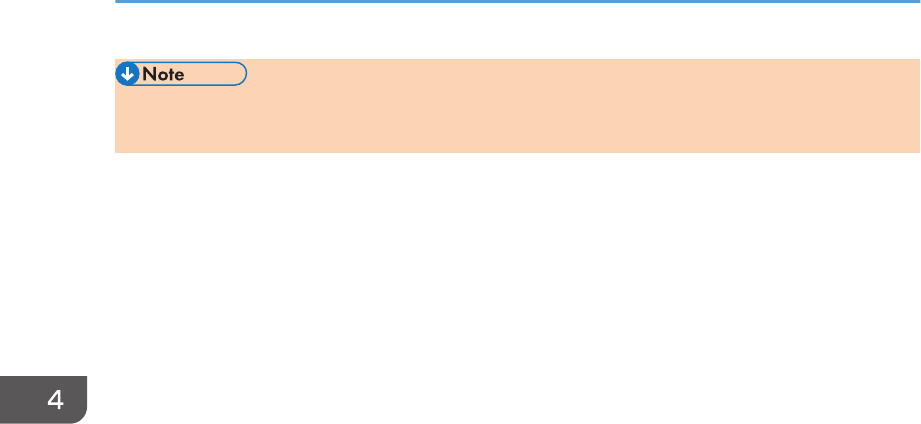Ricoh PRSP213NW1 Printer User Manual BBP PRSP213NW1 Rev0
Ricoh Company Ltd Printer BBP PRSP213NW1 Rev0
Ricoh >
BBP-PRSP213NW1_User manual-Rev0
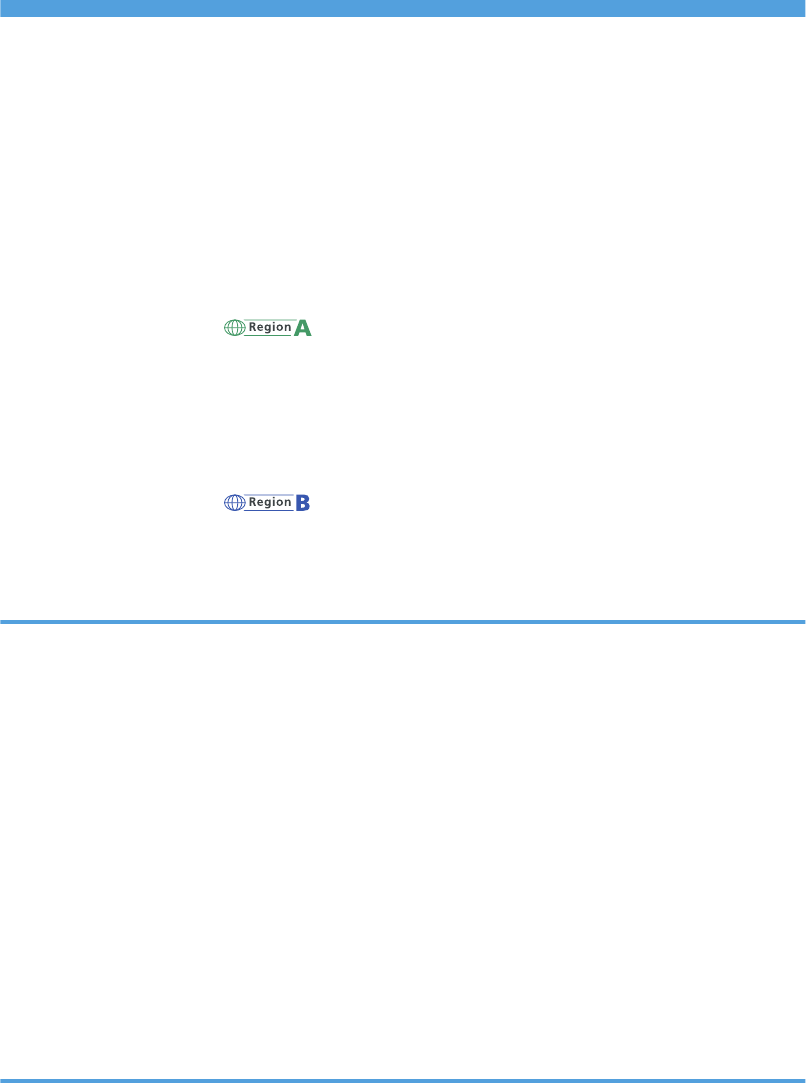
TABLE OF CONTENTS
How to Read This Manual................................................................................................................................. 7
Introduction..................................................................................................................................................... 7
Legal Prohibition.............................................................................................................................................7
Disclaimer........................................................................................................................................................7
About IP Address............................................................................................................................................8
Differences in Performance/Functions between Different Models.............................................................8
Note to Administrator.................................................................................................................................. 10
Model-Specific Information.............................................................................................................................12
Important Safety Instructions ...................................................................................................... 13
User Information on Electrical & Electronic Equipment.............................................................................13
Environmental Advice for Users..................................................................................................................13
Note for the Battery and/or Accumulator Symbol (For EU countries only)............................................14
Notes to Users of Facsimile Unit................................................................................................................. 15
Important Safety Instructions .......................................................................................................16
Notes to Users in the State of California....................................................................................................16
ENERGY STAR Program..................................................................................................................................17
1. Guide to the Machine
Guide to Components......................................................................................................................................19
Exterior..........................................................................................................................................................19
Exterior..........................................................................................................................................................21
Interior...........................................................................................................................................................23
Control Panel................................................................................................................................................23
About Operation Tools.................................................................................................................................... 28
Initial Setup....................................................................................................................................................... 29
Configuring Network Settings.........................................................................................................................30
Configuring the IP Address Settings........................................................................................................... 30
Wireless LAN Setup.....................................................................................................................................32
Configuring the IP Address Settings Using the Smart Organizing Monitor............................................ 34
Wireless LAN Setup.....................................................................................................................................36
2. Loading Paper
Supported Paper.............................................................................................................................................. 39
Non-Recommended Paper Types...................................................................................................................41
Print Area.......................................................................................................................................................... 42
1
Draft 2014/01/07

Loading Paper.................................................................................................................................................. 45
Loading Paper into Tray 1...........................................................................................................................45
Loading Paper into Bypass Tray................................................................................................................. 49
Specifying Paper Type and Paper Size Using Control Panel...................................................................51
Specifying Paper Type and Paper Size Using Smart Organizing Monitor.............................................52
Placing Originals..............................................................................................................................................54
About Originals............................................................................................................................................54
Placing Originals on the Exposure Glass...................................................................................................56
Placing Originals in the Auto Document Feeder....................................................................................... 57
3. Printing Documents
Basic Operation............................................................................................................................................... 59
Printing on Both Sides of Sheets..................................................................................................................59
Canceling a Print Job...................................................................................................................................60
If a Paper Mismatch Occurs............................................................................................................................62
Continuing Printing Using Mismatched Paper........................................................................................... 62
Continuing Printing Using Mismatched Paper........................................................................................... 62
Resetting the Print Job.................................................................................................................................. 62
Resetting the Print Job.................................................................................................................................. 62
4. Copying Originals
Copier Mode Screen.......................................................................................................................................63
Basic Operation............................................................................................................................................... 65
Canceling a Copy....................................................................................................................................... 66
Making Enlarged or Reduced Copies............................................................................................................67
Specifying Reduce/Enlarge....................................................................................................................... 67
Making Combined/2-sided Copies.............................................................................................................. 69
Specifying Combined and 2-sided Copies............................................................................................... 72
Copying Both Sides of an ID Card onto One Side of Paper........................................................................74
Specifying the ID Card Copy Setting.........................................................................................................74
Copying an ID Card....................................................................................................................................75
Specifying the Scan Settings........................................................................................................................... 77
Adjusting Image Density..............................................................................................................................77
Selecting the Document Type According to Original............................................................................... 77
2
Draft 2014/01/07

5. Scanning Originals
Scanner Mode Screen.....................................................................................................................................79
Registering Scan Destinations......................................................................................................................... 80
Modifying Scan Destinations...................................................................................................................... 85
Deleting Scan Destinations..........................................................................................................................86
Basic Operation............................................................................................................................................... 87
Scan to E-mail/FTP/Folder.........................................................................................................................87
Basic Operation for Scan to USB...............................................................................................................90
Specifying the Scan Settings........................................................................................................................... 92
Specifying the Scanning Size According to the Size of the Original...................................................... 92
Adjusting Image Density..............................................................................................................................92
Specifying Resolution.................................................................................................................................. 93
Scanning from a Computer............................................................................................................................. 94
Using TWAIN scanner................................................................................................................................ 94
TWAIN Scanning.........................................................................................................................................94
Basic Operation for WIA Scanning........................................................................................................... 99
6. Sending and Receiving a Fax
Fax Mode Screen.......................................................................................................................................... 101
Setting the Date and Time............................................................................................................................. 102
Entering Characters....................................................................................................................................... 103
Registering Fax Destinations......................................................................................................................... 104
Registering Fax Destinations Using the Control Panel............................................................................104
Sending a Fax................................................................................................................................................107
Selecting Transmission Mode...................................................................................................................107
Basic Operation for Sending a Fax......................................................................................................... 108
Specifying the Fax Destination................................................................................................................. 111
Useful Sending Functions..........................................................................................................................115
Specifying the Scan Settings.....................................................................................................................118
Using the Fax Function from a Computer (PC FAX).................................................................................... 120
Basic Operation for Sending Faxes from a Computer...........................................................................120
Configuring Transmission Settings............................................................................................................121
Configuring the PC FAX Address Book....................................................................................................121
Editing a Fax Cover Sheet........................................................................................................................ 123
3
Draft 2014/01/07

Receiving a Fax..............................................................................................................................................124
Selecting Reception Mode....................................................................................................................... 124
Printing Out Faxes Stored in Memory......................................................................................................126
Lists/Reports Related to Fax......................................................................................................................... 127
7. Configuring the Machine Using the Control Panel
Basic Operation.............................................................................................................................................129
Menu Chart.................................................................................................................................................... 131
Copier Features Settings............................................................................................................................... 132
Scanner Features Settings............................................................................................................................. 135
Fax Transmission Features Settings...............................................................................................................137
Fax Features Settings.....................................................................................................................................139
Address Book Settings...................................................................................................................................144
System Settings...............................................................................................................................................145
Printing Lists/Reports..................................................................................................................................... 150
Printing the Configuration Page................................................................................................................150
Types of Lists/Reports............................................................................................................................... 150
Printer Features Settings.................................................................................................................................152
Network Settings............................................................................................................................................155
Administrator Settings....................................................................................................................................159
8. Configuring the Machine Using Utilities
Using Web Image Monitor...........................................................................................................................165
Displaying Top Page..................................................................................................................................... 166
Changing the Interface Language........................................................................................................... 168
Checking the System Information................................................................................................................. 169
Status Tab...................................................................................................................................................169
Counter Tab............................................................................................................................................... 170
Machine Information Tab......................................................................................................................... 171
Configuring the System Settings................................................................................................................... 172
Sound Volume Adjustment Tab................................................................................................................ 172
Tray Paper Settings Tab............................................................................................................................ 172
Copier Tab.................................................................................................................................................173
Fax Tab.......................................................................................................................................................173
Toner Management Tab........................................................................................................................... 174
4
Draft 2014/01/07

Interface Tab..............................................................................................................................................175
Shortcut to Function Tab............................................................................................................................176
Registering Destinations................................................................................................................................ 177
Configuring the Fax Received File................................................................................................................178
Configuring the Network Settings................................................................................................................ 179
Network Status Tab...................................................................................................................................179
IPv6 Configuration Tab.............................................................................................................................180
Network Application Tab......................................................................................................................... 180
DNS Tab.................................................................................................................................................... 181
Auto E-mail Notification Tab.................................................................................................................... 182
SNMP Tab................................................................................................................................................. 183
SMTP Tab...................................................................................................................................................184
POP3 Tab...................................................................................................................................................185
Wireless Tab.............................................................................................................................................. 185
Configuring the IPsec Settings.......................................................................................................................188
IPsec Global Settings Tab.........................................................................................................................188
IPsec Policy List Tab...................................................................................................................................188
Printing Lists/Reports..................................................................................................................................... 192
Configuring the Administrator Settings.........................................................................................................193
Administrator Tab...................................................................................................................................... 193
Reset Settings Tab......................................................................................................................................193
Backup Setting Tab................................................................................................................................... 194
Restore Setting Tab....................................................................................................................................195
Set Date/Time Tab....................................................................................................................................195
Energy Saver Mode Tab.......................................................................................................................... 196
Help Source File Setting Tab.................................................................................................................... 197
Using Smart Organizing Monitor.................................................................................................................198
Checking the Status Information...............................................................................................................198
Configuring the Machine Settings............................................................................................................200
Printing the Configuration Page................................................................................................................201
9. Maintaining the Machine
Replacing the Print Cartridge........................................................................................................................203
Cautions When Cleaning..............................................................................................................................205
5
Draft 2014/01/07

Cleaning the Inside of the Machine............................................................................................................. 206
Cleaning the Exposure Glass........................................................................................................................207
Cleaning the Auto Document Feeder...........................................................................................................208
10. Troubleshooting
Common Problems.........................................................................................................................................209
Paper Feed Problems.....................................................................................................................................210
Removing Printing Jams.............................................................................................................................211
Removing Scanning Jams......................................................................................................................... 216
Print Quality Problems................................................................................................................................... 218
Checking the Condition of the Machine..................................................................................................218
Printer Problems............................................................................................................................................. 219
Print Positions Do Not Match Display Positions...................................................................................... 220
Copier Problems............................................................................................................................................ 221
Scanner Problems.......................................................................................................................................... 222
Fax Problems..................................................................................................................................................223
Error and Status Messages on the Screen...................................................................................................226
Error and Status Indicate on the Control Panel........................................................................................... 233
Error and Status Messages Appear on Smart Organizing Monitor..........................................................235
11. Appendix
Notes About the Toner.................................................................................................................................. 237
Moving and Transporting the Machine....................................................................................................... 238
Disposal......................................................................................................................................................238
Where to Inquire....................................................................................................................................... 238
Consumables..................................................................................................................................................239
Print Cartridge............................................................................................................................................239
Specifications of the Machine...................................................................................................................... 240
General Function Specifications.............................................................................................................. 240
Printer Function Specifications..................................................................................................................242
Copier Function Specifications.................................................................................................................243
Scanner Function Specifications...............................................................................................................244
Fax Function Specifications...................................................................................................................... 244
Trademarks.....................................................................................................................................................246
INDEX...........................................................................................................................................................249
6
Draft 2014/01/07
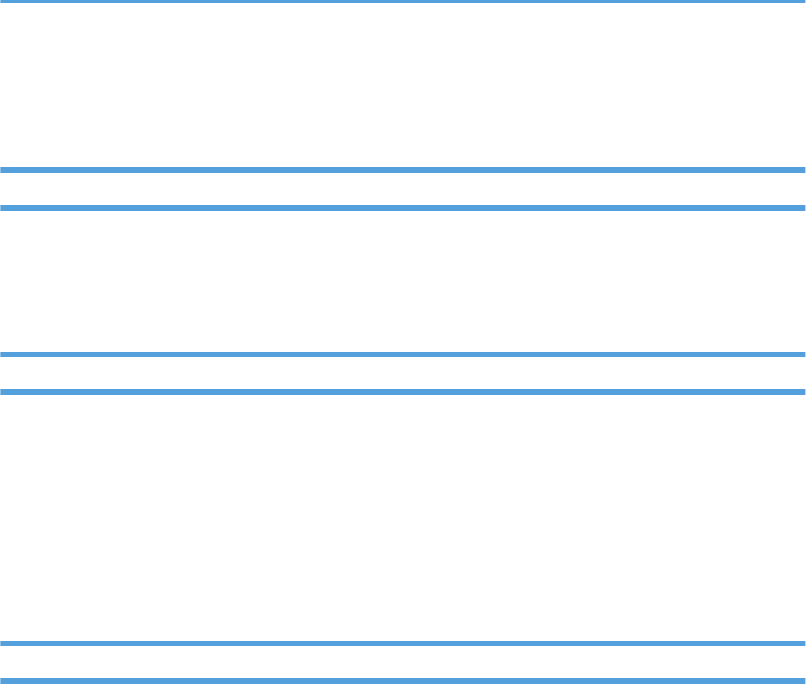
How to Read This Manual
Introduction
This manual contains detailed instructions and notes on the operation and use of this machine. For your
safety and benefit, read this manual carefully before using the machine. Keep this manual in a handy
place for quick reference.
Legal Prohibition
Do not copy or print any item for which reproduction is prohibited by law.
Copying or printing the following items is generally prohibited by local law:
bank notes, revenue stamps, bonds, stock certificates, bank drafts, checks, passports, driver's licenses.
The preceding list is meant as a guide only and is not inclusive. We assume no responsibility for its
completeness or accuracy. If you have any questions concerning the legality of copying or printing
certain items, consult with your legal advisor.
Disclaimer
Contents of this manual are subject to change without prior notice.
To the maximum extent permitted by applicable laws, in no event will the manufacturer be liable for any
damages whatsoever arising out of failures of this machine, losses of the registered data, or the use or
non-use of this product and operation manuals provided with it.
Make sure that you always copy or have backups of the data registered in this machine. Documents or
data might be erased due to your operational errors or malfunctions of the machine.
In no event will the manufacturer be responsible for any documents created by you using this machine or
any results from the data executed by you.
For good output quality, the manufacturer recommends that you use genuine toner from the
manufacturer.
Two kinds of size notation are employed in this manual.
Some illustrations or explanations in this guide may differ from your product due to improvement or
change in the product.
opal-p2_mf2_com_user_guide_00142077_eng.xml 7
Draft 2014/01/07
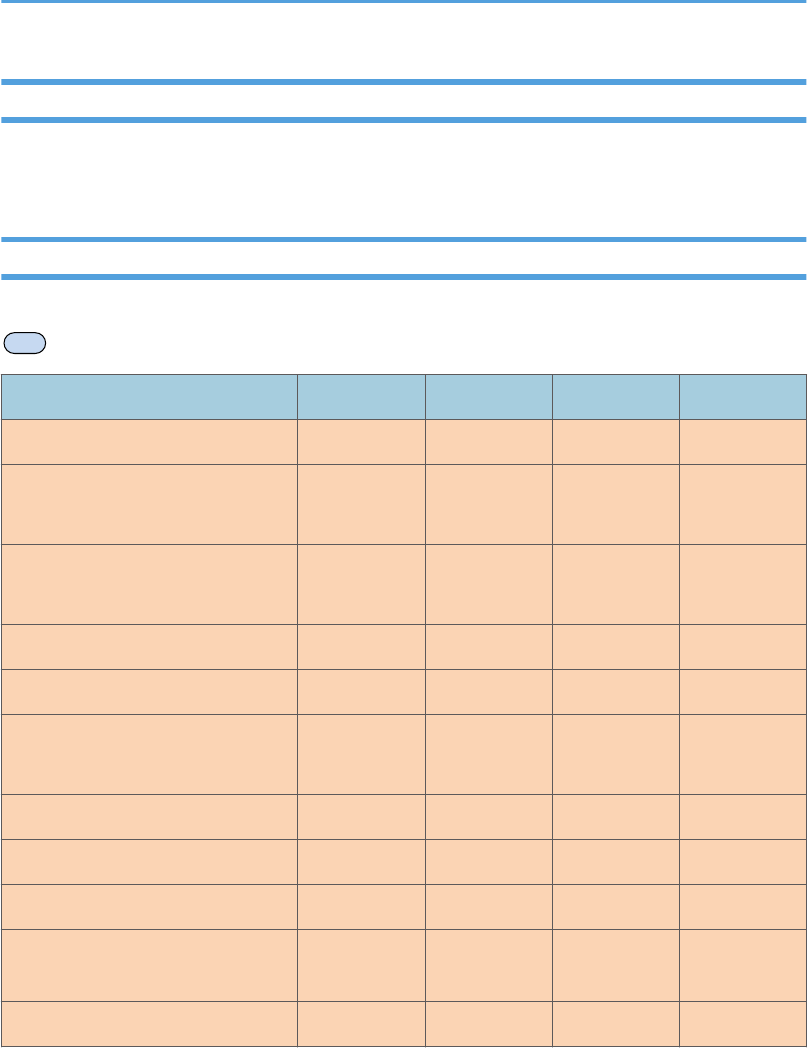
About IP Address
In this manual, "IP address" covers both IPv4 and IPv6 environments. Read the instructions that are
relevant to the environment you are using.
Differences in Performance/Functions between Different Models
The differences in main performance/functions between different models are as follows:
MF
SP 210SU SP 212SNw SP 210SF SP 212SFNw
Type Type 1 Type 2 Type 3 Type 4
Fax Not available Not available Available
(Standard)
Available
(Standard)
ADF Not available Available
(Standard)
Available
(Standard)
Available
(Standard)
PCL driver Not available Available Not available Available
GDI driver Available Not available Available Not available
Ethernet Port (Network) Not available Available
(Standard)
Not available Available
(Standard)
Wireless LAN Not available Available Not available Available
Scan to E-mail/FTP/Folder Not available Available Not available Available
Web Image Monitor Not available Available Not available Available
Toner Management (Toner Level
Indication)
Not available Not available Available*1 Available*1
Paperless FAX*2 Not available Not available Not available Available
8opal-p2_mf2_com_user_guide_00142077_eng.xml
Draft 2014/01/07
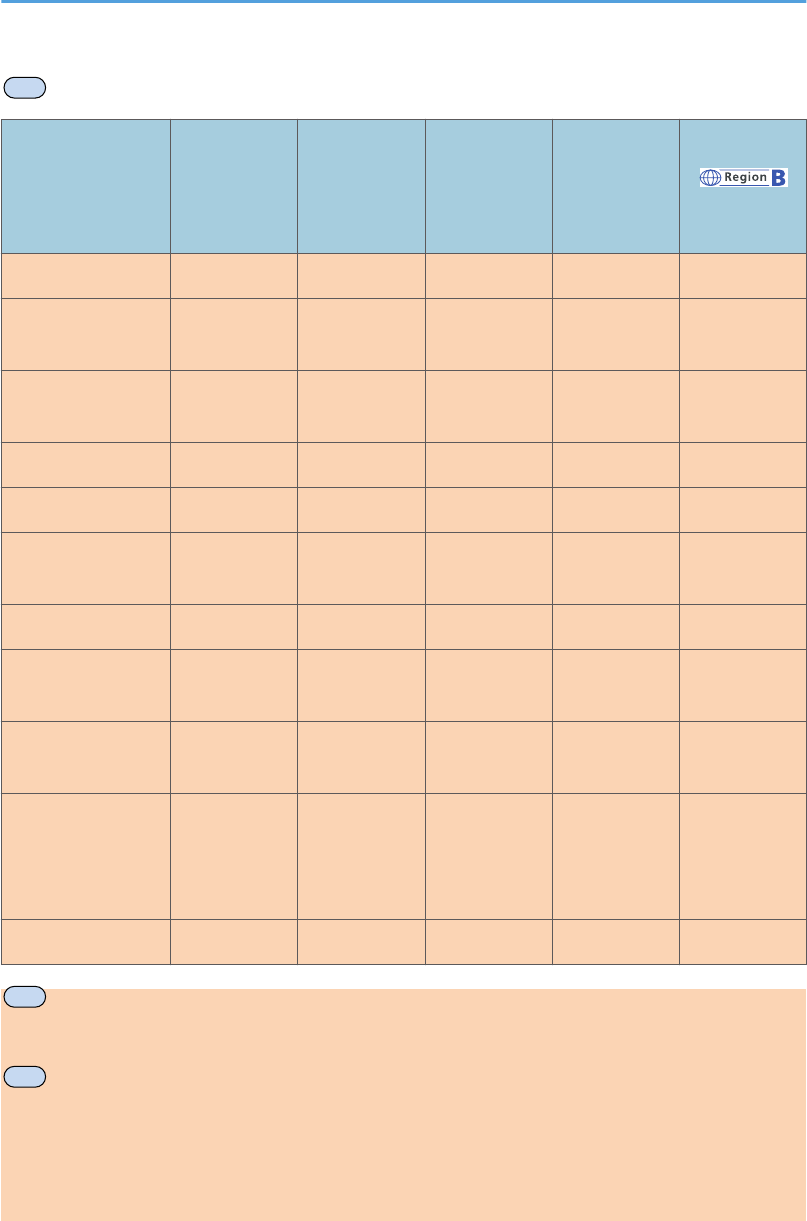
MF
SP 211SU SP 213SNw SP 211SF SP 213SFNw
SP 211S
(mainly North
America) only
Type Type 1 Type 2 Type 3 Type 4 Type 5
Fax Not available Not available Available
(Standard)
Available
(Standard)
Not available
ADF Not available Available
(Standard)
Available
(Standard)
Available
(Standard)
Available
(Standard)
PCL driver Not available Available Not available Available Not available
GDI driver Available Not available Available Not available Available
Ethernet Port
(Network)
Not available Available Not available Available Not available
Wireless LAN Not available Available Not available Available Not available
Scan to
Email/FTP/Folder
Not available Available Not available Available Not available
Web Image
Monitor
Not available Available Not available Available Not available
Toner
Management
(Toner Level
Indication)
Available Available Available*1 Available*1 Available
Paperless FAX*2 Not available Not available Not available Available Not available
MF
*1 Depending on the [Toner End Option Settings] setting, the toner management (toner level indication) function
may not be available. For [Toner End Option Settings], see page 145 "System Settings".
MF
*2 "Paperless FAX" refers to the function that allows you to store faxes in memory and print only the ones you
want, thus saving paper. "Paperless FAX" refers to [Reception File Setting] and [Notify Forward Status] that
can be specified using the machine's control panel and [Fax Received File Processing] that can be specified
using Web Image Monitor. For details, see page 139 "Fax Features Settings" and see page 172
"Configuring the System Settings".
opal-p2_mf2_com_user_guide_00142077_eng.xml 9
Draft 2014/01/07
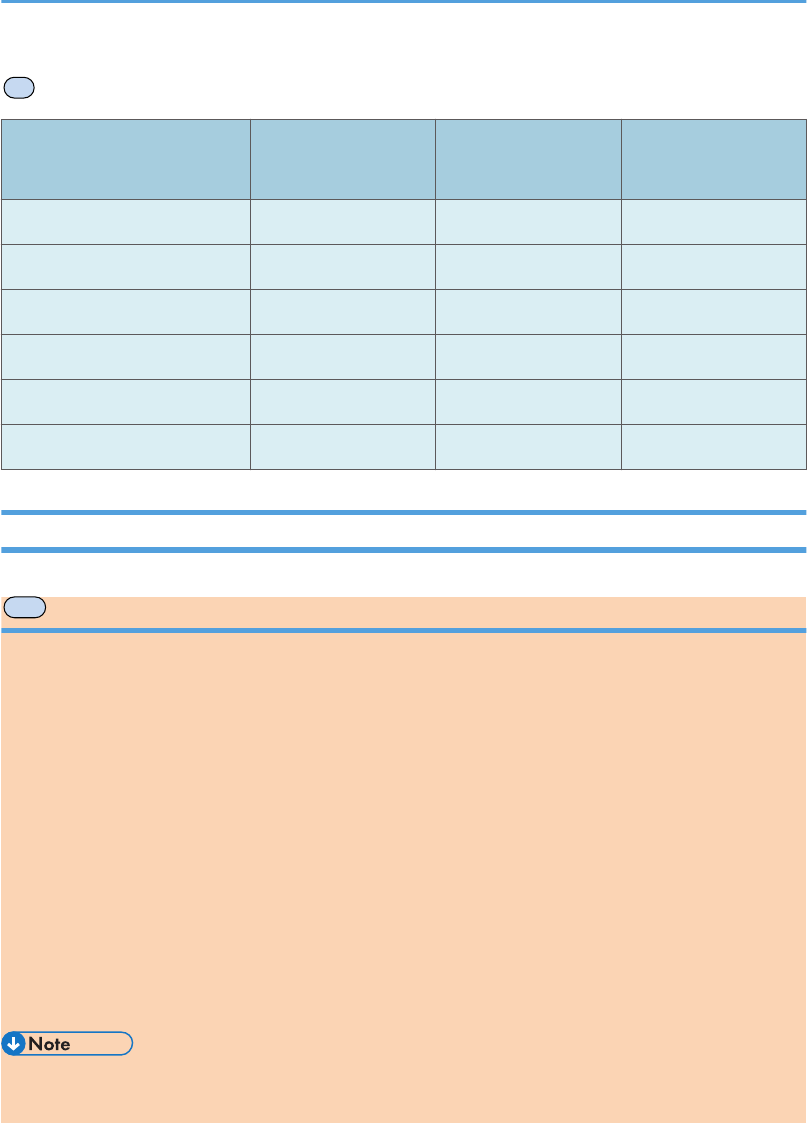
P
SP 210
SP 211
SP 212N
SP 213N
SP 212Nw
SP 213Nw
Type Type 1 Type 2 Type 3
PCL driver Not available Available Available
GDI driver Available Not available Not available
Ethernet Port (Network) Not available Available Available
Wireless LAN Not available Not available Available
Web Image Monitor Not available Available Available
Note to Administrator
MF
Password
Certain configurations of this machine can be password-protected to prevent unauthorized modifications
by others. We strongly recommend you to create your own password immediately.
The following are the operations that can be password-protected:
• Configuring the [Address Book], [Network Settings], or [Admin. Tools] menu using the control
panel
You can access these menus without a password by factory default.
The setting for creating a password can be found in [Admin. Tools].
• Configuring the [System Settings], [Quick Dial Destination], [Scan Destination], [Fax Speed Dial
Destination], [Fax Received File], [Network Settings], [IPsec Settings], or [Administrator Tools]
menu using Web Image Monitor
By default, the access to the machine via Web Image Monitor is not password-protected.
The setting for configuring the password can be found in [Administrator Settings].
• For details about creating passwords, see page 159 "Administrator Settings" or page 193
"Configuring the Administrator Settings".
10 opal-p2_mf2_com_user_guide_00142077_eng.xml
Draft 2014/01/07
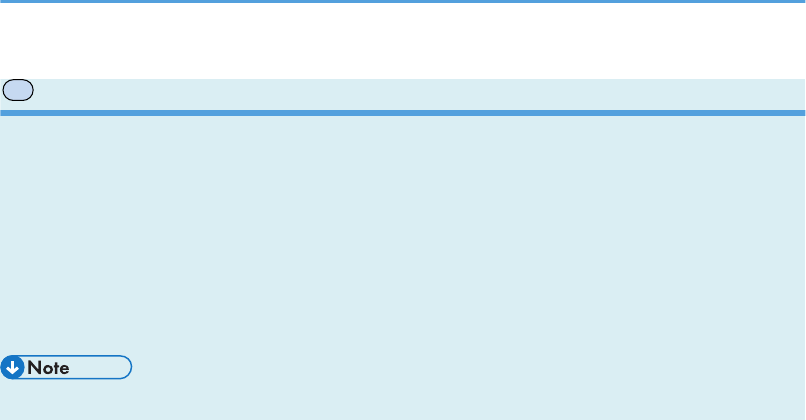
P
Password
Certain configurations of this machine can be password-protected to prevent unauthorized modifications
by others. We strongly recommend you to create your own password immediately.
The following are the operations that can be password-protected:
• Configuring the [System Settings], [Network Settings], [IPsec Settings], or [Administrator Tools]
menu using Web Image Monitor
By default, the access to the machine via Web Image Monitor is not password-protected.
The setting for configuring the password can be found in [Administrator Settings].
• For details about setting a password, see page 193 "Configuring the Administrator Settings".
opal-p2_mf2_com_user_guide_00142077_eng.xml 11
Draft 2014/01/07
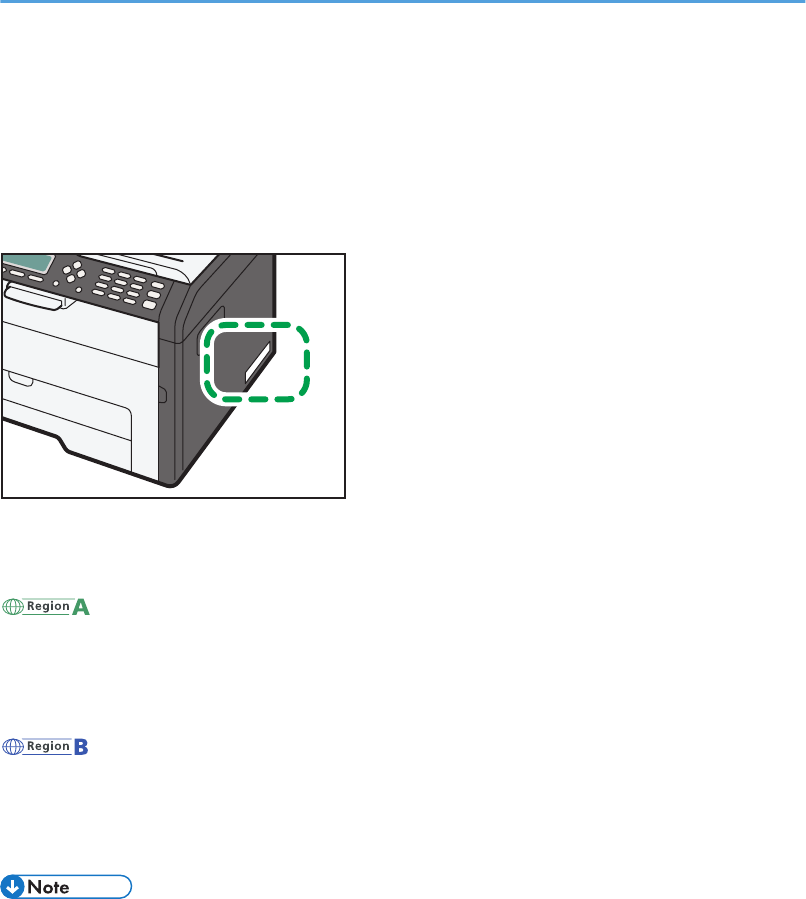
Model-Specific Information
This section explains how you can identify the region your machine belongs to.
There is a label on the rear of the machine, located in the position shown below. The label contains
details that identify the region your machine belongs to. Read the label.
DCT065
The following information is region-specific. Read the information under the symbol that corresponds to
the region of your machine.
(mainly Europe and Asia)
If the label contains the following, your machine is a region A model:
• CODE XXXX -27, -29
• 220-240V
(mainly North America)
If the label contains the following, your machine is a region B model:
• CODE XXXX -17
• 120V
• Dimensions in this manual are given in two units of measure: metric and inch. If your machine is a
Region A model, refer to the metric units. If your machine is a Region B model, refer to the inch
units.
12 opal-p2_mf2_com_user_guide_00142317_eng.xml
Draft 2014/01/07
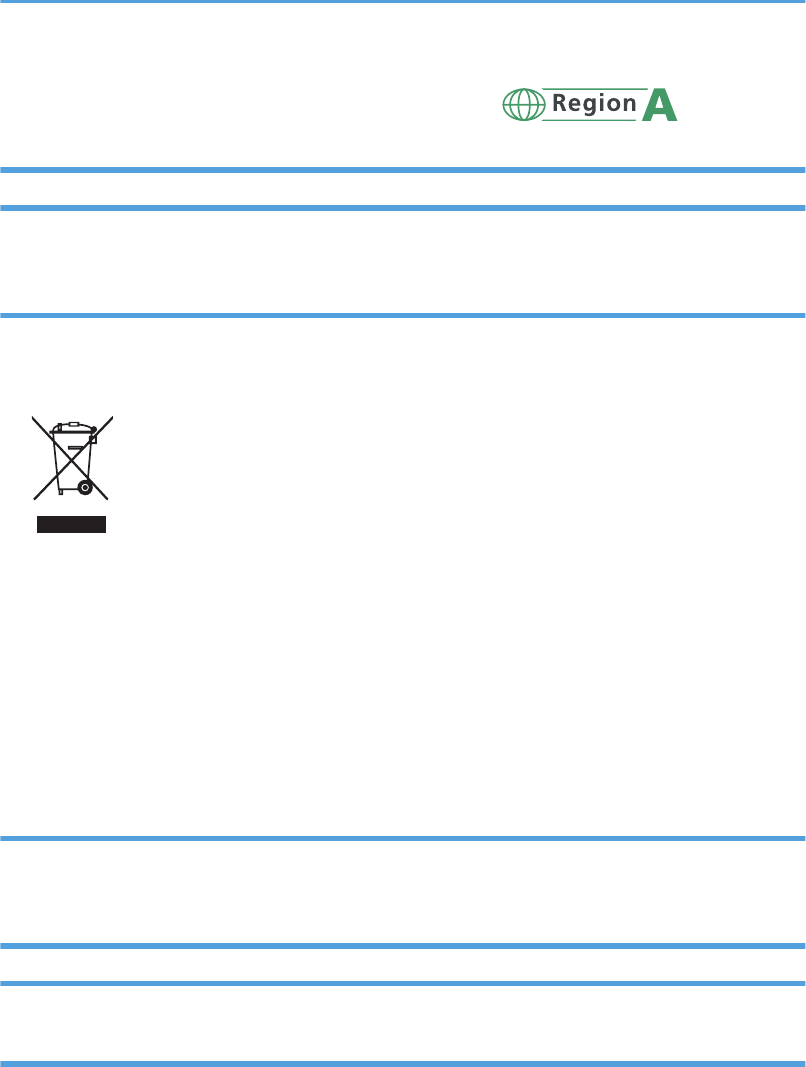
Important Safety Instructions
User Information on Electrical & Electronic Equipment
Users in the countries where this symbol shown in this section has been specified in
national law on collection and treatment of E-waste
Our Products contain high quality components and are designed to facilitate recycling.
Our products or product packaging are marked with the symbol below.
The symbol indicates that the product must not be treated as municipal waste. It must be disposed of
separately via the appropriate return and collection systems available. By following these instructions
you ensure that this product is treated correctly and help to reduce potential impacts on the environment
and human health, which could otherwise result from inappropriate handling. Recycling of products
helps to conserve natural resources and protect the environment.
For more detailed information on collection and recycling systems for this product, please contact the
shop where you purchased it, your local dealer or sales/service representatives.
All Other Users
If you wish to discard this product, please contact your local authorities, the shop where you bought this
product, your local dealer or sales/service representatives.
Environmental Advice for Users
Users in the EU, Switzerland and Norway
Consumables yield
Please refer to either the User’s Manual for this information or the packaging of the consumable.
Recycled paper
The machine can use recycled paper which is produced in accordance with European standard
EN 12281:2002 or DIN 19309. For products using EP printing technology, the machine can print
opal-p2_mf2_com_user_guide_00142318_eng.xml 13
Draft 2014/01/07

on 64g/m2 paper, which contains less raw materials and represents a significant resource
reduction.
Duplex printing (if applicable)
Duplex printing enables both sides of a sheet of paper to be used. This saves paper and reduces
the size of printed documents so that fewer sheets are used. We recommend that this feature is
enabled whenever you print.
Toner and ink cartridge return program
Toner and ink cartridge for recycling will be accepted free of charge from users in accordance with
local regulations.
For details about the return program, please refer to the Web page below or consult your service
person.
https://www.ricoh-return.com/
Energy efficiency
The amount of electricity a machine consumes depends as much on its specifications as it does on
the way you use it. The machine is designed to allow you to reduce electricity costs by switching to
Ready mode after it prints the last page. If required, it can immediately print again from this mode.
If no additional prints are required and a specified period of time passes, the device switches to an
energy saving mode.
In these modes, the machine consumes less power (watts). If the machine is to print again, it needs
a little longer to return from an energy saving mode than from Ready mode.
For maximum energy savings, we recommend that the default setting for power management is
used.
Products that comply with the Energy Star requirement are always energy efficient.
Note for the Battery and/or Accumulator Symbol (For EU countries only)
In accordance with the Battery Directive 2006/66/EC Article 20 Information for end-users Annex II,
the above symbol is printed on batteries and accumulators.
This symbol means that in the European Union, used batteries and accumulators should be disposed of
separately from your household waste.
In the EU, there are separate collection systems for not only used electrical and electronic products but
also batteries and accumulators.
Please dispose of them correctly at your local community waste collection/recycling centre.
14 opal-p2_mf2_com_user_guide_00142318_eng.xml
Draft 2014/01/07
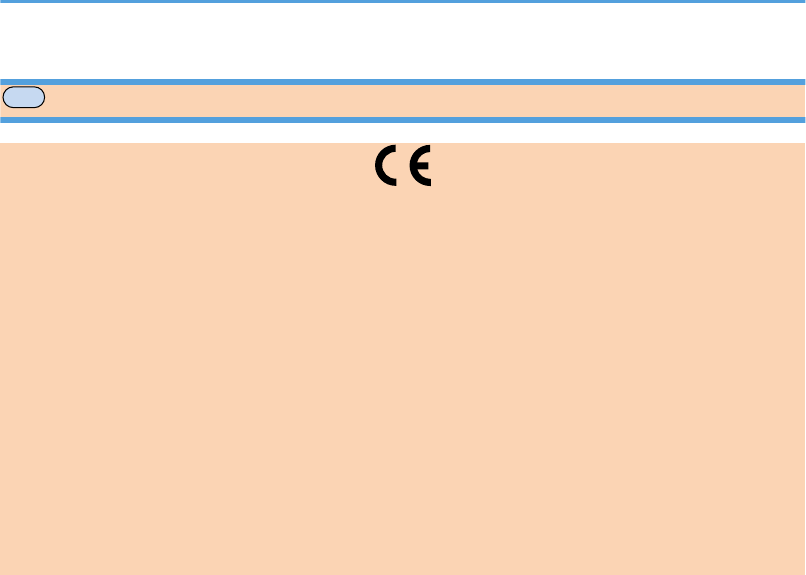
MF
Notes to Users of Facsimile Unit
Declaration of Conformity
Notice to Users in EEA Countries
This product complies with the essential requirements and provisions of Directive 1999/5/EC of
the European Parliament and of the Council of 9 March 1999 on radio equipment and
telecommunications terminal equipment and the mutual recognition of their conformity.
Notice to Users Accessing Analog PSTN in EEA Countries
This product is designed to be able to access analog PSTN in all EEA countries. Local PSTN
compatibility is dependent on software switch settings. Please contact your service representative if
relocating this product to another country. In the event of problems, please contact your service
representative in the first instance.
The CE Declaration of Conformity is available by accessing the URL:
http://www.ricoh.co.jp/fax/ce_doc/ and selecting the product applicable.
opal-p2_mf2_com_user_guide_00142318_eng.xml 15
Draft 2014/01/07

Important Safety Instructions
Notes to Users in the State of California
Perchlorate Material - special handling may apply. See: www.dtsc.ca.gov/hazardouswaste/
perchlorate
16 opal-p2_mf2_com_user_guide_00142319_eng.xml
Draft 2014/01/07
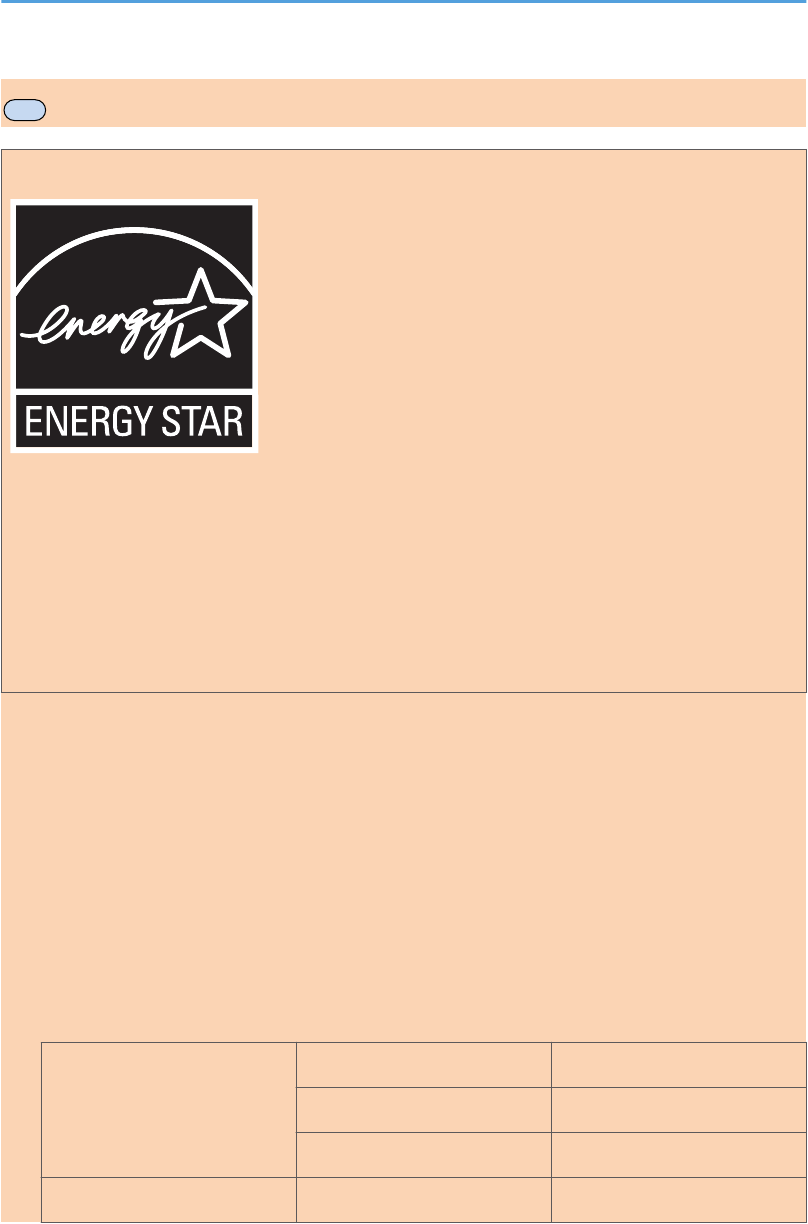
MF
ENERGY STAR Program
ENERGY STAR® Program Requirements for Imaging Equipment
The ENERGY STAR® Program Requirements for Imaging Equipment encourage energy conservation
by promoting energy efficient computers and other office equipment.
The program backs the development and dissemination of products that feature energy saving
functions.
It is an open program in which manufacturers participate voluntarily.
Targeted products are computers, monitors, printers, facsimiles, copiers, scanners, and multifunction
devices. Energy Star standards and logos are internationally uniform.
This machine is equipped with the following Energy Saver modes: Energy Saver mode 1 and Energy
Saver mode 2. The machine recovers from Energy Saver mode when it receives a print job, prints a
received fax, or when any key is pressed.
Energy Saver mode 1
This machine automatically enters Energy Saver mode 1 about 30 seconds after the last operation
is completed.
Energy Saver mode 2
This machine automatically enters Energy Saver mode 2 1 minute after the last operation is
completed.
Specifications
Energy Saver mode 1 Power Consumption*1 40 W
Default Interval 30 seconds
Recovery Time*1 10 seconds
Energy Saver mode 2 Power Consumption*1 3.9 W
opal-p2_mf2_com_user_guide_00142320_eng.xml 17
Draft 2014/01/07

Default Interval 1 minute
Recovery Time*1 25 seconds
*1 Recovery time and power consumption may differ depending on the conditions and environment of the
machine.
18 opal-p2_mf2_com_user_guide_00142320_eng.xml
Draft 2014/01/07
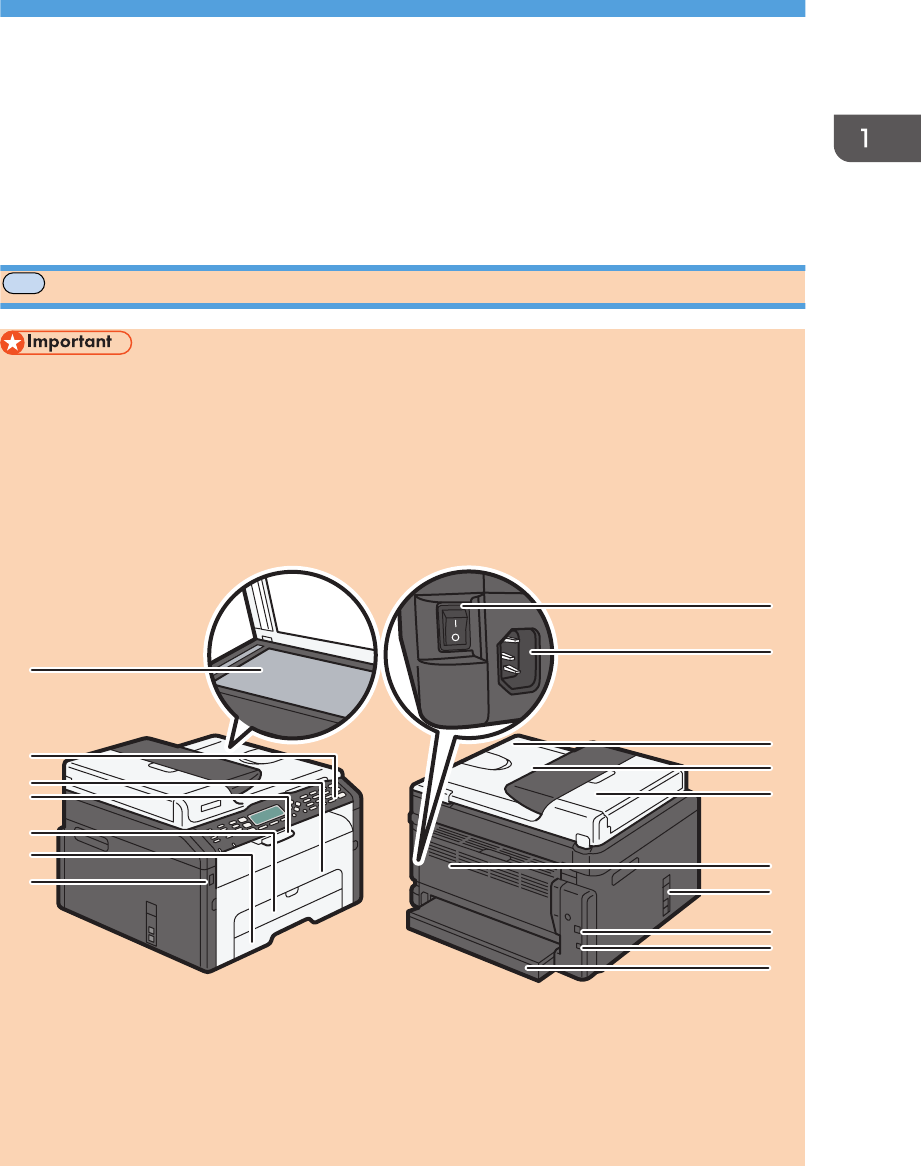
1. Guide to the Machine
Guide to Components
This section introduces the names of the various parts on the front and rear side of the machine and
outlines their functions.
MF
Exterior
• Type 1 model is not equipped with an Auto Document Feeder (ADF).
• Type 1 and 3 models do not come with an Ethernet port.
• Type 1and 2 models do not come with a line port or TEL port.
• Type 1, 3 and 5 models do not come with an Ethernet port.
• Type 1, 2 and 5 models do not come with a line port or TEL port.
DCT067
2
8
1
6
3
7
4
5
9
10
11
14
13
12
16
15
17
1. Exposure Glass
Place originals here sheet by sheet.
2. Control Panel
Contains a screen and keys for machine control. For details, see page 23 "Control Panel".
opal-p2_mf2_com_user_guide_00142078_eng.xml 19
Draft 2014/01/07

3. Front Cover
Open this cover to replace consumables or clear a paper jam.
4. Stop Fences
Raise this fence to prevent paper from falling off.
5. Bypass Tray
This tray can hold one sheet of plain paper.
6. Tray 1
This tray can hold up to 150 sheets of plain paper.
7. USB Flash Disk Port
Insert a USB flash disk to store scanned files using the Scan to USB function.
8. Power Switch
Use this switch to turn the power on or off.
9. Power Connector
Connect the power cord to the machine here. Insert the other end of the cable into a nearby wall outlet.
10. Auto Document Feeder (Exposure Glass Cover)
The ADF is integrated with the exposure glass cover. Open this cover to place documents on the exposure
glass.
11. Input Tray for the ADF
Place stacks of originals here. They will feed in automatically. This tray can hold up to 15 sheets of plain
paper.
12. ADF Cover
Open this cover to remove originals jammed in the ADF.
13. Rear Cover
Open this cover to deliver sheets face up or remove jammed paper.
14. Line and TEL Port
• Upper port: Port for external telephone connection.
• Lower port: G3 (analog) line Interface port for telephone line connection.
15. USB Port
Use this port to connect the machine to a computer using a USB cable.
16. Ethernet Port
Use this port to connect the machine a network using a network cable.
17. Tray Cover
Attach this cover when you extend the tray.
1. Guide to the Machine
20 opal-p2_mf2_com_user_guide_00142078_eng.xml
Draft 2014/01/07
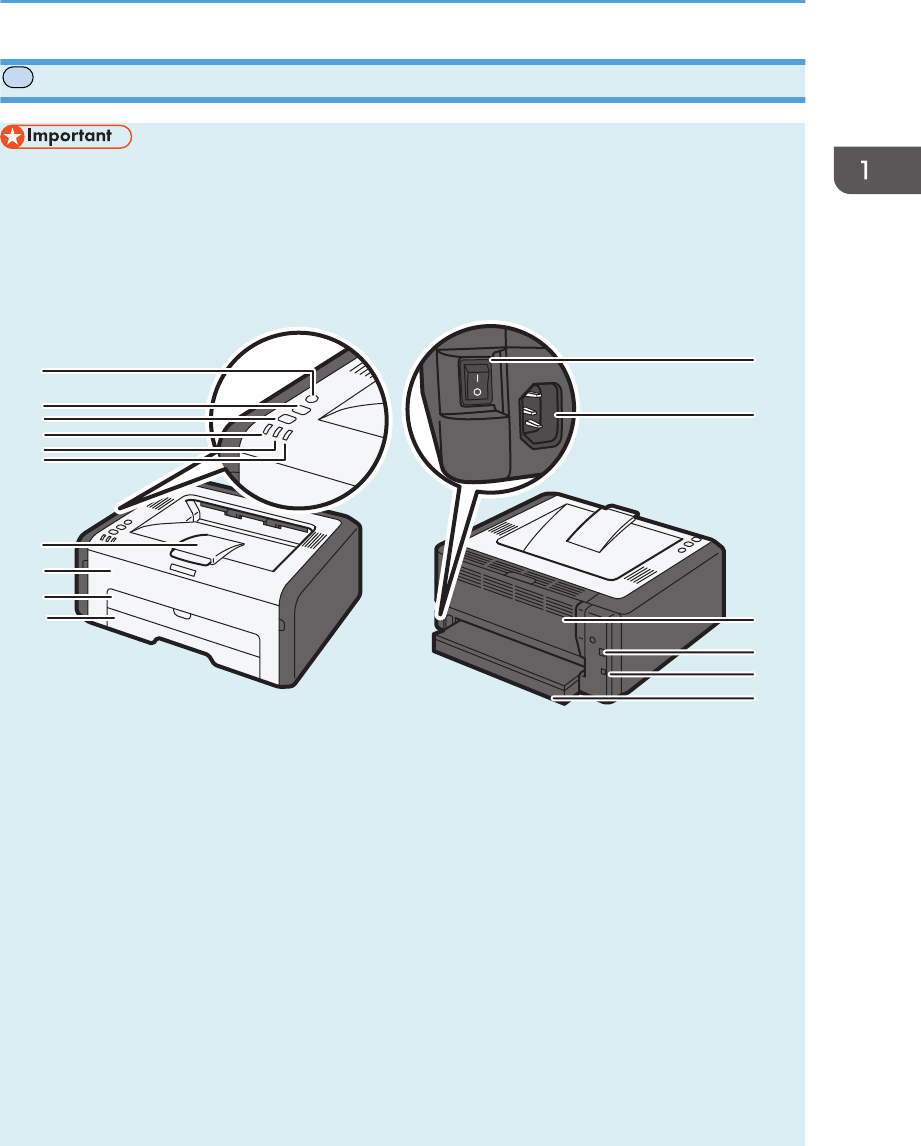
P
Exterior
• Type 1 models do not come with an Ethernet port.
• Type 1 and 2 models do not have the [WIFI/LAN] key.
• Only Type 2 and 3 models can print the test page using the [Job Reset] key.
DCT831
2
111
5
6
7
8
9
10
12
13
15
14
16
4
3
1. [WIFI/LAN] key
Press this key to switch between wireless and wired LAN connection.
2. [Job Reset] key
Press this key to cancel an ongoing print job. By holding down the key for 13 seconds, you can print the test
page.
3. [Start] key
You can use this key to print on the back of paper in duplex printing and to execute forced printing.
By holding down the key for 13 seconds, the configuration page or maintenance page can be printed. The
maintenance page is printed with Type 1 model and the configuration page is printed with Type 2 or Type 3
model.
4. Power Indicator
This indicator lights up blue when the machine is turned on. It flashes when a print job is received and while
printing is in progress.
Guide to Components
opal-p2_mf2_com_user_guide_00142078_eng.xml 21
Draft 2014/01/07

5. Alert Indicator
This indicator flashes red when paper jams occur, and it lights up when the paper settings do not match the
settings specified by the driver, and when other errors occur.
6. Toner/Paper End Indicator
This indicator lights up when the machine runs out of paper and when the toner is not set correctly.
This indicator flashes red when the toner is nearly empty, and it lights up when the machine runs out of paper
or toner and when the toner is not set correctly.
7. Stop Fences
Raise this fence to prevent paper from falling off.
8. Front Cover
Open this cover to replace consumables or clear a paper jam.
9. Bypass Tray
This tray can hold one sheet of plain paper.
10. Tray 1
This tray can hold up to 150 sheets of plain paper.
11. Power Switch
Use this switch to turn the power on or off.
12. Power Connector
Connect the power cord to the machine here. Insert the other end of the cable into a nearby wall outlet.
13. Rear Cover
Open this cover to deliver sheets face up or remove jammed paper.
14. USB Port
Use this port to connect the machine to a computer using a USB cable.
15. Ethernet Port
Use this port to connect the machine to network using a network cable.
16. Tray Cover
Attach this cover when you extend the tray.
1. Guide to the Machine
22 opal-p2_mf2_com_user_guide_00142078_eng.xml
Draft 2014/01/07
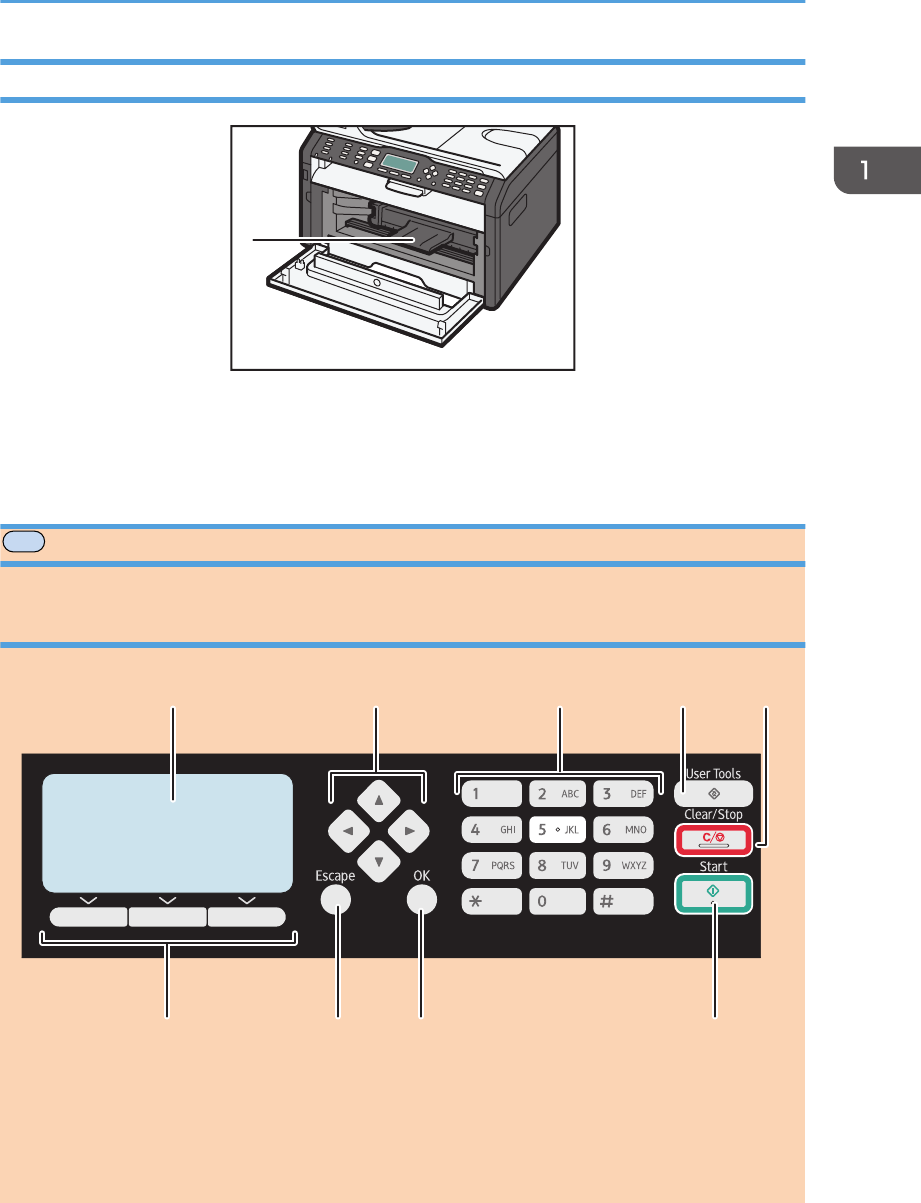
Interior
DCT064
1
1. Print Cartridge
A replacement consumable that is required to make prints on paper. For details about replacing the cartridge,
see page 203 "Replacing the Print Cartridge".
MF
Control Panel
On the Right
1 2 3 4 5
6 7 8 9
DCT890
1. Screen
Displays current status and messages.
2. Scroll Keys
Press these keys to move the cursor in each direction.
Guide to Components
opal-p2_mf2_com_user_guide_00142078_eng.xml 23
Draft 2014/01/07
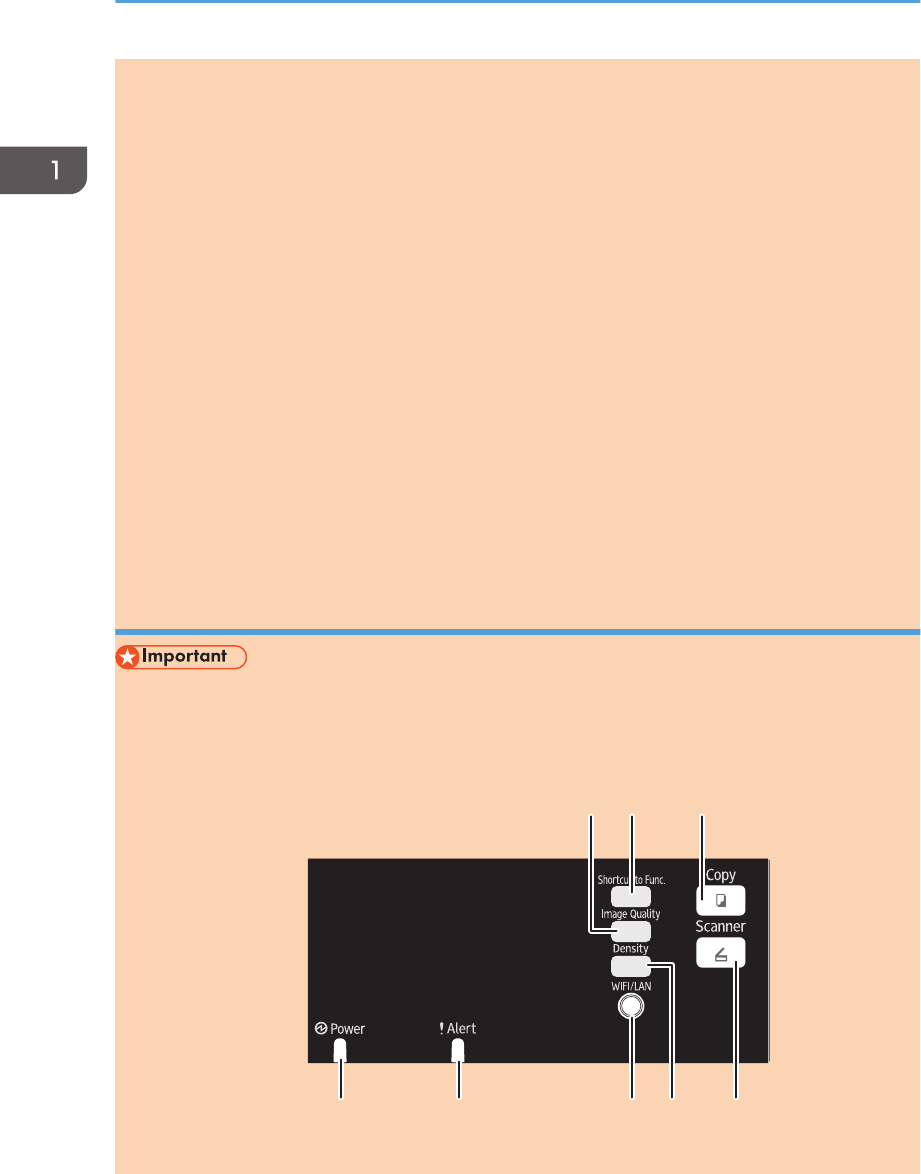
3. Number Keys
Use to enter numerical values when specifying settings such as fax numbers and copy quantities, or enter
letters when specifying names.
4. [User Tools] key
Press to display the menu for configuring the machine's system settings.
5. [Clear/Stop] key
Use this key to cancel or stop a print job, document copying, scanning, fax transmission/reception, and other
actions in progress.
6. Selection keys
Press the key that corresponds to an item shown on the bottom line of the screen to select it.
7. [Escape] key
Press to cancel the last operation or exit to the previous level of the menu tree.
8. [OK] Key
Use this key to confirm settings and specified values, or move to the next menu level.
9. [Start] key
Use this key to start fax transmission/reception, scan, or copy.
On the Left
• Depending on the model, the position of the keys may differ.
Type1, Type2, Type5
4 5 6
7
8
12 3
DCT892
1. Guide to the Machine
24 opal-p2_mf2_com_user_guide_00142078_eng.xml
Draft 2014/01/07
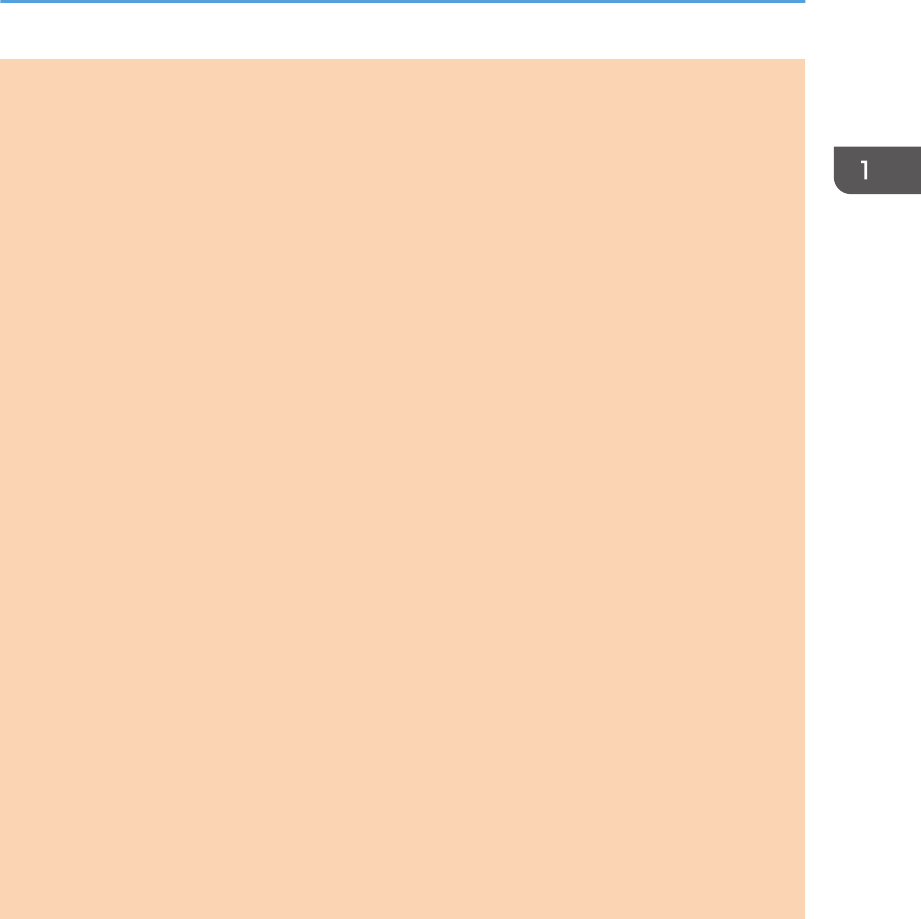
1. [Shortcut to Func.] key
Press to enter ID card copy mode for the current job.
If you do not use the ID card copy mode frequently, configure [Shortcut to Function] in [Admin. Tools] to make
this key available for sending faxes immediately or displaying scan file destinations. For [Shortcut to Function],
see page 159 "Administrator Settings".
2. [Image Quality] key
Press to select the image quality for the current job.
• Copier mode: select Text, Photo, Mixed, or Vou.
• Scanner mode: select the resolution.
3. [Copy] key (Type2 only)
Use this key to switch the machine to copier mode.
4. Power Indicator
This indicator lights up blue when the machine is turned on. It flashes when a print job is received and while
printing, scanning, or fax transmission/reception is in progress.
5. Alert Indicator
This indicator lights up red when the machine runs out of paper or consumables, when the paper settings do
not match the settings specified by the driver, or when other errors occur. It flashes slowly when the machine is
running out of toner.
6. [Density] key
Press to adjust image density for the current job.
• Copier mode: select from 5 levels of density.
• Scanner mode: select from 5 levels of density.
7. [WIFI/LAN] key (Type2 only)
Press this key to switch between wireless and wired LAN connection.
Press this key to display the menu for manually configuring the settings in Infrastructure or Ad-Hoc mode
selected in [Wi-Fi/LAN Key]. By holding down the key, you can display the menu for configuring the WPS
using the PIN code or in PBC mode. This key cannot be used if [Wi-Fi Enable] is set to [Disable].
8. [Scanner] key (Type2 only)
Use this key to switch the machine to scanner mode.
Guide to Components
opal-p2_mf2_com_user_guide_00142078_eng.xml 25
Draft 2014/01/07
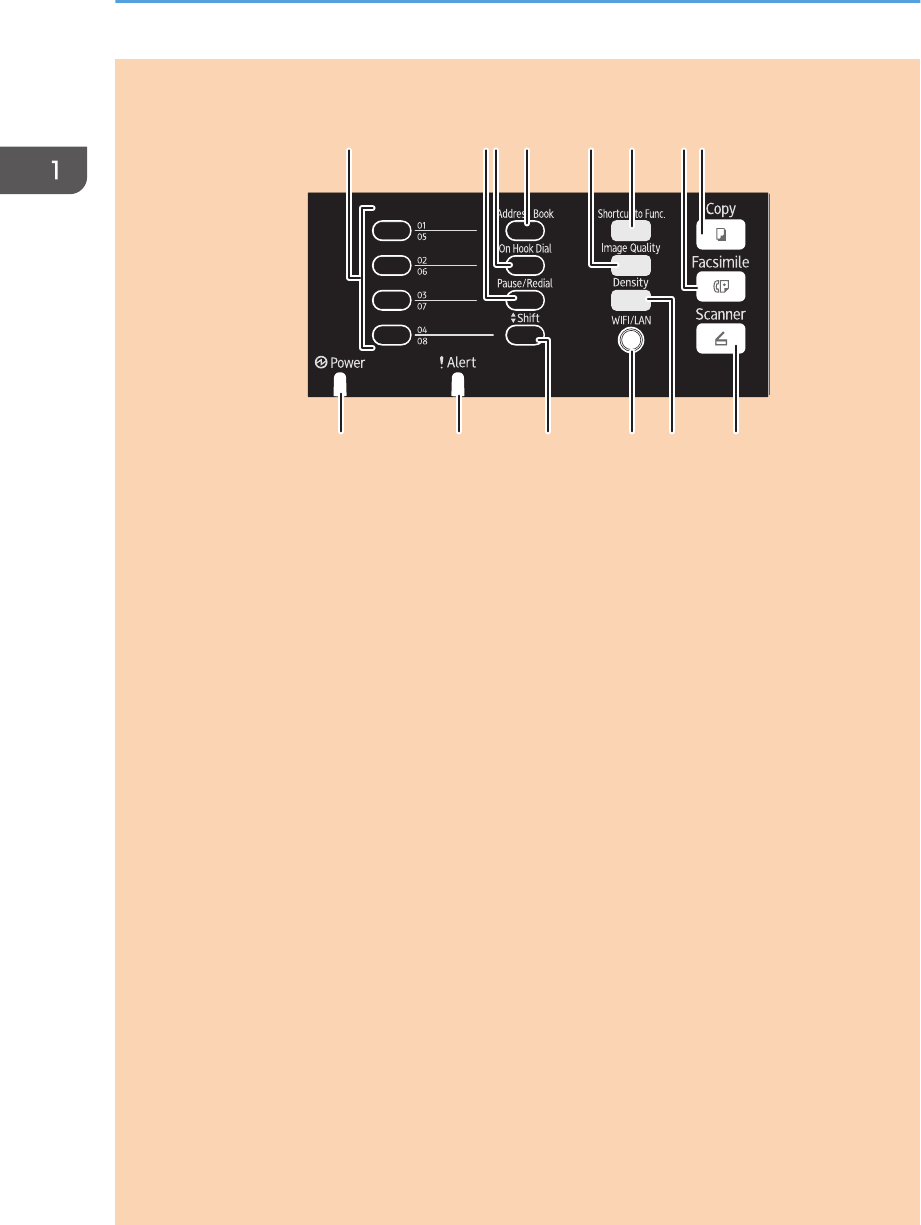
Type3, Type4
9101112
13
14
12345678
DCT891
1. One Touch buttons
Press to select a scan or fax Quick Dial destination.
2. [Pause/Redial] key
• Pause
Press to insert a pause in a fax number. The pause is indicated by "P".
• Redial
Press to display the last used scan or fax destination.
3. [On Hook Dial] key
Press to use on-hook dialing to check the destination's status when sending a fax.
4. [Address Book] key
Press to select a scan or fax destination from the Address Book.
5. [Image Quality] key
Press to select the image quality for the current job.
• Copier mode: select Text, Photo, Mixed, or Vou.
• Scanner mode: select the resolution.
• Fax mode: select Standard, Detail, or Photo.
6. [Shortcut to Func.] key
Press to enter ID card copy mode for the current job.
If you do not use the ID card copy mode frequently, configure [Shortcut to Function] in [Admin. Tools] to make
this key available for sending faxes immediately or displaying scan file destinations. For [Shortcut to Function],
see page 159 "Administrator Settings".
7. [Facsimile] key
Use this key to switch the machine to fax mode.
1. Guide to the Machine
26 opal-p2_mf2_com_user_guide_00142078_eng.xml
Draft 2014/01/07

8. [Copy] key
Use this key to switch the machine to copier mode.
9. Power Indicator
This indicator lights up blue when the machine is turned on. It flashes when a print job is received and while
printing, scanning, or fax transmission/reception is in progress.
10. Alert Indicator
This indicator lights up red when the machine runs out of paper or consumables, when the paper settings do
not match the settings specified by the driver, or when other errors occur. It flashes slowly when the machine is
running out of toner.
11. [Shift] key
Press to switch between Quick Dial numbers 1 to 4 and 5 to 8 when specifying a scan or fax destination using
the One Touch buttons.
12. [WIFI/LAN] key (Type4 only)
Press this key to switch between wireless and wired LAN connection.
Press this key to display the menu for manually configuring the settings in Infrastructure or Ad-Hoc mode
selected in [Wi-Fi/LAN Key]. By holding down the key, you can display the menu for configuring the WPS
using the PIN code or in PBC mode. This key cannot be used if [Wi-Fi Enable] is set to [Disable].
13. [Density] key
Press to adjust image density for the current job.
• Copier mode: select from 5 levels of density.
• Scanner mode: select from 5 levels of density.
• Fax mode: select from 3 levels of density.
14. [Scanner] key (Type4 only)
Use this key to switch the machine to scanner mode.
Guide to Components
opal-p2_mf2_com_user_guide_00142078_eng.xml 27
Draft 2014/01/07
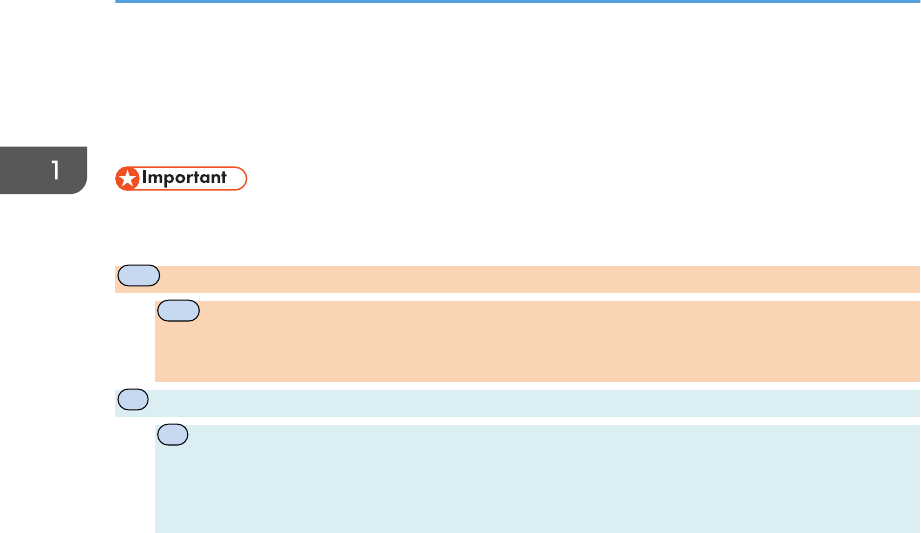
About Operation Tools
This section explains the operation tools of this machine.
• Depending on the model, Web Image Monitor may not be available. For details about model-
specific differences, see page 8 "Differences in Performance/Functions between Different Models".
MF
Control Panel
MF
The control panel contains a screen and keys for controlling the machine. Using the control
panel, you can configure the machine's various settings. For details about how to use the control
panel, see page 129 "Configuring the Machine Using the Control Panel".
P
Smart Organizing Monitor
P
Install this utility on your computer from the included CD-ROM before using it. Using Smart
Organizing Monitor, you can check the machine's status, configure its settings, and use other
functions. For details about how to use Smart Organizing Monitor, see page 198 "Using Smart
Organizing Monitor".
Web Image Monitor
You can check the machine's status and configure its settings by accessing the machine via Web
Image Monitor. For details about how to use Web Image Monitor, see page 165 "Using Web
Image Monitor".
1. Guide to the Machine
28 opal-p2_mf2_com_user_guide_00142079_eng.xml
Draft 2014/01/07

MF
Initial Setup
When you turn this machine on for the first time, you must set the following items. Select each setting
using the [ ], [ ], or number keys, and then press the [OK] key.
Display language
The selected language here is used for displaying messages, etc.
Country*3
The selected country is used for configuring the settings related to fax transmissions with
appropriate default values for the country of use.
User fax number*1
The registered number is used as the fax number of the machine. The user fax number can contain
0 to 9, spaces, and "+".
User name*1
The name entered here is used as the name of the fax sender.
Date/Time
The time and date entered here are used for the machine's internal clock.
Area*2 *3
By selecting the area in which the machine is being used, you can narrow down the choice of
display language and other settings.
*1 This setting is only available with Type 3 and 4 models.
*2 This setting is only available with Type 1 and 2 models.
*3 This setting may not be available depending on the region in which the machine is being used.
Initial Setup
opal-p2_mf2_com_user_guide_00142321_eng.xml 29
Draft 2014/01/07
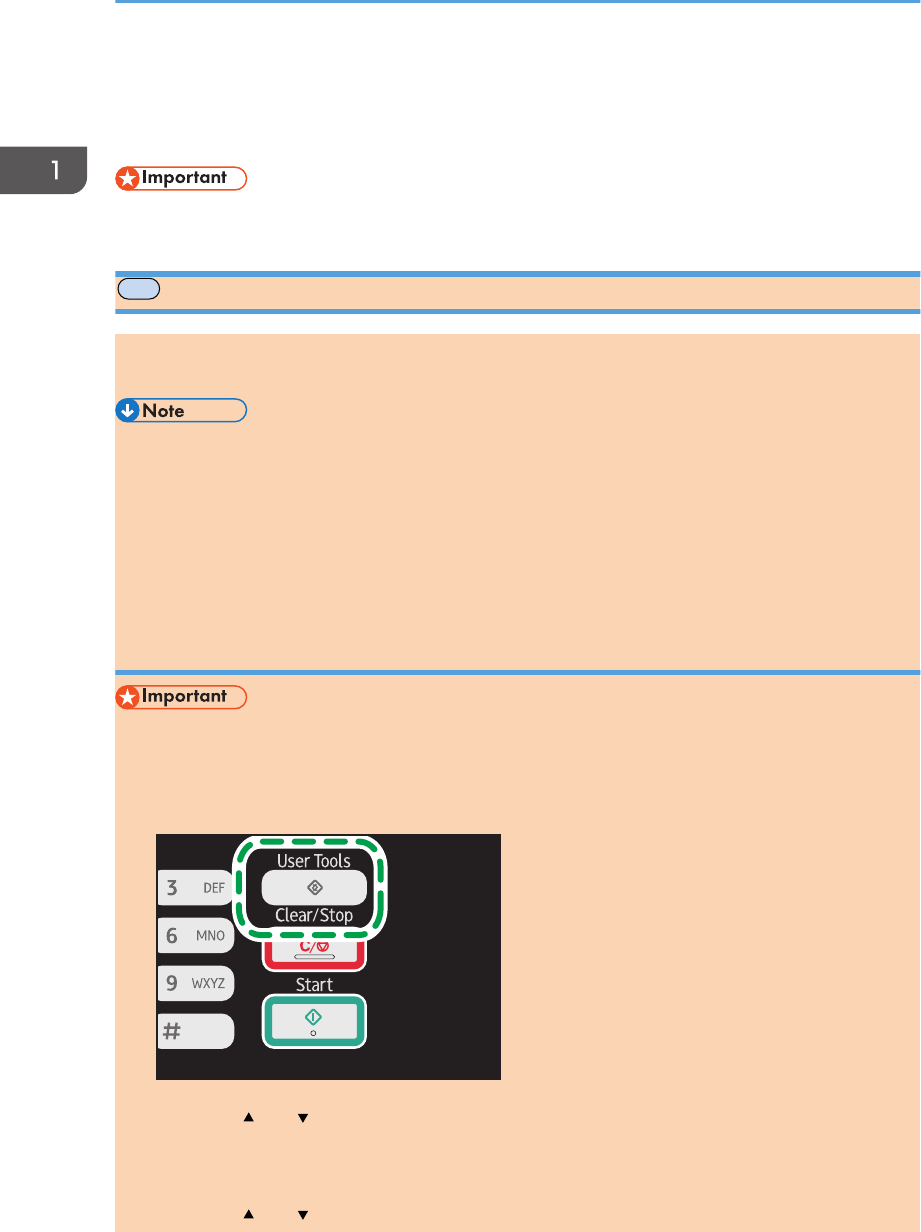
Configuring Network Settings
This section explains how to configure network settings.
• Ethernet and wireless LAN settings cannot be enabled at the same time.
MF
Configuring the IP Address Settings
The procedure for configuring network settings differs depending on whether the IP address is assigned
automatically by the network (DHCP), is specified manually.
• The password for accessing the [Admin. Tools] menu can be specified in [Admin. Tools Lock].
• Using the supplied CD-ROM, you can install drivers and configure the network settings. For details,
see Setup Guide.
• For details about configuring the IPv4 address, see the Setup Guide.
• For details about printing the configuration page, see page 150 "Printing Lists/Reports".
Specifying settings to receive an IPv6 address automatically
• A DHCP server is required on the network for the machine to receive an IPv6 address
automatically.
1. Press the [User Tools] key.
DCT845
2. Press the [ ] or [ ] key to select [Network Settings], and then press the [OK] key.
3. If you are requested to enter a password, enter the password using the number keys,
and then press the [OK] key.
4. Press the [ ] or [ ] key to select [IPv6 Configuration], and then press the [OK] key.
1. Guide to the Machine
30 opal-p2_mf2_com_user_guide_00142080_eng.xml
Draft 2014/01/07
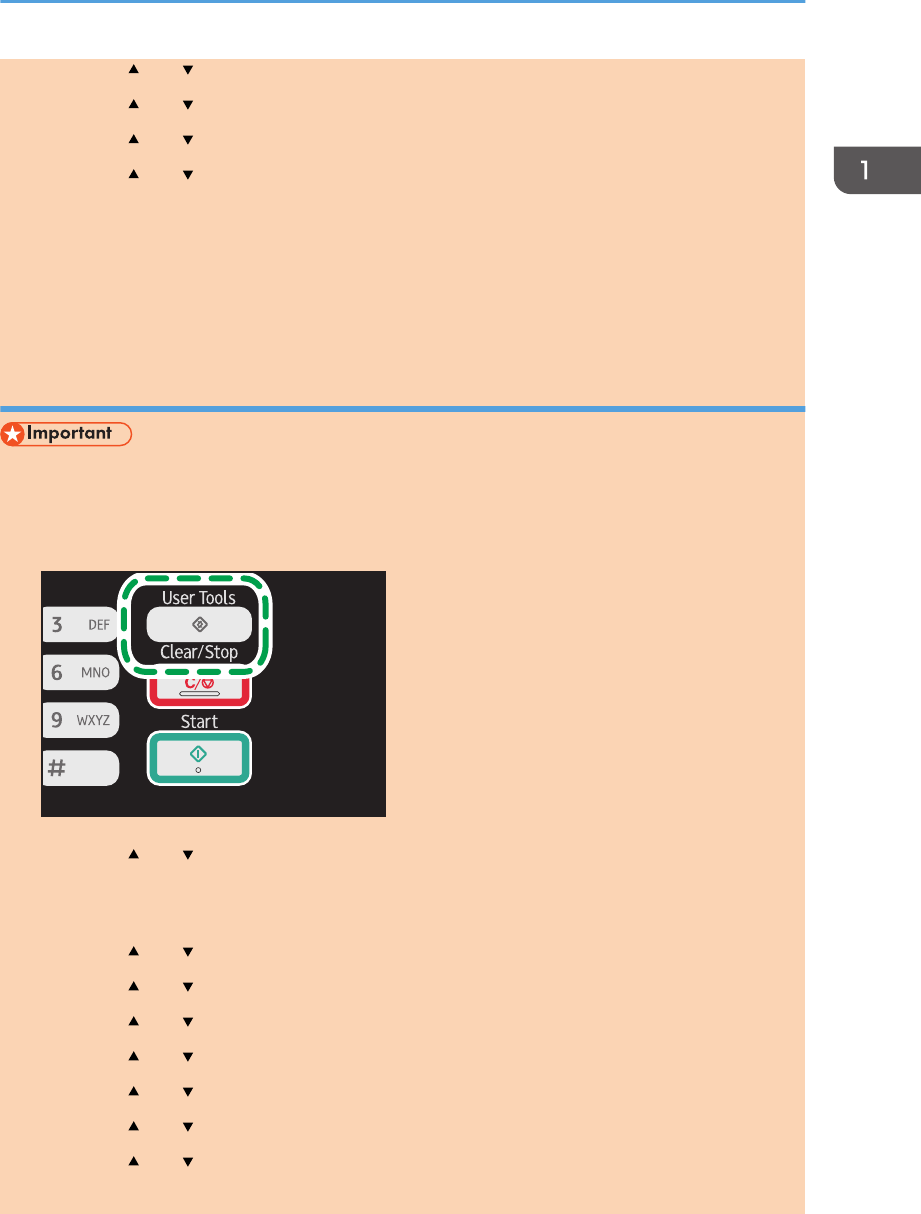
5. Press the [ ] or [ ] key to select [IPv6], and then press the [OK] key.
6. Press the [ ] or [ ] key to select [Active], and then press the [OK] key.
7. Press the [ ] or [ ] key to select [DHCP], and then press the [OK] key.
8. Press the [ ] or [ ] key to select [Active], and then press the [OK] key.
9. Press the [User Tools] key to return to the initial screen.
10. If you are requested to reboot the machine, turn off the machine, and then turn it back on.
11. Print the configuration page to confirm the setting.
The IPv6 address setting will appear under "IPv6 Configuration" on the configuration page.
Assigning the machine's IPv6 address manually
• The IPv6 address assigned to the machine must not be used by any other device on the same
network.
1. Press the [User Tools] key.
DCT845
2. Press the [ ] or [ ] key to select [Network Settings], and then press the [OK] key.
3. If you are requested to enter a password, enter the password using the number keys,
and then press the [OK] key.
4. Press the [ ] or [ ] key to select [IPv6 Configuration], and then press the [OK] key.
5. Press the [ ] or [ ] key to select [IPv6], and then press the [OK] key.
6. Press the [ ] or [ ] key to select [Active], and then press the [OK] key.
7. Press the [ ] or [ ] key to select [DHCP], and then press the [OK] key.
8. Press the [ ] or [ ] key to select [Inactive], and then press the [OK] key.
9. Press the [ ] or [ ] key to select [Manual Config. Address], and then press the [OK] key.
10. Press the [ ] or [ ] key to select [Manual Config. Address], and then press the [OK] key.
11. Enter the machine’s IPv6 address using the number keys, and then press the [OK] key.
Configuring Network Settings
opal-p2_mf2_com_user_guide_00142080_eng.xml 31
Draft 2014/01/07
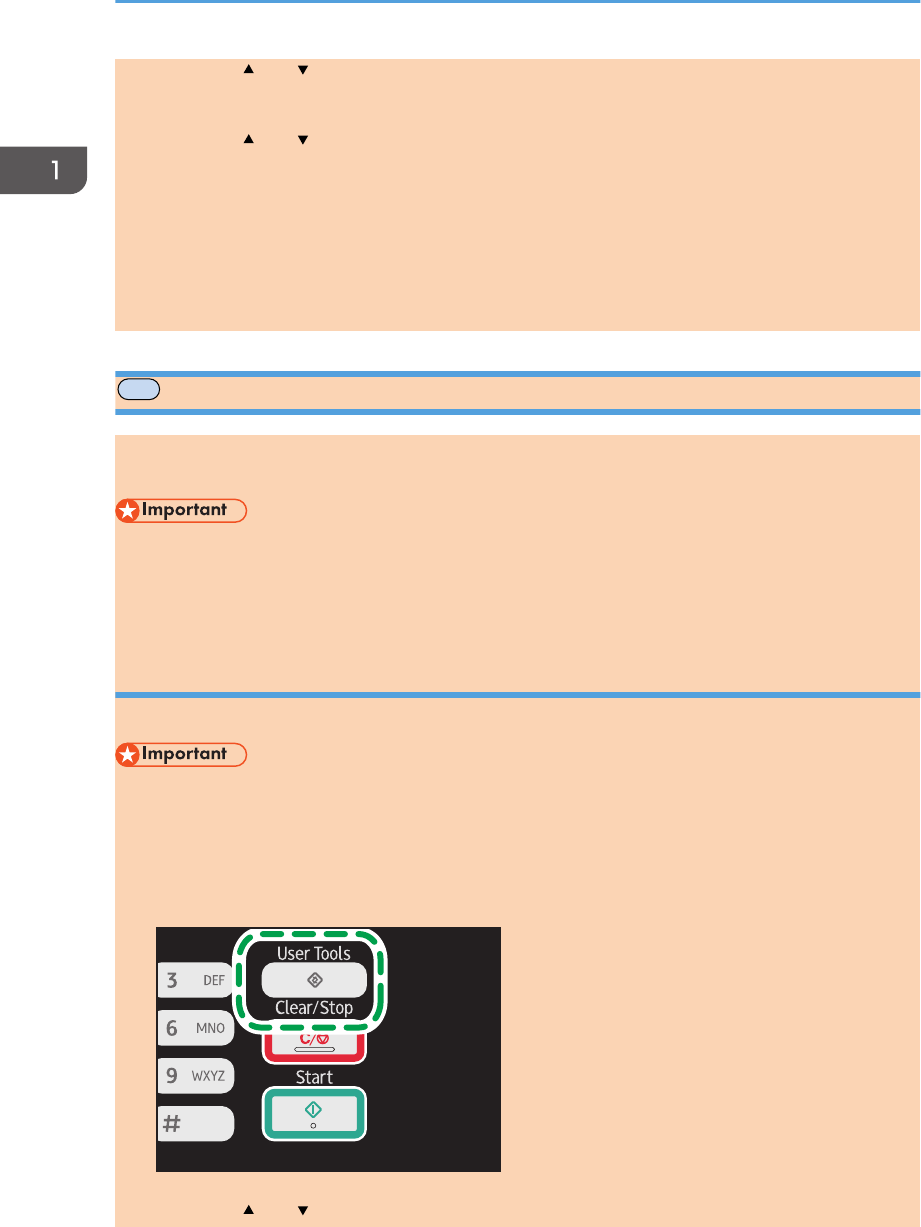
12. Press the [ ] or [ ] key to select [Prefix Length], and then press the [OK] key.
13. Enter the prefix length using the number keys, and then press the [OK] key.
14. Press the [ ] or [ ] key to select [Gateway Address], and then press the [OK] key.
15. Enter the gateway address using the number keys, and then press the [OK] key.
16. Press the [User Tools] key to return to the initial screen.
17. If you are requested to reboot the machine, turn off the machine, and then turn it back on.
18. Print the configuration page to confirm the setting.
The IPv6 address setting will appear under "IPv6 Configuration" on the configuration page.
MF
Wireless LAN Setup
This section explains how to configure the wireless LAN settings manually using the control panel. For
easy setup using WPS (Wi-Fi Protected Setup), see Wi-Fi Settings Guide.
• If [Disable] is specified for the [Wi-Fi Enable] setting, you cannot use the [Setup Wizard]. Specify
[Enable] for the [Wi-Fi Enable] setting first. If you change the [Wi-Fi Enable] setting, the machine
must be restarted.
Infrastructure mode
Use the following procedure to connect to the wireless LAN router or access point manually.
• Ensure that the router, access point, or device equipped with a wireless LAN, etc., is turned on.
• Check the authentication method and the name of the router, access point, or device equipped
with a wireless LAN (SSID/IBSS) in advance.
1. Press the [User Tools] key.
DCT845
2. Press the [ ] or [ ] key to select [Network Settings], and then press the [OK] key.
1. Guide to the Machine
32 opal-p2_mf2_com_user_guide_00142080_eng.xml
Draft 2014/01/07
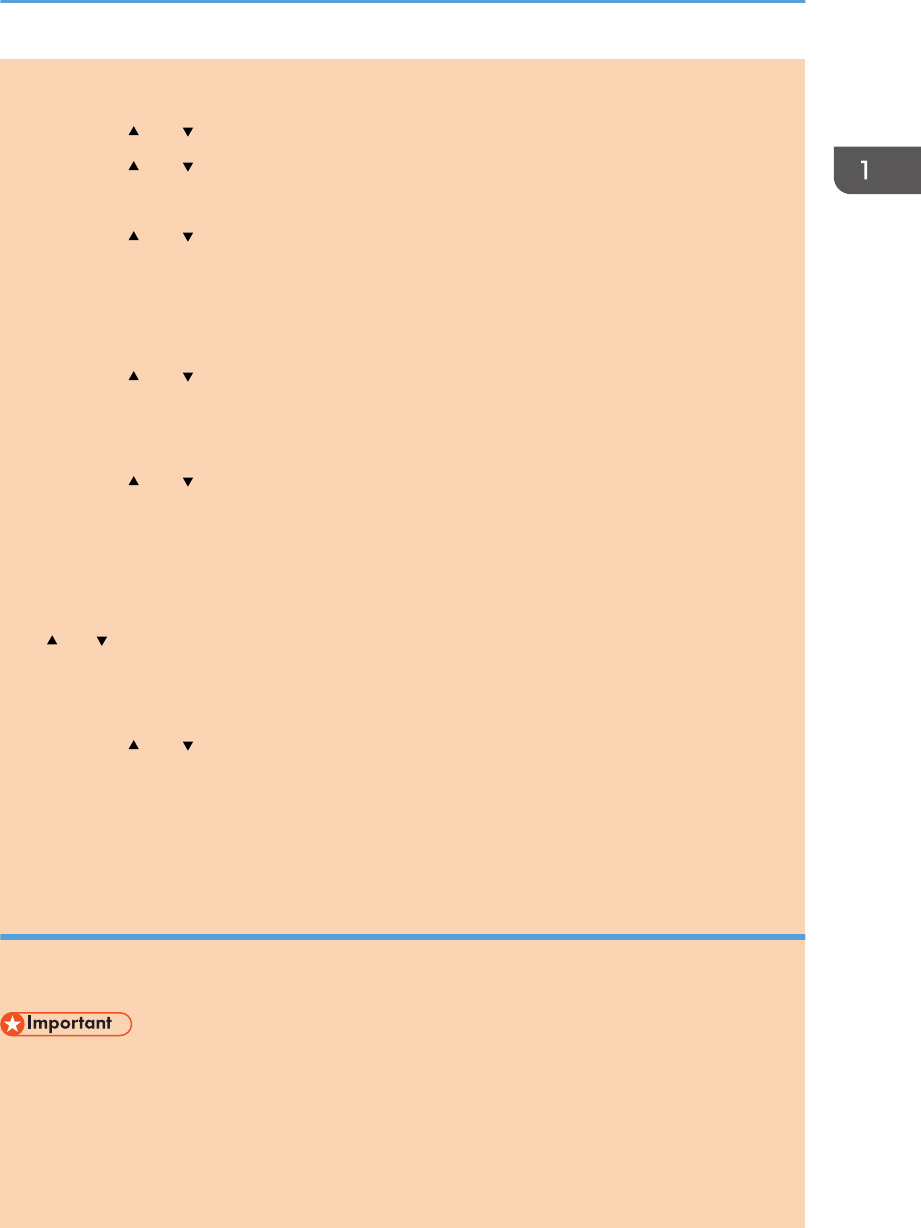
3. If you are requested to enter a password, enter the password using the number keys,
and then press the [OK] key.
4. Press the [ ] or [ ] key to select [Wi-Fi], and then press the [OK] key.
5. Press the [ ] or [ ] key to select [Setup Wizard], and then press the [OK] key.
6. Select [Infrastructure], and then press [Next].
7. Press the [ ] or [ ] key to select the destination SSID, and then press [Next].
If you cannot find the destination SSID, check if the device is turned on.
When entering the SSID, select [Input SSID], and then press [Next].
The SSID entry screen appears. Enter the SSID using the number keys, and then press [Next].
8. Press the [ ] or [ ] key to select the authentication method, and then press [Next].
Select the same method that the router or access point is using.
If you have selected [WPA2-PSK] or [Mix Mode WPA2/WPA], proceed to Step 10.
9. Press the [ ] or [ ] key to select the encryption method, and then press [Next].
Select the same method that the router or access point is using.
10. Enter the encryption key using the number keys, and then press [Connect].
If you selected [Shared Key] or [Open System] in Step 8, it is necessary to enter the ID. The ID is
used for identifying the encryption key. You can register four encryption keys (ID 1 to 4). Use the
[ ] or [ ] key to switch between the encryption key and ID settings.
11. Press [Yes].
After connecting to the network, the Wi-Fi screen is displayed.
12. Press the [ ] or [ ] key to select [Wi-Fi Status], and then press the [OK] key.
When "Connected" is displayed, the connection has been established.
When "Disconnected" is displayed, the connection has not been established. Start again from the
beginning.
Ad Hoc mode
This section explains how to connect directly to devices equipped with a wireless LAN, such as
computers on a peer-to-peer network.
• Make sure [Wi-Fi/LAN Key] is set to [Ad-Hoc Mode]. For [Wi-Fi/LAN Key], see page 155
"Network Settings".
• In Ad Hoc network, every device must be manually assigned an IP address for TCP/IP if there is no
DHCP server.
• In Ad Hoc mode, only Open System or WEP encryption is supported. WPA2-PSK and Mix Mode
WPA2/WPA authentication methods are not supported.
Configuring Network Settings
opal-p2_mf2_com_user_guide_00142080_eng.xml 33
Draft 2014/01/07
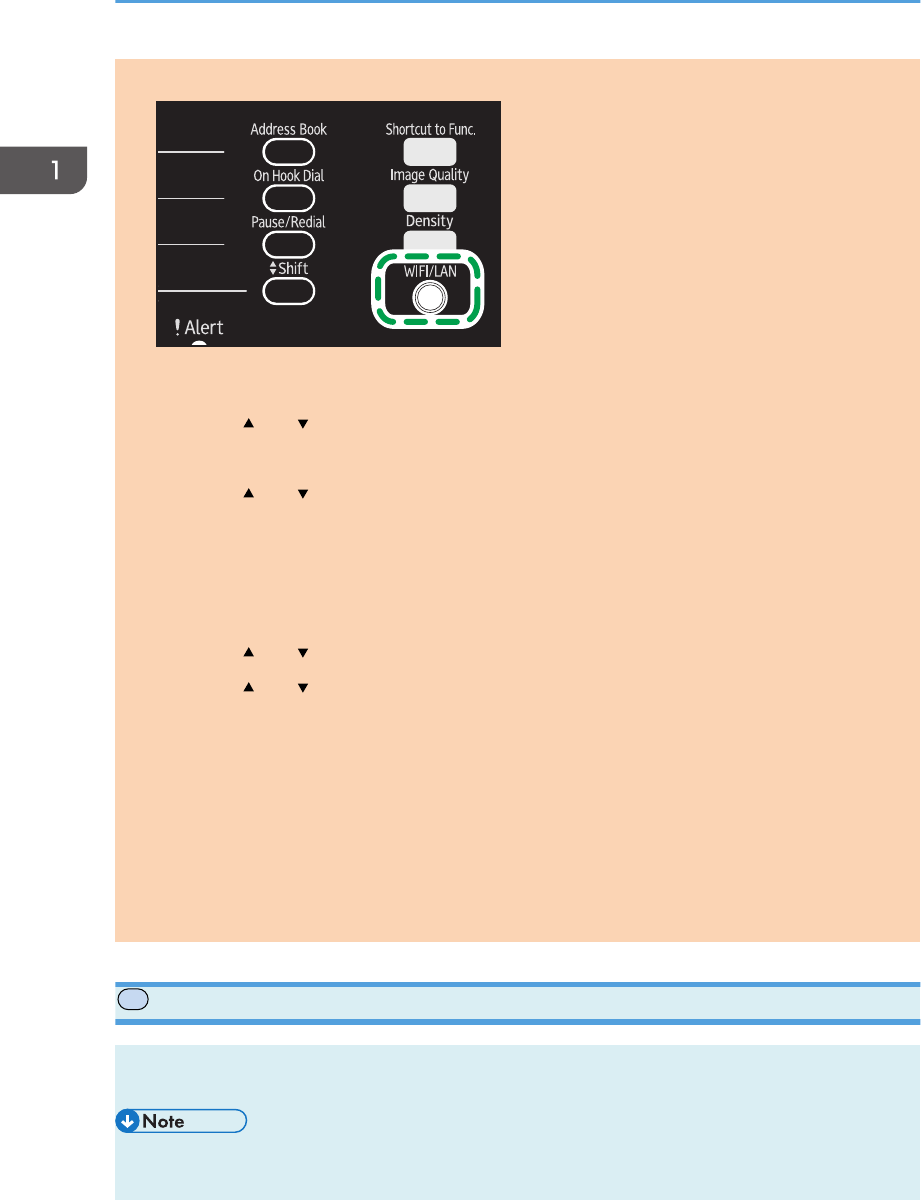
1. Press the [WIFI/LAN] key.
DCT853
If [Disable] is specified for the [Wi-Fi Enable] setting, you cannot use the [WIFI/LAN] key.
2. Press the [ ] or [ ] key to select a communication channel, and then press [Next].
Select a channel that corresponds to the device that you are going to connect with.
3. Press the [ ] or [ ] key to select the destination device name (IBSS), and then press
[Next].
If you cannot find the destination, check that the device is turned on.
When entering the device name, select [Input SSID], and then press [Next]. The SSID entry screen
appears. Enter the device name using the number keys, and then press [Next].
4. Press the [ ] or [ ] key to select the authentication method, and then press [Next].
5. Press the [ ] or [ ] key to select the encryption method, and then press [Next].
6. Enter the encryption key and ID using the number keys, and then press [Connect].
The ID is used for identifying the encryption key. You can register four encryption keys (ID 1 to 4).
7. Press [Yes].
8. Check the connection using [Wi-Fi Status].
When "Connected" is displayed, the connection has been established.
When "Disconnected" is displayed, the connection has not been established. Start again from the
beginning.
P
Configuring the IP Address Settings Using the Smart Organizing Monitor
The procedure for configuring network settings differs depending on whether IP address information is
assigned automatically by the network (DHCP), or manually.
• Using the supplied CD-ROM, you can install drivers and configure the network settings. For details,
see Setup Guide.
1. Guide to the Machine
34 opal-p2_mf2_com_user_guide_00142080_eng.xml
Draft 2014/01/07
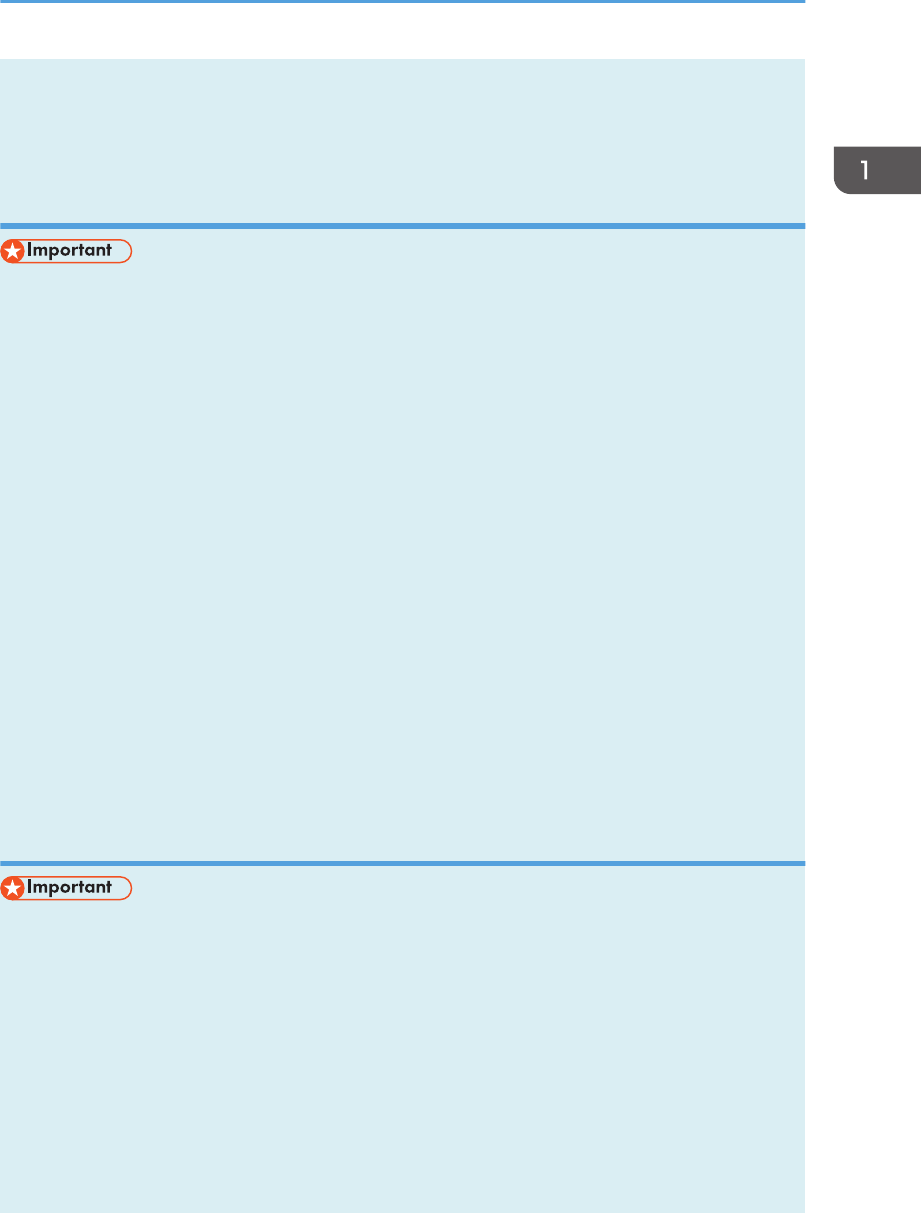
• For details about configuring the IPv4 address, see the Setup Guide.
• For details about printing the configuration page, see page 198 "Using Smart Organizing
Monitor".
Specifying settings to receive an IPv6 address automatically
• A DHCP server is required on the network for the machine to receive an IPv6 address
automatically.
1. On the [Start] menu, click [All Programs].
2. Click [Smart Organizing Monitor for SP xxx Series].
3. Click [Smart Organizing Monitor Status].
If the machine you are using is not selected, click [Connect Printer], and then select the machine's
model.
4. Click the [User Tools] tab.
5. Click [Printer Configuration].
6. Enter the access code, and then click [OK].
The default access code is "Admin". Enter "Admin" if it has not been changed. Case is significant.
7. Click the [IPv6] tab.
8. Select [Enable] in [IPv6 DHCP:].
9. Select [Enable] in [IPv6], and the click [OK].
10. Click [Close].
Assigning the machine's IPv6 address manually
• The IPv6 address assigned to the machine must not be used by any other device on the same
network.
1. On the [Start] menu, click [All Programs].
2. Click [Smart Organizing Monitor for SP xxx Series].
3. Click [Smart Organizing Monitor Status].
If the machine you are using is not selected, click [Connect Printer], and then select the machine's
model.
4. Click the [User Tools] tab.
5. Click [Printer Configuration].
Configuring Network Settings
opal-p2_mf2_com_user_guide_00142080_eng.xml 35
Draft 2014/01/07
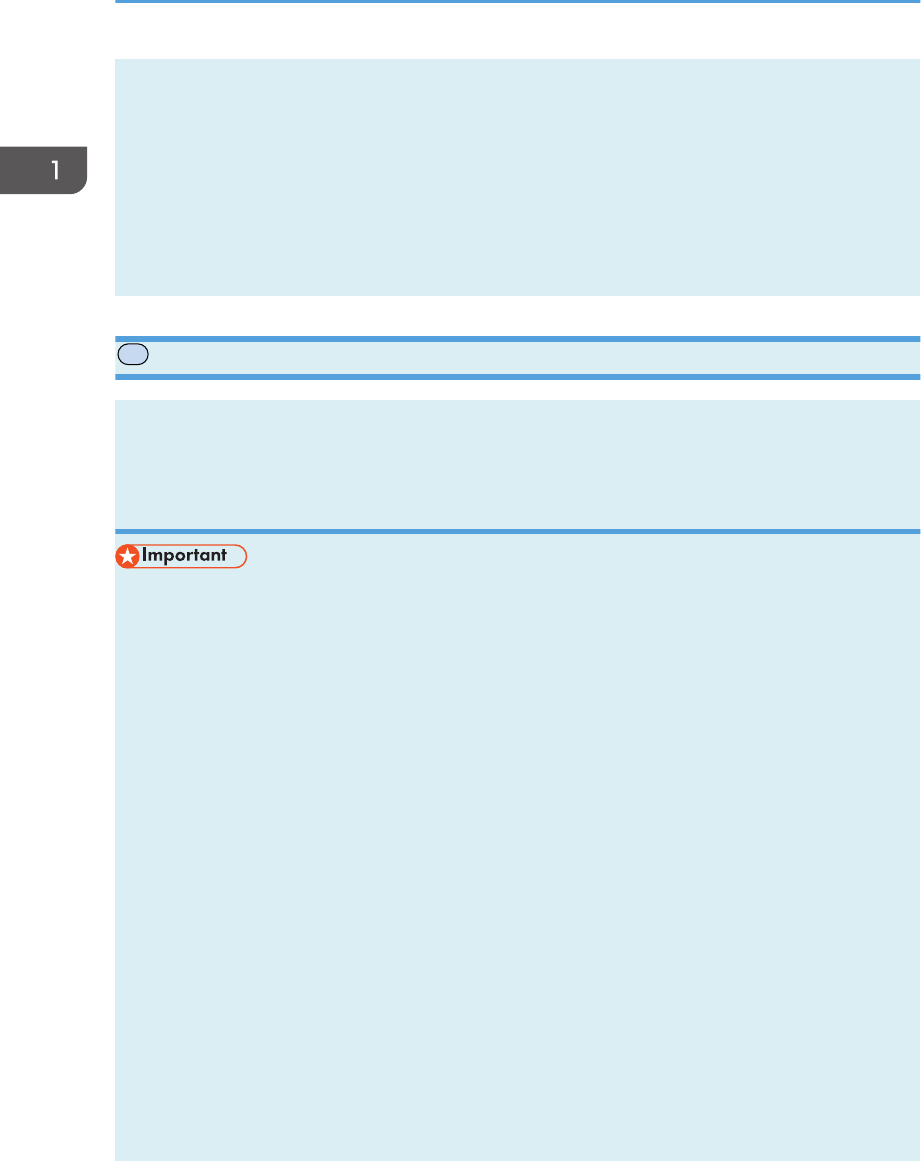
6. Enter the access code, and then click [OK].
The default access code is "Admin". Enter "Admin" if it has not been changed. Case is significant.
7. Click the [IPv6] tab.
8. Select [Disable] in [IPv6 DHCP:].
9. Select [Enable] in [IPv6].
10. Enter values in [Manual address:], [Prefix length:], and [Gateway:], and then click [OK].
11. Click [Close].
P
Wireless LAN Setup
This section explains how to configure the wireless LAN settings manually using Smart Organizing
Monitor. For easy setup using WPS (Wi-Fi Protected Setup), see Wi-Fi Settings Guide.
Configuring the Infrastructure mode using Smart Organizing Monitor
• Ensure that the router, access point, or device equipped with a wireless LAN, etc., is turned on.
• Check the authentication method and the name of the router, access point, or device equipped
with a wireless LAN (SSID/IBSS) in advance.
1. On the [Start] menu, click [All Programs].
2. Click [Smart Organizing Monitor for SP xxx Series].
3. Click [Smart Organizing Monitor Status].
If the machine you are using is not selected, click [Connect Printer], and then select the machine's
model.
4. Click the [User Tools] tab.
5. Click [Printer Configuration].
6. Enter the access code, and then click [OK].
The default access code is "Admin". Enter "Admin" if it has not been changed. Case is significant.
7. On the [Network 1] tab, set [Wireless Function:] to [Active].
8. On the [Wireless] tab, set [Manual Setup] to [Configuration Method].
9. In [SSID], enter the SSID.
10. Set [Communication Mode] to [Infrastructure].
11. In the [Authentication] box, select the authentication method.
1. Guide to the Machine
36 opal-p2_mf2_com_user_guide_00142080_eng.xml
Draft 2014/01/07
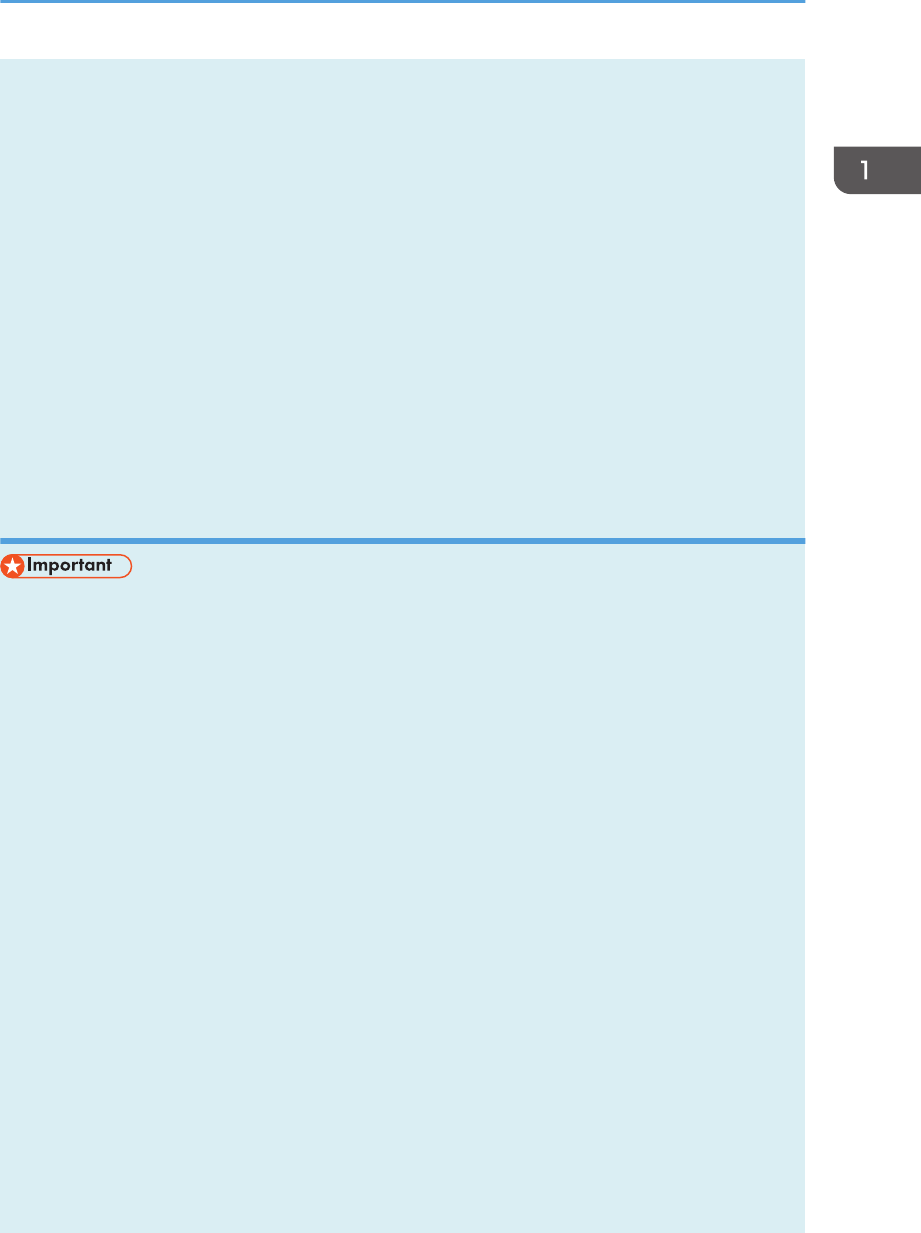
12. In the [Encryption] box, select the encryption method.
If you have selected [WPA2-PSK] or [Mix Mode WPA/WPA2] in [Authentication], proceed to
Step 17.
13. In the [WEP Key Length] box, select [64 bit] or [128 bit].
14. In the [WEP Transmit Key ID] box, select the ID.
15. In the [WEP Key Format] box, select [Hexadecimal] or [ASCII].
16. In [WEP Key], enter the password.
If you have specified [WEP key], proceed to Step 18.
17. In [WPA Passphrase], enter the password.
18. Click [Connect].
19. Click [OK].
20. Click [Close].
Configuring the Ad hoc mode using Smart Organizing Monitor
• In Ad Hoc network, every device must be manually assigned an IP address for TCP/IP if there is no
DHCP server.
• In Ad Hoc mode, only Open System or WEP encryption is supported. WPA2-PSK and Mix Mode
WPA2/WPA authentication methods are not supported.
1. On the [Start] menu, click [All Programs].
2. Click [Smart Organizing Monitor for SP xxx Series].
3. Click [Smart Organizing Monitor Status].
If the machine you are using is not selected, click [Connect Printer], and then select the machine's
model.
4. Click the [User Tools] tab.
5. Click [Printer Configuration].
6. Enter the access code, and then click [OK].
The default access code is "Admin". Enter "Admin" if it has not been changed. Case is significant.
7. On the [Network 1] tab, set [Wireless Function:] to [Active].
8. On the [Wireless] tab, set [Manual Setup] to [Configuration Method].
9. In [SSID], enter the SSID.
10. Set [Communication Mode] to [Ad-Hoc].
11. In the [Ad-Hoc Channel] box, select the channel number.
12. In the [Authentication] box, select the authentication method.
Configuring Network Settings
opal-p2_mf2_com_user_guide_00142080_eng.xml 37
Draft 2014/01/07
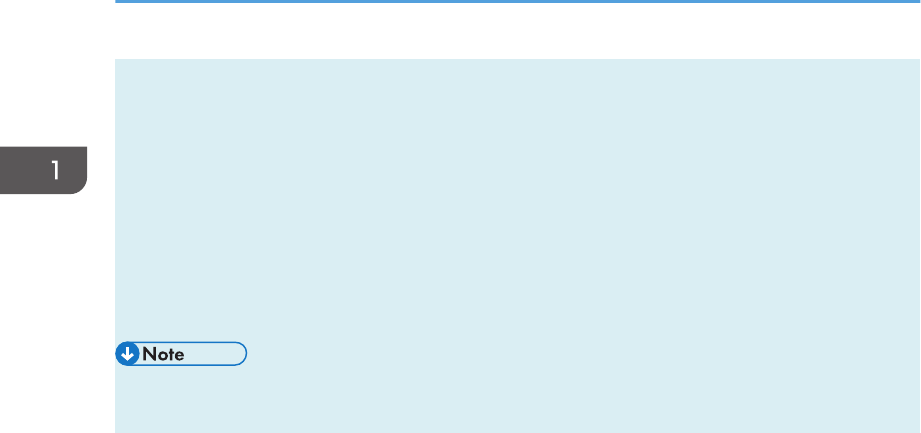
13. In the [Encryption] box, select the encryption method.
14. In the [WEP Key Length] box, select [64 bit] or [128 bit].
15. In the [WEP Transmit Key ID] box, select the ID.
16. In the [WEP Key Format] box, select [Hexadecimal] or [ASCII].
17. In [WEP Key], enter the password.
18. Click [Connect].
19. Click [OK].
20. Click [Close].
• For details about how to use Smart Organizing Monitor, see page 198 "Using Smart Organizing
Monitor".
1. Guide to the Machine
38 opal-p2_mf2_com_user_guide_00142080_eng.xml
Draft 2014/01/07

2. Loading Paper
Supported Paper
Paper Size
• A4
• 81/2 " × 11 " (Letter)
• 81/2 " × 14 " (Legal)
• B5
• 51/2 " × 81/2 " (Half Letter)
• 71/4 " × 101/2 " (Executive)
• A5
• A6
• B6
• 16K (197 × 273 mm)
• 16K (195 × 270 mm)
• 16K (184 × 260 mm)
• Custom Paper Size
The following paper sizes are supported as custom paper sizes:
• Width
Tray1: Approximately 100-216 mm (3.9-8.5 inches)
Bypass Tray: Approximately 90-216 mm (3.6-8.5 inches)
• Length
Approximately 148-356 mm (5.8-14 inches)
Paper Type
• Plain Paper (65-99 g/m2 (17-26 lb.))
• Recycled Paper (75-90 g/m2 (20-24 lb.))
• Thin Paper (52-64 g/m2 (14-17 lb.))
• Thick Paper (100-130 g/m2 (26.6-34 lb.))
Paper Capacity
• Tray1
150 sheets
(70 g/m2, 19 lb.)
opal-p2_mf2_com_user_guide_00142082_eng.xml 39
Draft 2014/01/07

• Bypass Tray
1 sheets
(70 g/m2, 19 lb.)
2. Loading Paper
40 opal-p2_mf2_com_user_guide_00142082_eng.xml
Draft 2014/01/07
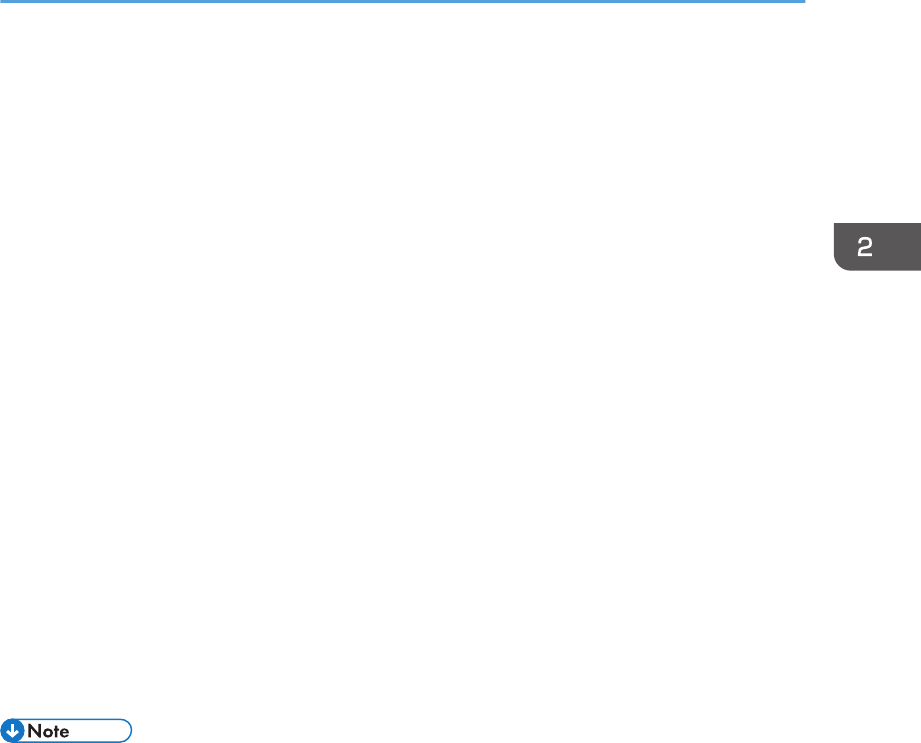
Non-Recommended Paper Types
Do not use the following types of paper:
• Ink-jet printer paper
• GelJet special paper
• Bent, folded, or creased paper
• Curled or twisted paper
• Wrinkled paper
• Damp paper
• Dirty or damaged paper
• Paper that is dry enough to emit static electricity
• Paper that has already been printed onto, except a preprinted letterhead paper.
Malfunctions are especially likely when using paper printed on by other than a laser printer
(e.g.monochrome and color copiers, ink-jet printers, etc.)
• Special paper, such as thermal paper and carbon paper
• Paper weighing heavier or lighter than the limit
• Paper with windows, holes, perforations, cutouts, or embossing
• Adhesive label paper on which glue or base paper is exposed
• Paper with clips or staples
• When loading paper, take care not to touch the surface of the paper.
• Even if paper is adequate for the machine, poorly stored paper can cause paper misfeeds, print
quality degradation, or malfunctions.
Non-Recommended Paper Types
opal-p2_mf2_com_user_guide_00142083_eng.xml 41
Draft 2014/01/07
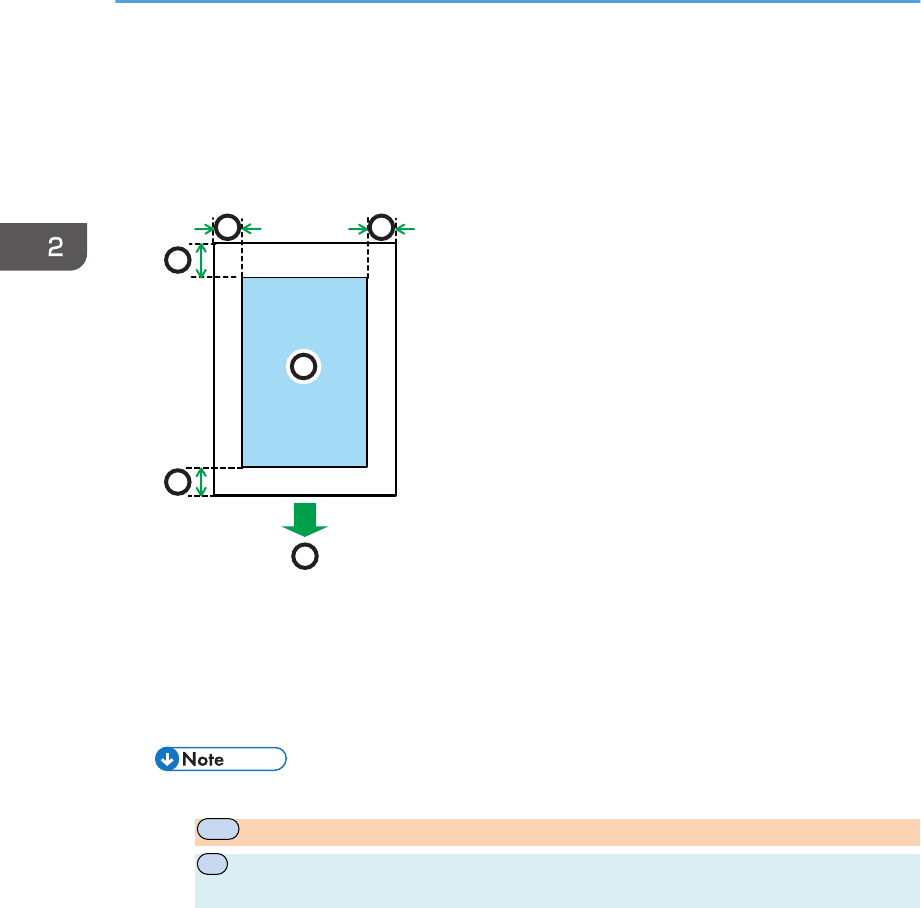
Print Area
The diagram below shows the area of the paper that the machine can print on.
From the printer driver
CHZ904
2
3
3
1
44
1. Print area
2. Feed direction
3. Approx. 4.2 mm (0.2 inches)
4. Approx. 4.2 mm (0.2 inches)
• The print area may vary depending on the paper size and printer driver settings.
•
MF
Adjust the print position by specifying [Printer Registration] in [System Settings].
•
P
To adjust the print position, specify [Registration: Tray 1] or [Registration: Bypass Tray] on
the [Maintenance] tab in Smart Organizing Monitor.
2. Loading Paper
42 opal-p2_mf2_com_user_guide_00142084_eng.xml
Draft 2014/01/07
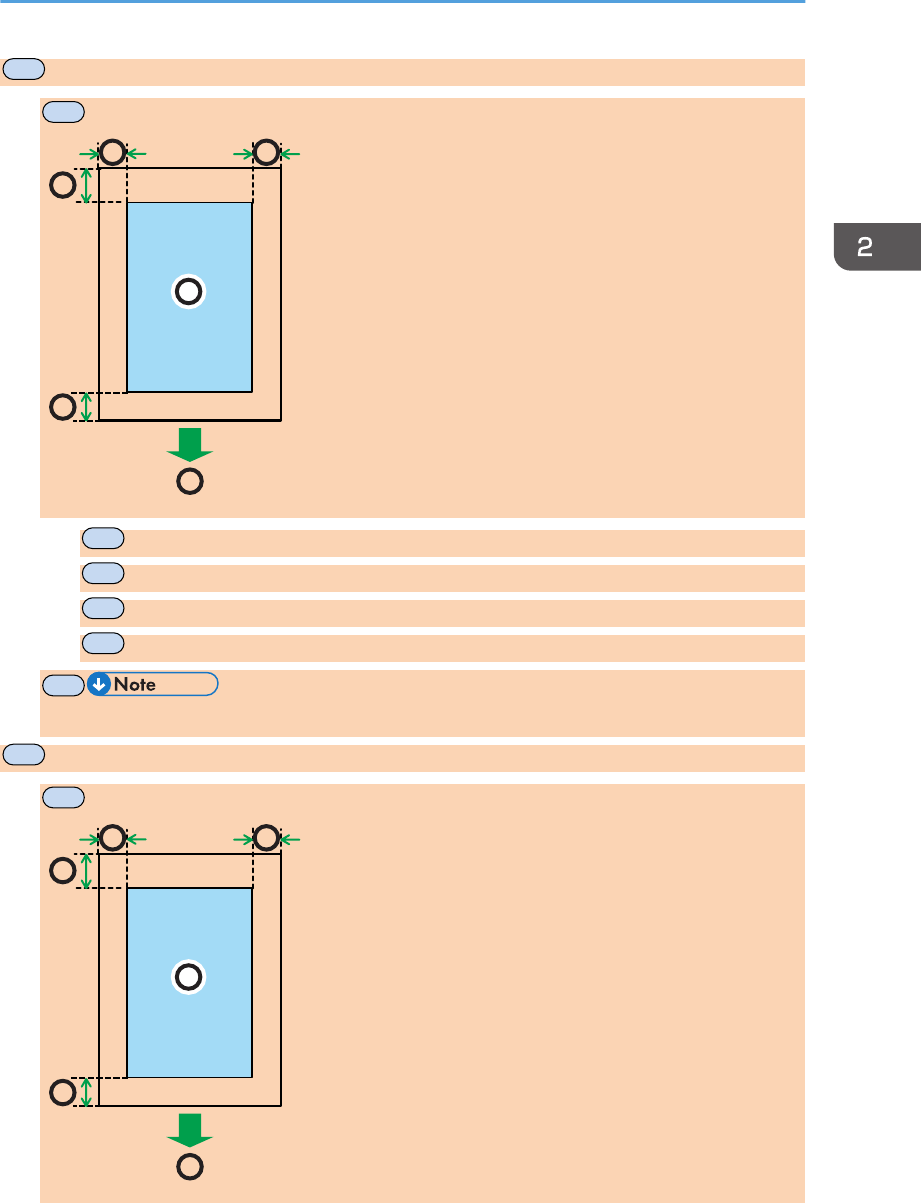
MF
Copier function
MF
CHZ904
2
3
3
1
44
1.
MF
Print area
2.
MF
Feed direction
3.
MF
Approx. 4 mm (0.2 inches)
4.
MF
Approx. 3 mm (0.1 inches)
MF
• The print area may vary depending on the paper size.
MF
Fax function
MF
CHZ904
2
3
3
1
44
Print Area
opal-p2_mf2_com_user_guide_00142084_eng.xml 43
Draft 2014/01/07

1.
MF
Print area
2.
MF
Feed direction
3.
MF
Approx. 4.2 mm (0.2 inches)
4.
MF
Approx. 2 mm (0.08 inches)
MF
• The print area may vary depending on the paper size.
2. Loading Paper
44 opal-p2_mf2_com_user_guide_00142084_eng.xml
Draft 2014/01/07
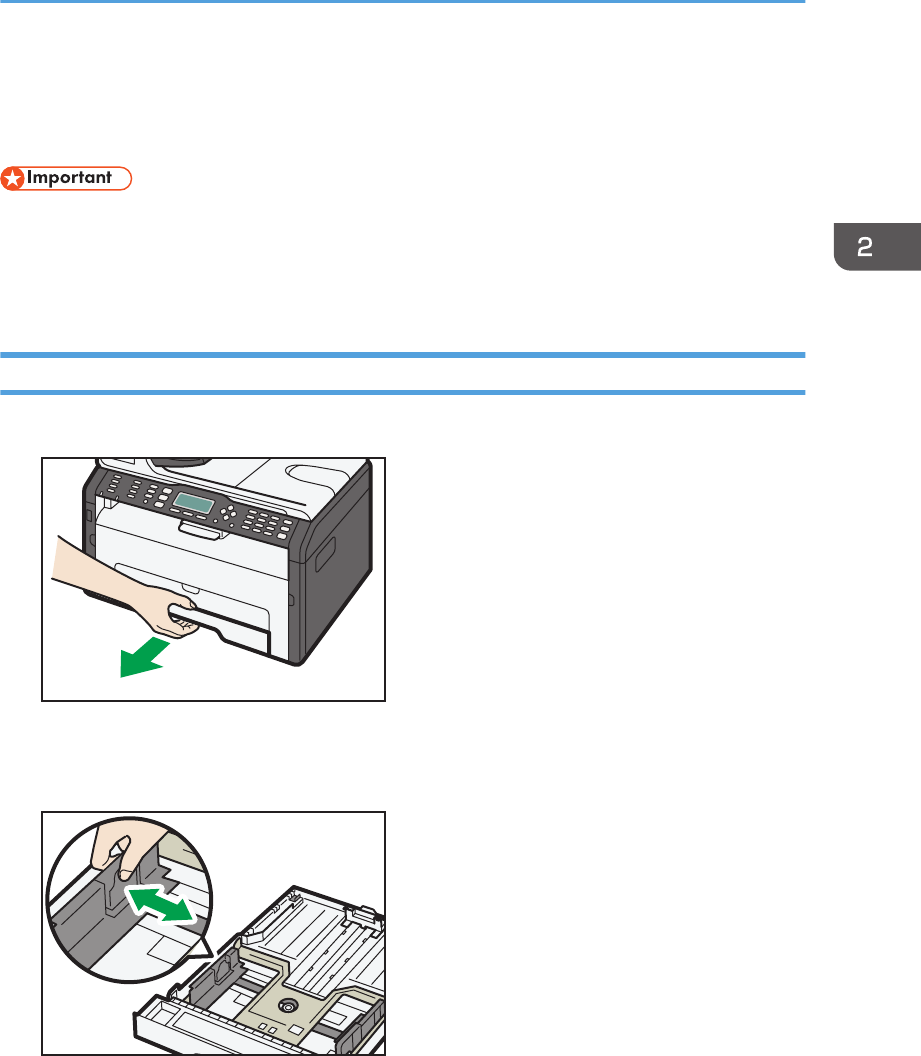
Loading Paper
Load a stack of paper for printing in the input tray.
• When loading paper, be sure to configure the paper size and paper type for the bypass tray and
Tray 1. When printing a document, specify the paper size and paper type and select the paper
tray in the printer driver so that the settings configured when paper is loaded can be used for
printing.
Loading Paper into Tray 1
1. Pull Tray 1 out slowly, and then remove it using both hands.
DCT063
Place the tray on a flat surface.
2. Pinch the clips on the side paper guides and slide them to match the standard size.
DCT030
Loading Paper
opal-p2_mf2_com_user_guide_00142085_eng.xml 45
Draft 2014/01/07
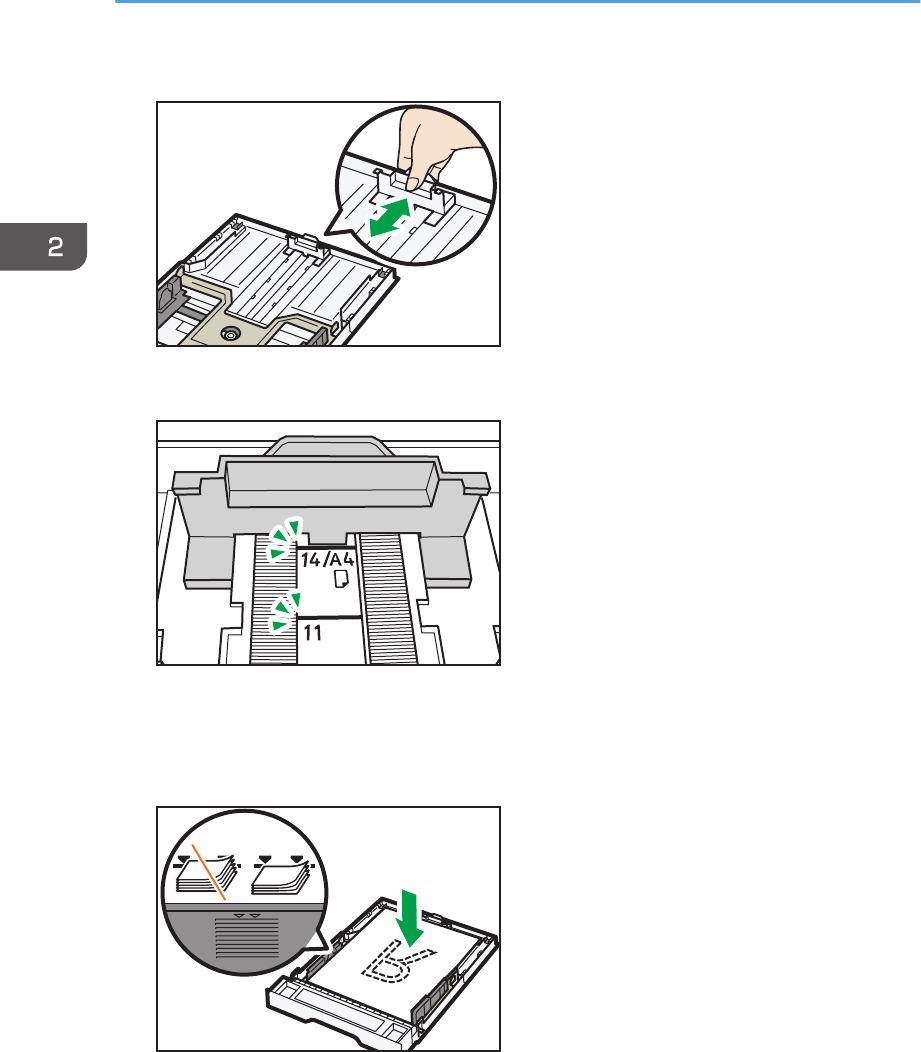
3. Pinch the end paper guide and slide it inward to match the standard size.
DCT031
When loading A4 or letter size paper, align the paper guide to the following position:
DCT871
4. Fan the paper before loading it in the tray.
5. Load the new paper stack print side down.
Make sure paper is not stacked higher than the upper limit marked inside the tray.
DCT032
2. Loading Paper
46 opal-p2_mf2_com_user_guide_00142085_eng.xml
Draft 2014/01/07
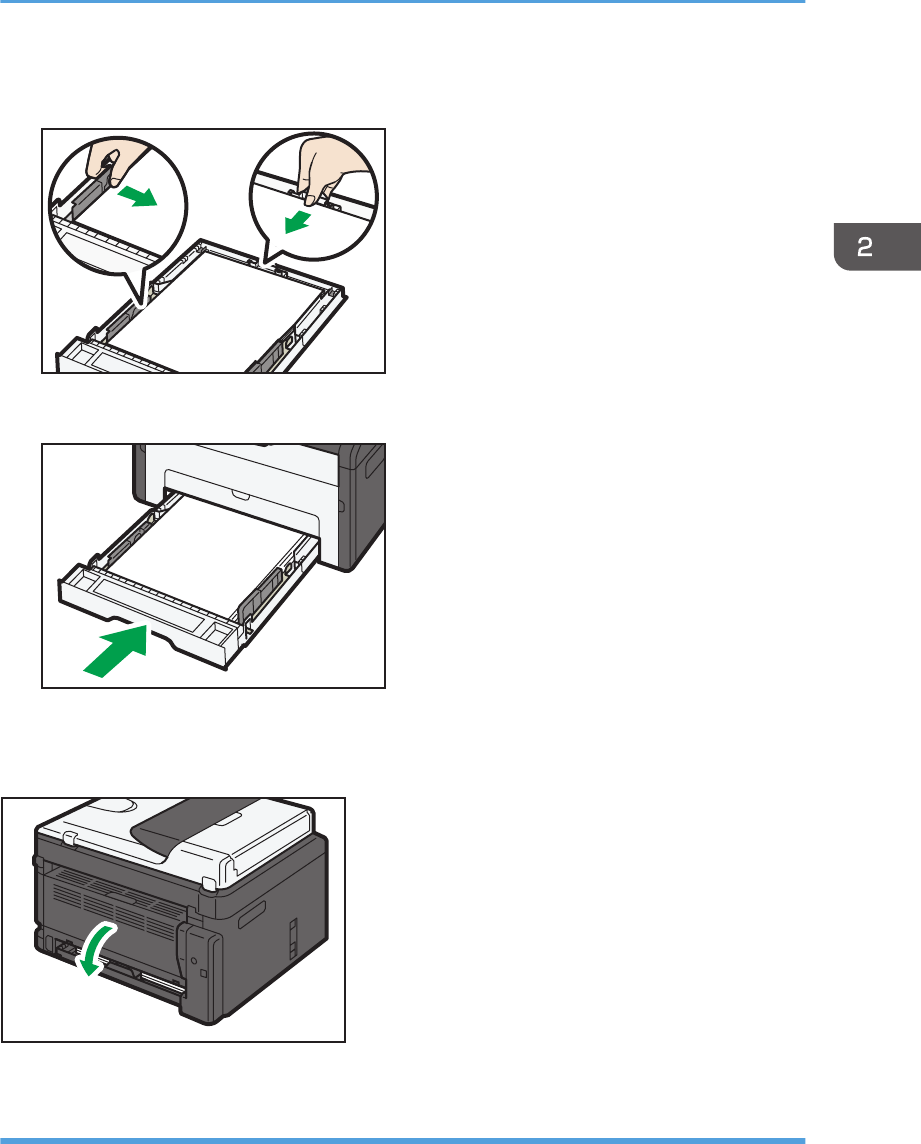
6. Check there are no gaps between the paper and the paper guides (both side and end
paper guides).
DCT049
7. Carefully push Tray 1 straight into the machine.
DCT011
To avoid paper jams, make sure the tray is securely inserted.
To deliver the sheets face up, open the rear cover.
DCT037
Extending Tray 1 to load paper
1. Pull Tray 1 out slowly, and then remove it using both hands.
Loading Paper
opal-p2_mf2_com_user_guide_00142085_eng.xml 47
Draft 2014/01/07
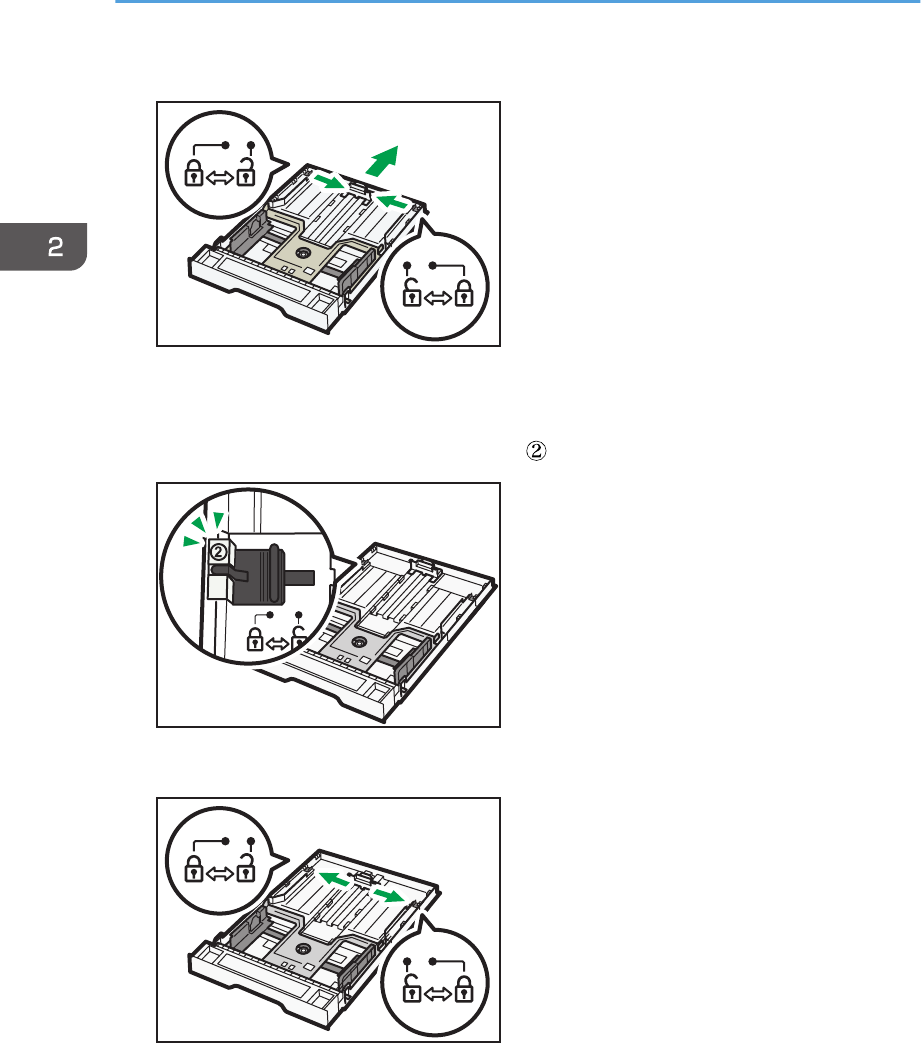
2. Release the extender locks on both sides of the tray, and then pull out the extender.
DCT034
Make sure the extender's inner surface and the scale are aligned.
You can adjust the length of the extender in three steps. When using A4 or letter size paper, adjust
the length to the position indicated by the mark " " in the tray.
DCT042
3. Pull out the extender and lock it.
DCT033
4. Follow Steps 2 to 7 in "Loading Paper into Tray 1".
2. Loading Paper
48 opal-p2_mf2_com_user_guide_00142085_eng.xml
Draft 2014/01/07
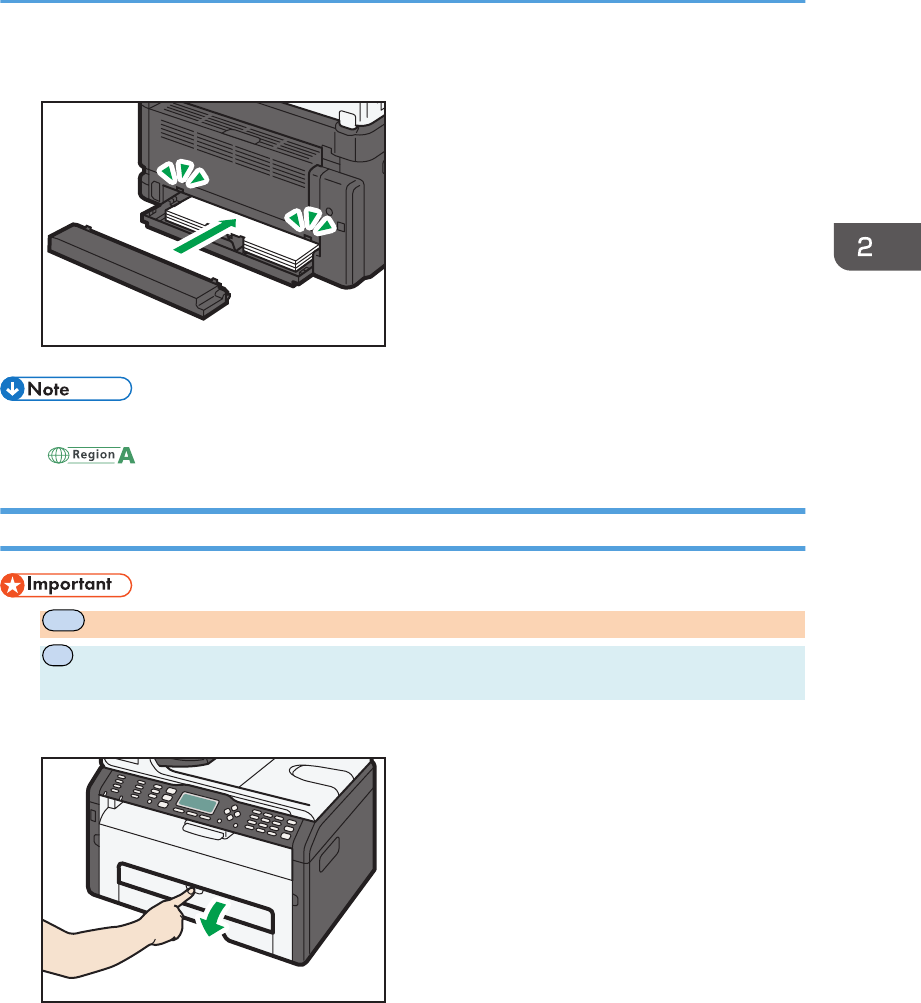
5. Attach the tray cover.
DCT038
• Legal paper or custom-size paper longer than A4 must be loaded without attaching the tray cover.
( only)
Loading Paper into Bypass Tray
•
MF
Do not load paper in the bypass tray unless the message "Ready" appears.
•
P
Do not load paper in the bypass tray unless the message "Ready" appears in Smart
Organizing Monitor.
1. Open the bypass tray.
DCT029
Loading Paper
opal-p2_mf2_com_user_guide_00142085_eng.xml 49
Draft 2014/01/07
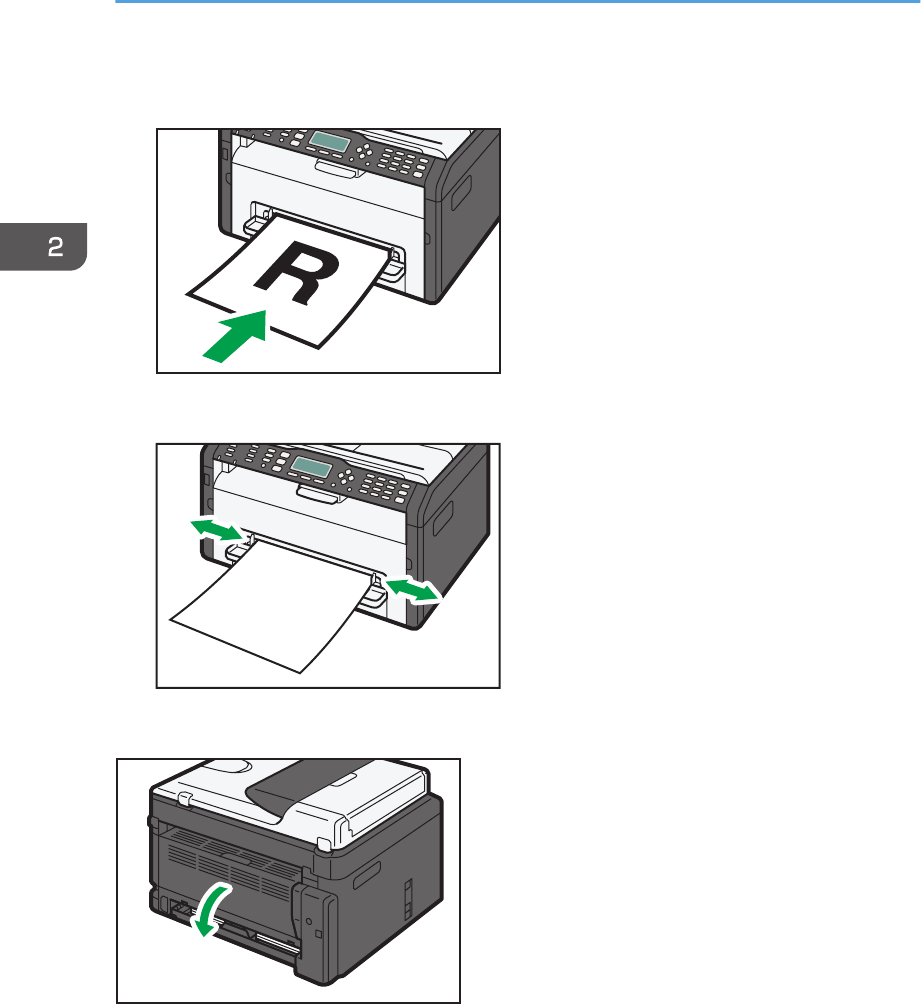
2. Slide the side guides outward, load paper with the print side up, and then push in until it
stops against the machine.
DCT013
3. Adjust the side guides to the paper width.
DCT014
To deliver the sheets face up, open the rear cover.
DCT037
2. Loading Paper
50 opal-p2_mf2_com_user_guide_00142085_eng.xml
Draft 2014/01/07
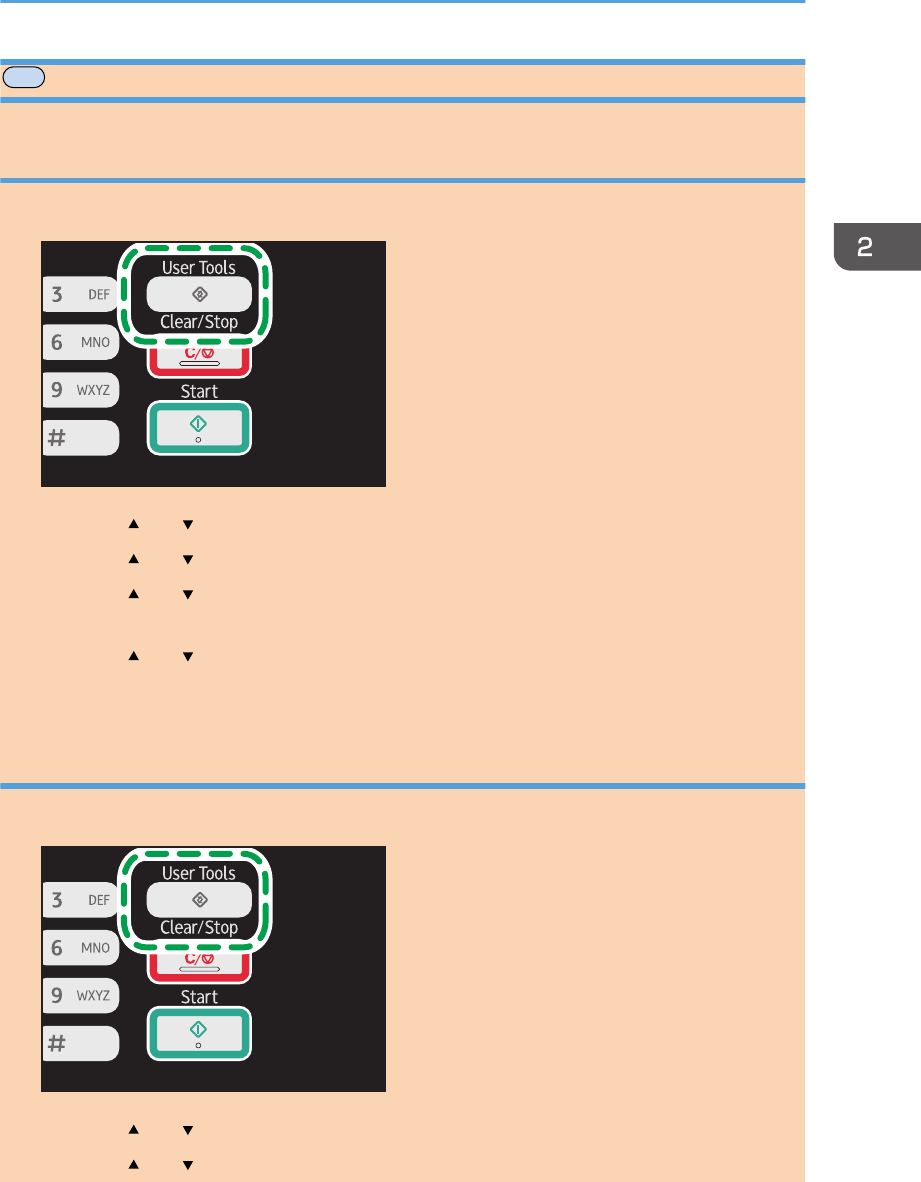
MF
Specifying Paper Type and Paper Size Using Control Panel
Specifying the paper type
1. Press the [User Tools] key.
DCT845
2. Press the [ ] or [ ] key to select [System Settings], and then press the [OK] key.
3. Press the [ ] or [ ] key to select [Tray Paper Settings], and then press the [OK] key.
4. Press the [ ] or [ ] key to select the paper type setting for the desired tray, and then
press the [OK] key.
5. Press the [ ] or [ ] key to select the desired paper type, and then press the [OK] key.
6. Press the [User Tools] key to return to the initial screen.
Specifying the standard paper size
1. Press the [User Tools] key.
DCT845
2. Press the [ ] or [ ] key to select [System Settings], and then press the [OK] key.
3. Press the [ ] or [ ] key to select [Tray Paper Settings], and then press the [OK] key.
Loading Paper
opal-p2_mf2_com_user_guide_00142085_eng.xml 51
Draft 2014/01/07
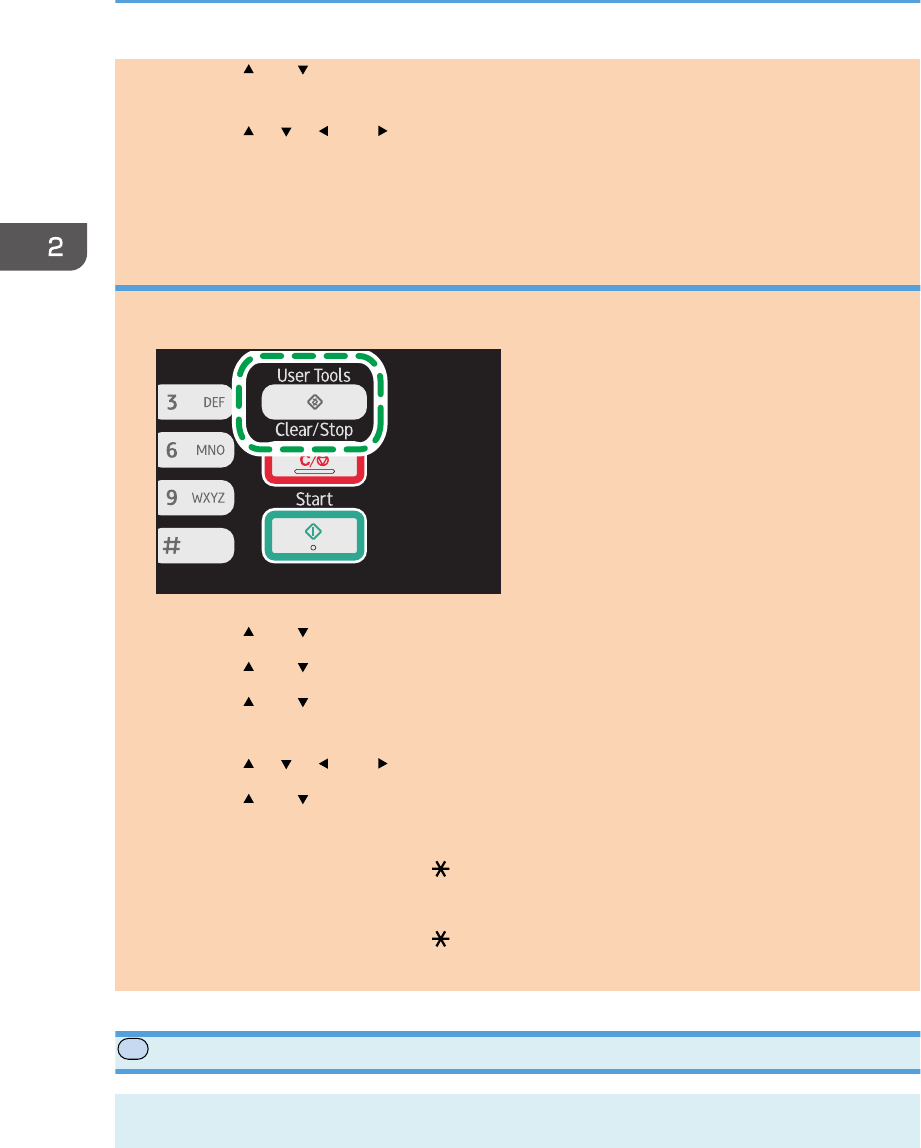
4. Press the [ ] or [ ] key to select the paper size setting for the desired tray, and then press
the [OK] key.
5. Press the [ ], [ ], [ ], or [ ] key to select the desired paper size, and then press the [OK]
key.
6. Press the [User Tools] key to return to the initial screen.
Specifying a custom paper size
1. Press the [User Tools] key.
DCT845
2. Press the [ ] or [ ] key to select [System Settings], and then press the [OK] key.
3. Press the [ ] or [ ] key to select [Tray Paper Settings], and then press the [OK] key.
4. Press the [ ] or [ ] key to select the paper size setting for the desired tray, and then press
the [OK] key.
5. Press the [ ], [ ], [ ], or [ ] key to select [Custom Size], and then press the [OK] key.
6. Press the [ ] or [ ] key to select [mm] or [inch], and then press the [OK] key.
7. Enter the width using number keys, and then press the [OK] key.
To enter a decimal point, press the [ ] key.
8. Enter the length using number keys, and then press the [OK] key.
To enter a decimal point, press the [ ] key.
9. Press the [User Tools] key to return to the initial screen.
P
Specifying Paper Type and Paper Size Using Smart Organizing Monitor
The procedure in this section is an example based on Windows 7. The actual procedure may vary
depending on the operating system you are using.
2. Loading Paper
52 opal-p2_mf2_com_user_guide_00142085_eng.xml
Draft 2014/01/07
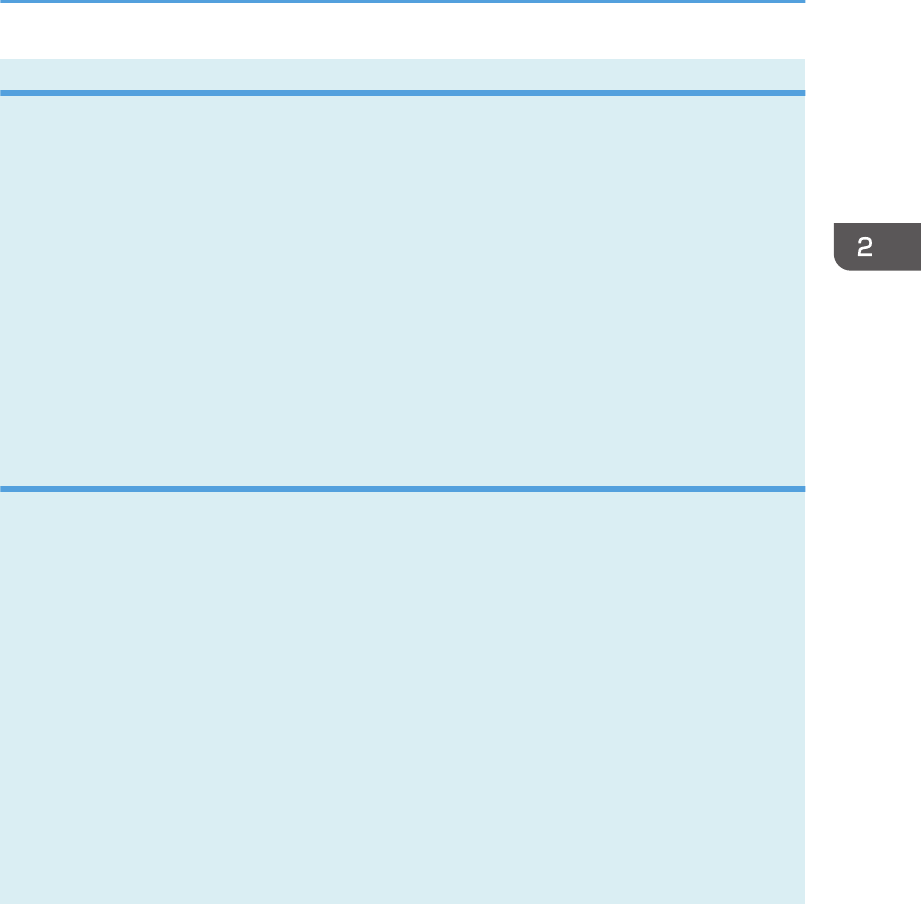
Specifying the paper type and paper size
1. On the [Start] menu, click [All Programs].
2. Click [Smart Organizing Monitor for SP xxx Series].
3. Click [Smart Organizing Monitor Status].
If the machine you are using is not selected, click [Connect Printer], and then select the machine's
model.
4. On the [User Tools] tab, click [Printer Configuration].
5. Click the [Paper Input] tab.
6. Select the paper type and paper size setting for the desired tray, and then click [OK].
7. Click [Close].
Changing the custom paper size
1. On the [Start] menu, click [All Programs].
2. Click [Smart Organizing Monitor for SP xxx Series].
3. Click [Smart Organizing Monitor Status].
If the machine you are using is not selected, click [Connect Printer], and then select the machine's
model.
4. On the [User Tools] tab, click [Printer Configuration].
5. On the [Paper Input] tab, select [Custom Paper Size] in the [Paper Size:] list of the paper
tray in use.
6. In the [Unit:] list, select [mm] or [inch].
7. In the [Horizontal:] box and [Vertical:] box, specify the width and length.
8. Click [OK].
9. Click [Close].
Loading Paper
opal-p2_mf2_com_user_guide_00142085_eng.xml 53
Draft 2014/01/07
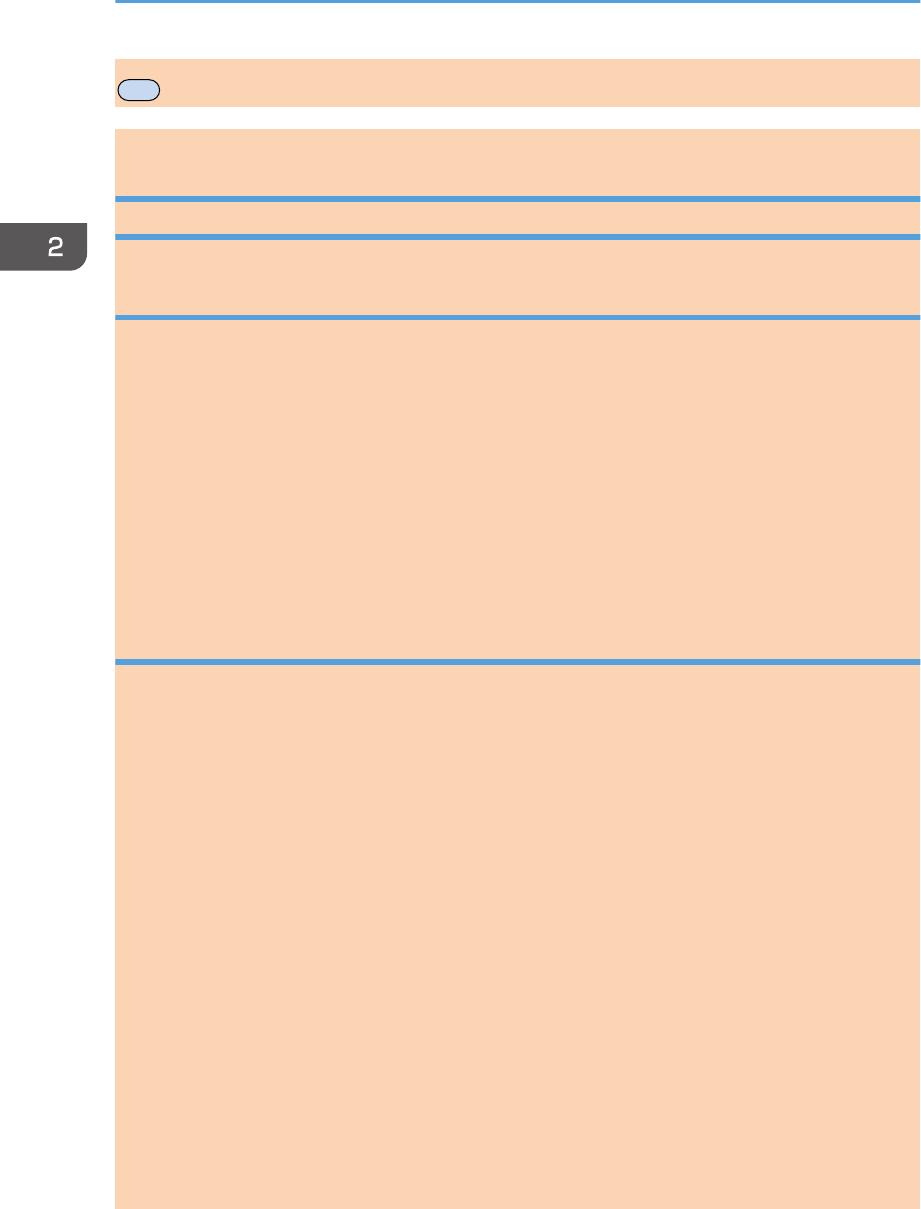
MF
Placing Originals
This section describes the types of originals you use set and how to place them.
About Originals
Recommended size of originals
Exposure glass
• Up to 216 mm (8.5 inches) in width, up to 297 mm (11.7 inches) in length
ADF
• Paper size: 140 to 216 mm (5.5 to 8.5 inches) in width, 140 to 356 mm (5.5 to 14 inches) in
length
• Paper weight: 60 to 90 g/m2 (16 to 24 lb.)
Up to 15 sheets of an original can be placed in the ADF at once (when using paper weighing 80
g/m2, 21.3 lb.).
Types of originals not supported by the Auto Document Feeder
If placed in the ADF, the following types of originals might be damaged, become jammed, or result in
gray or black lines appearing on prints:
• Originals larger or heavier than the recommended amount
• Stapled or clipped originals
• Perforated or torn originals
• Curled, folded, or creased originals
• Pasted originals
• Originals with any kind of coating, such as thermal fax paper, art paper, aluminum foil, carbon
paper, or conductive paper
• Originals with perforated lines
• Originals with indexes, tags, or other projecting parts
• Sticky originals such as translucent paper
• Thin, highly flexible originals
• Thick originals such as postcards
• Bound originals such as books
• Transparent originals such as OHP transparencies or translucent paper
2. Loading Paper
54 opal-p2_mf2_com_user_guide_00142086_eng.xml
Draft 2014/01/07
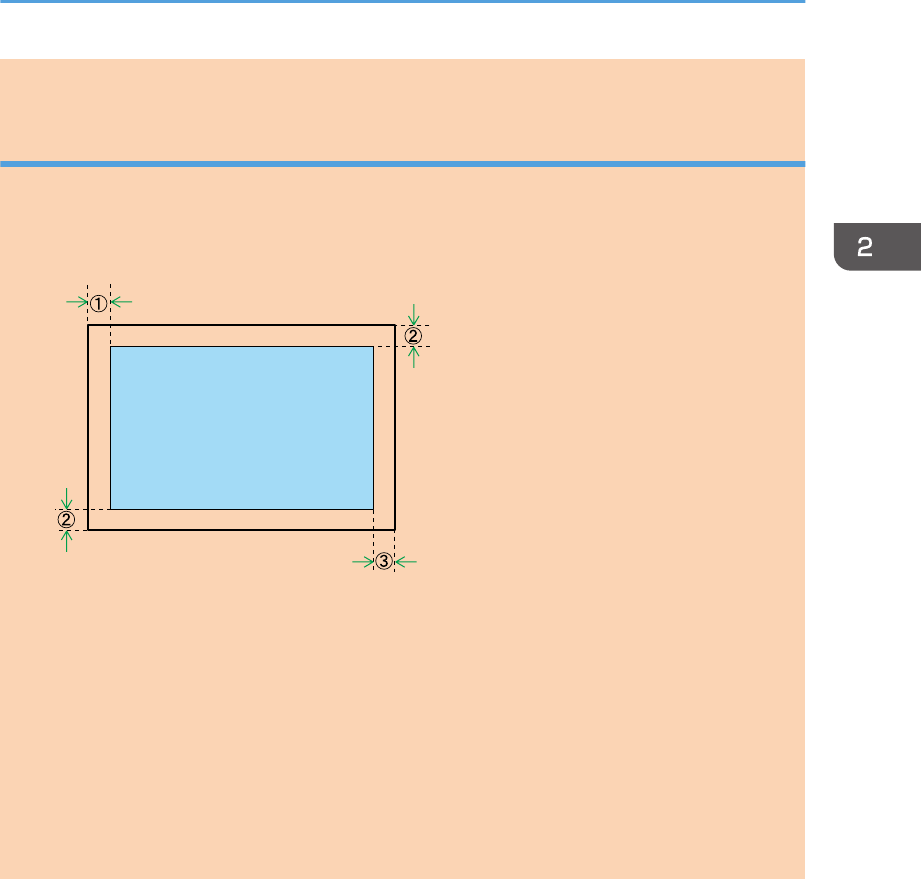
• Originals that are wet with toner or white out
Unscannable image area
Even if you correctly place originals, margins of a few millimeters on all four sides of the original may not
be scanned.
Margins when using exposure glass
CHZ916
Copier, Fax
1. Approx. 4 mm (0.2 inches)
2. Approx. 3 mm (0.1 inches)
3. Approx. 4 mm (0.2 inches)
Scanner
1. Approx. 0 mm (0 inches)
2. Approx. 0 mm (0 inches)
3. Approx. 2 mm (0.08 inches)
Placing Originals
opal-p2_mf2_com_user_guide_00142086_eng.xml 55
Draft 2014/01/07
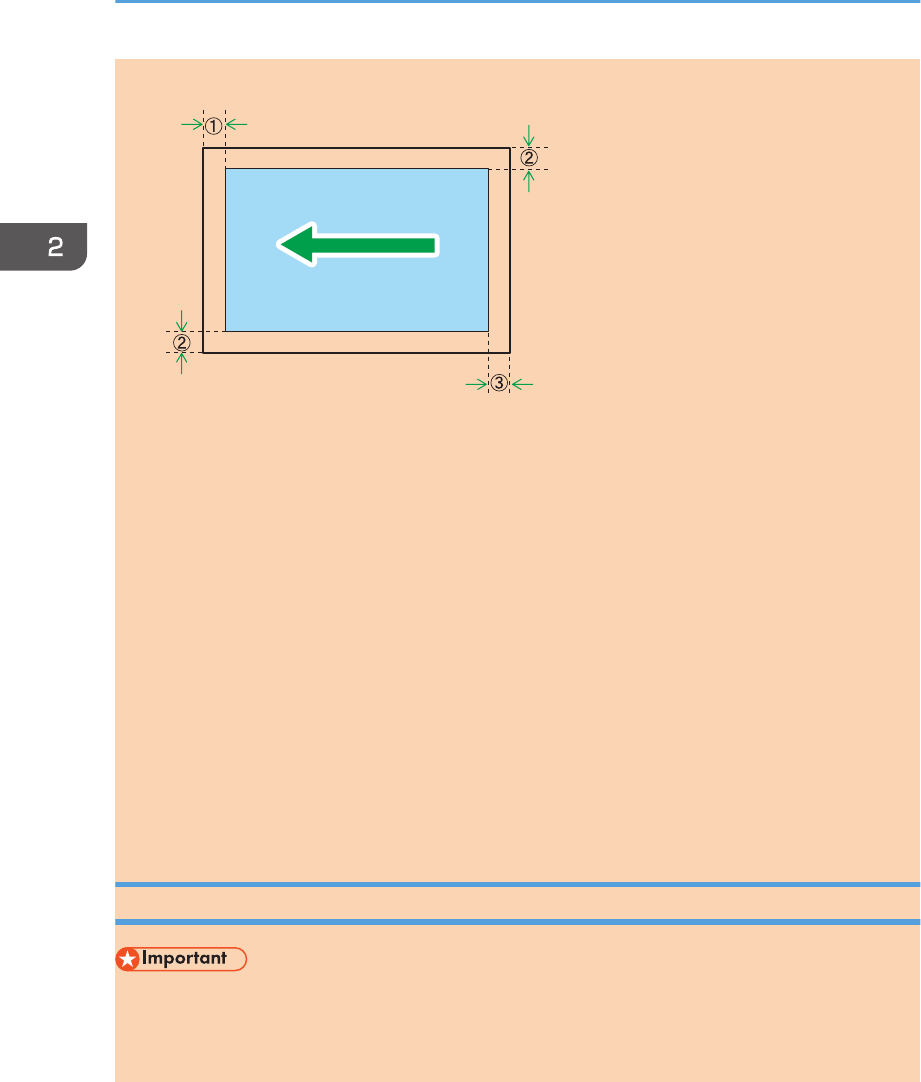
Margins when using ADF
DCT001
Copier
1. Approx. 4.1 mm (0.2 inches)
2. Approx. 3 mm (0.1 inches)
3. Approx. 4.3 mm (0.2 inches)
Scanner
1. Approx. 0 mm (0 inches)
2. Approx. 0 mm (0 inches)
3. Approx. 2 mm (0.08 inches)
Fax
1. Approx. 0 mm (0 inches)
2. Approx. 0 mm (0 inches)
3. Approx. 0 mm (0 inches)
Placing Originals on the Exposure Glass
• Do not place originals until all correction fluid or toner becomes completely dry. Doing so may
create marks on the exposure glass that will appear on copies.
1. Lift the exposure glass cover.
2. Loading Paper
56 opal-p2_mf2_com_user_guide_00142086_eng.xml
Draft 2014/01/07
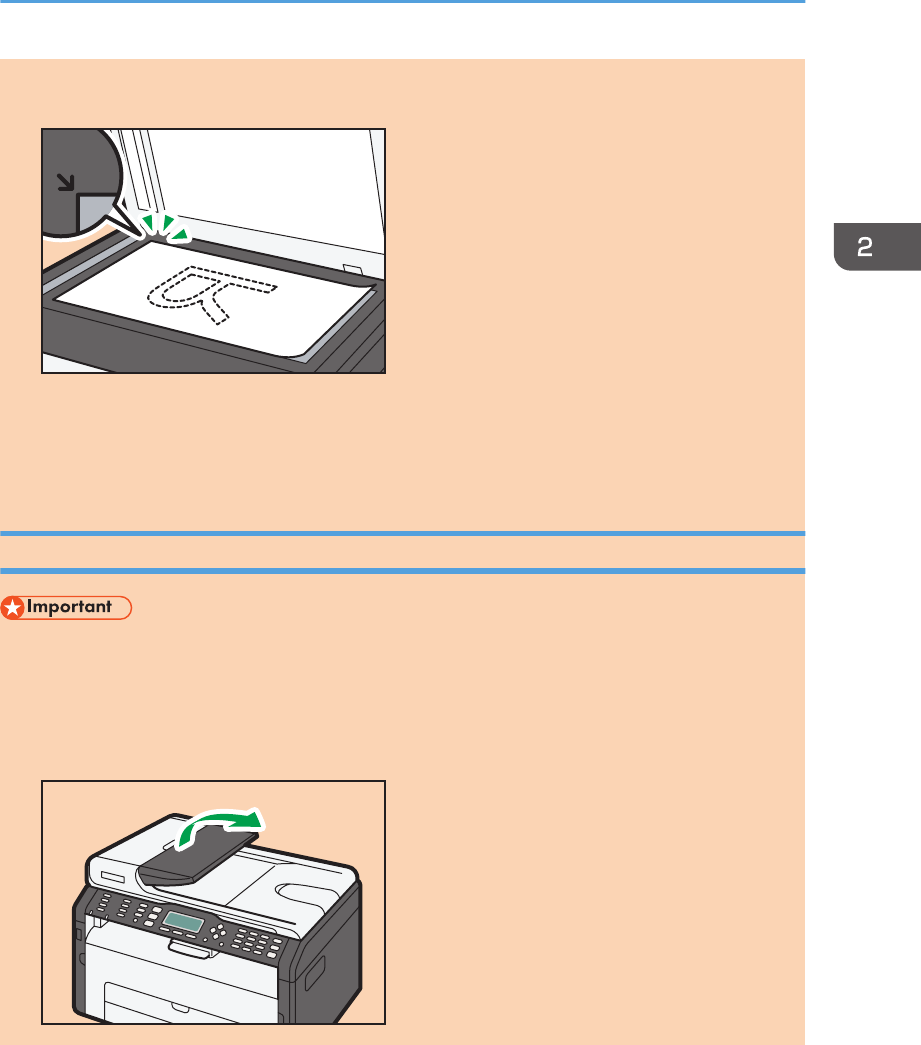
2. Place the original face down on the exposure glass. The original should be aligned to the
rear left corner.
DCT007
3. Lower the exposure glass cover.
Hold down the cover with your hands when using thick, folded, or bound originals and when the
cover cannot be lowered completely.
Placing Originals in the Auto Document Feeder
• Do not place originals mixed with different in the ADF all at once.
• To prevent multiple sheets from being fed at once, fan the bundle of your original before placing
them in the ADF.
1. Open the input tray for the ADF.
DCT016
Placing Originals
opal-p2_mf2_com_user_guide_00142086_eng.xml 57
Draft 2014/01/07
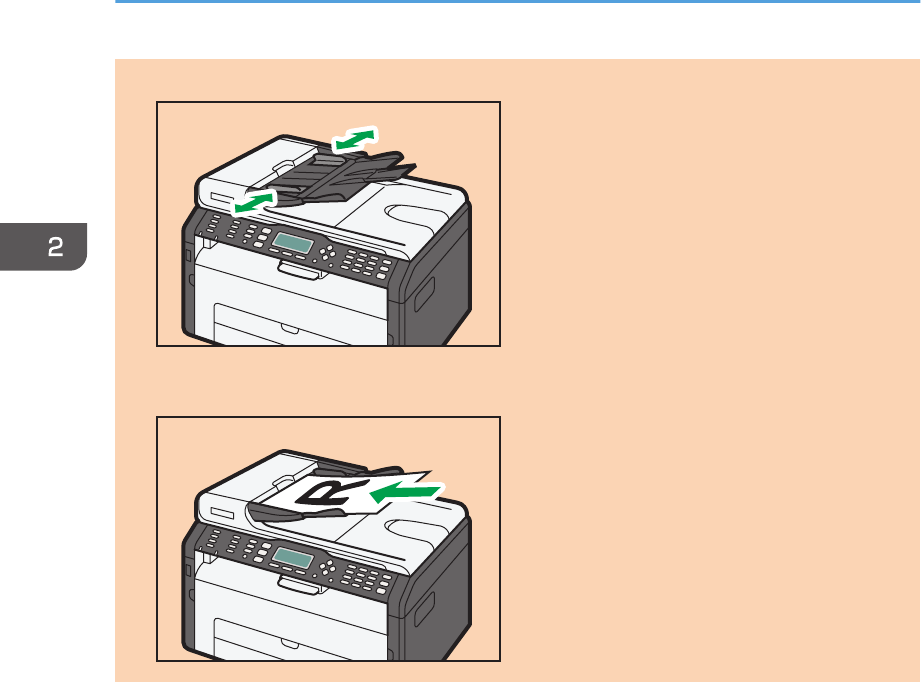
2. Adjust the guides according to the size of the originals.
DCT017
3. Place the aligned originals face up in the ADF. The last page should be on the bottom.
DCT018
2. Loading Paper
58 opal-p2_mf2_com_user_guide_00142086_eng.xml
Draft 2014/01/07
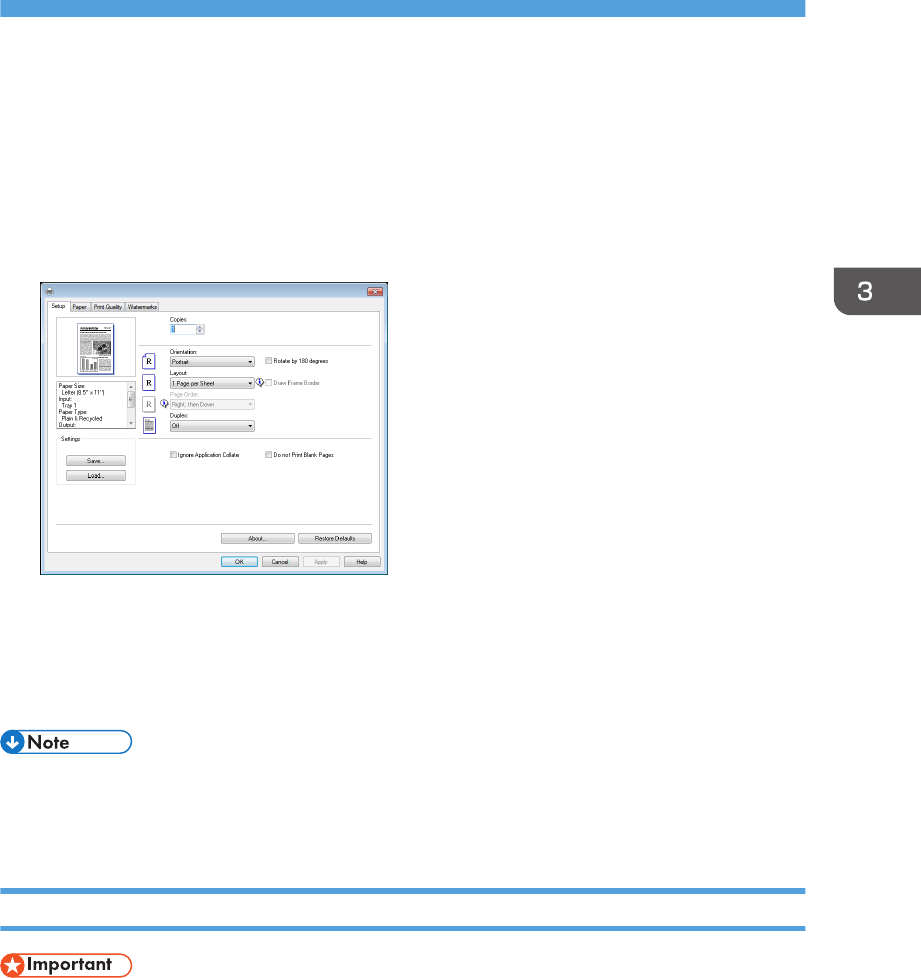
3. Printing Documents
Basic Operation
Use the printer driver to print a document from your computer.
1. After creating a document, open the [Printing Preferences] dialog box in the document's
native application.
2. Change any print settings if necessary.
For details about each setting items, click [Help].
3. When setting changes are completed, click [OK].
4. Print the document using the print function in the document's native application.
• If a paper jam occurs, printing stops halfway. Open the front cover, remove the print cartridge, and
then remove the jammed paper. If the paper cannot be removed in this way, remove it by opening
the fusing cover. Printing will resume automatically once the cover is closed.
Printing on Both Sides of Sheets
• This function cannot be available with the bypass tray.
1. After creating a document, open the [Printing Preferences] dialog box in the document's
native application.
2. On the [Setup] tab, in the [Duplex:] list box, select how you want to open the bound
output.
3. After making any additional settings, click [OK].
opal-p2_mf2_com_user_guide_00142088_eng.xml 59
Draft 2014/01/07
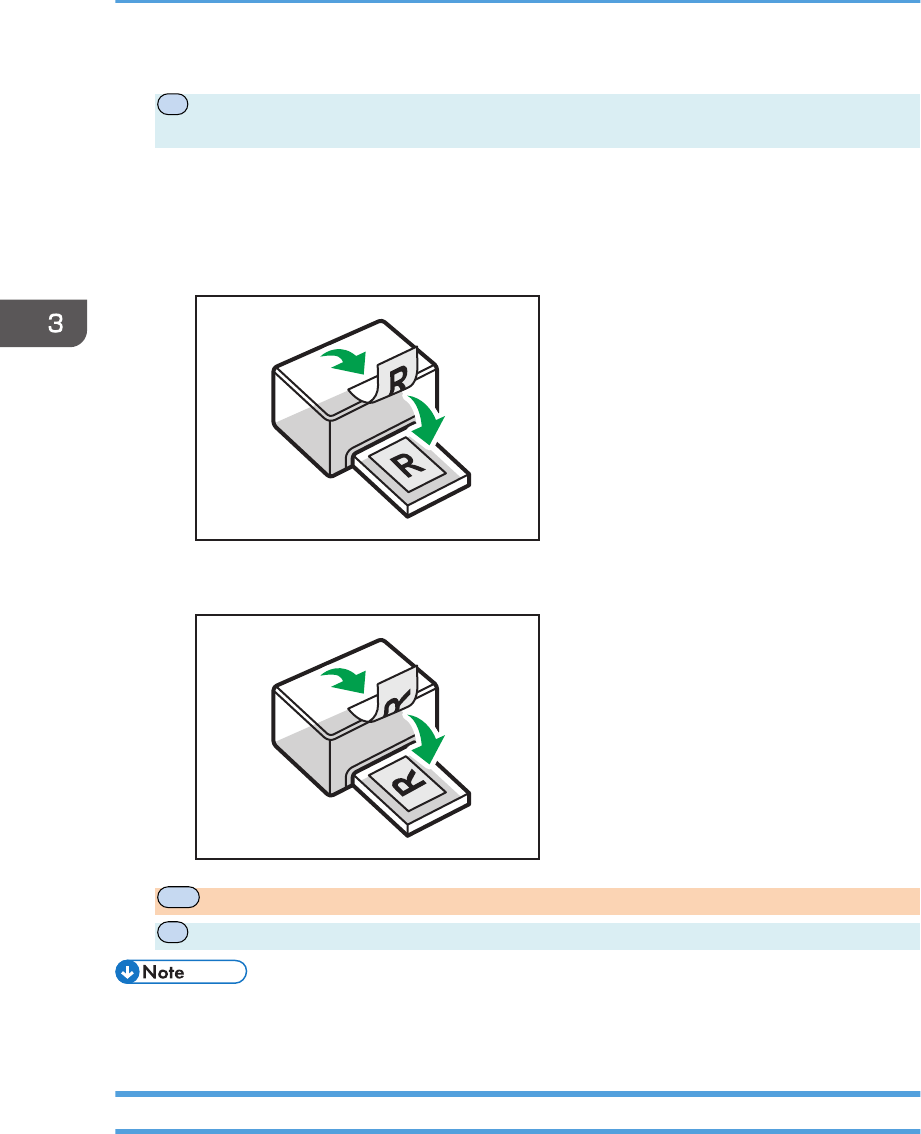
4. Start printing.
P
The machine prints only the one sides of pages first, and then displays on Smart Organizing
Monitor screen a message to reload the outputs turned over.
5. Take out all of the prints from the output tray and place them in Tray 1.
To print on the reverse side of the prints, turn them over so that the blank side faces down and
place them in Tray 1. Fan the paper well before loading it.
Portrait
DCT005
Landscape
DCT006
6.
MF
Press [Continue].
7.
P
Press the [Start] key.
• If the rear cover is open, the paper is delivered face up from the rear. Rearrange the printed sheets
in the correct order.
Canceling a Print Job
You can cancel print jobs using either the machine's control panel or your computer, depending on the
status of the job.
3. Printing Documents
60 opal-p2_mf2_com_user_guide_00142088_eng.xml
Draft 2014/01/07
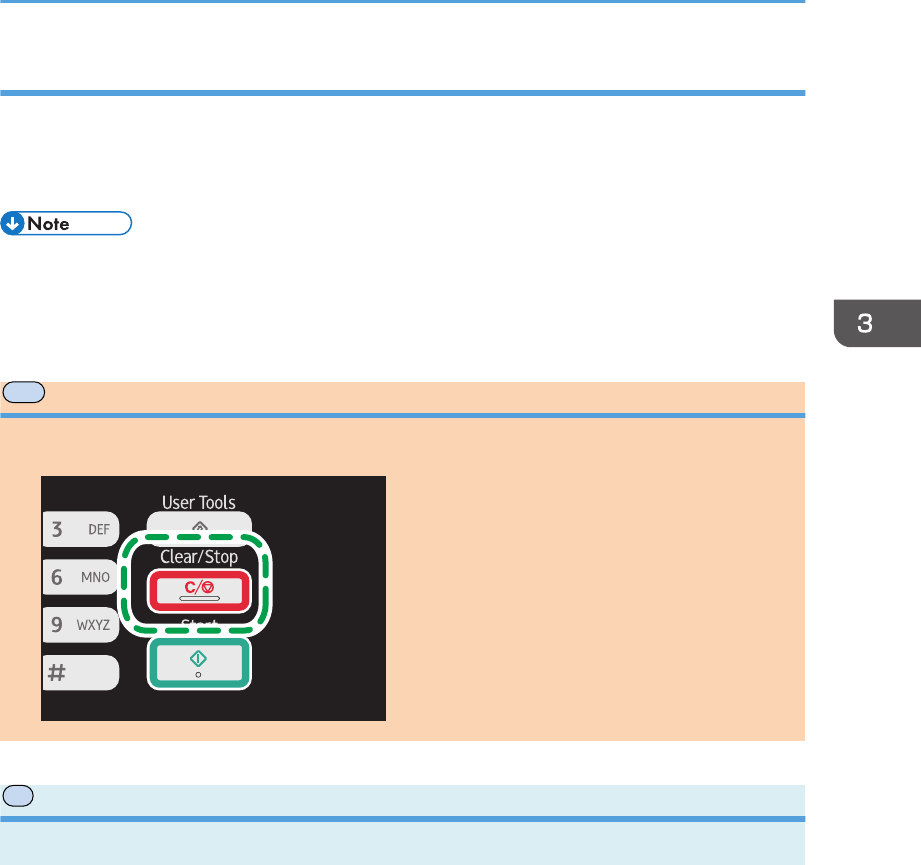
Canceling a print job before printing has started
1. Double-click the printer icon on the task tray of your computer.
2. Select the print job you want to cancel, click the [Document] menu, and then click
[Cancel].
• If you cancel a print job that has already been processed, printing may continue for a few pages
before being canceled.
• It may take a while to cancel a large print job.
MF
Canceling a print job while printing
1. Press the [Clear/Stop] key.
DCT846
P
Canceling a print job while printing
1. Press the [Job Reset] key.
Basic Operation
opal-p2_mf2_com_user_guide_00142088_eng.xml 61
Draft 2014/01/07
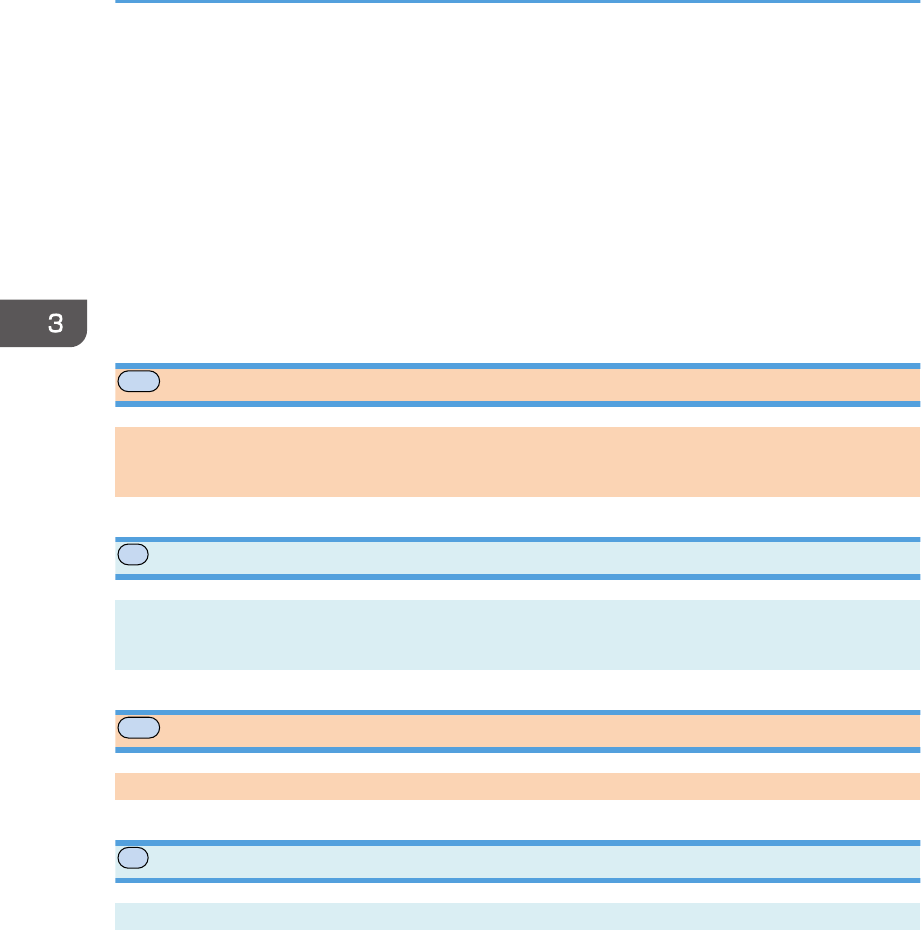
If a Paper Mismatch Occurs
If the paper size does not match the print job's settings, the machine reports an error. There are two
ways to resolve this error:
Continue printing using mismatched paper
Use the form-feed function to ignore the error and print using mismatched paper.
Reset the print job
Cancel printing.
MF
Continuing Printing Using Mismatched Paper
If the paper is too small for the print job, the printed image will be cropped.
1. If the error message is displayed, press [FormFeed].
P
Continuing Printing Using Mismatched Paper
If the paper is too small for the print job, the printed image will be cropped.
1. If the Alert indicator lights up, press the [Start] key.
MF
Resetting the Print Job
1. If the error message is displayed, press [JobReset].
P
Resetting the Print Job
1. If the Alert indicator lights up, press the [Job Reset] key.
3. Printing Documents
62 opal-p2_mf2_com_user_guide_00142089_eng.xml
Draft 2014/01/07
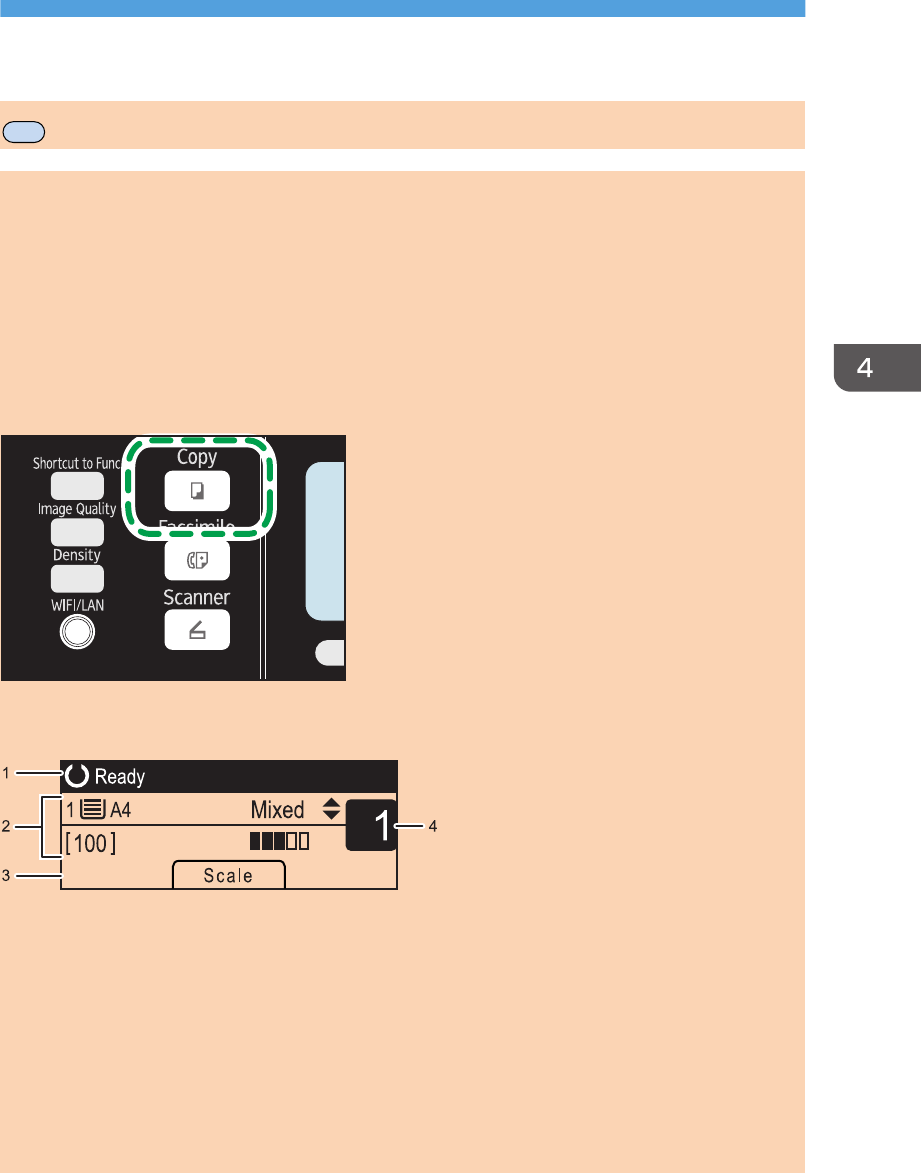
4. Copying Originals
MF
Copier Mode Screen
This section provides information about the screen when the machine is in copier mode.
By default, the display shows the copier screen when the machine is turned on.
If the scanner or fax screen is shown on the display, press the [Copy] key on the control panel to switch
to the copier screen.
Type 1 models do not have the [Copy] key. If ID card copy mode is being displayed, press the [Shortcut
to Func.] key again to switch to normal copier mode.
Type 1 and 5 models do not have the [Copy] key. If ID card copy mode is being displayed, press the
[Shortcut to Func.] key again to switch to normal copier mode.
DCT848
Standby mode screen
CVW200
1. Current status or messages
Displays the current status or messages.
2. Current settings
Displays the current tray, reproduction ratio, and scan settings.
3. Selection key items
Displays the functions you can use by pressing the corresponding selection keys.
4. Copy quantity
Displays the current copy quantity. You can change the copy quantity using the number keys.
opal-p2_mf2_com_user_guide_00142091_eng.xml 63
Draft 2014/01/07
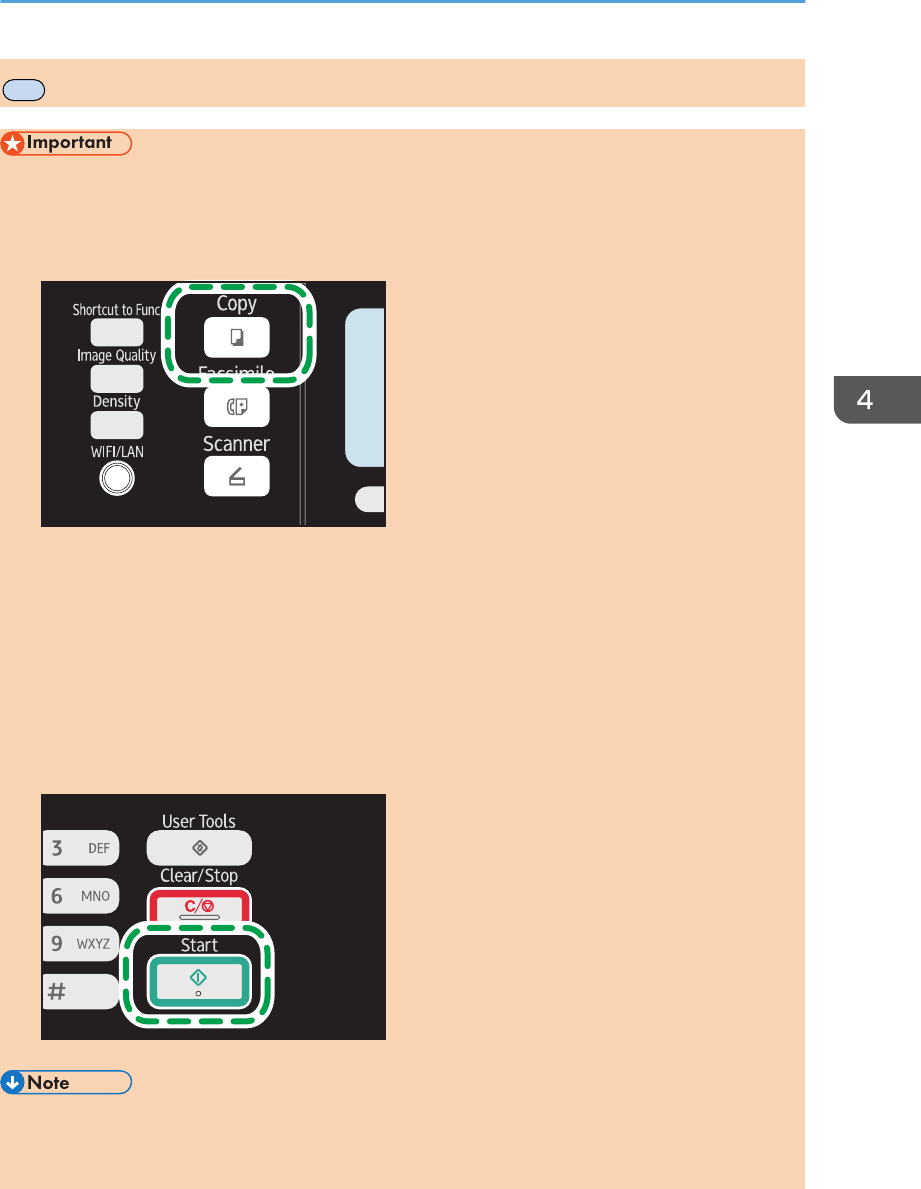
MF
Basic Operation
• The original in the ADF takes precedence over the original on the exposure glass if you place
originals both in the ADF and on the exposure glass.
1. Press the [Copy] key.
DCT848
With Type 1 models, start from Step 2. If ID card copy mode is being displayed, press the [Shortcut
to Func.] key again to switch to normal copier mode.
With Type 1 or 5 models, start from Step 2. If ID card copy mode is being displayed, press the
[Shortcut to Func.] key again to switch to normal copier mode.
2. Place the original on the exposure glass or in the ADF.
3. To make multiple copies, enter the number of copies using the number keys.
4. Press the [Start] key.
DCT847
• If a paper jam occurs, printing stops halfway. Open the front cover, remove the print cartridge, and
then remove the jammed paper. If the paper cannot be removed in this way, remove it by opening
the fusing cover. Printing will resume automatically once the cover is closed.
Basic Operation
opal-p2_mf2_com_user_guide_00142092_eng.xml 65
Draft 2014/01/07
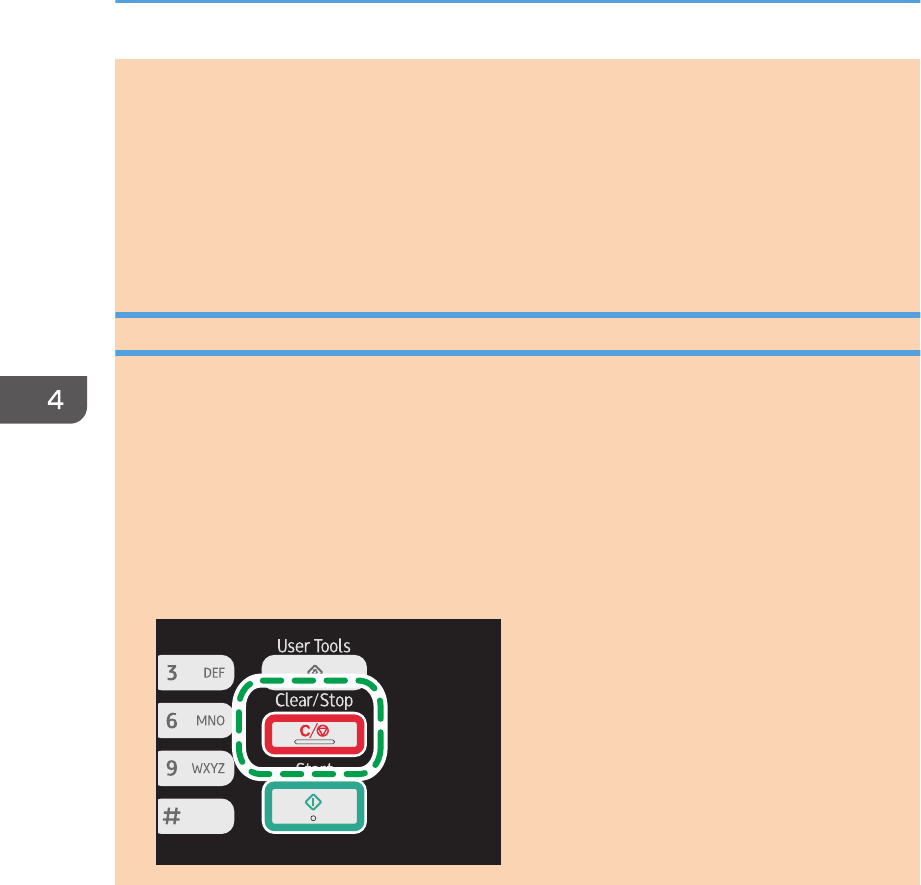
• If there is a paper jam in the ADF, open the ADF cover, and then remove the jammed paper.
Specify the copy setting again from the page where the paper jammed.
• To print on paper fed from Tray 1, remove the paper loaded in the bypass tray. Otherwise, the
paper in the bypass tray is fed first.
• [Sort] and [Duplex/Combine] cannot be used with the bypass tray.
• When making multiple copies of a multi-page document, you can select whether copies are output
in collated sets, or in page batches in the [Sort] setting under [Copier Features].
Canceling a Copy
If copying is canceled while scanning an original placed on the exposure glass, copying is canceled
immediately and there is no printout. If copying is canceled while scanning a multiple-page original
placed in the ADF, scanning stops halfway at the current page.
1. Press the [Copy] key.
With Type 1 models, start from Step 2.
With Type 1 or 5 models, start from Step 2.
2. Press the [Clear/Stop] key.
DCT846
4. Copying Originals
66 opal-p2_mf2_com_user_guide_00142092_eng.xml
Draft 2014/01/07
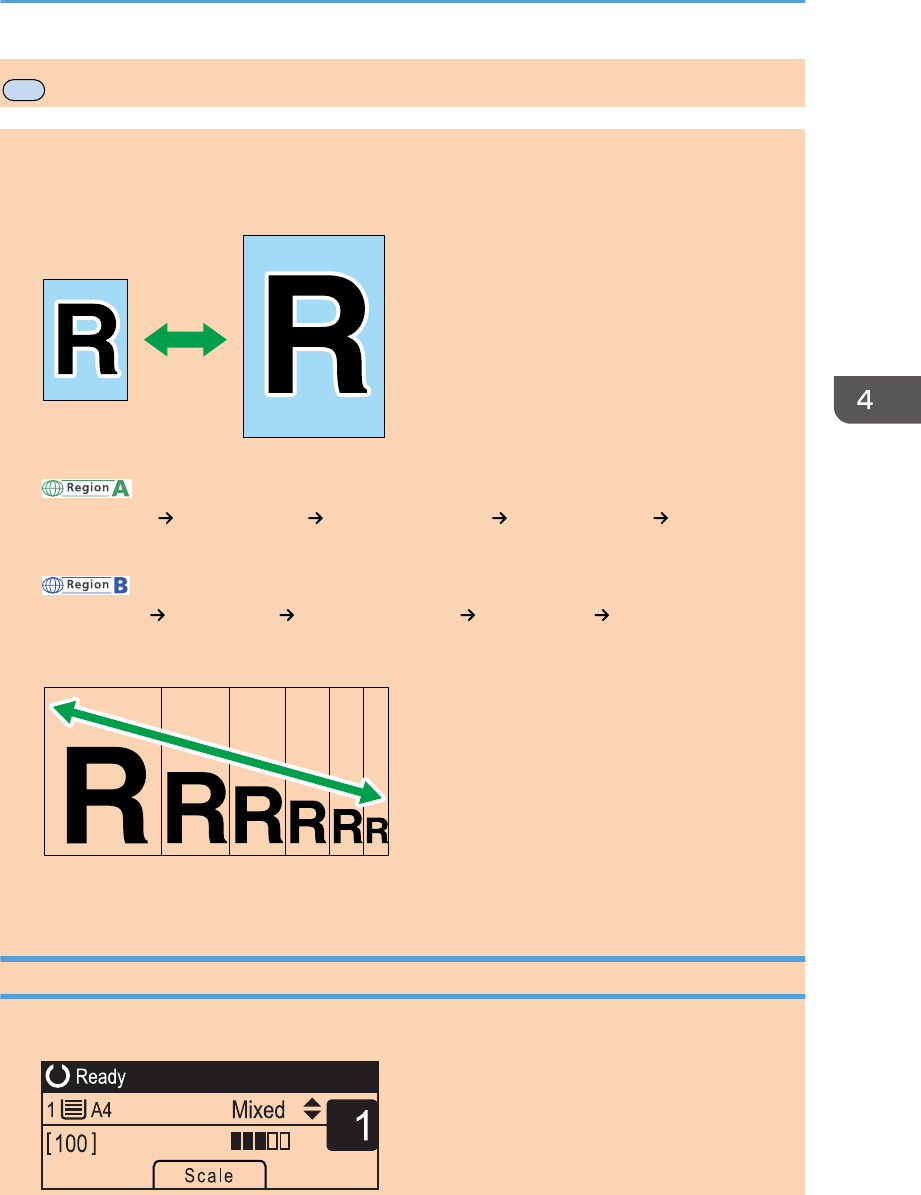
MF
Making Enlarged or Reduced Copies
There are two ways to set the scaling ratio: using a preset ratio or manually specifying a customized
ratio.
Preset ratio
CES103
(mainly Europe and Asia)
50%, 71% A4 A5, 82% B5 JIS A5, 93%, 122% A5 B5 JIS, 141% A5 A4, 200%,
400%
(mainly North America)
50%, 65% LT HLT, 78% LG LT, 93%, 129% HLT LT, 155% HLT LG, 200%, 400%
Custom ratio
CES106
25% to 400% in 1% increments.
Specifying Reduce/Enlarge
1. Press [Scale].
Making Enlarged or Reduced Copies
opal-p2_mf2_com_user_guide_00142093_eng.xml 67
Draft 2014/01/07
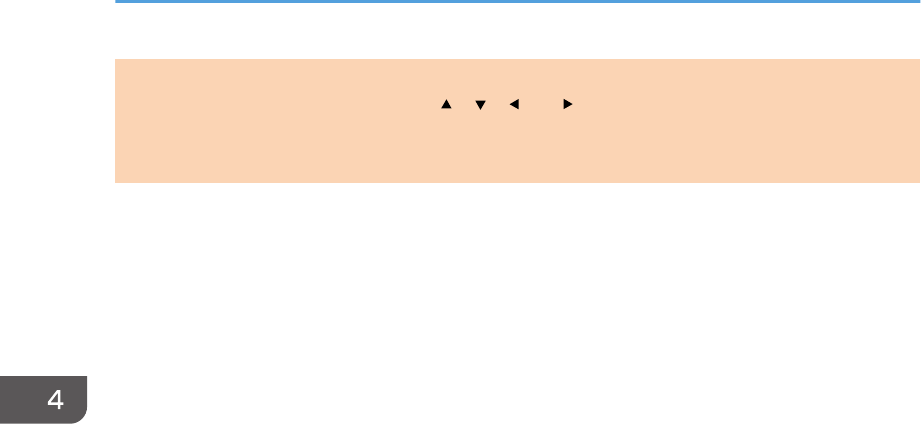
2. Press [Reduce], [Enlarge], or [Zoom].
For [Reduce] or [Enlarge], press the [ ], [ ], [ ], or [ ] key to select the desired ratio. For [Zoom],
specify the desired ratio using the number keys.
3. Press the [OK] key.
4. Copying Originals
68 opal-p2_mf2_com_user_guide_00142093_eng.xml
Draft 2014/01/07
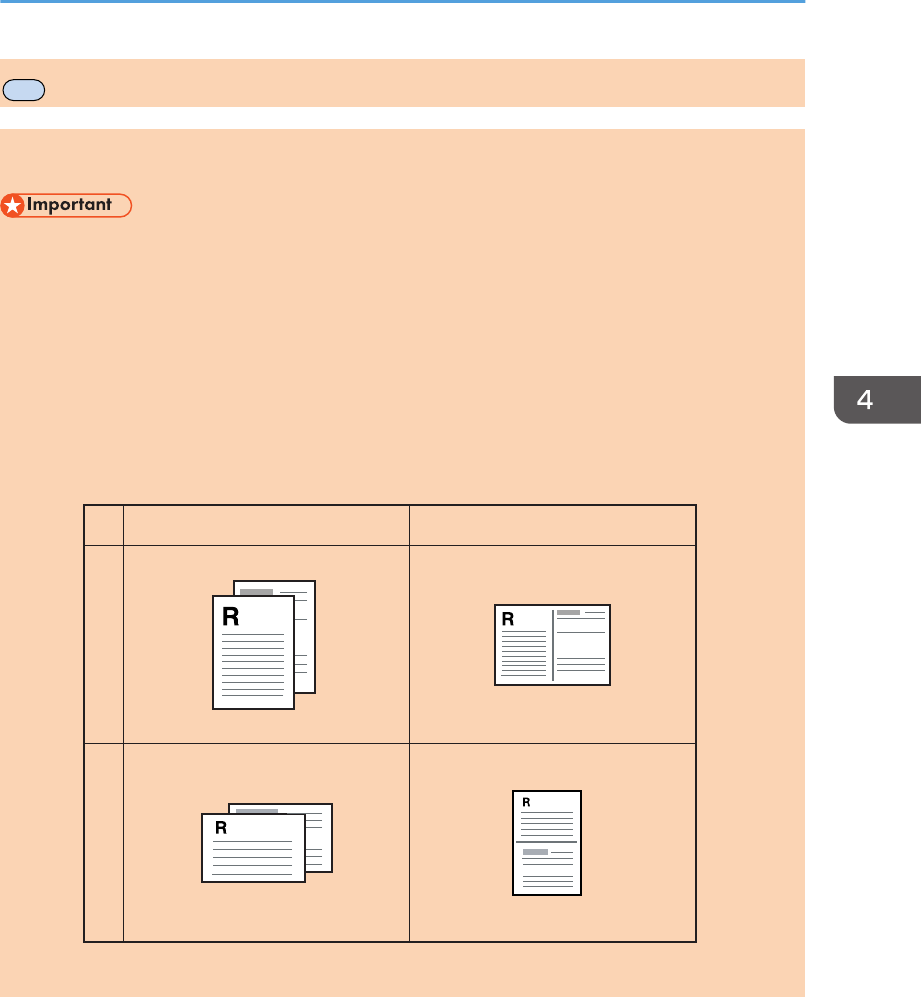
MF
Making Combined/2-sided Copies
This section describes how to combine and print a multiple pages (two or four pages) on one side or
both sides of paper.
• This function is only available when the original is set in the ADF, not when it is set on the exposure
glass.
• To use this function, the paper size used for printing copies must be set to A4, Letter or Legal.
There are following copy modes. Select a copy mode according to your original and how you want the
copy outputs to appear.
Combined copy on one side
In this mode, a two or four-page original is combined and printed on one side of paper.
• Comb. 2 on 1
PortraitLandscape
Original Copy
CMF250
• Comb. 4 on 1
Making Combined/2-sided Copies
opal-p2_mf2_com_user_guide_00142094_eng.xml 69
Draft 2014/01/07
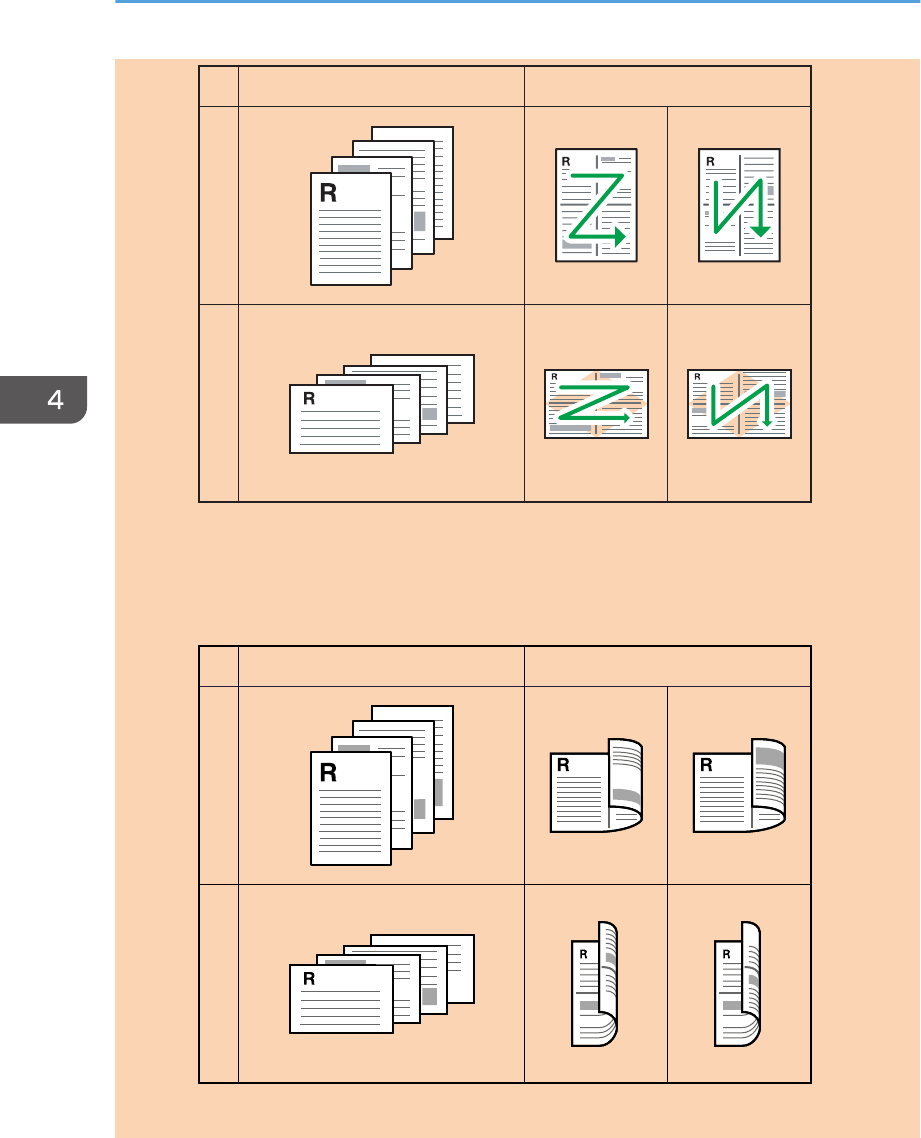
PortraitLandscape
Original Copy
Left to Right Top to Bottom
Left to Right Top to Bottom
DCT002
Combined copy on both sides
In this mode, a multiple-page original is combined and printed on both sides of paper.
• Comb. 2 on 1
PortraitLandscape
Original Copy
Top to Top Top to Bottom
Top to Top Top to Bottom
CMF255
• Comb. 4 on 1
4. Copying Originals
70 opal-p2_mf2_com_user_guide_00142094_eng.xml
Draft 2014/01/07
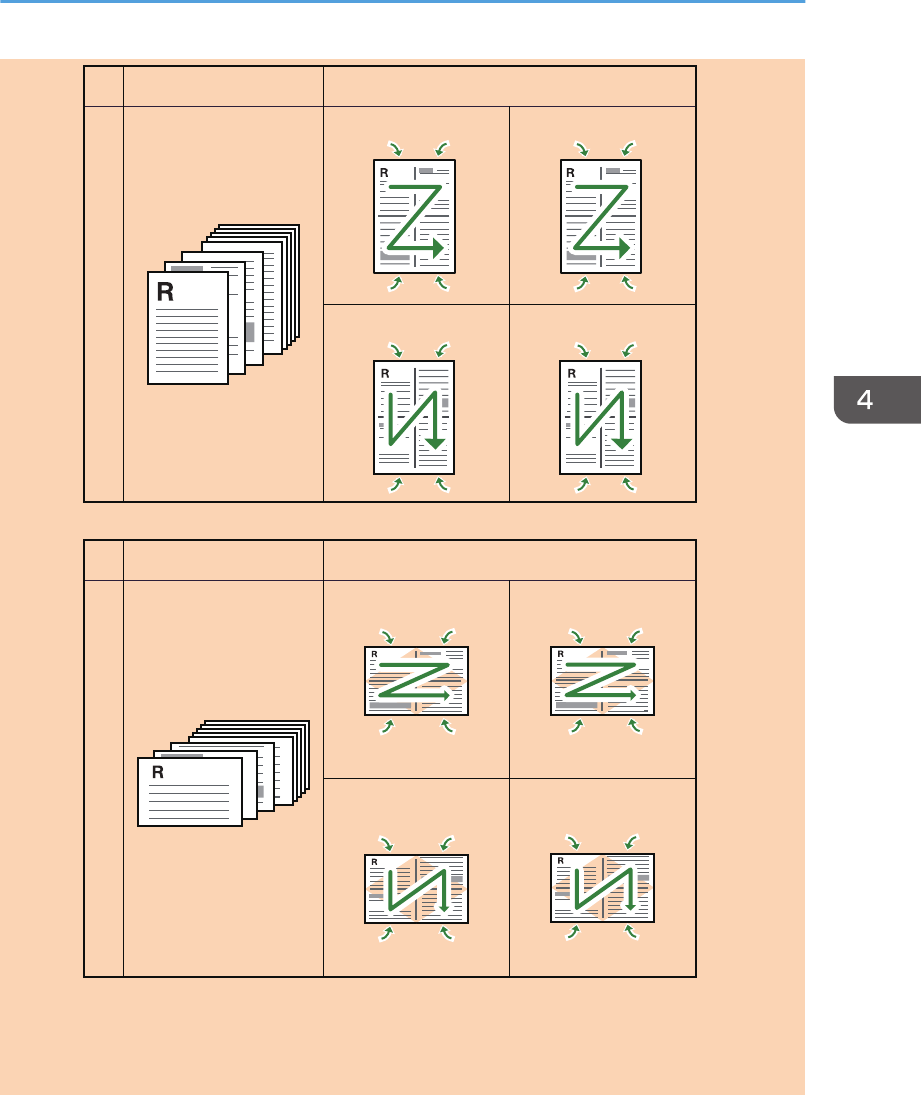
87
65
86
75
65
87
75
86
Portrait
Original Copy
Left to Right, Top to Top Left to Right, Top to Bottom
Top to Bottom, Top to Top Top to Bottom, Top to Bottom
DCT003
87
65
86
75
65
87
75
86
Landscape
Original Copy
Left to Right, Top to Top Left to Right, Top to Bottom
Top to Bottom, Top to Top Top to Bottom, Top to Bottom
DCT004
2-sided copy
In this mode, one-sided pages are printed on the front and back sides of paper without being
combined.
Making Combined/2-sided Copies
opal-p2_mf2_com_user_guide_00142094_eng.xml 71
Draft 2014/01/07

PortraitLandscape
Original Copy
CMF261
Top to Top Top to Bottom
Top to Top Top to Bottom
Specifying Combined and 2-sided Copies
1. Press the [Copy] key.
DCT848
With Type 1 models, start from Step 2. If ID card copy mode is being displayed, press the [Shortcut
to Func.] key again to switch to normal copier mode.
With Type 1 or 5 models, start from Step 2. If ID card copy mode is being displayed, press the
[Shortcut to Func.] key again to switch to normal copier mode.
2. Press the [ ] or [ ] key.
3. Press [Duplex/Combine].
4. Press the [ ] or [ ] key to select the desired copy mode, and then press the [OK] key.
4. Copying Originals
72 opal-p2_mf2_com_user_guide_00142094_eng.xml
Draft 2014/01/07
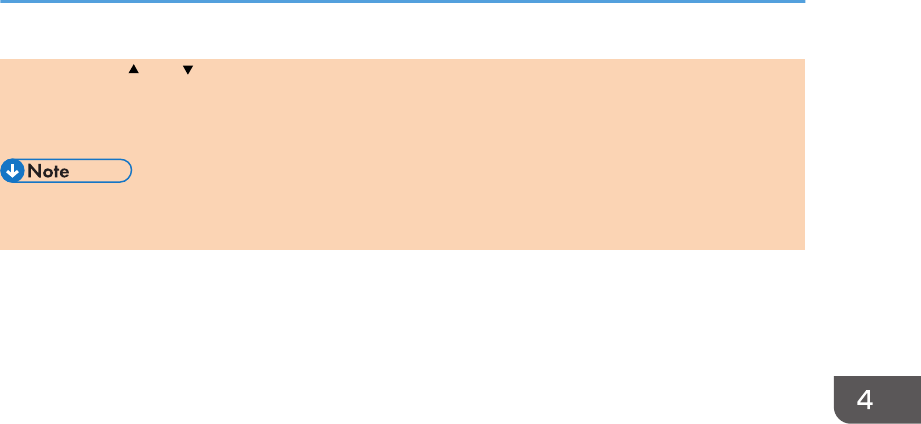
5. Press the [ ] or [ ] key to select paper orientation and page order, and then press the
[OK] key.
The screen will show the selected copy mode.
• After you place the originals, press the [Start] key within the time specified in [System Auto Reset
Timer]. Otherwise, the job is canceled. For details, see page 159 "Administrator Settings".
Making Combined/2-sided Copies
opal-p2_mf2_com_user_guide_00142094_eng.xml 73
Draft 2014/01/07
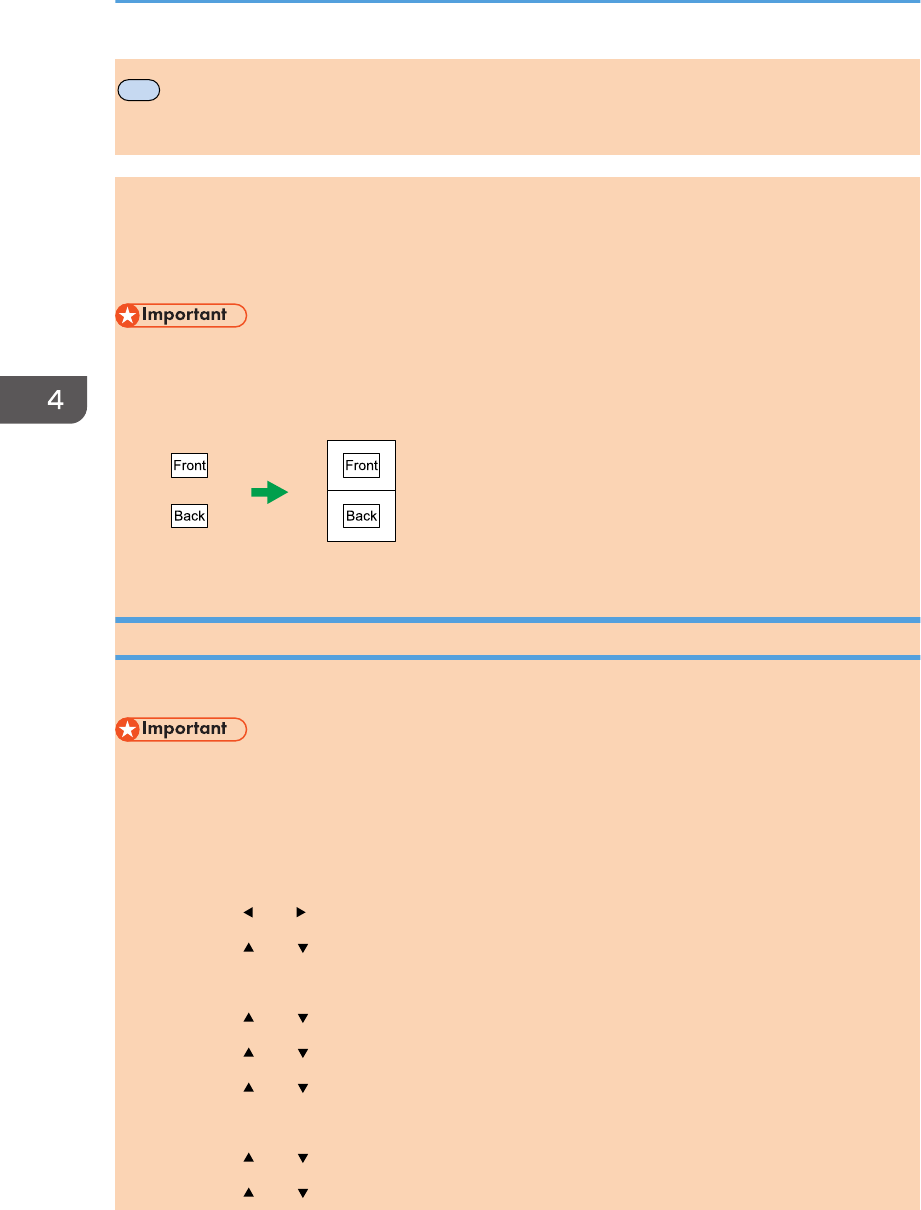
MF
Copying Both Sides of an ID Card onto One
Side of Paper
This section describes how to copy the front and back sides of an ID card or other small documents onto
either side of a sheet of paper.
When copying onto A4 paper, you can copy documents that are smaller than A5. Likewise, when
copying onto Letter size paper, you can copy documents that are smaller than Half Letter size.
• To use this function, the paper size used for printing copies must be set to A6, A5, A4, Half Letter,
or Letter.
CES165
Specifying the ID Card Copy Setting
You can specify the ID Card copy setting.
• Be sure to check the size of the card to copy before specifying [ID Card Size].
1. Press the [Copy] key.
With Type 1 model, start from Step 2.
With Type 1 or 5 model, start from Step 2.
2. Press the [ ] or [ ] key.
3. Press the [ ] or [ ] key to select [ID Card Copy Settings], and then press the [OK] key.
For [ID Card Copy Settings], see page 132 "Copier Features Settings".
4. Press the [ ] or [ ] key to select [ID Card Copy], and then press the [OK] key.
5. Press the [ ] or [ ] key to select [On], and then press the [OK] key.
6. Press the [ ] or [ ] key to select [ID Card Center Line], and then press the [OK] key.
Select [Print] to print the center line; otherwise select [Do not Print], and then press the [OK] key.
7. Press the [ ] or [ ] key to select [ID Card Size], and then press the [OK] key.
8. Press the [ ] or [ ] key to select [mm] or [inch], and then press the [OK] key.
4. Copying Originals
74 opal-p2_mf2_com_user_guide_00142095_eng.xml
Draft 2014/01/07
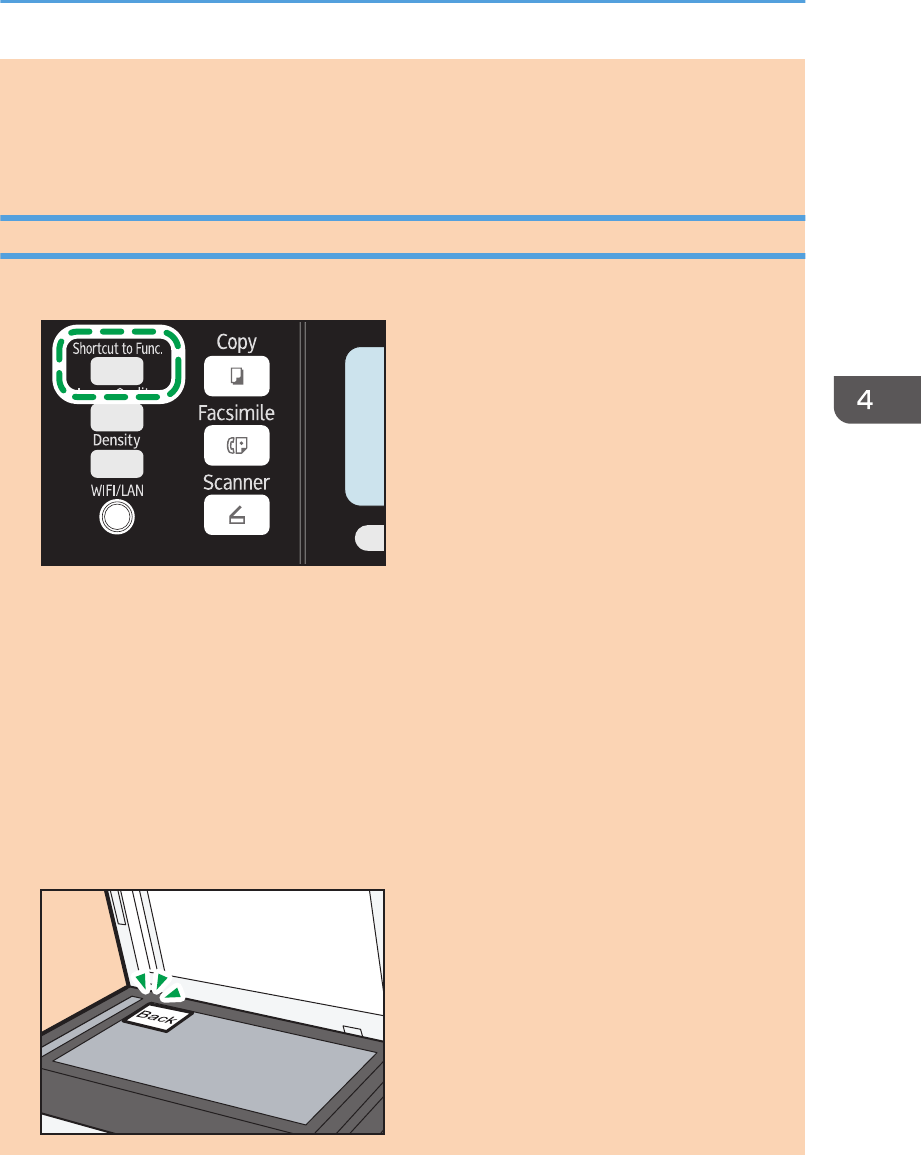
9. Enter the horizontal length (Horiz.) of the card to be placed on the exposure glass, and
then press the [OK] key.
10. Enter the vertical length (Vert.) of the card to be placed on the exposure glass, and then
press the [OK] key.
Copying an ID Card
1. Press the [Shortcut to Func.] key.
DCT851
With Type 1 model, if normal copier mode is being displayed, press the [Shortcut to Func.] key
again to switch to ID card copy mode.
With Type 1 and 5 models, if normal copier mode is being displayed, press the [Shortcut to Func.]
key again to switch to ID card copy mode.
If the ID card copy mode does not appear even though you have pressed the [Shortcut to Func.]
key, set [Shortcut to Function] to [ID Card Copy Mode], and then press the [Shortcut to Func.] key
again, or set [ID Card Copy] to [On] in [ID Card Copy Settings] in [Copier Features].
2. To make multiple copies, enter the number of copies using the number keys.
3. Place the original in the upper-left corner of the exposure glass.
DCT840
Copying Both Sides of an ID Card onto One Side of Paper
opal-p2_mf2_com_user_guide_00142095_eng.xml 75
Draft 2014/01/07
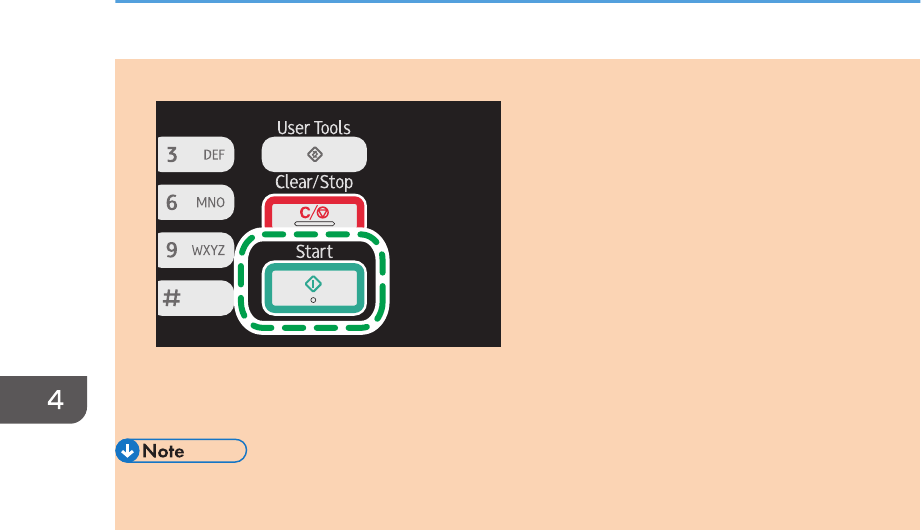
4. Press the [Start] key.
DCT847
5. Within 60 seconds, place the original back side down with the upper-left corner on the
exposure glass, and then press the [Start] key.
• After you place the originals, press the [Start] key within the time specified in [System Auto Reset
Timer]. Otherwise, the job is canceled. For details, see page 159 "Administrator Settings".
4. Copying Originals
76 opal-p2_mf2_com_user_guide_00142095_eng.xml
Draft 2014/01/07
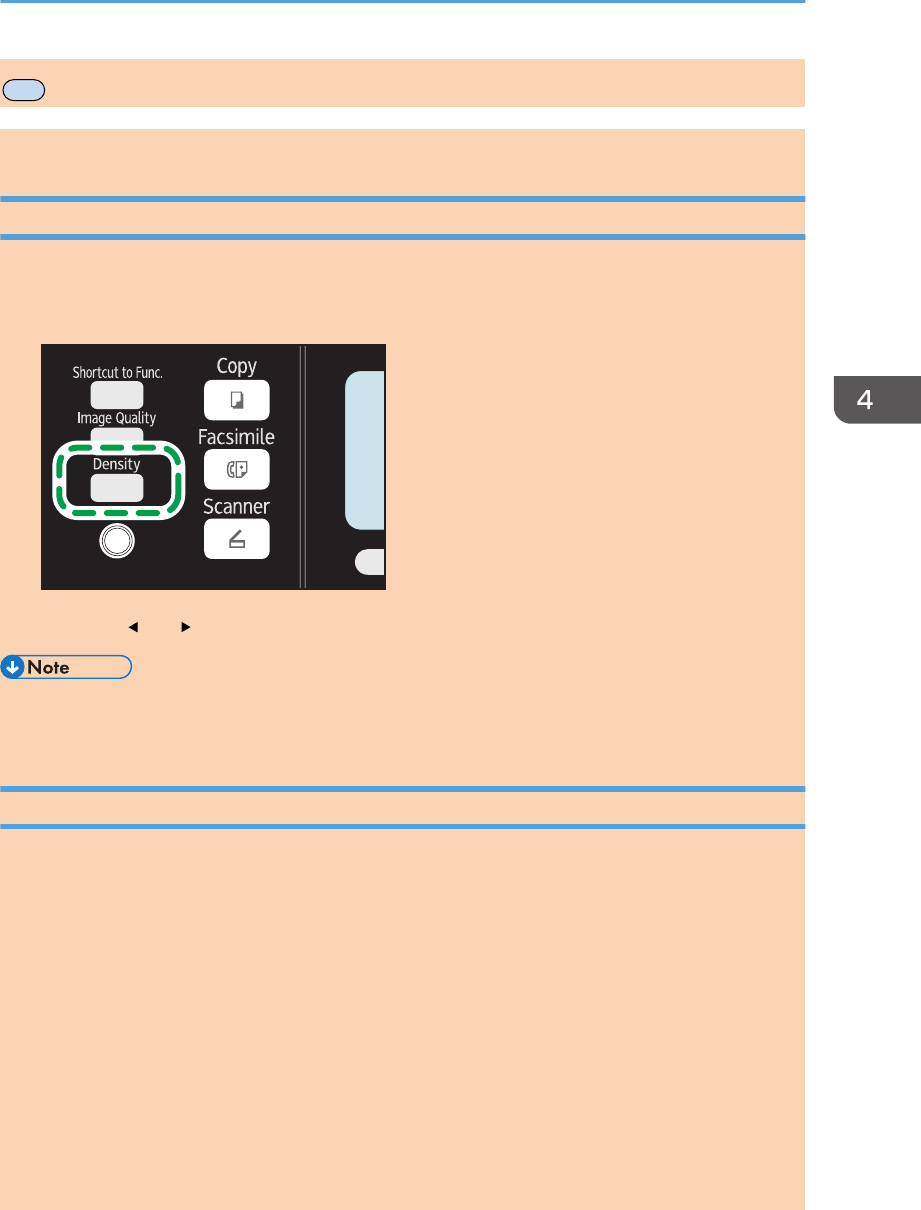
MF
Specifying the Scan Settings
This section describes how to specify image density and scan quality for the current job.
Adjusting Image Density
There are five image density levels. The higher the density level, the darker the printout.
1. Press the [Density] key.
DCT874
2. Press the [ ] or [ ] key to select the desired density level, and then press the [OK] key.
• You can change the machine's default [Density] setting to always make copies with a specific
density level. For details, see page 132 "Copier Features Settings".
Selecting the Document Type According to Original
There are three document types:
Text
Select this when the original contains only text and no photographs or images.
Photo
Select this when the original contains only photographs or images. Use this mode for the following
types of original:
• Photographs
• Pages that are entirely or mainly composed of photographs or images, such as magazine
pages.
Mixed
Select this when the original contains both text and photographs or images.
Specifying the Scan Settings
opal-p2_mf2_com_user_guide_00142096_eng.xml 77
Draft 2014/01/07
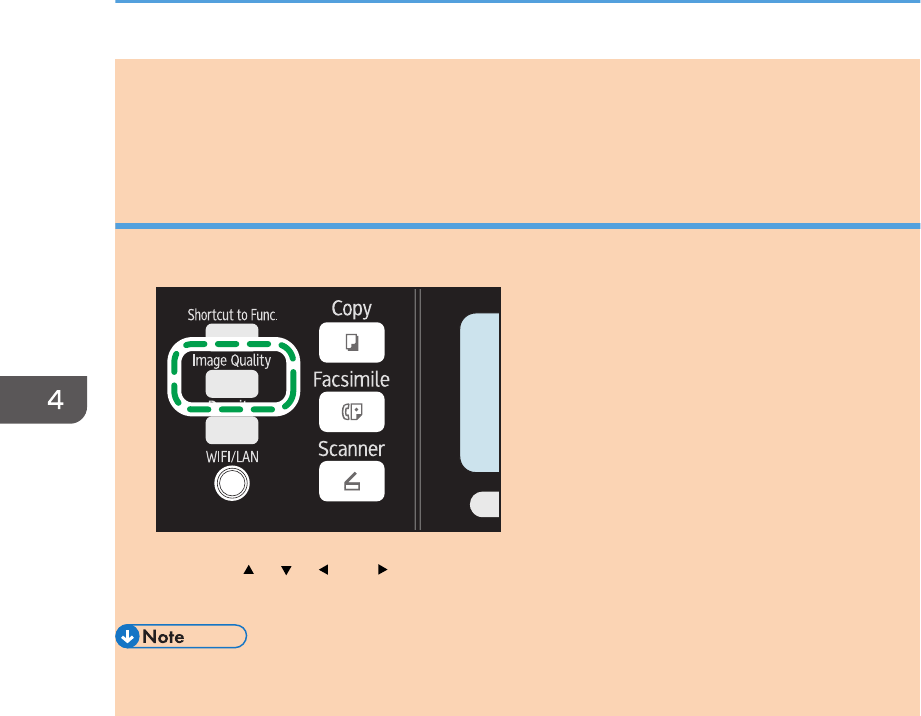
Vou.
Select this to scan with the appropriate setting for vouchers. This is available only if using the
exposure glass.
Specifying the Original Type
1. Press the [Image Quality] key.
DCT875
2. Press the [ ], [ ], [ ], or [ ] key to select the desired document type, and then press the
[OK] key.
• You can change the machine's default [Original Type] setting to always make copies with a
specific document type. For details, see page 132 "Copier Features Settings".
4. Copying Originals
78 opal-p2_mf2_com_user_guide_00142096_eng.xml
Draft 2014/01/07
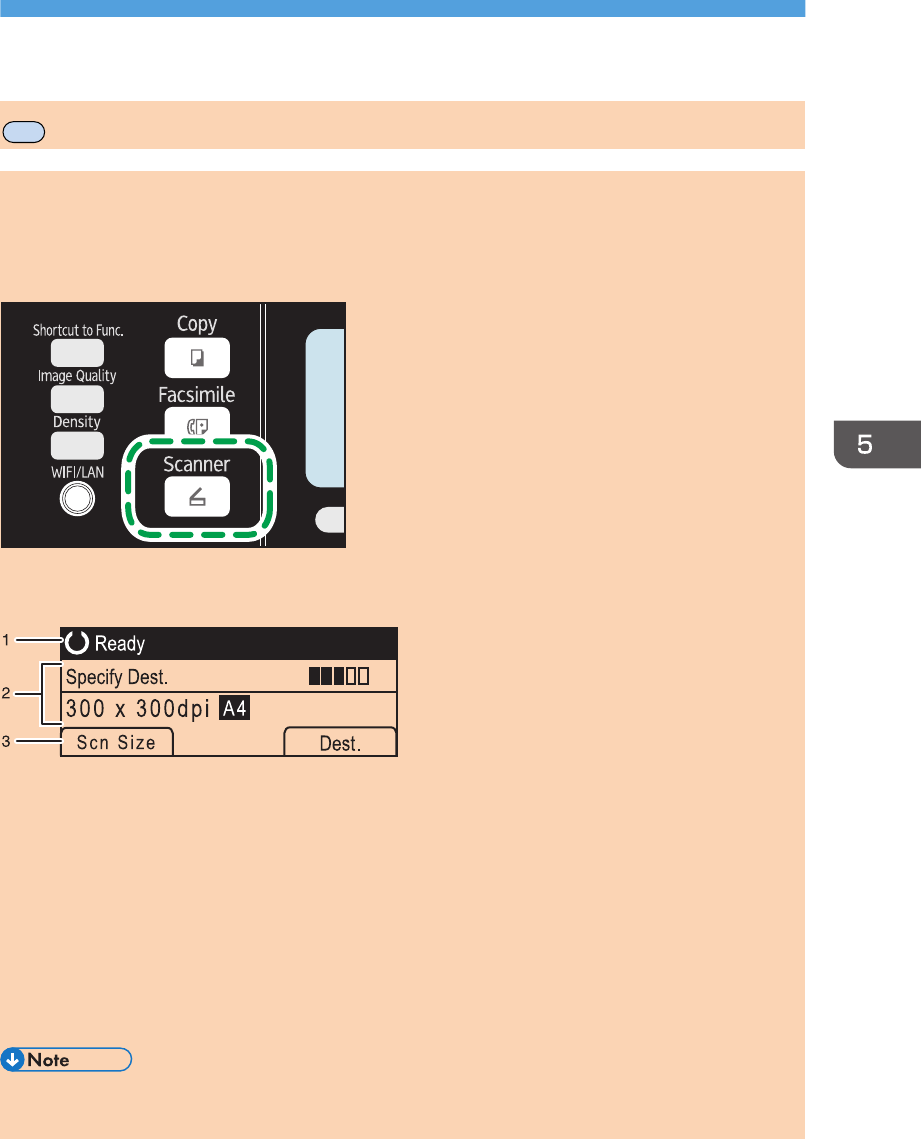
5. Scanning Originals
MF
Scanner Mode Screen
This section provides information about the screen in scanner mode.
By default, the display shows the copier screen when the machine is turned on. If the copier or fax
screen is shown on the display, press the [Scanner] key on the control panel to switch to the scanner
screen.
DCT850
Screen in standby mode
DCT857
1. Current status or messages
Displays the current status or messages.
2. Current settings
Displays the current scanning mode and scan settings.
• When "Specify Dest." is displayed:
Scan to E-mail, Scan to FTP, or Scan to Folder functions can be used.
3. Selection key items
Displays the functions you can use by pressing the corresponding selection keys.
• The machine's default mode at power on can be specified in the [Function Priority] setting under
[Admin. Tools]. For [Function Priority], see page 159 "Administrator Settings".
opal-p2_mf2_com_user_guide_00142098_eng.xml 79
Draft 2014/01/07
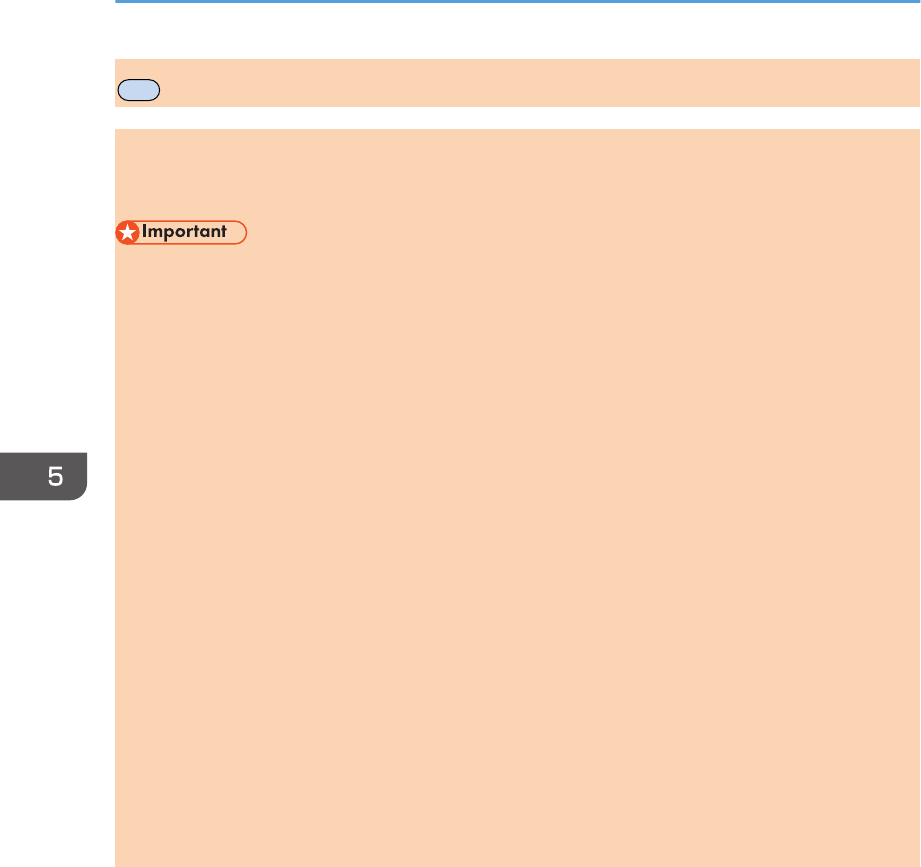
MF
Registering Scan Destinations
This section describes how to register scan destinations in the Address Book. To send scanned files to an
e-mail address (Scan to E-mail), FTP server (Scan to FTP), or a shared folder on a network computer
(Scan to Folder), you must first register the destination in the Address Book using Web Image Monitor.
• The Address Book data could be damaged or lost unexpectedly. The manufacturer shall not be
responsible for any damages resulting from such data loss. Be sure to create backup files of the
Address Book data periodically.
• Depending on your network environment, the Scan to FTP and Scan to Folder functions may
require a user name and password to be correctly entered in the destination information. In such
cases, after registering destinations, check that the user name and password are correctly entered
by sending test documents to those destinations.
The Address Book can contain up to 100 entries, including 8 Quick Dial entries.
Destinations registered as Quick Dial entries can be selected by pressing the corresponding One Touch
button.
1. Start the Web browser, and access the machine by entering its IP address.
2. Click [Quick Dial Destination] or [Scan Destination].
3. From the [Destination Type] list, select [E-mail Address], [FTP] or [Folder].
4. Register information as necessary.
The information you must register varies depending on the destination type. For details, see the
tables below.
5. Enter the administrator password if required.
6. Click [Apply].
7. Close the Web browser.
5. Scanning Originals
80 opal-p2_mf2_com_user_guide_00142099_eng.xml
Draft 2014/01/07
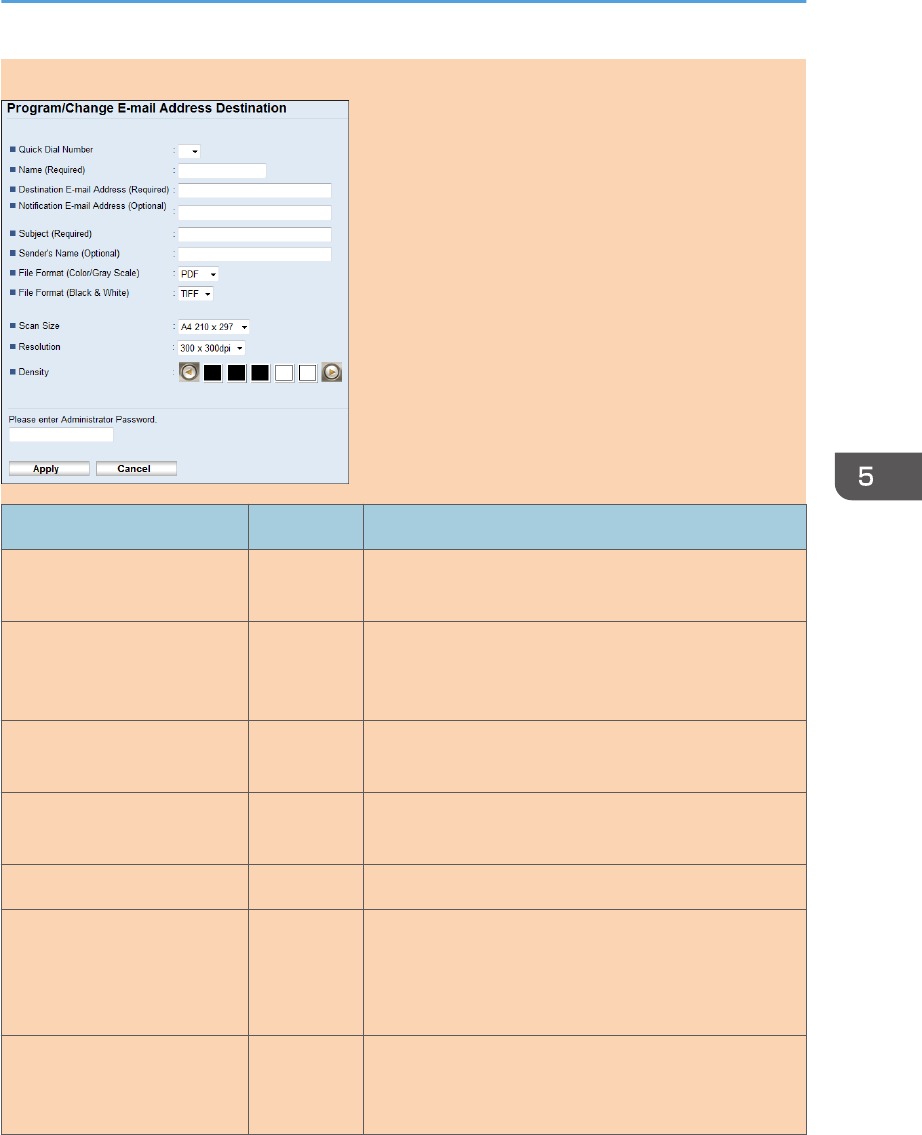
Scan to E-mail Settings
Item Setting Description
Quick Dial Number Optional Select when setting the destination as a Quick Dial
entry.
Name Required Name of the destination. The name specified here will
be shown on the screen when selecting a scan
destination. Can contain up to 16 characters.
Destination E-mail Address Required E-mail address of the destination. Can contain up to
64 characters.
Notification E-mail Address Optional E-mail address to which a notification is sent after
transmission. Can contain up to 64 characters.
Subject Required Subject of the e-mail. Can contain up to 64 characters.
Sender's Name Optional Name of e-mail sender. The name specified here will
be shown under "From" or a similar field of the
recipient's email application. Can contain up to 32
characters.
File Format (Color/Gray
Scale)
Required File format of the scanned file when scanning in color.
PDF or JPEG can be selected. PDF supports multiple
pages in a document, but JPEG does not.
Registering Scan Destinations
opal-p2_mf2_com_user_guide_00142099_eng.xml 81
Draft 2014/01/07
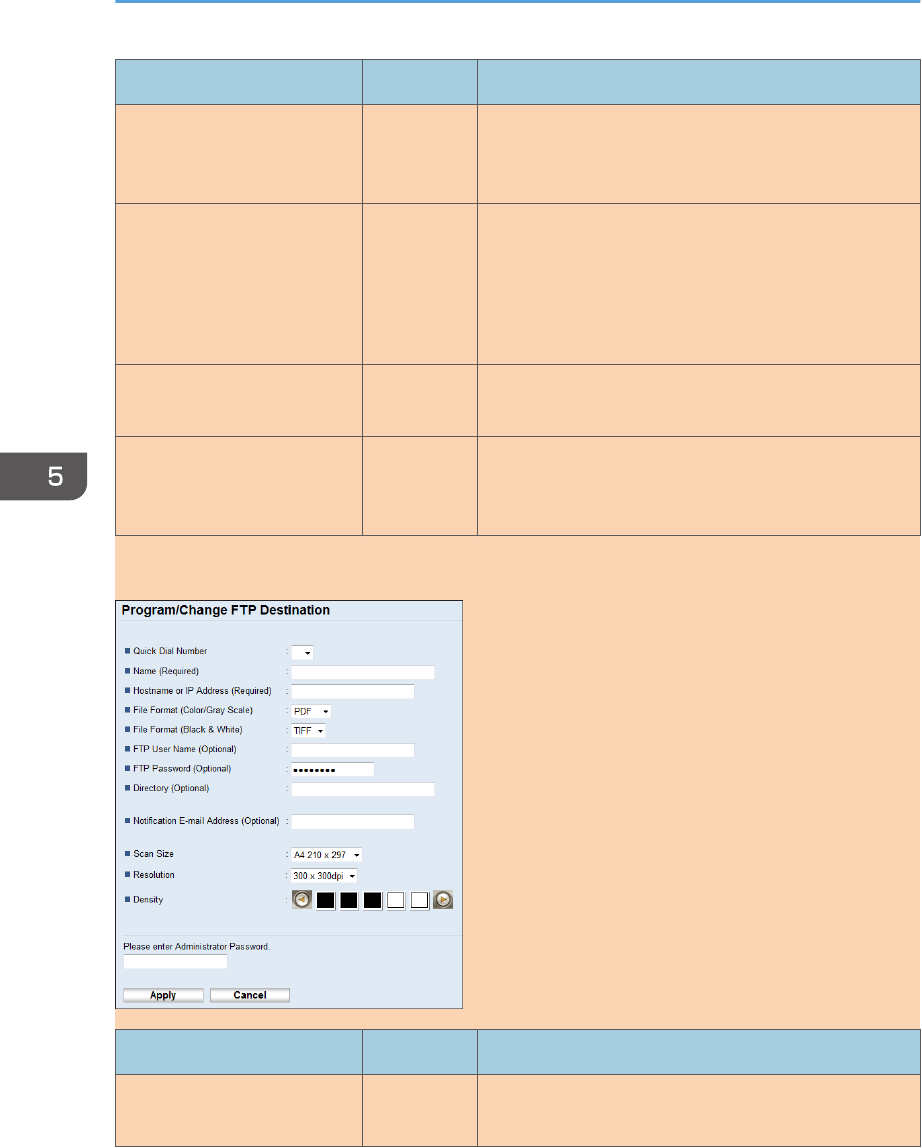
Item Setting Description
File Format (Black & White) Required File format of the scanned file when scanning in black
and white. PDF or TIFF can be selected. Both formats
support multiple pages in a document.
Scan Size Optional Select the scanning size for the original from A5, B5,
A4, Executive, Half Letter, Letter, Legal, 16K, or
custom size.
If you select custom size, select [mm] or [Inch], and
then specify the width and length.
Resolution Optional Select the scan resolution from 100×100, 150×150,
200×200, 300×300, 400×400, or 600×600 dpi.
Density Optional Specify the image density by clicking the right or left
buttons. These keys increase or decrease the image
density in single increments up to 5.
Scan to FTP Settings
Item Setting Description
Quick Dial Number Optional Select when setting the destination as a Quick Dial
entry.
5. Scanning Originals
82 opal-p2_mf2_com_user_guide_00142099_eng.xml
Draft 2014/01/07
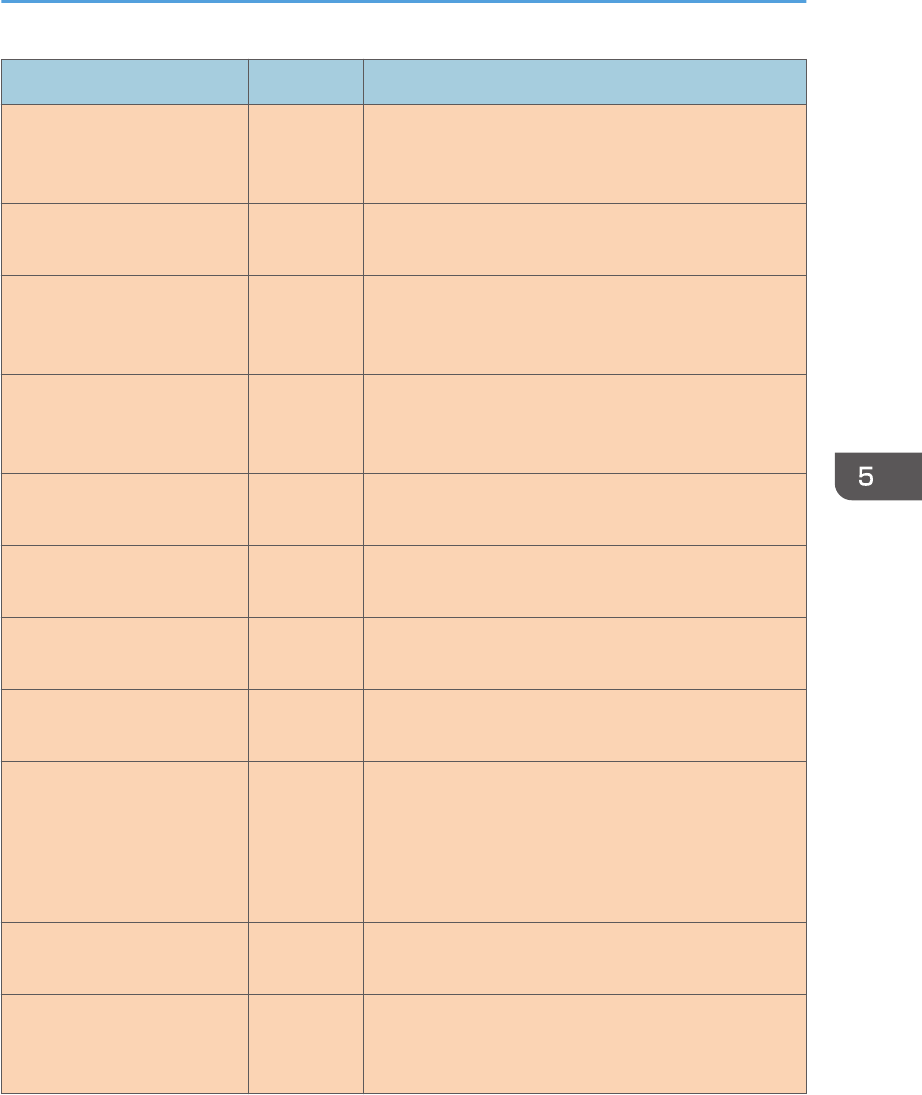
Item Setting Description
Name Required Name of the destination. The name specified here will
be shown on the screen when selecting a scan
destination. Can contain up to 16 characters.
Hostname or IP Address Required Name or IP address of the FTP server. Can contain up
to 64 characters.
File Format (Color/Gray
Scale)
Required File format of the scanned file when scanning in color.
PDF or JPEG can be selected. PDF supports multiple
pages in a document, but JPEG does not.
File Format (Black & White) Required File format of the scanned file when scanning in black
and white. PDF or TIFF can be selected. Both formats
support multiple pages in a document.
FTP User Name Optional User name for logging in to the FTP server. Can
contain up to 32 characters.
FTP Password Optional Password for logging in to the FTP server. Can contain
up to 32 characters.
Directory Optional Name of the FTP server directory where scanned files
are stored. Can contain up to 64 characters.
Notification E-mail Address Optional E-mail address to which a notification is sent after
transmission. Can contain up to 64 characters.
Scan Size Optional Select the scanning size for the original from A5, B5,
A4, Executive, Half Letter, Letter, Legal, 16K, or
custom size.
If you select custom size, select [mm] or [Inch], and
then specify the width and length.
Resolution Optional Select the scan resolution from 100×100, 150×150,
200×200, 300×300, 400×400, or 600×600 dpi.
Density Optional Specify the image density by clicking the right or left
buttons. These keys increase or decrease the image
density in single increments up to 5.
Registering Scan Destinations
opal-p2_mf2_com_user_guide_00142099_eng.xml 83
Draft 2014/01/07
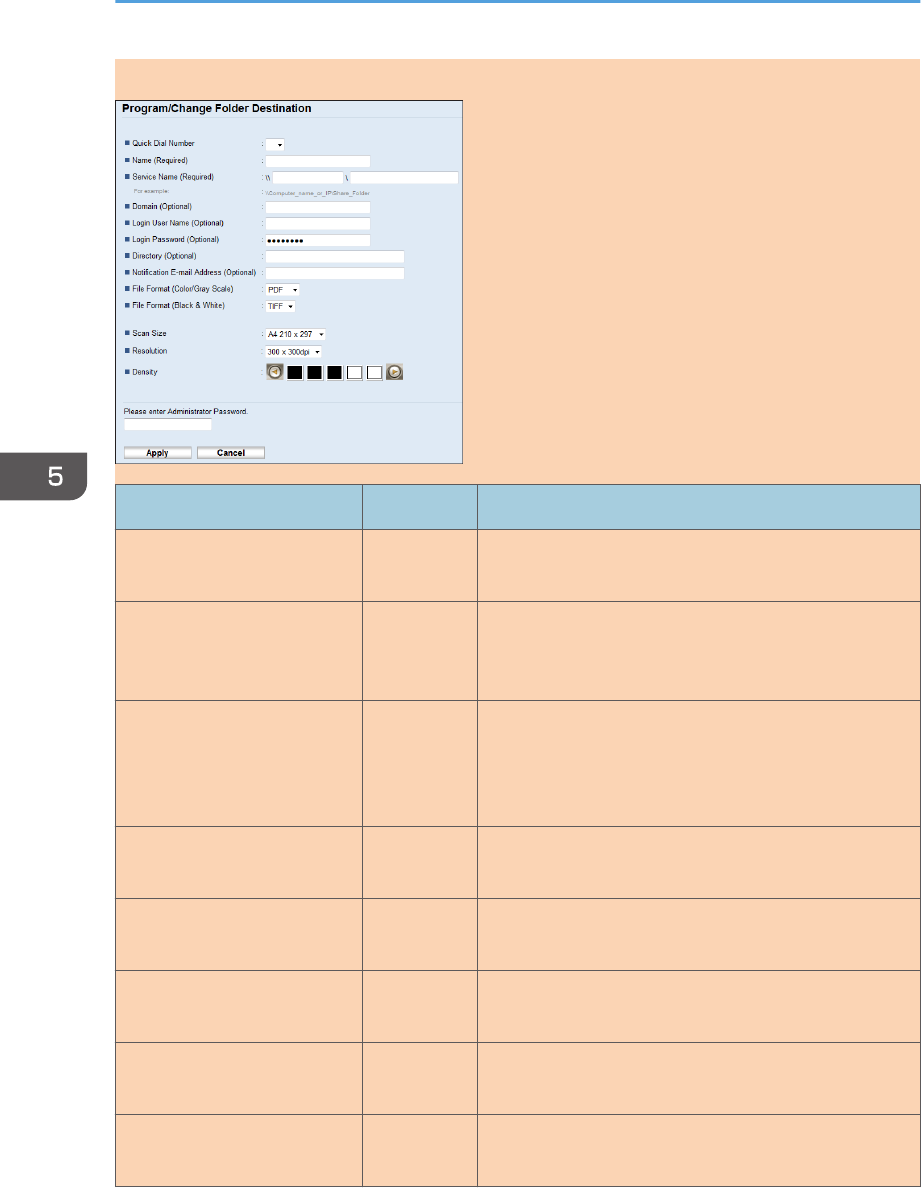
Scan to Folder Settings
Item Setting Description
Quick Dial Number Optional Select when setting the destination as a Quick Dial
entry.
Name Required Name of the destination. The name specified here will
be shown on the screen when selecting a scan
destination. Can contain up to 16 characters.
Service Name Required Path to the directory where scanned files will be stored.
Consists of the IP address or name of the destination
computer (can contain up to 64 characters), and name
of the shared folder (can contain up to 32 characters).
Domain Optional Specify the name of the domain to which the computer
belongs. Can contain up to 15 characters.
Login User Name Optional User name for logging in to the destination computer.
Can contain up to 32 characters.
Login Password Optional Password for logging in to the destination computer.
Can contain up to 32 characters.
Directory Optional Directory within the shared folder for storing scanned
files. Can contain up to 64 characters.
Notification E-mail Address Optional E-mail address to which a notification is sent after
transmission. Can contain up to 64 characters.
5. Scanning Originals
84 opal-p2_mf2_com_user_guide_00142099_eng.xml
Draft 2014/01/07
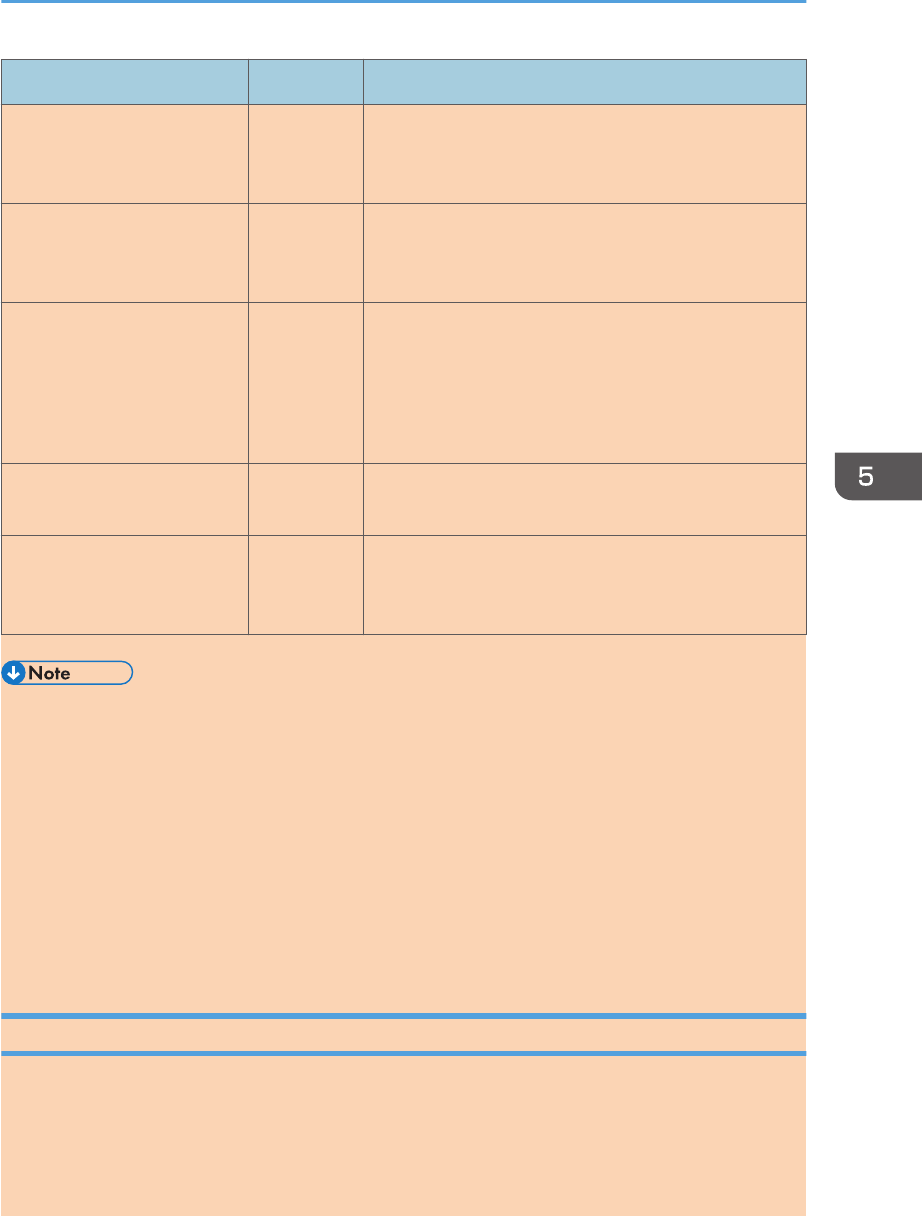
Item Setting Description
File Format (Color/Gray
Scale)
Required File format of the scanned file when scanning in color.
PDF or JPEG can be selected. PDF supports multiple
pages in a document, but JPEG does not.
File Format (Black & White) Required File format of the scanned file when scanning in black
and white. PDF or TIFF can be selected. Both formats
support multiple pages in a document.
Scan Size Optional Select the scanning size for the original from A5, B5,
A4, Executive, Half Letter, Letter, Legal, 16K, or
custom size.
If you select custom size, select [mm] or [Inch], and
then specify the width and length.
Resolution Optional Select the scan resolution from 100×100, 150×150,
200×200, 300×300, 400×400, or 600×600 dpi.
Density Optional Specify the image density by clicking the right or left
buttons. These keys increase or decrease the image
density in single increments up to 5.
• To send files via e-mail, SMTP and DNS settings must be configured properly.
• If you are using the Scan to E-mail function, select a time zone according to your geographic
location to send email with correct transmission date and time.
• To send files to an FTP server or computer, the user name, password, and directory must be
configured properly.
• On a network that uses a DNS server, specify a computer name in [Service Name] and the name
of the domain to which the computer belongs in [Domain]. In this case, also configure the DNS
related settings using Web Image Monitor.
• Scan destinations cannot be registered using the control panel.
Modifying Scan Destinations
This section describes how to modify the information of registered destinations.
1. Start the Web browser, and access the machine by entering its IP address.
2. Click [Scan Destination].
3. Click the [E-mail Address], [FTP], or [Folder] tab.
Registering Scan Destinations
opal-p2_mf2_com_user_guide_00142099_eng.xml 85
Draft 2014/01/07
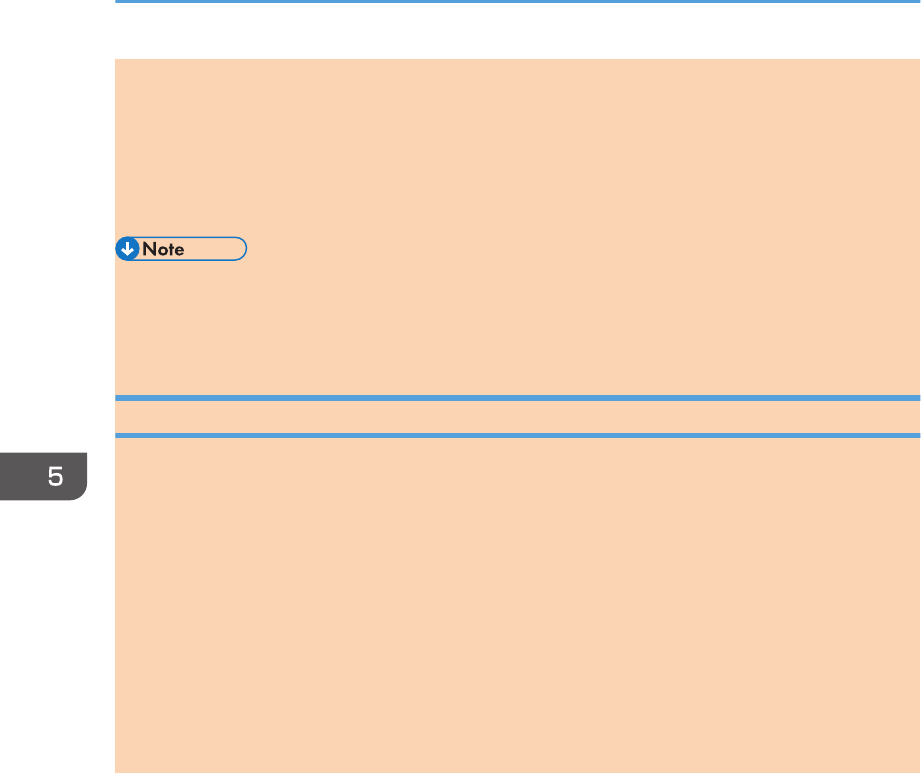
4. Select the entry to modify, and then click [Change].
5. Modify settings as necessary.
6. Enter the administrator password if required.
7. Click [Apply].
8. Close the Web browser.
• You can unassign a Quick Dial entry from a One-touch button from the [Quick Dial Destination]
page. To do this, select the desired entry, click [Delete], and then click [Apply] again on a
confirmation page.
Deleting Scan Destinations
This section describes how to delete registered destinations.
1. Start the Web browser, and access the machine by entering its IP address.
2. Click [Scan Destination].
3. Click the [E-mail Address], [FTP], or [Folder] tab.
4. Select the entry to delete, and then click [Delete].
5. Confirm that the entry you have selected is the entry that you want to delete.
6. Enter the administrator password if required.
7. Click [Apply].
8. Close the Web browser.
5. Scanning Originals
86 opal-p2_mf2_com_user_guide_00142099_eng.xml
Draft 2014/01/07
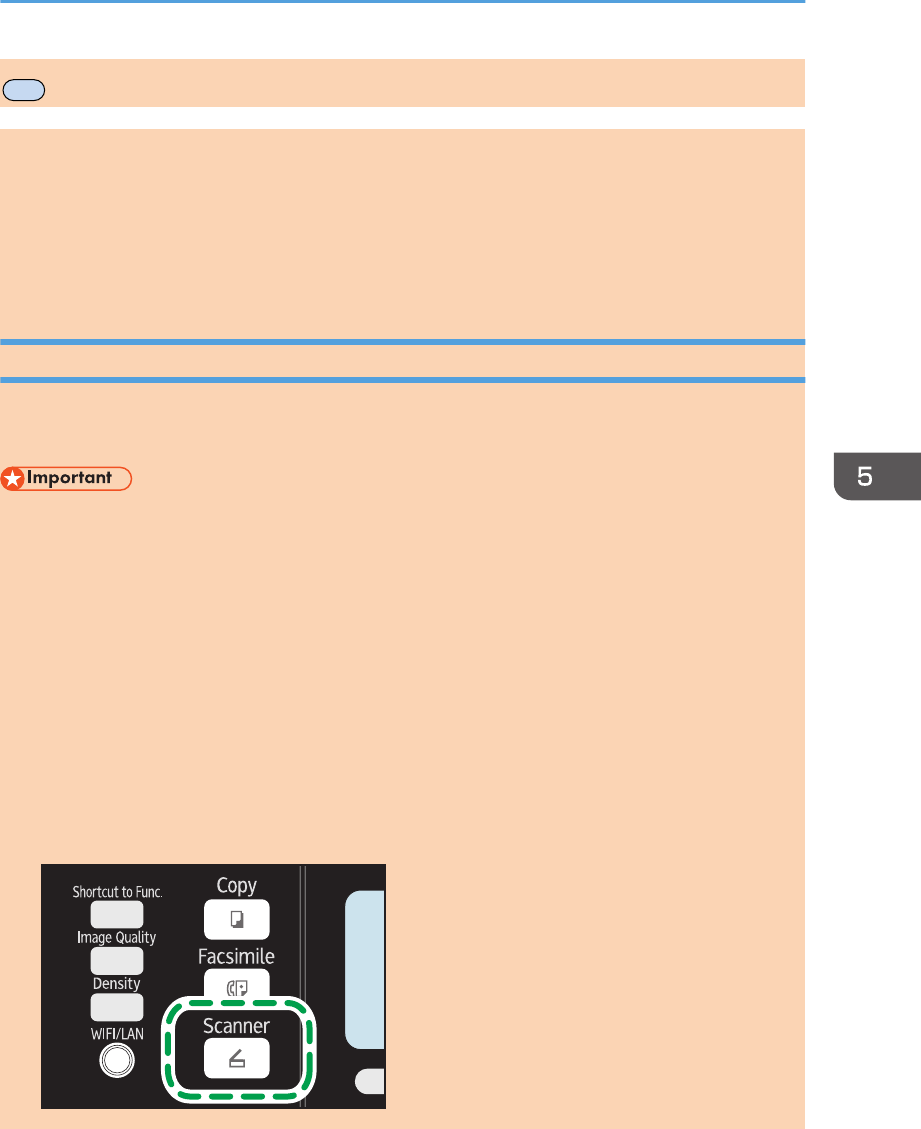
MF
Basic Operation
Scanning using the control panel allows you to send scanned files via e-mail (Scan to E-mail), to an FTP
server (Scan to FTP), or to the shared folder of a computer on a network (Scan to Folder), or to a USB
flash disk (Scan to USB).
The Scan to E-mail, Scan to FTP, and Scan to Folder functions are available only through a network
connection. No network connection is required for the Scan to USB function; you can send scanned files
directly to a USB flash disk inserted into the front of the machine.
Scan to E-mail/FTP/Folder
This section describes the basic operation for sending scanned files via e-mail, to an FTP server, or to a
computer, depending on the specified destination.
• The original in the ADF takes precedence over the original on the exposure glass if you place
originals both in the ADF and on the exposure glass.
• When using the Scan to E-mail, Scan to FTP or Scan to Folder function, you must first register the
destination in the Address Book using Web Image Monitor. For details, see page 80 "Registering
Scan Destinations".
• Depending on the model, the Scan to E-mail/FTP/Folder function may not be available. For details
about the differences between models, see page 8 "Differences in Performance/Functions between
Different Models".
1. Place the original on the exposure glass or in the ADF.
To place the original, see page 54 "Placing Originals".
2. Press the [Scanner] key.
DCT850
Basic Operation
opal-p2_mf2_com_user_guide_00142100_eng.xml 87
Draft 2014/01/07
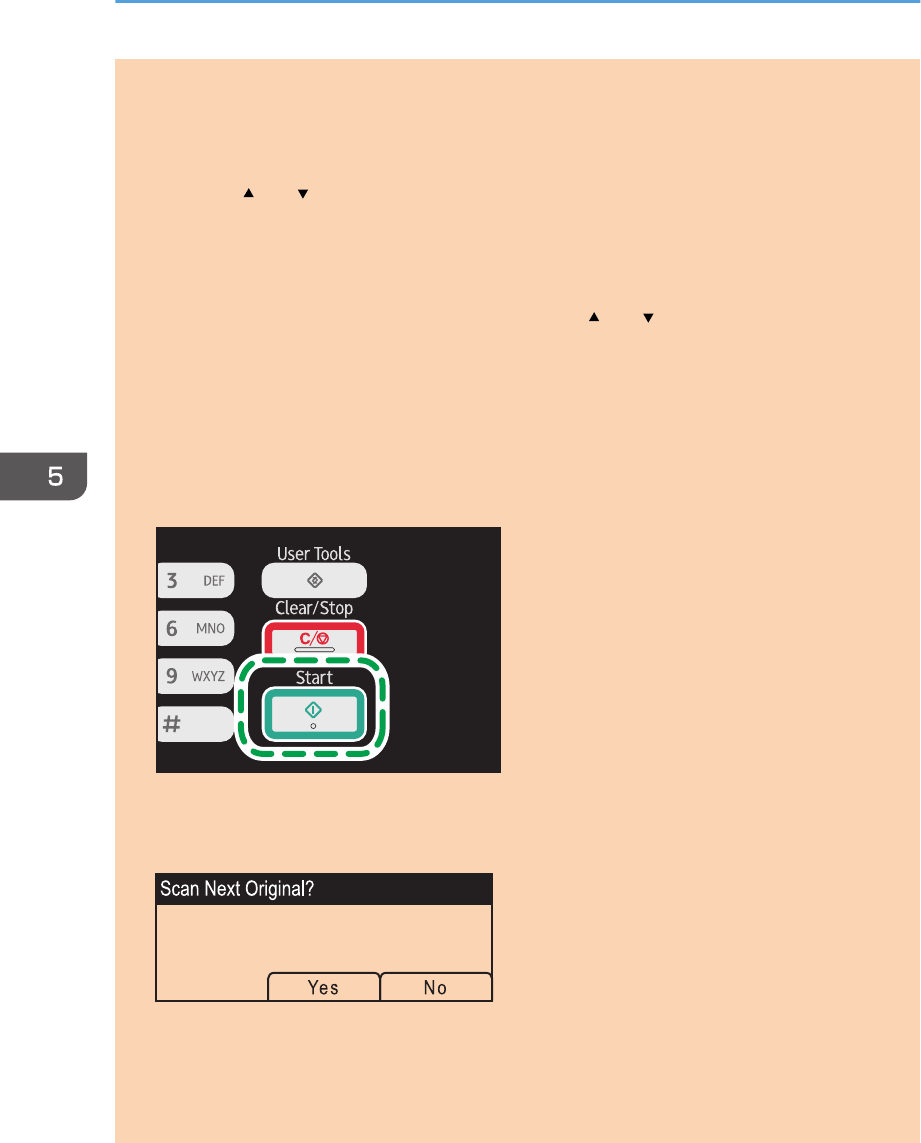
3. Press the [Address Book] key or [Dest.].
Alternatively, you can press the [Shortcut to Func.] key if [Shortcut to Function] under administrator
settings is set to [Select Scanner Dest.]. For [Shortcut to Function], see page 159 "Administrator
Settings".
4. Press the [ ] or [ ] key to select [Search Address Book], and then press the [OK] key.
If you want to search for a specific entry by its name, enter the first letters of the name using the
number keys, and then press the [OK] key. Each time you enter a character, the display changes to
show the matching name.
5. Search for the desired destination by pressing the [ ] or [ ] key to scroll the Address
Book, and then press the [OK] key.
When you specify a scan destination, the machine's scan settings change automatically according
to the information registered for that destination in the Address Book. If necessary, you can change
the scan settings using the control panel. For scan settings, see page 92 "Specifying the Scan
Settings".
6. Press the [Start] key.
DCT847
Depending on the machine's settings, you may see the following screen on the display when
scanning from the exposure glass.
If you see this screen, proceed to the next step.
7. If you have more originals to scan, place the next original on the exposure glass, and
then press [Yes]. Repeat this step until all originals are scanned.
8. When all originals have been scanned, press [No] to start sending the scanned file.
5. Scanning Originals
88 opal-p2_mf2_com_user_guide_00142100_eng.xml
Draft 2014/01/07
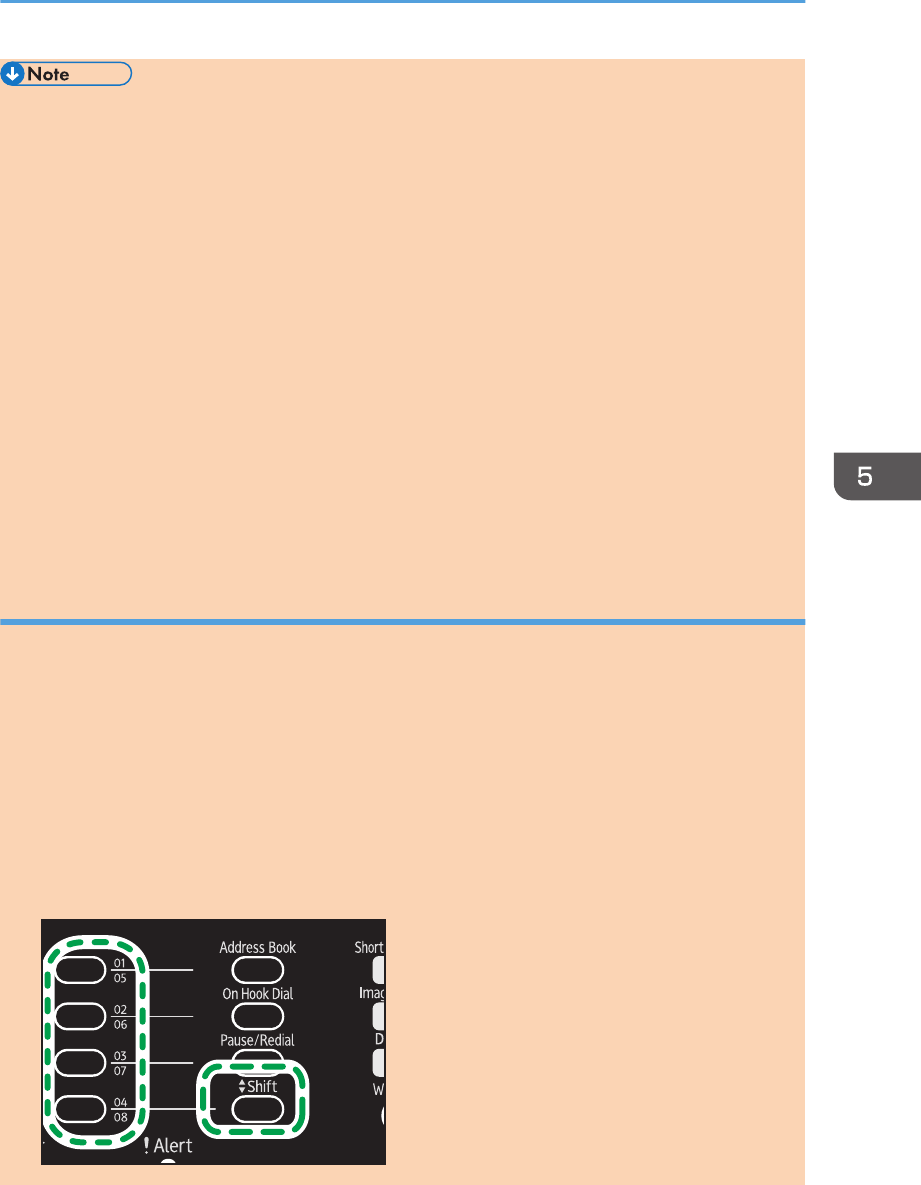
• To cancel scanning, press the [Scanner] key, and then press the [Clear/Stop] key. The scan files
are discarded.
• You can configure the machine to scan documents in black and white, color, or grayscale by
changing the [Scanning Mode] setting under scan settings. For details, see page 135 "Scanner
Features Settings".
• You can also specify a destination using the One Touch buttons, [Pause/Redial] key.
• If the [Limitless Scan] setting under scan settings is enabled, you can place originals on the
exposure glass repeatedly in a single scan procedure. For details, see page 135 "Scanner
Features Settings".
• If [File Type] under scan settings is set to [Multi-page], you can scan multiple pages to create a
single PDF or TIFF file containing all pages. However, if the file format is JPEG, a single-page file
will be created for every page scanned. For details, see page 135 "Scanner Features Settings".
• If paper is jammed in the ADF, the scan job will be discarded. Remove the jammed paper and scan
the entire originals again. For the direction to remove paper jammed in the ADF, see page 210
"Paper Feed Problems".
Specifying the scan destination using the One Touch buttons or [Pause/Redial] key
This section describes how to specify a destination using the following keys:
• One Touch buttons
Use these to specify destinations registered as Quick Dial entries.
• [Pause/Redial] key
Press this to specify the last used destination as the destination for the current job.
Using the One Touch buttons
Press the One Touch button to which the desired Quick Dial entry is registered.
Press the [Shift] key to use the Quick Dial entries Nos. 5 to 8.
DCT878
Basic Operation
opal-p2_mf2_com_user_guide_00142100_eng.xml 89
Draft 2014/01/07
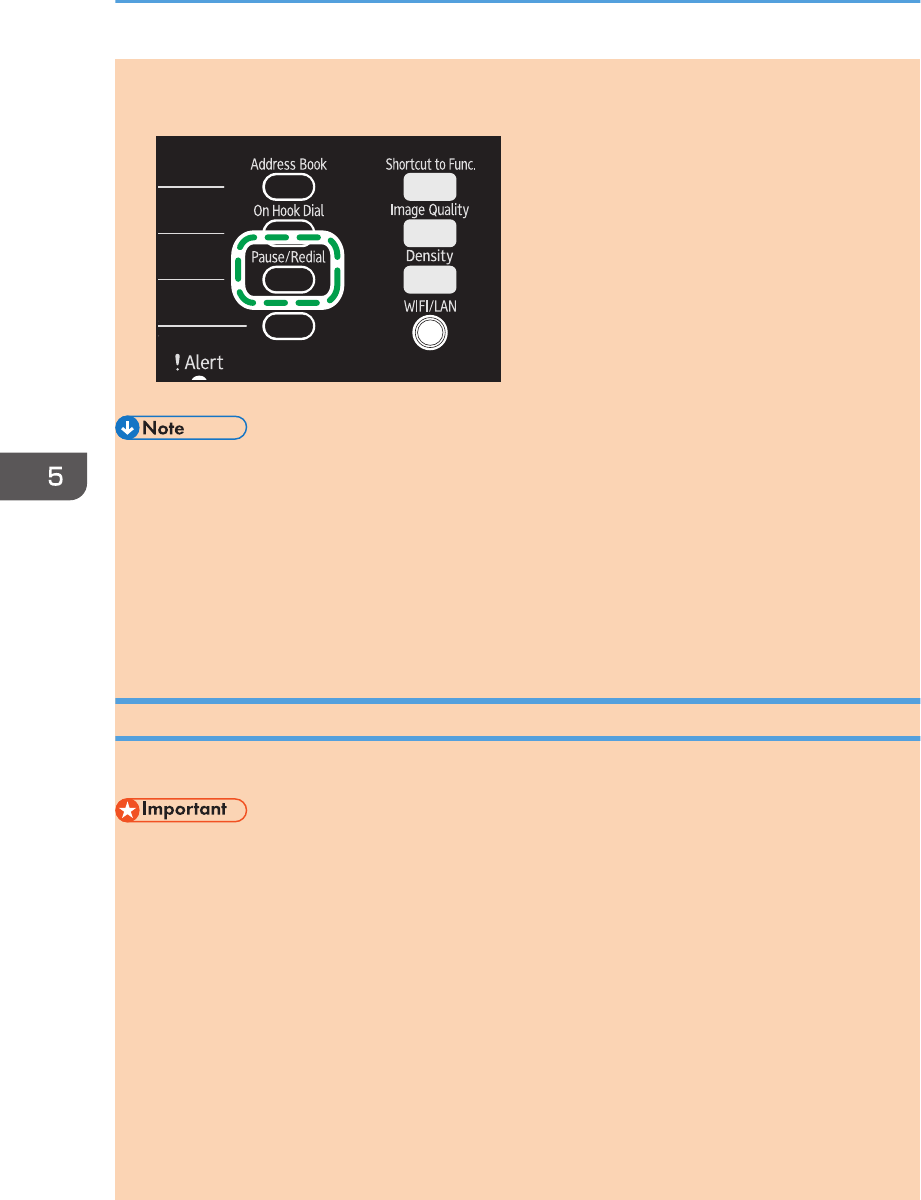
Using the [Pause/Redial] key
Press the [Pause/Redial] key to select the last used destination.
DCT877
• When you specify a scan destination, the machine's scan settings change automatically according
to the information registered for that destination in the Address Book. If necessary, you can change
the scan settings using the control panel. For scan settings, see page 92 "Specifying the Scan
Settings".
• The [Pause/Redial] key is not effective for the first scan job after the machine is turned on.
• To select destinations not registered as Quick Dial entries, use the [Address Book] key. For
specifying destinations using the [Address Book] key, see page 87 "Scan to E-mail/FTP/Folder".
Basic Operation for Scan to USB
This section describes the basic operation for sending scanned files to a USB flash disk.
• With the Type 1 models, the copier and fax functions are not available if the USB flash disk is
inserted.
• With the Type 1 and 5 models, the copier and fax functions are not available if the USB flash disk
is inserted.
• If the machine fails to switch to the Scan to USB mode even after the USB flash disk is inserted, set
[Save Scn Data to USB] to [Active].
• The original in the ADF takes precedence over the original on the exposure glass if you place
originals both in the ADF and on the exposure glass.
• This machine does not support the use of USB flash disks connected to external USB hubs. Insert
your USB flash disk directly into the USB flash disk port located at the top left corner of the
machine.
• Certain types of USB flash disks cannot be used.
5. Scanning Originals
90 opal-p2_mf2_com_user_guide_00142100_eng.xml
Draft 2014/01/07
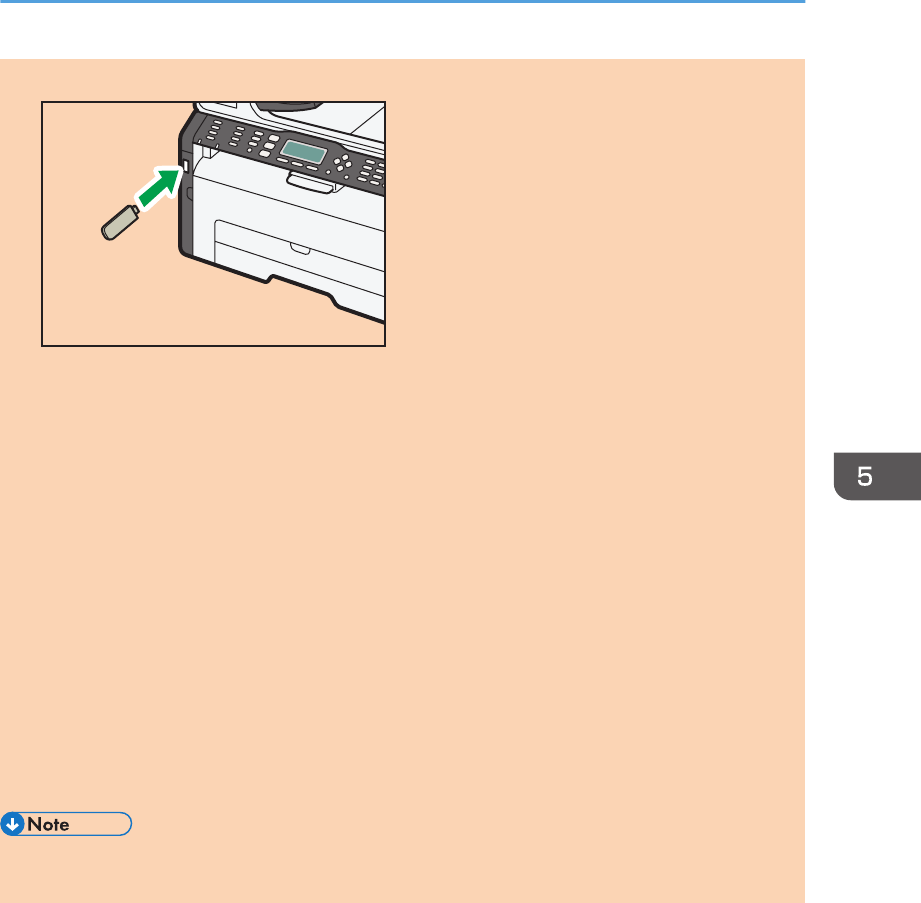
1. Insert your USB flash disk into the USB flash disk port.
DCT039
"Loading..." appears on the display. Wait until the display changes to show "Save Scn Data to
USB" (the duration depends on your USB flash disk).
2. Place the original on the exposure glass or in the ADF.
If necessary, configure advanced scan settings. For details, see page 92 "Specifying the Scan
Settings".
3. Press the [Start] key.
4. Select file format.
5. If you have more originals to scan, place the next original on the exposure glass, and
then press [Yes]. Repeat this step until all originals are scanned.
6. When all originals have been scanned, press [No] to start sending the scanned file.
7. Confirm that "Ready" appears on the display.
The scanned file is created in the root directory of the USB flash disk.
8. Remove the USB flash disk from the machine.
• To cancel scanning, press the [Scanner] key, and then press the [Clear/Stop] key. The scan files
are discarded.
Basic Operation
opal-p2_mf2_com_user_guide_00142100_eng.xml 91
Draft 2014/01/07
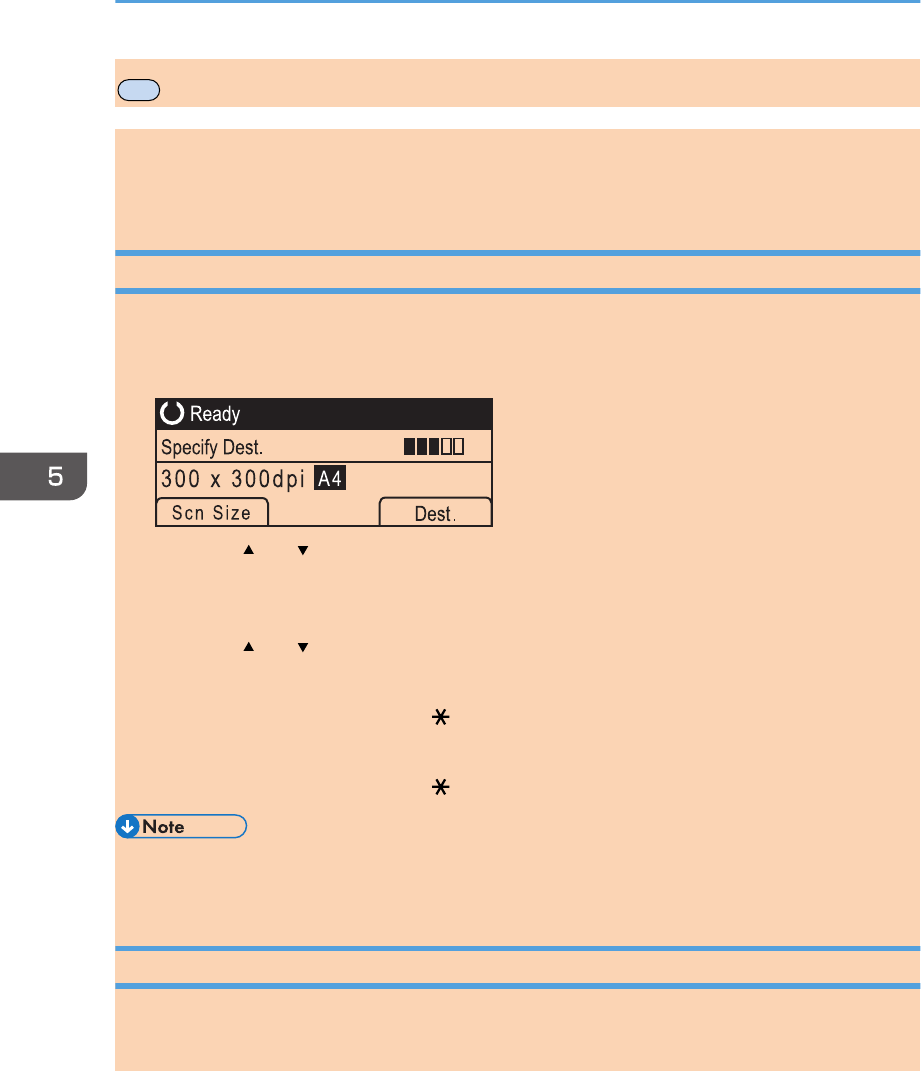
MF
Specifying the Scan Settings
When you specify a scan destination, the machine's scan settings change automatically according to the
information registered for that destination in the Address Book. If necessary, you can change the scan
settings for the current job using the control panel.
Specifying the Scanning Size According to the Size of the Original
This section describes how to specify the scanning size according to the size of the current original.
1. Press [Scn Size].
2. Press the [ ] or [ ] key to select the size of the original, and then press the [OK] key.
If you selected anything other than [Custom Size], you do not need to perform the remaining steps
of the procedure.
3. Press the [ ] or [ ] key to select [mm] or [inch], and then press the [OK] key.
4. Enter the width using the number keys, and then press the [OK] key.
To enter a decimal point, press the [ ] key.
5. Enter the length using the number keys, and then press the [OK] key.
To enter a decimal point, press the [ ] key.
• You can change the machine's default [Scan Size] setting to always scan originals with a specific
scanning size. For details, see page 135 "Scanner Features Settings".
Adjusting Image Density
This section describes how to adjust image density for the current job.
There are five image density levels. The higher the density level, the darker the scanned image.
5. Scanning Originals
92 opal-p2_mf2_com_user_guide_00142102_eng.xml
Draft 2014/01/07
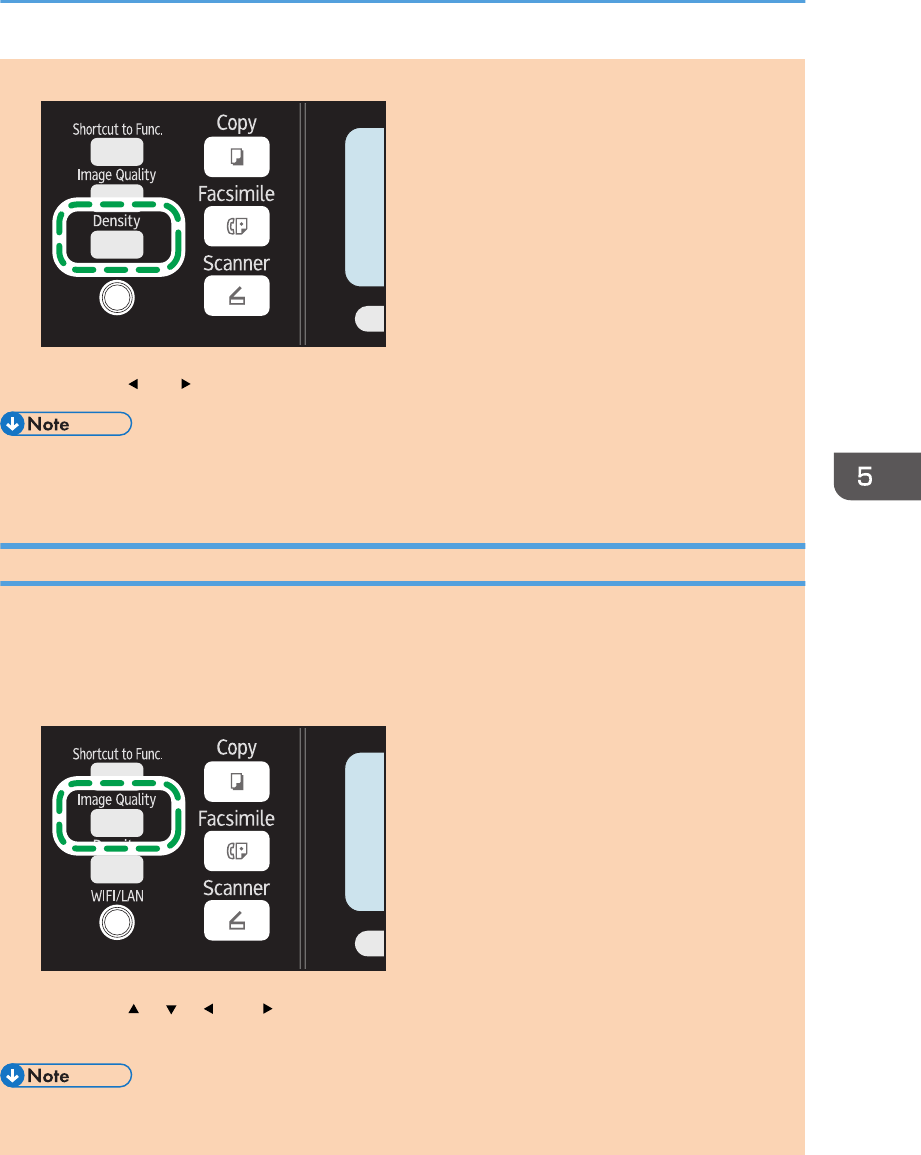
1. Press the [Density] key.
DCT874
2. Press the [ ] or [ ] key to select the desired density level, and then press the [OK] key.
• You can change the machine's default [Density] setting to always scan with a specific density level.
For details, see page 135 "Scanner Features Settings".
Specifying Resolution
This section describes how to specify the scan resolution for the current job.
There are six resolution settings. The higher the resolution, the higher the quality but greater the file size.
1. Press the [Image Quality] key.
DCT875
2. Press the [ ], [ ], [ ], or [ ] key to select the desired resolution, and then press the [OK]
key.
• You can change the machine's default [Resolution] setting to always scan with a specific resolution
level. For details, see page 135 "Scanner Features Settings".
Specifying the Scan Settings
opal-p2_mf2_com_user_guide_00142102_eng.xml 93
Draft 2014/01/07
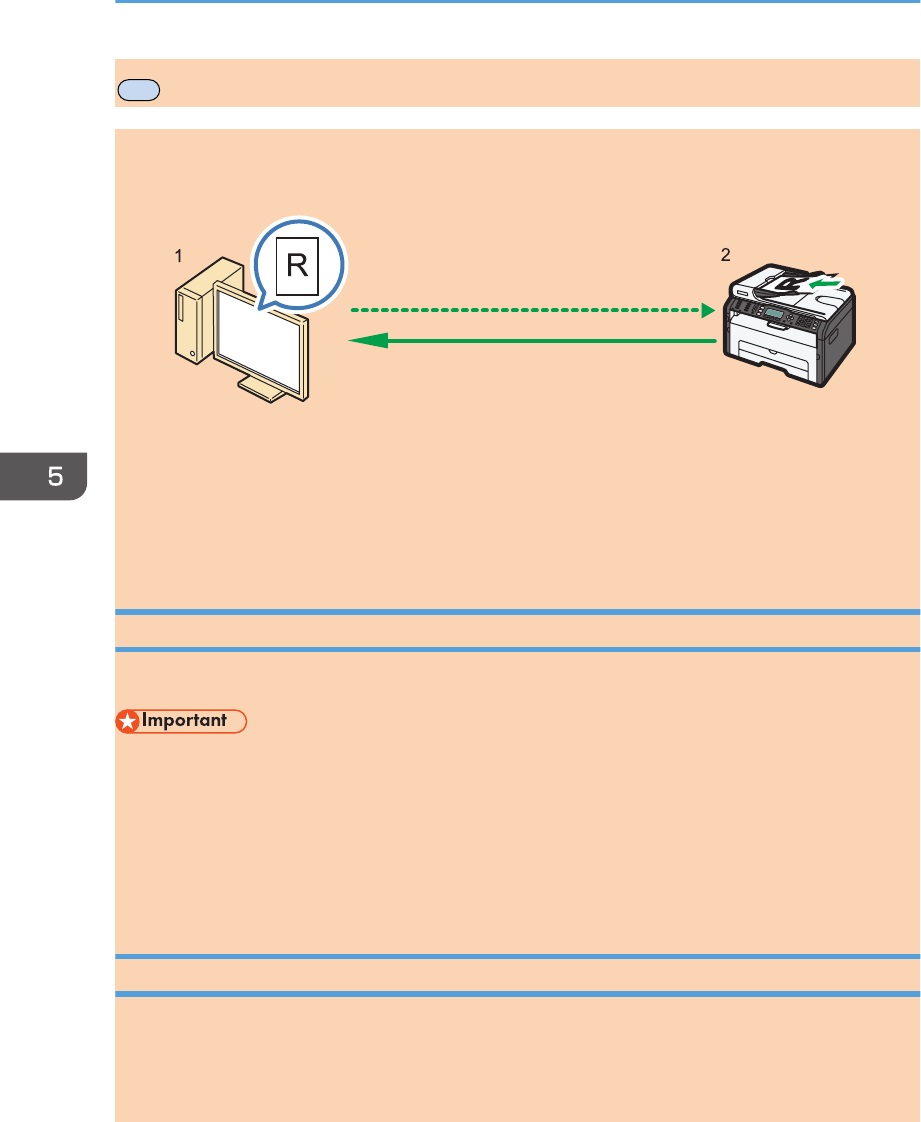
MF
Scanning from a Computer
Scanning from a computer (TWAIN scanning and WIA scanning) allows you to operate the machine
from your computer and scan originals into your computer directly.
DCT066
1. Your Computer (TWAIN driver already installed)
Instruct the machine to start scanning the original that is set on the machine.
2. This Machine
The original that is set on the machine is scanned, and its data is sent to a client computer.
Using TWAIN scanner
This section describes the preparations and procedure for using the TWAIN scanner.
• To use the TWAIN scanner, you must install the TWAIN driver, which is on the supplied CD-ROM.
• To use the TWAIN scanner, a TWAIN-compliant application must be installed.
To use the machine as a TWAIN scanner, first do the following:
• Install the TWAIN driver.
• Install a TWAIN-compliant application.
TWAIN Scanning
TWAIN scanning is possible if your computer is running a TWAIN-compatible application.
The following procedure uses Windows 7 and Microsoft Office Document Scanning as an example.
1. Place the original.
5. Scanning Originals
94 opal-p2_mf2_com_user_guide_00142103_eng.xml
Draft 2014/01/07
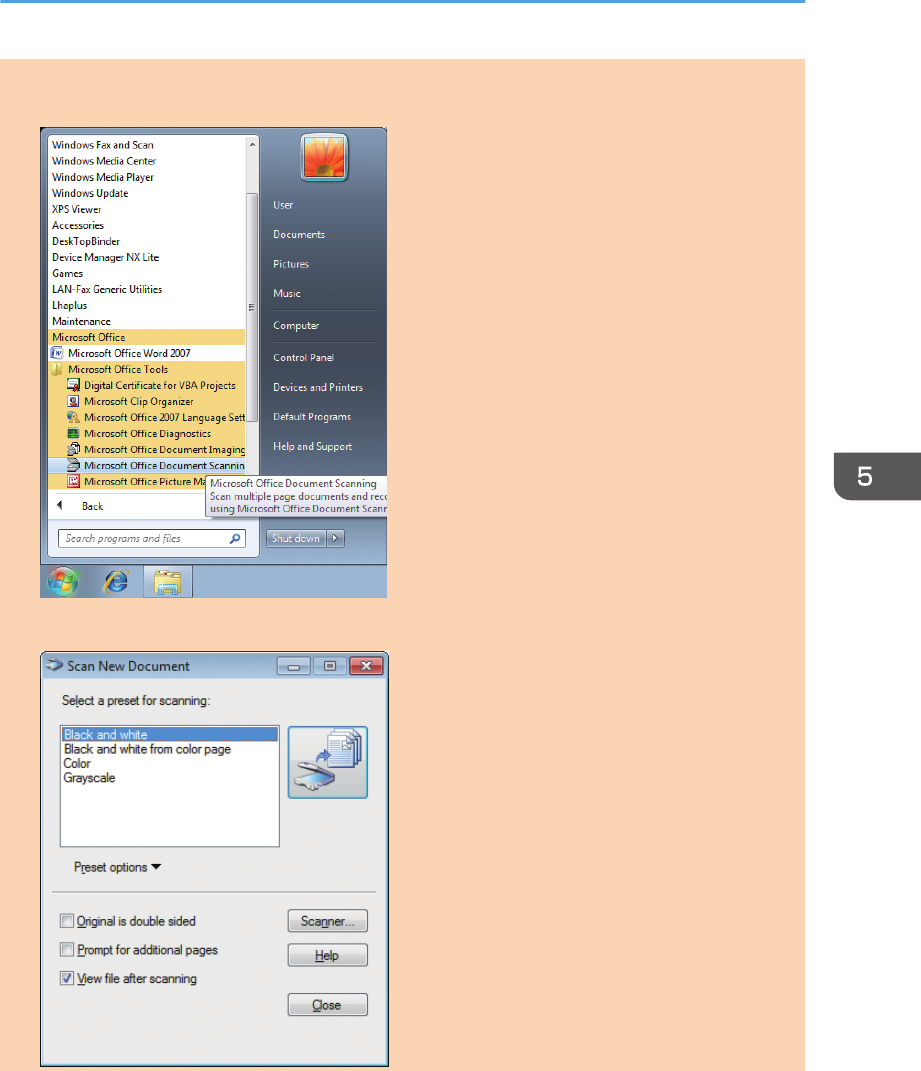
2. On the [Start] menu, point to [All Programs], point to [Microsoft Office], point to
[Microsoft Office Tools], and then click [Microsoft Office Document Scanning].
3. Click [Scanner…].
Scanning from a Computer
opal-p2_mf2_com_user_guide_00142103_eng.xml 95
Draft 2014/01/07
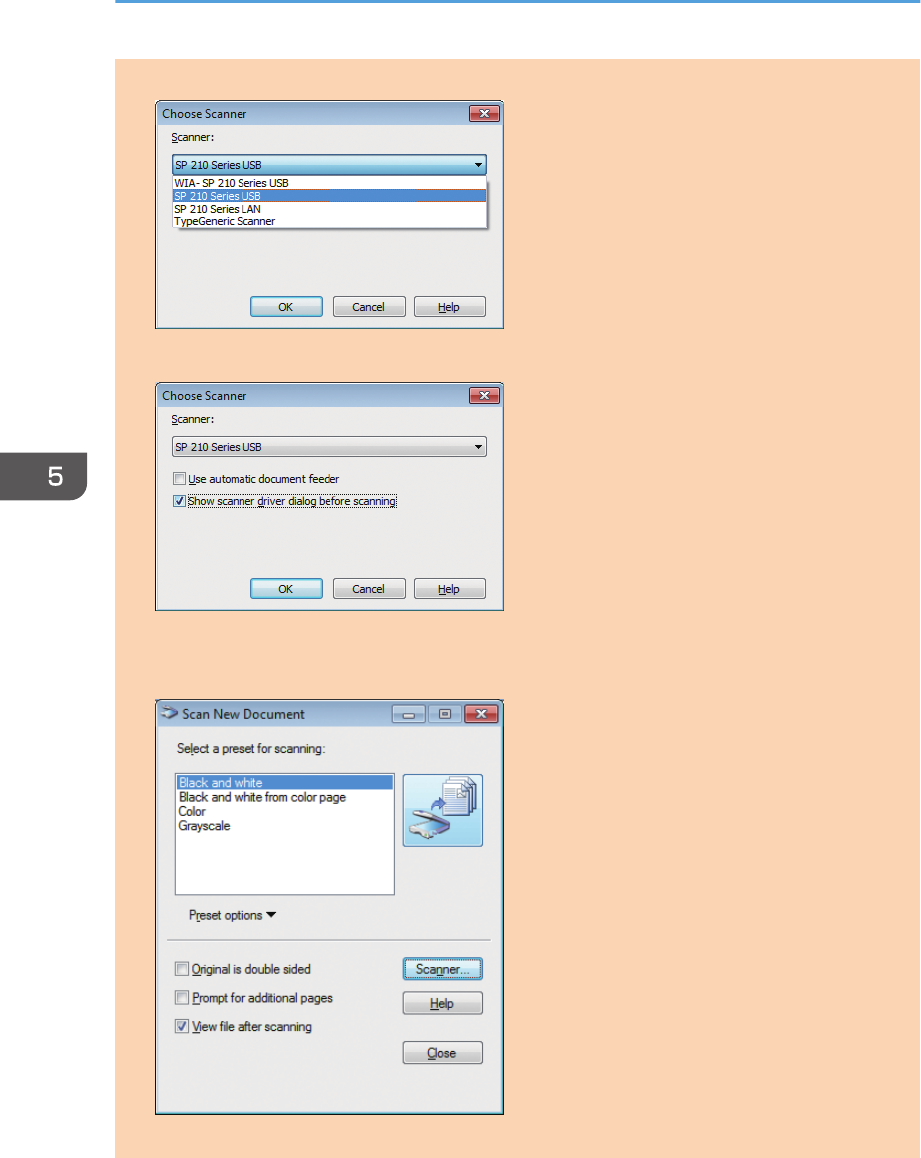
4. Select the scanner you want to use.
5. Select the [Show scanner driver dialog before scanning] check box.
6. Click [OK].
7. Click the [Scan] button.
The scanner driver dialog box appears.
5. Scanning Originals
96 opal-p2_mf2_com_user_guide_00142103_eng.xml
Draft 2014/01/07
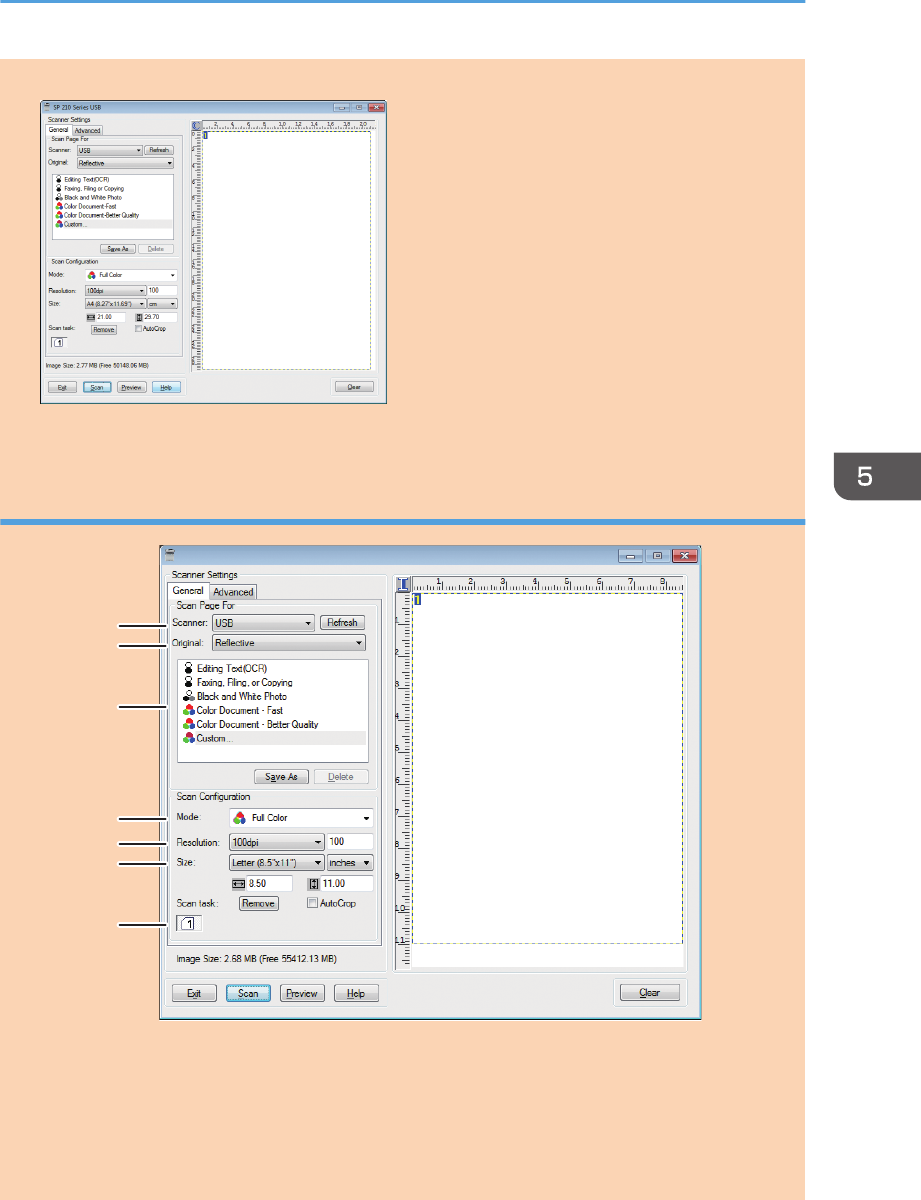
8. Click [Scan].
9. Click [Close].
Settings you can configure in the TWAIN dialog box
DAC525
1
2
3
4
5
6
7
1. Scanner:
Select the scanner you want to use. The scanner you select becomes the default scanner. Click [Refresh] to
discover all available scanners connected via USB or the network.
2. Original:
Select [Reflective] to scan from the exposure glass, or [Automatic Document Feeder] to scan from the ADF.
Scanning from a Computer
opal-p2_mf2_com_user_guide_00142103_eng.xml 97
Draft 2014/01/07
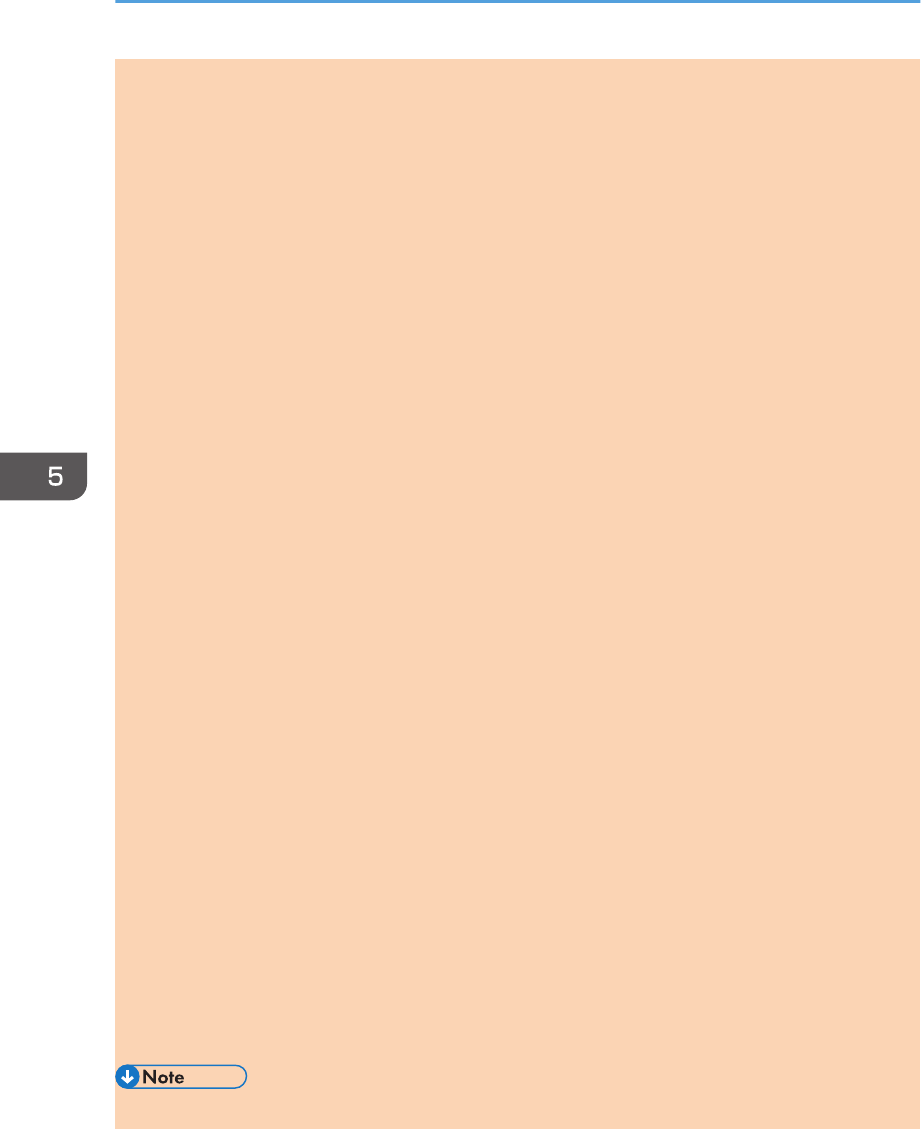
3. Original type
According to your original, select a setting from the list of options detailed below, or select [Custom...] to
configure your own scan settings. "Mode:", "Resolution:", and "Size:" under "Scan Configuration" will change
according to the Original type setting you selected here.
• When using the exposure glass:
[Editing Text(OCR)]
[Faxing, Filing, or Copying]
[Black and White Photo]
[Color Document - Fast]
[Color Document - Better Quality]
[Custom...]
• When using the ADF:
[ADF-Faster]
[ADF-Better]
[ADF - Gray]
[Custom...]
4. Mode:
Select from color, grayscale, or black-and-white.
5. Resolution:
Select a resolution from the list. If you select [User defined], enter a resolution value directly in the edit box.
Note that increasing the resolution also increases the file size and scanning time.
Selectable resolutions vary depending on where the original is set.
• When using the exposure glass:
75, 100, 150, 200, 300, 400, 500, 600, 1200, 2400, 4800, 9600, 19200 dpi, User defined
• When using the ADF:
75, 100, 150, 200, 300, 400, 500, 600 dpi, User defined
6. Size:
Select the scanning size. If you select [User defined], enter the scanning size directly in the edit box. Also, you
can change the scanning size with your mouse in the preview area. You can select the unit of measure from
[cm], [inches], or [pixels]. Selectable resolutions vary depending on where the original is set. For details, see
the TWAIN Help.
7. Scan task: (when using the exposure glass)
Displays up to 10 previously used scan areas. To remove a scan task, select the number of the task, and then
click [Remove]. You can select [AutoCrop] to let the scanner automatically detect the size of your original.
• For details, see the TWAIN driver Help.
5. Scanning Originals
98 opal-p2_mf2_com_user_guide_00142103_eng.xml
Draft 2014/01/07
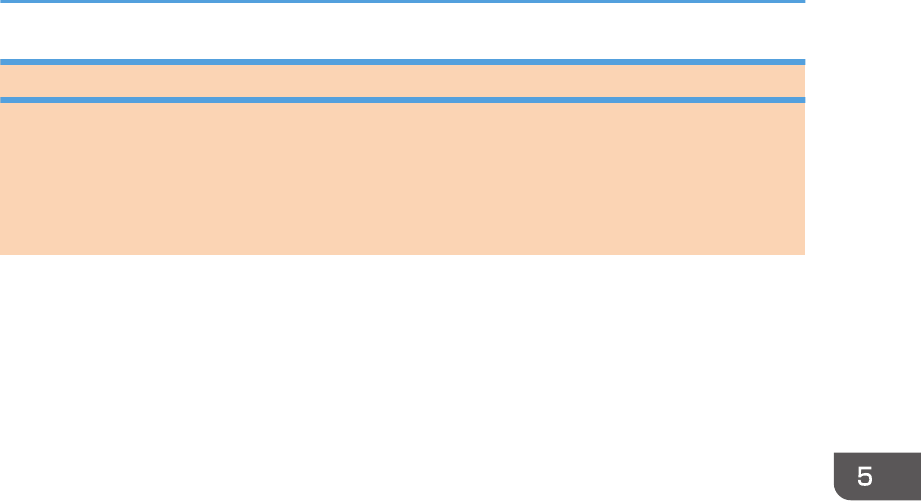
Basic Operation for WIA Scanning
1. Place the original.
2. On the [Start] menu, click [Devices and Printers].
3. Right-click the icon of the printer model you want to use, and then click [Start scan].
4. Configure the scan settings as required, and then click [Scan].
Scanning from a Computer
opal-p2_mf2_com_user_guide_00142103_eng.xml 99
Draft 2014/01/07

5. Scanning Originals
100 opal-p2_mf2_com_user_guide_00142103_eng.xml
Draft 2014/01/07
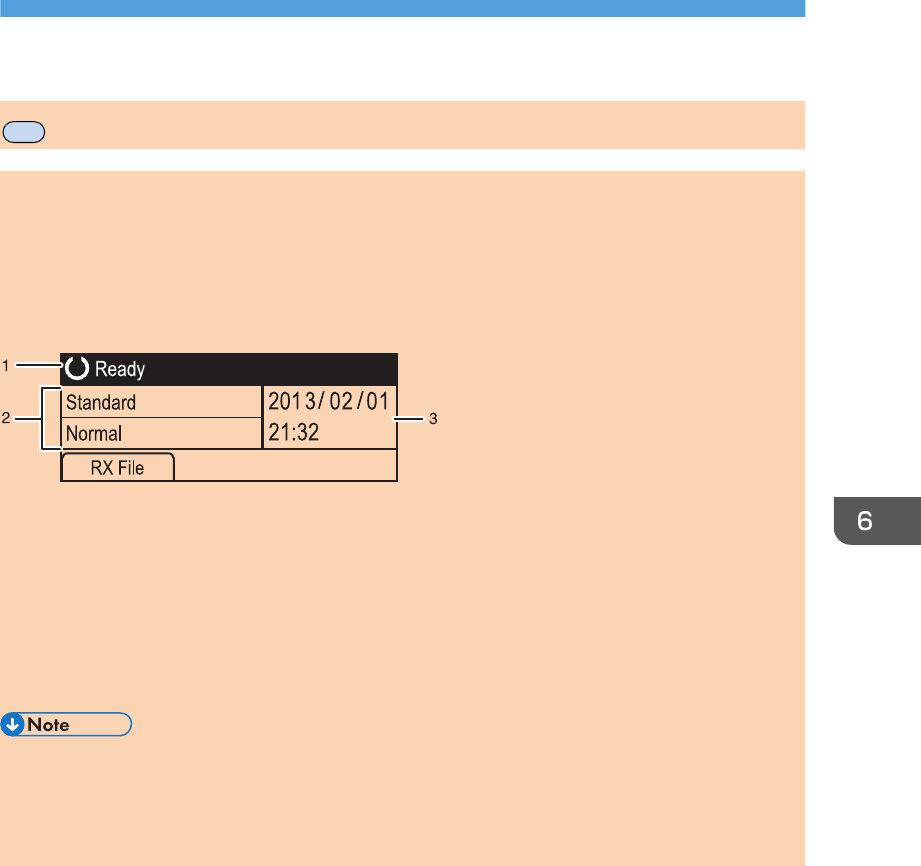
6. Sending and Receiving a Fax
MF
Fax Mode Screen
This section provides information about the screen in fax mode.
By default, the display shows the copier screen when the machine is turned on.
If the copy or scanner screen is shown on the display, press the [Facsimile] key on the control panel to
switch to the fax screen.
Standby mode screen
DCT859
1. Current status or messages
Displays the current status or messages.
2. Current settings
Displays the current density and resolution settings.
3. Current date and time
Shows the current date and time.
• The machine's default mode at power on can be specified in the [Function Priority] setting under
[Admin. Tools]. For [Function Priority], see page 159 "Administrator Settings".
• The display format for time and date can be specified in [Set Date/Time] under [Admin. Tools]. For
setting the date and time, see page 102 "Setting the Date and Time".
opal-p2_mf2_com_user_guide_00142105_eng.xml 101
Draft 2014/01/07
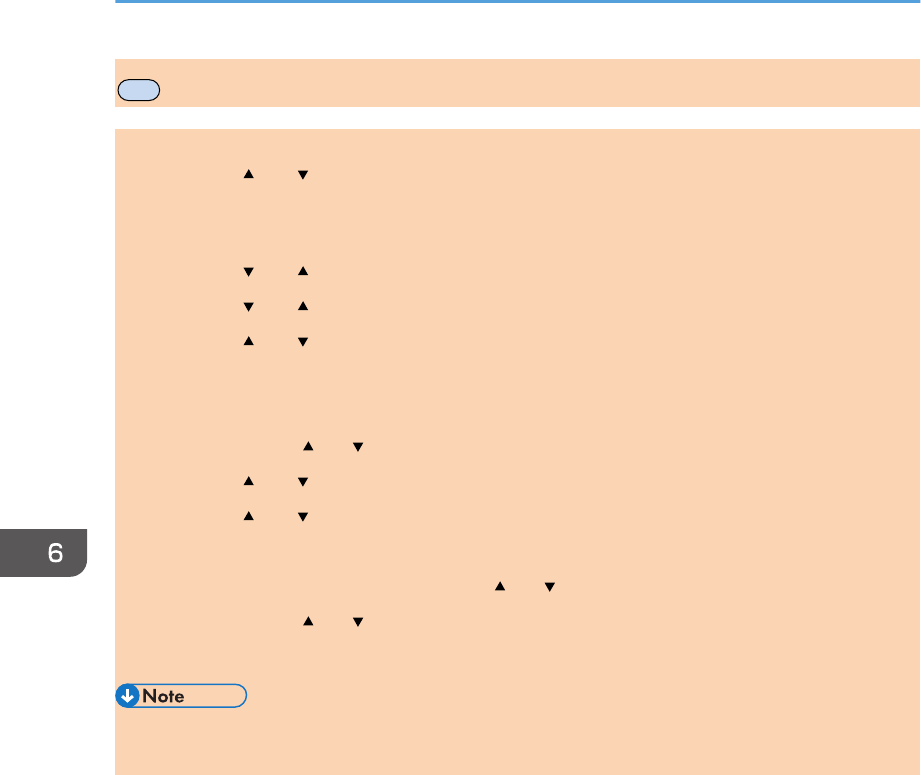
MF
Setting the Date and Time
1. Press the [User Tools] key.
2. Press the [ ] or [ ] key to select [Admin. Tools], and then press the [OK] key.
3. If you are requested to enter a password, enter the password using the number keys,
and then press the [OK] key.
4. Press the [ ] or [ ] key to select [Set Date/Time], and then press the [OK] key.
5. Press the [ ] or [ ] key to select [Set Date], and then press the [OK] key.
6. Press the [ ] or [ ] key to select the desired date format, and then press the [OK] key.
For the date and time display format, see page 159 "Administrator Settings".
7. Enter the current date using the number keys, and then press the [OK] key.
You can press the [ ] or [ ] key to move between fields.
8. Press the [ ] or [ ] key to select [Set Time], and then press the [OK] key.
9. Press the [ ] or [ ] key to select the desired time format, and then press the [OK] key.
10. Enter the current time using the number keys, and then press the [OK] key.
If you selected [12-hour Format], press the [ ] or [ ] key to select [AM] or [PM].
You can press the [ ] or [ ] key to move between fields.
11. Press the [User Tools] key to return to the initial screen.
• A password for accessing the [Admin. Tools] menu can be specified in [Admin. Tools Lock]. For
[Admin. Tools Lock], see page 159 "Administrator Settings".
6. Sending and Receiving a Fax
102 opal-p2_mf2_com_user_guide_00142106_eng.xml
Draft 2014/01/07
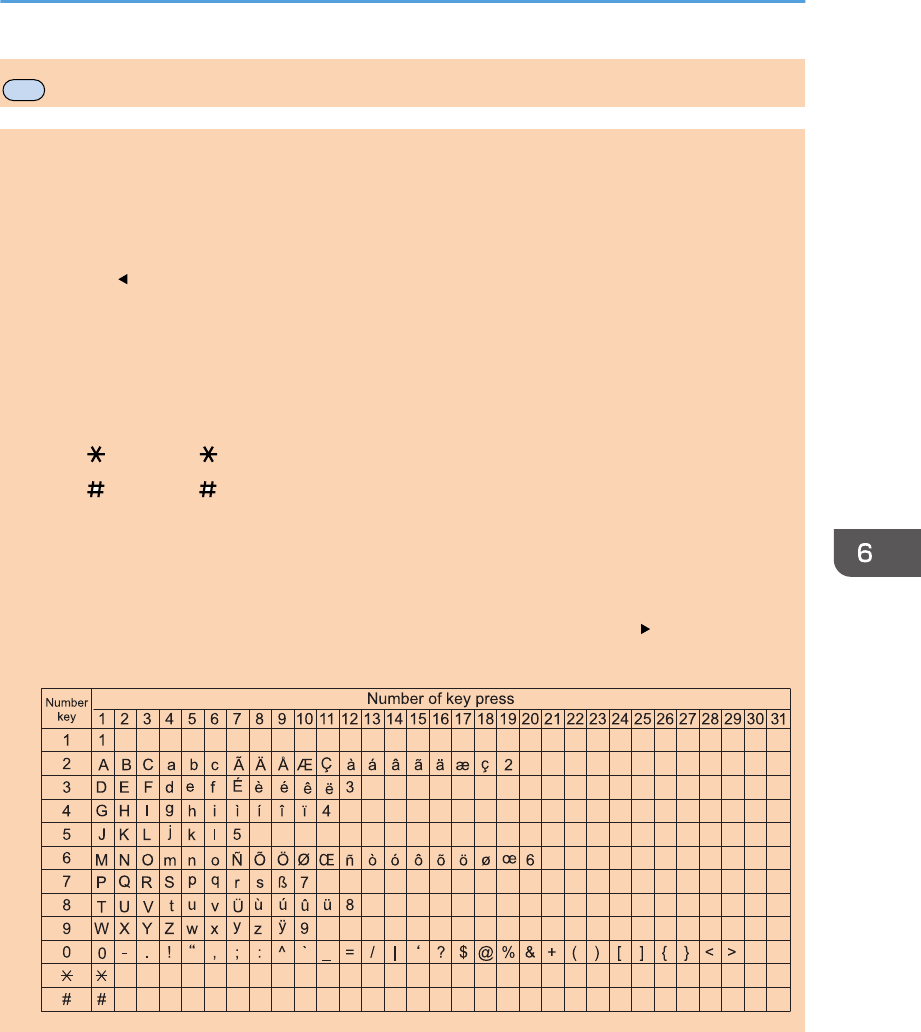
MF
Entering Characters
To enter characters, use keys as follows:
To enter a digit
Press a number key.
To delete a character
Press the [ ] key.
To enter a fax number
• To enter a number
Use the number keys.
• To enter characters other than digits
" ": Press the [ ] key.
" ": Press the [ ] key.
"P"(Pause): Press the [Pause/Redial] key.
To enter a name
Letters, numbers, and symbols can be entered using the number keys.
To enter two characters that use the same number key successively, press the [ ] key after entering
the first character.
DCT843
\~
Entering Characters
opal-p2_mf2_com_user_guide_00142107_eng.xml 103
Draft 2014/01/07
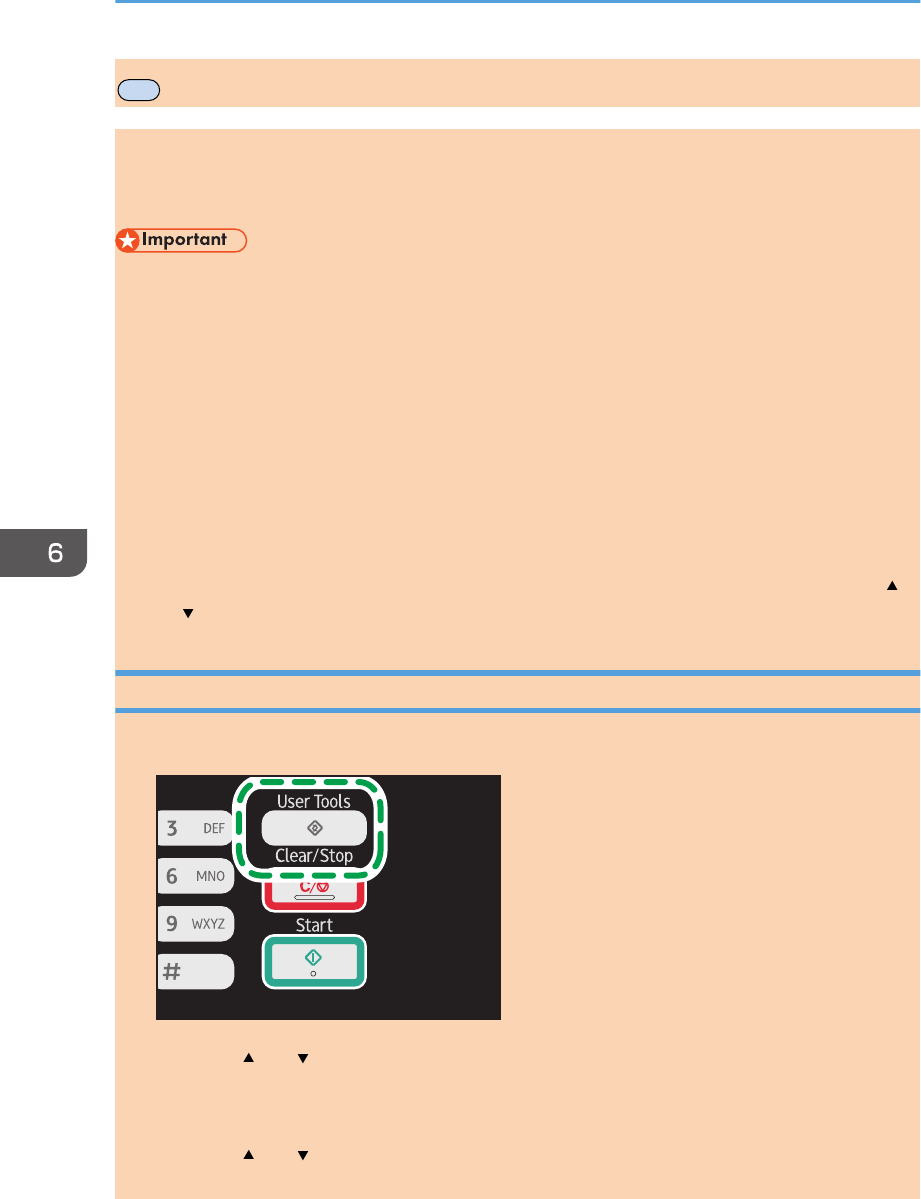
MF
Registering Fax Destinations
This section describes how to register fax destinations in the Address Book using the control panel. For
entering characters, see "Entering Characters".
The Address Book can also be edited using Web Image Monitor.
• The Address Book data could be damaged or lost unexpectedly. The manufacturer shall not be
responsible for any damages resulting from such data loss. Be sure to create backup files of the
Address Book data periodically. For details about creating backup files, see page 193
"Configuring the Administrator Settings".
The Address Book can contain up to 108 entries (8 Quick Dial entries and 100 Speed Dial entries).
Quick Dial entries
Destinations registered as Quick Dial entries can be selected by pressing the corresponding One
Touch button.
Speed Dial entries
Destinations registered as Speed Dial entries can be selected from the Address Book. Press the
[Address Book] key, select [Search Address Book], and then select the desired entry using the [ ]
or [ ] key.
Registering Fax Destinations Using the Control Panel
1. Press the [User Tools] key.
DCT845
2. Press the [ ] or [ ] key to select [Address Book], and then press the [OK] key.
3. If you are requested to enter a password, enter the password using the number keys,
and then press the [OK] key.
4. Press the [ ] or [ ] key to select [Quick Dial Dest.] or [Fax Speed Dial Dest.], and then
press the [OK] key.
6. Sending and Receiving a Fax
104 opal-p2_mf2_com_user_guide_00142108_eng.xml
Draft 2014/01/07
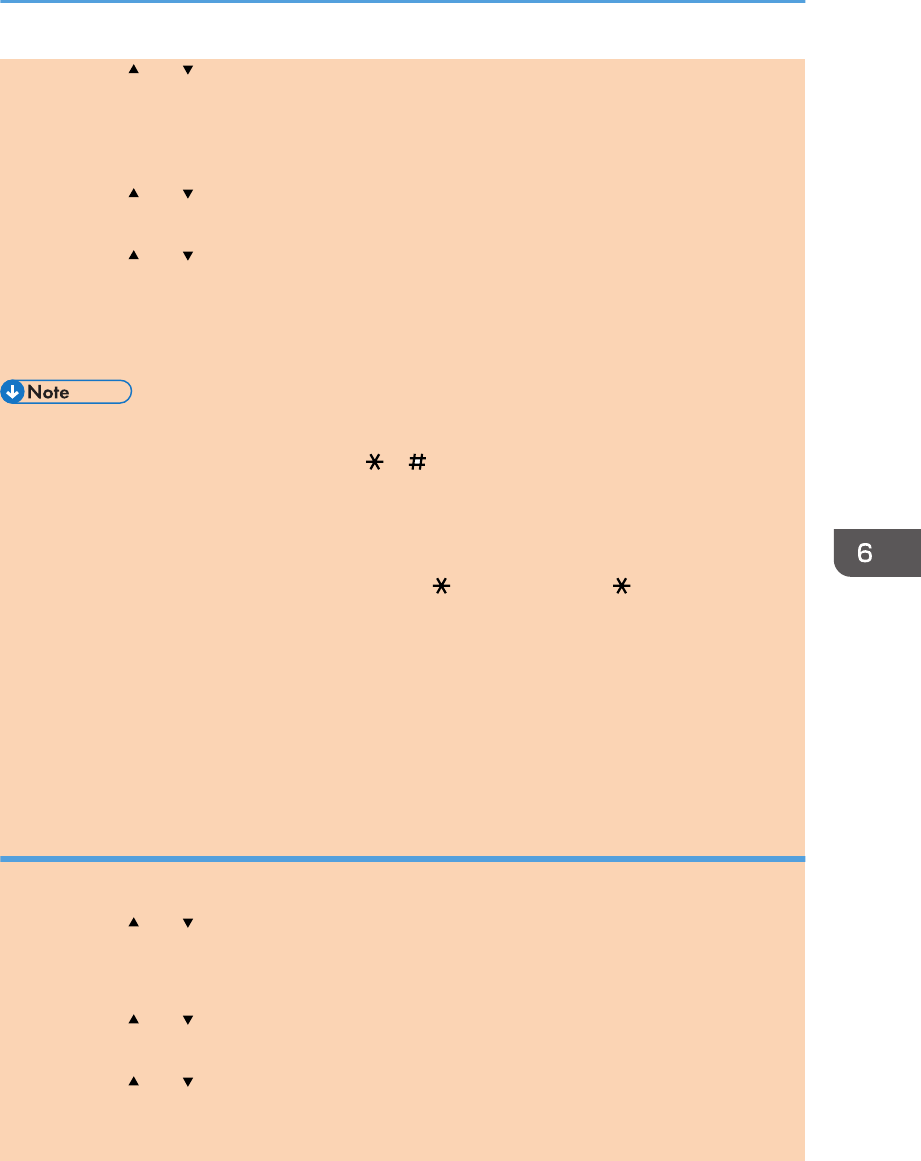
5. Press the [ ] or [ ] key to select [No.], and then enter the desired Quick Dial number (1 to
8) or Speed Dial number (1 to 100) using the number keys.
If a destination is already registered for the input number, the fax number and fax name registered
for that number appear.
6. Press the [ ] or [ ] key to select [Fax No.], and then enter the fax number (up to 40
characters).
7. Press the [ ] or [ ] key to select [Name], and then enter the fax name (up to 20
characters).
8. Confirm the setting, and then press the [OK] key.
9. Press the [User Tools] key to return to the initial screen.
• For entering characters, see page 103 "Entering Characters".
• A fax number can contain 0 to 9, pause, " ", " ", and space.
• If necessary, insert a pause in the fax number. The machine pauses briefly before it dials the digits
following the pause. You can specify the length of the pause time in the [Pause Time] setting under
fax transmission settings. For [Pause Time], see page 137 "Fax Transmission Features Settings".
• To use tone services on a pulse-dialing line, insert " " in the fax number. " " switches the dialing
mode from pulse to tone temporarily.
• If the machine is connected to the telephone network through a PBX, make sure to enter the outside
line access number specified in [PBX Access Number] before the fax number. For [PBX Access
Number], see page 159 "Administrator Settings".
• A password for accessing the [Address Book] menu can be specified in [Admin. Tools Lock]. For
[Admin. Tools Lock], see page 159 "Administrator Settings".
Modifying or deleting fax destinations
1. Press the [User Tools] key.
2. Press the [ ] or [ ] key to select [Address Book], and then press the [OK] key.
3. If you are requested to enter a password, enter the password using the number keys,
and then press the [OK] key.
4. Press the [ ] or [ ] key to select [Quick Dial Dest.] or [Fax Speed Dial Dest.], and then
press the [OK] key.
5. Press the [ ] or [ ] key to select [No.], and then enter the desired Quick Dial number (1 to
8) or Speed Dial number (1 to 100) using the number keys.
The fax number and fax name registered for that number appear.
Registering Fax Destinations
opal-p2_mf2_com_user_guide_00142108_eng.xml 105
Draft 2014/01/07
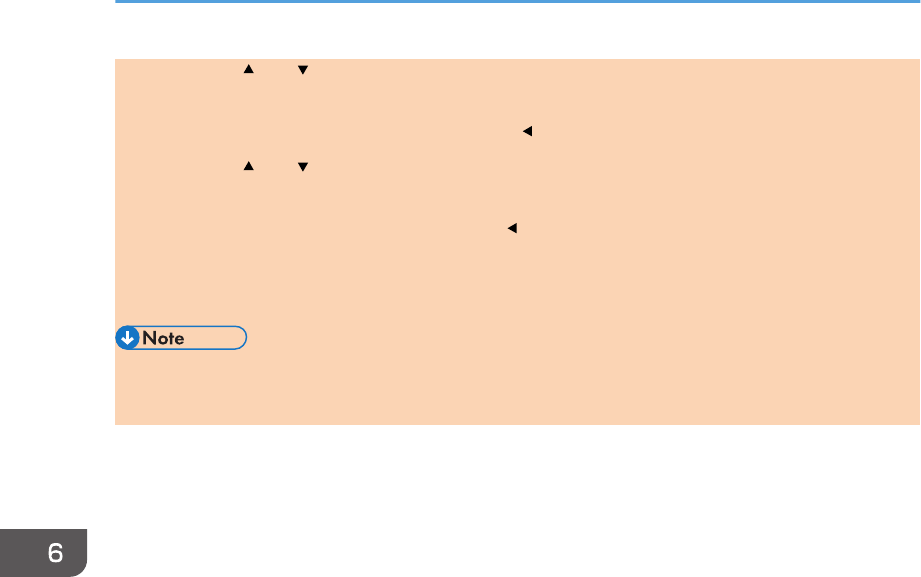
6. Press the [ ] or [ ] key to select [Fax No.], and then modify the fax number (up to 40
characters).
If you want to delete the fax number, press the [ ] key until the current number is deleted.
7. Press the [ ] or [ ] key to select [Name], and then modify the fax name (up to 20
characters).
If you want to delete the fax name, press the [ ] key until the current name is deleted.
8. Confirm the setting, and then press the [OK] key.
9. Press the [User Tools] key to return to the initial screen.
• For details about entering characters, see page 103 "Entering Characters".
• A password for accessing the [Address Book] menu can be specified in [Admin. Tools Lock].
6. Sending and Receiving a Fax
106 opal-p2_mf2_com_user_guide_00142108_eng.xml
Draft 2014/01/07
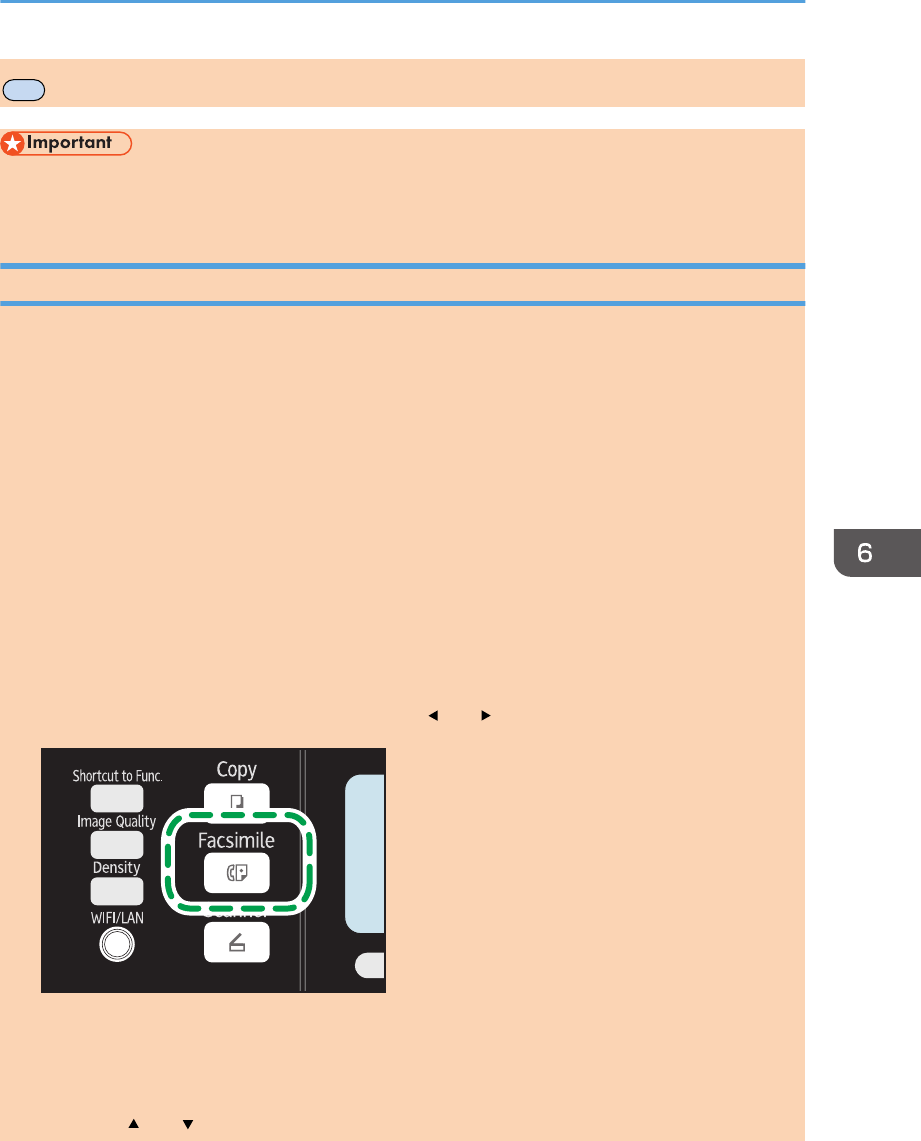
MF
Sending a Fax
• It is recommended that you call the receiver and confirm with them when sending important
documents.
Selecting Transmission Mode
There are two transmission modes: Memory Transmission and Immediate Transmission.
Memory Transmission
In this mode, the machine scans several originals into memory and sends them all at once. This is
convenient when you are in a hurry and want to take the document away from the machine. In this
mode, you can send a fax to multiple destinations.
The number of redial attempts is preset to two or three times, depending on the [Country] setting
under [Admin. Tools], in five-minute intervals. For details, see page 137 "Fax Transmission
Features Settings".
Immediate Transmission
In this mode, the machine scans the original and faxes it simultaneously, without storing it in
memory. This is convenient when you want to send an original quickly. In this mode, you can only
specify one destination.
1. Press the [Facsimile] key, and then press the [ ] or [ ] key.
DCT849
Alternatively, you can press the [Shortcut to Func.] key if [Shortcut to Function] under administrator
settings is set to [Fax Immediate TX]. For [Shortcut to Function], see page 159 "Administrator
Settings".
2. Press the [ ] or [ ] key to select [Immediate TX], and then press the [OK] key.
Sending a Fax
opal-p2_mf2_com_user_guide_00142109_eng.xml 107
Draft 2014/01/07
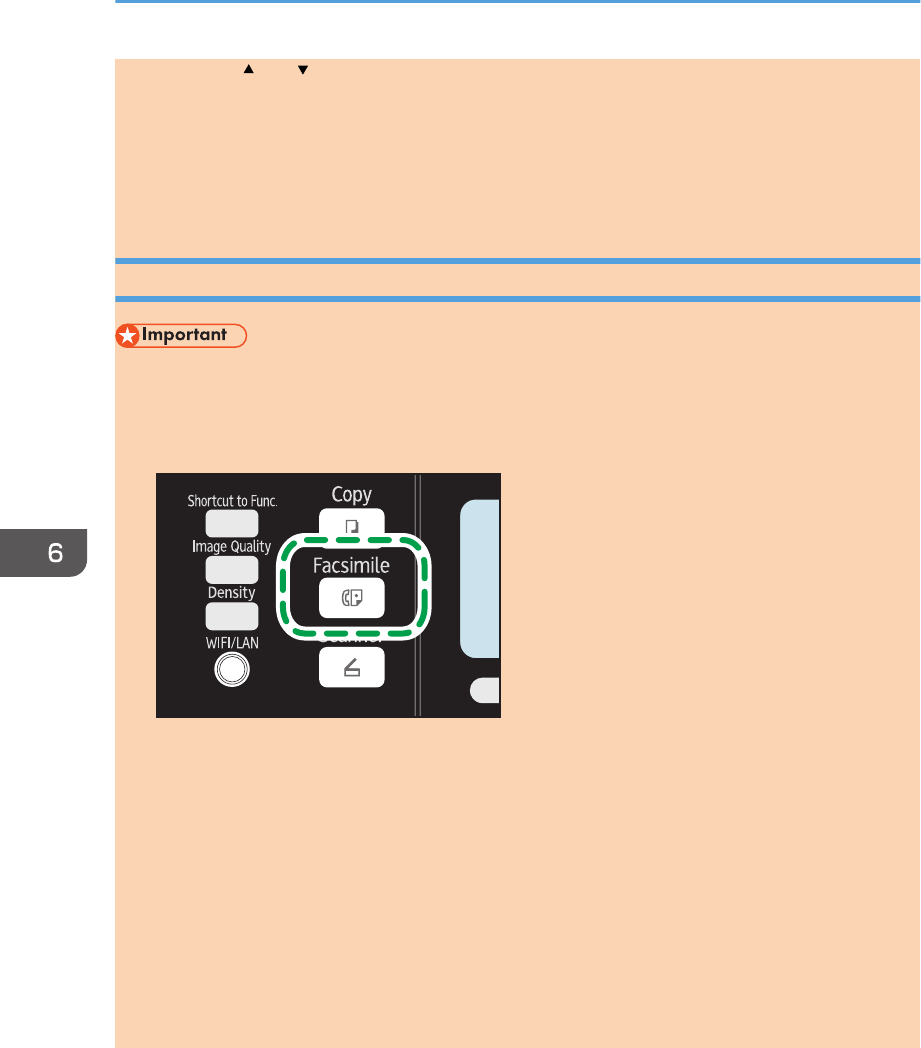
3. Press the [ ] or [ ] key to select [Off], [On], or [Next Fax Only], and then press the [OK]
key.
For Memory Transmission, select [Off].
For Immediate Transmission, select [On] or [Next Fax Only].
4. Press the [User Tools] key to return to the initial screen.
Basic Operation for Sending a Fax
• The original in the ADF takes precedence over the original on the exposure glass if you place
originals both in the ADF and on the exposure glass.
1. Press the [Facsimile] key.
DCT849
2. Place the original on the exposure glass or in the ADF.
To place the originals, see page 54 "Placing Originals".
3. Enter the fax number (up to 40 characters) using the number keys, or specify a
destination using the One Touch buttons or Speed Dial function.
For details about entering characters, see page 103 "Entering Characters". For details about
specifying destinations using the One Touch buttons or Speed Dial function, see page 111
"Specifying the Fax Destination".
• If the machine is connected to the telephone network through a PBX, make sure to enter the
outside line access number specified in [PBX Access Number] before the fax number. For [PBX
Access Number], see page 159 "Administrator Settings".
6. Sending and Receiving a Fax
108 opal-p2_mf2_com_user_guide_00142109_eng.xml
Draft 2014/01/07
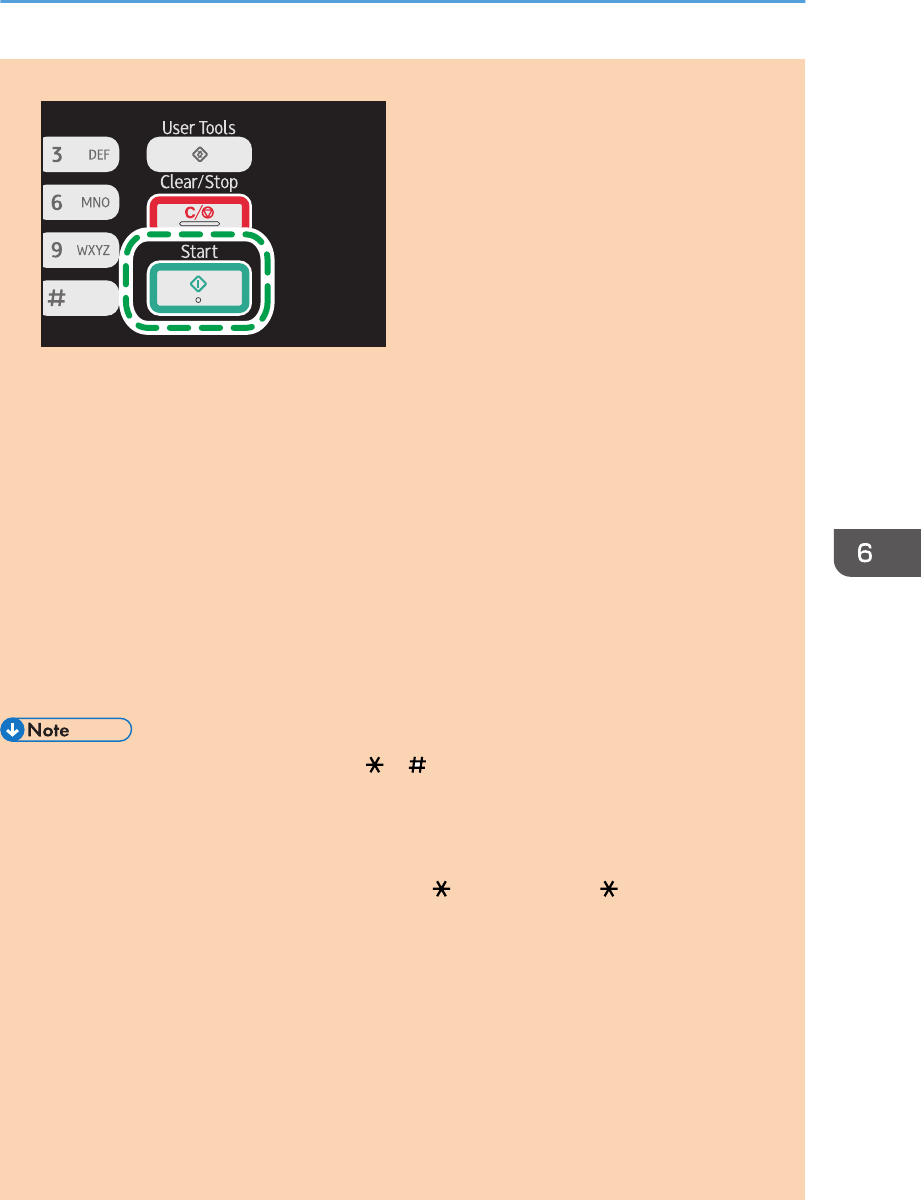
4. Press the [Start] key.
DCT847
• Depending on the machine's settings, you may be prompted to enter the fax number again if
you manually entered the destination fax number. In this case, re-enter the number within 60
seconds, press [OK], and then press the [Start] key. If the fax numbers do not match, go back
to Step 3. For fax number confirmation, see page 159 "Administrator Settings".
• When using the exposure glass in Memory Transmission mode, you will be prompted to place
another original. In this case, proceed to the next step.
5. If you have more originals to scan, press [Yes] within 60 seconds, place the next original
on the exposure glass, and then press [OK]. Repeat this step until all originals are
scanned.
If you do not press [Yes] within 60 seconds, the machine will start to dial the destination.
6. When all originals have been scanned, press # to start sending the fax.
• A fax number can contain 0 to 9, pause, " ", " ", and space.
• If necessary, insert a pause in a fax number. The machine pauses briefly before it dials the digits
following the pause. You can specify the length of the pause time in the [Pause Time] setting under
fax transmission settings. For [Pause Time], see page 137 "Fax Transmission Features Settings".
• To use tone services on a pulse-dialing line, insert " " in a fax number. " " switches the dialing
mode from pulse to tone temporarily.
• You can specify multiple destinations and broadcast the fax you are sending. For sending a fax
using the broadcast function, see page 111 "Specifying the Fax Destination".
• The machine prompts you to enter the fax number twice only when you dial the destination
manually. Destinations specified using the One Touch buttons, Speed Dial function, or [Pause/
Redial] key need not be confirmed.
• When in Memory Transmission mode, you can enable the [Auto Redial] setting under fax
transmission settings to set the machine to automatically redial the destination if the line is busy or
an error occurs during transmission. For [Auto Redial], see page 137 "Fax Transmission Features
Settings".
Sending a Fax
opal-p2_mf2_com_user_guide_00142109_eng.xml 109
Draft 2014/01/07
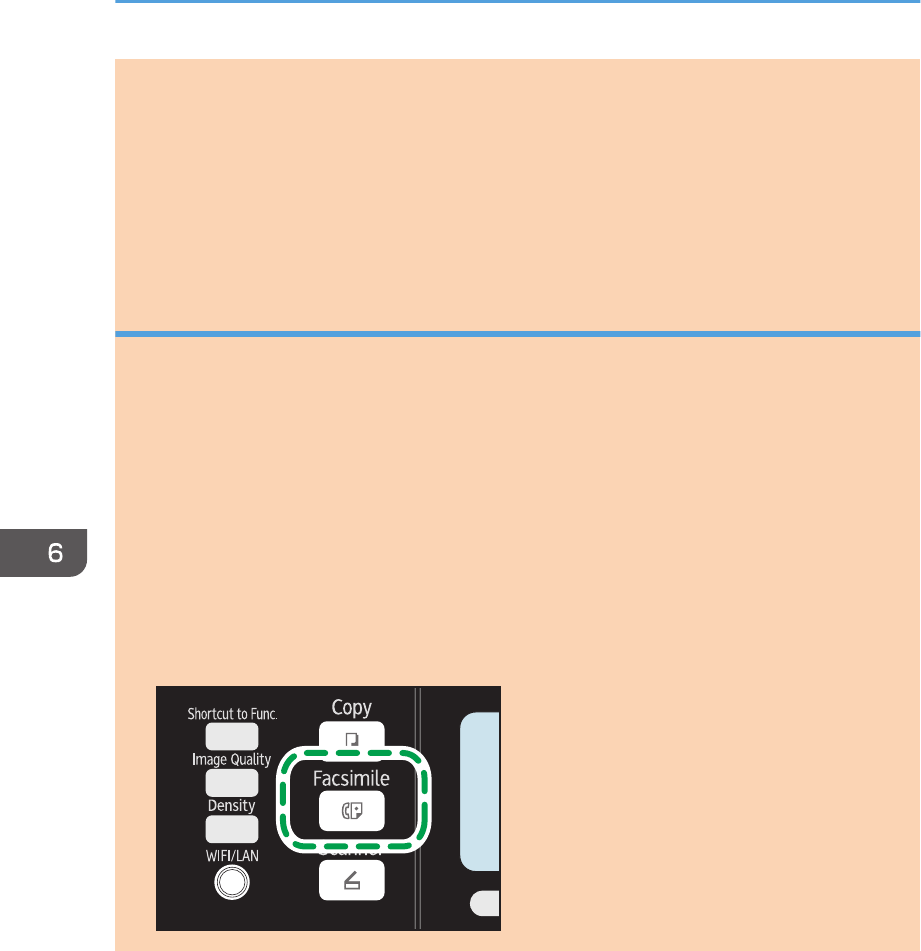
• When in Memory Transmission mode, the machine's memory may become full while scanning the
originals. In this case, the screen prompts you to cancel the transmission or to send only the pages
that have been scanned successfully.
• If paper is jammed in the ADF, the jammed page has not been scanned properly. When the
machine is in Immediate Transmission mode, resend the fax starting from the jammed page. When
in Memory Transmission mode, scan the entire originals again. For details about removing paper
jammed in the ADF, see page 210 "Paper Feed Problems".
Canceling a fax
Follow the procedure below to cancel sending a fax.
When in Immediate Transmission mode
If you cancel sending a fax while the machine is scanning the original, the fax transmission process
is canceled immediately. In this case, an error is displayed on the other party's machine.
When in Memory Transmission mode
If you cancel sending a fax while the machine is scanning the original, the machine will not send
the document.
If you cancel sending a fax during transmission, the fax transmission process is canceled
immediately. In this case, an error is displayed on the other party's machine.
1. Press the [Facsimile] key.
DCT849
6. Sending and Receiving a Fax
110 opal-p2_mf2_com_user_guide_00142109_eng.xml
Draft 2014/01/07
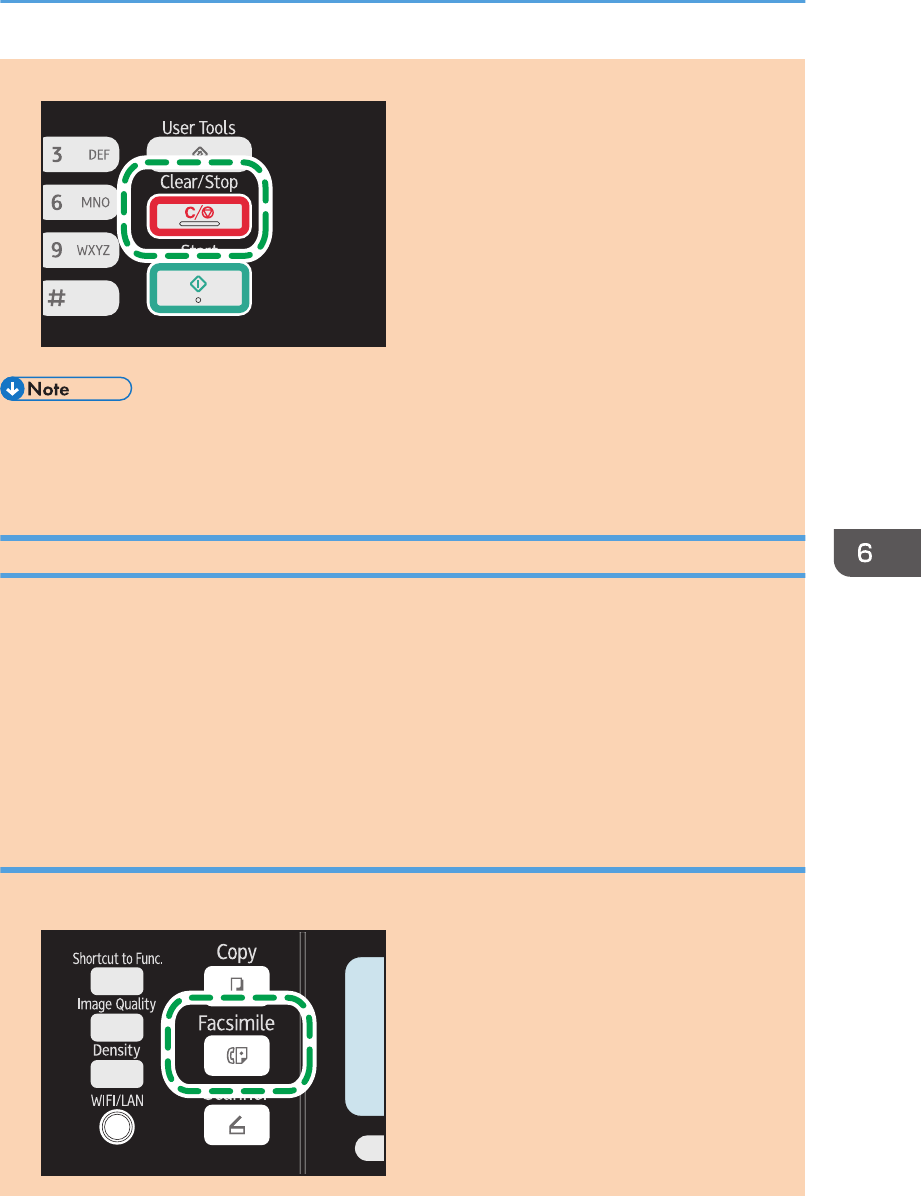
2. Press the [Clear/Stop] key.
DCT846
• If you cancel sending a fax while broadcasting, only the fax to the current destination is canceled.
The fax will be sent to the subsequent destinations as normal. For details about sending a fax using
the broadcast function, see page 111 "Specifying the Fax Destination".
Specifying the Fax Destination
Other than entering the destination fax number using the number keys, you can specify destinations
using the following functions:
• One Touch buttons
• Speed Dial
• Broadcast function
• Redial function
Specifying the destination using the One Touch buttons
1. Press the [Facsimile] key.
DCT849
Sending a Fax
opal-p2_mf2_com_user_guide_00142109_eng.xml 111
Draft 2014/01/07
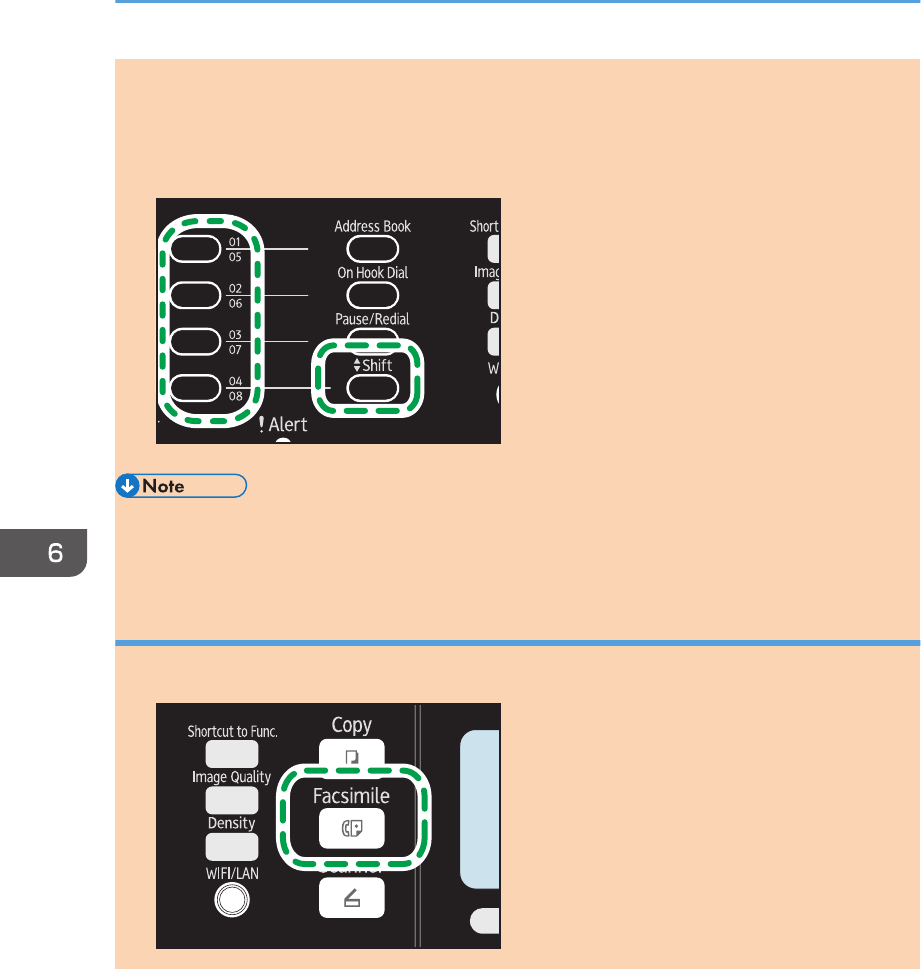
2. Press the One Touch button to which the desired Quick Dial entry is registered.
For registering the Quick Dial entries, see page 104 "Registering Fax Destinations".
Press the [Shift] key if you want to use Quick Dial entries Nos. 5 to 8 before pressing a One Touch
button.
DCT878
• You can check the registered names and fax numbers by printing a report. For printing the Quick
Dial list, see page 150 "Printing Lists/Reports".
Specifying the destination using Speed Dial
1. Press the [Facsimile] key.
DCT849
6. Sending and Receiving a Fax
112 opal-p2_mf2_com_user_guide_00142109_eng.xml
Draft 2014/01/07
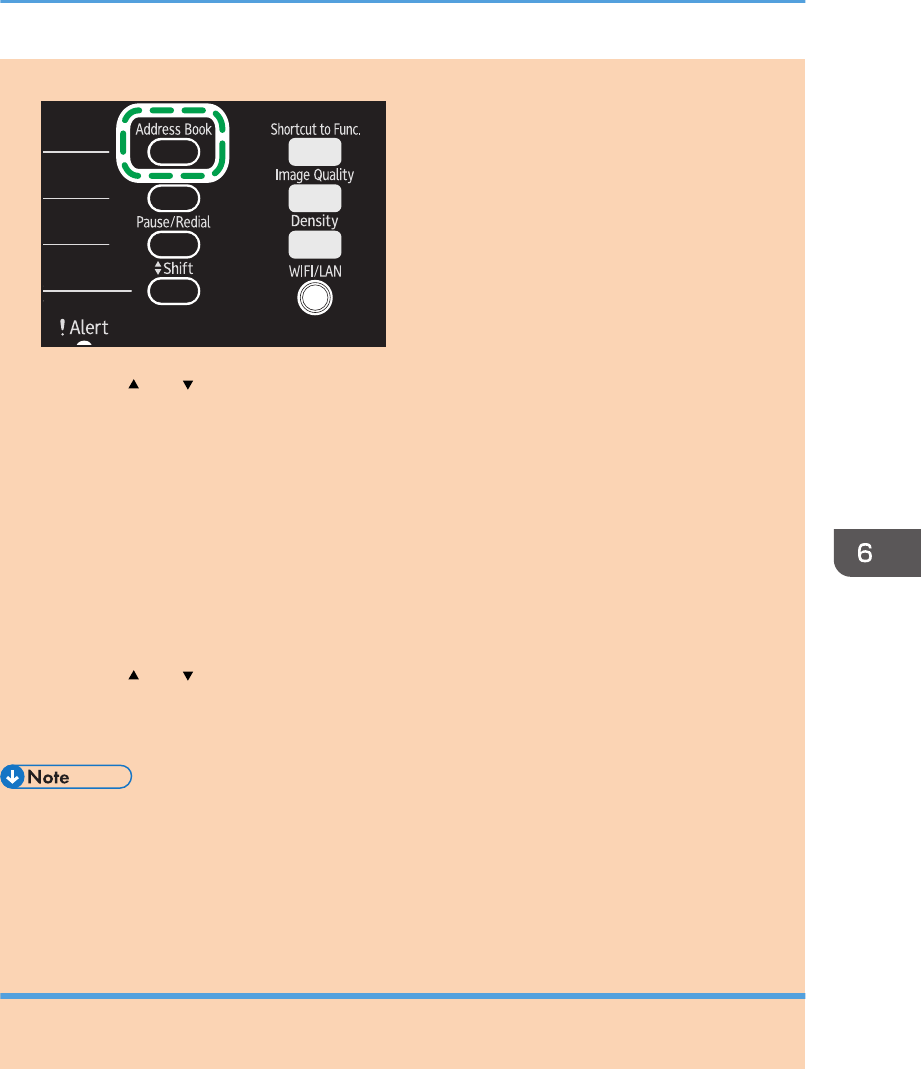
2. Press the [Address Book] key.
DCT876
3. Press the [ ] or [ ] key to select [Search Address Book], and then press the [OK] key.
If you want to search for a specific entry by its registration number or name, use the following
procedure:
• Searching by the registration number
Press the [Address Book] key again, enter the number using the number keys, and then press
the [OK] key.
• Searching by the name
Enter the first letters of the name using the number keys, and then press the [OK] key. Each
time you enter a character, the display changes to show the matching name.
4. Press the [ ] or [ ] key to select the desired Speed Dial entry, and then press the [OK]
key.
For registering the Speed Dial entries, see page 104 "Registering Fax Destinations".
• The Address Book shows only the Speed Dial entries. Use the One Touch buttons to specify Quick
Dial destinations.
• You can check the registered names and fax numbers by printing a report. For printing the Speed
Dial list, see page 150 "Printing Lists/Reports".
Specifying the destination using the broadcast function
You can send a fax to multiple destinations (up to 100 destinations) simultaneously.
Faxes are sent to destinations in the order they were specified.
Sending a Fax
opal-p2_mf2_com_user_guide_00142109_eng.xml 113
Draft 2014/01/07
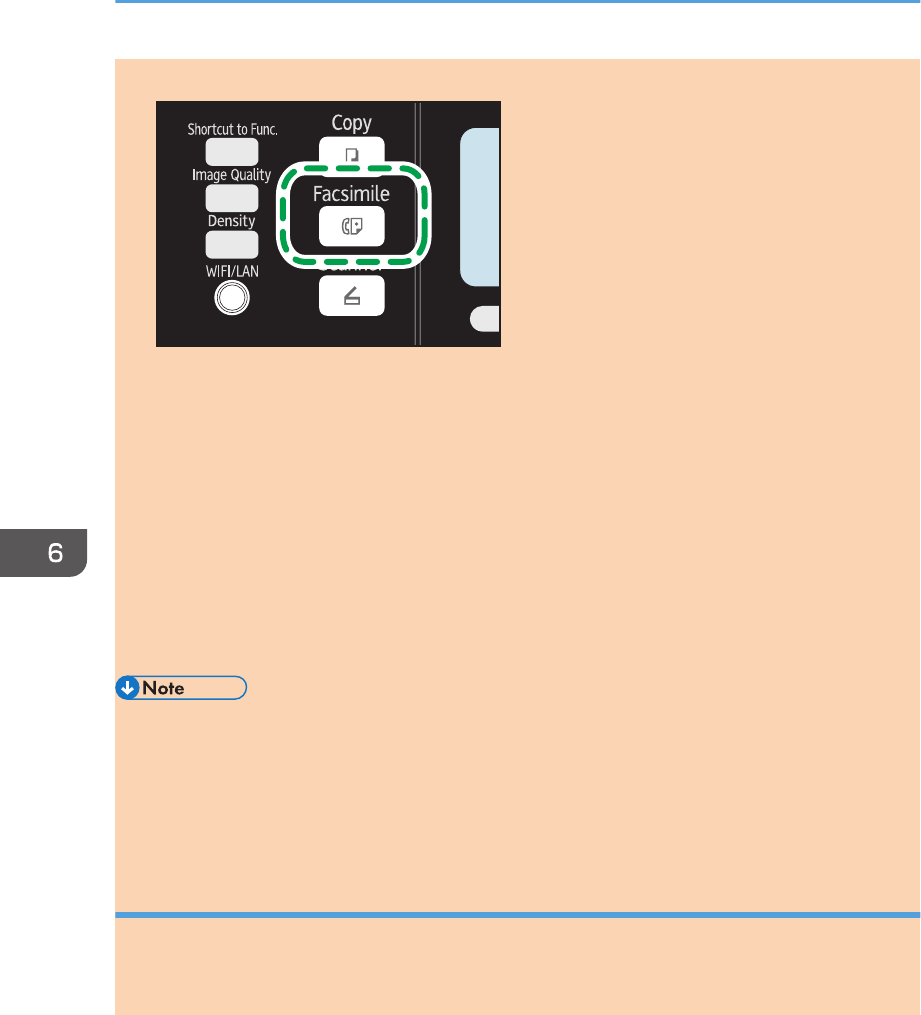
1. Press the [Facsimile] key.
DCT849
2. Add a destination by using one of the following methods:
• To add a Quick Dial destination: press a corresponding One Touch button.
• To add a Speed Dial destination: press the [Address Book] key, select [Search Address
Book], select a destination, and then press the [OK] key.
• To add a manually-specified destination: confirm that [No.key] is pressed, and then enter the
destination fax number using the number keys.
3. Press the [OK] key.
Press [List] to see the list of destinations that have been added so far.
Go back to Step 2 to add further destinations.
• While specifying multiple destinations, you can press the [Clear/Stop] key to clear all destinations.
• If you specify multiple destinations in Immediate Transmission mode, the mode switches to Memory
Transmission mode temporarily.
• While broadcasting, pressing the [Clear/Stop] key cancels the fax to the current destination only.
Specifying the destination using the redial function
You can specify the last used destination as the destination for the current job.
This function saves time when you are sending to the same destination repeatedly, as you do not have to
enter the destination each time.
6. Sending and Receiving a Fax
114 opal-p2_mf2_com_user_guide_00142109_eng.xml
Draft 2014/01/07
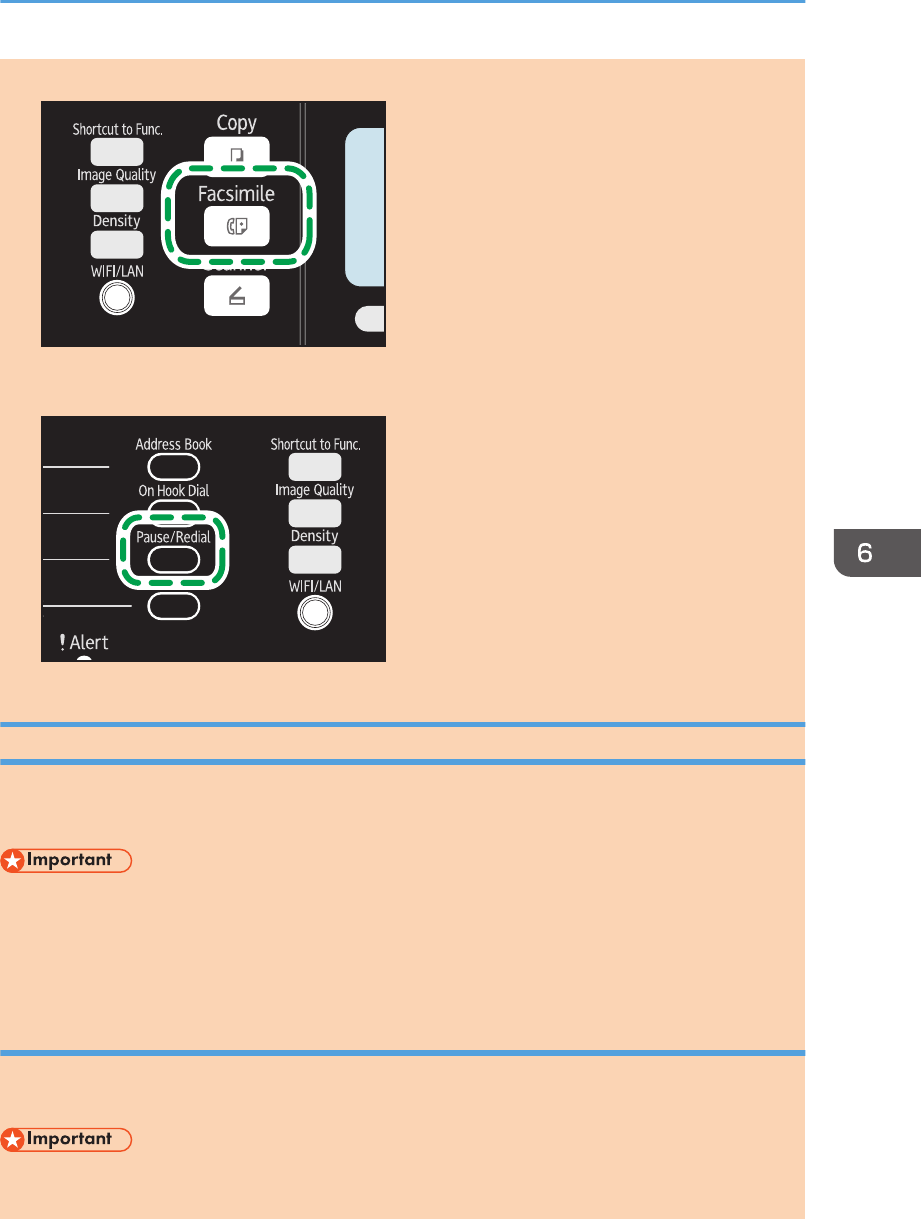
1. Press the [Facsimile] key.
DCT849
2. Press the [Pause/Redial] key.
DCT877
Useful Sending Functions
You can check the status of the other party's machine easily before sending a fax by using the On Hook
Dial function. Using an extra telephone, you can talk and send a fax in one call.
• This function is available in Immediate Transmission mode only.
The procedure differs depending on whether [Operation] is set to [Easy Mode] or [Advanced Mode] in
[Fax Features].
Sending a fax using On Hook Dial
The On Hook Dial function allows you to check the destination's status while listening to the tone from the
internal speaker. This function is useful when you want to ensure that the fax will be received.
• The On Hook Dial function cannot be used when [Fax Number Confirmation] under administrator
settings is enabled.
Sending a Fax
opal-p2_mf2_com_user_guide_00142109_eng.xml 115
Draft 2014/01/07
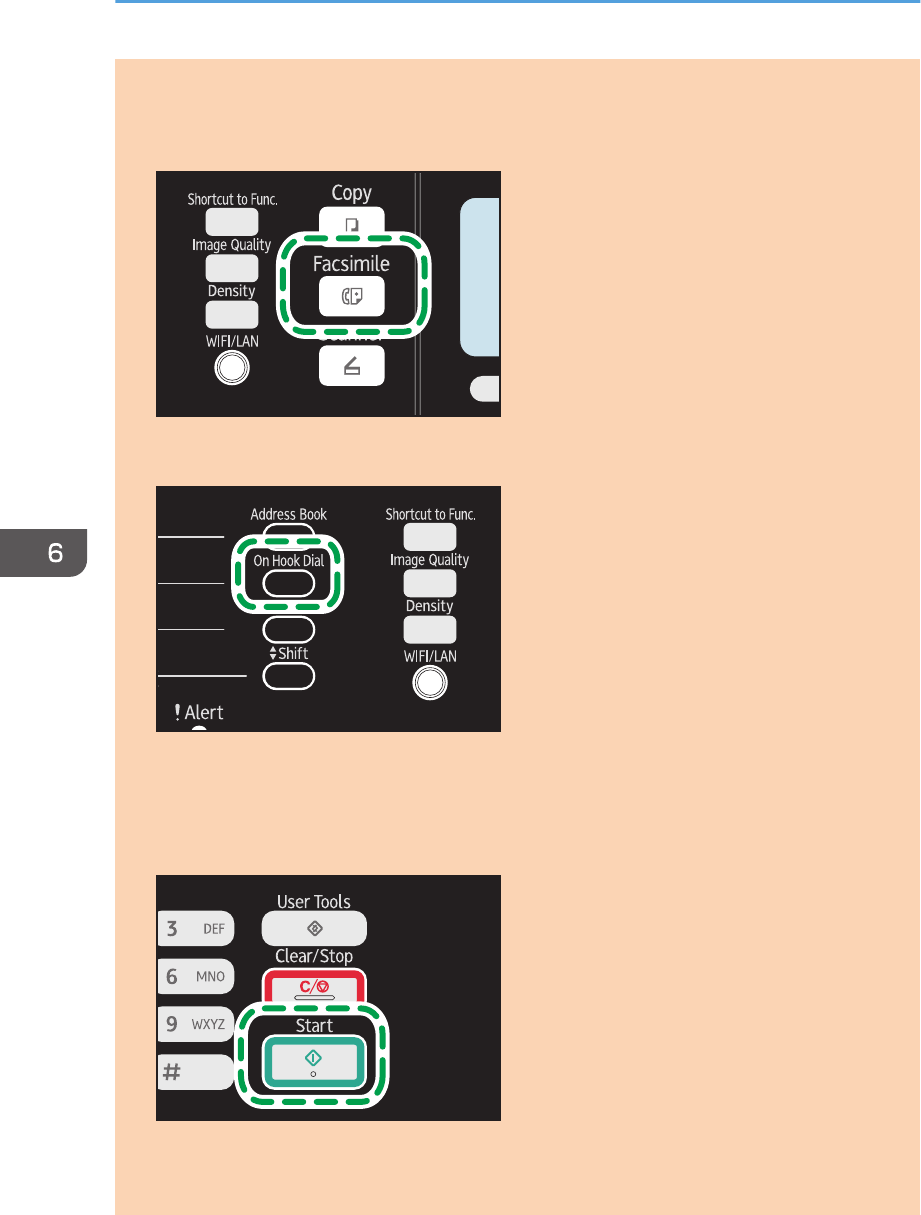
1. Place the original on the exposure glass or in the ADF.
If [Operation] is set to [Easy Mode], you cannot send faxes using the exposure glass.
2. Press the [Facsimile] key.
DCT849
3. Press the [On Hook Dial] key.
DCT852
"On Hook" appears on the screen.
4. Specify the destination using the number keys.
5. If you hear a high pitched tone, press the [Start] key.
DCT847
If [Operation] is set to [Easy Mode], Step 6 does not apply.
If the original is placed on the exposure glass, press [TX], and then press the [Start] key.
6. Sending and Receiving a Fax
116 opal-p2_mf2_com_user_guide_00142109_eng.xml
Draft 2014/01/07
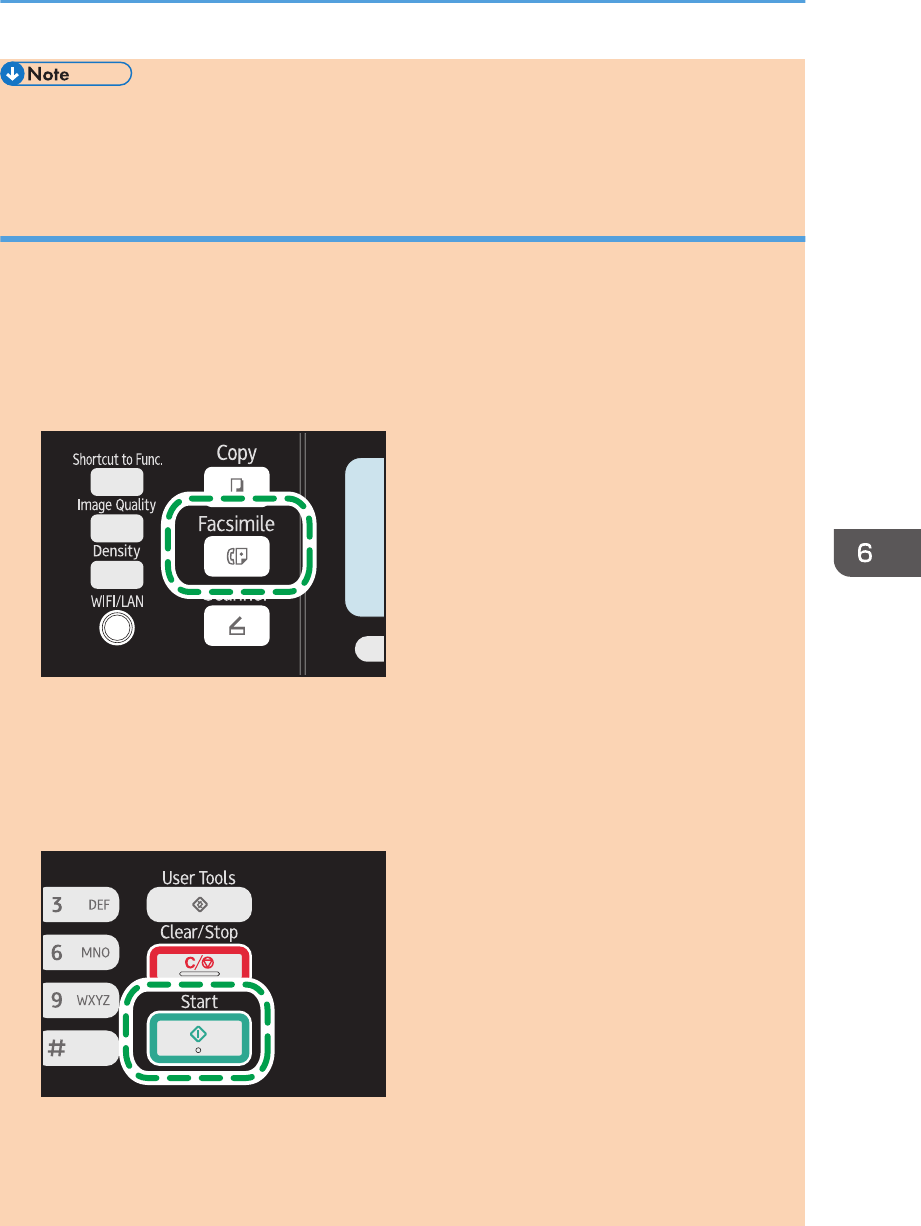
• For details about selecting the transmission mode, see page 107 "Selecting Transmission Mode".
• For details about [Fax Number Confirmation], see page 159 "Administrator Settings".
Sending a fax after a conversation
An external telephone allows you to send a fax after finishing your conversation without having to
disconnect and redial. This function is useful when you want to ensure that the fax has been received.
1. Place the original on the exposure glass or in the ADF.
If [Operation] is set to [Easy Mode], you cannot send faxes using the exposure glass.
2. Press the [Facsimile] key.
DCT849
3. Pick up the handset of the external telephone.
4. Specify the destination using the external telephone.
5. When the other party answers, ask them to press their fax start button.
6. If you hear a high pitched tone, press the [Start] key.
DCT847
If [Operation] is set to [Easy Mode], proceed to Step 7.
7. If the original is placed on the exposure glass, press [TX], and then press the [Start] key.
8. Replace the handset.
Sending a Fax
opal-p2_mf2_com_user_guide_00142109_eng.xml 117
Draft 2014/01/07
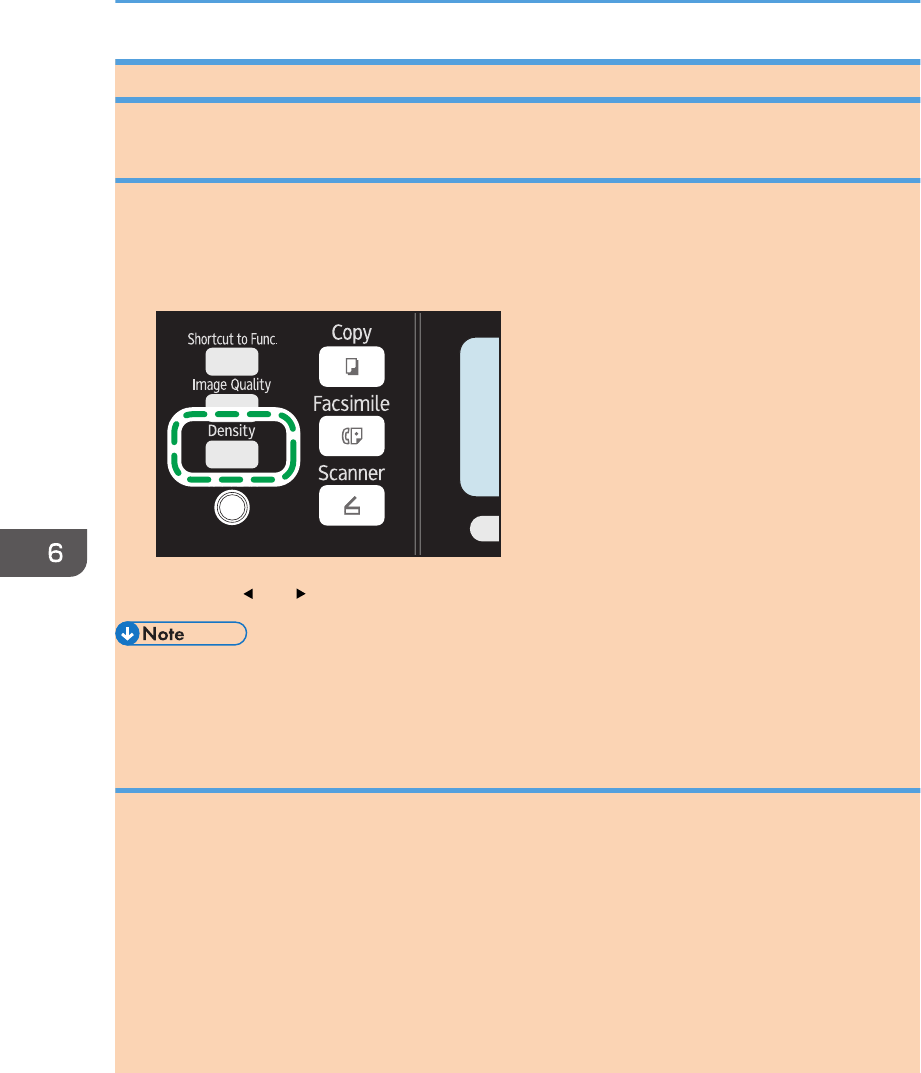
Specifying the Scan Settings
Adjusting image density
This section describes how to adjust image density for the current job.
There are three image density levels. The darker the density level, the darker the printout.
1. Press the [Density] key.
DCT874
2. Press the [ ] or [ ] key to select the desired density level, and then press the [OK] key.
• You can change the machine's default [Density] setting to always scan with a specific density level.
For [Density], see page 137 "Fax Transmission Features Settings".
Specifying the resolution
This section describes how to specify the scan resolution for the current job.
There are three resolution settings:
Standard
Select this when the original is a printed or typewritten document with normal-sized characters.
Detail
Select this when the original is a document with small print.
Photo
Select this when the original contains images such as photographs or shaded drawings.
6. Sending and Receiving a Fax
118 opal-p2_mf2_com_user_guide_00142109_eng.xml
Draft 2014/01/07
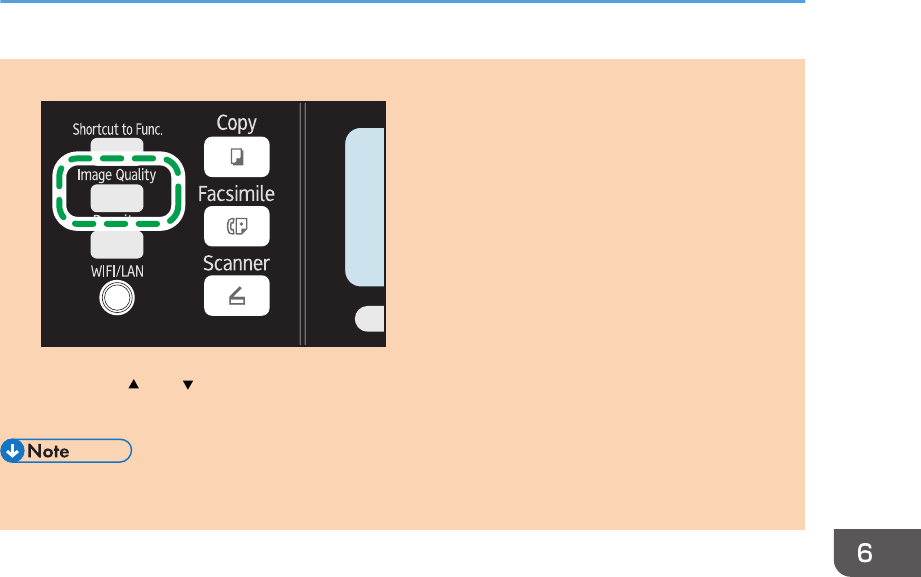
1. Press the [Image Quality] key.
DCT875
2. Press the [ ] or [ ] key to select the desired resolution setting, and then press the [OK]
key.
• You can change the machine's default [Resolution] setting to always scan with a specific resolution
level. For [Resolution], see page 137 "Fax Transmission Features Settings".
Sending a Fax
opal-p2_mf2_com_user_guide_00142109_eng.xml 119
Draft 2014/01/07
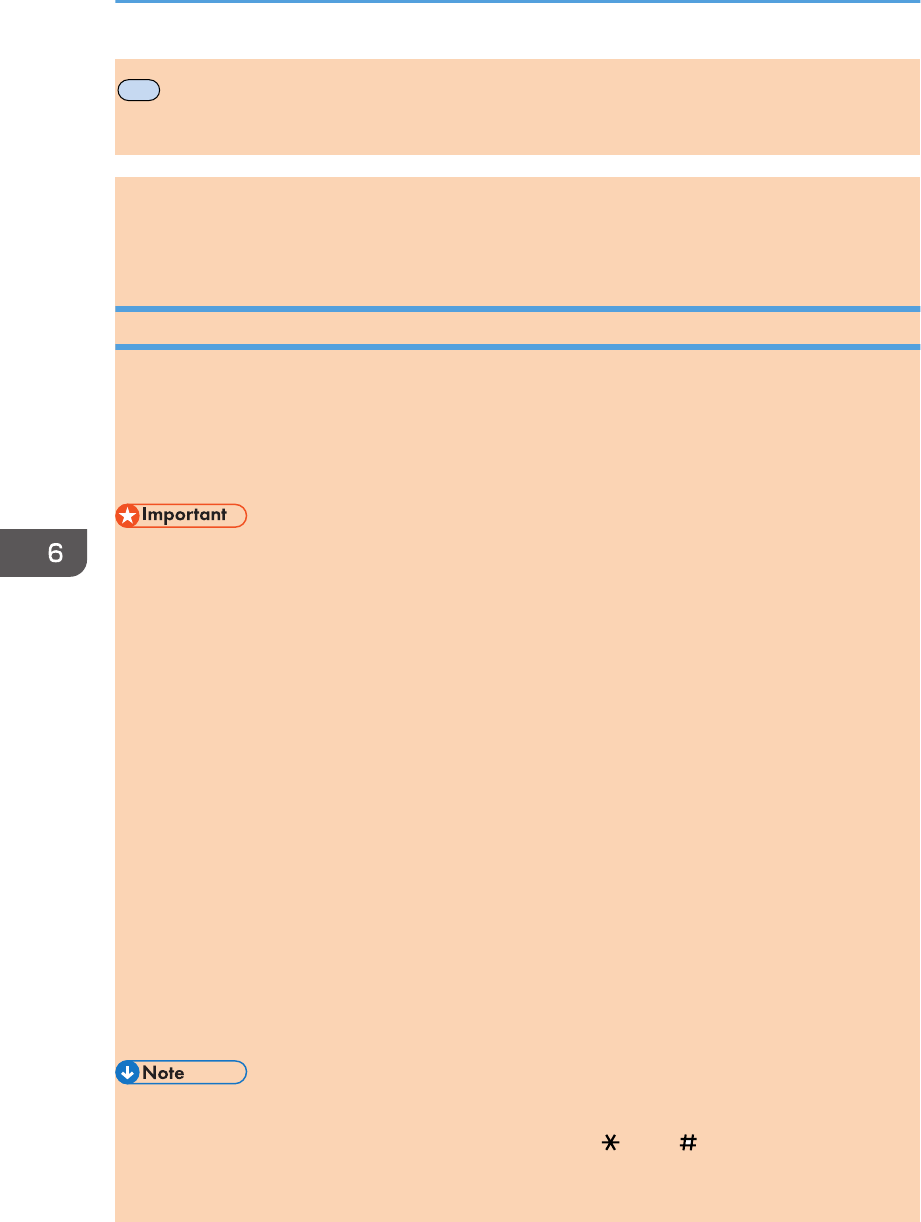
MF
Using the Fax Function from a Computer (PC
FAX)
This section describes how to use the fax function of the machine from a computer.
You can send a document directly from a computer through this machine to another fax machine,
without printing the document.
Basic Operation for Sending Faxes from a Computer
This section describes the basic operation for sending faxes from a computer.
You can select a destination from the PC Fax address book or enter a fax number manually. You can
send faxes to up to 100 destinations at once.
The procedure in this section is an example based on Windows 7.
• Using PC FAX, you can send up to ten pages (including the cover sheet) at a time.
1. Open the file you want to send.
2. On the [File] menu, click [Print...].
3. Select the PC FAX driver as the printer, and then click [Print].
4. Specify a destination.
• To specify a destination from the PC FAX address book:
Select a destination from [User List:], and then click [Add to List].
Repeat this step to add more destinations.
• To enter a fax number directly:
Click the [Specify Destination] tab, and enter a fax number (up to 40 digits) in [Fax Number:],
and then click [Add to List].
Repeat this step to add more destinations.
5. To attach a cover sheet, click [Edit Cover Sheet] on the [Specify Destination] tab, and then
select the [Attach a Cover Sheet] check box.
6. Click [Send].
• For details, see the PC FAX driver Help.
• A fax number can contain 0 to 9, "P" (pause), "T" (tone), " ", and " ".
• To use tone services on a pulse-dialing line, insert "T" in a fax number. "T" switches the dialing
mode from pulse to tone temporarily.
6. Sending and Receiving a Fax
120 opal-p2_mf2_com_user_guide_00142112_eng.xml
Draft 2014/01/07
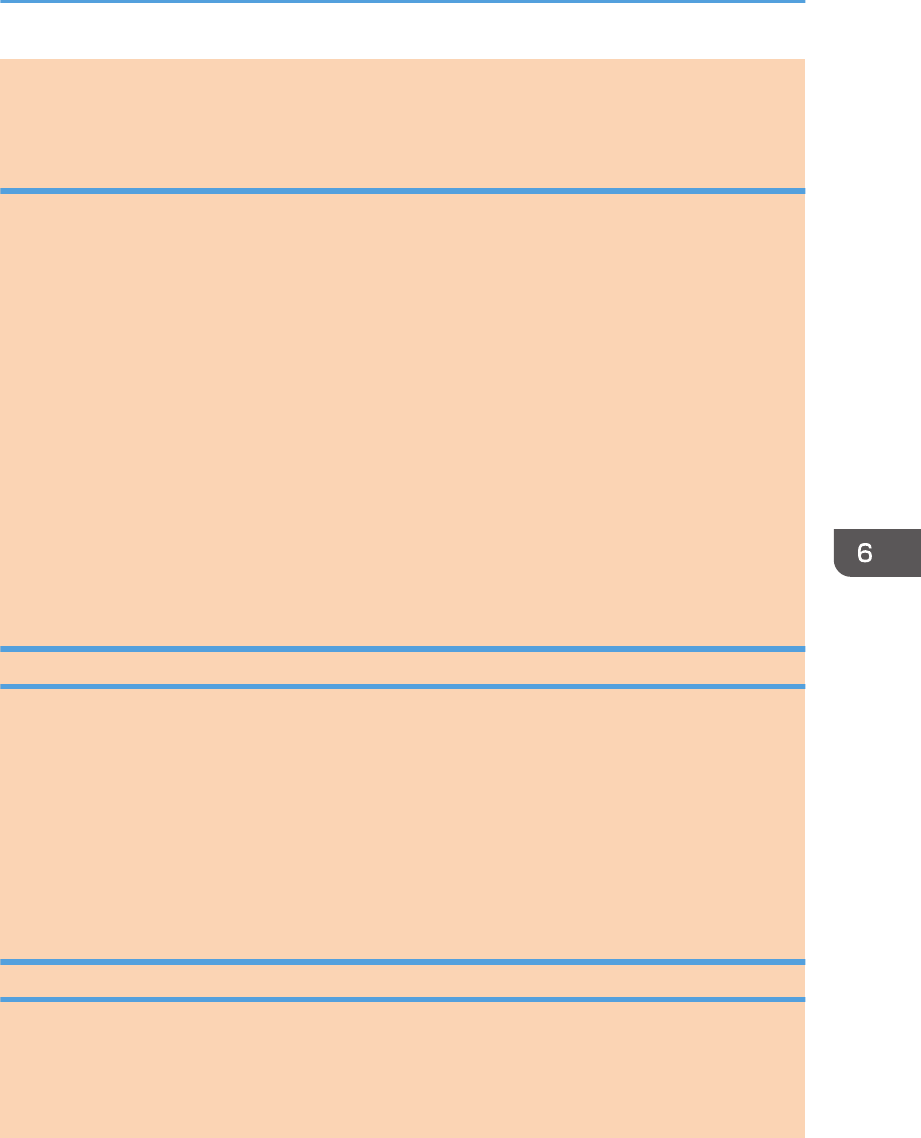
• To delete an entered destination, select the destination in [Destination List:], and then click [Delete
from List].
Canceling a fax
You can cancel sending a fax using either the machine's control panel or your computer, depending on
the status of the job.
Canceling while the machine is receiving a fax from the computer
If the machine is shared by multiple computers through a print server, be careful not to cancel
another user's fax.
1. Double-click the printer icon on the task bar of your computer.
2. Select the print job you want to cancel, click the [Document] menu, and then click
[Cancel].
Canceling a fax using the control panel
Cancel the fax using the control panel.
1. Press the [Facsimile] key.
2. Press the [Clear/Stop] key.
Configuring Transmission Settings
This section describes how to configure transmission settings in the PC FAX driver's properties.
Properties are set separately for each application.
1. On the [File] menu, click [Print...].
2. Select the PC Fax driver as the printer, and then click a button such as [Preferences].
PC FAX driver properties dialog box appears.
3. Configure settings as necessary, and then click [OK].
Configuring the PC FAX Address Book
This section describes the PC FAX address book. Configure the PC FAX address book on the computer.
The PC FAX address book allows you to specify PC FAX destinations quickly and easily.
The PC FAX address book can contain up to 1000 entries, including individual destinations and groups
of destinations.
Using the Fax Function from a Computer (PC FAX)
opal-p2_mf2_com_user_guide_00142112_eng.xml 121
Draft 2014/01/07
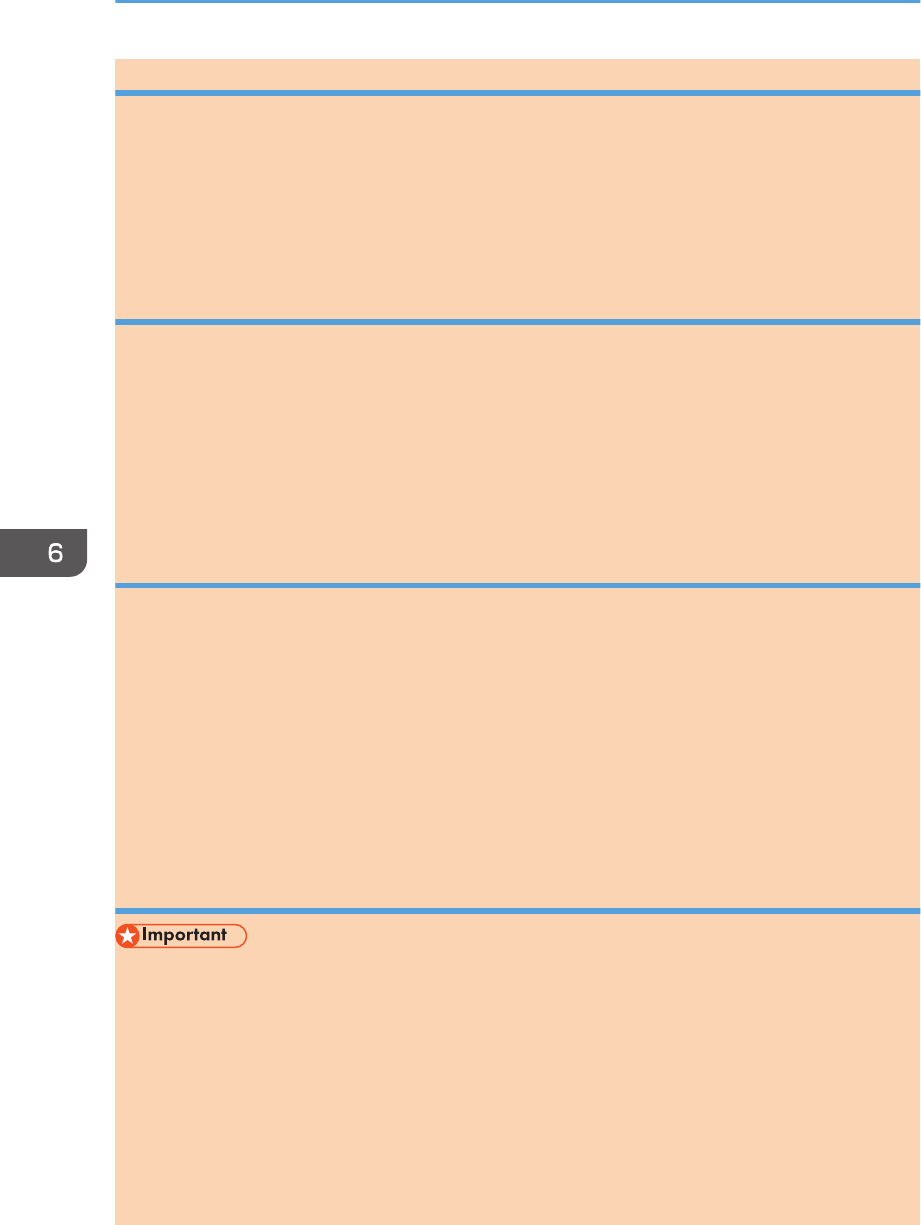
Opening the PC FAX address book
This section describes how to open the PC FAX address book.
1. On the [Start] menu, click [Devices and Printers].
2. Right-click the PC FAX driver icon, and then click [Printing Preferences...].
3. Click the [Address Book] tab.
Registering destinations
This section describes how to register destinations in the PC FAX address book.
1. Open the PC Fax address book, and then click [Add User].
2. Enter the destination information.
You must enter a contact name and fax number.
3. Click [OK].
Registering groups
This section describes how to register groups of destinations.
A group can contain up to 100 individual destinations.
1. Open the PC Fax address Book, and then click [Add Group].
2. Enter the group name in [Group Name].
3. Select the destination you want to include in the group from [User List:], and then click
[Add].
4. Click [OK].
Exporting/Importing PC-Fax Address Book data
• The following procedure is based on Windows 7 as an example. If you are using another
operating system, the procedure might vary slightly.
Exporting PC-Fax Address Book data
PC-Fax Address Book data can be exported to a file in CSV (Comma Separated Values) format.
Follow this procedure to export PC-Fax Address Book data.
1. Open the PC-Fax Address Book, and then click [Export].
2. Navigate to the location to save the PC-Fax Address Book data, specify a name for
the file, and then click [Save].
6. Sending and Receiving a Fax
122 opal-p2_mf2_com_user_guide_00142112_eng.xml
Draft 2014/01/07
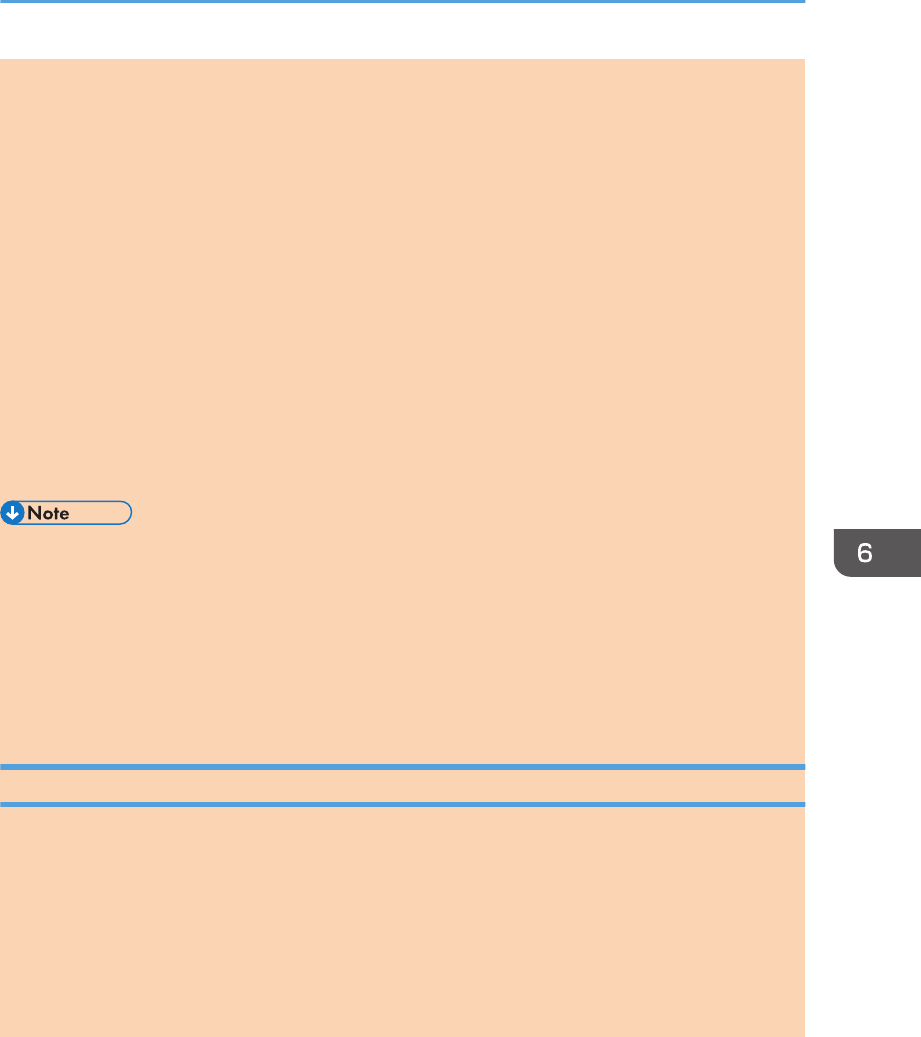
Importing PC-Fax Address Book data
PC-Fax Address Book data can be imported from files in CSV format. You can import address book
data from other applications if the data is saved as a CSV file.
Follow this procedure to import PC-Fax Address Book data. To import address book data from
other applications, you must select the appropriate items to import.
1. Open the PC-Fax Address Book, and then click [Import].
2. Select the file containing the address book data, and then click [Open].
A dialog box for selecting the items to import appears.
3. For each field, select an appropriate item from the list.
Select [*empty*] for fields for which there is no data to import. Note that [*empty*] cannot
be selected for [Name] and [Fax].
4. Click [OK].
For details about the settings, see the PC-Fax driver Help.
• CSV files are exported using Unicode encoding.
• PC-Fax Address Book data can be imported from CSV files whose character encoding is Unicode
or ASCII.
• Group data cannot be exported or imported.
• Up to 1000 destinations can be registered in the PC-Fax Address Book. If this limit is exceeded
during importing, the remaining destinations will not be imported.
Editing a Fax Cover Sheet
This section describes how to edit a fax cover sheet in the PC FAX driver's properties.
1. On the [File] menu, click [Print...].
2. Select the PC Fax driver as the printer, and then click [Print].
3. Click the [Specify Destination] tab, and then click [Edit Cover Sheet].
4. Configure settings as necessary, and then click [Print].
For details about the settings, see the PC Fax driver Help.
Using the Fax Function from a Computer (PC FAX)
opal-p2_mf2_com_user_guide_00142112_eng.xml 123
Draft 2014/01/07
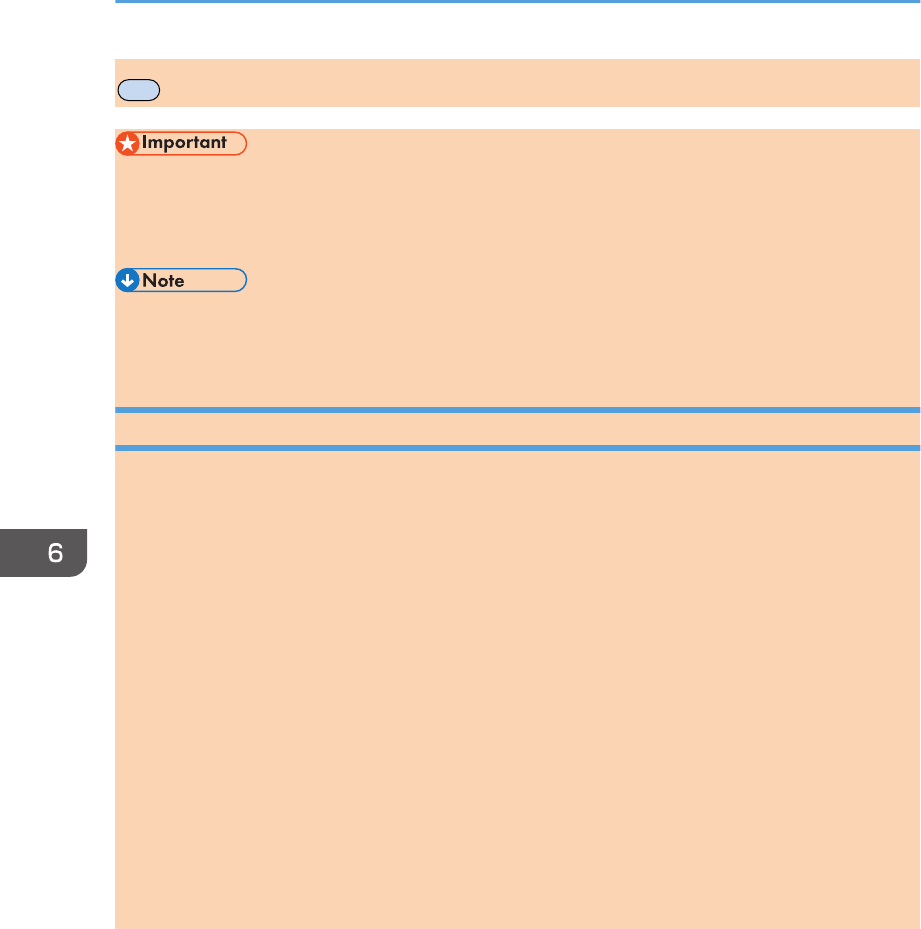
MF
Receiving a Fax
• When receiving an important fax, we recommend you confirm the contents of the received fax with
the sender.
• The machine may not be able to receive faxes when the amount of free memory space is low.
• An external telephone is required to use this machine as a telephone.
• Only A4, Letter, or Legal size paper can be used for printing faxes.
Selecting Reception Mode
The reception modes are as follows:
When using the machine only as a fax machine
Select the following mode when no external telephone or telephone answering device is
connected:
• Fax Only mode (auto reception)
In this mode, the machine is used only as a fax machine and receives faxes automatically.
When using the machine with an external device
Select one of the following modes when the handset, external telephone or telephone answering
device is connected:
• FAX/TEL Manual mode (manual reception)
In this mode, you must answer calls with the handset, external telephone. If a call is a fax call,
you must start the fax reception manually.
• Fax Only mode (auto reception)
In this mode, the machine automatically answers all incoming calls in fax reception mode.
6. Sending and Receiving a Fax
124 opal-p2_mf2_com_user_guide_00142113_eng.xml
Draft 2014/01/07
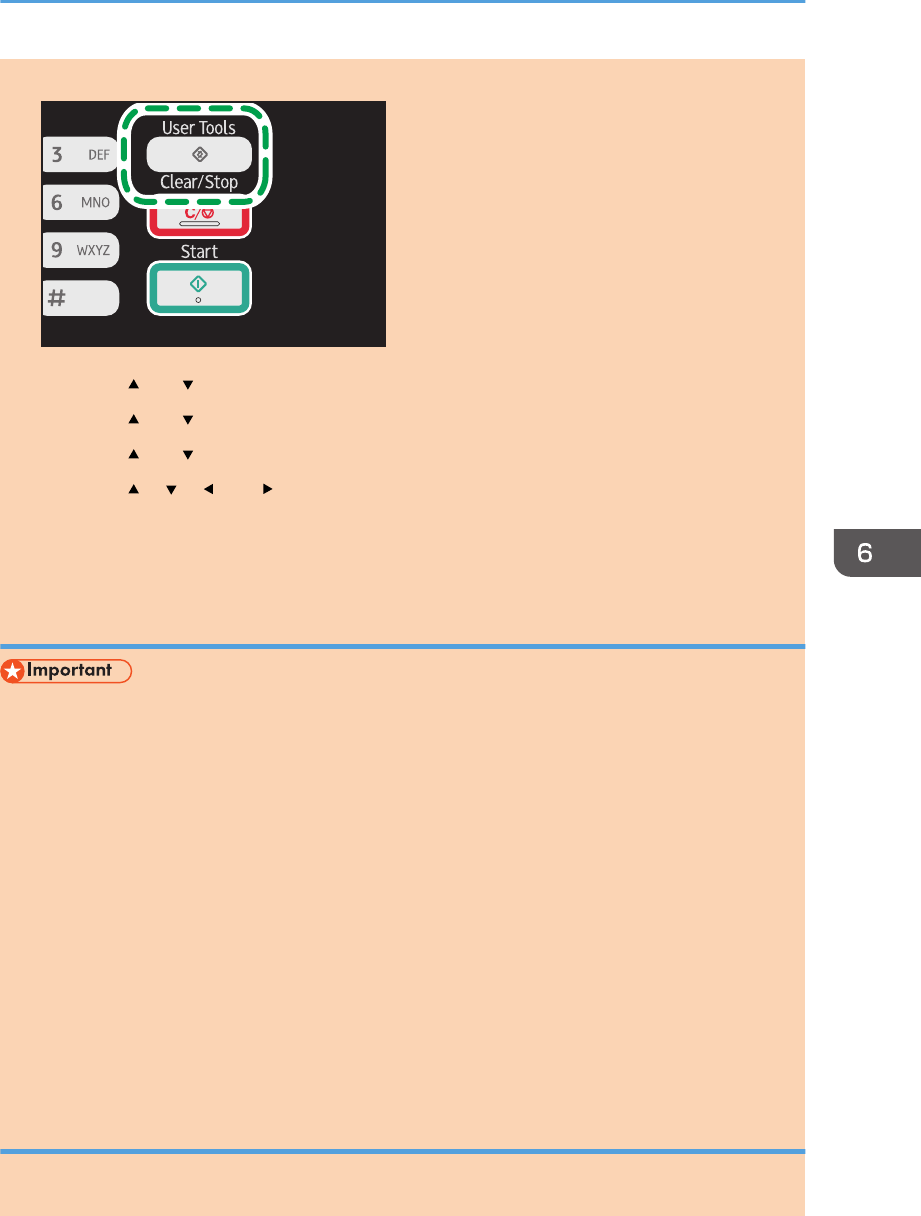
1. Press the [User Tools] key.
DCT845
2. Press the [ ] or [ ] key to select [Fax Features], and then press the [OK] key.
3. Press the [ ] or [ ] key to select [Reception Settings], and then press the [OK] key.
4. Press the [ ] or [ ] key to select [Switch Reception Mode], and then press the [OK] key.
5. Press the [ ], [ ], [ ], or [ ] key to select the desired reception mode, and then press the
[OK] key.
6. Press the [User Tools] key to return to the initial screen.
Receiving a fax in FAX/TEL Manual mode
• The procedure differs depending on whether [Operation] is set to [Easy Mode] or [Advanced
Mode] in [Fax Features].
1. Pick up the handset of the external telephone to answer the call.
The sender tells you that they will send a fax.
A normal telephone call starts.
2. When you hear a fax calling tone or no sound, press the [Facsimile] key.
3. Press the [Start] key.
If [Operation] is set to [Easy Mode], proceed to Step 4.
4. Press [RX].
5. Press the [Start] key.
6. Replace the handset.
Receiving a fax in Fax Only mode
When the reception mode is set to Fax Only mode, the machine automatically answers all incoming
calls in fax reception mode.
Receiving a Fax
opal-p2_mf2_com_user_guide_00142113_eng.xml 125
Draft 2014/01/07
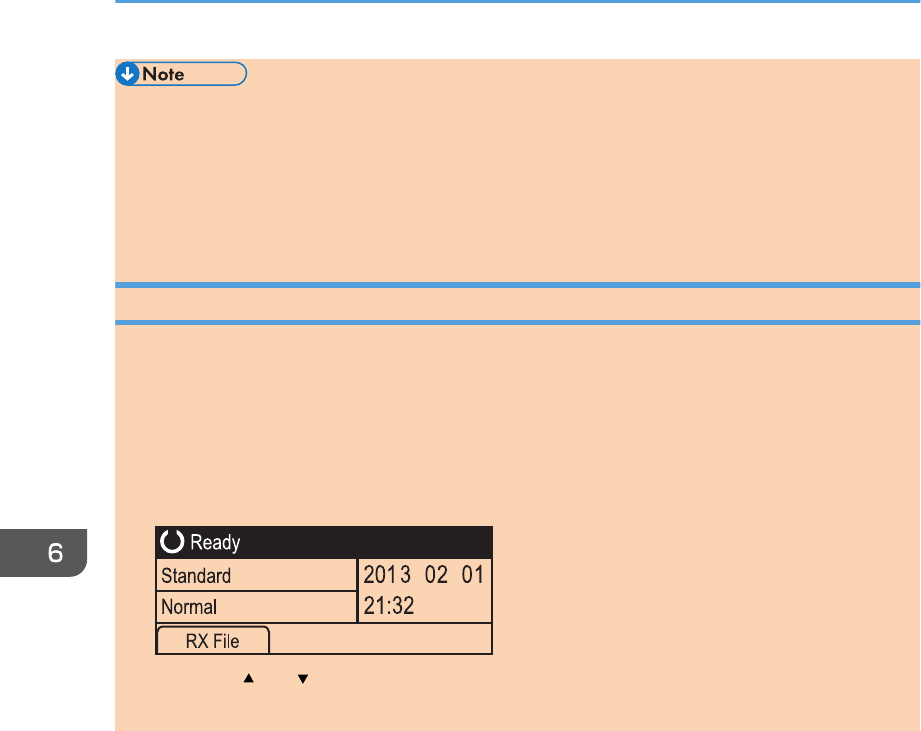
• You can specify the number of times the machine rings before answering a call in the [Number of
Rings] setting under [Fax Features]. For [Number of Rings], see page 139 "Fax Features Settings".
• If you answer a call with the external telephone while the machine is ringing, a normal telephone
call starts. If you hear a fax calling tone or no sound, receive the fax manually. To receive the fax
manually, see page 125 "Receiving a fax in FAX/TEL Manual mode".
Printing Out Faxes Stored in Memory
This section explains how to print out received faxes stored in the machine's memory.
When the Fax Received indicator is lit, there is a fax stored in machine’s memory. Follow the procedure
below to print the fax.
1. Press the [Facsimile] key.
2. Press [RX File].
//
3. Press the [ ] or [ ] keys to select [Automatic], and then press the [OK] key.
The machine prints out the stored fax and deletes it from memory.
6. Sending and Receiving a Fax
126 opal-p2_mf2_com_user_guide_00142113_eng.xml
Draft 2014/01/07
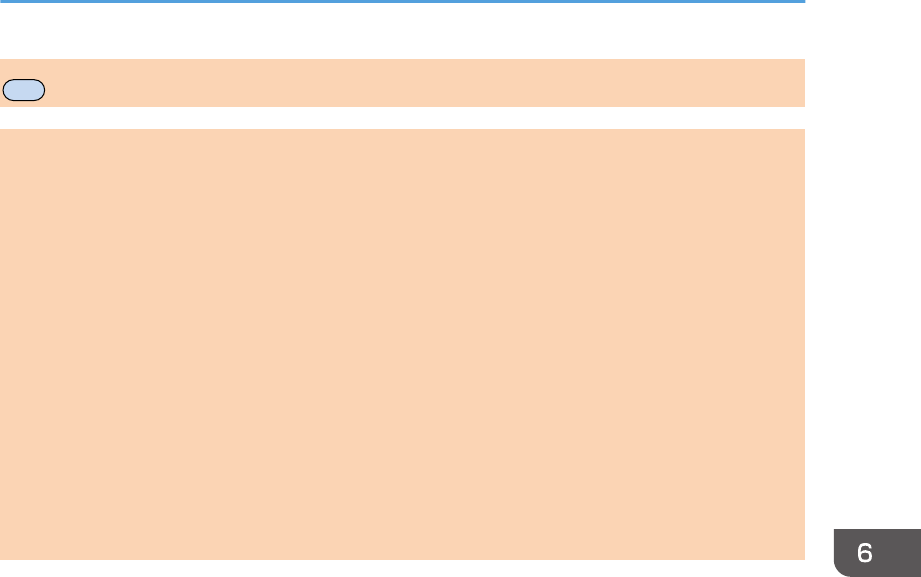
MF
Lists/Reports Related to Fax
The lists and reports related to the fax function are as follow:
• Fax Journal
Prints a fax transmission and reception journal for the last 100 jobs.
• TX Status Report
Prints out the latest Transmission result.
• TX/RX Standby File List
Prints a list of unsent fax jobs remaining in the machine's memory.
• Power Failure Report
Prints a report when the machine's power has been interrupted while sending or receiving a fax, or
images stored in the machine's memory have been lost due to the machine being turned off for a
prolonged period of time.
• Fax Speed Dial Dest. List
Prints a list of Speed Dial entries.
Lists/Reports Related to Fax
opal-p2_mf2_com_user_guide_00142116_eng.xml 127
Draft 2014/01/07

6. Sending and Receiving a Fax
128 opal-p2_mf2_com_user_guide_00142116_eng.xml
Draft 2014/01/07
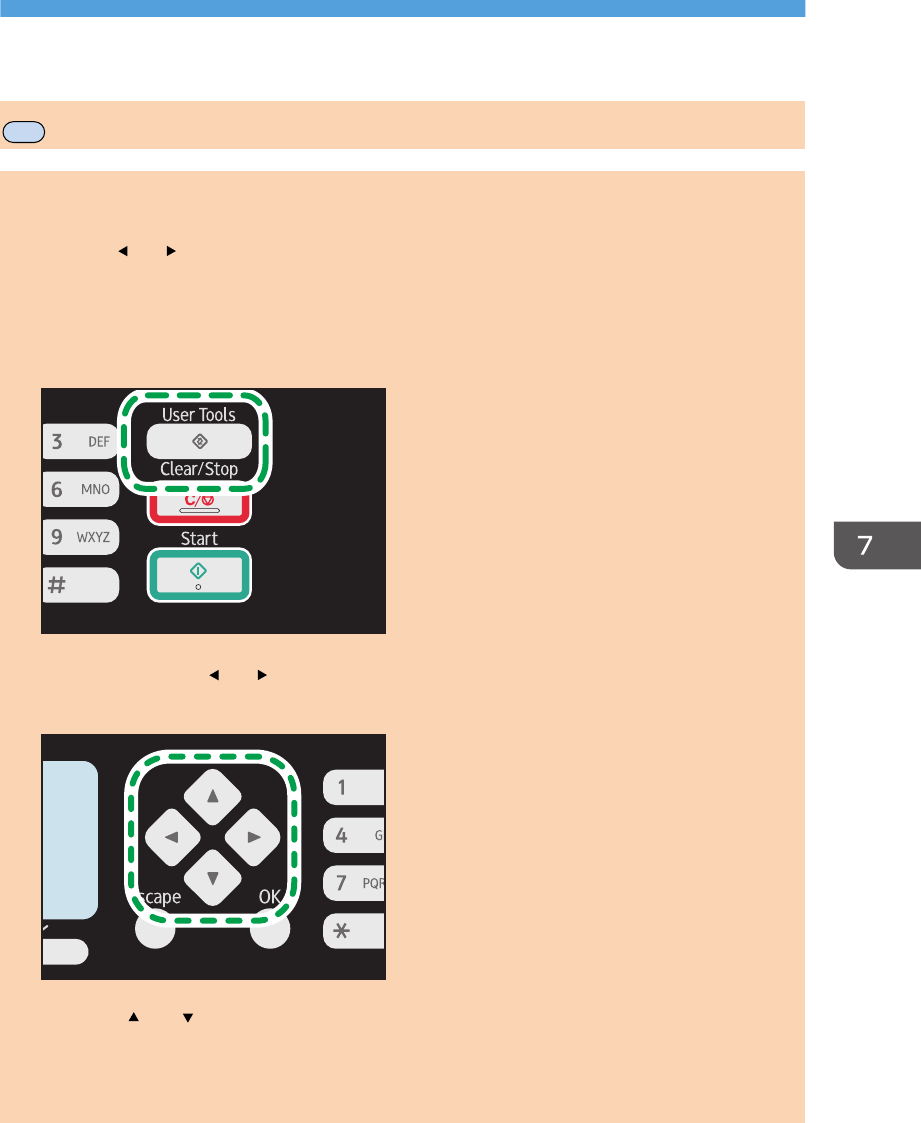
7. Configuring the Machine Using the
Control Panel
MF
Basic Operation
There are two main ways to access the machine settings:
• Press the [User Tools] key to access the System or Network settings.
• Press the [ ] or [ ] key to access the Copy, Scan, or Fax settings.
To check which category the function you want to configure belongs to, see page 131 "Menu
Chart".
1. If you want to configure the machine's system settings, press the [User Tools] key.
DCT845
Otherwise, press the [ ] or [ ] key while "Ready" is displayed on the initial screen of the Copy,
Scan, and Fax settings.
DCT879
2. Press the [ ] or [ ] key to select the settings you want to use.
If you select [Address Book], [Network Settings], or [Admin. Tools] menu, you might be requested
to enter a password. Enter the four-digit password, and then press the [OK] key. For details about
the password, see [Admin. Tools Lock] on page 159 "Administrator Settings".
opal-p2_mf2_com_user_guide_00142118_eng.xml 129
Draft 2014/01/07
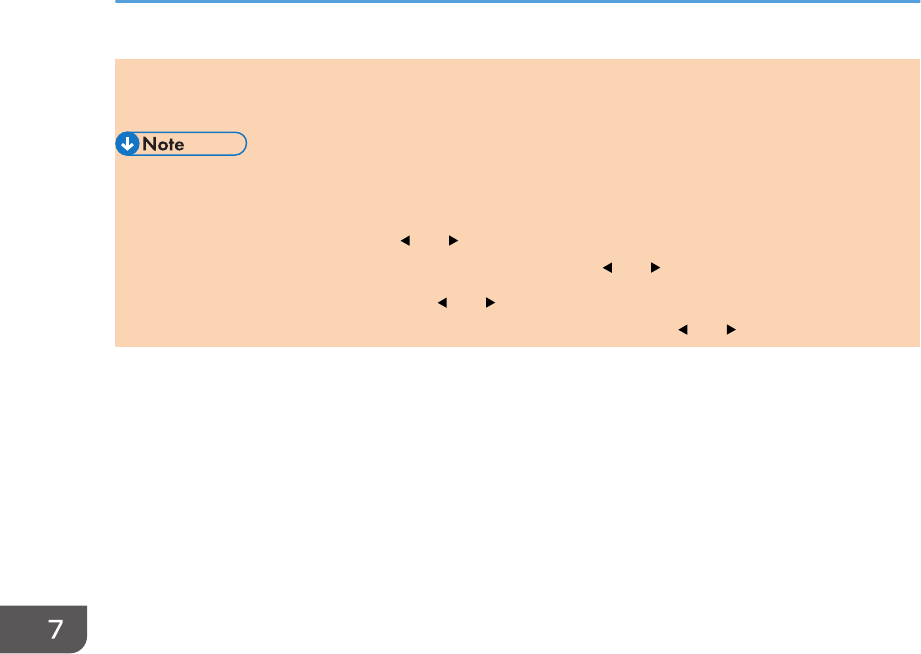
3. To confirm setting items and values displayed, press the [OK] key.
4. To go back to the previous item, press the [Escape] key.
• To return to the initial screen, press the [Escape] key the same amount of times as the number of
selected items, or press the [User Tools] key once.
• With Type 1 models, press the [ ] or [ ] key to access the Copy setting. To specify [Scan Settings],
insert the USB flash drive and select the settings using the [ ] or [ ] key.
• With Type 1 or 5 models, press the [ ] or [ ] key to access the Copy setting. To specify [Scan
Settings], insert the USB flash drive and select the settings using the [ ] or [ ] key.
7. Configuring the Machine Using the Control Panel
130 opal-p2_mf2_com_user_guide_00142118_eng.xml
Draft 2014/01/07
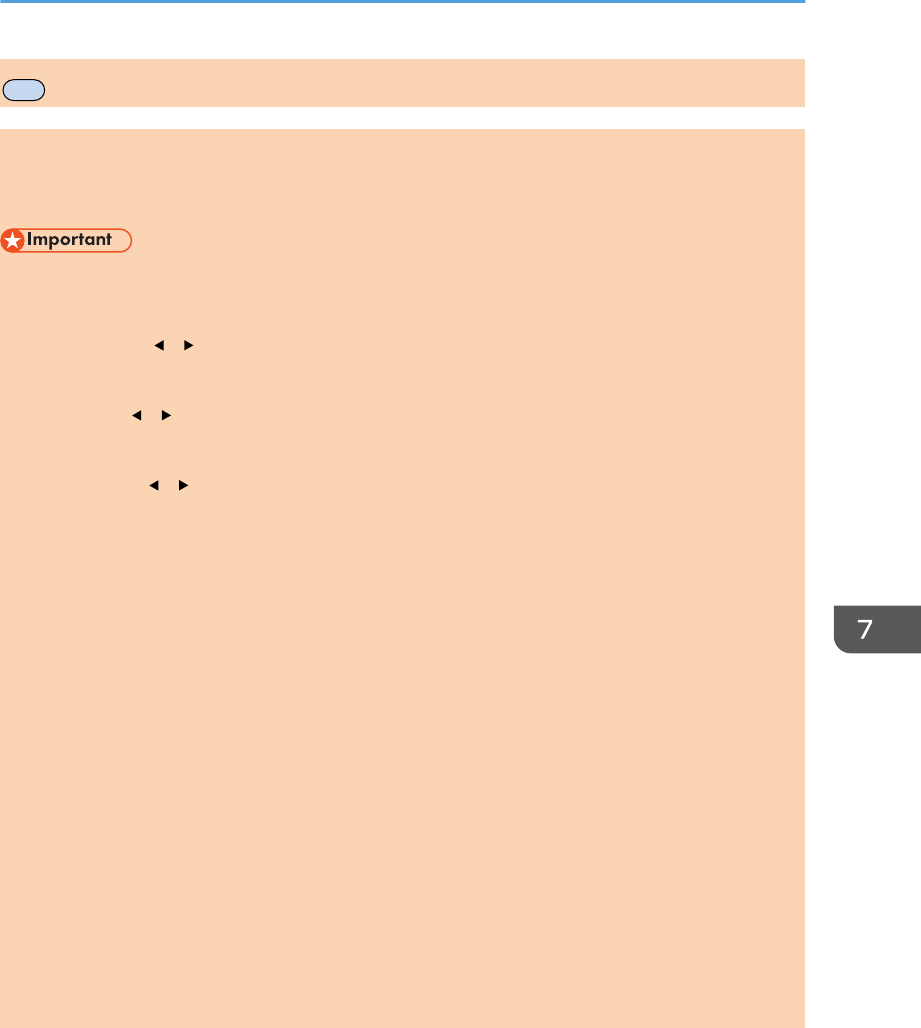
MF
Menu Chart
This section lists the parameters included in each menu.
For details about configuring the machine using Web Image Monitor, see page 165 "Configuring the
Machine Using Utilities".
• Some items might not appear depending on the model type or machine's configuration.
• Some items can also be configured using Web Image Monitor.
Copier Features ([ ] [ ] key setting)
For details, see page 132 "Copier Features Settings"
Scan Settings ([ ] [ ] key setting)
For details, see page 135 "Scanner Features Settings"
Fax TX Settings ([ ] [ ] key setting)
For details, see page 137 "Fax Transmission Features Settings"
Fax Features ([User Tools] key setting)
For details, see page 139 "Fax Features Settings"
Address Book ([User Tools] key setting)
For details, see page 144 "Address Book Settings"
System Settings ([User Tools] key setting)
For details, see page 145 "System Settings"
Network Settings ([User Tools] key setting)
For details, see page 155 "Network Settings"
Print List/Report ([User Tools] key setting)
For details, see page 150 "Printing Lists/Reports"
Admin. Tools ([User Tools] key setting)
For details, see page 159 "Administrator Settings"
Printer Features ([User Tools] key setting)
For details, see page 152 "Printer Features Settings"
Menu Chart
opal-p2_mf2_com_user_guide_00142119_eng.xml 131
Draft 2014/01/07

MF
Copier Features Settings
Select Paper Tray
Select the paper tray used for copying.
Default: [Tray 1]
• Tray 1
• Bypass Tray
Sort
Configures the machine to sort the output pages into sets when making multiple copies of a multi-
page document (P1, P2, P1, P2...).
Default: [Off]
• On
• Off
Original Type
Specifies the content of originals, to optimize copy quality.
Default: [Mixed]
• Mixed
Select this when the original contains both text and photographs or pictures.
• Text
Select this when the original contains only text and no photographs or pictures.
• Photo
Select this when the original contains photographs or pictures. Use this mode for the following
types of original:
• Photographs
• Pages that are entirely or mainly photographs or pictures, such as magazine pages.
• Vou.
Select this to scan with the appropriate setting for vouchers. This is available only if using the
exposure glass.
Density
Specifies the image density for photocopying.
Increase the level (black squares) to increase the density.
Default: The default setting is the middle of 5 adjustment levels.
Reduce/Enlarge
Specifies the percentage by which copies are enlarged or reduced.
7. Configuring the Machine Using the Control Panel
132 opal-p2_mf2_com_user_guide_00142120_eng.xml
Draft 2014/01/07

Default: [100%]
(mainly Europe and Asia)
50%, 71% (A4->A5), 82% (B5J->A5), 93%, 100%, 122% (A5->B5J), 141% (A5->A4), 200%,
400%
(mainly North America)
50%, 65% LT->HLT, 78% LG->LT, 93%, 100%, 129% HLT->LT, 155% HLT->LG, 200%, 400%
• Zoom 25-400%
Duplex/Combine
Specifies combined copying. Select a copy mode according to your original and how you want
the copy outputs to appear. For more details, see page 69 "Making Combined/2-sided Copies".
Note that enabling combined copying automatically disables ID card copying.
Default: [Off]
• Off
• 1Sd 2Orig->Comb 2on1 1Sd
Copy will be made on 1 side, on which 2 pages of 1-sided original will be printed.
• Portrait
• Landscape
• 1Sd 4Orig->Comb 4on1 1Sd
Copy will be made on 1 side, on which 4 pages of 1-sided original will be printed.
• Portrait: L to R
• Portrait: T to B
• Landscape: L to R
• Landscape: T to B
• 1 Sided Orig->2 Sided Copy
Copies two 1-sided pages on one 2-sided page.
• Portrait: T to T
• Portrait: T to B
• Landscape: T to T
• Landscape: T to B
• 1Sd 4Orig->Comb 2on1 2Sd
Copies four 1-sided pages on two 2-sided pages.
• Portrait: T to T
• Portrait: T to B
• Landscape: T to T
Copier Features Settings
opal-p2_mf2_com_user_guide_00142120_eng.xml 133
Draft 2014/01/07
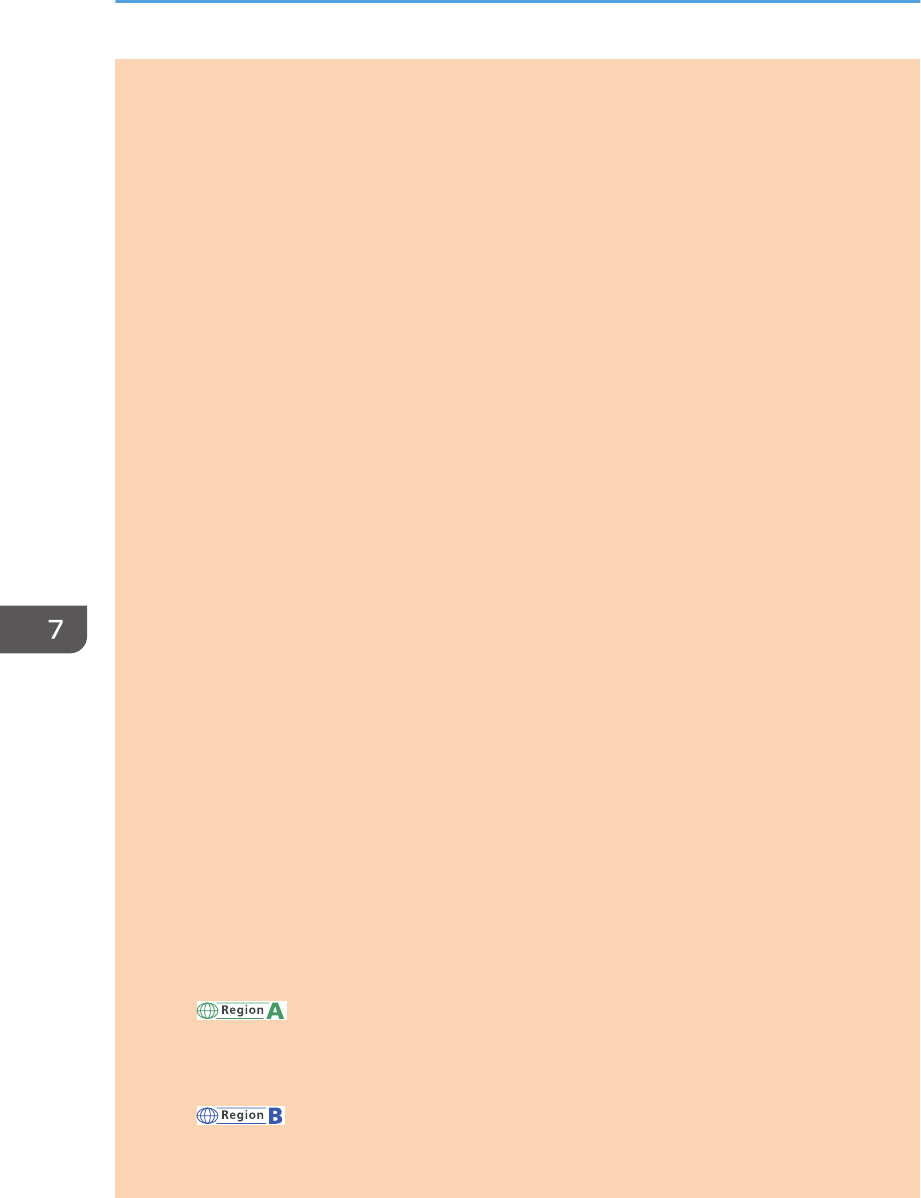
• Landscape: T to B
• 1Sd 8Orig->Comb 4on1 2Sd
Copies eight 1-sided pages on four 2-sided pages.
• Portrait: L to R, T to T
• Portrait: L to R, T to B
• Portrait: T to B, T to T
• Portrait: T to B, T to B
• Landscape: L to R, T to T
• Landscape: L to R, T to B
• Landscape: T to B, T to T
• Landscape: T to B, T to B
ID Card Copy Settings
You can specify the ID Card Copy setting.
• ID Card Copy
If you set this to [On], the settings specified in [ID Card Copy Settings] are applied to printed
copies.
Default: [Off]
• On
• Off
• ID Card Center Line
Specify whether to draw a center line when making ID card copy.
Default: [Do not Print]
• Print
• Do not Print
• ID Card Size
You can change the ID card copy scanning size.
Default:
(mainly Europe and Asia)
Horiz: 86 mm
Vert: 54 mm
(mainly North America)
Horiz: 3.38 inch
Vert: 2.12 inch
7. Configuring the Machine Using the Control Panel
134 opal-p2_mf2_com_user_guide_00142120_eng.xml
Draft 2014/01/07
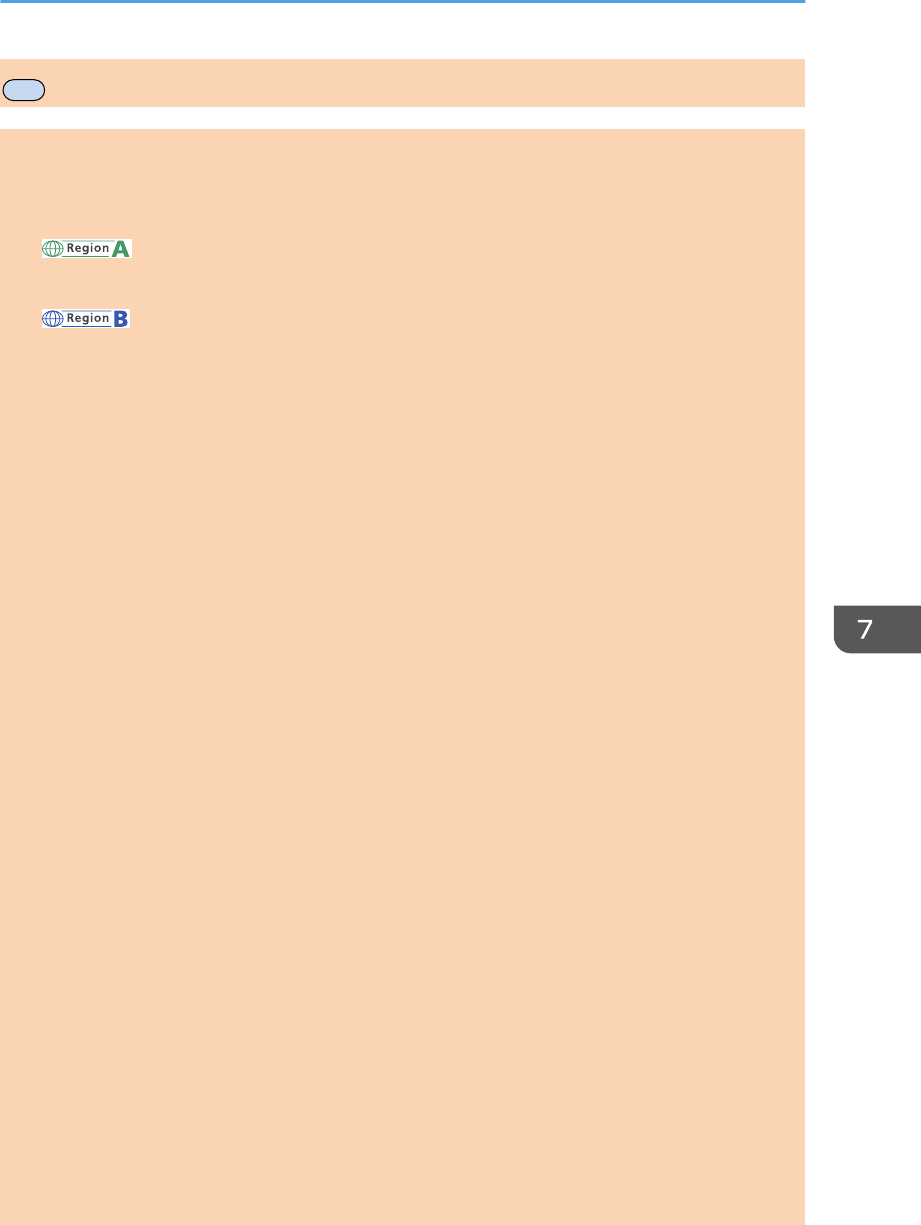
MF
Scanner Features Settings
Scan Size
Specifies the scanning size according to the size of the original.
Default:
(mainly Europe and Asia)
[A4]
(mainly North America)
[8 1/2 × 11]
• 8 1/2 × 14, 8 1/2 × 11, 8 1/2 × 5 1/2, 7 1/4 × 10 1/2, A4, B5, A5, 16K, Custom Size
Scanning Mode
Specifies the scanning mode using the control panel.
Default: [Color]
• B&W
The machine creates 1-bit black-and-white images. Images contain only black and white
colors.
• Color
The machine creates 8-bit color images. Images are full color.
• Gray Scale
The machine creates 8-bit black-and-white images. Images contain black and white, and
intermediate gray colors.
Max. E-mail Size
Specifies the maximum size of a file that can be sent by e-mail.
Default: [1 MB]
• 1 MB
• 2 MB
• 3 MB
• 4 MB
• 5 MB
• No Limit
Density
Specifies the image density for scanning originals.
Increase the level (black squares) to increase the density.
Default: The default setting is the middle of 5 adjustment levels.
Scanner Features Settings
opal-p2_mf2_com_user_guide_00142121_eng.xml 135
Draft 2014/01/07

Resolution
Specifies the resolution for scanning the original.
Default: [300 × 300dpi]
• 100 × 100dpi
• 150 × 150dpi
• 200 × 200dpi
• 300 × 300dpi
• 400 × 400dpi
• 600 × 600dpi
Compression (Color)
Specifies the color compression ratio for JPEG files. The lower the compression ratio, the higher the
quality but greater the file size.
Default: [Medium]
• Low
• Medium
• High
Limitless Scan
Sets the machine to request next originals when scanning with the exposure glass.
Default: [Off]
• Off
• On
File Type
Specifies whether to create a multi-page file containing all pages or separate single-page files
when scanning multiple pages.
Note that a scanned file can contain multiple pages only when the file format is PDF or TIFF. If the
file format is JPEG, a single-page file is created for each scanned page.
Default: [Multi-page]
• Multi-page
A multi-page file containing all pages is created.
• Single Page
A single-page file is created for each page.
7. Configuring the Machine Using the Control Panel
136 opal-p2_mf2_com_user_guide_00142121_eng.xml
Draft 2014/01/07

MF
Fax Transmission Features Settings
Immediate TX
Sets the machine to send a fax immediately when the original is scanned.
Default: [Off]
• Off
Select this when using Memory Transmission.
• On
Select this when using Immediate Transmission.
• Next Fax Only
Select this when using Immediate Transmission for the next transmission only.
Resolution
Specifies the resolution to use for scanning originals.
Default: [Standard]
• Standard
Select this when the original is a printed or typewritten document with normal-sized
characters.
• Detail
Select this when the original is a document with small print.
• Photo
Select this when the original contains images such as photographs or shaded drawings.
Density
Specifies the image density to use for scanning originals.
Default: [Normal]
• Light
• Normal
• Dark
Pause Time
Specifies the length of pause time when a pause is inserted between the digits of a fax number.
Default: 3 seconds
• 1 to 15 seconds
Auto Redial
Sets the machine to redial the fax destination automatically when the line is busy or a transmission
error occurs, if the machine is in Memory Transmission mode. The number of redial attempts is
Fax Transmission Features Settings
opal-p2_mf2_com_user_guide_00142122_eng.xml 137
Draft 2014/01/07

preset to two or three times, depending on the [Country] setting under [Admin. Tools], in five-minute
intervals.
Default: [On]
• Off
• On
Print Fax Header
Sets the machine to add a header to every fax you send. The header includes the current date and
time, user fax name and fax number of the machine, job ID, and page information.
Default: [On]
• Off
• On
7. Configuring the Machine Using the Control Panel
138 opal-p2_mf2_com_user_guide_00142122_eng.xml
Draft 2014/01/07

MF
Fax Features Settings
Reception Settings
Specifies the settings for receiving a fax.
• Switch Reception Mode
Specifies the reception mode.
Default: [Fax Only]
• Fax Only
The machine automatically answers all incoming calls in fax reception mode.
• FAX/TEL(Mnl.)
The machine rings when it receives incoming calls. The machine receives faxes only
when you manually receive faxes.
• FAX/TAD
The machine receives faxes automatically when a fax call is received. Otherwise, the
connected telephone answering device answers the call.
• Auto Reduction
Sets the machine to reduce the size of a received fax if it is too large to print on a single sheet
of paper.
Note that the machine only reduces the size down to 74%. If further reduction is required to fit
the fax on a single sheet, it will be printed on separate sheets without being reduced.
Default: [On]
(Default may be [Off] depending on the [Country] setting under [Admin. Tools].)
• Off
• On
• Number of Rings
Specifies the number of times the machine rings before it starts to receive faxes in Fax Only
mode.
Default: 3 times
• 3 to 5 times, in increments of 1
• RX Store File
You can print or delete received faxes.
• Print Selected File
You can select and print received faxes.
• Delete Selected File
Fax Features Settings
opal-p2_mf2_com_user_guide_00142123_eng.xml 139
Draft 2014/01/07

You can select and delete received faxes.
• Delete All File
• Reception File Setting
Sets the machine to store received faxes into memory for printing or forward them to a preset
destination.
Use Web Image Monitor to specify the forwarding destination (for details, see page 172
"Configuring the System Settings").
Default: [Print]
• Print
• Forward
• Print Received File
Sets the machine to automatically print the faxes received into memory or store them for later
manual printing.
Default: [Automatic]
• Automatic
Automatically print out the received faxes and delete from memory.
• Manual
Store the received faxes in memory for manual printing.
• Notify Forward Status
Sets the machine to send e-mail notifications after faxes are forwarded. The e-mail notification
destination depends on how the forwarding destination is configured using Web Image
Monitor (for details, see page 172 "Configuring the System Settings").
Default: [Off]
• On
• Off
Delete TX Standby File
Deletes unsent fax jobs remaining in the machine's memory. The machine can store up to 5 unsent
fax jobs.
This function is only performed when selected.
• Delete Selected File
To delete a fax job, select the desired job, and then select [Yes]. Selecting [No] exits to the
previous level of the menu tree without deleting the fax job.
• Delete All Files
To delete the fax jobs, select [Yes]. Selecting [No] exits to the previous level of the menu tree
without deleting the fax job.
7. Configuring the Machine Using the Control Panel
140 opal-p2_mf2_com_user_guide_00142123_eng.xml
Draft 2014/01/07

Communication Settings
• ECM Transmission
Sets the machine to automatically resend parts of the data that are lost during transmission.
Default: [On]
• Off
• On
• ECM Reception
Sets the machine to automatically receive parts of the data that are lost during reception.
Default: [On]
• Off
• On
• Dial Tone Detect
Sets the machine to detect a dial tone before the machine begins to dial the destination
automatically.
Default: [Detect]
(Default may be [Not Detect] depending on the [Country] setting under [Admin. Tools].)
• Detect
• Not Detect
• Transmission Speed
Specifies the transmission speed for the fax modem.
Default: [33.6 Kbps]
• 33.6 Kbps
• 14.4 Kbps
• 9.6 Kbps
• 7.2 Kbps
• 4.8 Kbps
• 2.4 Kbps
• Reception Speed
Specifies the reception speed for the fax modem.
Default: [33.6 Kbps]
• 33.6 Kbps
• 14.4 Kbps
• 9.6 Kbps
Fax Features Settings
opal-p2_mf2_com_user_guide_00142123_eng.xml 141
Draft 2014/01/07

• 7.2 Kbps
• 4.8 Kbps
• 2.4 Kbps
Report Print Settings
• Print TX Status Report
Sets the machine to print a transmission report automatically after a fax transmission.
When the machine is in Immediate Transmission mode, the image of the original will not be
reproduced on the report, even if [Error Only (Image Attached)] or [Every TX (Image
Attached)] is selected.
Note that if a memory error occurs for PC-Fax transmission, a transmission report will always
be printed regardless of this setting.
The transmission report will be printed on A4 or Letter size paper.
Default: [Error Only (Image Attached)]
• Error Only
Prints a report when a transmission error occurs.
• Error Only (Image Attached)
Prints a report with an image of the original when transmission error occurs.
• Every TX
Prints a report for every fax transmission.
• Every TX (Image Attached)
Prints a report with an image of the original for every fax transmission.
• Do not Print
• Print Fax Journal
Sets the machine to print a fax journal automatically for every 50 fax jobs (both sent and
received).
Default: [Auto Print]
• Auto Print
• Do not Auto Print
Operation
You can simplify the procedure for sending and receiving faxes by disabling the use of the
exposure glass. If originals are loaded in the ADF, you can fax them using the ADF in either mode
by pressing the [Start] key.
Default: [Advanced Mode]
• Easy Mode
7. Configuring the Machine Using the Control Panel
142 opal-p2_mf2_com_user_guide_00142123_eng.xml
Draft 2014/01/07

If you select [Easy Mode], you can receive faxes by pressing the [Start] key. The exposure
glass cannot be used in this mode.
• Advanced Mode
If you select [Advanced Mode], you can specify whether to send or receive faxes after
pressing the [Start] key.
Fax Features Settings
opal-p2_mf2_com_user_guide_00142123_eng.xml 143
Draft 2014/01/07
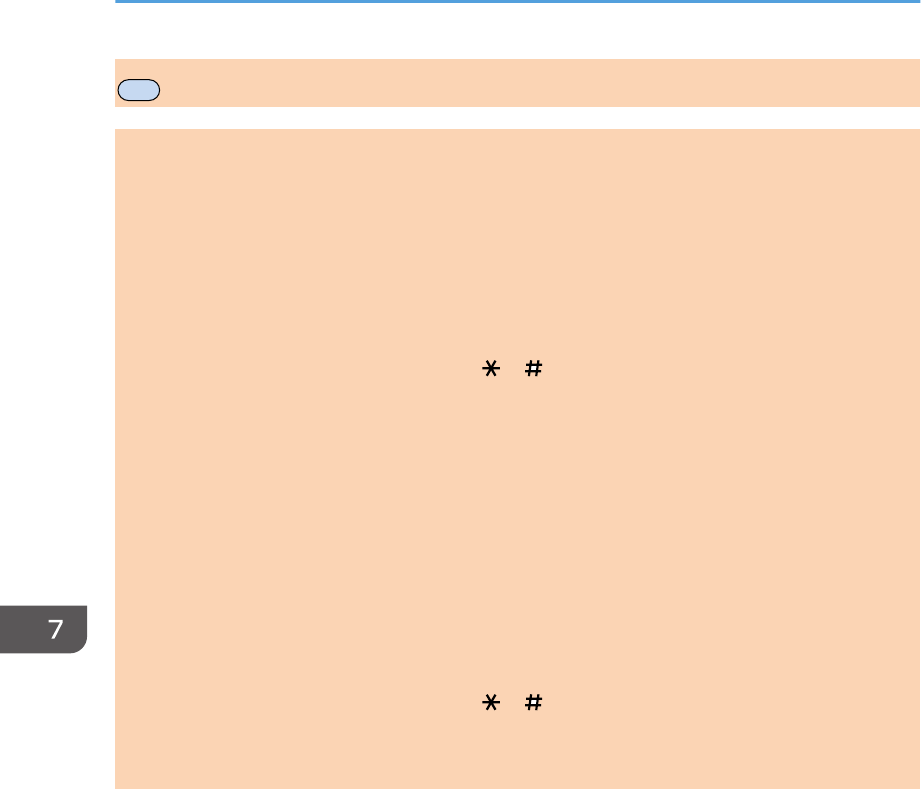
MF
Address Book Settings
Quick Dial Dest.
Specifies the fax number and name for Quick Dial entries. You can register up to 8 Quick Dial
entries.
• No.
Specifies the Quick Dial number.
• Fax No.
Specifies the fax number for Quick Dial entries. The fax number can contain up to 40
characters, including 0 to 9, pause, " ", " ", and space.
• Name
Specifies the name for Quick Dial entries. The name can contain up to 20 characters.
Fax Speed Dial Dest.
Specifies the fax number and name for Speed Dial entries. You can register up to 100 Speed Dial
entries.
• No.
Specifies the Speed Dial number.
• Fax No.
Specifies the fax number for Speed Dial entries. The fax number can contain up to 40
characters, including 0 to 9, pause, " ", " ", and space.
• Name
Specifies the name for Speed Dial entries. The name can contain up to 20 characters.
7. Configuring the Machine Using the Control Panel
144 opal-p2_mf2_com_user_guide_00142124_eng.xml
Draft 2014/01/07

MF
System Settings
Adjust Sound Volume
Specifies the volume of the sounds produced by the machine.
Default: [Low] for [Panel Key Sound], and [Middle] for other parameters.
• Panel Key Sound
Specifies the volume of the beep that sounds when a key is pressed.
• Off
• Low
• Middle
• High
• On Hook Mode
Specifies the volume of the sound from the speaker during on hook mode.
• Off
• Low
• Middle
• High
• Job End Tone
Specifies the volume of the beep that sounds when a job is complete.
• Off
• Low
• Middle
• High
• Job Error Tone
Specifies the volume of the beep that sounds when a fax transmission error occurs.
• Off
• Low
• Middle
• High
• Alarm Volume
Specifies the volume of the alarm that sounds when an operation error occurs.
• Off
• Low
System Settings
opal-p2_mf2_com_user_guide_00142125_eng.xml 145
Draft 2014/01/07
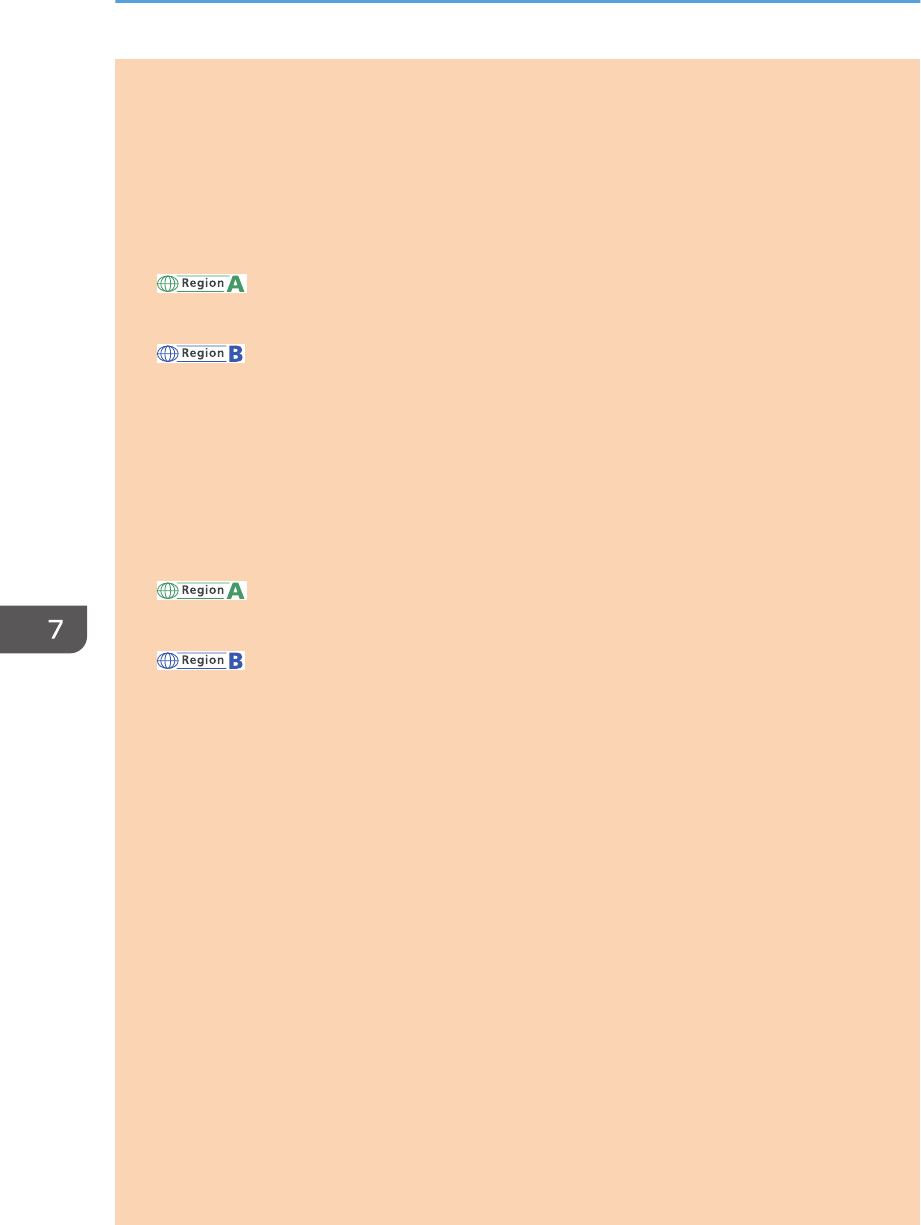
• Middle
• High
Tray Paper Settings
Paper Size: Tray 1
Specifies the paper size for Tray 1.
Default:
(mainly Europe and Asia)
[A4]
(mainly North America)
[81/2 × 11]
• A4, B5 JIS, A5, B6 JIS, A6, 8 1/2 × 14, 8 1/2 × 11, 5 1/2 × 8 1/2, 7 1/4 × 10 1/2,
16K (197 × 273), 16K (195 × 270), 16K (184 × 260), Custom
Paper Size: Bypass Tray
Specifies the paper size for bypass tray.
Default:
(mainly Europe and Asia)
[A4]
(mainly North America)
[81/2 × 11]
• A4, B5 JIS, A5, B6 JIS, A6, 8 1/2 × 14, 8 1/2 × 11, 5 1/2 × 8 1/2, EXE (7 1/4 × 10
1/2), 16K (197 × 273mm), 16K (195 × 270mm), 16K (184 × 260mm), Custom
Paper Type: Tray 1
Specifies the paper type for Tray 1.
Default: [Plain Paper]
• Plain Paper, Recycled Paper, Thick Paper, Thin Paper
Paper Type: Bypass Tray
Specifies the paper type for bypass tray.
Default: [Plain Paper]
• Plain Paper, Recycled Paper, Thick Paper, Thin Paper
Size Mismatch Detection
Sets the machine to report an error if the paper size does not match the print job's settings.
Default: [Off]
• Off
• On
7. Configuring the Machine Using the Control Panel
146 opal-p2_mf2_com_user_guide_00142125_eng.xml
Draft 2014/01/07

I/O Timeout
• USB
Specifies how many seconds the machine waits for print data, if the data is interrupted while it
is being sent from the computer via USB. If the machine does not receive any more data within
the time specified here, the machine only prints the data it has received. If printing is frequently
interrupted by data from other ports, increase the timeout period.
Default: [60 sec.]
• 15 sec.
• 60 sec.
• 300 sec.
• Network
Specifies how many seconds the machine waits for print data, if the data is interrupted while it
is being sent from the computer via network. If the machine does not receive any more data
within the time specified here, the machine only prints the data it has received. If printing is
frequently interrupted by data from other ports, increase the timeout period.
Default: [60 sec.]
• 15 sec.
• 60 sec.
• 300 sec.
• Fixed USB Port
Specifies whether the same printer/PC-Fax driver can be used for multiple machines or not
under USB connection.
Default: [Off]
• Off
You must install the printer/PC-Fax driver separately for individual machines, because
the machine other than the original will be recognized as a new device upon USB
connection.
• On
The same printer/PC-Fax driver you have installed in your computer can be used with
any machine other than the one originally used for installation, if the machine is of the
same model.
Auto Continue
Sets the machine to ignore an error with paper size or type and continue printing. The printing stops
temporarily when an error is detected, and restarts automatically after about ten seconds using the
settings made on the control panel. However, if the size of paper specified on the control panel
and that of the paper loaded in the paper tray or the paper size specified for the print job do not
match when printing restarts, it may cause a paper jam.
System Settings
opal-p2_mf2_com_user_guide_00142125_eng.xml 147
Draft 2014/01/07

Default: [On]
• Off
• On
Toner Saving
Sets the machine to print using a reduced amount of toner (for prints made by the copier function
only).
Default: [Off]
• Off
• On
Toner End Option Settings
This setting is used to monitor the toner level.
Default: [Stop Printing]
• Stop Printing
Monitoring the toner level is enabled. The remaining toner level can be checked in the control
panel and on the Web Image Monitor.
• Continue Printing
The machine no longer monitors the toner level. Even when the toner runs out, printing will
continue and no messages will be displayed.
[Toner End Option Settings] is not displayed for Type 1 and 2 models.
[Toner End Option Settings] is not displayed for Type 1, 2 and 5 models.
Supplies Status
• Print Cartridge
Displays information about consumables. This information is displayed only if [Toner End
Option Settings] has been set to [Stop Printing].
If [Toner End Option Settings] is set to [Continue Printing], "**" is displayed instead of the
indicator above.
Toner levels are not displayed for Type 1 and 2 models.
Toner levels are not displayed for Type 1, 2 and 5 models.
Printer Registration
Adjusts the position of the input tray. Adjust the value by using the [ ] or [ ] key.
To check the registration, print a test page.
Default: [0]
• Horiz.: Tray 1 (-6 to +6 mm, in 1 mm increments)
• Vert.: Tray 1 (-6 to +6 mm, in 1 mm increments)
7. Configuring the Machine Using the Control Panel
148 opal-p2_mf2_com_user_guide_00142125_eng.xml
Draft 2014/01/07

• Horiz.: Bypass Tray (-6 to +6 mm, in 1 mm increments)
• Vert.: Bypass Tray (-6 to +6 mm, in 1 mm increments)
Low Humidity Mode
When the machine is used in a low humidity environment, black stripes with a few millimeters width
may appear. Selecting [On] should prevent such black stripes from appearing.
Default: [Off]
• On
• Off
Image Density
Adjusts the density of printing.
Default: 0
• -3 to +3
Fusing Unit Amelrtn.Mode
If the toner is not transferred properly, causing the paper to be stained, select [On] to improve
transferability.
Default: [Off]
• Off
• On
System Settings
opal-p2_mf2_com_user_guide_00142125_eng.xml 149
Draft 2014/01/07
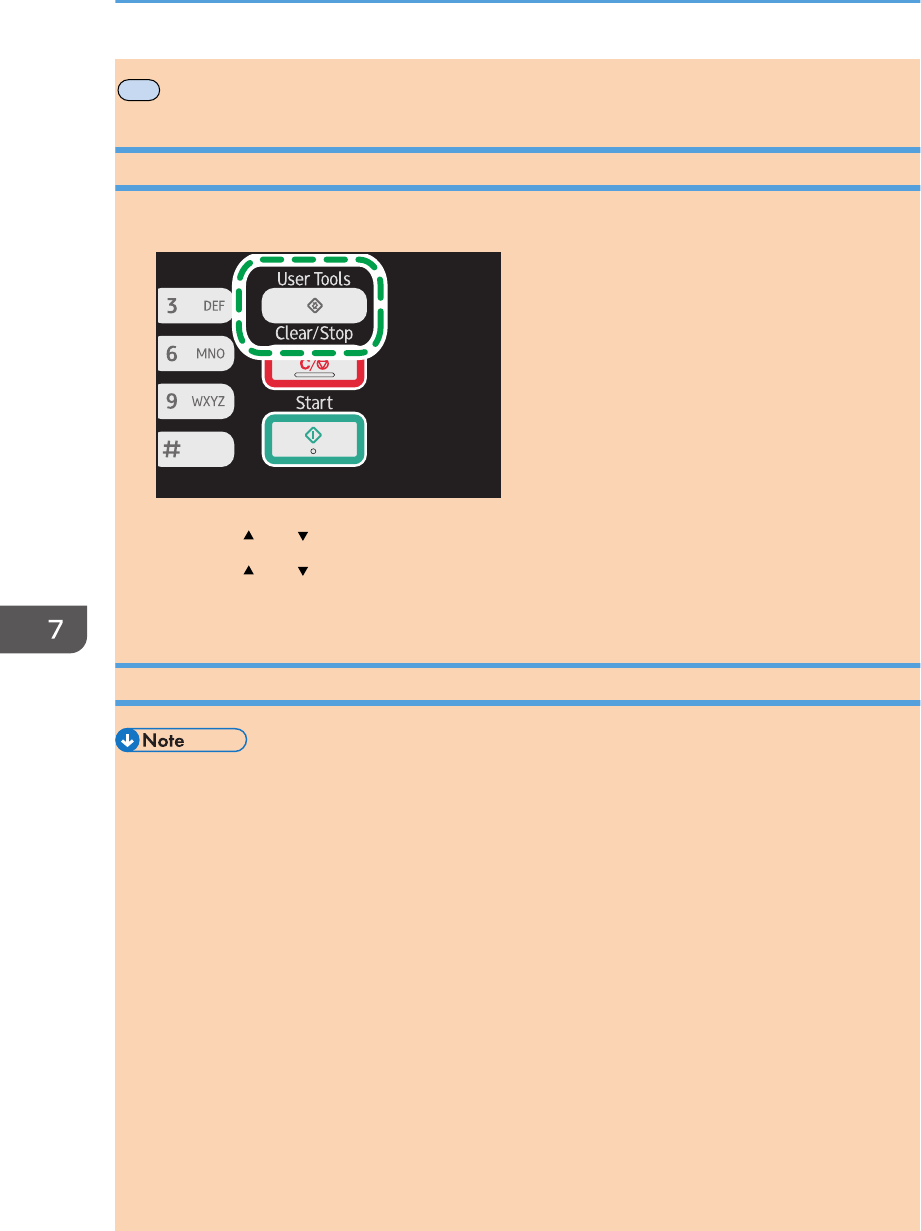
MF
Printing Lists/Reports
Printing the Configuration Page
1. Press the [User Tools] key.
DCT845
2. Press the [ ] or [ ] key to select [Print List/Report], and then press the [OK] key.
3. Press the [ ] or [ ] key to select [Configuration Page], and then press the [OK] key.
4. Press [Yes] in the confirmation screen.
Types of Lists/Reports
• Reports will be printed on A4 or Letter size paper. Load one of these sizes of paper into the tray
before printing reports.
Configuration Page
Prints general information and the current configurations of the machine.
You can check the firmware version on the configuration page.
By updating the firmware, you can correct problems as well as adding a number of new functions.
For details about updating the firmware, see the Firmware Update Guide.
The Firmware Update Guide can be downloaded from our Web site.
Fax Journal
Prints a fax transmission and reception journal for the last 50 jobs.
TX/RX Standby File List
Prints a list of fax jobs remaining in the machine's memory to be printed, sent, or forwarded.
Quick Dial Dest. List
Prints a list of scan and fax Quick Dial entries.
7. Configuring the Machine Using the Control Panel
150 opal-p2_mf2_com_user_guide_00142126_eng.xml
Draft 2014/01/07

Fax Speed Dial Dest. List
Prints a list of Speed Dial entries.
• Sort by Speed Dial No.
Prints the list with the entries sorted by Speed Dial registration number.
• Sort by Name
Prints the list with the entries sorted by name.
Scanner Dest. List
Prints a list of scan destinations.
Scanner Journal
Prints a scanner journal for the last 100 Scan to E-mail, Scan to FTP, and Scan to Folder
transmissions.
Maintenance Page
Prints the maintenance page.
Test Page
Checks the results of print position adjustment.
This setting is only available with Type 1 and 3 models.
This setting is only available with Type 1, 3, and 5 models.
Printing Lists/Reports
opal-p2_mf2_com_user_guide_00142126_eng.xml 151
Draft 2014/01/07
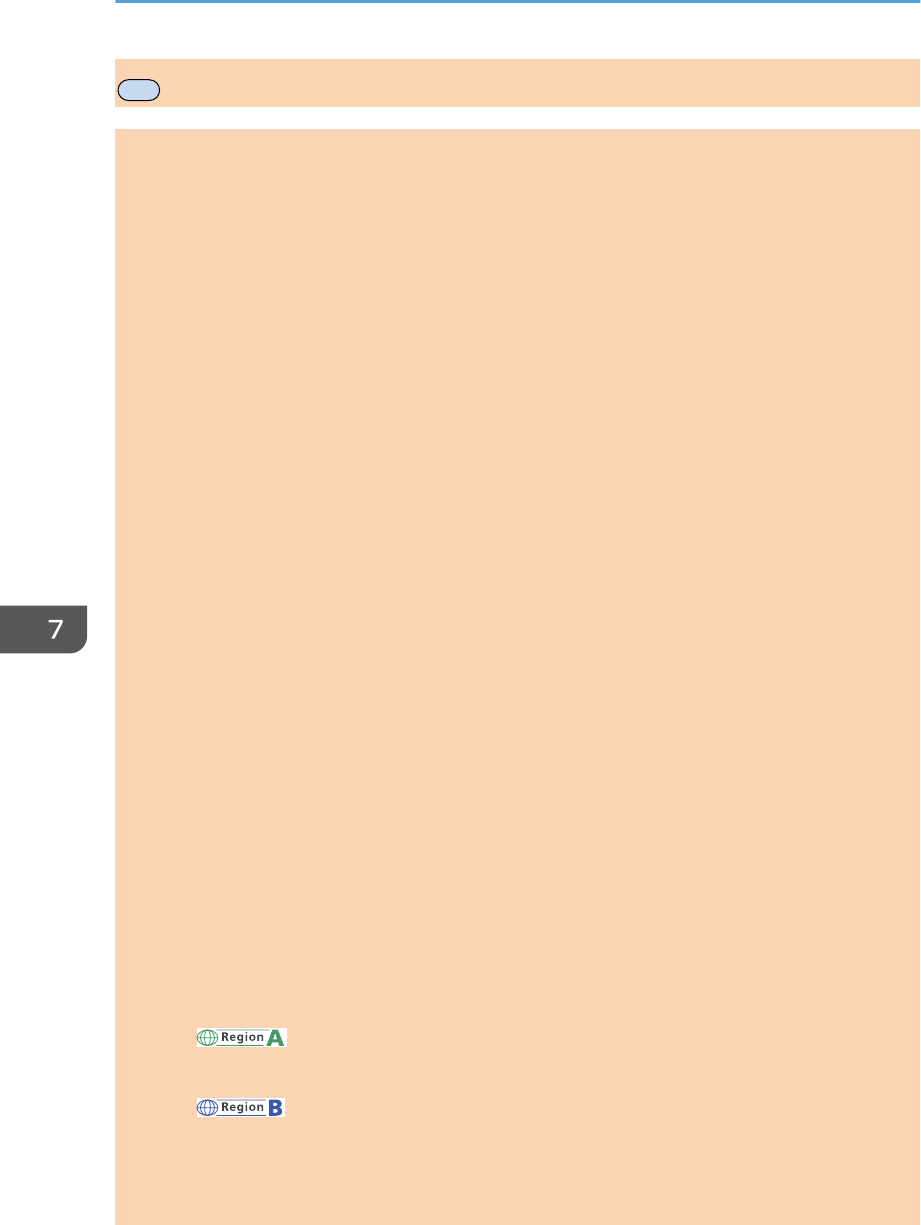
MF
Printer Features Settings
List/Test Print
Prints lists showing configurations on the machine.
• Config. Page
Prints general information and the current configurations of the machine.
• Menu List
Prints the machine's function menus.
• Test Page
Prints a test page for checking the single-sided printing condition. The test page contains
network settings.
• PCL Font List
Prints installed PCL font list.
System
• Copies
Sets the machine to print the specified number of sets.
This setting is disabled if the number of pages to print is specified by the printer driver.
Default: 1
• 1 to 999
• Sub Paper Size
Sets the machine to print onto paper of another size if the specified paper is not loaded in any
tray. Alternative sizes are preset to A4 and Letter.
Default: [Auto]
• Auto
• Off
• Default Page Size
Specifies the paper size to be used when the paper size is not specified in the print job.
Default:
(mainly Europe and Asia)
[A4]
(mainly North America)
[8 1/2 × 11]
• A4, B5 JIS, A5, B6 JIS, A6, 8 1/2 × 14, 8 1/2 × 11, 5 1/2 × 8 1/2,
7 1/4 × 10 1/2, 16K (197 × 273), 16K (195 × 270), 16K (184 × 260)
7. Configuring the Machine Using the Control Panel
152 opal-p2_mf2_com_user_guide_00142127_eng.xml
Draft 2014/01/07
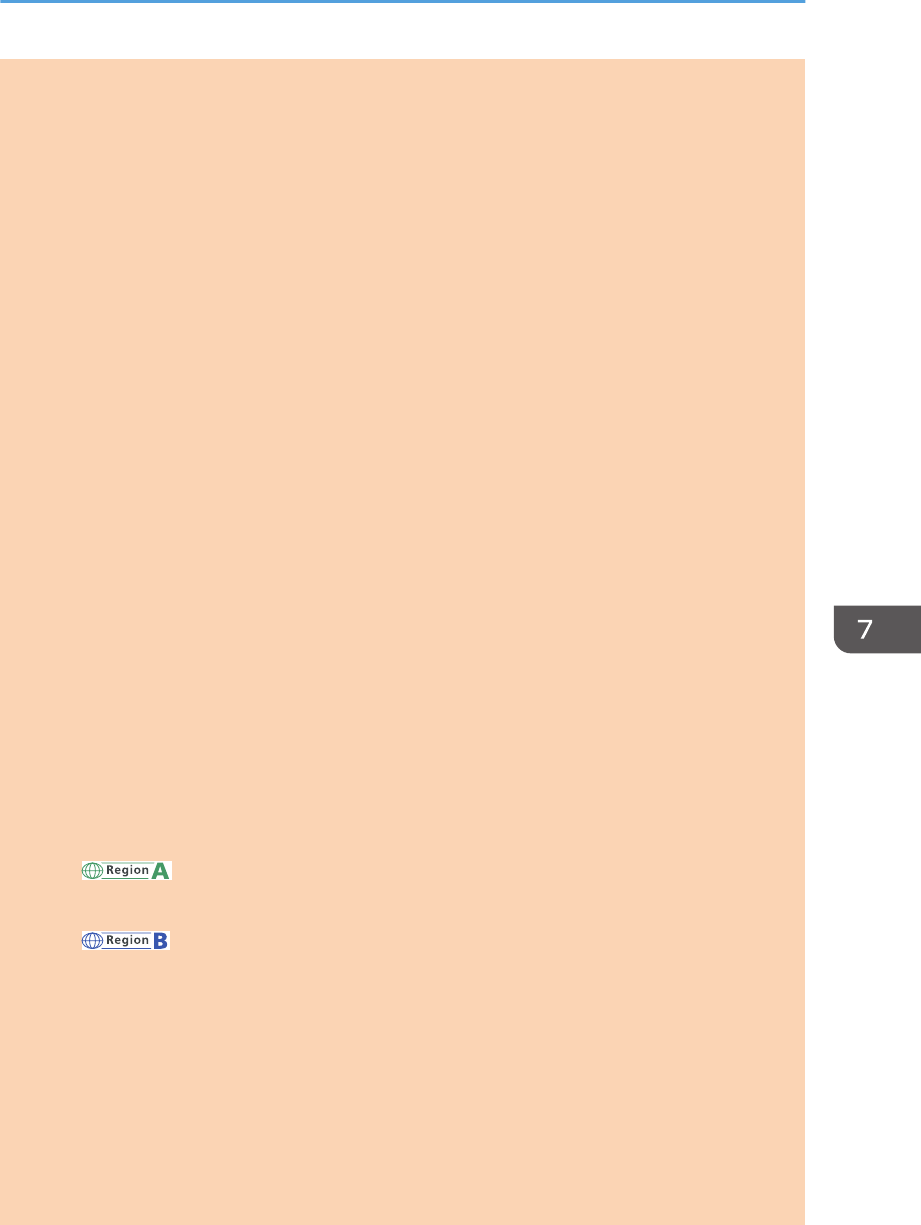
• Blank Page Print
Sets the machine to print blank pages.
When cover sheet printing is enabled from the printer driver, cover sheets are inserted even if
you select [Off].
Note that this setting has lower priority than the printer driver's blank page setting.
Default: [On]
• On
• Off
• Print Error Report
Sets the machine to print an error page when the machine detects a printer or memory error.
Default: [Off]
• On
• Off
PCL Menu
Specifies conditions when using PCL for printing.
• Orientation
Specifies the page orientation.
Default: [Portrait]
• Portrait
• Landscape
• Form Lines
Specifies the number of lines per page between 5 and 128.
Default:
(mainly Europe and Asia)
[64]
(mainly North America)
[60]
• Font Number
Specifies the ID of the default font you want to use between 0 and 89.
Default: 0
• Point Size
Specifies the point size you want to use for the default font between 4.00 and 999.75 in 0.25
increments.
Default: 12.00 points
Printer Features Settings
opal-p2_mf2_com_user_guide_00142127_eng.xml 153
Draft 2014/01/07

• Font Pitch
Specifies the number of characters per inch you want to use for the default font between 0.44
and 99.99 in 0.01 increments.
This setting is effective only for fixed-space fonts.
Default: 10.00 pitch
• Symbol Set
Specifies the character set for the default font. The following sets are available:
Default: [PC-8]
• Roman-8, Roman-9, ISO L1, ISO L2, ISO L5, PC-8, PC-8 D/N, PC-850, PC-852,
PC-858, PC8-TK, Win L1, Win L2, Win L5, Desktop, PS Text, VN Intl, VN US, MS Publ,
Math-8, PS Math, VN Math, Pifont, Legal, ISO 4, ISO 6, ISO 11, ISO 15, ISO 17, ISO
21, ISO 60, ISO 69, Win 3.0, MC Text, ISO L6, ISO L9, PC-775, PC-1004, Win
Baltic
• Courier Font
Specifies a courier-type font.
Default: [Regular]
• Regular
• Dark
• Ext. A4 Width
Sets the machine to extend the width of the printable area of A4 size paper, reducing side
margin width.
Default: [Off]
• On
• Off
• Append CR to LF
Sets the machine to append a CR code to each LF code to print text data clearly.
Default: [Off]
• On
• Off
• Resolution
Specifies the print resolution in dots per inch.
Default: [600 × 600 dpi]
7. Configuring the Machine Using the Control Panel
154 opal-p2_mf2_com_user_guide_00142127_eng.xml
Draft 2014/01/07
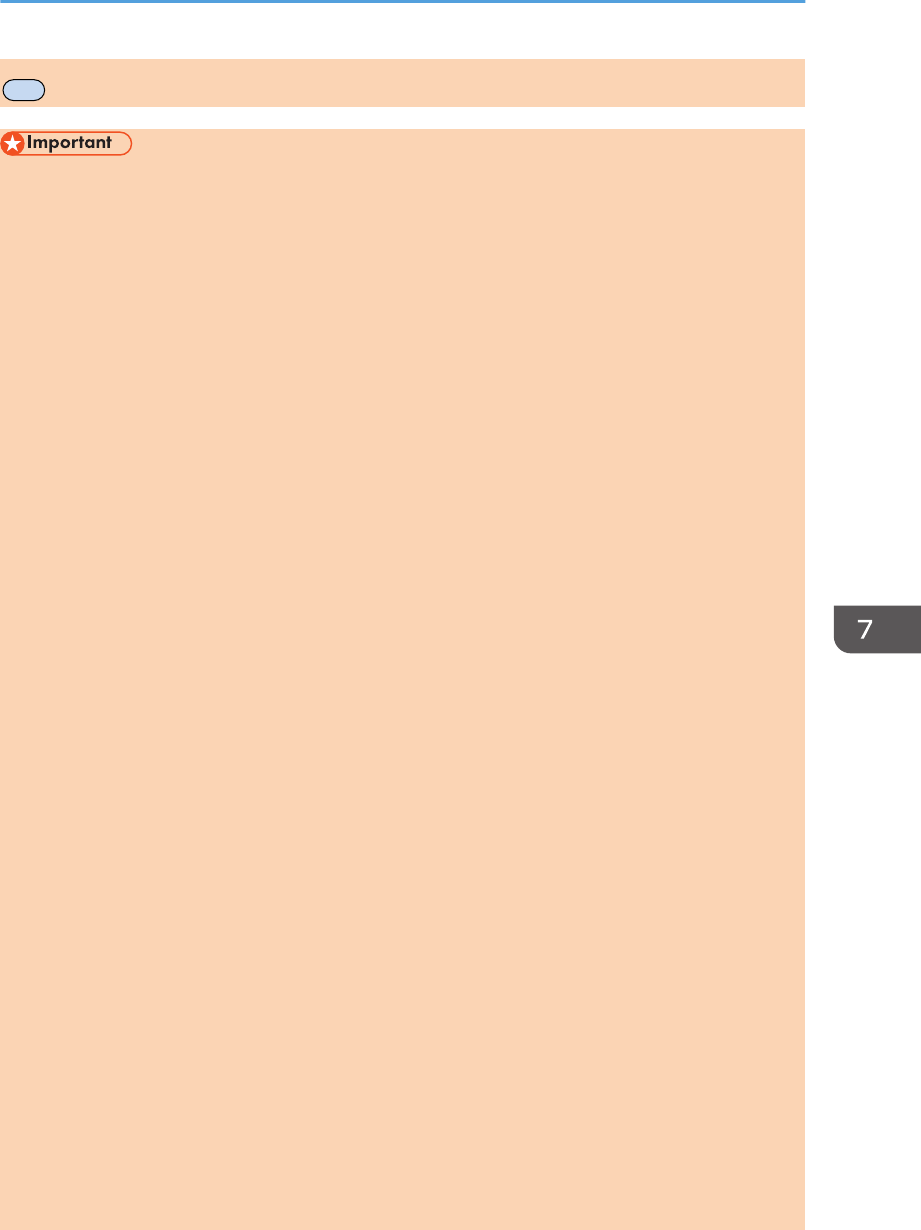
MF
Network Settings
• Depending on the settings you change, the machine might need to be restarted.
Ethernet
• MAC Address
Displays the machine's MAC address.
• Ethernet Speed
Displays the current Ethernet speed setting.
• 100Mbps Full Duplex
• 100Mbps Half Duplex
• 10Mbps Full Duplex
• 10Mbps Half Duplex
• Ethernet Unavailable
Appears when a network cable is not connected.
• Set Ethernet Speed
Specifies the speed for Ethernet communication. Select a speed that matches your network
environment.
For most networks, the default setting is the optimum setting.
Default: [Auto Select]
• Auto Select
• 100Mbps Full Duplex
• 100Mbps Half Duplex
• 10Mbps Full Duplex
• 10Mbps Half Duplex
Wi-Fi
• Wi-Fi Enable
Select whether to enable or disable Wireless LAN.
Default: [Enable]
• Disable
• Enable
If [Disable] is set, [Wi-Fi/LAN Key], [Wi-Fi Status], [MAC Address], [Current Connection],
and [Setup Wizard] are not displayed.
• Wi-Fi/LAN Key
Network Settings
opal-p2_mf2_com_user_guide_00142128_eng.xml 155
Draft 2014/01/07

Select the mode that appears if the [WIFI/LAN] key is pressed.
Default: [Infrastructure Mode]
• Infrastructure Mode
• Ad-Hoc Mode
• Wi-Fi Status
Displays the current connection status.
• MAC Address
Displays the machine's MAC address.
• Current Connection
Displays detailed information about the connection, such as the SSID and the wireless signal
strength.
• Setup Wizard
Displays the procedure for manually connecting to a wireless LAN. It leads you step-by-step
through configuring the settings for connecting with a wireless LAN.
IPv4 Configuration
• DHCP
Sets the machine to receive its IPv4 address, subnet mask, and default gateway address
automatically from a DHCP server.
Default: [Active]
• Inactive
• Active
• IP Address
Specifies the machine's IPv4 address when DHCP is not used.
Use this menu to check the current IP address when DHCP is used.
Default: XXX.XXX.XXX.XXX
The numbers represented by "X" vary according to your network environment.
• Subnet Mask
Specifies the machine's subnet mask when DHCP is not used.
Use this menu to check the current subnet mask when DHCP is used.
Default: XXX.XXX.XXX.XXX
The numbers represented by "X" vary according to your network environment.
• Gateway Address
Specifies the machine's default gateway address when DHCP is not used.
Use this menu to check the current default gateway address when DHCP is used.
7. Configuring the Machine Using the Control Panel
156 opal-p2_mf2_com_user_guide_00142128_eng.xml
Draft 2014/01/07

Default: XXX.XXX.XXX.XXX
The numbers represented by "X" vary according to your network environment.
• IP Address Method
Displays the IP address acquisition method.
• IP Not Ready
• DHCP
• Manual Config.
• Default IP
IPv6 Configuration
• IPv6
Select whether to enable or disable IPv6.
Default: [Inactive]
• Active
• Inactive
• DHCP
Sets the machine to receive its IPv6 address from a DHCP server.
Default: [Active]
• Active
• Inactive
• IP Address (DHCP)
Displays the IPv6 address obtained from a DHCP server.
• Manual Config. Address
• Manual Config. Address
Specifies the machine's IPv6 address when DHCP is not used. Can contain up to 39
characters.
For details about entering characters, see page 103 "Entering Characters".
• Prefix Length
Specifies the prefix length, using a value between 0 and 128.
• Gateway Address
Specifies the IPv6 address of the default gateway. Can contain up to 39 characters.
For details about entering characters, see page 103 "Entering Characters".
• Stateless Address
Displays the IPv6 stateless addresses obtained from a Router Advertisement.
Network Settings
opal-p2_mf2_com_user_guide_00142128_eng.xml 157
Draft 2014/01/07
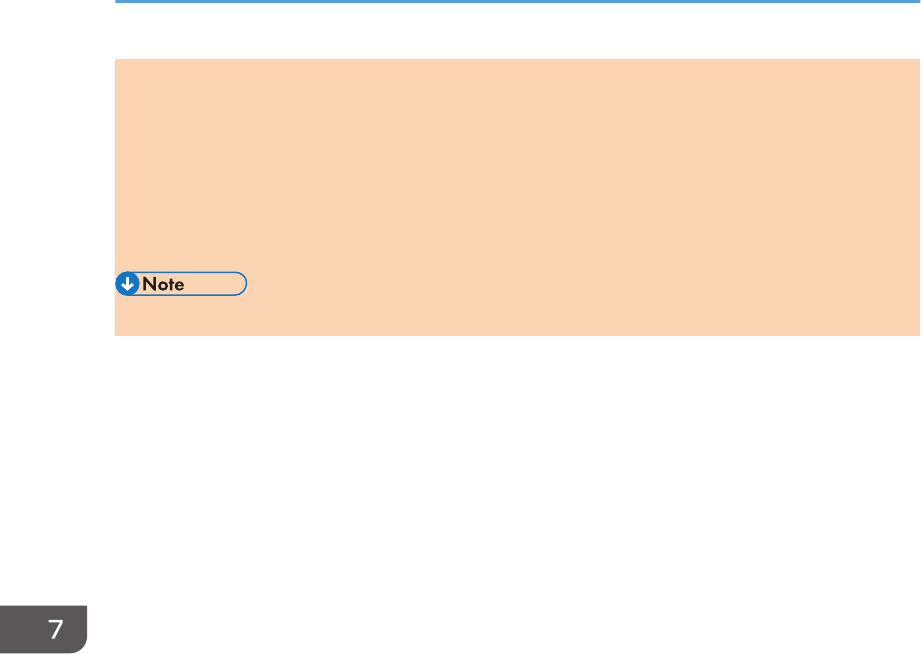
• Stateless Address 1
• Stateless Address 2
• Stateless Address 3
• Stateless Address 4
• Link-local Address
Displays the IPv6 link local address.
• Contact your network administrator for information about the network configuration.
7. Configuring the Machine Using the Control Panel
158 opal-p2_mf2_com_user_guide_00142128_eng.xml
Draft 2014/01/07
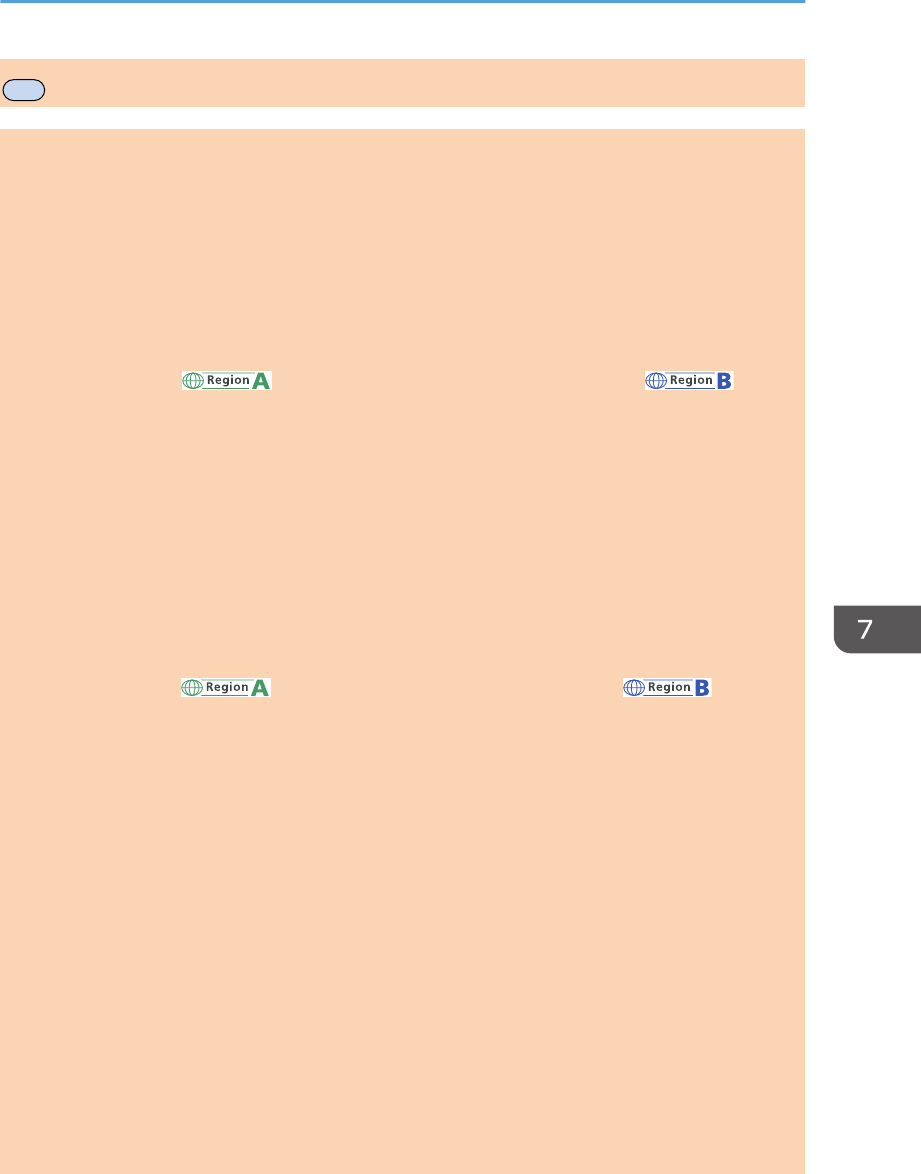
MF
Administrator Settings
Set Date/Time
Sets the date and time of the machine’s internal clock.
• Set Date
Specifies the date of the machine’s internal clock.
Only dates that correspond with the year and month can be set. Incompatible dates will be
refused.
Default
Date format: (mainly Europe and Asia) [Day/Month/Year], (mainly
North America) [Year/Month/Day]
• Date format: Month/Day/Year, Day/Month/Year, or Year/Month/Day
Year: 2000 to 2099
Month: 1 to 12
Day: 1 to 31
• Set Time
Sets the time of the machine's internal clock.
Default
Time format: (mainly Europe and Asia) [24-hour Format], (mainly
North America) [12-hour Format]
• Time format: 12-hour Format, 24-hour Format
AM/PM stamp: AM, PM (for 12-hour Format)
Hour: 0 to 23 (for 24-hour Format), or 1 to 12 (for 12-hour Format)
Minute: 0 to 59
Program Fax Information
Specifies the fax name and fax number of the machine.
• Number:
Specifies the fax number of the machine using up to 20 characters, including 0 to 9, space,
and "+".
• Name:
Specifies the fax name of the machine using up to 20 alphanumeric characters and symbols.
Dial/Push Phone
Specifies the line type of the telephone line.
Administrator Settings
opal-p2_mf2_com_user_guide_00142129_eng.xml 159
Draft 2014/01/07

To configure this setting, contact your telephone company and select the setting based on your
telephone line. Selecting a wrong setting may cause failures in fax transmissions.
[Dial Phone (20PPS)] may not appear depending on the country setting of the machine.
Default: [Push Phone]
• Push Phone
• Dial Phone (10PPS)
• Dial Phone (20PPS)
PSTN / PBX
Sets the machine to connect to the public switched telephone network (PSTN) or a private branch
exchange (PBX).
Default: [PSTN]
• PSTN
• PBX
PBX Access Number
Specifies the dial number to access the outside line when the machine is connected to a PBX.
Make sure that this setting matches the setting of your PBX. Otherwise, you may not be able to send
faxes to outside destinations.
Default: 9
• 0 to 999
Function Priority
Specifies the mode that is activated when the power is turned on, or if the time specified for [System
Auto Reset Timer] elapses without activity while the initial screen of the current mode is displayed.
Default: [Copier]
• Copier
• Facsimile
• Scanner
System Auto Reset Timer
Sets the machine to return to the mode specified in [Function Priority].
This setting is also applied to the timeout for copying the next document while ID card copy.
Default: [On] (30 sec.)
• On (30 sec., 1 min., 2 min., 3 min., 5 min., 10 min.)
• Off
7. Configuring the Machine Using the Control Panel
160 opal-p2_mf2_com_user_guide_00142129_eng.xml
Draft 2014/01/07

Energy Saver Mode
Sets the machine to enter Energy Saver mode, Energy Saver mode 1 or Energy Saver mode 2, to
reduce power consumption. The machine recovers from Energy Saver mode when it receives a
print job, prints a received fax, or when [Copy] or [Start] key is pressed.
• EnergySaverMode 1
The machine enters Energy Saver mode 1 if the machine has been idle for about 30 seconds.
It takes less time to recover from Energy Saver mode 1 than from power-off state or Energy
Saver mode 2, but power consumption is higher in Energy Saver mode 1 than in Energy
Saver mode 2.
Default: [Off]
• Off
• On (30 seconds)
• EnergySaverMode 2
The machine enters Energy Saver mode 2 after the period of time specified for this setting is
passed. The machine consumes less power in Energy Saver mode 2 than in Energy Saver
mode 1, but it takes longer to recover from Energy Saver mode 2 than from Energy Saver
mode 1.
• Europe
Default: [1 minute]
The time can be set from 1 to 30 minutes.
• Countries other than European countries
Default: [On] (1 minute)
• On (1 to 240 minutes, in 1 minute increments)
• Off
Language
Specifies the language used on the screen and in reports.
Area (Europe only)
By selecting the area in which the machine is being used, you can narrow down the choice of
display language and other settings.
You can also specify this setting during the initial setup after turning the power on for the first time.
Default: [Europe]
• Europe
• Asia
• Oceania
• Americas
Administrator Settings
opal-p2_mf2_com_user_guide_00142129_eng.xml 161
Draft 2014/01/07

• Africa
Country
Selects the country in which the machine is used. The country you specify determines the time and
date display format and the default values of the fax transmission-related settings.
Make sure to select the country code correctly. Selecting a wrong country may cause failures in fax
transmissions.
The default value for this setting is the country code you have specified during the Initial Setup,
which is required after turning on the machine for the first time.
Reset Settings
Be sure not to clear the settings by mistake.
• Reset All Settings
Resets the machine's settings to their defaults except the following: language for the screen,
country setting, network settings, and fax Quick Dial/Speed Dial destinations.
Press [Yes] to execute. Press [No] to exit to the previous level of the menu tree without clearing
the settings.
• Reset Network Settings
Resets the network settings to their defaults.
Press [Yes] to execute. Press [No] to exit to the previous level of the menu tree without clearing
the settings.
• Clear Address Book
Clears the fax Quick Dial/Speed Dial destinations.
Press [Yes] to execute. Press [No] to exit to the previous level of the menu tree without clearing
the destinations.
Shortcut to Function
Assigns one of the following functions to the [Shortcut to Func.] key on the control panel.
Default: [ID Card Copy Mode]
• ID Card Copy Mode
Press the key to switch to the ID card copy mode.
• Fax Immediate TX
Press the key to switch to the [Immediate TX] menu.
• Select Scanner Dest.
Press the key to switch to the scanner destination selection menu.
Admin. Tools Lock
Specifies a four-digit password for accessing the [Address Book], [Network Settings], and [Admin.
Tools] menus.
7. Configuring the Machine Using the Control Panel
162 opal-p2_mf2_com_user_guide_00142129_eng.xml
Draft 2014/01/07

Do not forget this password.
• On (0000 to 9999)
• Off
IPsec
Selects whether to enable or disable IPsec.
This function appears only when a password is specified under [Admin. Tools Lock].
Default: [Inactive]
• Active
• Inactive
Fax Number Confirmation
Sets the machine to require a fax number to be entered twice when specifying a destination
manually.
When this function is enabled, you cannot use the On Hook Dial function.
This function appears only when a password is specified under [Admin. Tools Lock].
Default: [Off]
• On
• Off
Save Scn Data to USB
Specify whether to enable or disable Scan to USB.
This function appears only when a password is specified under [Admin. Tools Lock].
Default: [Active]
• Active
• Inactive
Administrator Settings
opal-p2_mf2_com_user_guide_00142129_eng.xml 163
Draft 2014/01/07

7. Configuring the Machine Using the Control Panel
164 opal-p2_mf2_com_user_guide_00142129_eng.xml
Draft 2014/01/07
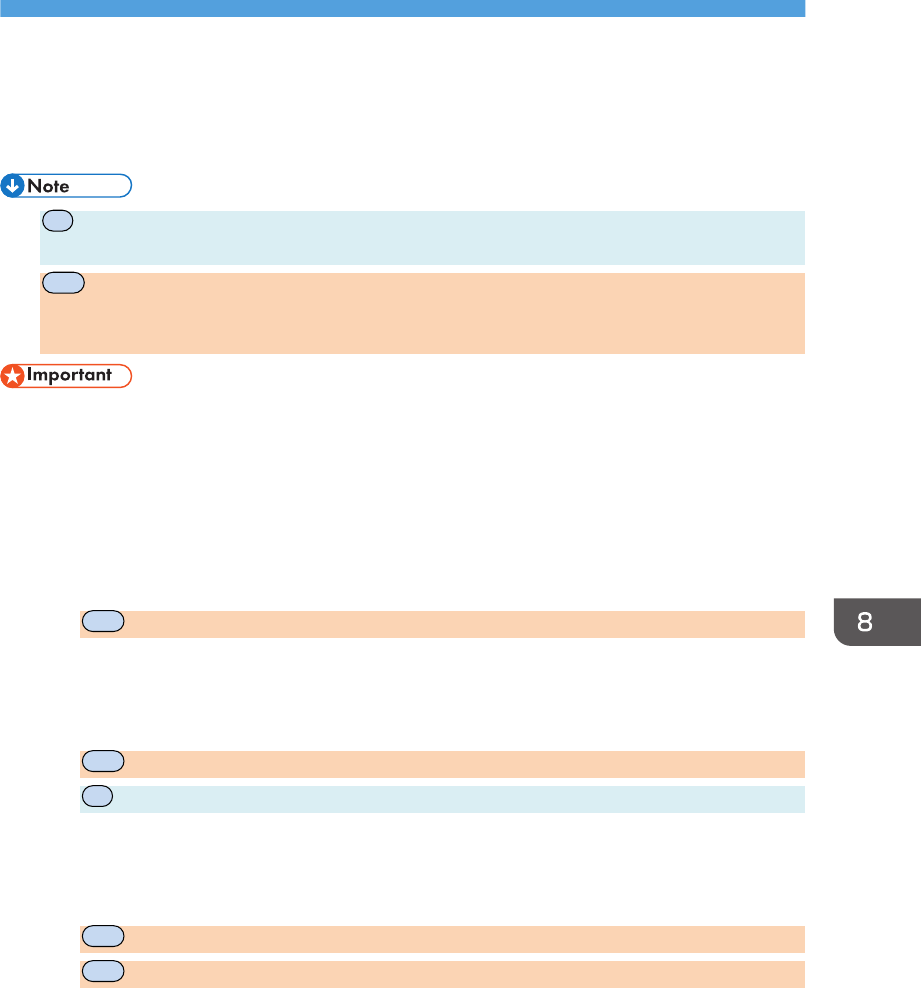
8. Configuring the Machine Using
Utilities
Using Web Image Monitor
•
P
To operate the machine via Web Image Monitor, you must first configure the machine's
TCP/IP or wireless LAN settings. For details, see page 179 "Configuring the Network Settings".
•
MF
To operate the machine via Web Image Monitor, you must first configure the machine's
TCP/IP or wireless LAN settings. For details, see page 155 "Network Settings" or see page 179
"Configuring the Network Settings".
• Some items might not appear, depending on the model type you are using.
• Some items can also be configured using the control panel.
Available operations
The following operations can be performed remotely using Web Image Monitor on a computer:
• Displaying the machine’s status or settings
• Configuring the machine's settings
•
MF
Registering the scan and fax destinations
• Configuring the network settings
• Configuring the IPsec settings
• Printing reports
•
MF
Setting the administrator password and e-mail address
•
P
Setting the administrator password
• Resetting the machine's configuration to the factory default
• Creating backup files of the machine's configuration
• Restoring the machine's configuration from backup files
•
MF
Configuring the machine's date and time
•
MF
Configuring the machine's Energy Saver mode setting
Supported Web browsers
• Internet Explorer 6 – 11
• Firefox 3.0 – 23
opal-p2_mf2_com_user_guide_00142131_eng.xml 165
Draft 2014/01/07
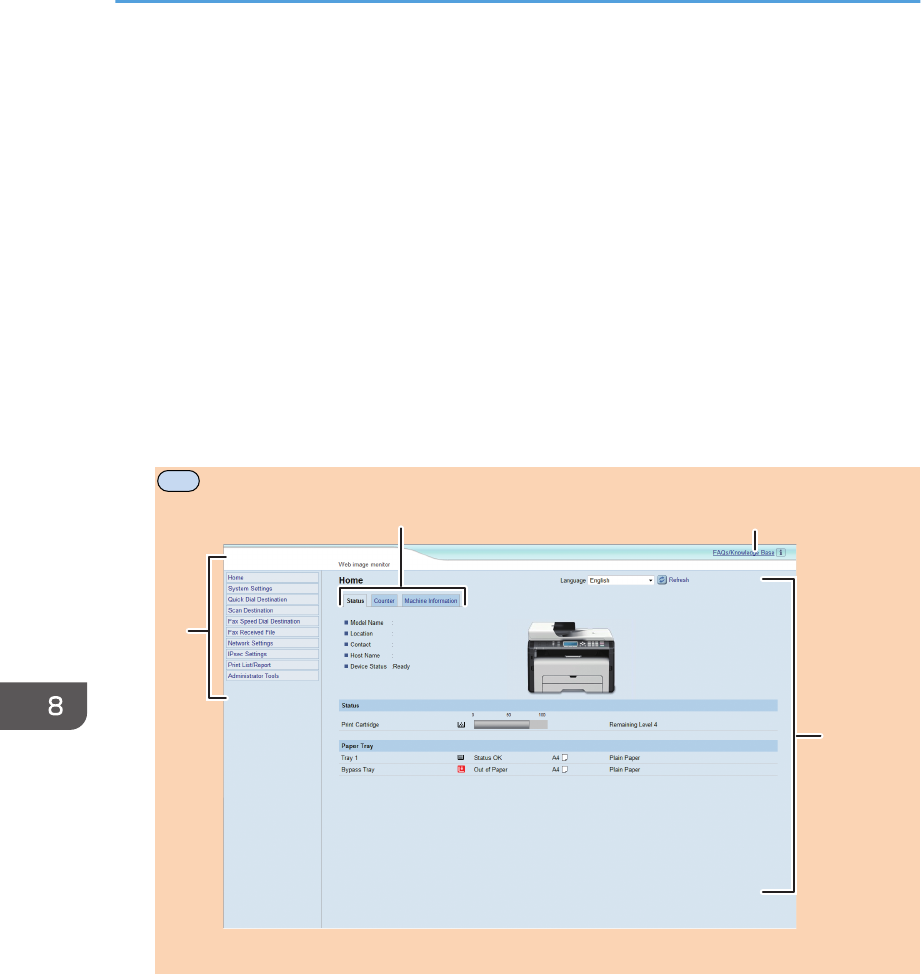
Displaying Top Page
When you access the machine using Web Image Monitor, the top page appears in your browser's
window.
1. Launch the Web browser.
2. In the Web browser's address bar, enter "http://(machine’s IP address)/" to access the
machine.
If a DNS or WINS server is used and the machine’s host name has been specified, you can enter
the host name instead of the IP address.
The top page of Web Image Monitor appears.
Top page
Every Web Image Monitor page is divided into the following areas:
MF
DCT841
1
2 3
4
8. Configuring the Machine Using Utilities
166 opal-p2_mf2_com_user_guide_00142132_eng.xml
Draft 2014/01/07
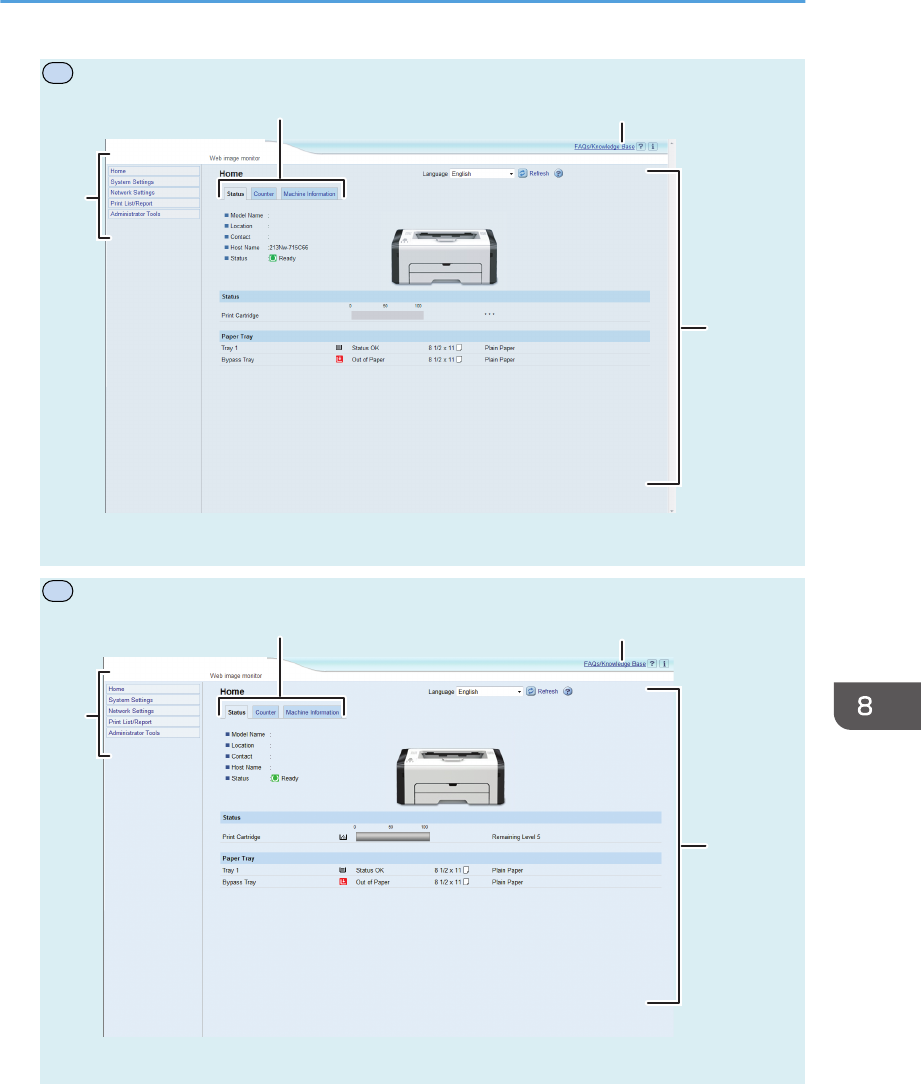
P
DCT856
1
2 3
4
P
DCT880
1
2 3
4
1. Menu area
Clicking a menu shows its contents in the main area.
2. Tab area
Contains tabs for switching between information and settings you want to see or configure.
Displaying Top Page
opal-p2_mf2_com_user_guide_00142132_eng.xml 167
Draft 2014/01/07
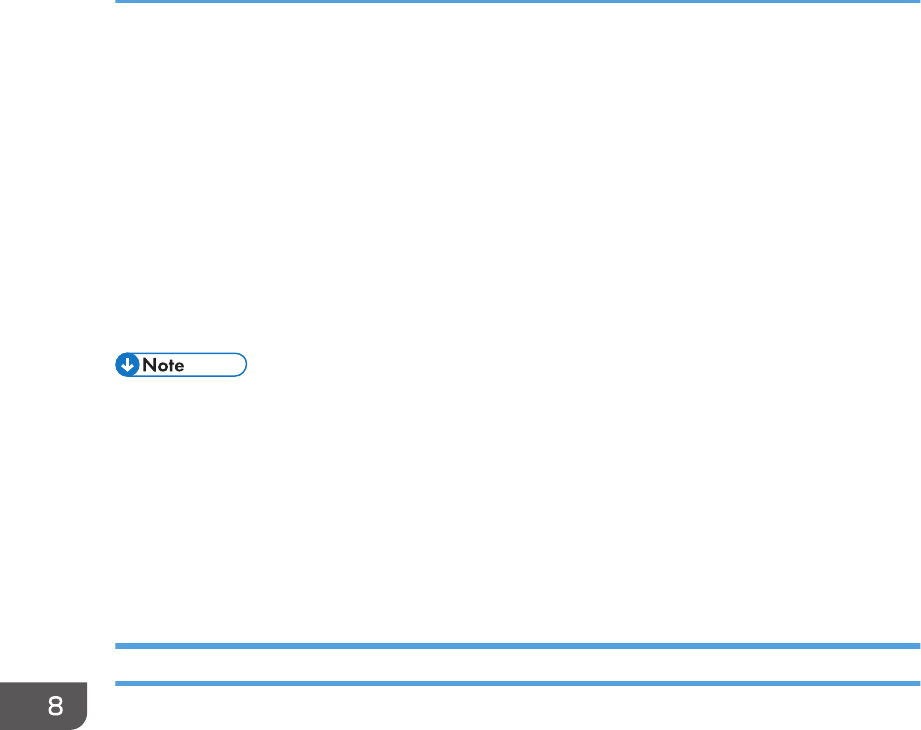
3. FAQs/Knowledge Base
Provides answers to frequently asked questions and other useful information about using this
machine.
An internet connection is required to view this information.
4. Main area
Displays the contents of the item selected in the menu area.
Information in the main area is not automatically updated. Click [Refresh] at the upper-right in
the main area to update the information. Click the Web browser's [Refresh] button to refresh
the entire browser screen.
• If you use an older version of a supported Web browser or the Web browser has JavaScript and
cookies disabled, display and operation problems may occur.
• If you are using a proxy server, configure the Web browser settings as necessary. For details about
the settings, contact your network administrator.
• The previous page may not appear even if the back button of the Web browser is clicked. If this
happens, click the refresh button of the Web browser.
• The FAQs (Frequently Asked Questions)/Knowledge Base are not available in certain languages.
Changing the Interface Language
Select the desired interface language from the [Language] list.
8. Configuring the Machine Using Utilities
168 opal-p2_mf2_com_user_guide_00142132_eng.xml
Draft 2014/01/07
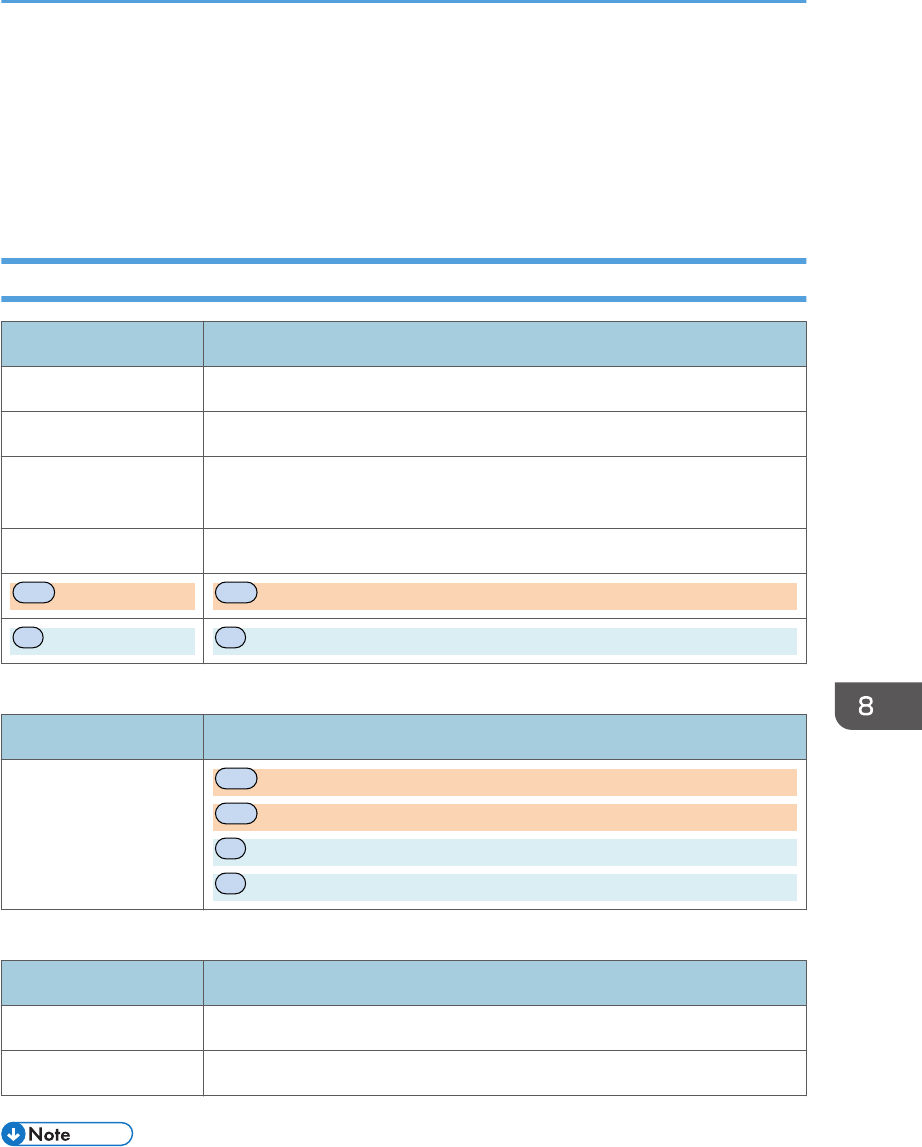
Checking the System Information
Click [Home] to display the main page of Web Image Monitor. You can check the current system
information on this page.
This page contains three tabs: [Status], [Counter], and [Machine Information].
Status Tab
Item Description
Model Name Shows the name of the machine.
Location Shows the location of the machine as registered on the [SNMP] page.
Contact Shows the contact information of the machine as registered on the [SNMP]
page.
Host Name Shows the host name specified in [Host Name] on the [DNS] page.
MF
Device Status
MF
Shows the current messages on the machine's display.
P
Status
P
Shows the current messages on the machine's display.
Status
Item Description
Print Cartridge
MF
Displays the remaining toner level.
MF
Toner levels are not displayed for Type 1 and 2 models.
P
Toner level status may not be displayed.
P
Displays the remaining toner level.
Paper Tray
Item Description
Tray 1 Shows the current state and paper size/type setting of Tray 1.
Bypass Tray Shows the current state and paper size/type setting of the bypass tray.
• If a non-genuine print cartridge is installed, toner life cannot be reliably indicated.
Checking the System Information
opal-p2_mf2_com_user_guide_00142133_eng.xml 169
Draft 2014/01/07
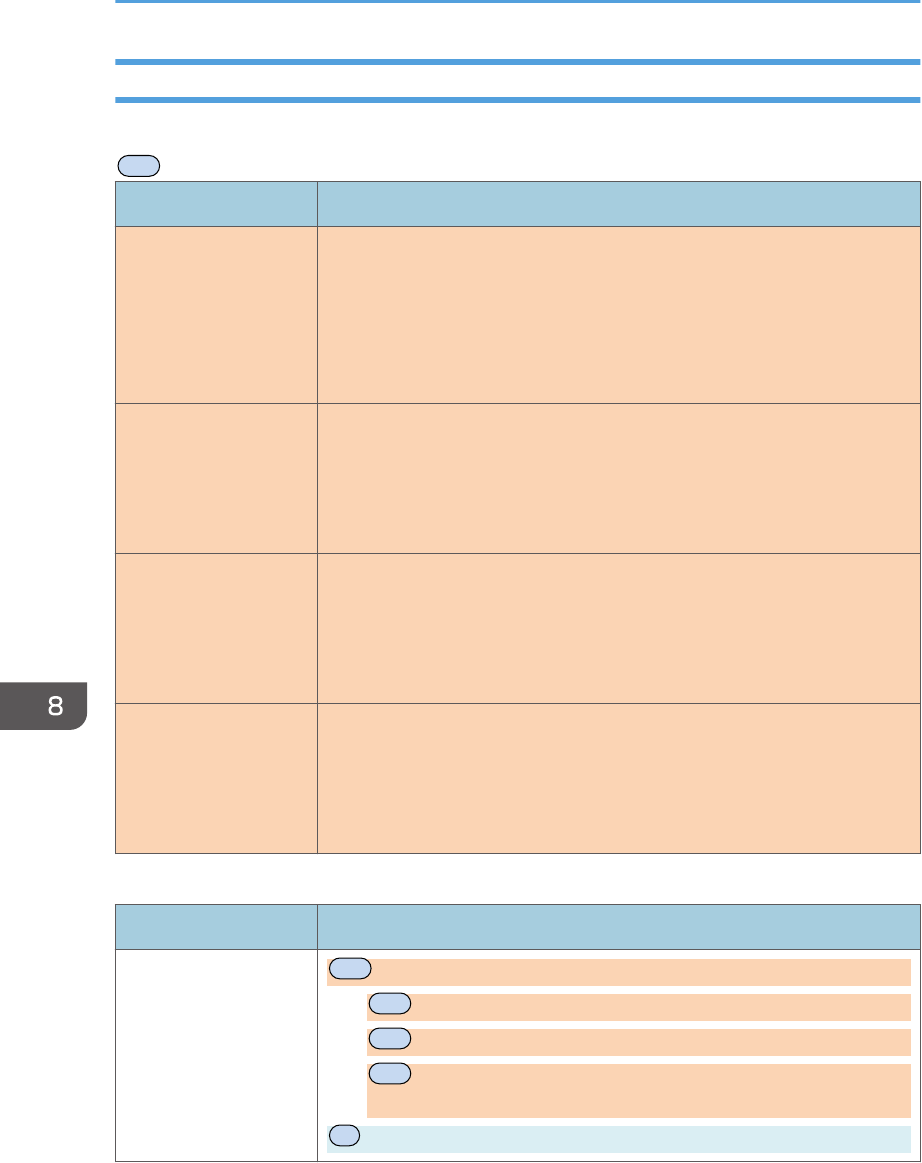
Counter Tab
Page Counter
MF
Item Description
Printer Shows the following for pages printed using the printer function:
• Total number of pages printed using the printer function, and lists/
reports printed from the [List/Test Print] menu under [Printer Features]
• Number of color pages (always shows 0)
• Number of black-and-white pages printed using the printer function
Scanner Shows the following for pages scanned using the scanner function:
• Total number of pages
• Number of color pages
• Number of black-and-white pages
Copier Shows the following for pages printed using the copier function:
• Total number of pages
• Number of color pages (always shows 0)
• Number of black-and-white pages
Fax Shows the following for telephone line faxes:
• Total number of pages sent and received
• Number of pages sent
• Number of pages received
Print Counter
Item Description
Page Total
MF
Shows the total number of all prints from the machine:
•
MF
Pages printed using the printer, copy, and fax functions
•
MF
Lists/Reports printed from the [Print List/Report] menu
•
MF
Lists/Reports printed from the [List/Test Print] menu under
[Printer Features]
P
Displays the total number of pages printed.
8. Configuring the Machine Using Utilities
170 opal-p2_mf2_com_user_guide_00142133_eng.xml
Draft 2014/01/07
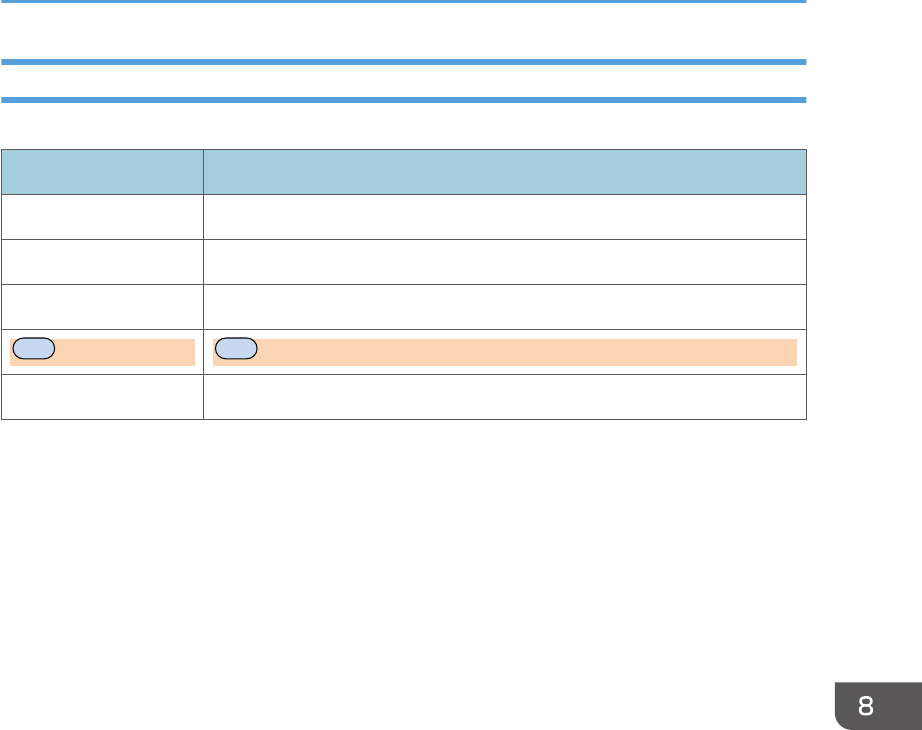
Machine Information Tab
Machine Information
Item Description
Firmware Version Shows the version of firmware installed on the machine.
Engine FW Version Shows the version of firmware for the machine engine.
Machine ID Shows the identification number of the machine.
MF
Fax Card
MF
Shows that a fax card is installed.
Total Memory Shows the total memory installed on the machine.
Checking the System Information
opal-p2_mf2_com_user_guide_00142133_eng.xml 171
Draft 2014/01/07
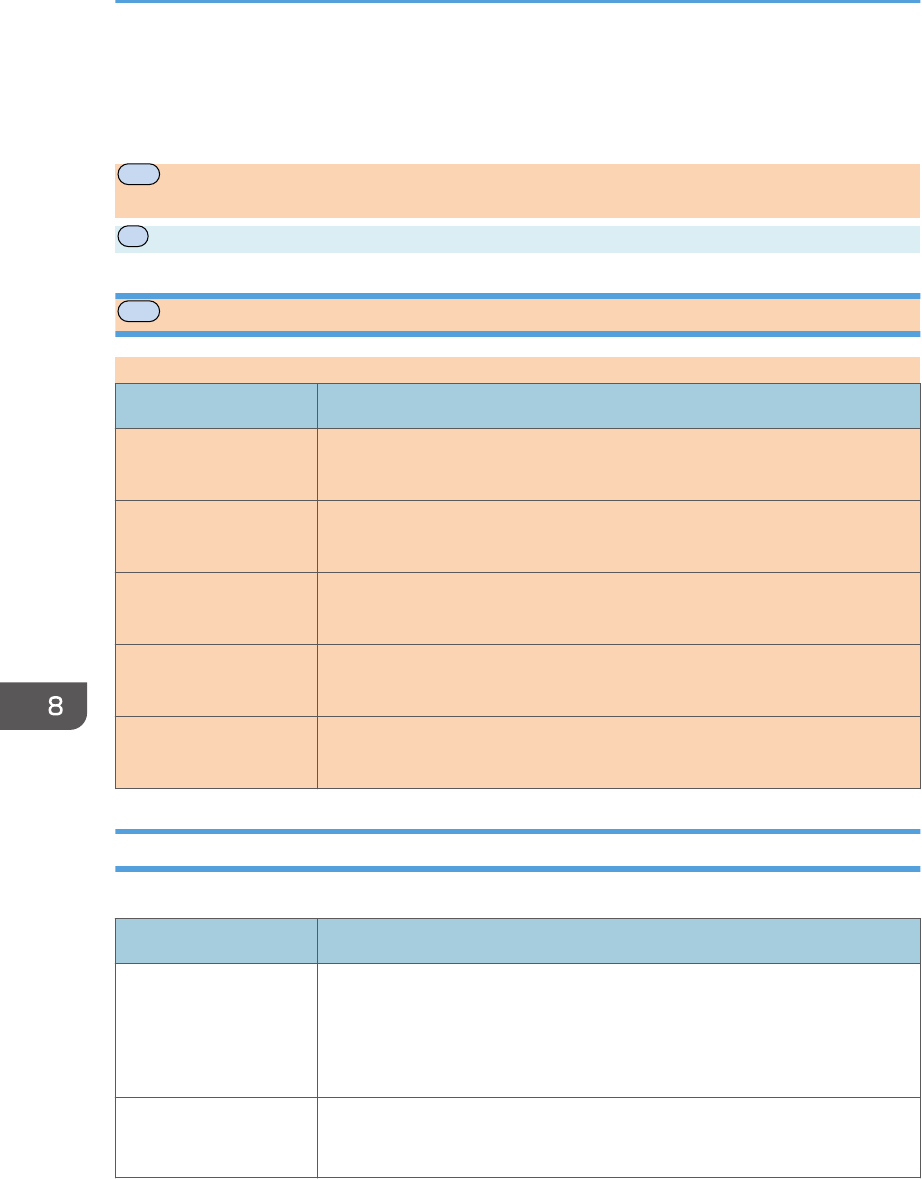
Configuring the System Settings
Click [System Settings] to display the page for configuring the system settings.
MF
This page contains the following tabs: [Sound Volume Adjustment], [Tray Paper Settings],
[Copier], [Fax], [Toner Management], [Interface] and [Shortcut to Function].
P
This page contains the following tabs: [Tray Paper Settings] and [Interface].
MF
Sound Volume Adjustment Tab
Sound Volume Adjustment
Item Description
Panel Key Sound Select the volume of the beep that sounds when a key is pressed from [Off],
[Low], [Middle], or [High].
On Hook Mode Select the volume of the sound from the speaker during on hook mode from
[Off], [Low], [Middle], or [High].
Job End Tone Select the volume of the beep that sounds when a job is complete from
[Off], [Low], [Middle], or [High].
Job Error Tone Select the volume of the beep that sounds when a fax transmission error
occurs from [Off], [Low], [Middle], or [High].
Alarm Volume Select the volume of the alarm that sounds when an operation error occurs
from [Off], [Low], [Middle], or [High].
Tray Paper Settings Tab
Tray 1
Item Description
Paper Size Select the paper size for Tray 1 from the following:
A4, B5 JIS, A5, B6 JIS, A6, 8 1/2 × 14, 8 1/2 × 11, 5 1/2 × 8 1/2, 7
1/4 × 10 1/2, 16K (197 × 273mm), 16K (195 × 270mm), 16K (184 ×
260mm), Custom Size
Paper Type Select the paper type for Tray 1 from the following:
Plain Paper, Recycled Paper, Thick Paper, Thin Paper
8. Configuring the Machine Using Utilities
172 opal-p2_mf2_com_user_guide_00142134_eng.xml
Draft 2014/01/07
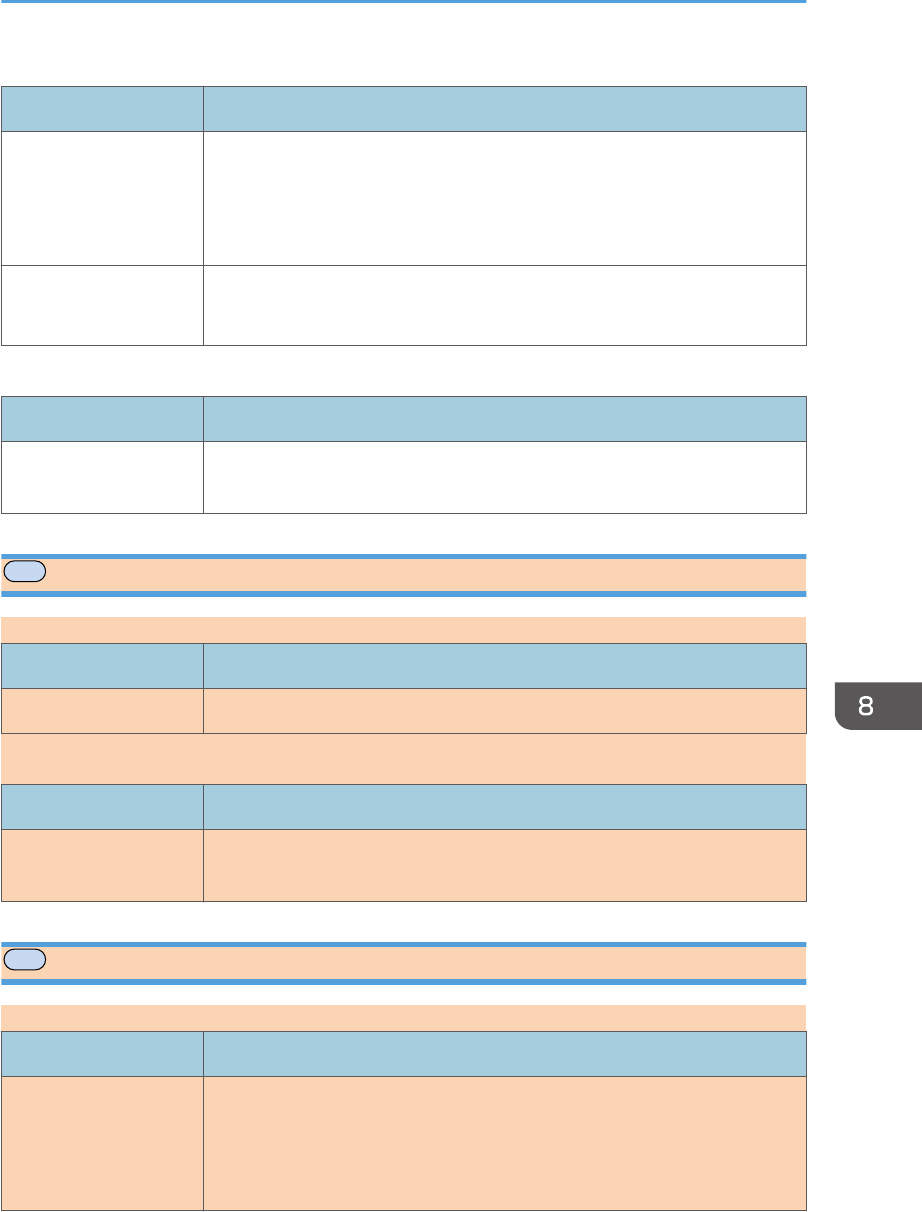
Bypass Tray
Item Description
Paper Size Select the paper size for the bypass tray from the following:
A4, B5 JIS, A5, B6 JIS, A6, 8 1/2 × 14, 8 1/2 × 11, 5 1/2 × 8 1/2, 7
1/4 × 10 1/2, 16K (197 × 273mm), 16K (195 × 270mm), 16K (184 ×
260mm), Custom Size
Paper Type Select the paper type for the bypass tray from the following:
Plain Paper, Recycled Paper, Thick Paper, Thin Paper
Size mismatch detection
Item Description
Size mismatch
detection
Select whether to set the machine to report an error if the paper size does
not match the print job's settings.
MF
Copier Tab
Select Paper
Item Description
Select Paper Select the paper tray used for copying.
Separation Line
Item Description
Separation Line Specify whether to print a line in the middle of the printed paper when
making ID card copy or combined copy.
MF
Fax Tab
Fax Number Confirmation
Item Description
Fax Number
Confirmation
Enable this setting to configure the machine to require a fax number to be
entered twice when specifying a destination manually.
This setting appears only when the administrator password is set in the
[Administrator] page.
Configuring the System Settings
opal-p2_mf2_com_user_guide_00142134_eng.xml 173
Draft 2014/01/07
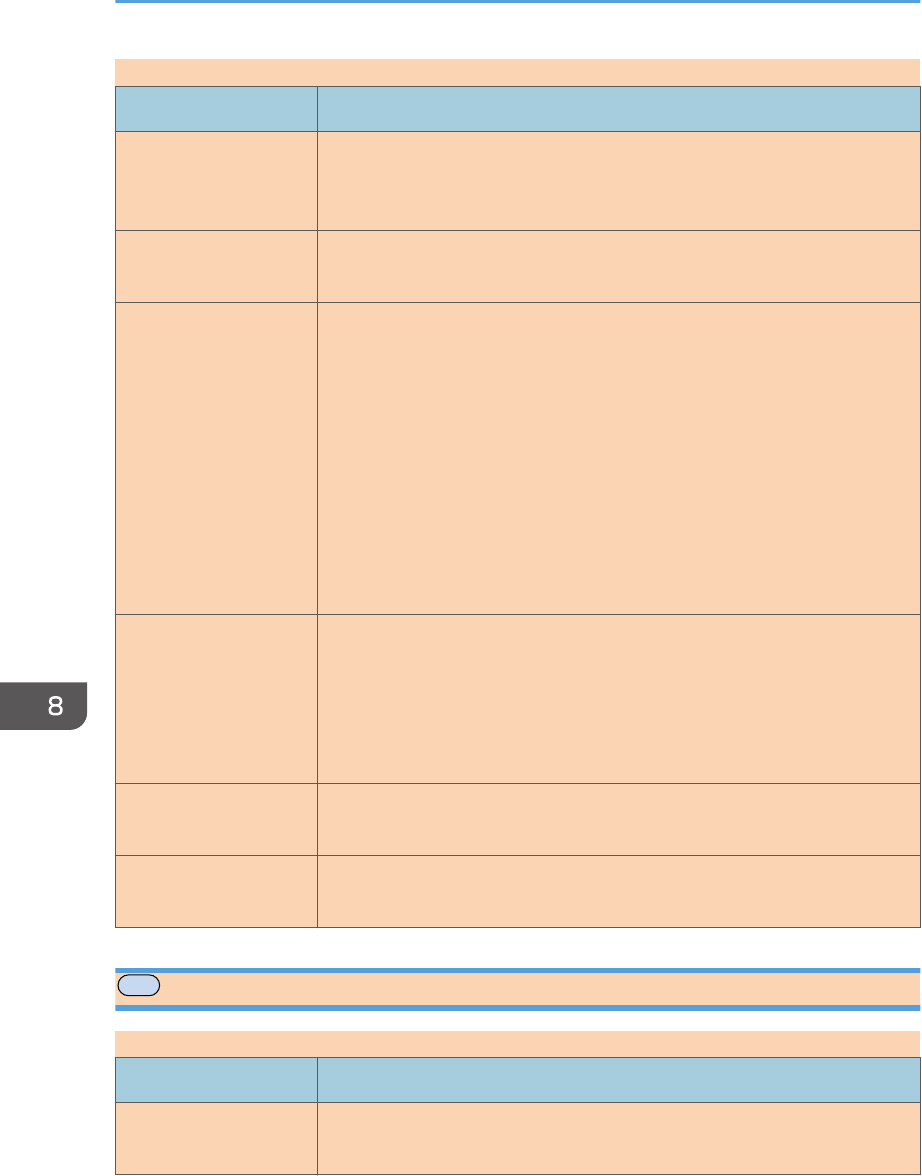
Fax Received File Processing
Item Description
Received File
Processing
Select whether received faxes are stored into the machine's memory for
printing or forwarded to a destination specified for [Forwarding
Destination].
Print Automatically Select whether the faxes received into the machine's memory are printed
automatically or stored for later manual printing.
Notify Forward Status Select whether e-mail notifications are sent after forwarding faxes or not.
Email notification destination depends on how [Forwarding Destination] is
specified:
• If specified with [E-mail Address]: the notification will be sent to the
administrator e-mail address specified in [Administrator E-mail
Address] in the [Administrator] page.
• If specified with [Scan Destination]: the notification will be sent to the
notification destination specified for the selected scan destination.
Note that if a destination e-mail address is not specified, no notification will
be sent even if this setting is enabled.
Forwarding Destination Specifies the forwarding destination.
• [E-mail Address]: Enter a destination e-mail address. Can contain up
to 64 characters.
• [Scan Destination]: Select a scan destination as a forwarding
destination.
Number of Trials of
Forwarding (time)
Specifies how many times the machine attempts to forward a fax (1 to 255
times).
Interval of Forwarding
Trial (min.)
Specifies how many minutes the machine waits between forwarding
attempts (1 to 255 minutes).
MF
Toner Management Tab
Toner Saving
Item Description
Toner Saving Enable this setting to print using a reduced amount of toner when printing
out copies.
8. Configuring the Machine Using Utilities
174 opal-p2_mf2_com_user_guide_00142134_eng.xml
Draft 2014/01/07
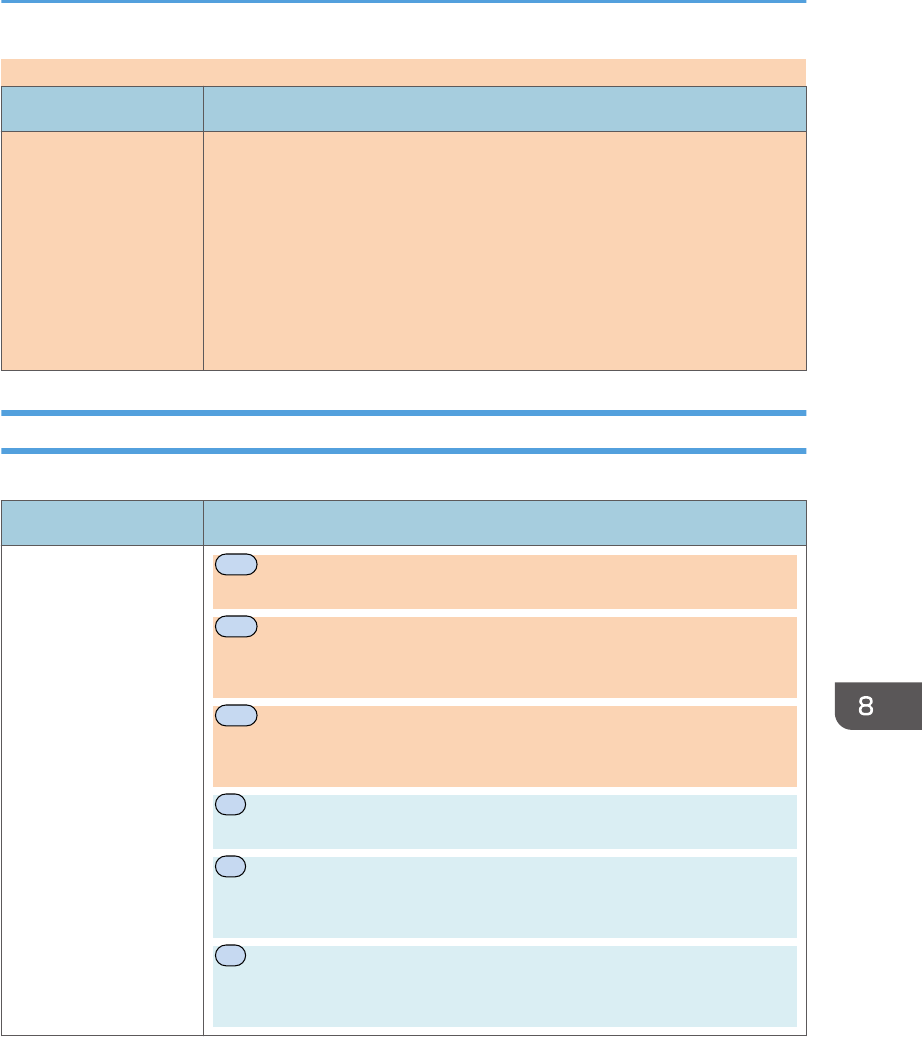
Supply End Option
Item Description
Supply End Option This setting is used to monitor the toner level.
• Stop Printing
Monitoring the toner level is enabled. The remaining toner level can
be checked in the control panel and on the Web Image Monitor.
• Continue Printing
The machine no longer monitors the toner level. Even when the toner
runs out, printing will continue and no messages will be displayed.
Interface Tab
Interface
Item Description
Fixed USB Port
MF
Specifies whether the same printer/PC-Fax driver can be used for
multiple machines or not under USB connection.
MF
If this setting is enabled, the same printer/PC-Fax driver you have
installed in your computer can be used with any machine other than the one
originally used for installation, if the machine is of the same model.
MF
If disabled, you must install the printer/PC-Fax driver separately for
individual machines, because the machine other than the original will be
recognized as a new device upon USB connection.
P
Specifies whether the same printer can be used for multiple machines
or not under USB connection.
P
If this setting is enabled, the same printer driver you have installed in
your computer can be used with any machine other than the one originally
used for installation, if the machine is of the same model.
P
If disabled, you must install the printer driver separately for individual
machines, because the machine other than the original will be recognized
as a new device upon USB connection.
Configuring the System Settings
opal-p2_mf2_com_user_guide_00142134_eng.xml 175
Draft 2014/01/07
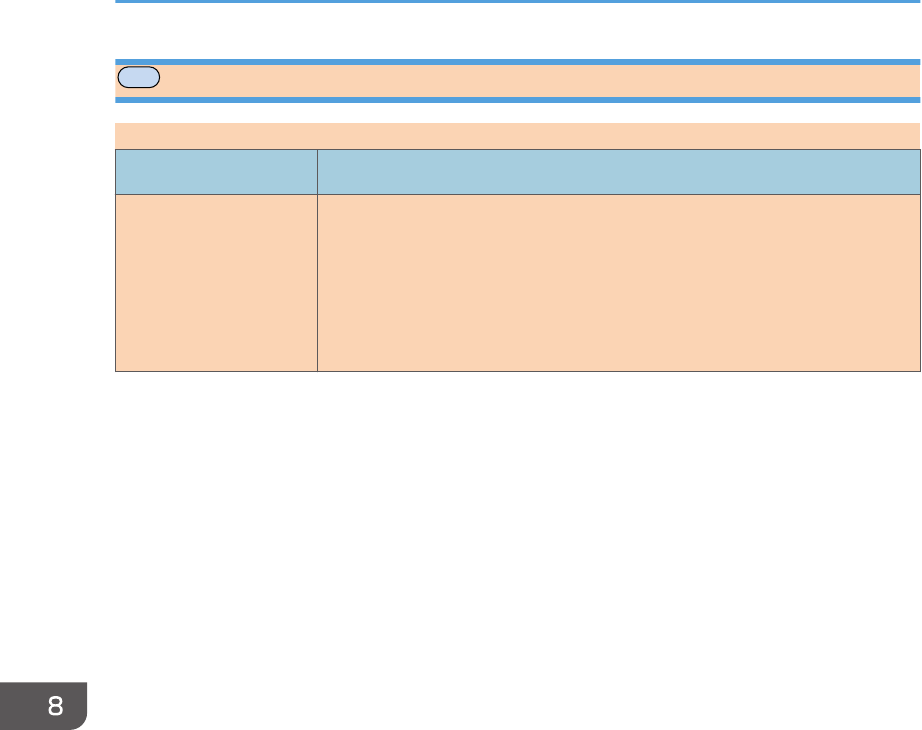
MF
Shortcut to Function Tab
Shortcut to Function
Item Description
Shortcut to Function
Settings
Assigns one of the following functions to the [Shortcut to Func.] key on the
control panel.
• [ID Card Copy Mode]
• [Fax Immediate TX]
• [Select Scanner Destination]
8. Configuring the Machine Using Utilities
176 opal-p2_mf2_com_user_guide_00142134_eng.xml
Draft 2014/01/07
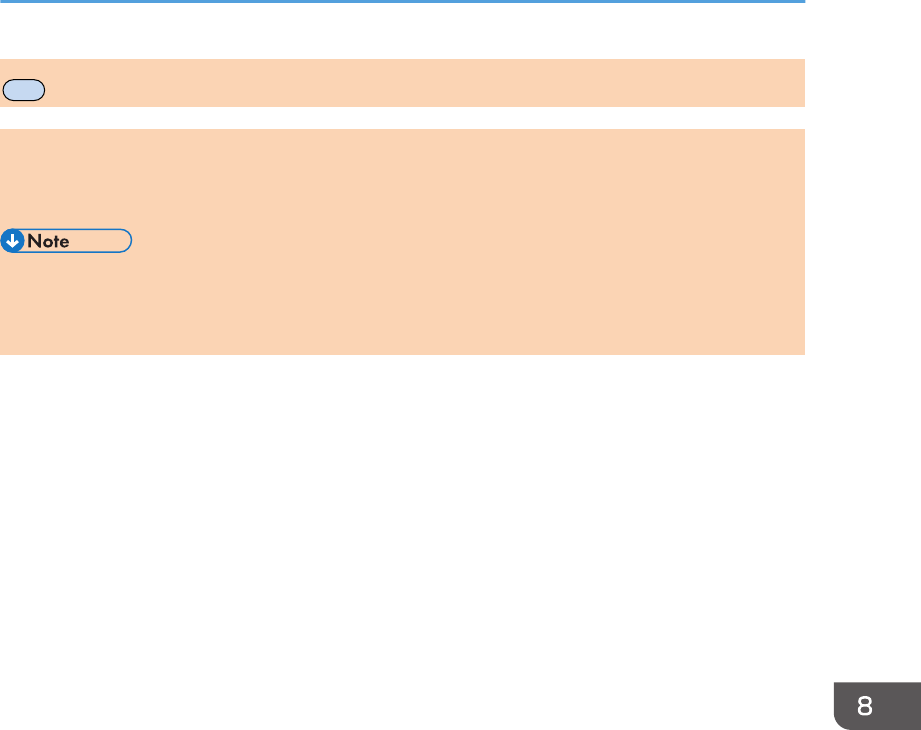
MF
Registering Destinations
Scan and fax destinations can be registered using Web Image Monitor.
Up to 100 scan destinations and 108 fax destinations (8 Quick Dial and 100 Speed Dial destinations)
can be registered. See the scan and fax sections for more information on registering destinations.
• For details about registering scan destinations, see page 80 "Registering Scan Destinations".
• For details about registering fax destinations using Web Image Monitor, see page 104
"Registering Fax Destinations".
Registering Destinations
opal-p2_mf2_com_user_guide_00142135_eng.xml 177
Draft 2014/01/07
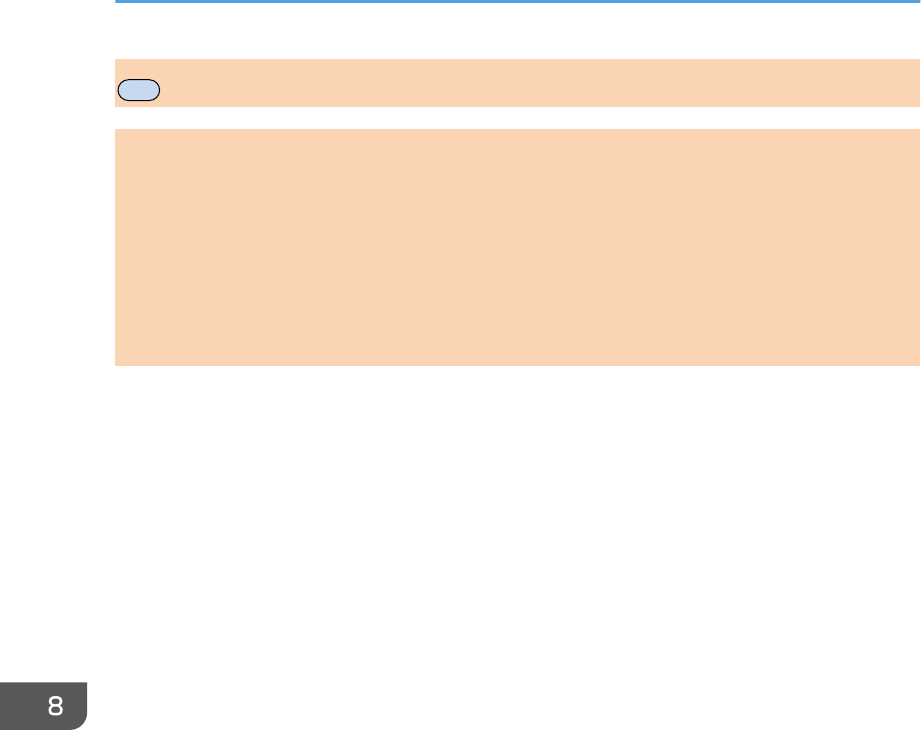
MF
Configuring the Fax Received File
You can print or delete received faxes.
• Print Selected File
You can select and print received faxes.
• Delete Selected File
You can select and delete received faxes.
• Delete All File
You can delete all received faxes.
8. Configuring the Machine Using Utilities
178 opal-p2_mf2_com_user_guide_00142136_eng.xml
Draft 2014/01/07
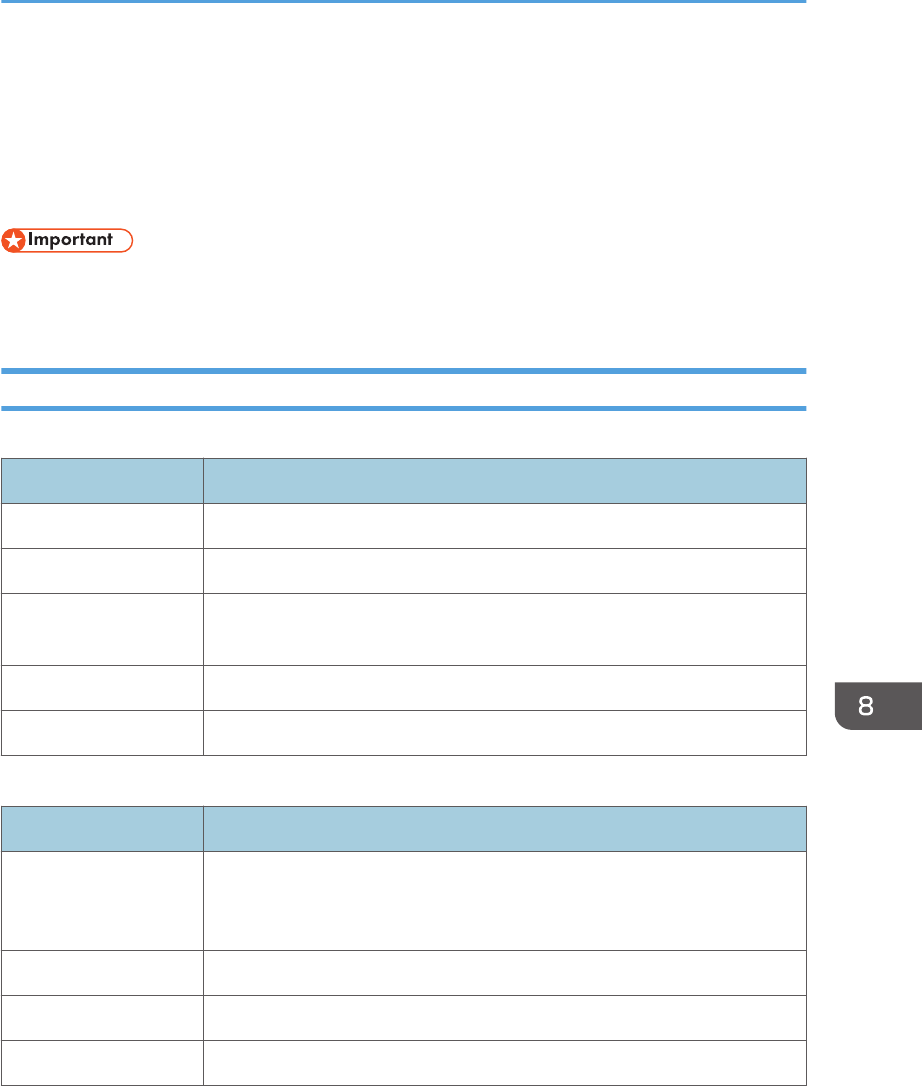
Configuring the Network Settings
Click [Network Settings] to display the page for configuring the network settings.
This page contains the following tabs: [Network Status], [IPv6 Configuration], [Network Application],
[DNS], [Auto E-mail Notification], [SNMP], [SMTP], [POP3], and [Wireless].
• Depending on the settings you change, the machine might need to be restarted.
• Depending on the model you are using, some items might not appear.
Network Status Tab
General Status
Item Description
Ethernet Speed Shows the type and speed of the network connection.
IPP Printer Name Shows the name used to identify the machine on the network.
Network Version Shows the version of the machine's network module (a part of the machine
firmware).
Ethernet MAC Address Shows the Ethernet MAC address of the machine.
Active Interface Shows the active communication method.
TCP/IP Status
Item Description
DHCP Select whether the machine should receive a dynamic IPv4 address
automatically using DHCP. To use DHCP, select [Active]. When enabled,
the items below cannot be configured.
IP Address Enter the IPv4 address for the machine.
Subnet Mask Enter the subnet mask of the network.
Gateway Enter the IPv4 address of the network gateway.
Configuring the Network Settings
opal-p2_mf2_com_user_guide_00142137_eng.xml 179
Draft 2014/01/07
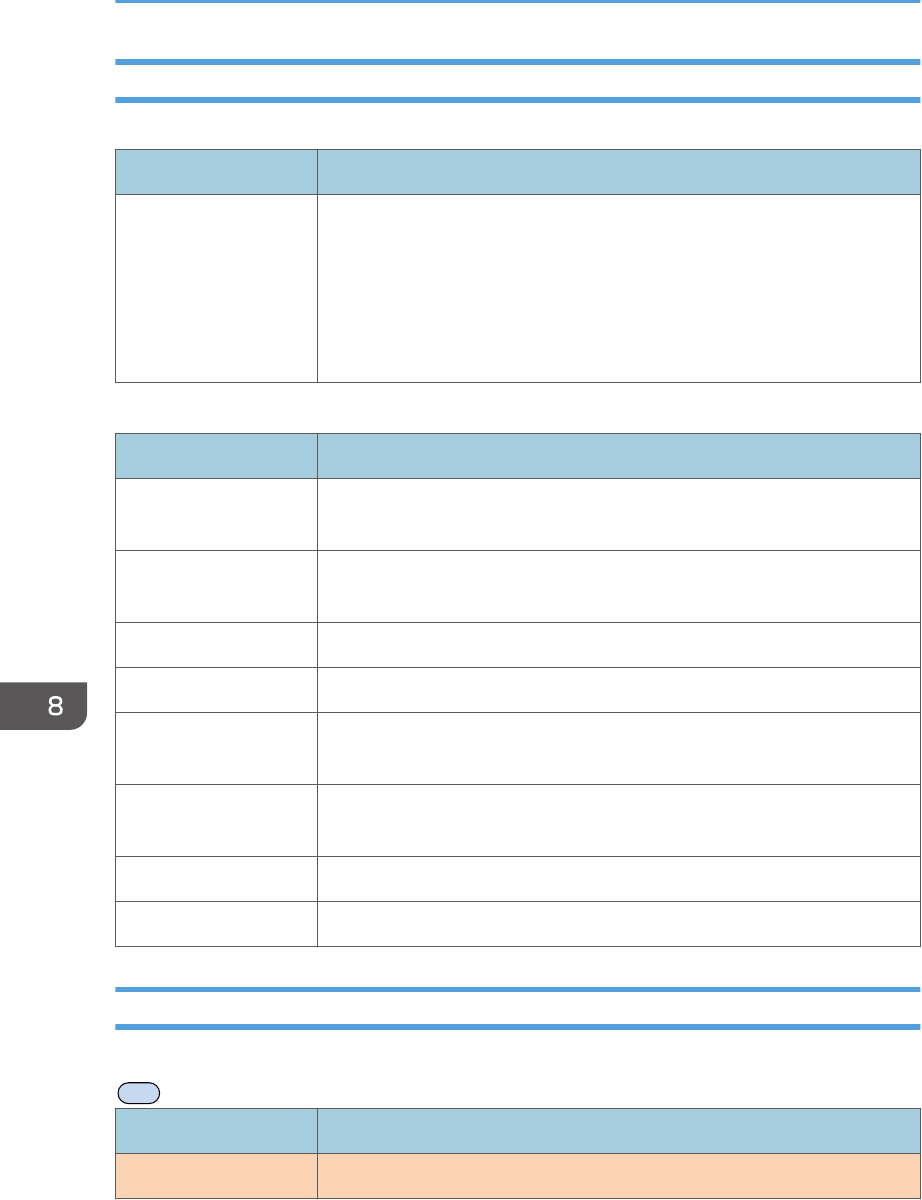
IPv6 Configuration Tab
IPv6
Item Description
IPv6 Select whether to enable or disable IPv6. You cannot disable IPv6 using
Web Image Monitor if the machine is currently in use in an IPv6
environment. In this case, use the control panel to disable [IPv6] under
network settings.
When disabled, [DHCP], [Manual Configuration Address], [Prefix Length],
and [Gateway Address] below cannot be configured.
IPv6 Address
Item Description
DHCP Select whether or not the machine obtains its IPv6 address from a DHCP
server.
IP Address (DHCP) Displays the IPv6 address obtained from the DHCP server when [DHCP] is
set to [Active].
Stateless Address Displays up to four stateless auto addresses.
Gateway Address Displays the machine's default gateway address.
Link-local Address Displays the link local address of the machine. The link local address is an
address that is valid only inside the local network (local segment).
Manual Configuration
Address
Enter the machine's IPv6 address. Can contain up to 39 characters.
Prefix Length Enter the prefix length, using a value between 0 and 128.
Gateway Address Enter the default gateway's IPv6 address. Can contain up to 39 characters.
Network Application Tab
Scanner Send Setting
MF
Item Description
E-mail Select to enable the Scan to E-mail feature.
8. Configuring the Machine Using Utilities
180 opal-p2_mf2_com_user_guide_00142137_eng.xml
Draft 2014/01/07
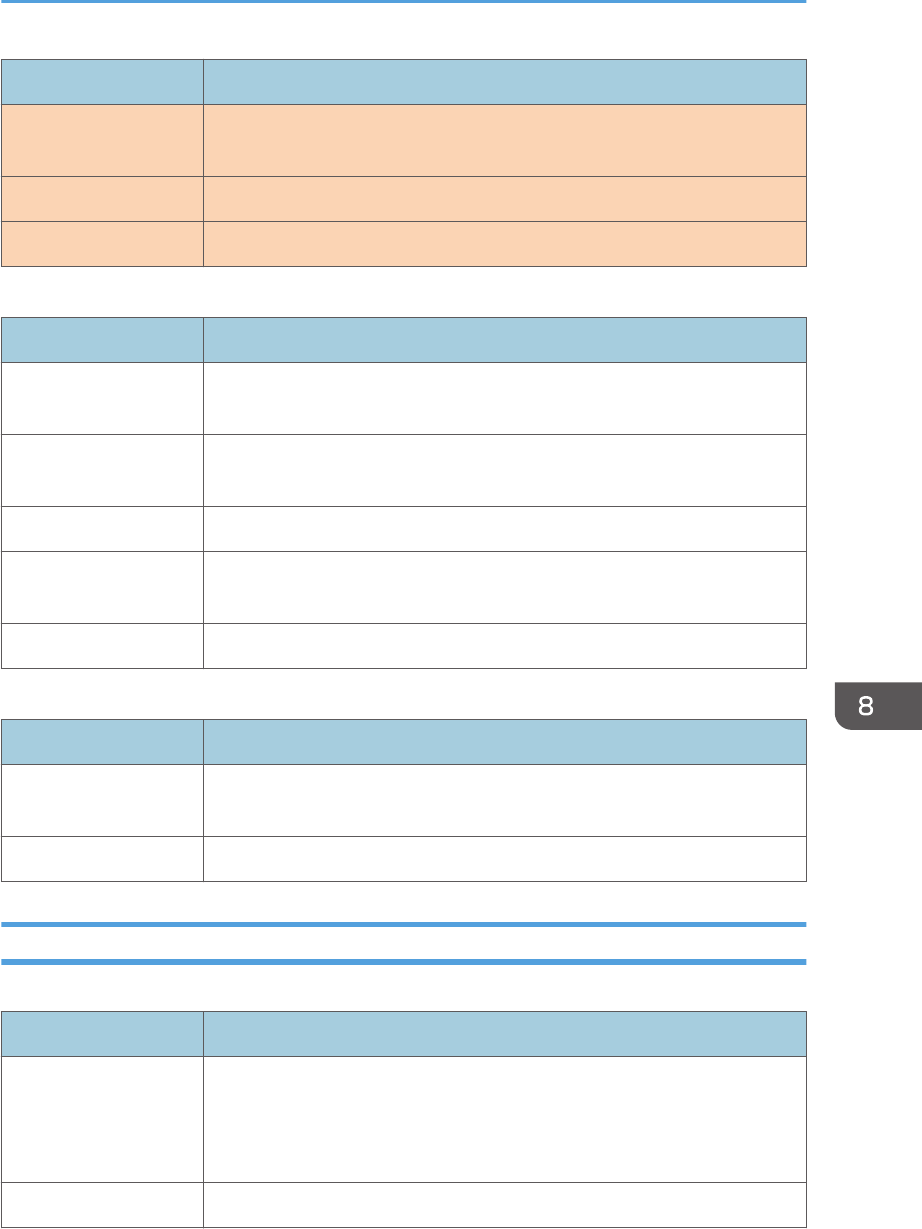
Item Description
Max. E-mail Size Select the maximum size of scan files that can be attached to an e-mail
message (1 to 5 MB, or no limit).
FTP Select to enable the Scan to FTP feature.
Folder Select to enable the Scan to Folder feature.
Network Print Setting
Item Description
IPP Select to enable network printing using Internet Print Protocol (via TCP port
631/80).
FTP Select to enable network printing using an embedded FTP server in the
machine (via TCP port 20/21).
RAW Select to enable network raw printing.
Port No. Enter the TCP port number to use for raw printing. The valid range is 1024
to 65535, except 53550 and 49999 (default is 9100).
LPR Select to enable network printing using LPR/LPD (via TCP port 515).
mDNS Setting
Item Description
mDNS Select to enable Multicast DNS (via UDP port 5353). If disabled, the item
below cannot be configured.
Printer Name Enter the name of the machine. Can contain up to 32 characters.
DNS Tab
DNS
Item Description
DNS Method Select whether to specify domain name servers manually or receive DNS
information from the network automatically. When set to [Auto-Obtain
(DHCP)], [Primary DNS Server], [Secondary DNS Server], and [Domain
Name] below become unavailable.
Primary DNS Server Enter the IPv4 address of the primary DNS.
Configuring the Network Settings
opal-p2_mf2_com_user_guide_00142137_eng.xml 181
Draft 2014/01/07
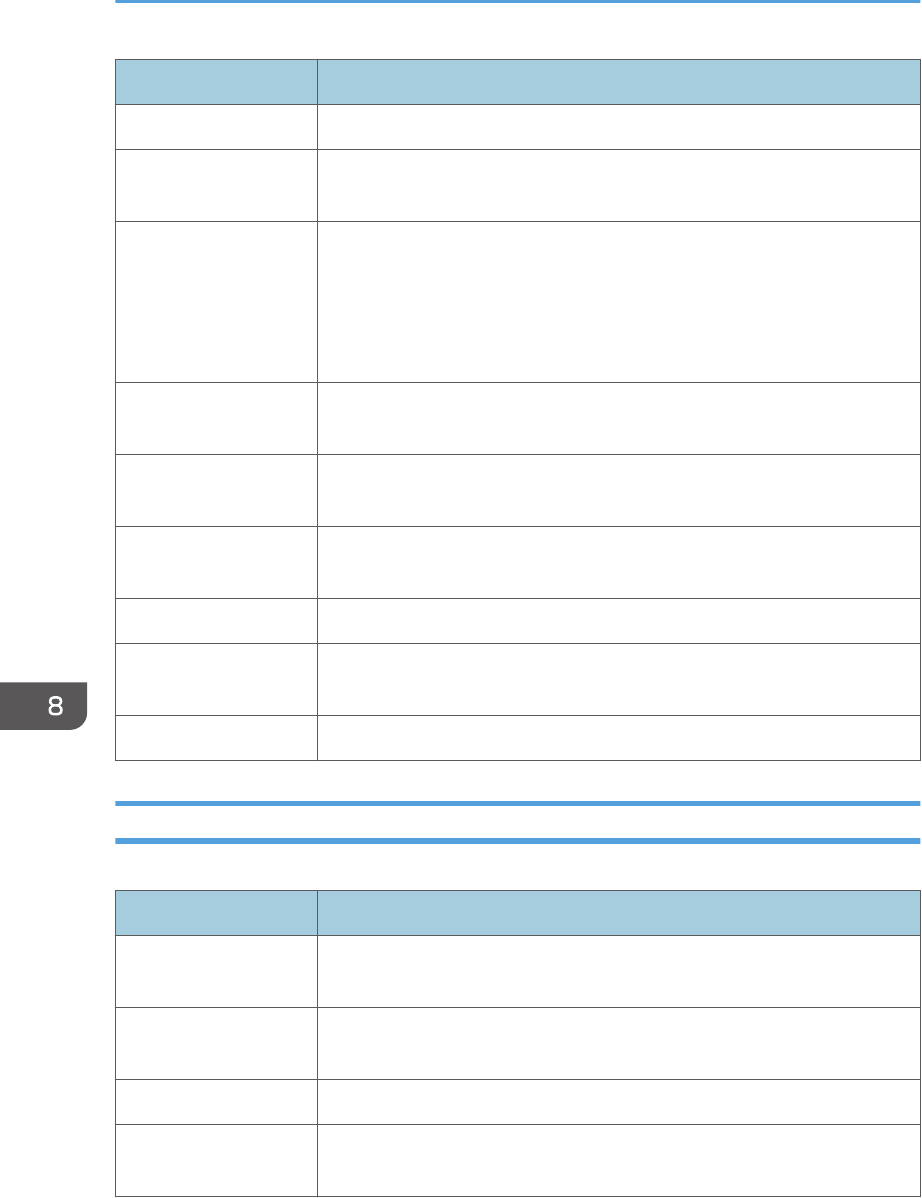
Item Description
Secondary DNS Server Enter the IPv4 address of the secondary DNS.
Domain Name Enter the IPv4 domain name for the machine. Can contain up to 32
characters.
IPv6 DNS Method Select whether to specify the domain server manually or have the machine
obtain its DNS information automatically.
When set to [Auto-Obtain (DHCP)], [Primary IPv6 DNS Server],
[Secondary IPv6 DNS Server], and [IPv6 Domain Name] below become
unavailable.
Primary IPv6 DNS
Server
Enter the IPv6 address of the primary IPv6 DNS server. Can contain up to
39 characters.
Secondary IPv6 DNS
Server
Enter the IPv6 address of the secondary IPv6 DNS server. Can contain up
to 39 characters.
IPv6 Domain Name Enter the IPv6 domain name of the machine. Can contain up to 32
characters.
DNS Resolve Priority Select whether to give priority to IPv4 or IPv6 for DNS name resolution.
DNS Timeout (seconds) Enter the number of seconds the machine waits before considering a DNS
request to have timed out (1 to 999 seconds).
Host Name Enter a host name for the machine. Can contain up to 15 characters.
Auto E-mail Notification Tab
E-mail Notification 1/E-mail Notification 2
Item Description
Display Name Enter a sender name for notification e-mail. Can contain up to 32
characters.
E-mail Address Enter the address of the recipient of the alert email. Can contain up to 64
characters.
Paper Misfeed Select to send an alert e-mail to the specified address if a paper jam occurs.
Replace Print Cartridge
Soon
Select to send an alert e-mail to the specified address if toner becomes low.
8. Configuring the Machine Using Utilities
182 opal-p2_mf2_com_user_guide_00142137_eng.xml
Draft 2014/01/07
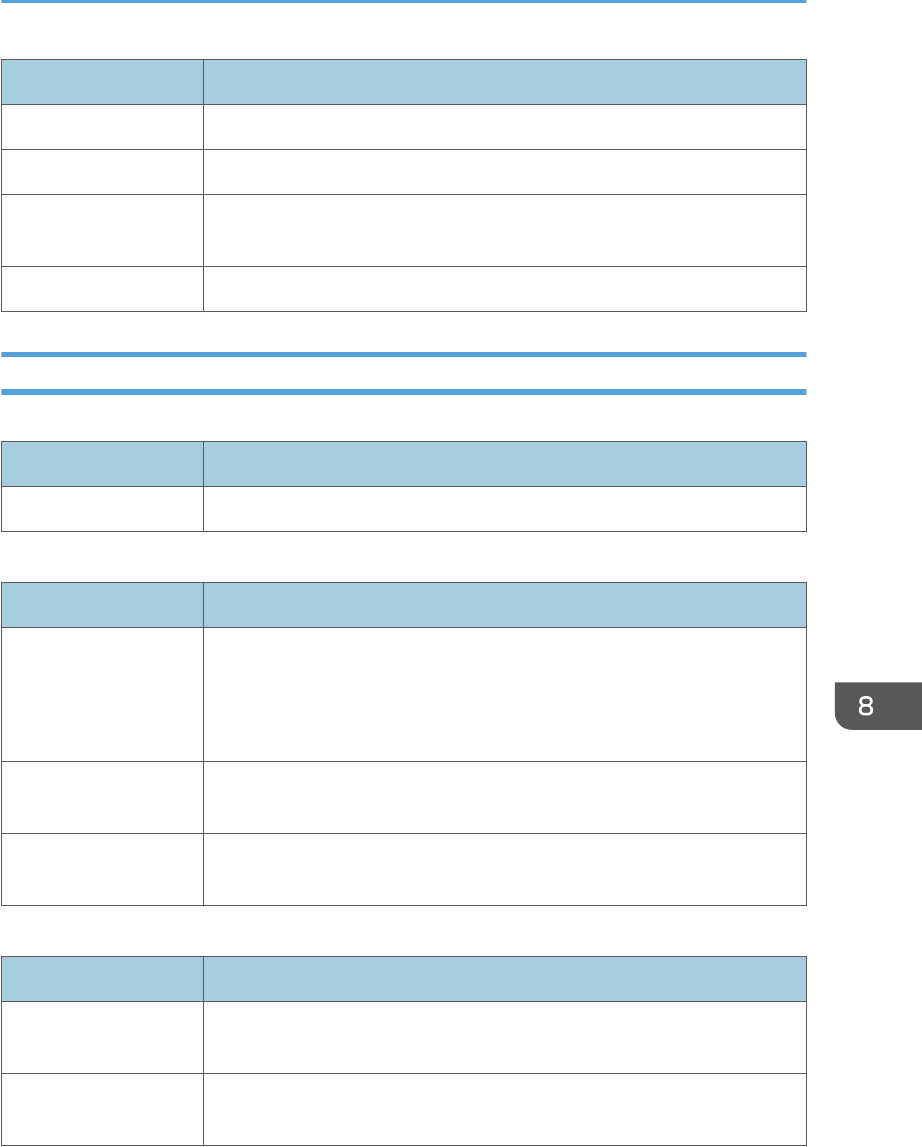
Item Description
Replace Print Cartridge Select to send an alert e-mail to the specified address if toner runs out.
Out of Paper Select to send an alert e-mail to the specified address if paper runs out.
Call Service Select to send an alert e-mail to the specified address if the machine
requires servicing.
Cover Open Select to send an alert e-mail to the specified address if a cover is open.
SNMP Tab
SNMP
Item Description
SNMP Select whether to enable the machine to use SNMP services.
Trap
Item Description
Target Trap Select whether to enable the machine to send traps to the management host
(NMS).
When disabled, [SNMP Management Host 1] and [SNMP Management
Host 2] below become unavailable.
SNMP Management
Host 1
Enter the IP address or host name of a management host. Can contain up to
64 characters.
SNMP Management
Host 2
Enter the IP address or host name of a management host. Can contain up to
64 characters.
Community
Item Description
Get Community Enter the community name to use for authentication of Get requests. Can
contain up to 32 characters.
Trap Community Enter the community name to use for authentication of Trap requests. Can
contain up to 32 characters.
Configuring the Network Settings
opal-p2_mf2_com_user_guide_00142137_eng.xml 183
Draft 2014/01/07
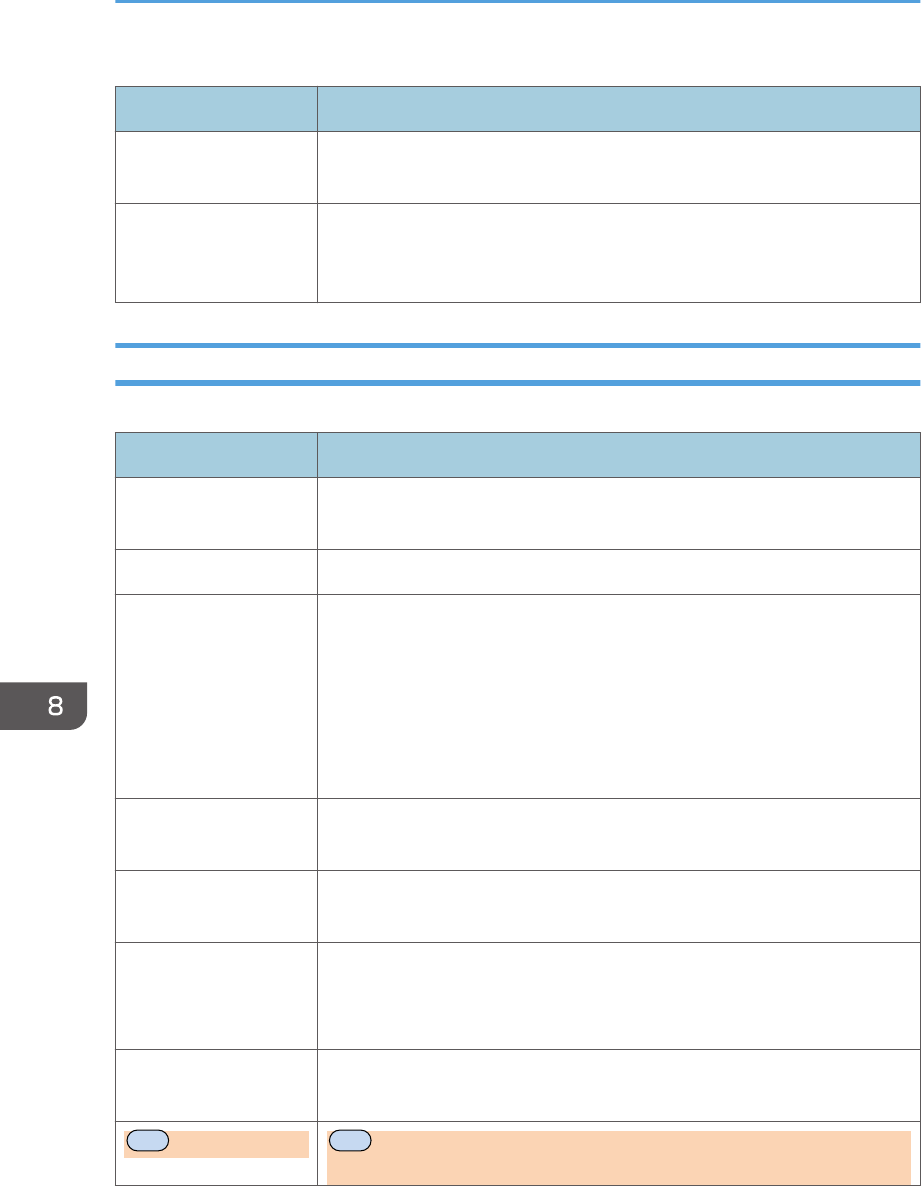
System
Item Description
Location Enter the location of the machine. The location entered here is displayed on
the main page. Can contain up to 64 characters.
Contact Enter the contact information of the machine. The contact information
entered here is displayed on the main page. Can contain up to 64
characters.
SMTP Tab
SMTP
Item Description
Primary SMTP Server Enter the IP address or host name of the SMTP/POP3 server. Can contain
up to 64 characters.
Port No. Enter the port number for SMTP (1 to 65535).
Authentication Method Select an authentication method from the following:
[Anonymous]: The user name and password are not necessary.
[SMTP]: The machine supports NTLM and LOGIN authentication.
[POP before SMTP]: The POP3 server is used for authentication. When
sending e-mails to an SMTP server, you can enhance the SMTP server
security level by connecting to the POP server for authentication.
User Name Enter the user name for logging in to the SMTP server. Can contain up to 32
characters.
Password Enter the password for logging in to the SMTP server. Can contain up to 32
characters.
Device E-mail Address Enter the machine’s e-mail address.
This address is used as the sender's address of e-mail messages sent from
this machine, such as notification e-mails. Can contain up to 64 characters.
Server Timeout
(seconds)
Enter the number of seconds the machine waits before considering an
SMTP operation to have timed out (1 to 999).
MF
Time Zone
MF
Select a time zone according to your geographic location. Selecting
a different time zone may cause transmission date and time to be incorrect
8. Configuring the Machine Using Utilities
184 opal-p2_mf2_com_user_guide_00142137_eng.xml
Draft 2014/01/07
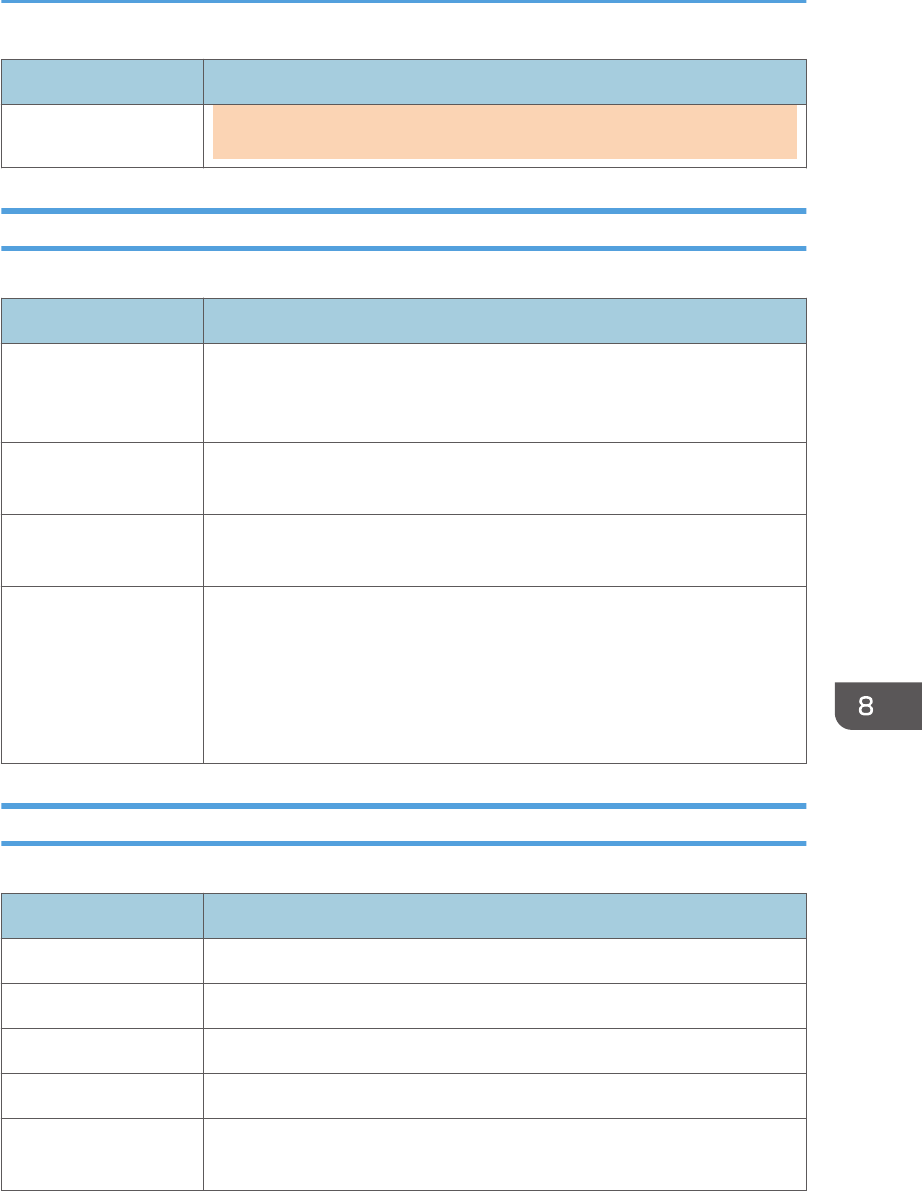
Item Description
for email sent by the Scan to E-mail function, even when the machine's
clock is set correctly.
POP3 Tab
POP3 Settings
Item Description
POP3 Server Enter the IP address or host name of the POP3 server for e-mail reception.
The POP3 server specified here will be used for [POP before SMTP]. Can
contain up to 64 characters.
User Account Enter the user name for logging in to the POP3 server. Can contain up to 32
characters.
User Password Enter the password for logging in to the POP3 server. Can contain up to 32
characters.
Authentication Select an authentication method from the following:
[None]: Password will not be encrypted.
[APOP Authentication]: Password will be encrypted.
[Auto]: Password will be encrypted or not encrypted according to the POP3
server’s settings.
Wireless Tab
Wireless LAN Status
Item Description
Wireless LAN Status Displays the status of the connection to the wireless LAN.
MAC Address Displays the MAC address.
Communication Mode Displays the communication mode that the machine is connecting in.
SSID Displays the SSID of the access point that the machine is connected to.
Channel Displays the channel information of the current wireless LAN settings if [Ad-
Hoc] is selected for [Communication Mode].
Configuring the Network Settings
opal-p2_mf2_com_user_guide_00142137_eng.xml 185
Draft 2014/01/07
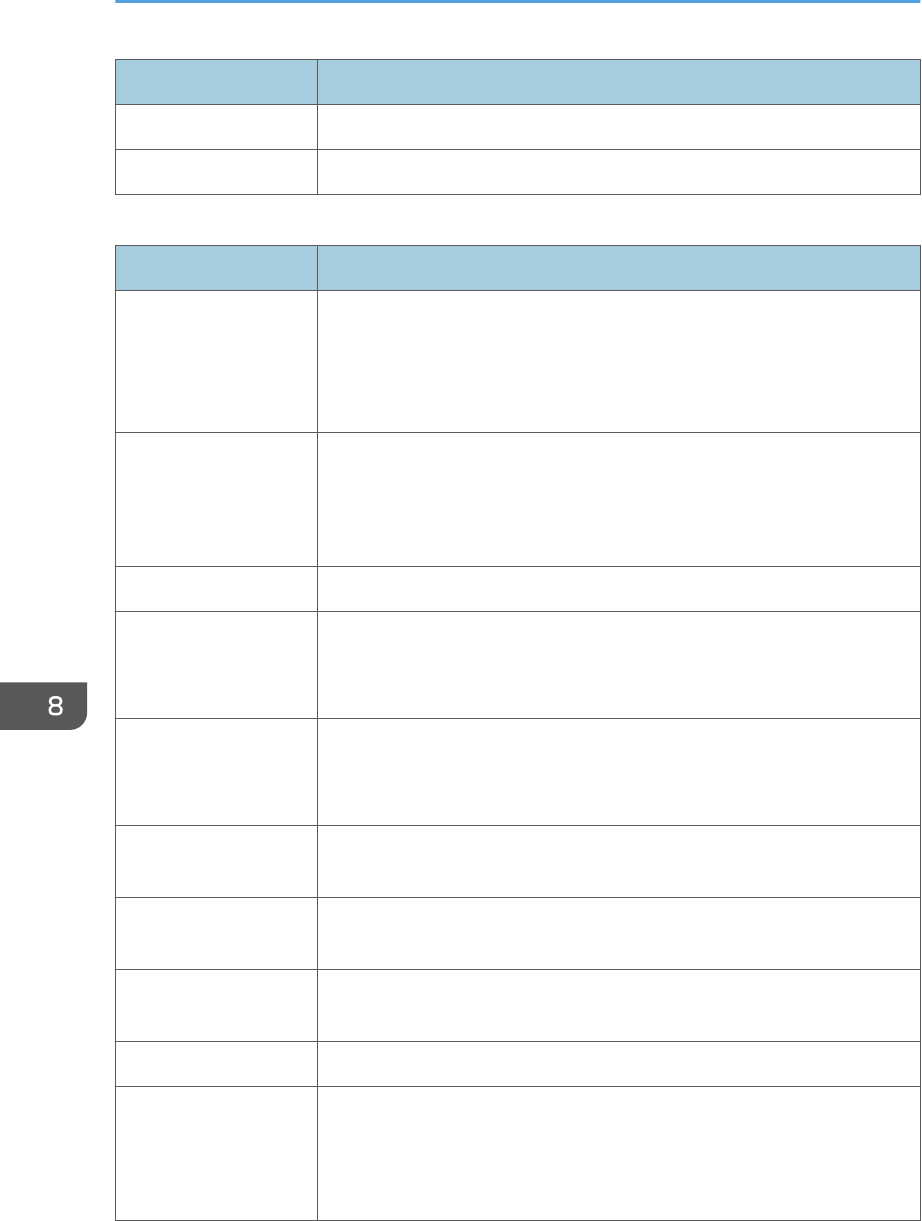
Item Description
Wireless Signal Status Displays the strength of the wireless signal that is being received.
Wireless Specifies whether or not to use the wireless LAN.
Wireless LAN Settings
Item Description
SSID Enter the SSID of the access point.
The SSID can contain up to 32 characters.
When you click [Scan List], a list of available access points is displayed.
You can select the SSID from the list.
Communication Mode Select the mode to connect in.
If the machine will be connected to a wireless router or access point, select
[Infrastructure]. If the machine will be connected to a device equipped with
a wireless LAN directly, select [Ad-Hoc].
Ad-Hoc Channel If [Ad-Hoc] is selected for [Communication Mode], select a channel.
Authentication Select an authentication method.
If [Ad-Hoc] is selected for [Communication Mode], you can select only
[Open System] and [Shared Key].
Encryption Select an encryption method.
If [Ad-Hoc] is selected for [Communication Mode], you can select only
[None] and [WEP].
WPA Passphrase If [WPA2-PSK] or [Mixed Mode WPA/WPA2] is selected for
[Authentication], enter the WPA encryption key.
WEP Key Length If [WEP] is selected for [Encryption], select 64 bits or 128 bits for the length
of the encryption key.
WEP Transmit Key ID Select an ID number to identify each WEP key in case multiple WEP
connections are configured.
WEP Key Format Select a format for entering the WEP key.
WEP Key Enter the WEP key. The number and type of characters you can enter vary
depending on the length and format selected for the key. See the following:
• WEP key length: [64bit], Format: [Hexadecimal]
WEP key max length: 10 characters (0-9, A-F, a-f)
8. Configuring the Machine Using Utilities
186 opal-p2_mf2_com_user_guide_00142137_eng.xml
Draft 2014/01/07
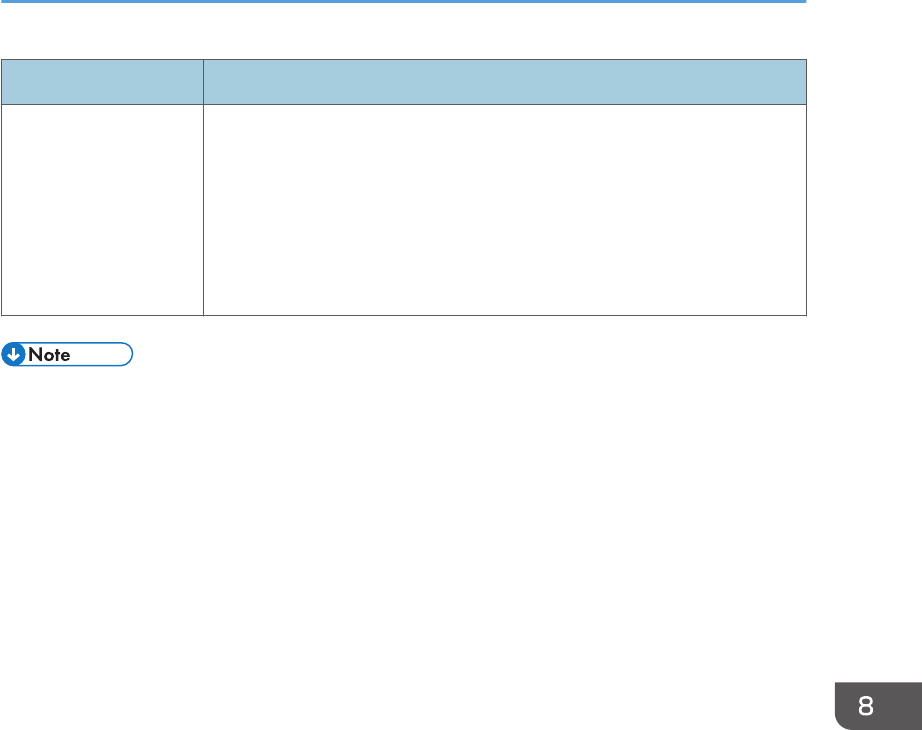
Item Description
• WEP key length: [64bit], Format: [ASCII]
WEP key max length: 5 characters (0x20-0x7e)
• WEP key length: [128bit], Format: [Hexadecimal]
WEP key max length: 26 characters (0-9, A-F, a-f)
• WEP key length: [128bit], Format: [ASCII]
WEP key max length: 13 characters (0x20-0x7e)
• If you are configuring the connection settings manually, check the SSID, authentication method, or
encryption key of the access point or wireless router in advance.
Configuring the Network Settings
opal-p2_mf2_com_user_guide_00142137_eng.xml 187
Draft 2014/01/07
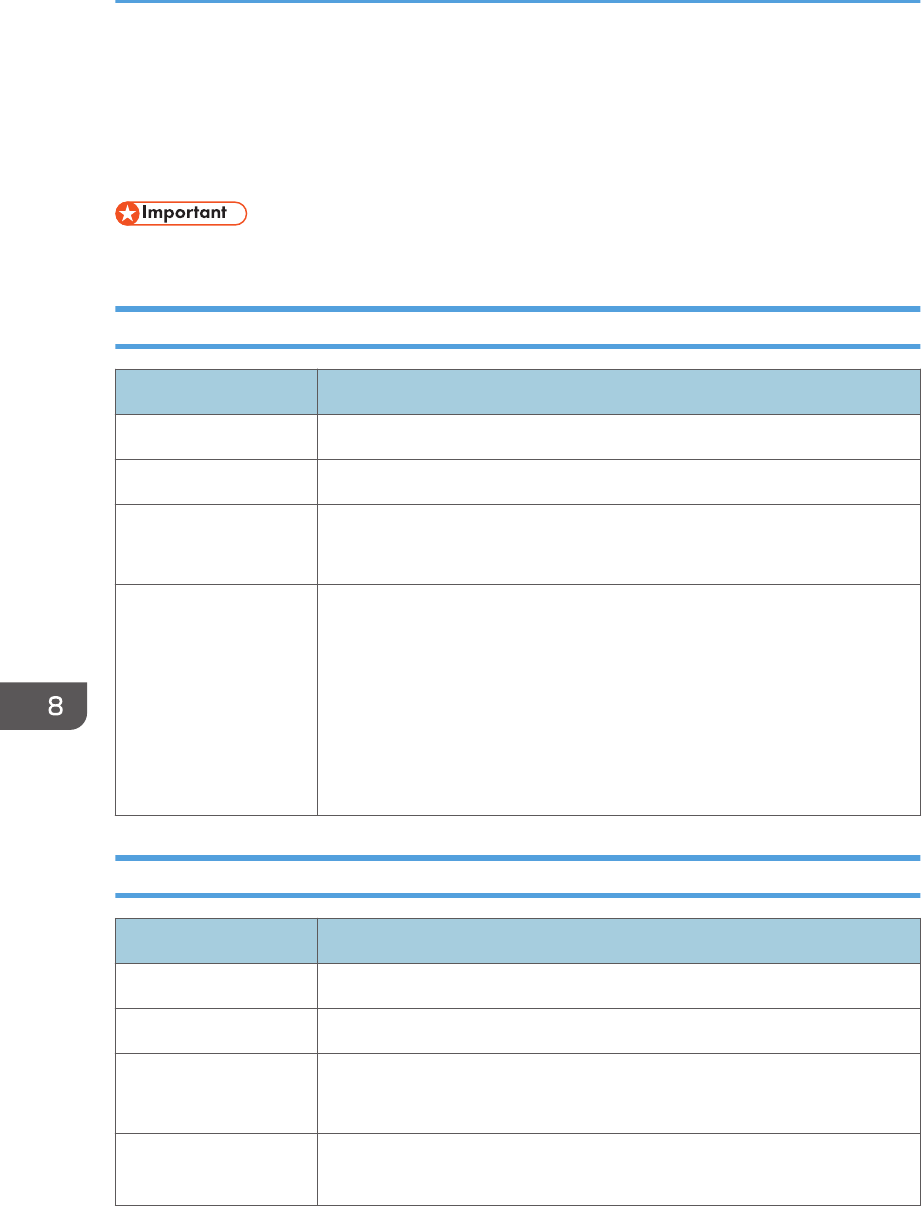
Configuring the IPsec Settings
Click [IPsec Settings] to display the page for configuring the IPsec settings.
This page contains the following tabs: [IPsec Global Settings] and [IPsec Policy List].
• This function is available only when an administrator password is specified.
IPsec Global Settings Tab
Item Description
IPsec Function Select whether to enable or disable IPsec.
Default Policy Select whether to allow for the default IPsec policy.
Broadcast and
Multicast Bypass
Select the services that you do not want to apply IPsec from the following:
[DHCPv4], [DHCPv6], [SNMP], [mDNS], [NetBIOS], [UDP Port 53550]
All ICMP Bypass Select whether to apply IPsec to ICMP packets (IPv4 and IPv6) from the
following:
[Active]: All ICMP packets will be bypassed without IPsec protection.
"ping" command (echo request and echo reply) is not encapsulated by
IPsec.
[Inactive]: Some ICMP message types will be bypassed without IPsec
protection.
IPsec Policy List Tab
Item Description
No. IPsec policy number.
Name Displays the name of the IPsec policy.
Address Settings Displays the IP address filter of the IPsec policy as below:
Remote address/Prefix length
Action Displays the action of the IPsec policy as "Allow", "Drop", or "Require
Security".
8. Configuring the Machine Using Utilities
188 opal-p2_mf2_com_user_guide_00142138_eng.xml
Draft 2014/01/07
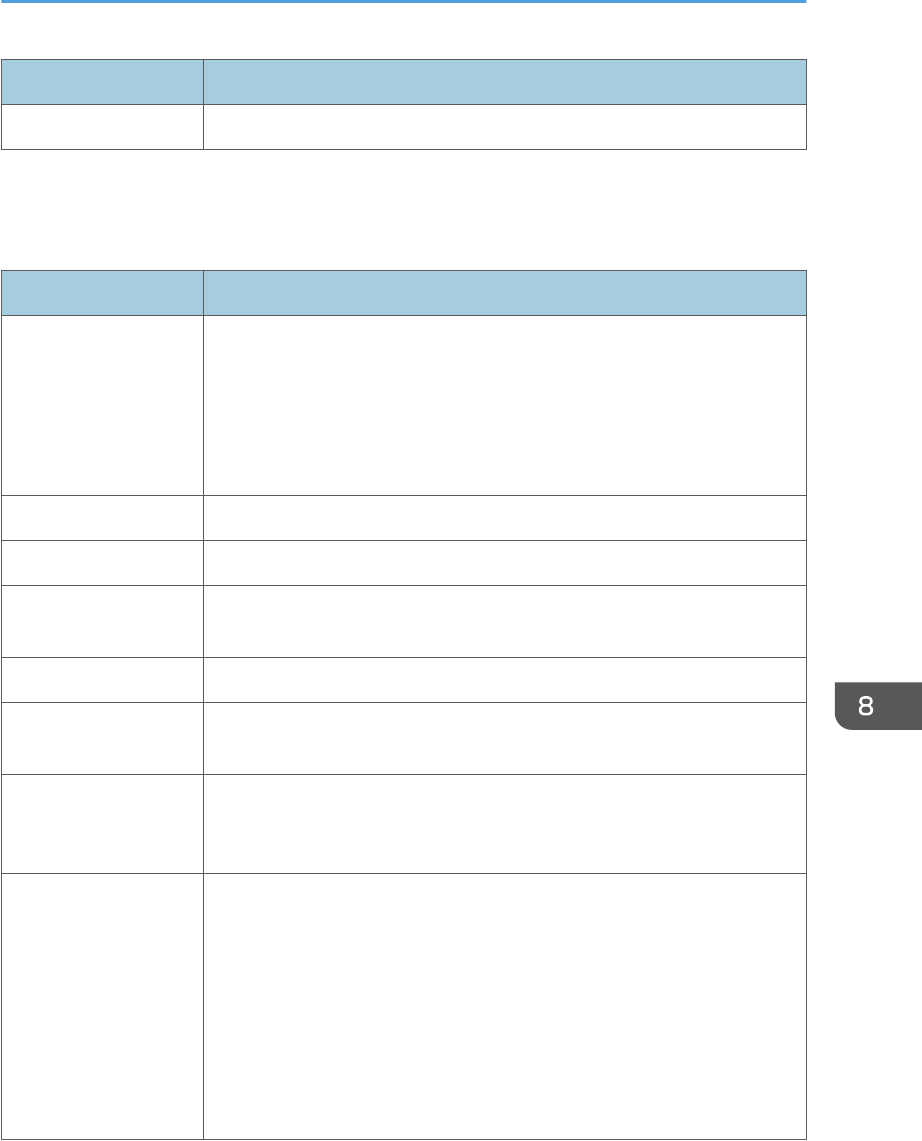
Item Description
Status Displays the status of the IPsec policy as "Active" or "Inactive".
To configure IPsec policies, select the desired IPsec policy, and then click [Change] to open the "IPsec
Policy Settings" page. The following settings can be made on the "IPsec Policy Settings" page.
IP Policy Settings
Item Description
No. Specify a number between 1 and 10 for the IPsec policy. The number you
specify will determine the position of the policy in the IPsec Policy List. Policy
searching is performed according to the order of the list. If the number you
specify is already assigned to another policy, the policy you are
configuring will take the number of the earlier policy, and the earlier policy
and any subsequent policies will be renumbered accordingly.
Activity Select whether to enable or disable the policy.
Name Enter the name of the policy. Can contain up to 16 characters.
Address Type Select IPv4 or IPv6 as the type of IP address to be used in IPsec
communication.
Local Address Displays the IP address of this printer.
Remote Address Enter the IPv4 or IPv6 address of the device with which to communicate.
Can contain up to 39 characters.
Prefix Length Enter the prefix length of the Remote Address, using a value between 1 and
128. If this setting is left blank, "32" (IPv4) or "128" (IPv6) will be
automatically selected.
Action Specify how the IP packets are processed from the following:
• [Allow]: IP packets are both sent and received without IPsec applied to
them.
• [Drop]: IP packets are discarded.
• [Require Security]: IPsec is applied to IP packets that are both sent and
received.
If you have selected [Require Security], you must configure [IPsec Settings]
and [IKE Settings].
Configuring the IPsec Settings
opal-p2_mf2_com_user_guide_00142138_eng.xml 189
Draft 2014/01/07
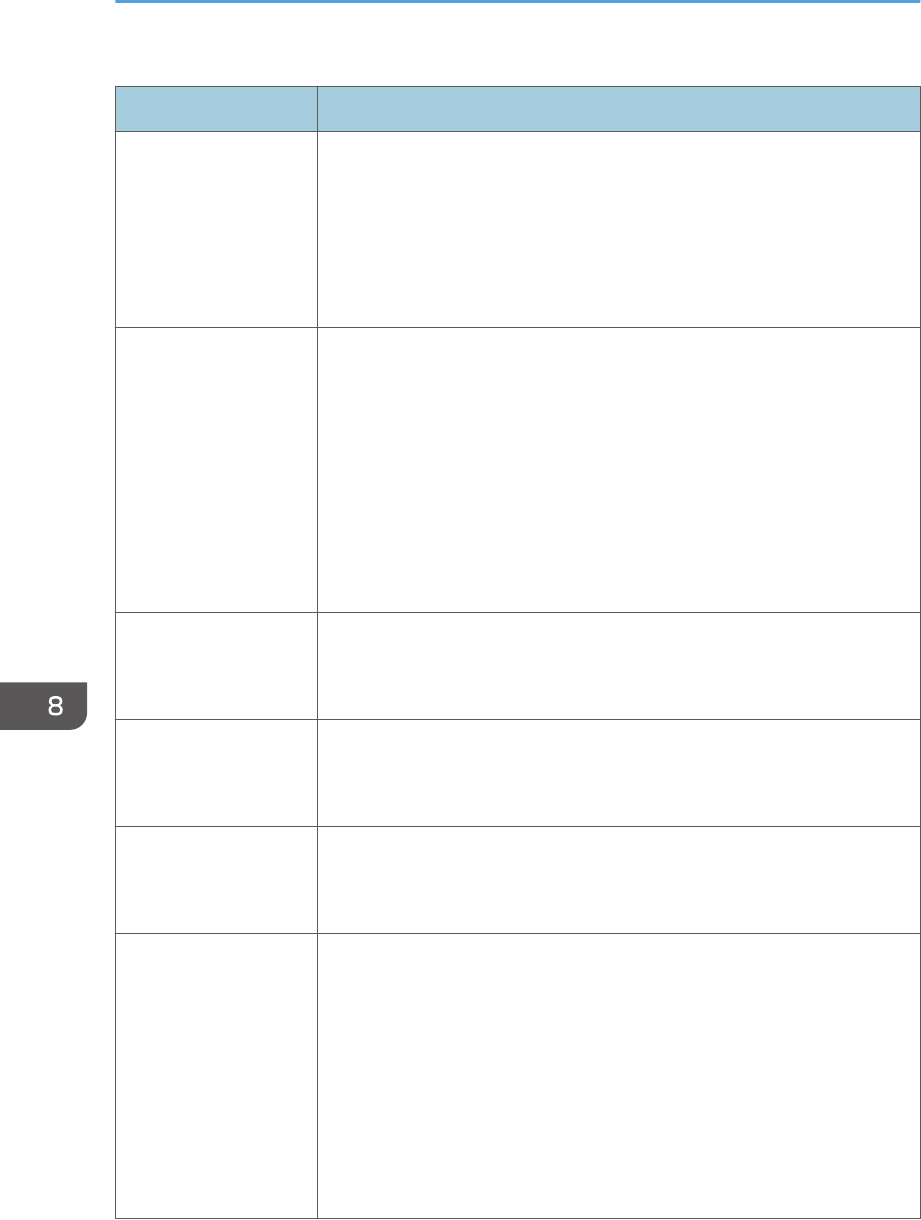
IPsec Settings
Item Description
Encapsulation Type Specify the encapsulation type from the following:
• [Transport]: Select this mode to secure only the payload section of
each IP packet when communicating with IPsec compliant devices.
• [Tunnel]: Select this mode to secure every section of each IP packet.
We recommend this type for communication between security
gateways (such as VPN devices).
Security Protocol Select the security protocol from the following:
• [AH]: Establishes secure communication that supports authentication
only.
• [ESP]: Establishes secure communication that supports both
authentication and data encryption.
• [ESP&AH]: Establishes secure communication that supports both data
encryption and authentication of packets, including packet headers.
Note that you cannot specify this protocol when [Tunnel] is selected
for [Encapsulation Type].
Authentication
Algorithm for AH
Specify the authentication algorithm to be applied when [AH] or [ESP&AH]
is selected for [Security Protocol] from the following:
[MD5], [SHA1]
Encryption Algorithm
for ESP
Specify the encryption algorithm to be applied when [ESP] or [ESP&AH] is
selected for [Security Protocol] from the following:
[None], [DES], [3DES], [AES-128], [AES-192], [AES-256]
Authentication
Algorithm for ESP
Specify the authentication algorithm to be applied when [ESP] is selected
for [Security Protocol] from the following:
[MD5], [SHA1]
Life Time Specify the life time of the IPsec SA (Security Association) as a time period
or data volume. The SA will expire when the time period you specify
elapses or the volume of data you specify reaches the volume carried.
If you specify both a time period and a data volume, the SA will expire as
soon as either is reached, and a new SA will then be obtained by
negotiation.
To specify the life time of the SA as a time period, enter a number of
seconds.
To specify the life time of the SA as a data volume, enter a number of KBs.
8. Configuring the Machine Using Utilities
190 opal-p2_mf2_com_user_guide_00142138_eng.xml
Draft 2014/01/07
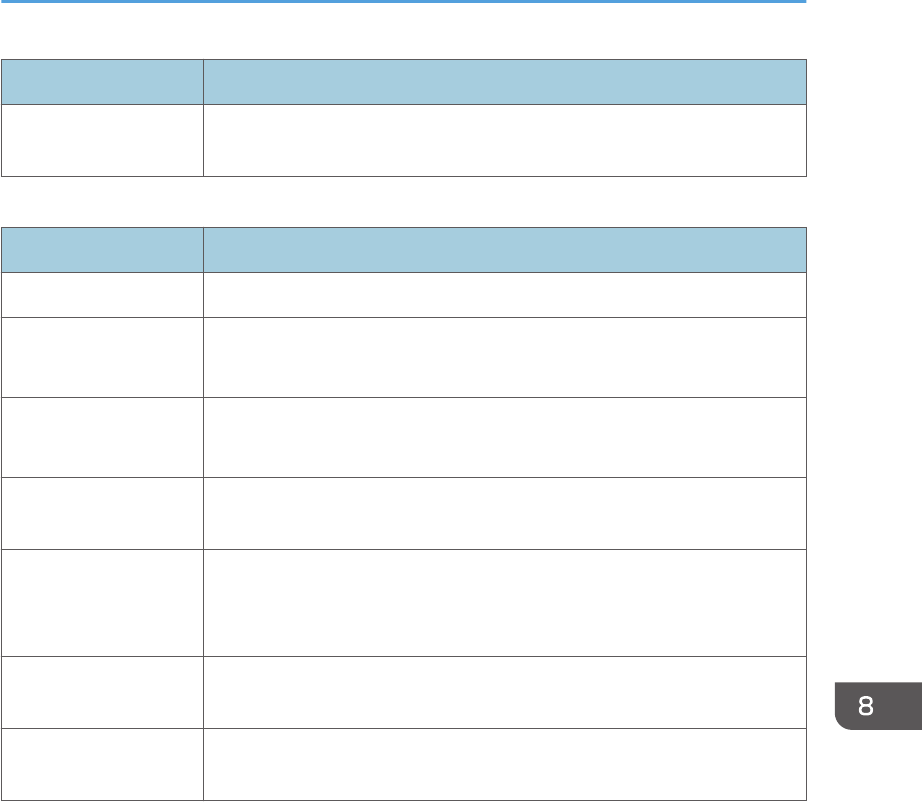
Item Description
Key Perfect Forward
Secrecy
Select whether to enable or disable PFS (Perfect Forward Secrecy).
IKE Settings
Item Description
IKE Version Displays the IKE version.
Encryption Algorithm Specify the encryption algorithm from the following:
[DES], [3DES], [AES-128], [AES-192], [AES-256]
Authentication
Algorithm
Specify the authentication algorithm from the following:
[MD5], [SHA1]
IKE Life Time Specify the life time of the ISAKMP SA as a time period. Enter a number of
seconds.
IKE Diffie-Hellman
Group
Select the IKE Diffie-Hellman Group to be used in the generation of the IKE
encryption key from the following:
[DH1], [DH2]
Pre-Shared Key Specify the PSK (Pre-Shared Key) to be used for authentication of a
communicating device. Can contain up to 32 characters.
Key Perfect Forward
Secrecy
Select whether to enable or disable PFS (Perfect Forward Secrecy).
Configuring the IPsec Settings
opal-p2_mf2_com_user_guide_00142138_eng.xml 191
Draft 2014/01/07
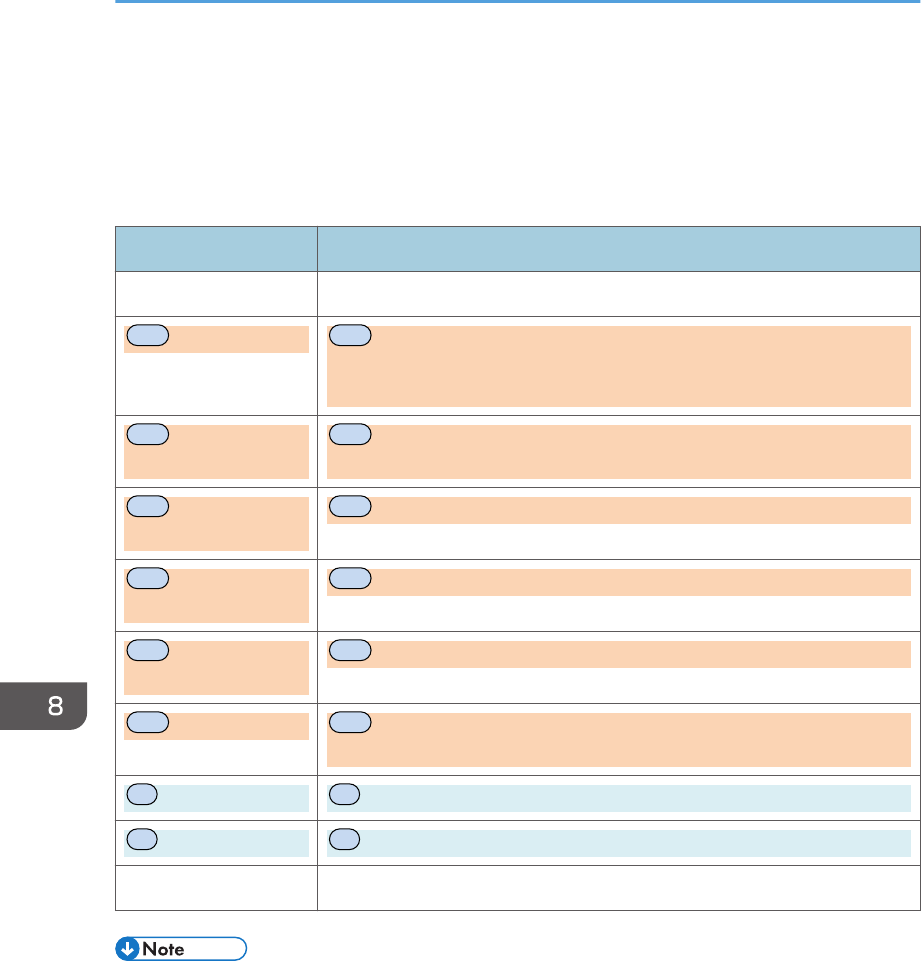
Printing Lists/Reports
Click [Print List/Report] to display the page for printing reports. Then, select an item and click [Print] to
print out information for that item.
Print List/Report
Item Description
Configuration Page Prints general information about the machine and its current configuration.
MF
Fax Journal
MF
Prints a fax transmission and reception journal for the last 50 jobs. For
details about automatic fax journal printing, see page 139 "Fax Features
Settings".
MF
Fax TX/RX
Standby File List
MF
Prints a list of fax jobs remaining in the machine's memory to be
printed, sent, or forwarded.
MF
Quick Dial
Destination List
MF
Prints a list of Quick Dial entries.
MF
Fax Speed Dial
Destination List
MF
Prints a list of Speed Dial entries.
MF
Scanner
Destination List
MF
Prints a list of scan destinations.
MF
Scanner Journal
MF
Prints a scanner journal for the last 100 Scan to E-mail, Scan to FTP,
and Scan to Folder transmissions.
P
Test Page
P
Prints a test page for checking the printing condition.
P
PCL Font List
P
Prints the current configuration and installed PCL font list.
Maintenance Page Prints the maintenance page.
• Reports cannot be printed via Web Image Monitor if other jobs are printing. Before printing
reports, confirm that machine is not printing.
• Reports will be printed on A4 or Letter size paper. Load one of these sizes of paper into the tray
before printing reports.
8. Configuring the Machine Using Utilities
192 opal-p2_mf2_com_user_guide_00142139_eng.xml
Draft 2014/01/07
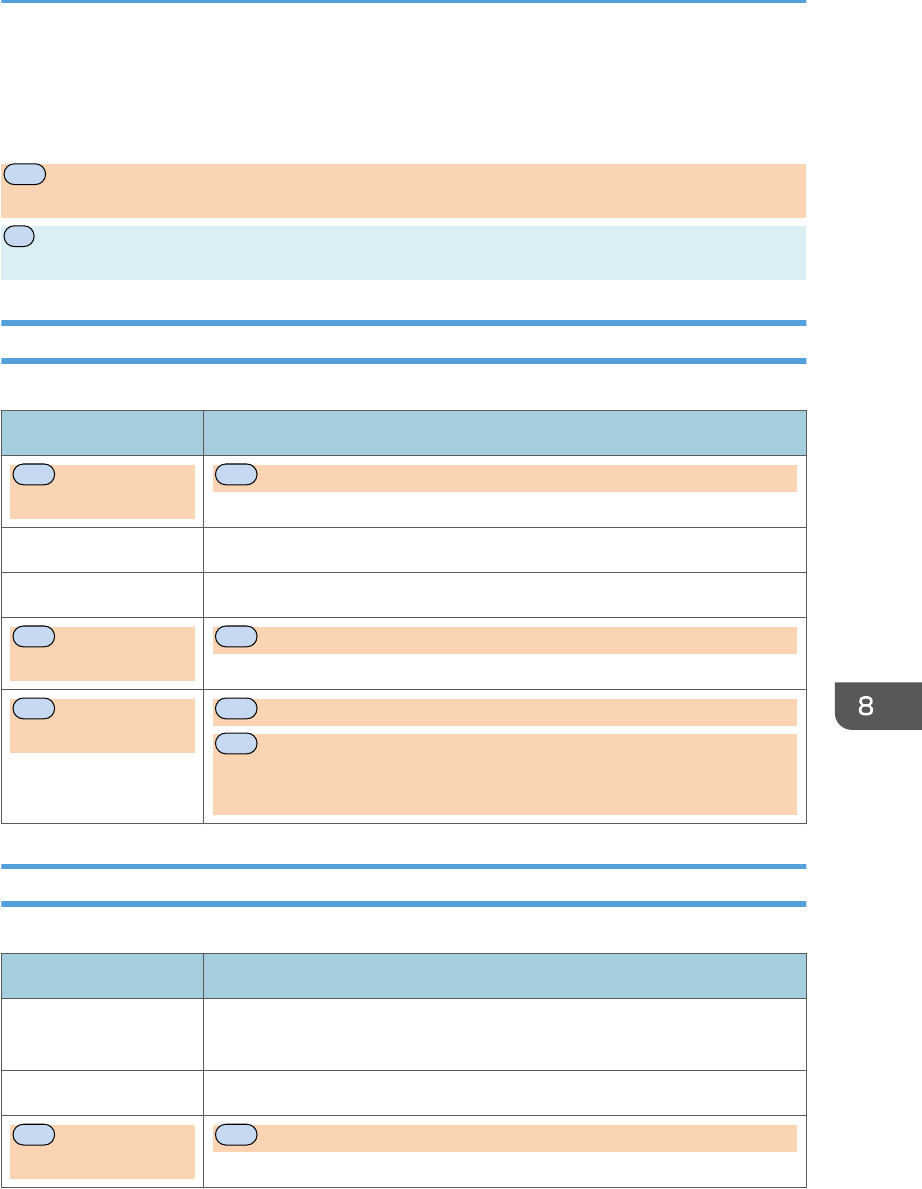
Configuring the Administrator Settings
Click [Administrator Tools] to display the page for configuring the administrator settings.
MF
This page contains the following tabs: [Administrator], [Reset Settings], [Backup Setting], [Restore
Setting], [Set Date/Time], and [Energy Saver Mode].
P
This page contains the following tabs: [Administrator], [Reset Settings], [Backup Setting], [Restore
Setting], and [Help Source File Setting].
Administrator Tab
Administrator Settings
Item Description
MF
Change
Password
MF
Check this to configure the administrator password.
New Password Enter the new administrator password. Can contain up to 16 characters.
Confirm New Password Enter the same password again, to confirm.
MF
Change E-mail
Address
MF
Check this to configure the administrator e-mail address.
MF
Administrator E-
mail Address
MF
Enter the administrator e-mail address.
MF
If the machine's e-mail address is not configured in the [SMTP] page,
this address will be used as the sender's address of e-mails sent from this
machine, such as notification e-mails. Can contain up to 64 characters.
Reset Settings Tab
Reset Settings
Item Description
Reset Network Settings Select to restore settings configured under the [Network Settings] and
[Administrator Tools].
Reset Menu Settings Select to restore settings that are not related to the network to their defaults.
MF
Clear Scan
Destination
MF
Select to clear the scan destinations.
Configuring the Administrator Settings
opal-p2_mf2_com_user_guide_00142140_eng.xml 193
Draft 2014/01/07
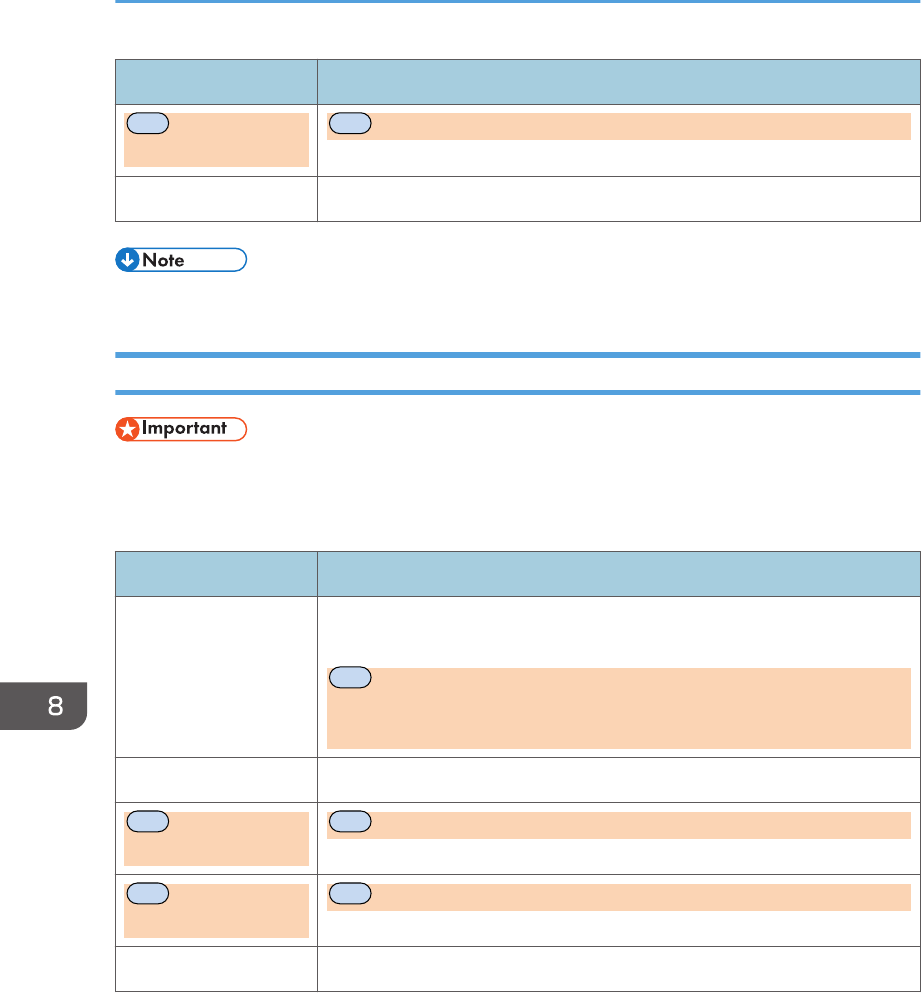
Item Description
MF
Clear Address
Book
MF
Select to clear the fax destinations.
Reset IPsec Settings Select to clear the IPsec settings.
• [Reset IPsec Settings] appears only when the administrator password is specified.
Backup Setting Tab
• When sending the machine for repair, it is important that you create backup files in advance. The
machine's settings are returned to the default after repair.
Backup Setting
Item Description
Back up Network
Settings
Backs up settings configured under the [Network Settings] and
[Administrator Tools].
MF
Note that, however, [Max. E-mail Size] setting under [Network
Application] will not be backed up here; it will be backed up by [Back up
Menu Settings] instead.
Back up Menu Settings Backs up settings that are not related to the network.
MF
Back up Scan
Destination
MF
Backs up scan destinations to a file.
MF
Back up Address
Book
MF
Backs up fax destinations to a file.
Back up IPsec Settings Backs up the IPsec settings to a file.
Follow the procedure below to create configuration backup files.
1. Select the radio button for the type of data you wish to back up.
2. Enter the administrator password if required.
3. Click [OK].
4. Click [Save] in the confirmation dialog box.
5. Navigate to the location to save the backup file.
8. Configuring the Machine Using Utilities
194 opal-p2_mf2_com_user_guide_00142140_eng.xml
Draft 2014/01/07
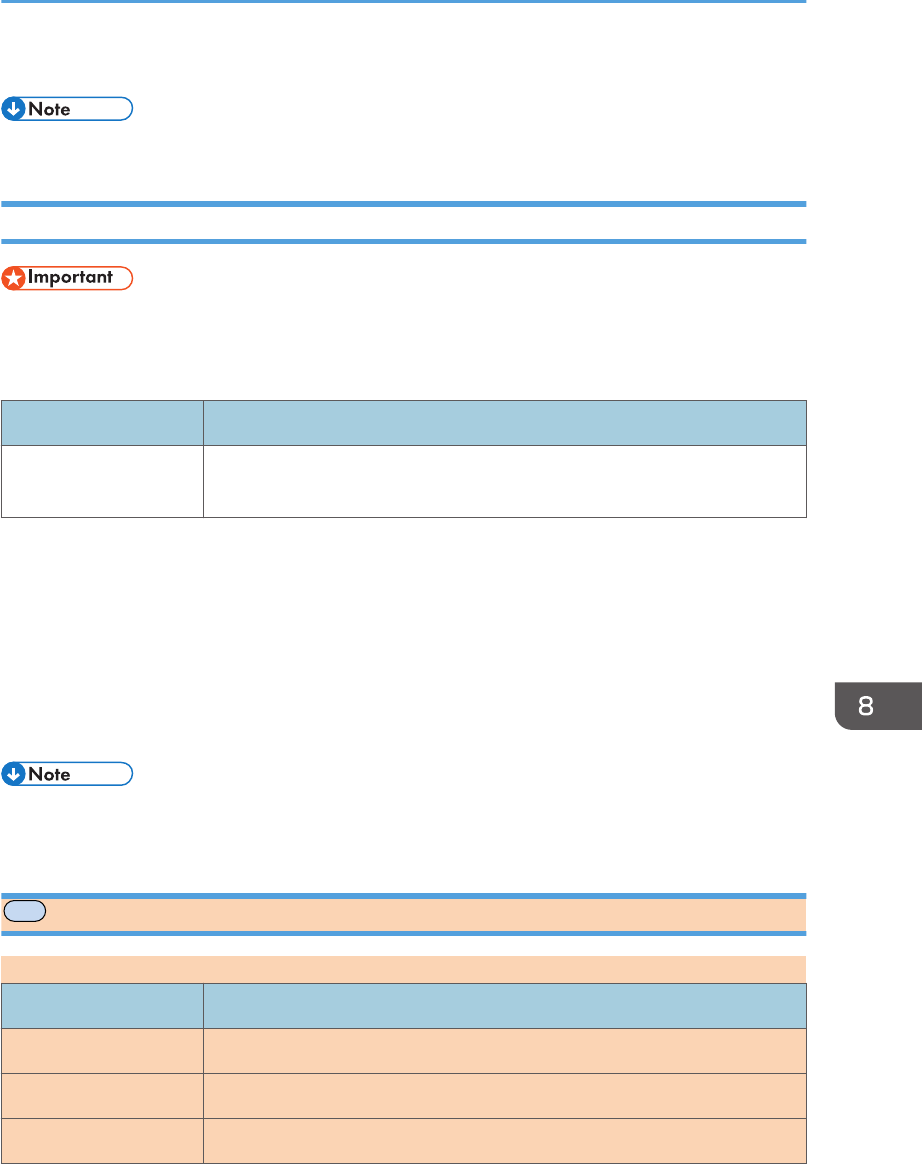
6. Specify a name for the file, and click [Save].
• [Back up IPsec Settings] appears only when the administrator password is specified.
Restore Setting Tab
• When the machine is returned from repair, it is important that you restore the machine's settings
from the backup files. The machine's settings are returned to the default after repair.
Restore Setting
Item Description
File to Restore Enter the path and name of the file to restore, or click [Browse...] to select
the file.
Follow the procedure below to restore configuration backup files.
1. Click [Browse...].
2. Navigate to the directory containing the backup file to restore.
3. Select the backup file, and click [Open].
4. Enter the administrator password if required.
5. Click [OK].
• If the settings are not restored successfully, an error message appears. Try again to restore the file
completely.
MF
Set Date/Time Tab
Set Date
Item Description
Year Enter the current year (2000 to 2099).
Month Enter the current month (1 to 12).
Day Enter the current day (1 to 31).
Configuring the Administrator Settings
opal-p2_mf2_com_user_guide_00142140_eng.xml 195
Draft 2014/01/07
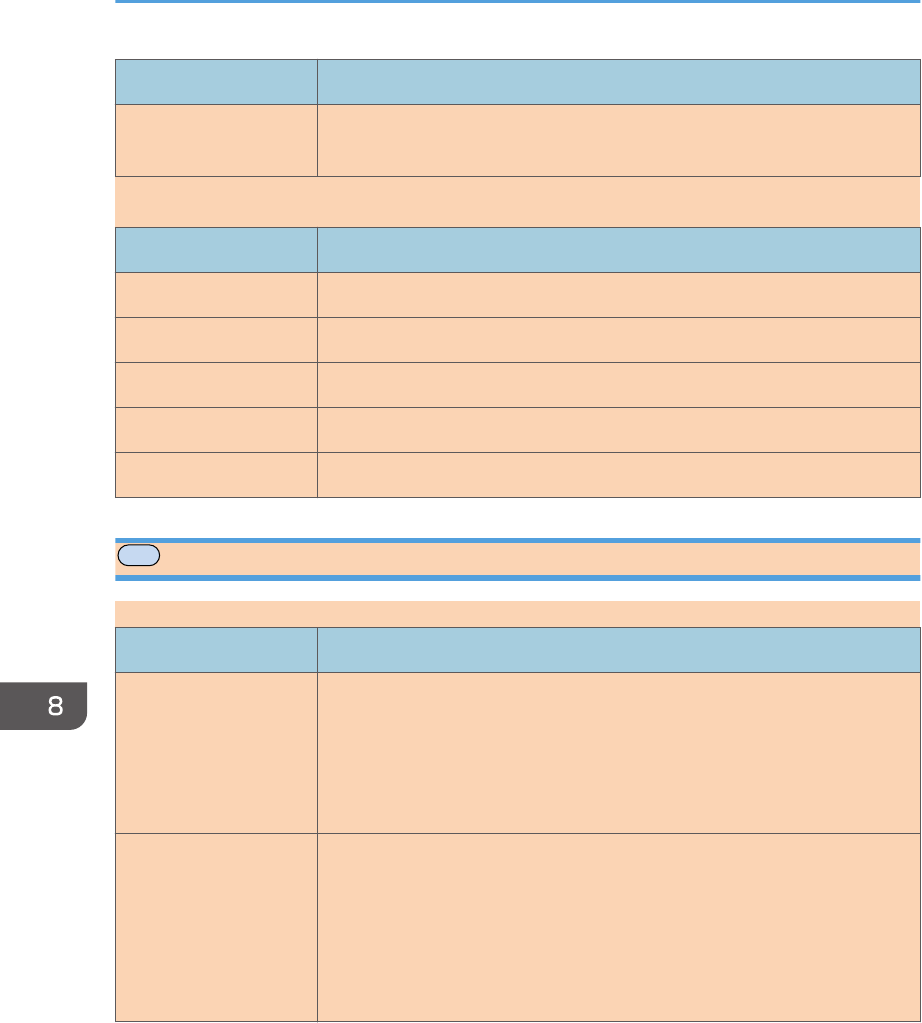
Item Description
Date Format Select the date format from [MM/DD/YYYY], [DD/MM/YYYY], or
[YYYY/MM/DD].
Set Time
Item Description
Time Format Select 24- or 12-hour time format.
Time (AM/PM) Select [AM] or [PM] if 12-hour time format is selected.
hour (0-23) Enter the current hour if 24-hour time format is selected (0-23).
hour (1-12) Enter the current hour if 12-hour time format is selected (1-12).
min. (0-59) Enter the current minute (0-59).
MF
Energy Saver Mode Tab
Energy Saver Mode
Item Description
Energy Saver Mode 1 Select [Active] to set the machine to enter Energy Saver mode 1 if the
machine has been idle for about 30 seconds.
It takes less time to recover from Energy Saver mode 1 than from power-off
state or Energy Saver mode 2, but power consumption is higher in Energy
Saver mode 1 than in Energy Saver mode 2.
Energy Saver Mode 2 Select [Active] to set the machine to enter Energy Saver mode 2 after the
period of time specified for [Waiting Time (1 min. - 240 min.)] is passed (1
to 240 minutes).
The machine consumes less power in Energy Saver mode 2 than in Energy
Saver mode 1, but it takes longer to recover from Energy Saver mode 2
than from Energy Saver mode 1.
8. Configuring the Machine Using Utilities
196 opal-p2_mf2_com_user_guide_00142140_eng.xml
Draft 2014/01/07
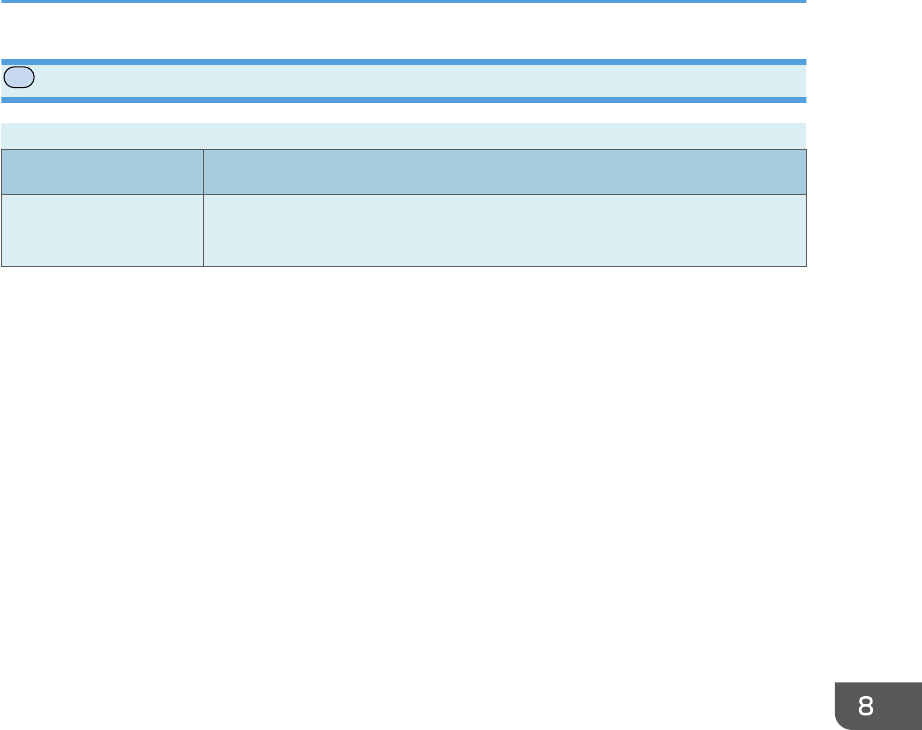
P
Help Source File Setting Tab
Help Source File Setting
Item Description
Help Source File Enter the address (URL) of the Help button. Up to 50 alphanumeric
characters can be entered.
Configuring the Administrator Settings
opal-p2_mf2_com_user_guide_00142140_eng.xml 197
Draft 2014/01/07
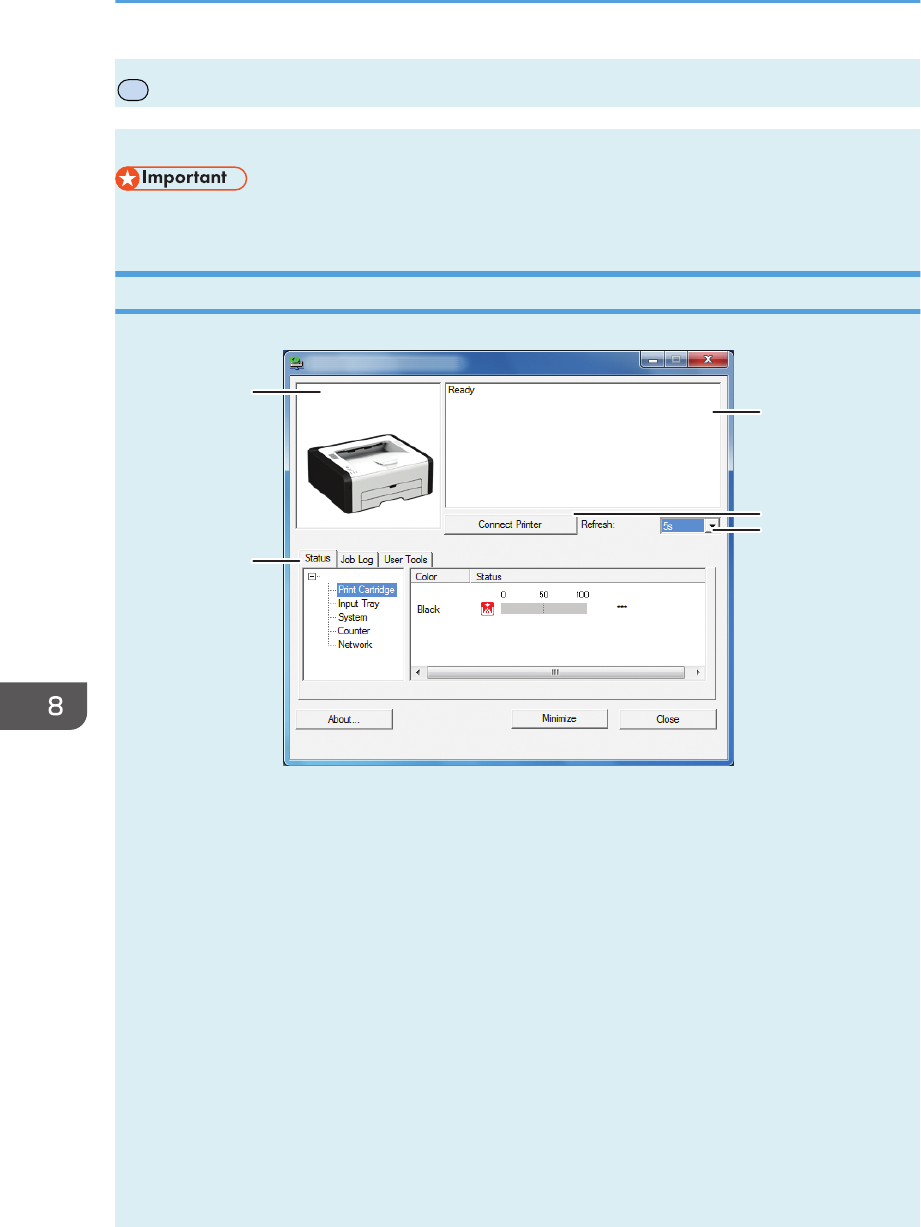
P
Using Smart Organizing Monitor
The state and status information of the machine can be checked using Smart Organizing Monitor.
• Some items might not appear, depending on the model type you are using.
Checking the Status Information
DCT865
1
2
3
4
5
1. Image area
Displays the status of this machine with an icon.
2. Status area
• Printer Name
• Print Cartridge
Toner level status may not be displayed.
• Input Tray
You can check the following information about the input trays.
[Tray], [Status], [Paper Size], [Paper Type]
Displays the type of the paper loaded into each input tray.
• System
Displays the system information about the printer, such as the model name, system version, and memory
size.
• Counter
8. Configuring the Machine Using Utilities
198 opal-p2_mf2_com_user_guide_00142141_eng.xml
Draft 2014/01/07
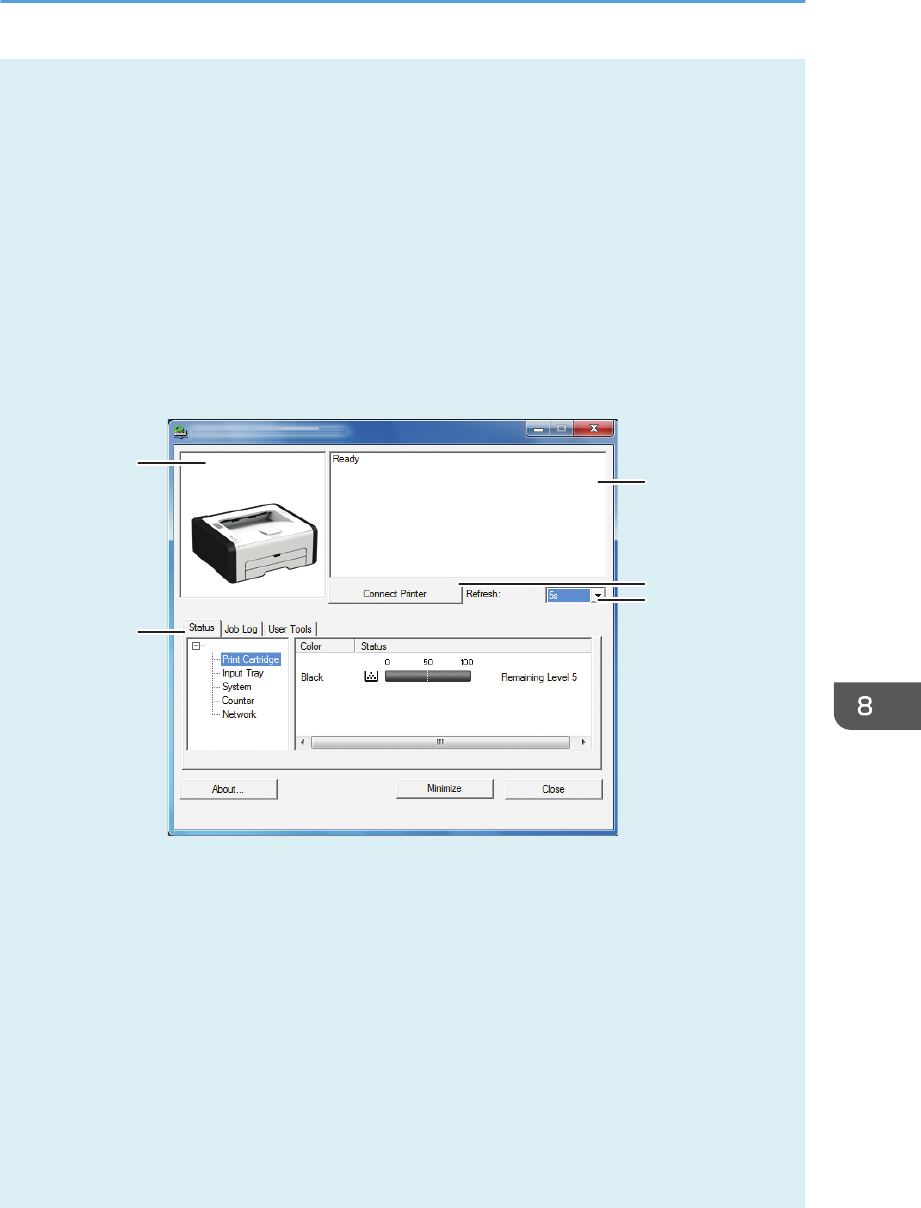
Displays information about the counters.
• Network
Displays network details such as the printer's IP address and network-related comments.
3. Message area
Displays the status of this machine with a message.
For details about error messages, see page 235 "Error and Status Messages Appear on Smart Organizing
Monitor".
4. [Connect Printer] button
Click to select a printer driver.
5. [Refresh:]
Specify the automatic update of the display.
DCT881
1
2
3
4
5
1. Image area
Displays the status of this machine with an icon.
2. Status area
• Printer Name
• Print Cartridge
Displays the following messages to indicate remaining toner levels: Remaining Level 1 to 5, "Almost
Empty" and "Empty"
• Input Tray
You can check the following information about the input trays.
[Tray], [Status], [Paper Size], [Paper Type]
Displays the type of the paper loaded into each input tray.
Using Smart Organizing Monitor
opal-p2_mf2_com_user_guide_00142141_eng.xml 199
Draft 2014/01/07
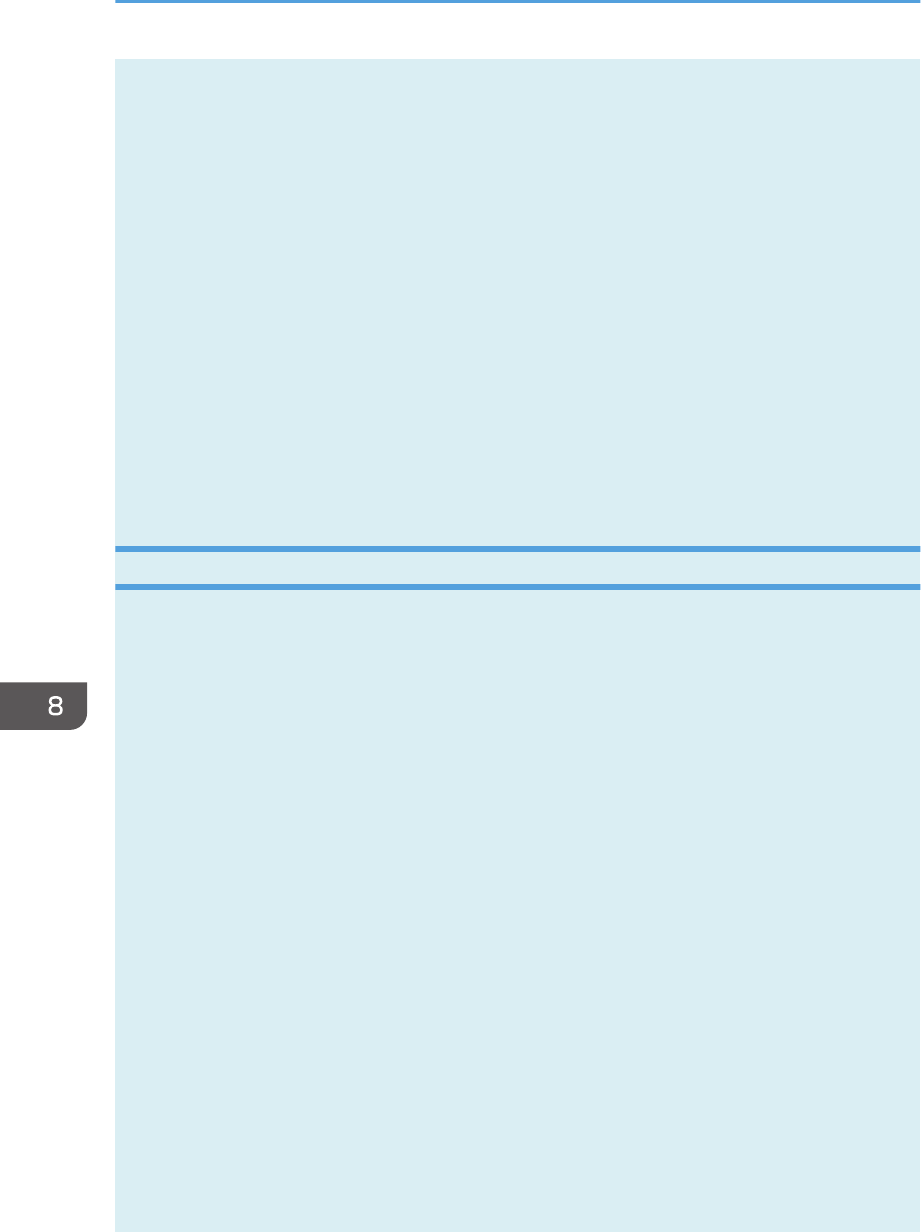
• System
Displays the system information about the printer, such as the model name, system version, and memory
size.
• Counter
Displays information about the counters.
• Network
Displays network details such as the printer's IP address and network-related comments.
3. Message area
Displays the status of this machine with a message.
For details about error messages, see page 235 "Error and Status Messages Appear on Smart Organizing
Monitor".
4. [Connect Printer] button
Click to select a printer driver.
5. [Refresh:]
Specify the automatic update of the display.
Configuring the Machine Settings
Smart Organizing Monitor is used to modify the machine’s settings.
1. On the [Start] menu, click [All Programs].
2. Click [Smart Organizing Monitor for SP xxx Series].
3. Click [Smart Organizing Monitor Status].
If the machine you are using is not selected, click [Connect Printer], and then select the machine's
model.
4. On the [User Tools] tab, click [Printer Configuration].
5. Enter the access code.
The default access code is "Admin".
6. Change the settings if necessary.
7. Click [OK].
8. Click [Close].
Access Code
The configurable functions depend on the authority of the access code you enter.
• Administrator
All tabs in the [Printer Configuration] dialog box are available.
• General users
Only the [Paper Input] tab is available.
8. Configuring the Machine Using Utilities
200 opal-p2_mf2_com_user_guide_00142141_eng.xml
Draft 2014/01/07
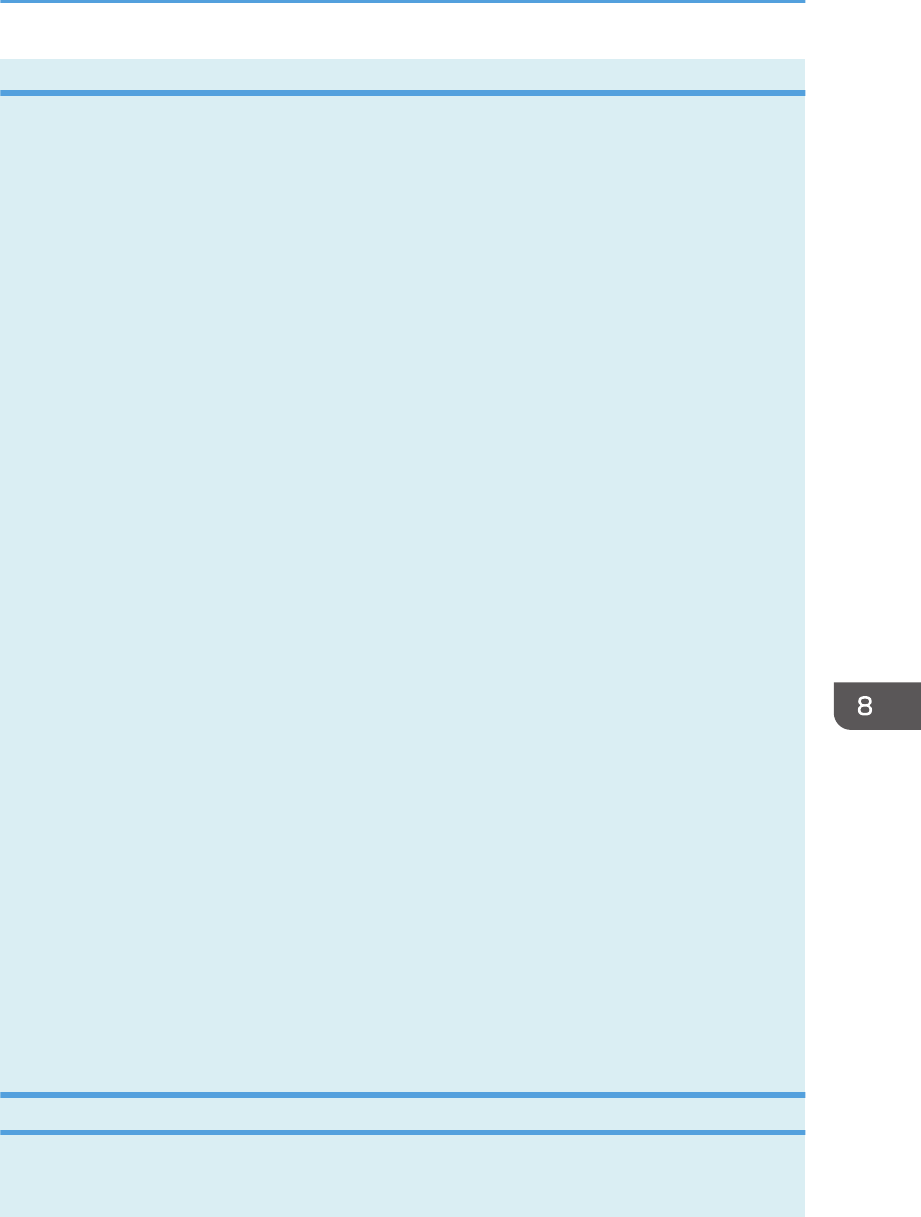
Tab Settings
This section provides a tab-by-tab overview of the machine settings that can be modified using Smart
Organizing Monitor. For more information on each setting item, see the Smart Organizing Monitor
Help.
Paper Input tab
• You can change paper size and other paper settings.
Maintenance tab
• You can adjust print starting positions.
System tab
• You can set basic functions required to use the printer. The printer can be used on factory-set
defaults, but the configuration can be changed depending on the condition of the user.
• The changed condition holds even if the printer is turned off.
• The access code can be changed on this tab.
IPv6, Network 1, Network 2 and Network 3 tabs
• You can set configurations about network connection and communication.
• The following operations are possible on these tabs:
• Checking the printer name, active protocol, and other printer information
• Making interface settings, including the timeout setting and protocol settings
• Checking or making TCP/IP settings
• Checking or making SMTP and SNMP settings
• Checking or making Alert settings
Wireless LAN Settings tab
• You can set configurations about wireless LAN network connection and communication.
• The following operations are possible on the tab:
• Checking the wireless LAN status
• Connecting wireless LAN manually
• Connecting with one touch using WPS
Printer Tab
• You can set configurations about PCL.
Printing the Configuration Page
1. On the [Start] menu, click [All Programs].
2. Click [Smart Organizing Monitor for SP xxx Series].
Using Smart Organizing Monitor
opal-p2_mf2_com_user_guide_00142141_eng.xml 201
Draft 2014/01/07
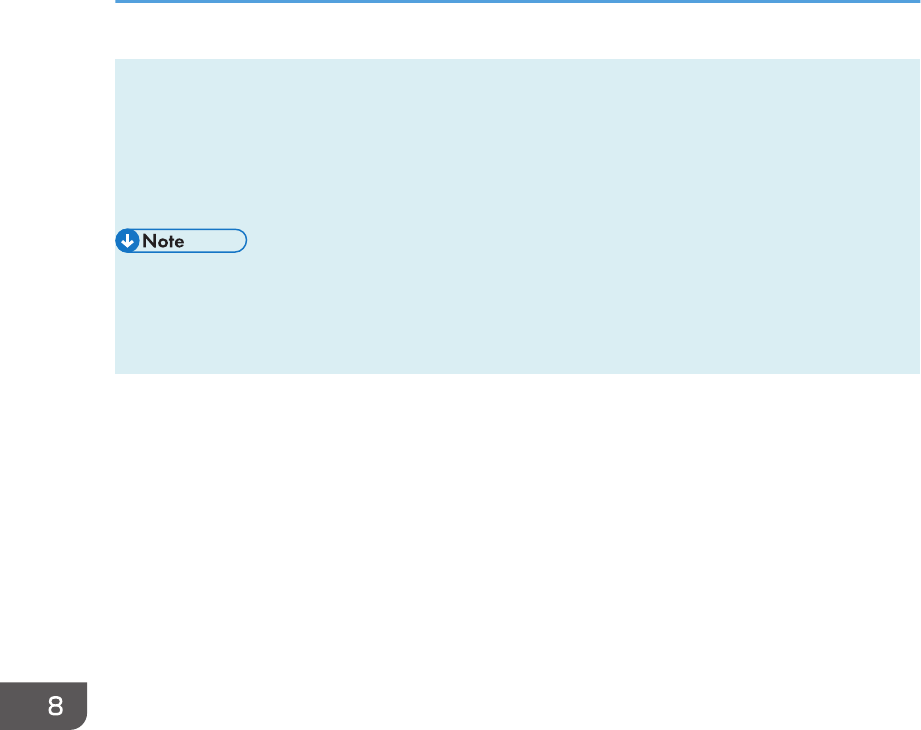
3. Click [Smart Organizing Monitor Status].
If the machine you are using is not selected, click [Connect Printer], and then select the machine's
model.
4. On the [User Tools] tab, select [Configuration Page] in the [List/Test Print] list.
5. Click [Print].
• You can check the firmware version on the configuration page. By updating the firmware, you can
correct problems as well as adding a number of new functions. For details about updating the
firmware, see the Firmware Update Guide. The Firmware Update Guide can be downloaded from
our Web site.
8. Configuring the Machine Using Utilities
202 opal-p2_mf2_com_user_guide_00142141_eng.xml
Draft 2014/01/07
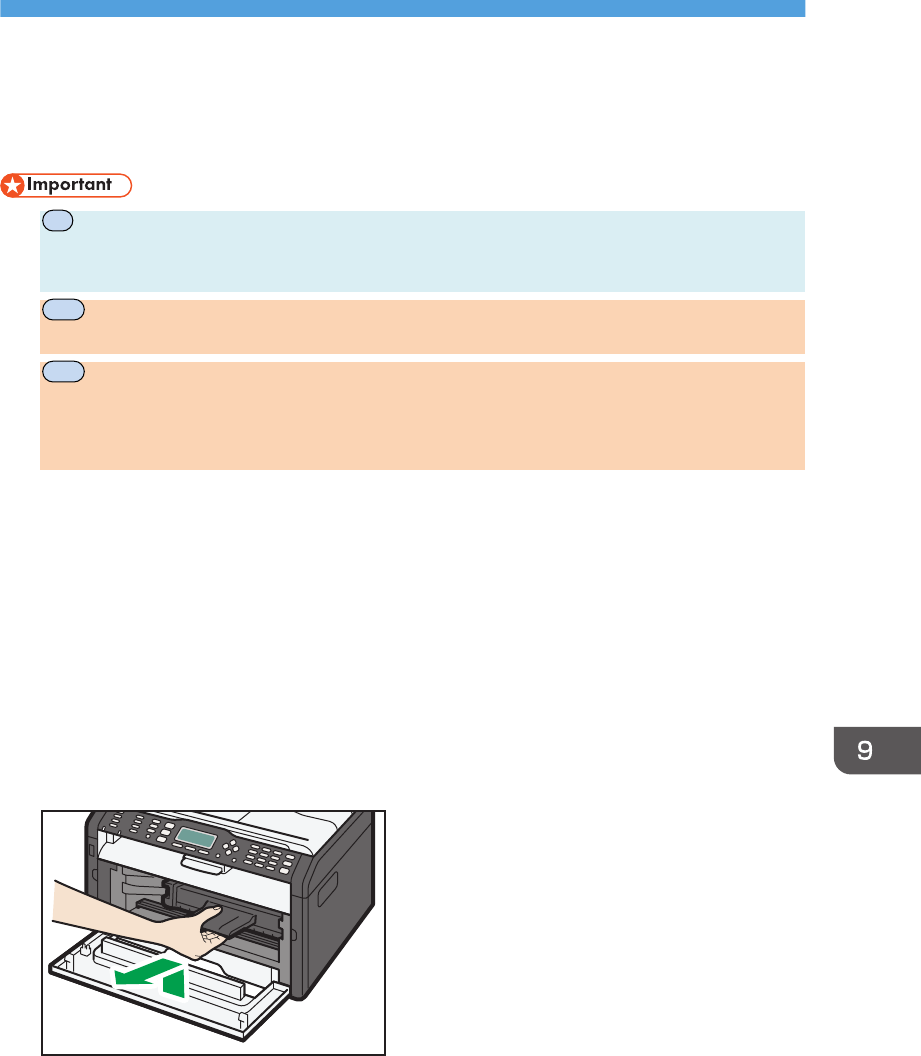
9. Maintaining the Machine
Replacing the Print Cartridge
•
P
This machine does not monitor the remaining toner level, and no message will be displayed to
prompt the user to replace the print cartridge if the machine runs out of toner. Replace the print
cartridge if the printed image suddenly becomes pale or blurred.
•
MF
Toner levels are not displayed for Type 1 and 2 models. Replace the print cartridge if the
printed image becomes pale or blurred.
•
MF
If "Replacement Required: Print Cartridge" is displayed in the control panel, replace the print
cartridge by following the procedure described below. However, this message will not be
displayed if [Toner End Option Settings] has been set to [Continue Printing]. Replace the print
cartridge if the printed image becomes pale or blurred.
• Store print cartridges in a cool dark place.
• Actual printable numbers vary depending on image volume and density, number of pages printed
at a time, paper type and size, and environmental conditions such as temperature and humidity.
Toner quality degrades over time.
• For good print quality, the manufacturer recommends that you use genuine toner from the
manufacturer.
• The manufacturer shall not be responsible for any damage or expense that might result from the use
of parts other than genuine parts from the manufacturer with your office products.
1. Open the front cover, and then carefully lower it.
2. Carefully pull out the print cartridge horizontally, holding its center.
DCT024
3. Take the new print cartridge out of the box, and then take it out of the plastic bag.
opal-p2_mf2_com_user_guide_00142143_eng.xml 203
Draft 2014/01/07
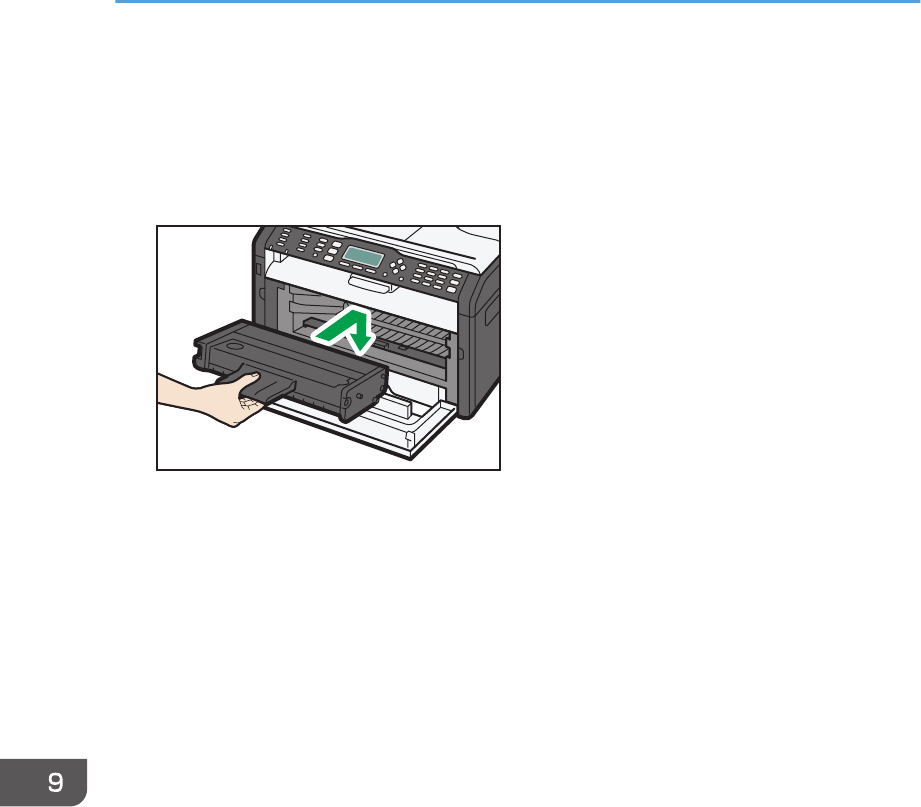
4. Hold the print cartridge and shake it from side to side five or six times.
Shake the print cartridge horizontally in the direction. The first few printed pages may appear
blurred or smeared if the cartridge has not been shaken properly.
5. Slide the print cartridge in horizontally, and then slowly push it in all the way. Finally,
push the cartridge down until it clicks into place.
DCT026
6. Carefully push up the front cover until it closes.
9. Maintaining the Machine
204 opal-p2_mf2_com_user_guide_00142143_eng.xml
Draft 2014/01/07
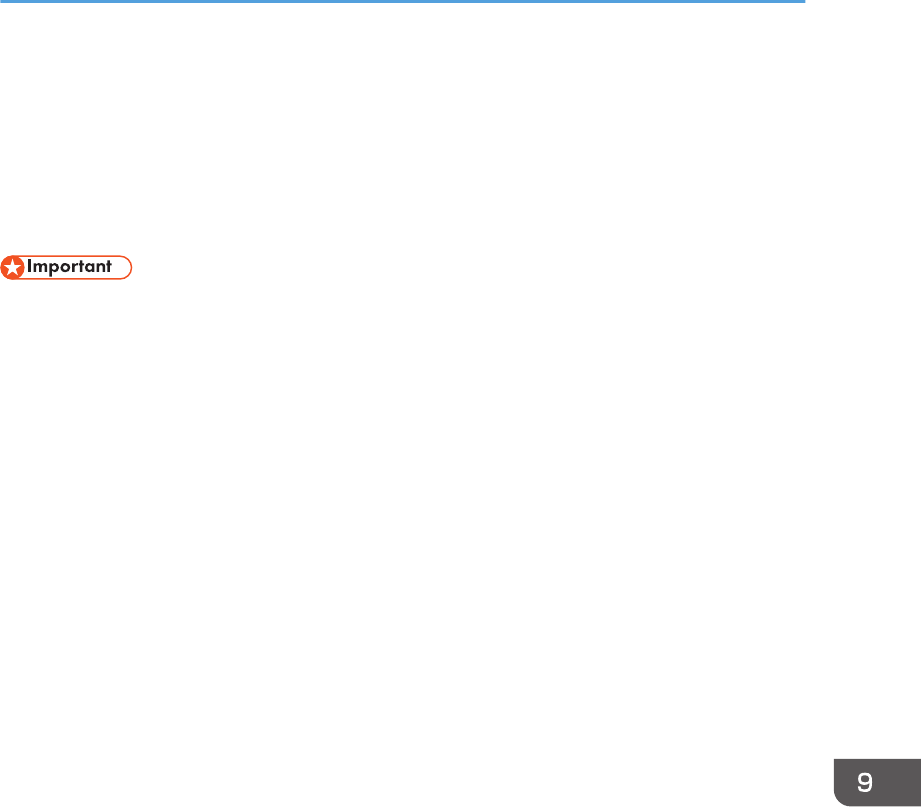
Cautions When Cleaning
Clean the machine periodically to maintain high print quality.
Dry wipe the exterior with a soft cloth. If dry wiping is not sufficient, wipe with a soft, damp cloth that has
been wrung out thoroughly. If you still cannot remove the stain or grime, use a neutral detergent, wipe
over the area with a thoroughly-wrung damp cloth, and then dry wipe the area and allow it to dry.
• To avoid deformation, discoloration, or cracking, do not use volatile chemicals, such as benzine
and thinner, or spray insecticide on the machine.
• If there is dust or grime inside the machine, wipe with a clean, dry cloth.
• You must disconnect the plug from the wall outlet at least once a year. Clean away any dust and
grime from the plug and outlet before reconnecting. Accumulated dust and grime pose a fire
hazard.
• Do not allow paper clips, staples, or other small objects to fall inside the machine.
Cautions When Cleaning
opal-p2_mf2_com_user_guide_00142144_eng.xml 205
Draft 2014/01/07
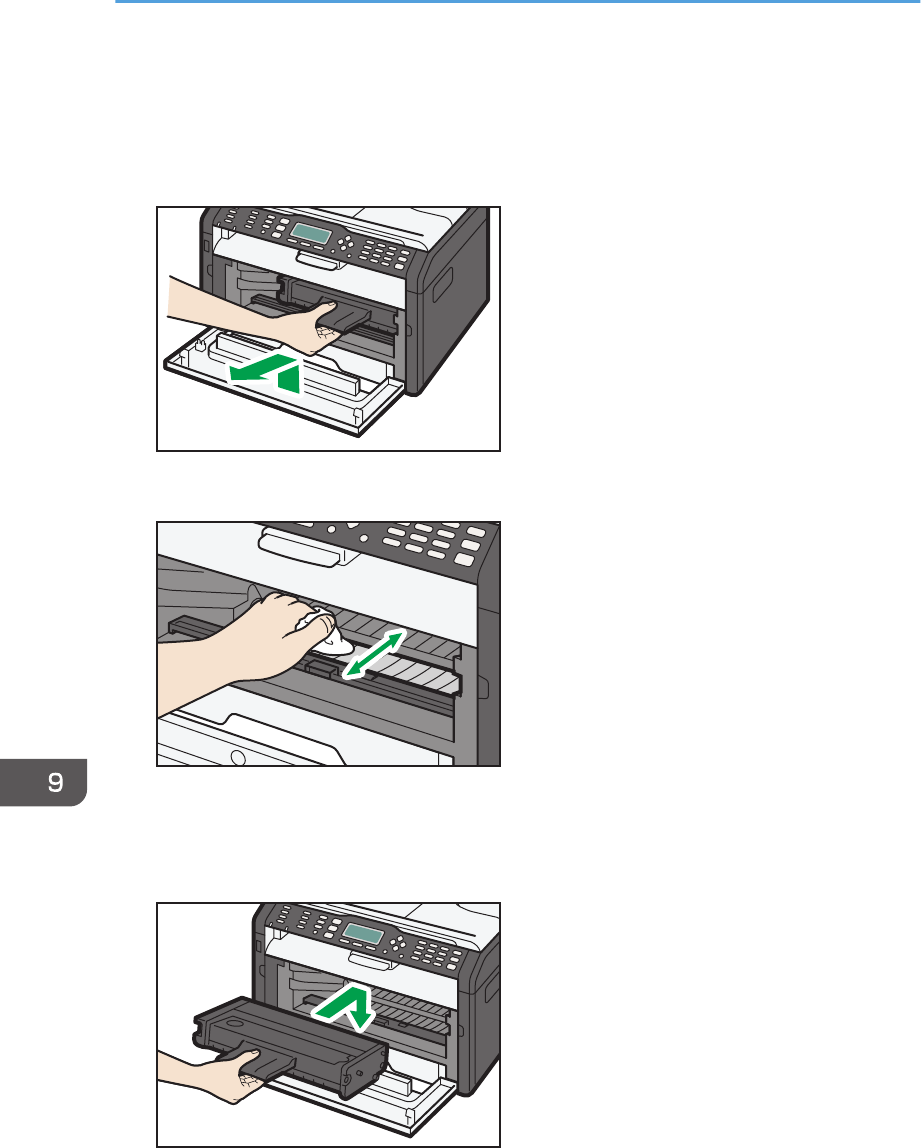
Cleaning the Inside of the Machine
1. Open the front cover, and then carefully lower it.
2. Carefully pull out the print cartridge horizontally, holding its center.
DCT024
3. Use a cloth to wipe the inside of the machine toward and away from yourself.
DCT040
Wipe carefully so as not to touch any protrusions inside the machine.
4. Slide the print cartridge in horizontally, and then slowly push it in all the way. Finally,
push the cartridge down until it clicks into place.
DCT026
5. Carefully push up the front cover until it closes.
9. Maintaining the Machine
206 opal-p2_mf2_com_user_guide_00142145_eng.xml
Draft 2014/01/07
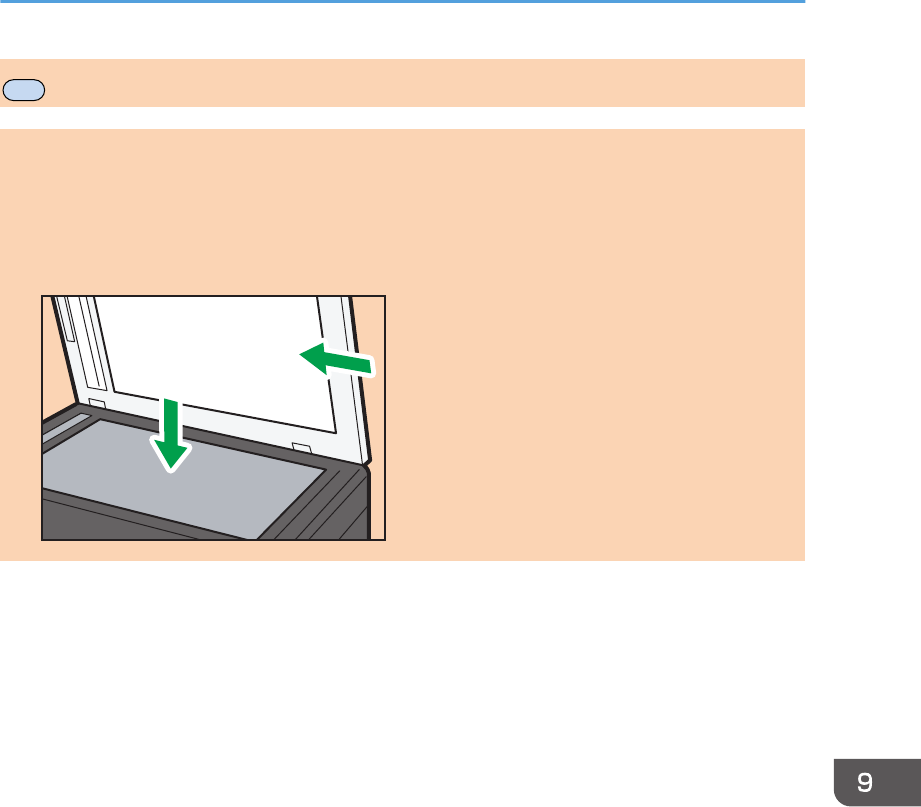
MF
Cleaning the Exposure Glass
1. Lift the exposure glass cover.
Be careful not to hold the input tray when lifting the exposure glass cover, for the tray might be
damaged.
2. Clean the parts indicated with arrows with a soft damp cloth and then wipe the same
parts with a dry cloth to remove any remaining moisture.
DCT008
Cleaning the Exposure Glass
opal-p2_mf2_com_user_guide_00142146_eng.xml 207
Draft 2014/01/07
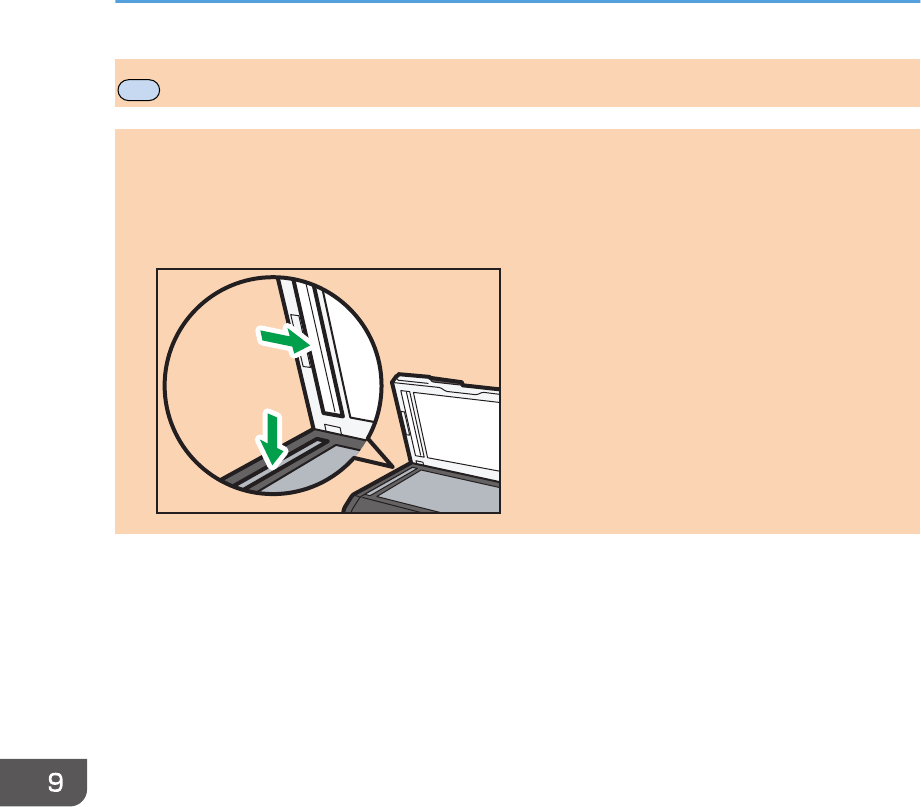
MF
Cleaning the Auto Document Feeder
1. Lift the ADF.
Be careful not to hold the input tray when lifting the ADF, for the tray might be damaged.
2. Clean the parts indicated with arrows with a soft damp cloth and then wipe the same
parts with a dry cloth to remove any remaining moisture.
DCT009
9. Maintaining the Machine
208 opal-p2_mf2_com_user_guide_00142147_eng.xml
Draft 2014/01/07
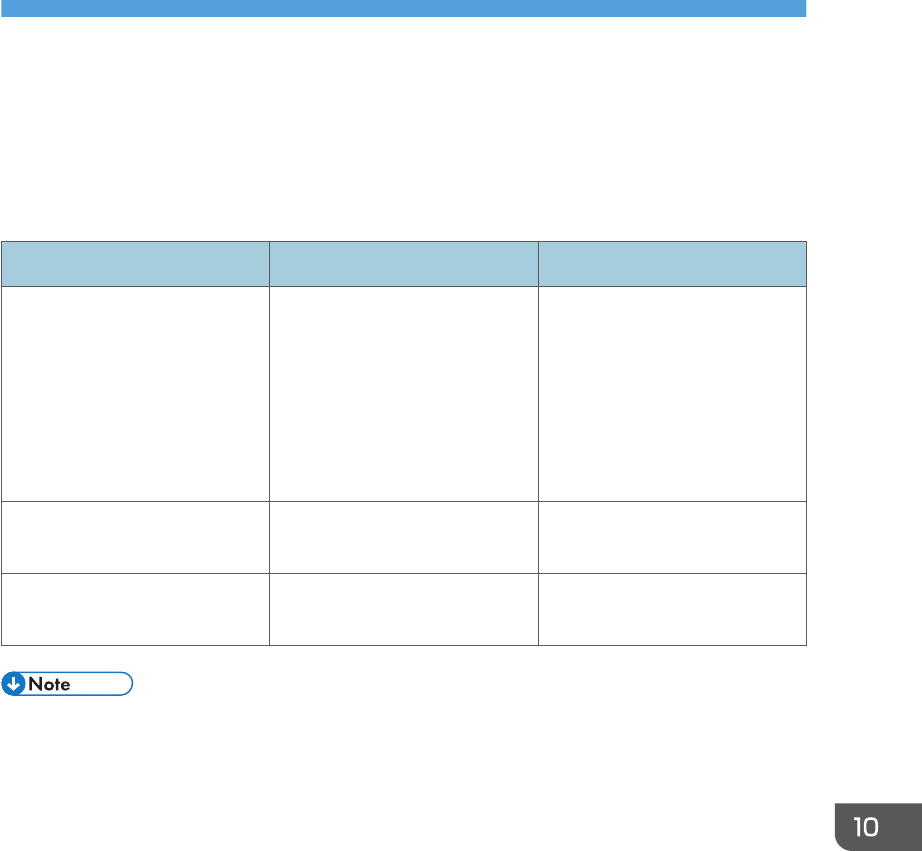
10. Troubleshooting
Common Problems
This section describes how to troubleshoot common problems that may occur while operating the
machine.
Problem Possible cause Solution
The machine does not turn on. The power cord is not
connected properly.
• Make sure that the power
plug is firmly inserted into
the wall outlet.
• Make sure that the wall
outlet is not defective by
connecting another
working device.
Pages are not printed. The USB cable or Ethernet
cable is not connected correctly.
Reconnect the USB cable or
Ethernet cable.
Strange noise is heard. The consumable is not properly
installed.
Check that the consumable is
properly installed.
• If any of these problems persist, turn off the power, pull out the power cord, and contact your sales
or service representative.
opal-p2_mf2_com_user_guide_00142149_eng.xml 209
Draft 2014/01/07

Paper Feed Problems
If the machine is operating but paper will not feed or paper jams occur frequently, check the condition of
the machine and paper.
Problem Solution
Paper does not feed smoothly. • Use supported types of paper. See page 39 "Supported
Paper".
• Load paper correctly, making sure that the paper guides
are properly adjusted. See page 45 "Loading Paper".
• If the paper is curled, straighten the paper.
• Take out the paper from tray and fan it well. Then,
reverse the top and bottom of the paper, and put it in the
tray.
Paper jams occur frequently. • If there are gaps between the paper and the paper
guides, adjust the paper guides to remove the gaps.
• Avoid printing on both sides of paper when printing
images that contain large areas of solid color, which
consume a lot of toner.
• Use supported types of paper. See page 39 "Supported
Paper".
• Load paper only as high as the upper limit markings on
the paper guide.
Multiple sheets of paper are fed at
one time.
• Fan the paper well before loading. Also make sure that
the edges are even by tapping the stack on a flat surface
such as a desk.
• Make sure that the paper guides are in the right position.
• Use supported types of paper. See page 39 "Supported
Paper".
• Load paper only as high as the upper limit markings on
the paper guide.
• Check that paper was not added while there was still
some left in the tray.
Only add paper when there is none left in the tray.
Paper gets wrinkles. • Paper is damp. Use paper that has been stored properly.
• Paper is too thin. See page 39 "Supported Paper".
10. Troubleshooting
210 opal-p2_mf2_com_user_guide_00142150_eng.xml
Draft 2014/01/07
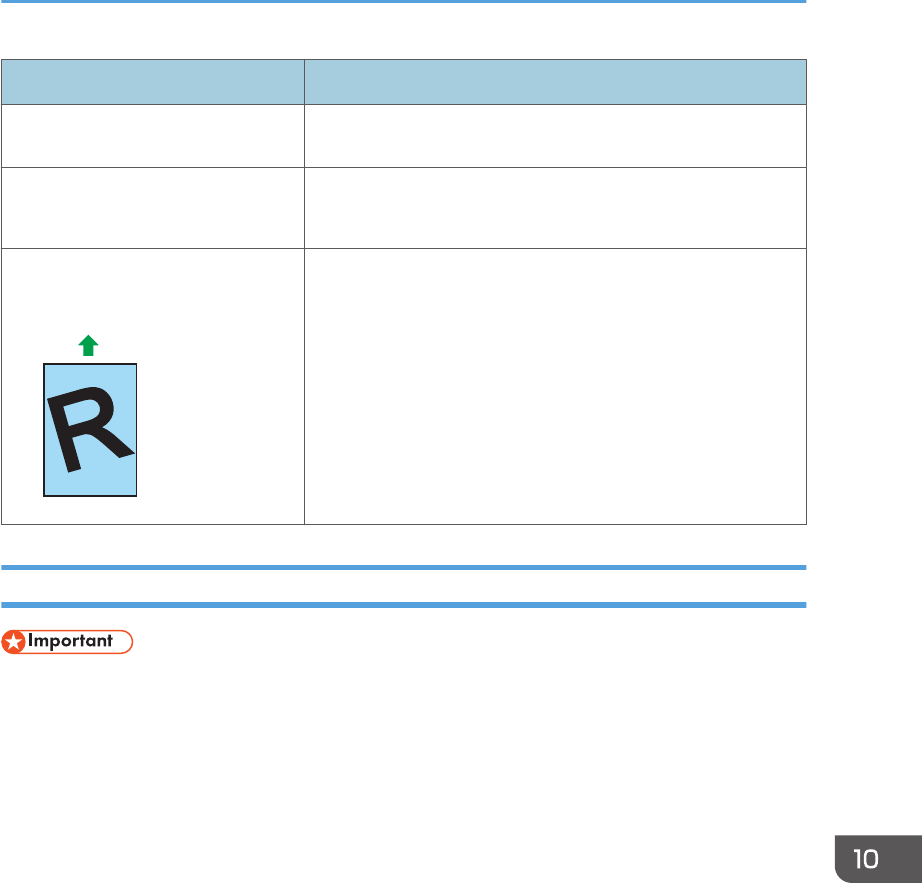
Problem Solution
• If there are gaps between the paper and the paper
guides, adjust the paper guides to remove the gaps.
The printed paper is curled. • Load the paper upside down in the input tray.
• Paper is damp. Use paper that has been stored properly.
Images are printed diagonally to the
pages.
CER091
If there are gaps between the paper and the paper guides,
adjust the paper guides to remove the gaps.
Removing Printing Jams
• Jammed paper may be covered in toner. Be careful not to get toner on your hands or clothes.
• Toner on prints made immediately after clearing a paper jam may be insufficiently fused and can
smudge. Make test prints until smudges no longer appear.
• Do not forcefully remove jammed paper, as it may tear. Torn pieces remaining inside the machine
will cause further jams and possibly damage the machine.
• Paper jams can cause pages to be lost. Check your print job for missing pages and reprint any
pages that did not print out.
• The jammed paper may be ejected automatically when opening and then closing the front cover or
when turning the power off and then back on.
Paper Feed Problems
opal-p2_mf2_com_user_guide_00142150_eng.xml 211
Draft 2014/01/07
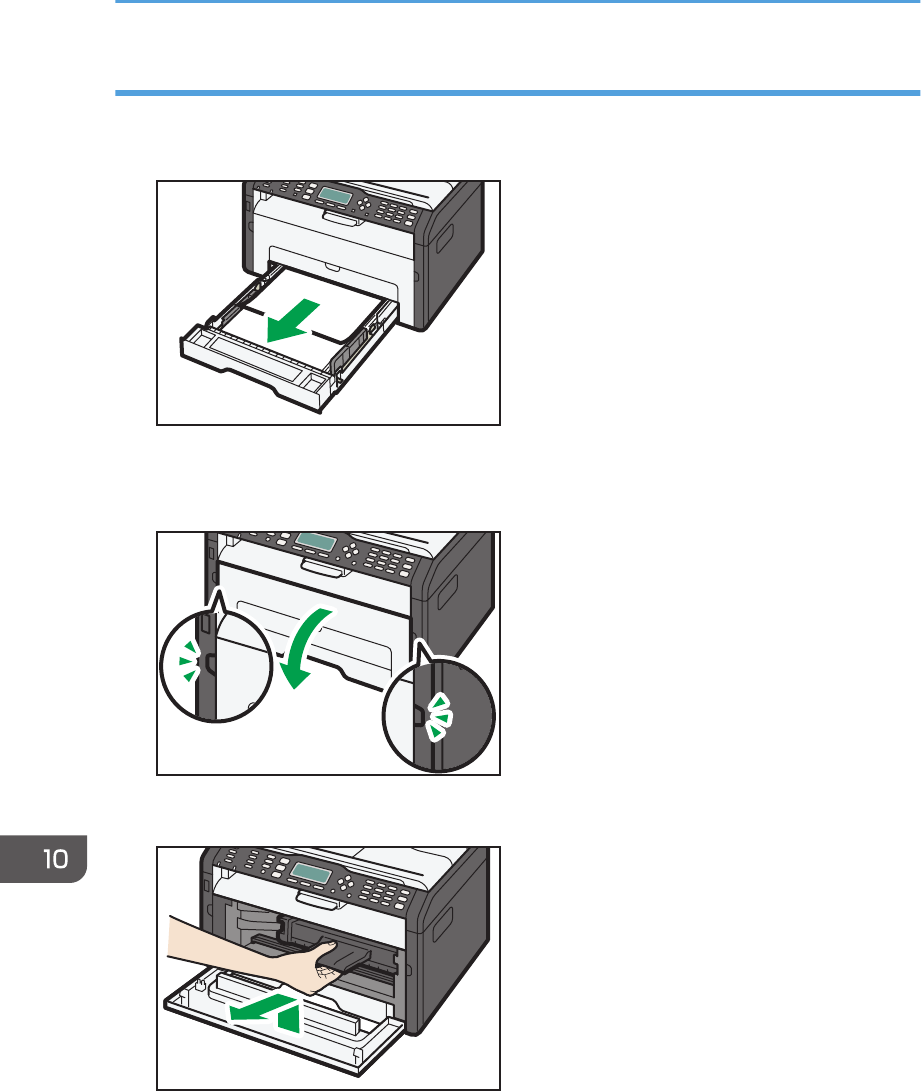
Removing Jammed Paper from Tray 1
1. Pull Tray 1 halfway out, and check for jammed paper. If there is jammed paper, remove it
carefully.
DCT012
2. Carefully slide Tray 1 back in until it stops.
3. Open the front cover, and then carefully lower it.
DCT027
4. Carefully pull out the print cartridge horizontally, holding its center.
DCT024
• Do not shake the removed print cartridge. Doing so can cause remaining toner to leak.
• Place the print cartridge on paper or similar material to avoid dirtying your workspace.
10. Troubleshooting
212 opal-p2_mf2_com_user_guide_00142150_eng.xml
Draft 2014/01/07
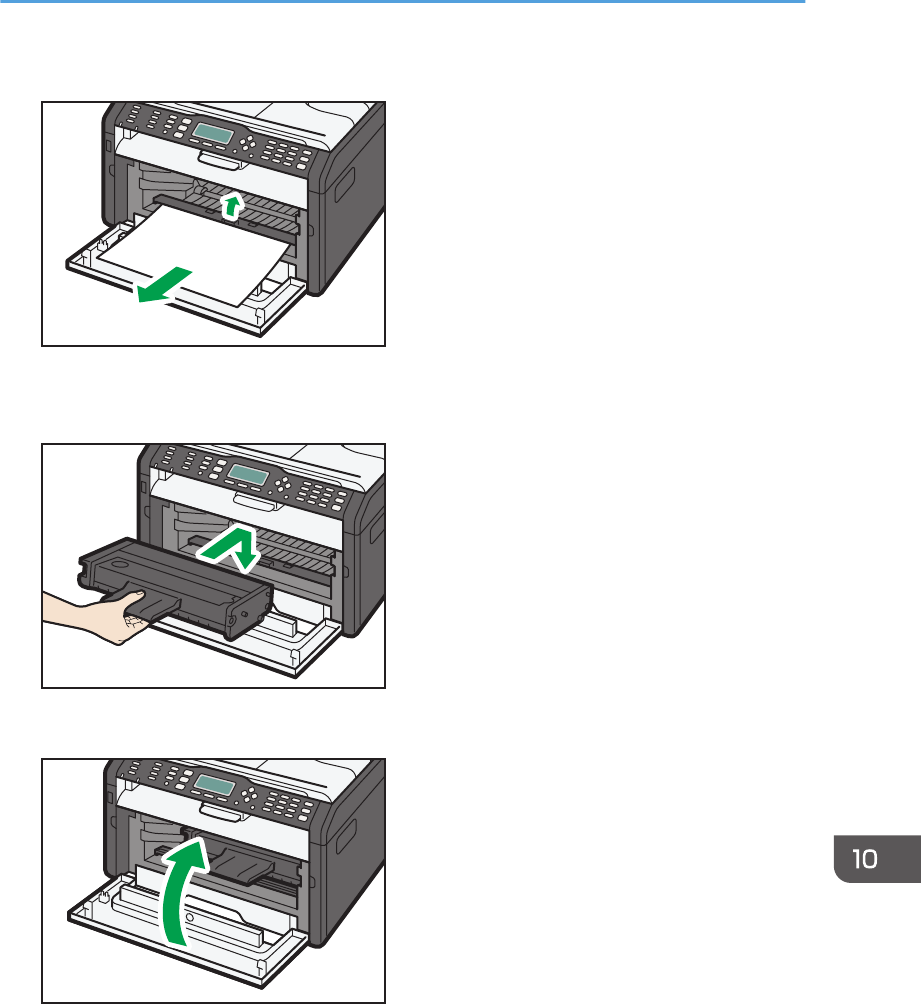
5. Lifting the guide plate, remove the jammed paper carefully.
DCT025
6. Slide the print cartridge in horizontally, and then slowly push it in all the way. Finally,
push the cartridge down until it clicks into place.
DCT026
7. Carefully push up the front cover until it closes.
DCT028
If the error display continues to appear, perform the procedure described in "Opening the Rear
Cover to Remove Jammed Paper".
Paper Feed Problems
opal-p2_mf2_com_user_guide_00142150_eng.xml 213
Draft 2014/01/07
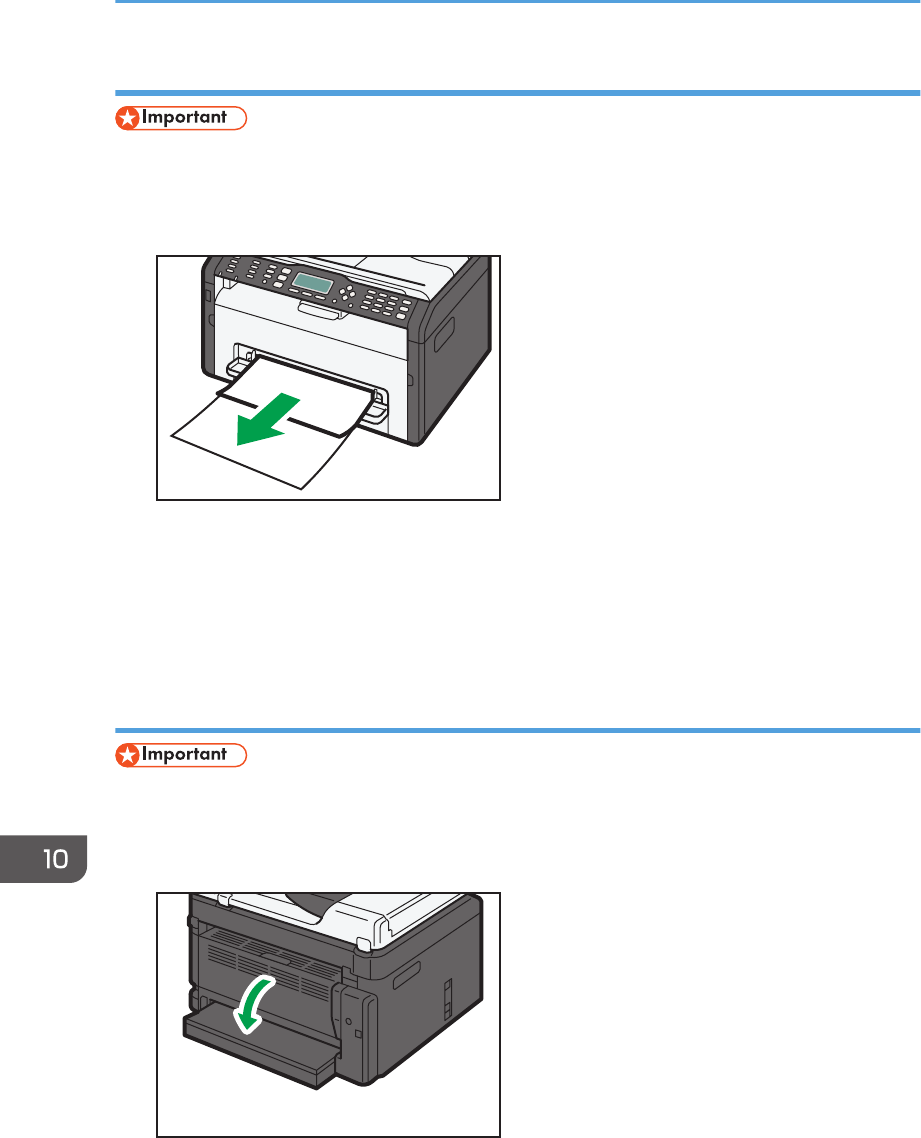
Removing Jammed Paper from the Bypass Tray
• Since the temperature around the guide is high, wait for it to cool before checking for jammed
paper.
1. If paper is jammed in the bypass tray input area, remove the jammed paper carefully.
DCT015
2. Close the bypass tray.
3. Follow Steps 3 to 7 in "Removing Jammed Paper from Tray 1".
If the error display continues to appear, perform the procedure described in "Opening the Rear
Cover to Remove Jammed Paper".
Opening the Rear Cover to Remove Jammed Paper
• Since the temperature around the guide is high, wait for it to cool before checking for jammed
paper.
1. Open the rear cover.
DCT022
10. Troubleshooting
214 opal-p2_mf2_com_user_guide_00142150_eng.xml
Draft 2014/01/07
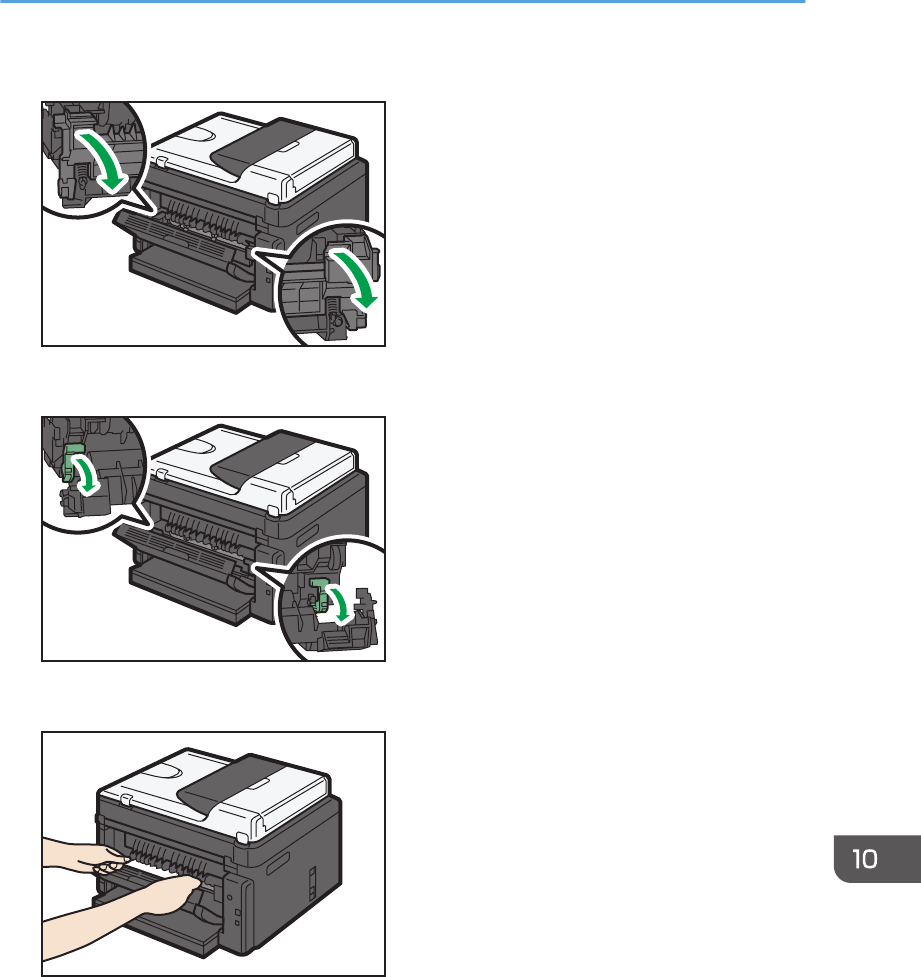
2. Open the fusing cover.
DCT035
3. Push the levers on the sides down with your thumbs.
DCT036
4. Remove the jammed paper carefully.
DCT068
5. Push the levers on the sides up with your thumbs.
6. Close the fusing cover.
Paper Feed Problems
opal-p2_mf2_com_user_guide_00142150_eng.xml 215
Draft 2014/01/07
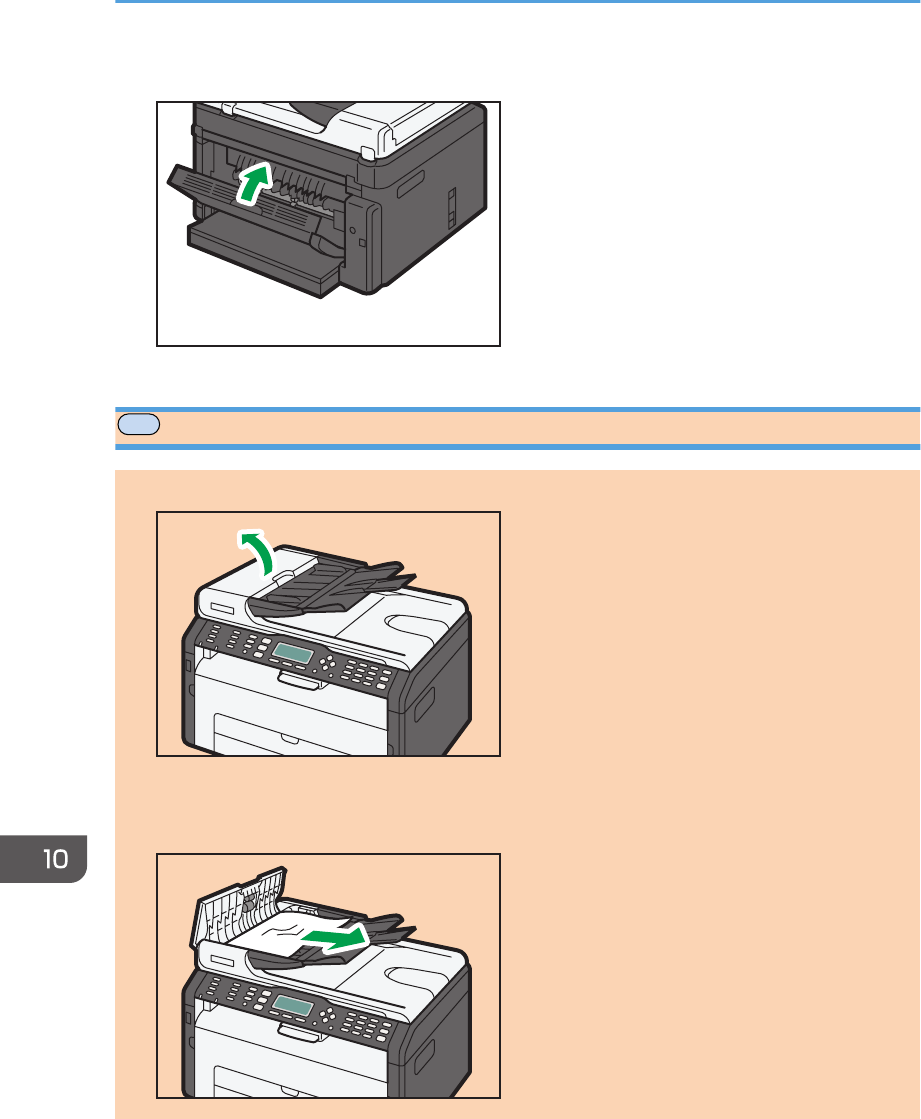
7. Close the rear cover.
DCT023
MF
Removing Scanning Jams
1. Open the ADF cover.
DCT019
2. Gently pull the jammed original to remove it. Be careful not to pull the original too hard,
as it may tear.
DCT021
10. Troubleshooting
216 opal-p2_mf2_com_user_guide_00142150_eng.xml
Draft 2014/01/07
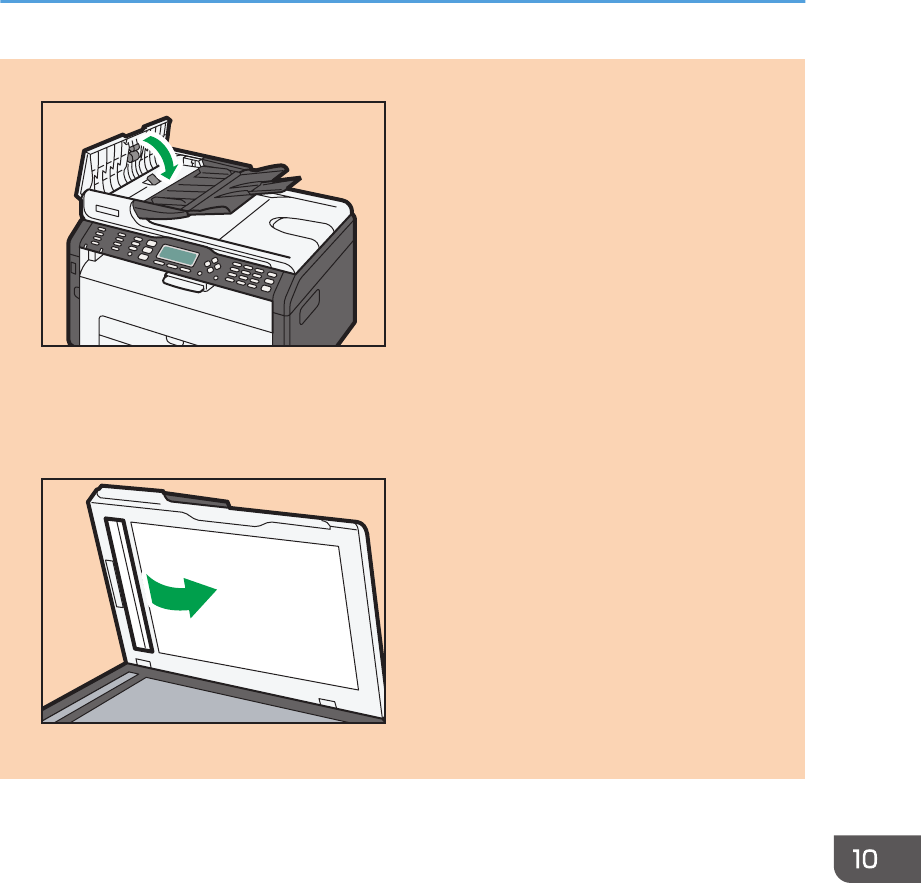
3. Close the ADF cover.
DCT020
4. Lift the ADF, and if there is original remaining in the ADF, gently pull the jammed original
to remove it.
Be careful not to hold the input tray when lifting the ADF, for the tray might be damaged.
DCT010
5. Close the ADF.
Paper Feed Problems
opal-p2_mf2_com_user_guide_00142150_eng.xml 217
Draft 2014/01/07
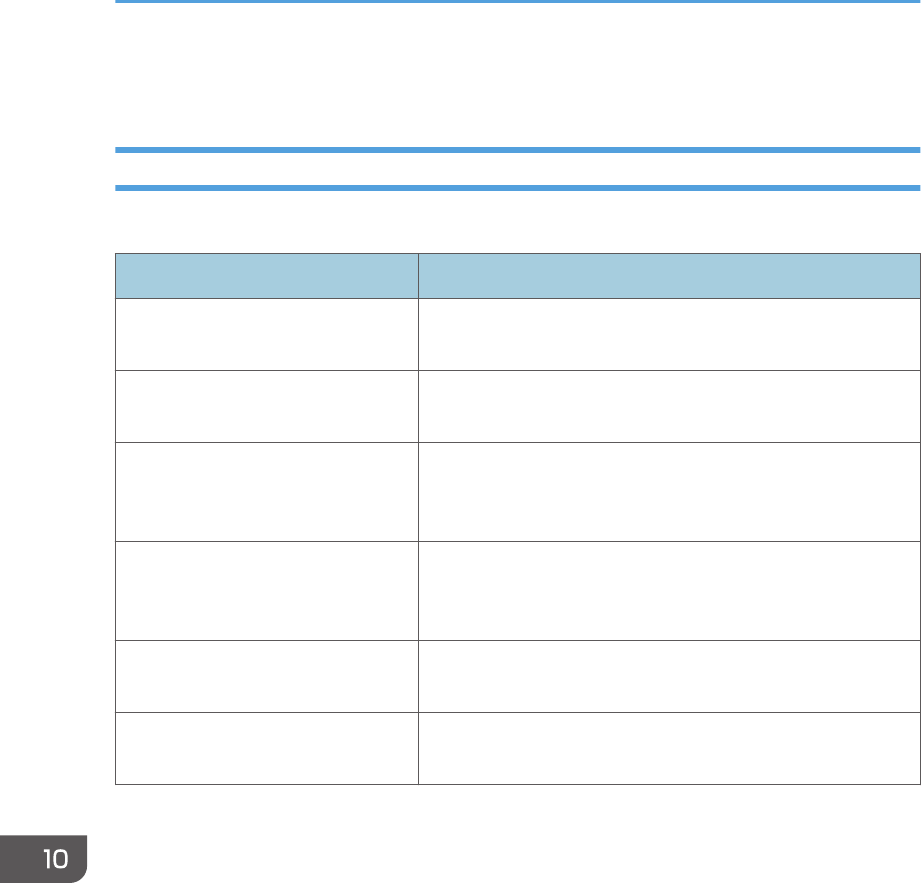
Print Quality Problems
Checking the Condition of the Machine
If there is a problem with the quality of printing, first check the condition of the machine.
Possible Cause Solution
There is a problem with the
machine's location.
Make sure that the machine is on a level surface. Place the
machine where it will not be subject to vibration or shock.
Unsupported types of paper is used. Make sure that the paper being used is supported by the
machine. See page 39 "Supported Paper".
The paper type setting is incorrect.
Make sure that the paper type setting of the printer driver
matches the type of paper loaded. See page 39 "Supported
Paper".
A non-genuine print cartridges is
being used.
Non-genuine print cartridges reduce print quality and can
cause malfunctions. Use genuine print cartridges only. See
page 239 "Consumables".
An old print cartridges is being used. Print cartridges should be opened before their expiration date
and used within six months of being opened.
The machine is dirty. See page 203 "Maintaining the Machine", and clean the
machine as required.
10. Troubleshooting
218 opal-p2_mf2_com_user_guide_00142151_eng.xml
Draft 2014/01/07
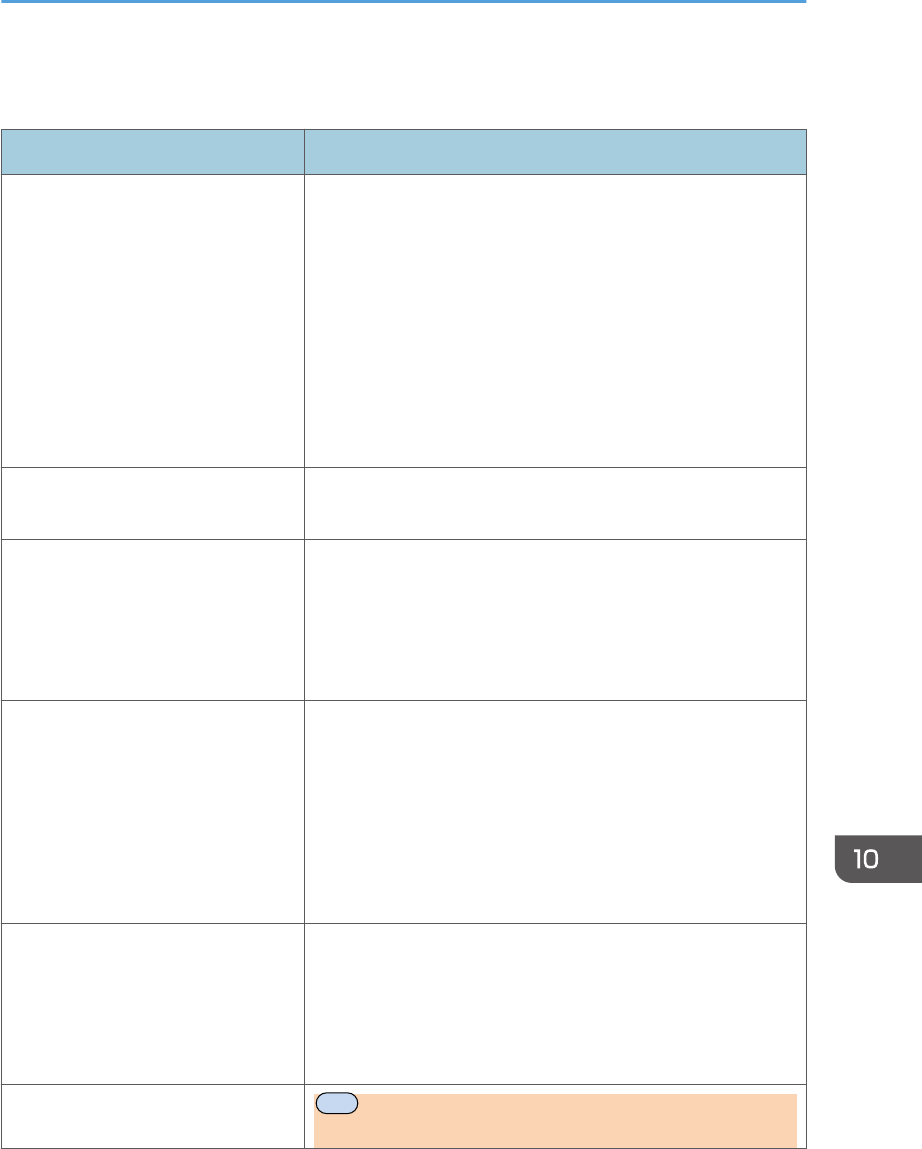
Printer Problems
Problem Solution
An error occurs. If an error occurs when printing, change the computer or
printer driver settings.
• Check the printer icon name does not exceed 32
alphanumeric characters. If it does, shorten it.
• Check whether other applications are operating.
Close any other applications, as they may be interfering
with printing. If the problem is not resolved, close
unneeded processes too.
• Check that the latest printer driver is being used.
A print job is canceled. • Set [I/O Timeout] to a larger value than the current
settings.
There is considerable delay between
the print start command and actual
printing.
• Processing time depends on data volume. High volume
data, such as graphics-heavy documents, take longer to
process. Wait for a while.
• To speed up printing, reduce the printing resolution using
the printer driver.
The whole printout is blurred. • Paper is damp. Use paper that has been stored properly.
See page 39 "Supported Paper".
• If you enable [Toner Save:], printing is generally less
dense.
• Condensation may have collected. If rapid change in
temperature or humidity occurs, use this machine only
after it has acclimatized.
Cannot print properly when using a
certain application, or cannot print
image data properly.
Some characters are printed faintly
or not printed.
• Change the print quality settings.
The print position is misaligned.
MF
Specify [Printer Registration] in [System Settings] to
adjust the print position.
Printer Problems
opal-p2_mf2_com_user_guide_00142152_eng.xml 219
Draft 2014/01/07
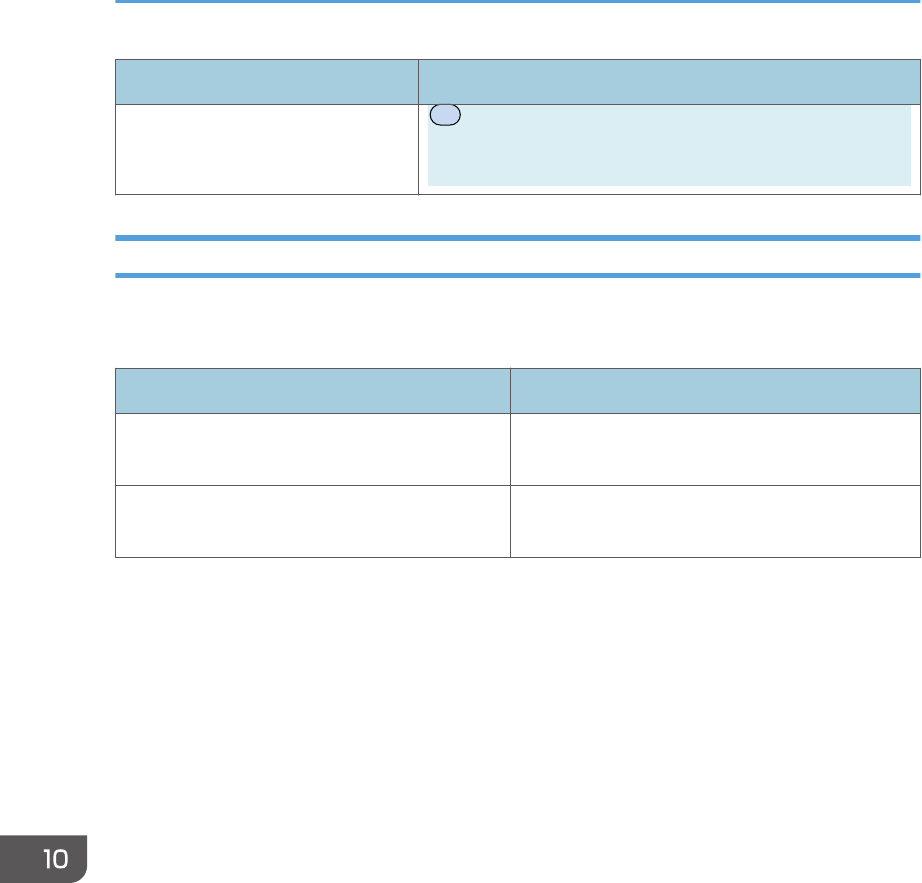
Problem Solution
P
Adjust the print position by specifying [Registration: Tray
1] or [Registration: Bypass Tray] on the [Maintenance] tab in
Smart Organizing Monitor.
Print Positions Do Not Match Display Positions
If the position of items on the printed page differs from the position displayed on the computer screen,
the cause may be one of the following.
Possible Cause Solution
Page layout settings are not configured properly. Check that the page layout settings are properly
configured in the application.
The paper size setting does not match the paper
loaded.
Check whether the paper size specified on the
printer driver matches that of the loaded paper.
10. Troubleshooting
220 opal-p2_mf2_com_user_guide_00142152_eng.xml
Draft 2014/01/07
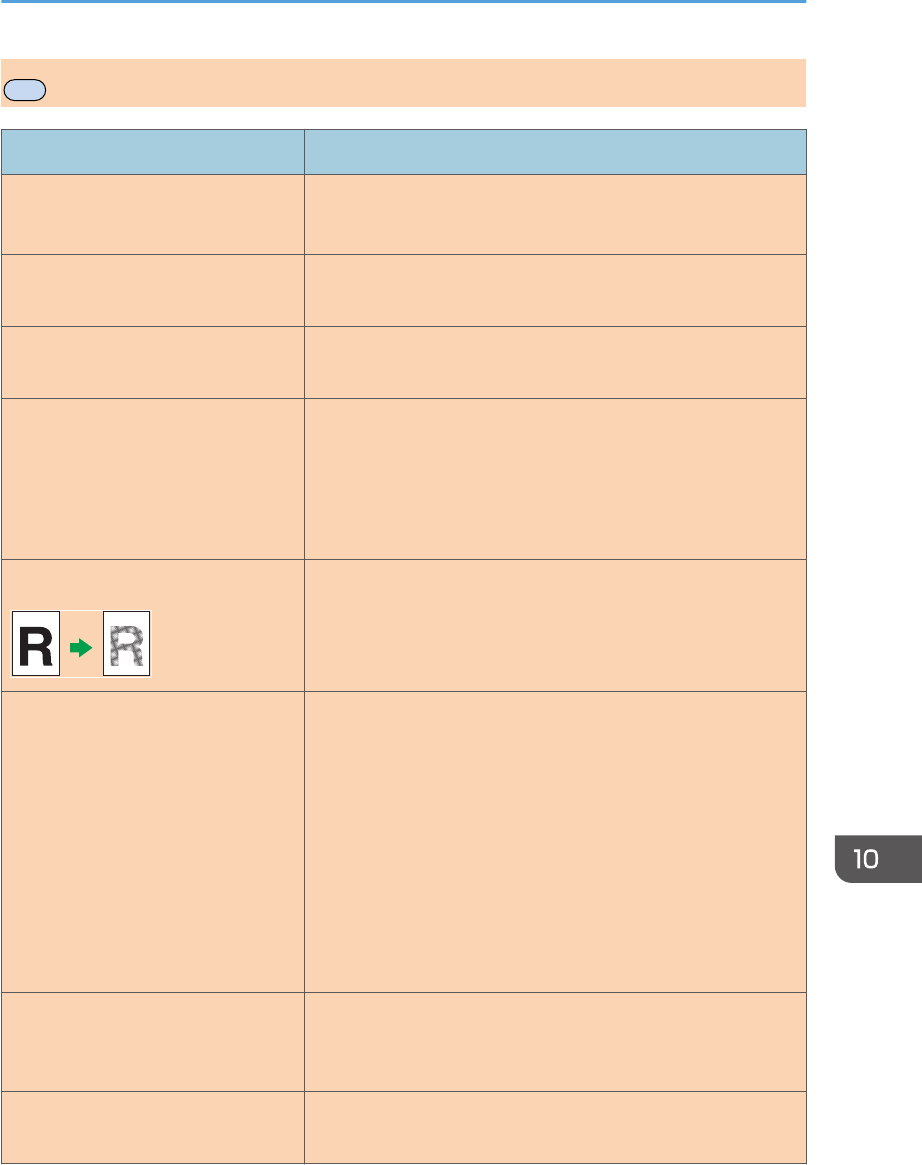
MF
Copier Problems
Problem Solution
Photocopied paper is blank. The original was placed with the front and back reversed.
See page 54 "Placing Originals".
Copied pages are too dark or too
light.
Adjust the image density.
Copied pages do not look the same
as the originals.
Select the correct scan mode according to the type of original.
Black spots appear when
photocopying a photographic print.
The original may have stuck to the exposure glass due to high
humidity.
Place the original on the exposure glass, and then place two
or three sheets of white paper on top of it. Leave the exposure
glass cover open when copying.
A moire pattern is produced. The original probably has heavily lined or dotted areas.
Switching the setting for image quality between [Photo] and
[Mixed] may eliminate the moire pattern.
Photocopied paper is dirty. • Image density is too high.
Adjust the image density.
• Toner on the printed surface is not dry.
Do not touch printed surfaces immediately after copying.
Remove freshly printed sheets one by one, taking care
not to touch printed areas.
• The scanning part is dirty.
• Before placing originals on the exposure glass, make
sure that toner or correction fluid is dry.
When copying from the exposure
glass, the print area of the copy is
out of alignment with the original.
Place the original copy side down, making sure that it is
aligned to the rear left corner and pressed flat against the
exposure glass.
The paper size setting does not
match the paper loaded.
Check whether the paper size specified on the machine
matches that of the loaded paper.
Copier Problems
opal-p2_mf2_com_user_guide_00142153_eng.xml 221
Draft 2014/01/07
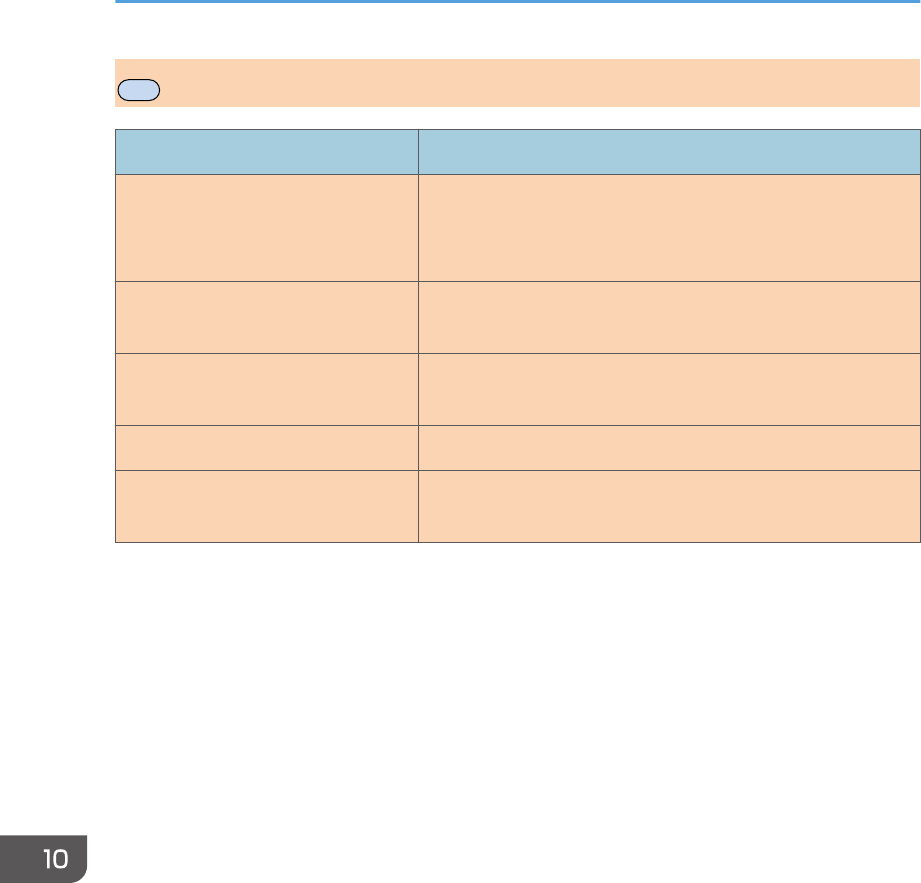
MF
Scanner Problems
Problem Solution
The scanned image is dirty. • The scanning part is dirty.
• Before placing originals on the exposure glass, make
sure that toner or correction fluid is dry.
The scanned image is distorted or
out of position.
The original was moved during scanning. Do not move the
original during scanning.
The scanned image is upside down. The original was placed upside down. Place the original in the
correct orientation. See page 54 "Placing Originals".
The scanned image is blank. The original was placed with the front and back reversed.
The scanned image is too dark or
too light.
Adjust the image density.
10. Troubleshooting
222 opal-p2_mf2_com_user_guide_00142154_eng.xml
Draft 2014/01/07
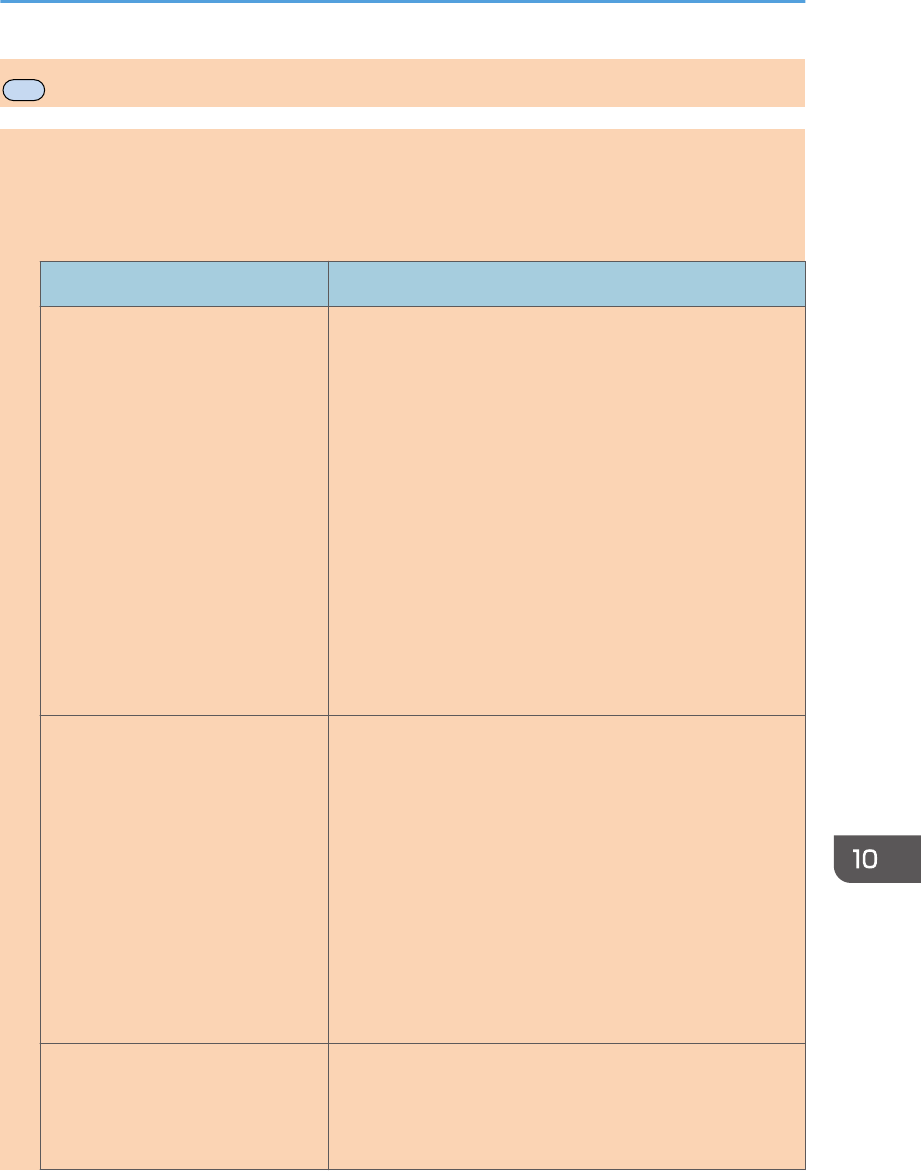
MF
Fax Problems
When an error code appears on the fax journal or TX status report
The table below describes the meaning of error codes that appear under "Status" on the fax journal
or TX status report, and what to do when a particular error code appears.
TX Status Report
Error Code Solution
Err:1) The line was not connected correctly. The fax transmission
did not finish successfully. There was a problem with either
the transmission or reception.
• Check that the telephone line is properly connected to
the machine.
• Disconnect the telephone line from the machine, and
connect a standard telephone in its place. Check that
you can make calls using the telephone. If you cannot
make calls this way, contact your telephone company.
• If the problem persists, contact your sales or service
representative.
Dial tone could not be detected.
• Set [Dial Tone Detect] to [Do not Detect].
Err:2)
Err:3)
Err:4)
Dial fails when trying to send faxes.
• Check that the fax number you dialed is correct.
• Check that the destination is a fax machine.
• Check that the line is not busy.
• You may need to insert a pause between dial digits.
Press the [Pause/Redial] key after, for example, the
area code.
• Check that [PSTN / PBX] under [Admin. Tools] is set
properly for your connection method to the telephone
network. See page 159 "Administrator Settings".
Err:5) The [Clear/Stop] key has been pressed while transmitting/
receiving faxes. Send the fax again. When the error
reoccurs even if the [Clear/Stop] key has not been
pressed, consult your service representative.
Fax Problems
opal-p2_mf2_com_user_guide_00142155_eng.xml 223
Draft 2014/01/07
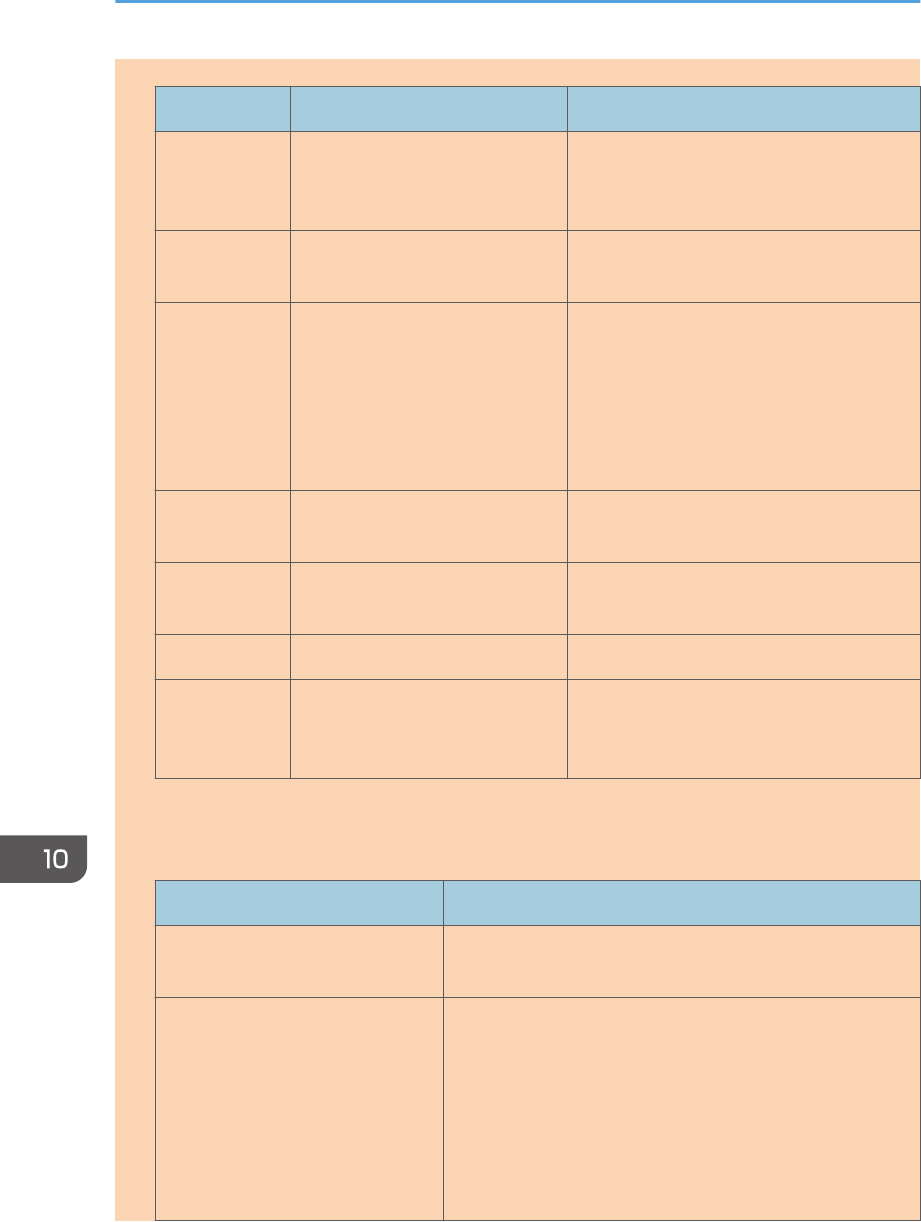
Fax Journal
Error Code Cause Solution
0001 The recipient’s fax machine does
not support G3 standard.
Select a transmission speed supported by
the recipient fax machine, and resend the
fax.
0071 Memory is full. Print, send, or delete the jobs stored in the
memory.
0080 The recipient’s fax machine did
not respond within 35 seconds.
Send the fax again. Contact the recipient
and ask them to check that their fax
machine is working properly.
To send a fax to an international
destination, enter a pause before the
recipient's fax/telephone number.
008D The recipient’s fax machine is out
of paper.
Contact the recipient and ask them to load
paper.
00A0 Sending fax was canceled
manually.
Send the fax again.
00A1 The original is jammed. Remove the jammed original.
00FF Redialing failed. Make sure the recipient’s fax number is
correct, and check that the telephone line
is properly connected.
When other problems occur
The table below describes how to troubleshoot problems that do not produce an error code.
Problem Solution
Cannot send faxes. Check the error code, and then perform the appropriate
procedure to resolve the problem.
Cannot receive faxes even when
sending them is possible.
• A print cartridge is empty. Replace the print cartridge.
See page 203 "Replacing the Print Cartridge".
• Tray 1 is empty. Load paper in Tray 1. See page 45
"Loading Paper".
• If fax reception mode is manual mode, you must
receive the fax manually. See page 124 "Receiving a
Fax".
10. Troubleshooting
224 opal-p2_mf2_com_user_guide_00142155_eng.xml
Draft 2014/01/07
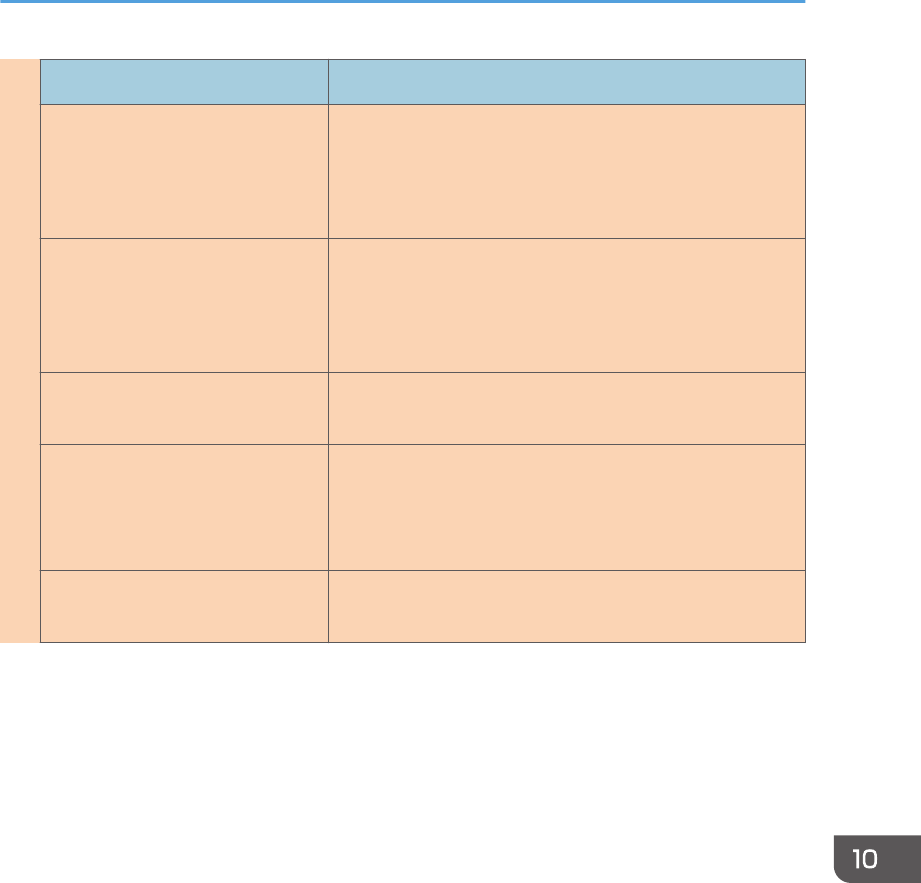
Problem Solution
Cannot print received faxes. • Tray 1 is empty. Load paper in Tray 1. See page 45
"Loading Paper".
• Tray 1 does not contain paper of the right size. Load
paper of the right size in Tray 1.
Faxes you sent appear spotty or
dirty when received.
• The exposure glass or ADF is dirty. See page 208
"Cleaning the Auto Document Feeder".
• Before placing originals on the exposure glass, make
sure that ink or correction fluid is dry.
A fax you sent appears blank
when received.
The original was placed upside down. Place the original in
the correct orientation. See page 54 "Placing Originals".
Dirty spots may appear, or an
image from the reverse side shows
through copy received by the
recipient.
Image density is too high. Adjust the image density.
Dial fails when trying to send
faxes.
Check the error code, and then perform the appropriate
procedure to resolve the problem.
Fax Problems
opal-p2_mf2_com_user_guide_00142155_eng.xml 225
Draft 2014/01/07
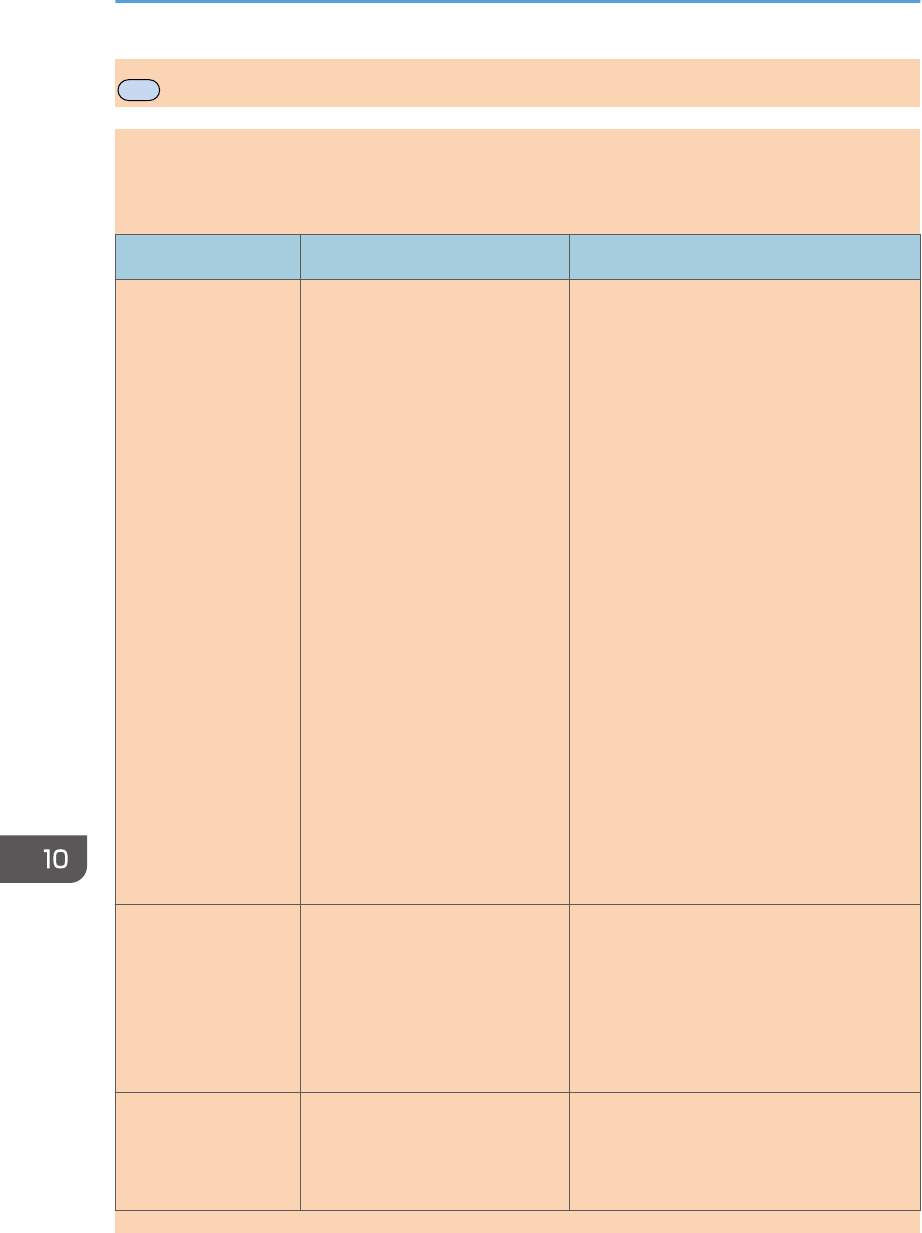
MF
Error and Status Messages on the Screen
Messages are listed in alphabetical order in the table below.
"X" indicates the parts of the messages that appear differently depending on a specific situation, such as
the paper sizes, paper types, or tray names.
Message Causes Solutions
2XXX14 The machine was not able to
print the received fax, or the
machine's memory reached
capacity while receiving a fax
because the document was too
large.
• The paper tray was empty. Load
paper in the paper tray. See page 45
"Loading Paper".
• The paper tray did not contain A4,
Letter, or Legal size paper. Load valid
size paper in the tray, and configure
the paper size settings under [System
Settings] accordingly.
• A cover or tray was open. Close the
cover or tray.
• There was a paper jam. Remove the
jammed paper. See page 210
"Paper Feed Problems".
• A print cartridge was empty. Replace
the print cartridge. See page 203
"Replacing the Print Cartridge".
• The received fax was too large. Ask
the sender to resend the document in
parts as several smaller individual
faxes, or to send at a lower
resolution.
ADF Orig. Misfeed
Open ADF Cover
and remove paper.
An original has been jammed
inside the ADF.
• Remove jammed originals, and then
place them again. See page 210
"Paper Feed Problems".
• Check the originals are suitable for
scanning. See page 54 "Placing
Originals".
Available: IDCard
Copy A4/A5/
A6/8.5x11/5.5x8.
5
ID card copy could not be
performed because the tray
does not contain the valid size
Specify the A4, A5, A6, 8.5 × 11 or
5.5x8.5 or Letter size paper for the tray
selected for printing copies. See page 145
"System Settings".
10. Troubleshooting
226 opal-p2_mf2_com_user_guide_00142156_eng.xml
Draft 2014/01/07
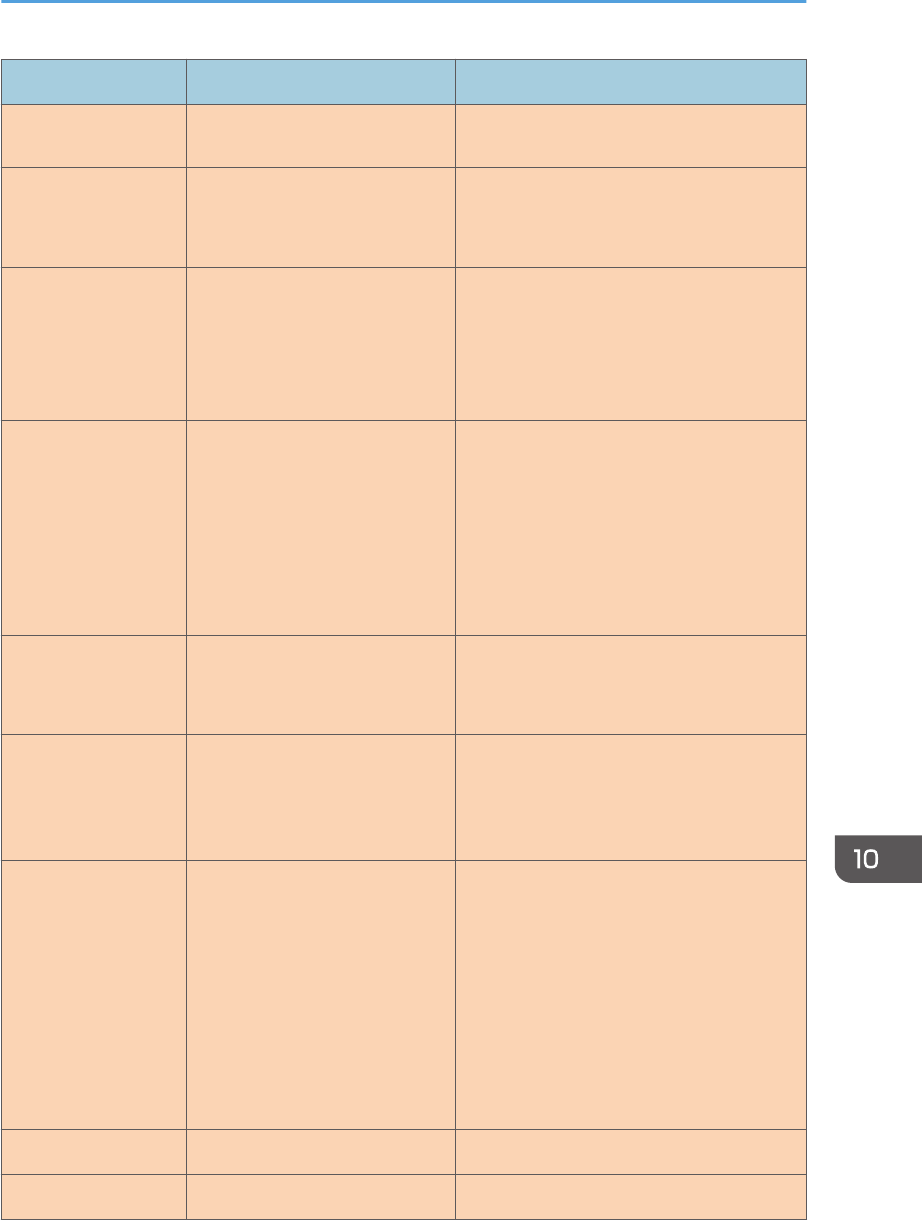
Message Causes Solutions
paper, which are A4, A5, A6,
8.5 × 11 or 5.5 × 8.5 size.
Busy Fax transmission could not be
completed because the
destination's line was busy.
Wait for a while and send the fax again.
Cannot Copy This
Setting
Comb.: 2 on 1 / 4
on 1
Combined copying could not be
performed because the tray
does not contain the valid size
paper, which are A4, Letter, or
Legal size.
Specify the A4, Letter, or Legal size paper
for the tray selected for printing copies.
See page 145 "System Settings".
Cannot copy.
Set original to ADF.
Combined copying could not be
performed because the originals
were not placed in the ADF.
• Use the ADF, even when copying a
single sheet.
• If you need to use the exposure glass,
turn off combined copying in
[Duplex/Combine] under copy
settings, and then try again. See
page 132 "Copier Features Settings".
Check Paper Size The paper size set for the
document differs from the size of
the paper in the indicated tray.
Press [FormFeed] to begin printing, or
press [JobReset] to cancel the job.
Check Paper Type The paper type set for the
document differs from the type
of the paper in the indicated
tray.
Press [FormFeed] to begin printing, or
press [JobReset] to cancel the job.
Connection Failed The line could not be connected
correctly.
• Confirm that the telephone line is
properly connected to the machine.
• Disconnect the telephone line from
the machine, and connect a standard
telephone in its place. Confirm that
you can make calls using the
telephone. If you cannot make calls
this way, contact your telephone
company.
Cooling down... The engine has overheated. Wait until the message disappears.
Cover open A cover is open. Close the cover completely.
Error and Status Messages on the Screen
opal-p2_mf2_com_user_guide_00142156_eng.xml 227
Draft 2014/01/07
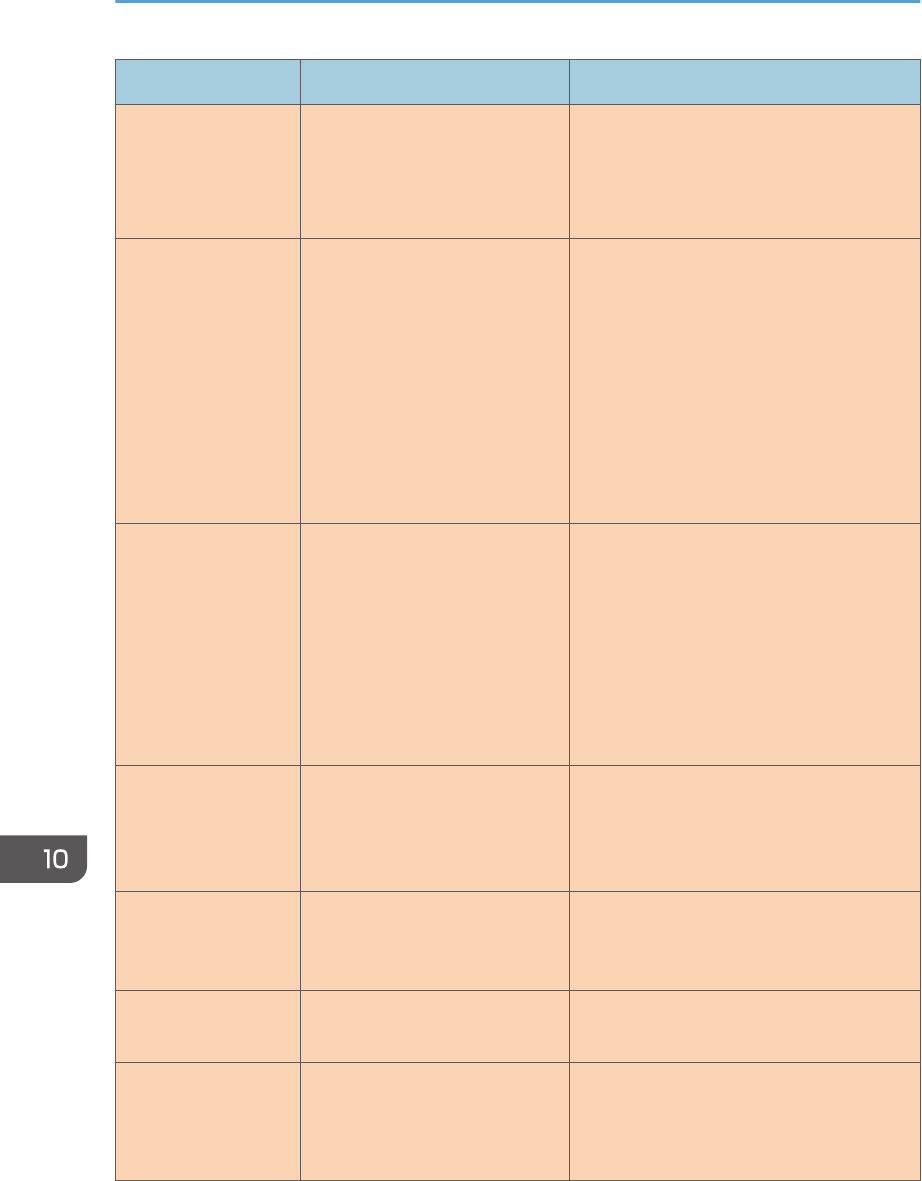
Message Causes Solutions
Dest. is not
Programmed
No Quick Dial entry is
associated with the One Touch
button you pressed.
• Press a different One Touch button.
• Assign a registered destination to the
One Touch button. See page 80
"Registering Scan Destinations".
Dial Failed The fax could not be sent. • Confirm that the fax number you
dialed is correct.
• Confirm that the destination is a fax
machine.
• Confirm that the line is not busy.
• You may need to insert a pause
between dial digits. Press the [Pause/
Redial] key after, for example, the
area code.
Exceeded Max.E-
mail Size
The scan file exceeds the size
limit for files that can be sent
through e-mail.
• Configure [Resolution] under scan
settings to reduce the scanning
resolution. See page 135 "Scanner
Features Settings".
• Configure [Max. E-mail Size] under
scan settings to increase the allowed
size. See page 135 "Scanner
Features Settings".
Fax Job Memory
Overflow
The number of fax jobs in
memory (unsent or unprinted
faxes) has reached maximum,
so new jobs cannot be stored.
Wait until pending jobs have been
transmitted or printed.
Indep.Sply.Prt.Cart. A non-supported print cartridge
is installed.
Remove and replace it with a print
cartridge specified by an authorized
dealer.
Internal Misfeed Paper has been jammed in the
machine.
Remove the jammed paper. See page 210
"Paper Feed Problems".
Memory Almost Full Memory has almost reached
capacity during sort copy.
If several originals are still to be scanned,
it is recommended to start printing now,
and copy the remaining originals
separately. If originals are being scanned
10. Troubleshooting
228 opal-p2_mf2_com_user_guide_00142156_eng.xml
Draft 2014/01/07
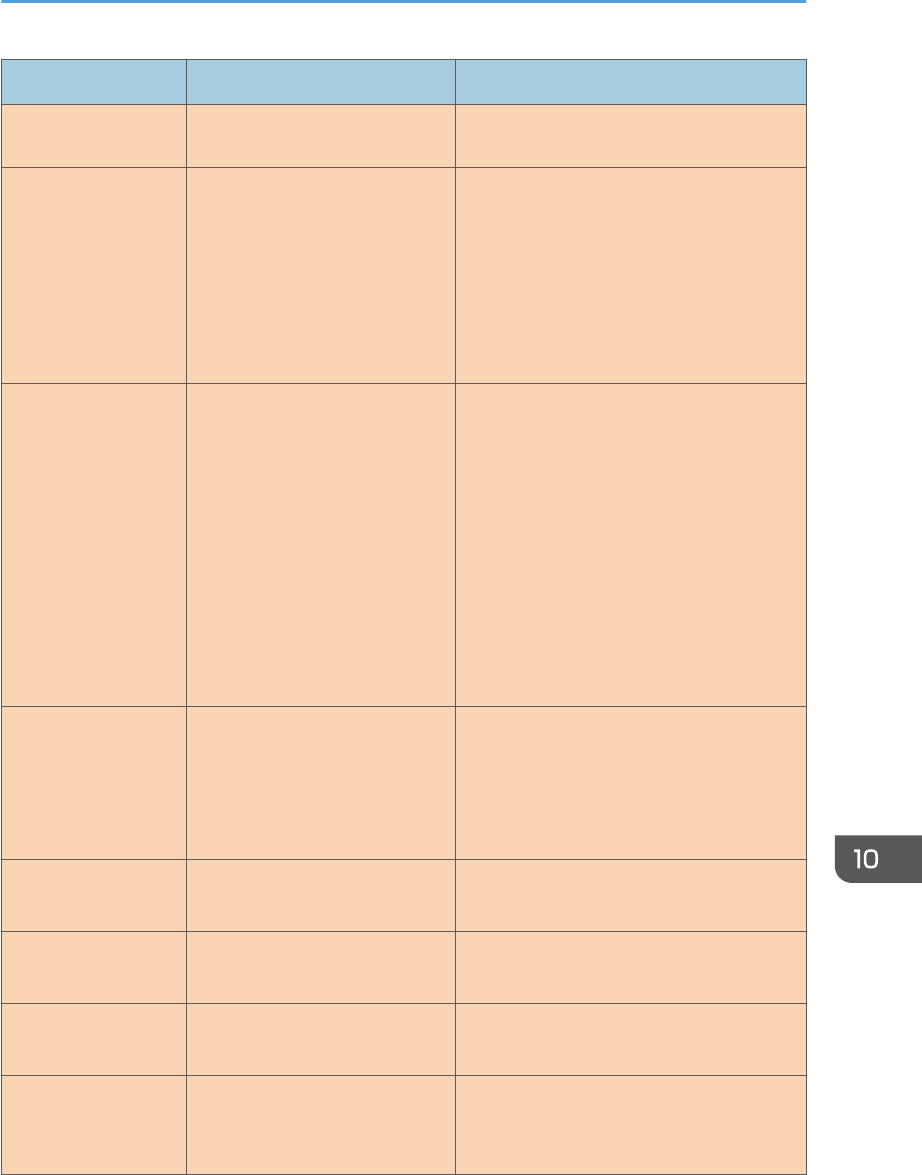
Message Causes Solutions
from the ADF, remove any remaining
pages from the ADF.
Memory Overflow The data is too large or
complex to print.
• Select [600 × 600 dpi] in
[Resolution] under [Printer Features]
to reduce the size of data. See
page 152 "Printer Features Settings".
• If using the PCL printer driver, set
[Resolution] in [Print Quality] to [600
× 600 dpi].
Memory Overflow • The machine's memory
reached capacity while
scanning the first page of
the original to store a fax
job in memory before
transmission.
• The machine's memory
reached capacity while
storing a fax in memory in
Memory Transmission
mode.
Resend the fax in parts as several smaller
individual faxes, or send at a lower
resolution.
Memory Overflow
TX
Cancel
Memory has reached capacity
while scanning the second or
later pages of the original when
trying to send a fax in Memory
Transmission mode.
Press [TX] to send only the pages that have
been scanned in memory, or press
[Cancel] to cancel.
Misfeed: BypassTray Paper has been jammed in the
bypass tray.
Remove the jammed paper. See page 210
"Paper Feed Problems".
Misfeed: Stnd. Tray Paper has been jammed in the
paper exit area.
Remove the jammed paper. See page 210
"Paper Feed Problems".
Misfeed: Tray 1 Paper has been jammed in the
tray 1 paper input area.
Remove the jammed paper. See page 210
"Paper Feed Problems".
Net Communication
Error
Connection with the server was
lost while sending or receiving
data.
Contact the network administrator.
Error and Status Messages on the Screen
opal-p2_mf2_com_user_guide_00142156_eng.xml 229
Draft 2014/01/07
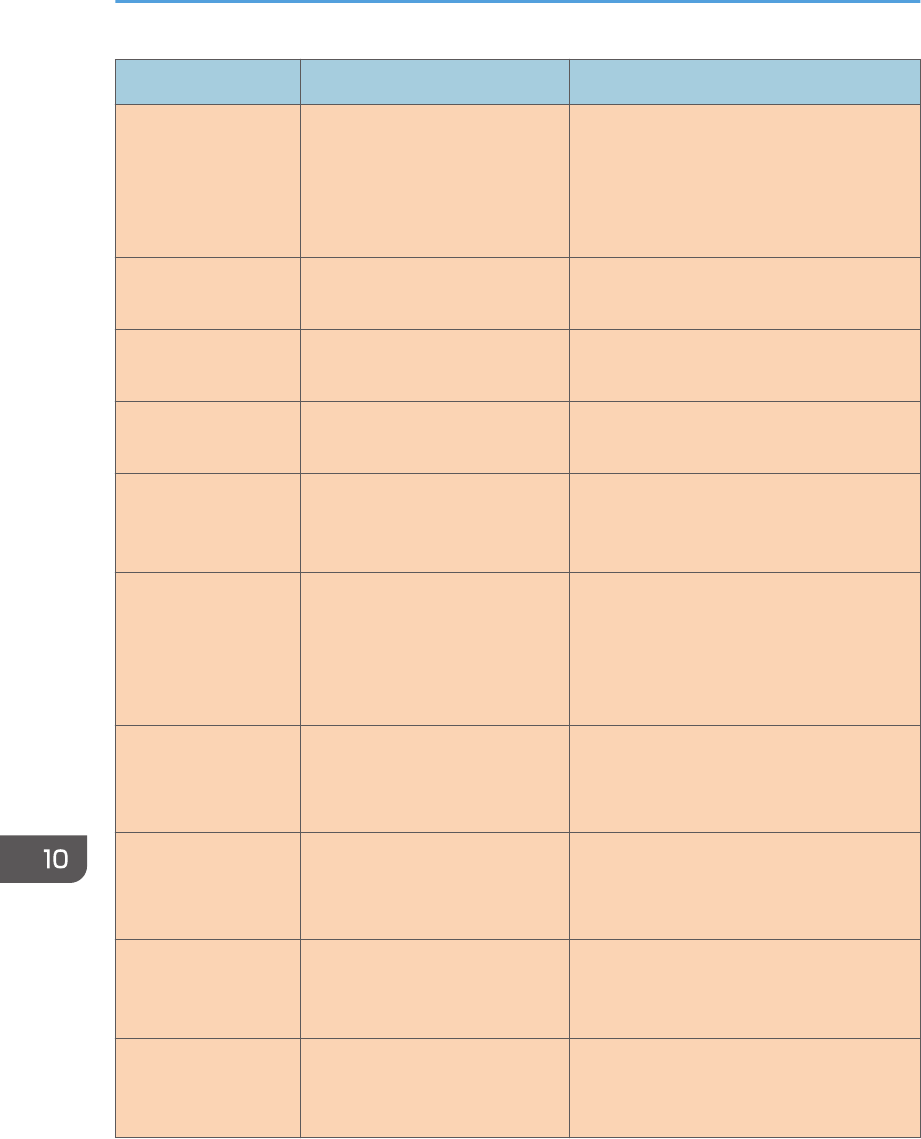
Message Causes Solutions
Network is not Ready A scanned file could not be sent
because the machine has not
received IP address information
from the DHCP server
completely.
Wait until the machine receives the IP
address information completely, and then
try the operation again.
On Hook or Stop key The machine has been off-hook
for an extended period of time.
Put down the handset or press the [Clear/
Stop] key.
Out of Paper: X The indicated tray has run out of
paper.
Load paper to the indicated tray. See
page 45 "Loading Paper".
Please Restart
Machine
The machine needs to be
restarted.
Turn off the power, and then turn it back
on.
Print Cart. Set Error The print cartridge has not been
installed or has not been
installed correctly.
Reinstall the print cartridge. See page 203
"Replacing the Print Cartridge".
Remove Paper:
Bypass Tray
The machine failed to proceed
with the print job, because tray
1 was specified as the input tray
but paper was set in the bypass
tray.
Remove paper from the bypass tray.
Replace Required
Soon:
Print Cartridge
The print cartridge is almost
empty.
Prepare a new print cartridge.
Replacement
Required:
Print Cartridge
The machine has run out of
toner.
Replace the print cartridge. See page 203
"Replacing the Print Cartridge".
RX Comm. Error A reception error occurred, and
the fax could not be received
correctly.
If possible, contact the sender of the fax
and ask them to resend it.
Scan (NW)
Disconnected
A scanned file could not be sent
because the Ethernet cable was
not connected properly.
Reconnect the Ethernet cable properly,
and then try the operation again.
10. Troubleshooting
230 opal-p2_mf2_com_user_guide_00142156_eng.xml
Draft 2014/01/07
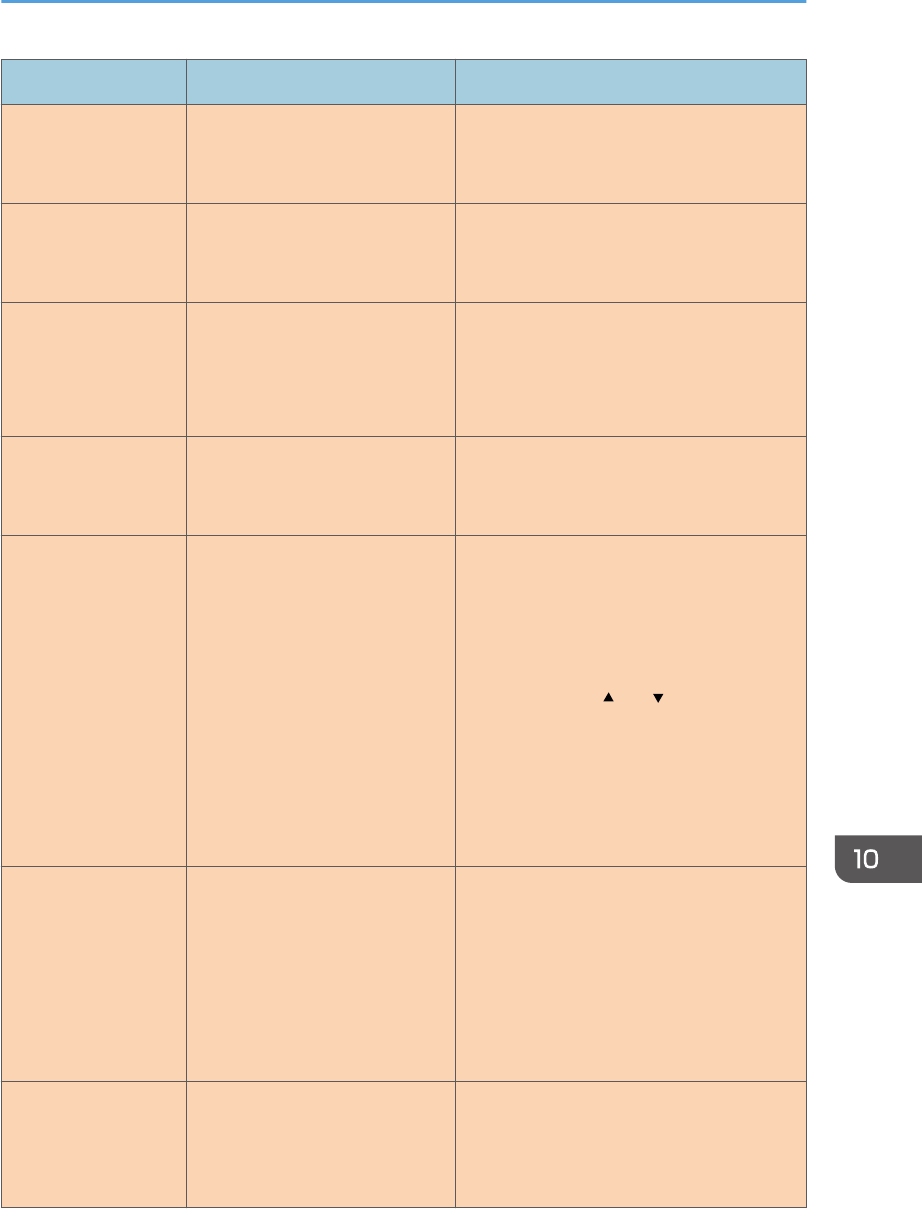
Message Causes Solutions
Scan (USB)
Disconnected
The USB cable was
disconnected while scanning
from a computer.
Reconnect the USB cable properly, and
then try the operation again.
Server Connection
Failed
A scanned file could not be sent
because the destination could
not be reached.
Confirm that the destination is registered
correctly, and then try the operation again.
Server Response
Error
An error occurred in
communication with the server
before beginning transmission.
Confirm that the destination is registered
correctly, and then try the operation again.
If the problem could not be solved, contact
the network administrator.
Service call - X A fatal hardware error has
occurred, and the machine
cannot function.
Contact your sales or service
representative.
Set Correct Paper The paper tray does not contain
A4, Letter, or Legal size paper.
While the message is displayed, press the
[OK] key. A menu for changing the paper
size of the current tray appears.
Load A4/Letter/ Legal size paper in the
tray, and then select the corresponding
paper size using [ ] or [ ] key and press
the [OK] key. The machine will then print
out the fax.
Note that the paper size setting for the tray
under system settings will be changed. See
page 145 "System Settings".
Set Original to ADF
Cannot use exposure
glass
with set. in [Scan
Size].
Scanning could not be
performed because the originals
were not placed in the ADF,
even though the machine is set
to scan originals larger than
A4/Letter size.
• Use the ADF, even when scanning
A4/Letter or smaller size originals.
• If you need to use the exposure glass,
set A4/Letter or smaller size in [Scan
Size] under scan settings, and then try
again. See page 92 "Specifying the
Scan Settings".
Sort Copy was
Cancelled
The machine's memory reached
capacity while originals were
being scanned from the ADF to
perform sort copying.
Press [Exit] to print the originals that were
successfully scanned into memory. Then,
copy again the originals left in the ADF.
Error and Status Messages on the Screen
opal-p2_mf2_com_user_guide_00142156_eng.xml 231
Draft 2014/01/07
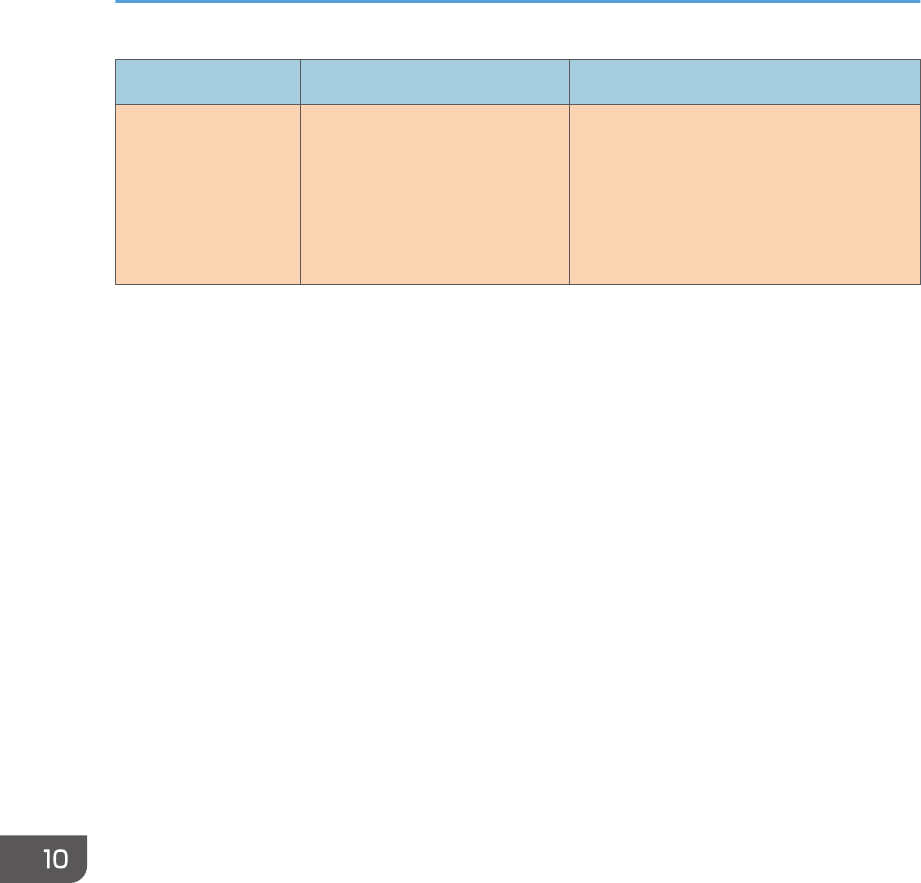
Message Causes Solutions
TX Comm. Error A transmission error occurred,
and the fax could not be
transmitted correctly.
If the [Auto Redial] setting is enabled, the
machine will redial the number and try
again. If all attempts fail, or if the machine
is in Immediate Transmission mode, the fax
will not be transmitted. Try the operation
again.
10. Troubleshooting
232 opal-p2_mf2_com_user_guide_00142156_eng.xml
Draft 2014/01/07
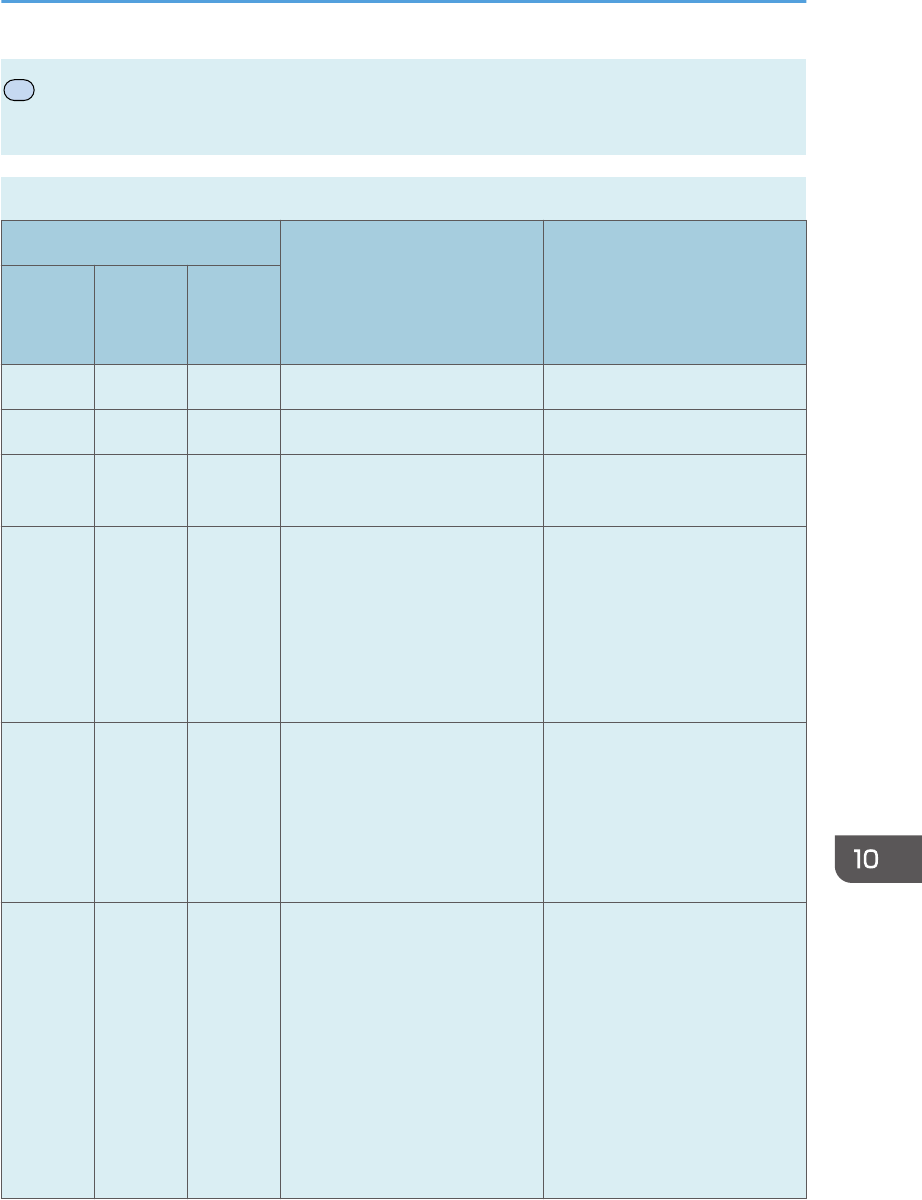
P
Error and Status Indicate on the Control
Panel
The LED on the operation panel indicates the machine status, including any errors.
LED
Status Solution
Toner/
Paper
End
Alarm Power
- - On The power is on. The status is normal.
- - Flashing Importing data. The status is normal.
Flashing - On The print cartridge is almost
empty.
Replace the print cartridge
before it becomes empty.
On - On • The print cartridge is
empty.
• The print cartridge is not
set correctly.
• The tray has run out of
paper.
• The print cartridge is
empty.
• Set the print cartridge
again correctly.
• Load paper into the tray.
- Flashing On A paper jam has occurred in
the machine.
Use Web Image Monitor or
Smart Organizing Monitor to
determine where the paper jam
is, and then remove the
jammed paper. See page 210
"Paper Feed Problems".
- On On • The size of paper to print
on and the size of the
paper loaded in the tray
do not match.
• A cover is open.
• Use Web Image Monitor
or Smart Organizing
Monitor to check the
paper size settings, and
then change either the
size of paper to print on
or the size of paper
loaded in the tray.
• Confirm that all the covers
are closed completely.
Error and Status Indicate on the Control Panel
opal-p2_mf2_com_user_guide_00142157_eng.xml 233
Draft 2014/01/07
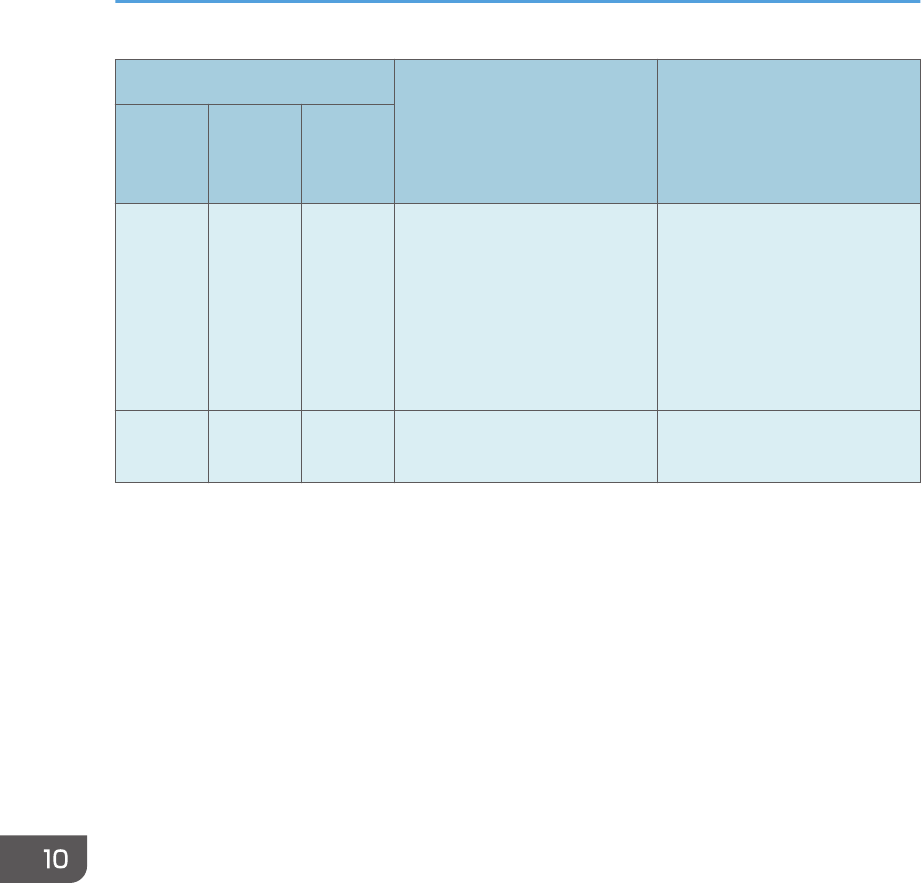
LED
Status Solution
Toner/
Paper
End
Alarm Power
- On On Another type of error has
occurred.
Use Web Image Monitor or
Smart Organizing Monitor to
check the error, and then take
appropriate measures. See
page 165 "Using Web Image
Monitor" or page 198 "Using
Smart Organizing Monitor".
On On On A malfunction has occurred. Contact your sales or service
representative.
10. Troubleshooting
234 opal-p2_mf2_com_user_guide_00142157_eng.xml
Draft 2014/01/07
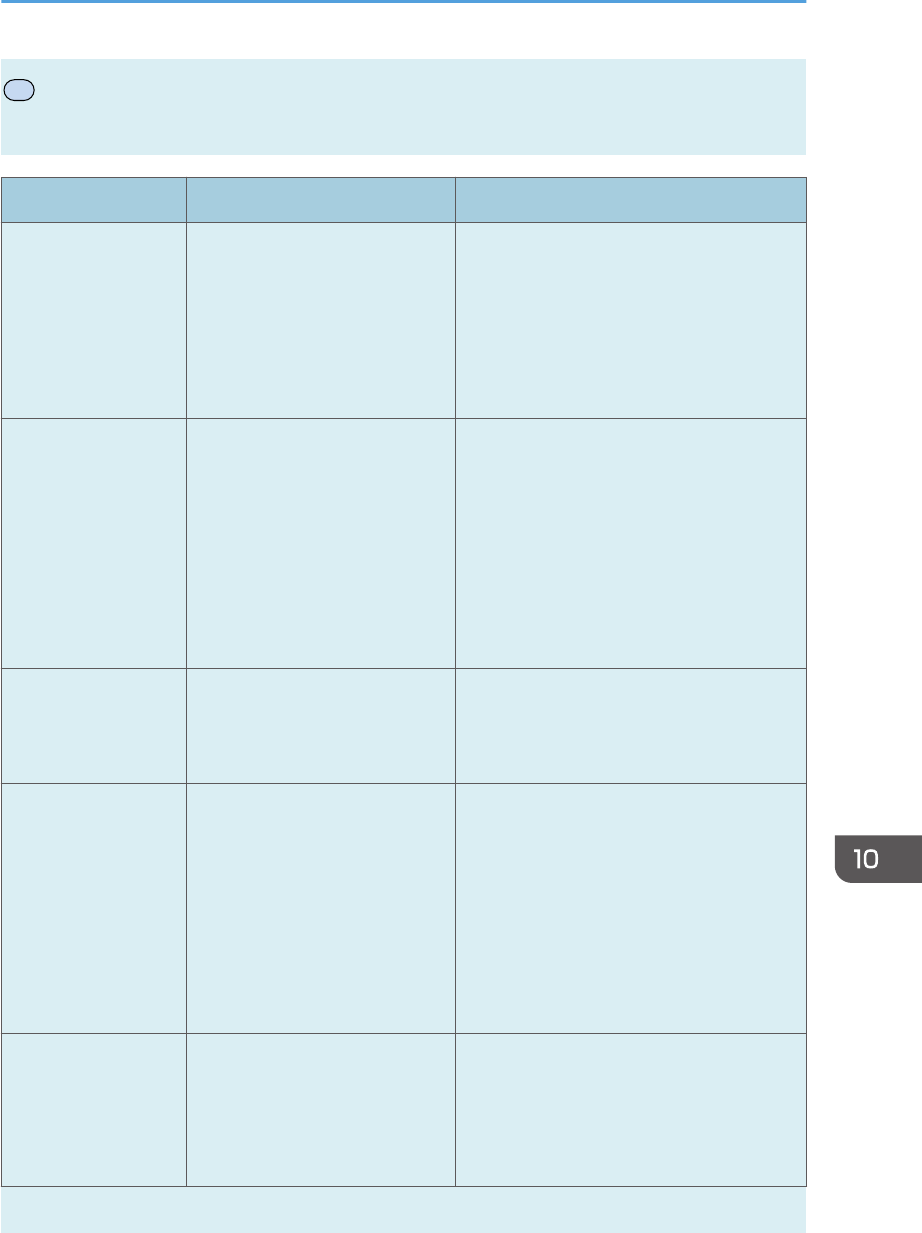
P
Error and Status Messages Appear on Smart
Organizing Monitor
Message Causes Solutions
No Response from
I/O Device
Check the cable,
power cord, and
main switch.
• The power cable of the
machine is not plugged in.
• The power of the machine
is not turned ON.
• The USB cable is not
connected.
• Check the printer power cord.
• Check the printer power switch is on.
• Check the USB cable is properly
connected.
Tray Not Detected or
No Paper
The indicated paper
source tray is not set
properly, or no
paper loaded.
Check the indicated
tray.
Tray 1 has run out of paper.
The bypass tray has run out of
paper.
Load paper into Tray 1. See page 45
"Loading Paper".
Load paper into the bypass tray. See
page 45 "Loading Paper".
Tray 1 Jam
Bypass Tray Jam
Total Jam
A paper jam has occurred in the
machine.
Remove the jammed paper. See page 210
"Paper Feed Problems".
Paper Size Mismatch
Paper of the selected
paper size is not
loaded in the
indicated paper
source tray.
Check the indicated
tray.
The paper size specified on the
machine and the size specified
in the printer driver do not
match.
For details about specifying the paper size
setting on the machine, see page 45
"Loading Paper". For details about
changing the paper size setting in the
printer driver, see the printer driver Help.
Paper Type
Mismatch
Paper of the selected
paper type is not
loaded in the
The paper type specified on the
machine and the type specified
in the printer driver do not
match.
For details about changing the paper type
setting of the machine, see page 45
"Loading Paper". For details about
changing the paper type setting in the
printer driver, see the printer driver Help.
Error and Status Messages Appear on Smart Organizing Monitor
opal-p2_mf2_com_user_guide_00142158_eng.xml 235
Draft 2014/01/07
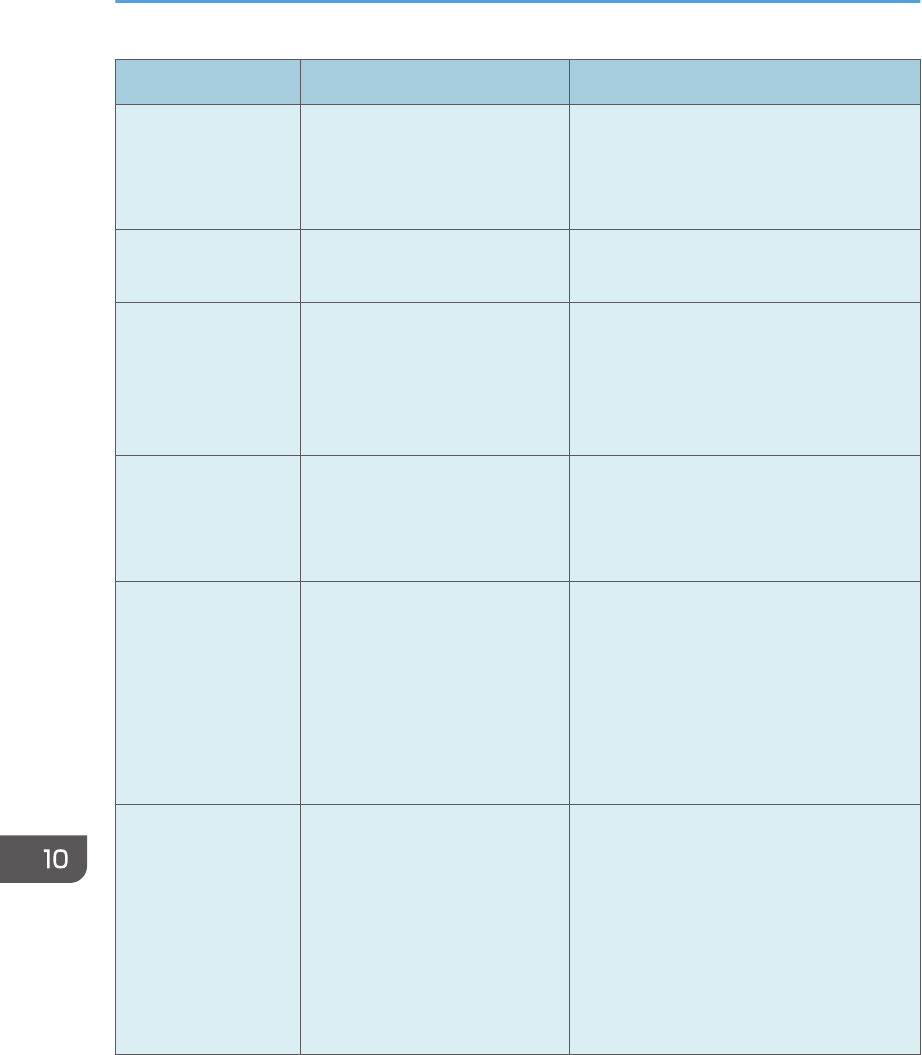
Message Causes Solutions
indicated paper
source tray.
Check the indicated
tray.
Print Cartridge is
near empty.
The print cartridge is almost
empty.
The print cartridge is almost empty.
Shortly printing
becomes not
available. Please
keep Print Cartridge
handy.
The machine has run out of the
toner.
Replace the print cartridge. See page 203
"Replacing the Print Cartridge".
Printing has been
interrupted because
of the memory
overflow.
The data is too large or
complex to print.
Select [600 x 600 dpi] in [Resolution:] to
reduce the size of data. For details, see the
printer driver Help.
Waste Toner full
No printing is
available.
Open the indicated
cover, and then
replace Print
Cartridge.
The waste toner bottle is full. Replace the print cartridge.
No Toner or Waste
Toner full
No printing is
available.
Open the indicated
cover, and then
replace Print
Cartridge.
The print cartridge has not been
installed.
Reinstall the print cartridge. See page 203
"Replacing the Print Cartridge".
10. Troubleshooting
236 opal-p2_mf2_com_user_guide_00142158_eng.xml
Draft 2014/01/07
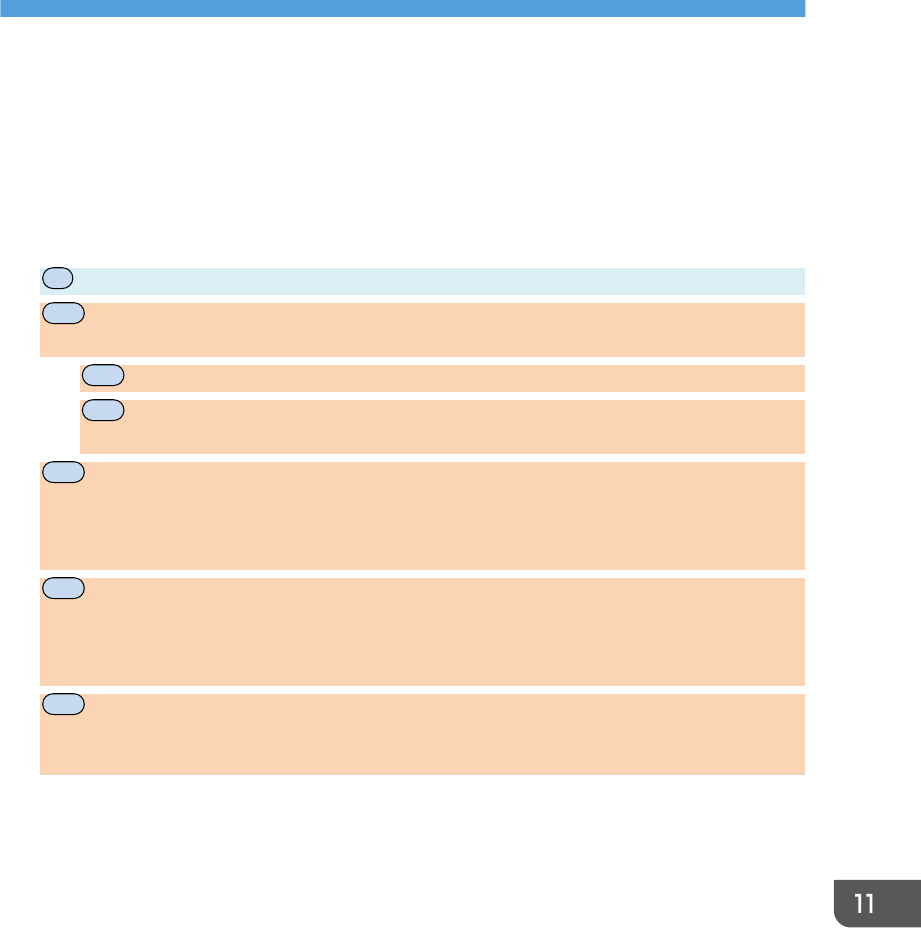
11. Appendix
Notes About the Toner
• Proper operation cannot be guaranteed if any third-party toner is used.
• Depending on printing conditions, there are cases where the printer cannot print the number of
sheets indicated in the specifications.
•
P
Replace the print cartridge if the printed image suddenly becomes pale or blurred.
•
MF
When operating the machine for the first time, use the print cartridge supplied with this
machine. If this cartridge is not initially used, the following problems may occur:
•
MF
"Replacement Required: Print Cartridge" will be displayed before the toner runs out.
•
MF
"Replacement Required: Print Cartridge" will not be displayed when the toner runs out,
but instead the printed image suddenly becomes pale or blurred.
•
MF
To continue printing after "Replacement Required: Print Cartridge" is displayed, set [Toner
End Option Settings] to [Continue Printing]. However, since any trouble caused by using this setup
is outside of the scope of the manufacturer's warranty, this setup should be used with care. For
details about [Toner End Option Settings], see page 145 "System Settings".
•
MF
If [Toner End Option Settings] is first set to [Continue Printing] and then to [Stop Printing], be
sure to use a new print cartridge. If a used print cartridge is installed, there will be a discrepancy
between the remaining toner level displayed and the actual remaining toner, and accordingly,
"Replacement Required: Print Cartridge" will not be displayed at the appropriate timing.
•
MF
The lifetime of the photo conductor, which is built into the print cartridge, is taken into account
in displaying "Replacement Required: Print Cartridge". If the photo conductor stops working before
the toner runs out, "Replacement Required: Print Cartridge" may be displayed.
opal-p2_mf2_com_user_guide_00142161_eng.xml 237
Draft 2014/01/07
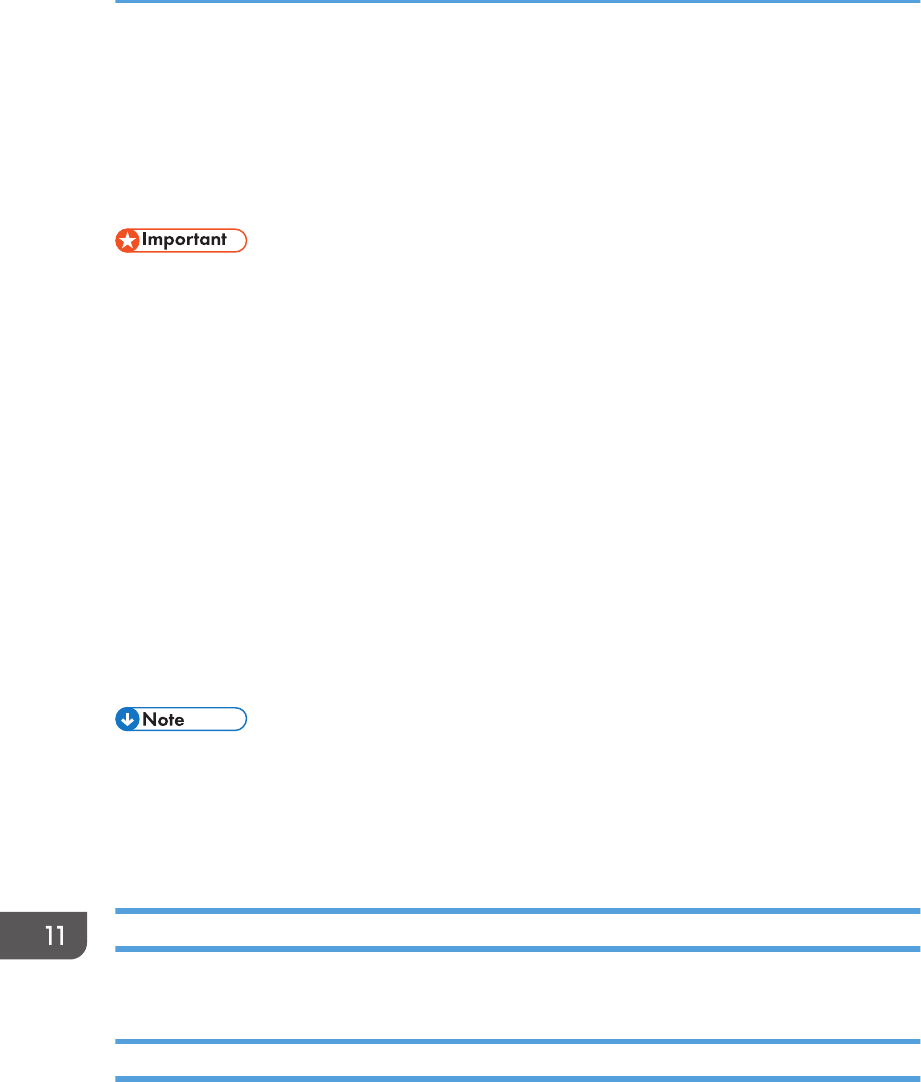
Moving and Transporting the Machine
This section provides cautions that you must follow when moving the machine both short and long
distances.
Repack the machine in its original packing materials when moving it over a long distance.
• Be sure to disconnect all cables from the machine before transporting it.
• The machine is a precision piece of machinery. Be sure to handle it carefully when moving it.
• Make sure to move the machine horizontally. Take extra caution when carrying the machine up or
down stairs.
• Do not remove the print cartridge when moving the machine.
• Be sure to hold the machine level while carrying it. To prevent toner from spilling, move the
machine carefully.
1. Be sure to check the following points:
• The power switch is turned off.
• The power cord is unplugged from the wall outlet.
• All other cables are unplugged from the machine.
2. Lift the machine using the inset grips on both sides of the machine, and then move it
horizontally to the place where you want to use it.
• To move the machine over a long distance, pack it well. Take care not to tip or tilt the machine
during transit.
• Toner might spill inside the machine if the machine is not kept level during transit.
• For more information about moving the machine, contact your sales or service representative.
Disposal
Ask your sales or service representative for information about correct disposal of this machine.
Where to Inquire
Contact your sales or service representative for further information about the topics included in this
manual or to inquire about other topics not included in this manual.
11. Appendix
238 opal-p2_mf2_com_user_guide_00142162_eng.xml
Draft 2014/01/07
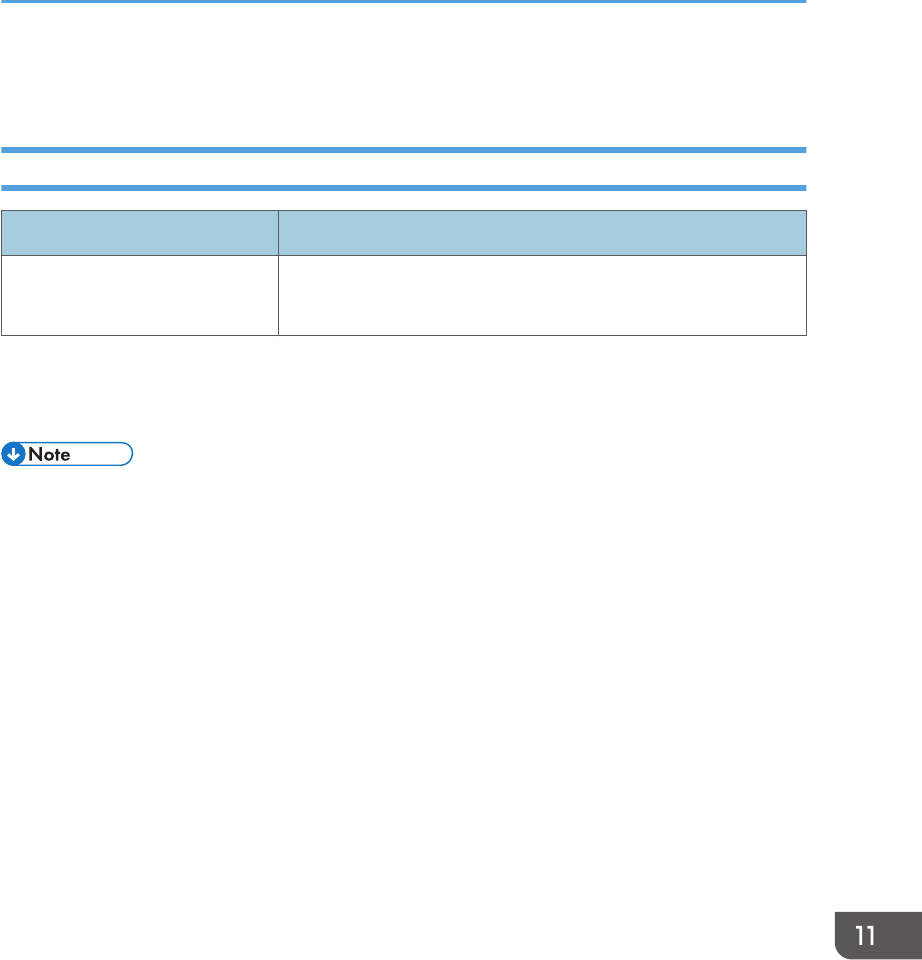
Consumables
Print Cartridge
Print cartridge Average printable number of pages per cartridge *1
Black 1,500 pages, 2,600 pages
2,600 pages
*1 The printable number of pages is based on pages that are compliant with ISO/IEC 19752 with the image
density set as the factory default. ISO/IEC 19752 is an international standard for measurement of printable
pages, set by the International Organization for Standardization.
• Unless a print cartridges is replaced before toner runs out, printing will become impossible. To
facilitate cartridge replacement, we recommend you purchase and store extra print cartridges.
• The actual number of printable pages varies depending on the image volume and density, number
of pages printed at a time, paper type and paper size used, and environmental conditions such as
temperature and humidity.
• Print cartridges may need to be changed sooner than indicated above due to deterioration over
the period of use.
• Print cartridges are not covered by warranty. However, if there is a problem, contact the store
where you purchased them.
• The supplied print cartridge can print approximately 1,000 pages.
• The supplied print cartridge can print approximately 700 pages.
• This machine periodically performs cleaning. During cleaning, toner will be used to maintain print
quality.
Consumables
opal-p2_mf2_com_user_guide_00142163_eng.xml 239
Draft 2014/01/07
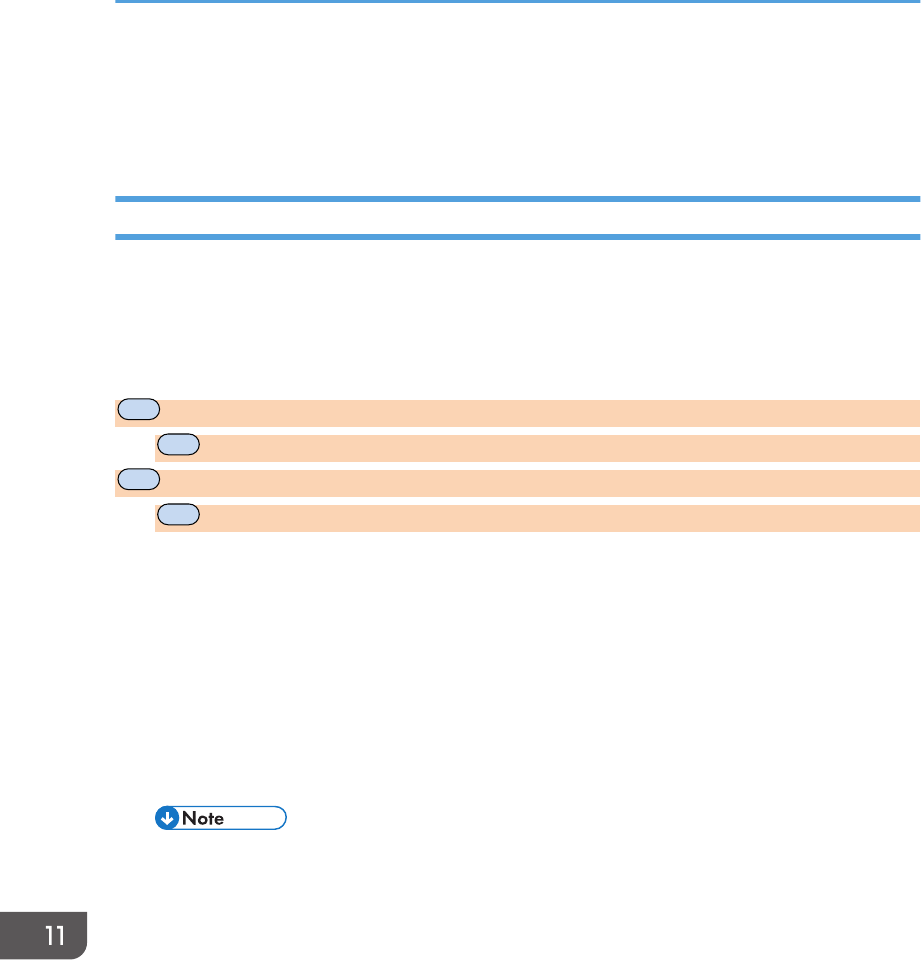
Specifications of the Machine
This section lists the machine's specifications.
General Function Specifications
Configuration
Desktop
Print process
Laser electrostatic transfer
MF
Maximum paper size for scanning using the exposure glass
MF
216 mm × 297 mm (8.5 × 11.7 inches)
MF
Maximum paper size for scanning using the ADF
MF
216 mm × 356 mm (8.5 × 14 inches)
Maximum paper size for printing
216 mm × 356 mm (8.5 × 14 inches)
Warm-up time
Less than 25 seconds (23 °C, 71.6 °F)
Paper sizes
A4, 81/2 " × 11 " (Letter), 81/2 " × 14 " (Legal), B5, 51/2 " × 81/2 " (Half Letter), 71/4 " × 101/2
" (Executive), A5, A6, B6, 16K (197 × 273 mm), 16K (195 × 270 mm), 16K (184 × 260 mm),
Custom Paper Size
• The following paper sizes are supported as custom paper sizes:
• Width
Tray1: Approximately 100-216 mm (3.9-8.5 inches)
Bypass Tray: Approximately 90-216 mm (3.6-8.5 inches)
• Length
Approximately 148-356 mm (5.8-14 inches)
Paper type
Plain Paper (65-99 g/m2 (17-26 lb.)), Recycled Paper (75-90 g/m2 (20-24 lb.)), Thin Paper
(52-64 g/m2 (14-17 lb.)), Thick Paper (100-130 g/m2 (26.6-34 lb.))
Paper input capacity
• Tray 1
11. Appendix
240 opal-p2_mf2_com_user_guide_00142164_eng.xml
Draft 2014/01/07
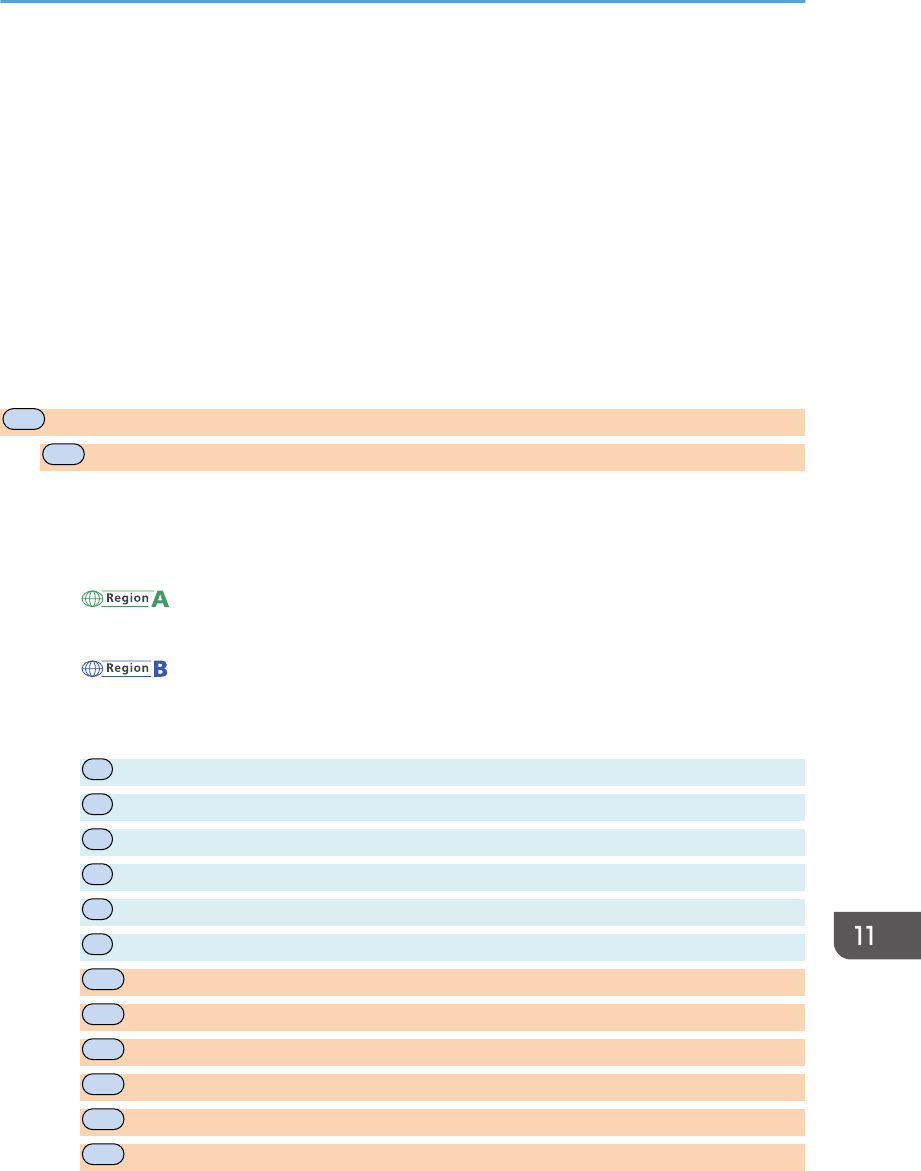
150 sheets (70 g/m2, 19 lb.)
• Bypass Tray
1 sheet (70 g/m2, 19 lb.)
Maximum loading height
15.5 mm (0.6 inches)
Paper output capacity
• Output Tray
50 sheets (70 g/m2, 19 lb.)
• Rear
1 sheet (70 g/m2, 19 lb.)
MF
ADF capacity
MF
15 sheets (80 g/m2, 21.3 lb.)
Memory
128 MB
Power requirements
• (mainly Europe and Asia)
220-240 V, 5 A, 50/60 Hz
• (mainly North America)
120 V, 8 A, 60 Hz
Power consumption
•
P
Maximum power consumption
P
900 W
•
P
Energy Saver mode 1
P
34.8 W
•
P
Energy Saver mode 2
P
3.7 W
•
MF
Maximum power consumption
MF
900 W
•
MF
Energy Saver mode 1
MF
40 W
•
MF
Energy Saver mode 2
MF
3.9 W
Specifications of the Machine
opal-p2_mf2_com_user_guide_00142164_eng.xml 241
Draft 2014/01/07
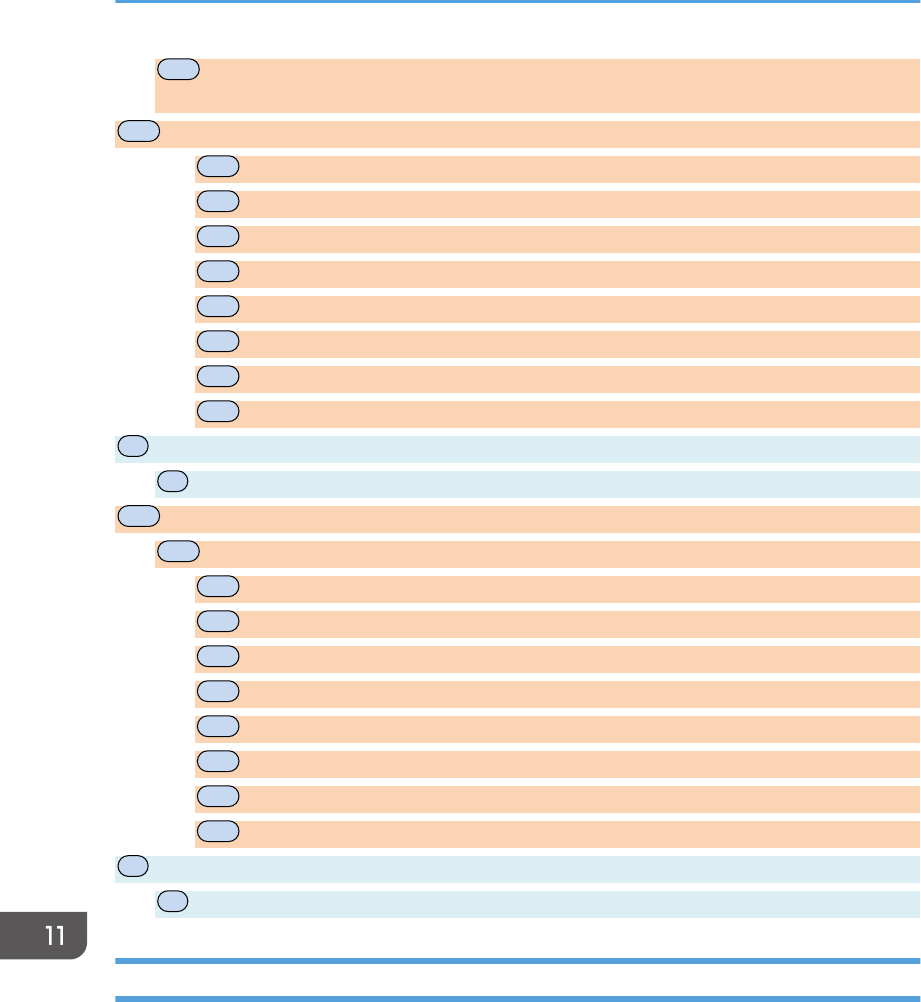
MF
* The power level when the main switch is turned off and the power cord is plugged into an
outlet: 1W or less
MF
Machine dimensions (Width × Depth × Height)
•
MF
Type 1
MF
402 × 360 × 252 mm (15.8 × 14.2 × 10.1 inches)
•
MF
Type 2, Type 3, Type 4
MF
402 × 360 × 293 mm (15.8 × 14.2 × 11.5 inches)
•
MF
Type 1, Type 5
MF
402 × 360 × 252 mm (15.8 × 14.2 × 10.1 inches)
•
MF
Type 2, Type 3, Type 4
MF
402 × 360 × 293 mm (15.8 × 14.2 × 11.5 inches)
P
Machine dimensions (Width × Depth × Height)
P
402 × 360 × 165 mm (15.8 × 14.2 × 6.5 inches)
MF
Weight (machine body with consumables)
MF
Approximately 11.1 kg (22 lb.) or less
•
MF
Type 1
MF
Approximately 9.9 kg (22 lb.) or less
•
MF
Type 2, Type 3, Type 4
MF
Approximately 11.1 kg (25 lb.) or less
•
MF
Type 1, Type 5
MF
Approximately 9.9 kg (22 lb.) or less
•
MF
Type 2, Type 3, Type 4
MF
Approximately 11.1 kg (25 lb.) or less
P
Weight (machine body with consumables)
P
Approximately 7.2 kg (16 lb.) or less
Printer Function Specifications
Printing speed
22 pages per minute (A4/Letter)
Resolution
600 × 600 dpi (maximum: 1200 × 600 dpi)
First print speed
6 seconds or less (From the start of paper feed action to the completion of paper delivery)
11. Appendix
242 opal-p2_mf2_com_user_guide_00142164_eng.xml
Draft 2014/01/07
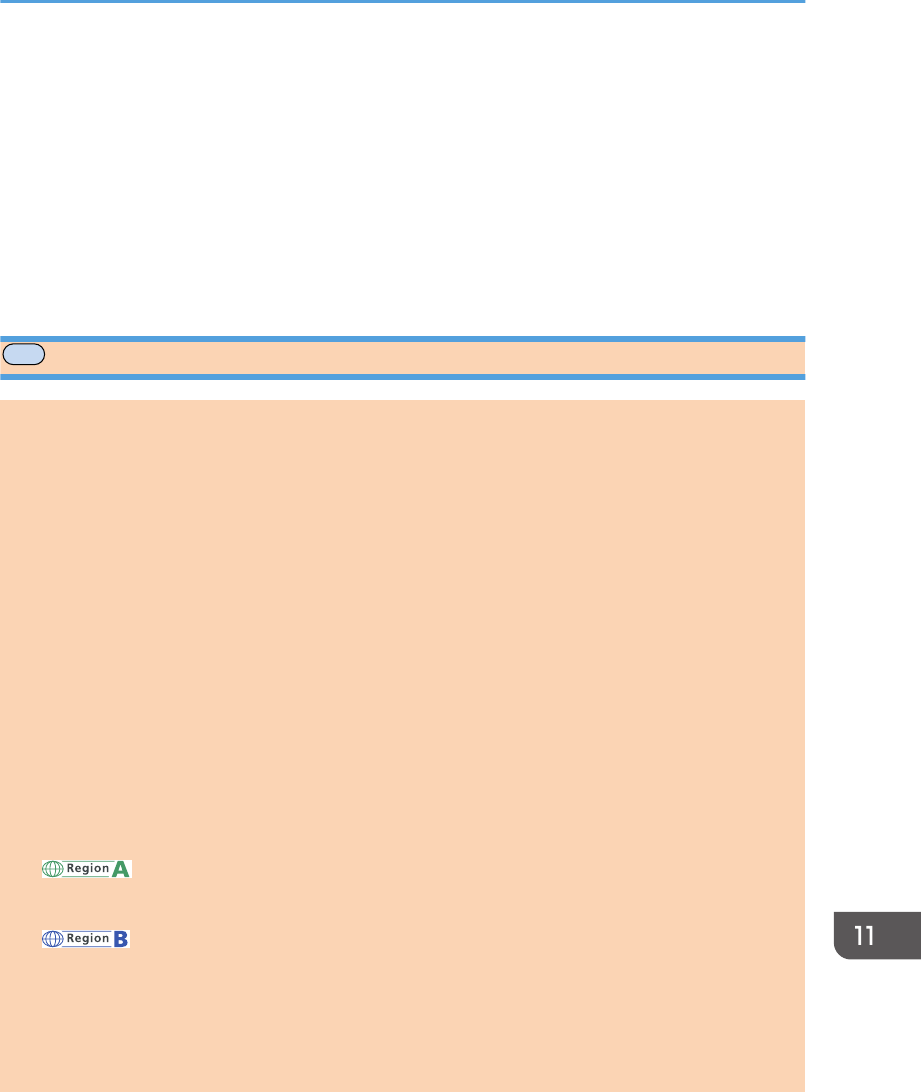
10 seconds or less (From the completion of data processing to the completion of paper delivery)
Interface
• Ethernet (10BASE-T, 100BASE-TX)
• USB 2.0
• Wi-Fi
Printer language
DDST, PCL
MF
Copier Function Specifications
Maximum resolution (scanning and printing)
• Exposure glass
Scanning: 600 × 600 dpi
Printing: 600 × 600 dpi
• ADF
Scanning: 600 × 300 dpi
Printing: 600 × 600 dpi
First copy speed (A4/Letter, at 23 °C, 71.6 °F)
32 seconds or less
Multiple copy speed
Countries other than European countries
22 pages per minute
Reproduction ratio
(mainly Europe and Asia)
Fixed ratio: 50%, 71%, 82%, 93%, 122%, 141%, 200%, 400%
(mainly North America)
50%, 65%, 78%, 93%, 129%, 155%, 200%, 400%
Zoom ratio: 25% to 400%
Copy quantity
99
Specifications of the Machine
opal-p2_mf2_com_user_guide_00142164_eng.xml 243
Draft 2014/01/07
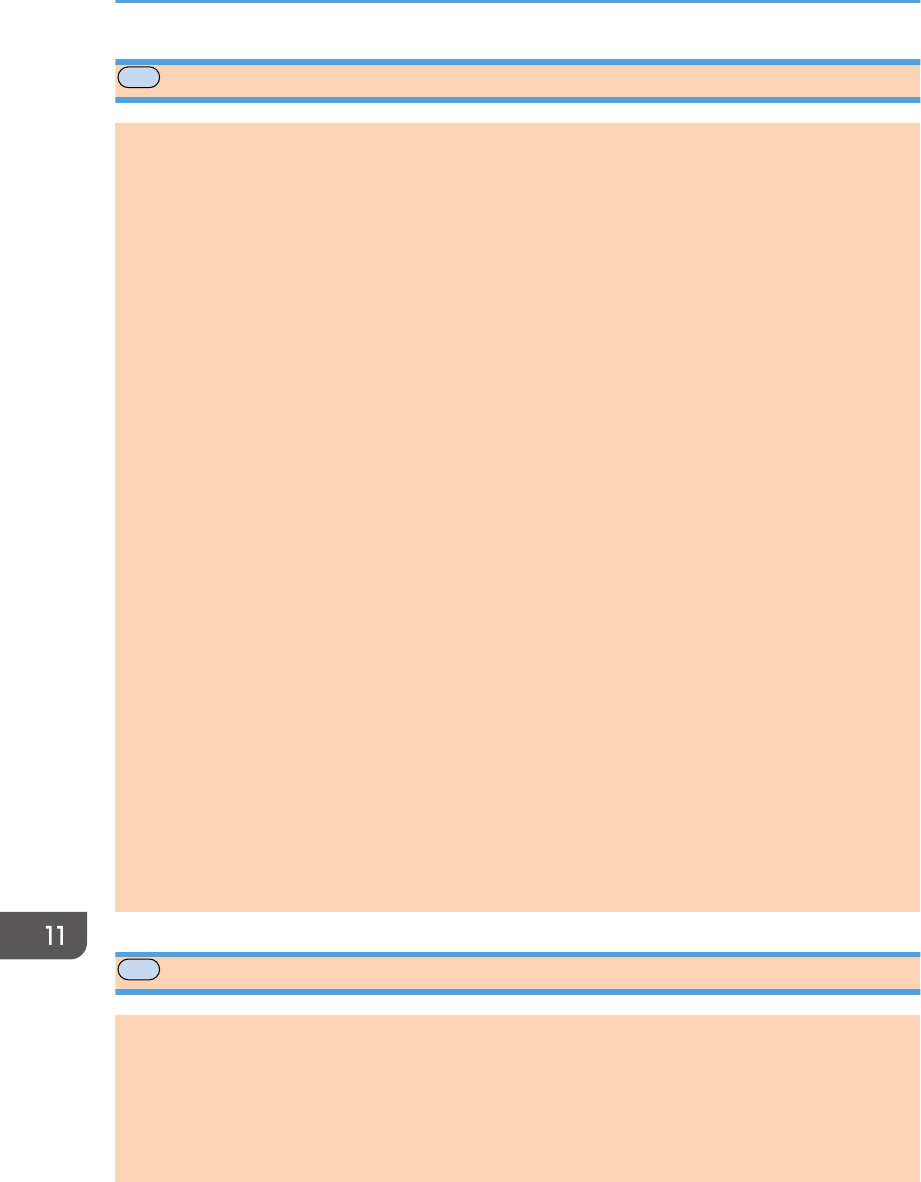
MF
Scanner Function Specifications
Maximum scanning area (horizontal × vertical)
• Exposure glass
216 × 297 mm (8.5 × 11.7 inches)
• ADF
216 × 356 mm (8.5 × 14 inches)
Maximum resolution when scanning from the control panel (Scan to E-mail, Scan to FTP, Scan
to Folder, Scan to USB)
600 × 600 dpi
Maximum resolution when scanning from a computer (TWAIN)
• Exposure glass
4800 × 4800 dpi
• ADF
600 × 600 dpi
Maximum resolution when scanning from a computer (WIA)
600 × 600 dpi
ADF throughput
Black and white: 64 mm per second
Color: 22 mm per second
Interface
• Scanning from the control panel
Ethernet (10BASE-T, 100BASE-TX), USB2.0, Wi-Fi
• Scanning from a computer
Ethernet (10BASE-T, 100BASE-TX), USB2.0, Wi-Fi
MF
Fax Function Specifications
Access line
• Public switched telephone networks (PSTN)
• Private branch exchange (PBX)
Transmission mode
ITU-T Group 3 (G3)
11. Appendix
244 opal-p2_mf2_com_user_guide_00142164_eng.xml
Draft 2014/01/07

Scan line density
8 dots per mm × 3.85 line per mm (200 × 100 dpi)
8 dots per mm × 7.7 line per mm (200 × 200 dpi)
Transmission time
3 seconds (8 dots per mm × 3.85 line per mm, 33.6 kbps, MMR, ITU-T # 1 chart)
Transfer rate
33.6 kbps to 2400 bps (auto shift down system)
Data compression methods
MH, MR, MMR
Memory capacity
Transmission: Up to 5 jobs; up to 10 pages per job
Reception: Up to 50 jobs; up to 100 pages in the total of all jobs
Address book
• Speed dial
100 items
• Quick dial
8 items
• Number of redials for Fax
1
Specifications of the Machine
opal-p2_mf2_com_user_guide_00142164_eng.xml 245
Draft 2014/01/07

Trademarks
Firefox is a registered trademark of the Mozilla Foundation.
Microsoft, Windows, Windows Server, Windows Vista, and Internet Explorer are either registered
trademarks or trademarks of Microsoft Corporation in the United States and/or other countries.
Other product names used herein are for identification purposes only and might be trademarks of their
respective companies. We disclaim any and all rights to those marks.
The proper names of Internet Explorer 6, 7, 8, 9, 10 and 11 are as follows:
Microsoft® Internet Explorer® 6
Windows® Internet Explorer® 7
Windows® Internet Explorer® 8
Windows® Internet Explorer® 9
Internet Explorer® 10
Internet Explorer® 11
The proper names of the Windows operating systems are as follows:
• The product names of Windows XP are as follows:
Microsoft® Windows® XP Professional
Microsoft® Windows® XP Home Edition
Microsoft® Windows® XP Professional x64 Edition
• The product names of Windows Vista are as follows:
Microsoft® Windows Vista® Ultimate
Microsoft® Windows Vista® Business
Microsoft® Windows Vista® Home Premium
Microsoft® Windows Vista® Home Basic
Microsoft® Windows Vista® Enterprise
• The product names of Windows 7 are as follows:
Microsoft® Windows® 7 Home Premium
Microsoft® Windows® 7 Professional
Microsoft® Windows® 7 Ultimate
Microsoft® Windows® 7 Enterprise
• The product names of Windows 8 are as follows:
Microsoft® Windows® 8
Microsoft® Windows® 8 Pro
Microsoft® Windows® 8 Enterprise
11. Appendix
246 opal-p2_mf2_com_user_guide_00142165_eng.xml
Draft 2014/01/07

• The product names of Windows 8.1 are as follows:
Microsoft® Windows® 8.1
Microsoft® Windows® 8.1 Pro
Microsoft® Windows® 8.1 Enterprise
• The product names of Windows Server 2003 are as follows:
Microsoft® Windows Server® 2003 Standard Edition
Microsoft® Windows Server® 2003 Enterprise Edition
• The product names of Windows Server 2003 R2 are as follows:
Microsoft® Windows Server® 2003 R2 Standard Edition
Microsoft® Windows Server® 2003 R2 Enterprise Edition
• The product names of Windows Server 2008 are as follows:
Microsoft® Windows Server® 2008 Foundation
Microsoft® Windows Server® 2008 Standard
Microsoft® Windows Server® 2008 Enterprise
• The product names of Windows Server 2008 R2 are as follows:
Microsoft® Windows Server® 2008 R2 Foundation
Microsoft® Windows Server® 2008 R2 Standard
Microsoft® Windows Server® 2008 R2 Enterprise
• The product names of Windows Server 2012 are as follows:
Microsoft® Windows Server® 2012 Foundation
Microsoft® Windows Server® 2012 Essentials
Microsoft® Windows Server® 2012 Standard
• The product names of Windows Server 2012 R2 are as follows:
Microsoft® Windows Server® 2012 R2 Foundation
Microsoft® Windows Server® 2012 R2 Essentials
Microsoft® Windows Server® 2012 R2 Standard
Microsoft® Windows Server® 2012 R2 Datacenter
Microsoft product screen shots reprinted with permission from Microsoft Corporation.
Trademarks
opal-p2_mf2_com_user_guide_00142165_eng.xml 247
Draft 2014/01/07

11. Appendix
248 opal-p2_mf2_com_user_guide_00142165_eng.xml
Draft 2014/01/07

INDEX
A
Address book................................................80, 144
Address book (LAN-Fax)....................................122
Address book (PC FAX)......................................122
ADF (Auto Document Feeder)............................208
Administrator password............................... 10, 193
Administrator settings................................. 159, 193
Auto e-mail notification settings......................... 182
B
Backup settings....................................................194
Basic operation................................59, 65, 87, 129
Broadcast function.............................................. 113
Bypass tray.......................................................... 173
Bypass tray setting priority................................. 172
C
Canceling a copy..................................................66
Canceling a fax.......................................... 110, 121
Changing the custom paper size......................... 53
Cleaning.................................... 205, 206, 207, 208
Combine copy....................................................... 69
Common problems..............................................209
Community...........................................................183
Condition of the machine................................... 218
Configuration page........................... 150, 192, 201
Consumables.......................................................239
Control panel.........................................................23
Copier features....................................................132
Copier function....................................................243
Copier mode screen..............................................63
Copier problems................................................. 221
Counter information............................................ 170
D
Date......................................................................102
Date and time settings.........................................195
Date setting..........................................................195
Default settings.................................................... 193
Density....................................................................92
DHCP......................................................................30
Differences in Performance/Functions between
Different Models...................................................... 8
Disclaimer.................................................................7
DNS setting..........................................................181
Duplex.................................................................... 59
E
E-mail notification 1............................................ 182
E-mail notification 2............................................ 182
Energy saver mode............................................. 196
ENERGY STAR program.......................................17
Enlarged or reduced copies.................................67
Entering characters............................................. 103
Error messages...................................226, 233, 235
Exposure glass.....................................................207
Exterior.............................................................19, 21
F
Fax destinations.......................................... 104, 177
Fax features......................................................... 139
Fax function......................................................... 244
Fax mode screen.................................................101
Fax Number confirmation...................................173
Fax problems.......................................................223
Fax received file processing...............................174
Fax transmission settings.....................................137
Fax TX/RX standby file list..................................192
FAX/TEL manual mode.......................................125
G
General status..................................................... 179
I
ID Card copy.........................................................74
IKE settings...........................................................188
Image density................................................77, 118
Immediate transmission.......................................107
Important Safety Instructions.......................... 13, 16
Interface............................................................... 175
Interior.................................................................... 23
Introduction.............................................................. 7
IP address...............................................................30
IPsec global settings............................................188
IPsec policy settings.............................................188
IPsec settings........................................................188
IPv6 configuration............................................... 180
249
Draft 2014/01/07

J
Job cancel..............................................................60
L
Language.............................................................168
Legal prohibition......................................................7
Lists......................................................127, 150, 192
Loading paper....................................................... 45
M
Machine information...........................................171
Machine settings................................................. 200
Maintenance page............................................. 192
Manual IP address................................................ 31
mDNS setting.......................................................180
Memory transmission..........................................107
Menu chart.......................................................... 131
Models................................................................... 12
Moving.................................................................238
N
Network application...........................................180
Network print setting...........................................180
Network settings...................................30, 155, 179
Network status.....................................................179
Non-recommended paper................................... 41
O
On hook dial....................................................... 115
One Touch buttons................................................ 89
Original type..........................................................77
Originals................................................................ 54
P
Page counter........................................................170
Paper feed problems...........................................210
Paper jam........................................... 211, 214, 216
Paper mismatch..................................................... 62
Paper tray............................................................ 169
Pause/Redial key..................................................89
PC FAX................................................................. 120
Placing originals..............................................56, 57
POP3 settings.......................................................185
Print area................................................................42
Print cartridge..............................................203, 239
Print counter.........................................................170
Print quality problems......................................... 218
Printer features.....................................................152
Printer function.....................................................242
Printer problems...................................................219
R
Receiving a fax....................................................124
Reception mode.................................................. 124
Recommended size of originals........................... 54
Redial function.....................................................114
Replace................................................................ 203
Reports................................................127, 150, 192
Reset settings........................................................193
Resolution...................................................... 93, 118
Restore settings.................................................... 195
S
Scan destinations...................... 80, 85, 86, 89, 177
Scan size................................................................92
Scan to E-mail................................................. 80, 87
Scan to Folder.................................................80, 87
Scan to FTP...................................................... 80, 87
Scanner destination list....................................... 192
Scanner Features Settings...................................135
Scanner function..................................................244
Scanner problems............................................... 222
Scanner send setting...........................................180
Scanning................................................................ 94
Select paper........................................................ 173
Sending a fax............................................. 107, 108
Set date................................................................195
Set time.................................................................195
Shortcut to Func. key...........................................176
Shortcut to function..............................................176
Smart Organizing Monitor.................................198
SMTP settings.......................................................184
SNMP settings..................................................... 183
Sound volume adjustment...................................172
Specifications............................ 240, 242, 243, 244
Specifying a custom paper size........................... 52
Specifying the paper type.................................... 51
Specifying the paper type and paper size..........53
250
Draft 2014/01/07

Specifying the standard paper size..................... 51
Speed Dial...........................................................112
Status indicate..................................................... 233
Status information.......................................169, 198
Status messages..........................................226, 235
Supported paper...................................................39
System.................................................................. 183
System information..................................... 169, 198
System settings............................................145, 172
T
TCP/IP status....................................................... 179
Time...................................................................... 102
Time setting.......................................................... 195
Toner............................................................169, 237
Toner management............................................. 174
Top page............................................................. 166
Trademarks.......................................................... 246
Transmission mode..............................................107
Trap...................................................................... 183
Tray paper settings.....................................145, 172
Troubleshooting......209, 210, 218, 219, 220, 221,
222, 223, 226
TWAIN...................................................................94
Types of originals not supported by the ADF......54
U
Unscannable image area..................................... 55
W
Web Image Monitor...........................................165
WIA........................................................................ 99
Wireless LAN settings.................................185, 200
Wireless LAN setup...............................................32
Wireless settings..................................................185
251
Draft 2014/01/07

MEMO
252 EN
GB
EN
US
EN
AU
M***-****
Draft 2014/01/07

1
English
Information
Introduction
This manual contains detailed instructions and notes on the operation and use
of this machine. For your safety and benefit, read this manual carefully before
using the machine. Keep this manual in a handy place for quick reference.
Power Source
120 V, 8 A, 50/60 Hz
Be sure to connect the power cord to a power source as above.
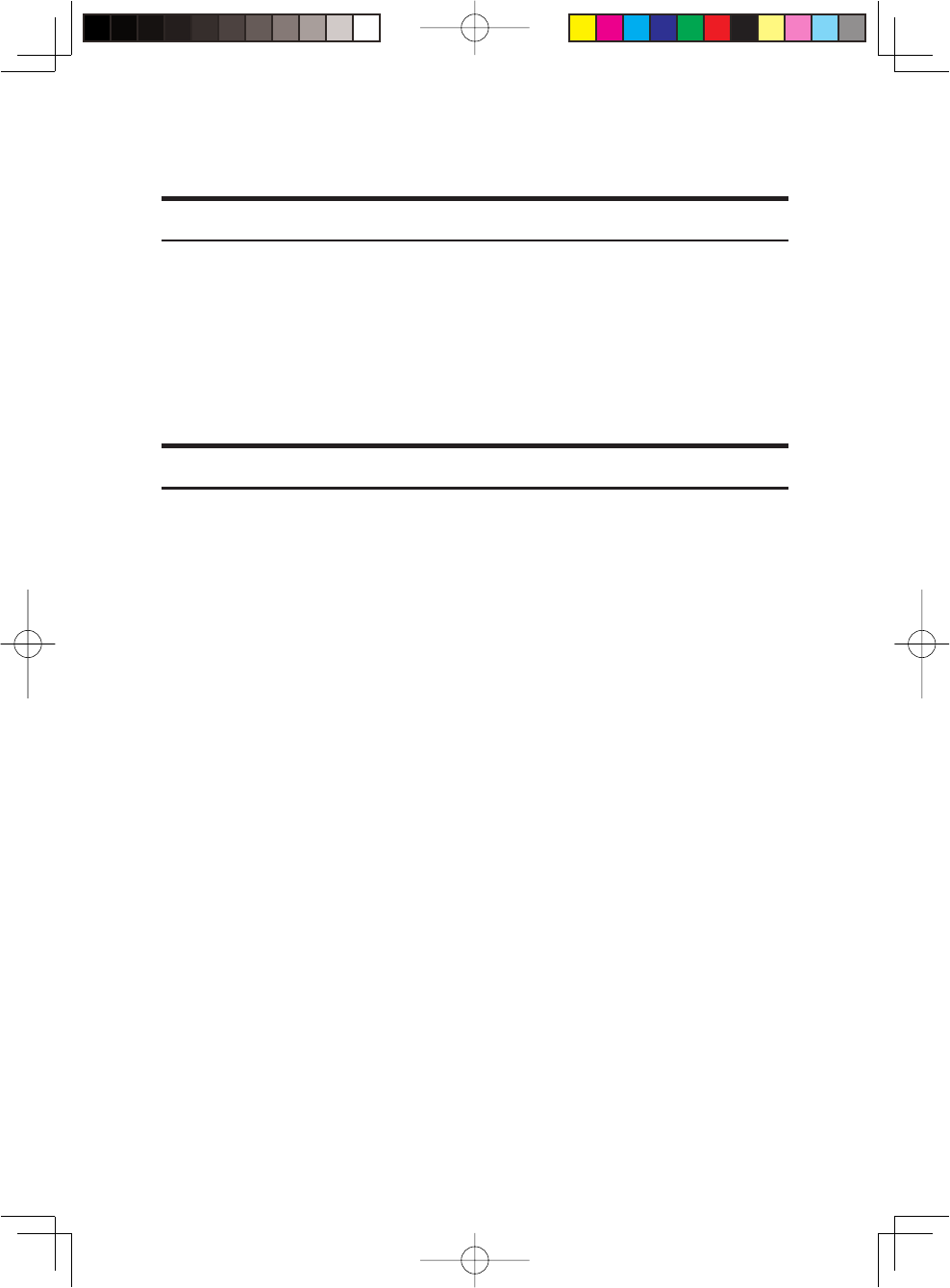
2
Laws and Regulations
Legal Prohibition
Do not copy or print any item for which reproduction is prohibited by law.
Copying or printing the following items is generally prohibited by local law:
bank notes, revenue stamps, bonds, stock certificates, bank drafts, checks, pass-
ports, driver's licenses.
The preceding list is meant as a guide only and is not inclusive. We assume
no responsibility for its completeness or accuracy. If you have any questions
concerning the legality of copying or printing certain items, consult with your
legal advisor.
Laser Safety
CDRH Regulations
This machine complies with the requirements of 21 CFR Subchapter J for class I
laser product. This machine contains AlGaAs laser diode, 11-milliwatt, 775-
790.7 nanometer wavelength for each emitter. The beam divergence angle is 25
degrees (minimum) and 36 degrees (maximum) in the vertical direction, and 7
degrees (minimum) and 12.5 degrees (maximum) in the horizontal direction,
and laser beams are generated in Continuous Wave (CW) mode.
Caution:
Use of controls or adjustments or performance of procedures other than those
specified in this manual might result in hazardous radiation exposure.

3
English
Notes to USA Users of FCC Requirements
Part 15 of the FCC Rules
Note
This equipment has been tested and found to comply with the limits for a
Class B digital device, pursuant to Part 15 of the FCC Rules. These limits are
designed to provide reasonable protection against harmful interference in a
residential installation. This equipment generates, uses and can radiate radio
frequency energy and, if not installed and used in accordance with the instruc-
tions, may cause harmful interference to radio communications. However,
there is no guarantee that interference will not occur in a particular installation.
If this equipment does cause harmful interference to radio or television recep-
tion, which can be determined by turning the equipment off and on, the user
is encouraged to try to correct the interference by one more of the following
measures:
Reorient or relocate the receiving antenna.
Increase the separation between the equipment and receiver.
Connect the equipment into an outlet on a circuit different from that to
which the receiver is connected.
Consult the dealer or an experienced radio /TV technician for help.
This device complies with part 15 of the FCC Rules.
Operation is subject to the following two conditions:
(1) This device may not cause harmful interference, and
(2) This device must accept any interference received, including interference
that may cause undesired operation.
Changes or modifications not expressly approved by the party responsible for
compliance could void the user's authority to operate the equipment.
Caution
Changes or modifications not expressly approved by the party responsible for
compliance could void the user's authority to operate the equipment.
Country Code Statement
For product available in the USA/Canada market, only channel 1~11 can be
operated. Selection of other channels is not possible.
CAUTION:
Any changes or modifications not expressly approved by the grantee of this
device could void the user’s authority to operate the equipment. This transmit-
ter must not be co-located or operating in conjunction with any other antenna
or transmitter.
❖
•
•
•
•
❖
❖
❖

4
Federal Communication Commission (FCC) Radiation Exposure Statement
This EUT is compliance with RF exposure for general population/uncontrolled
exposure limits in ANSI/IEEE C95.1-1999 and had been tested in accordance
with the measurement methods and procedures specified in OET Bulletin 65
Supplement C. This equipment should be installed and operated with mini-
mum distance 20cm between the radiator and your body.
Part 68 of the FCC Rules
FCC Requirements
1) This equipment complies with Part 68 of the FCC rules and requirements adopted
by the ACTA. On the cover of this equipment is a label that contains, among other
information, a product identifi er in the format US:AAAEQ##TXXXXX. If requested,
this number must be provided to the telephone company.
2) This equipment uses the RJ11C USOC jack.
3) A plug and jack used to connect this equipment to the premises wiring and tele-
phone network must comply with the applicable FCC Part 68 rules and require-
ments adopted by the ACTA. A compliant telephone cord and modular plug is
provided with this product. It is designed to be connected to a compatible modular
jack that is also compliant. See installation instructions for detail.
4) The REN is used to determine the number of devices that may be connected to a
telephone line. Excessive RENs on a telephone line may result in the devices not
ringing in response to an incoming call. In most but not all areas, the sum of RENs
should not exceed fi ve (5.0). To be certain of the number of devices that may be
connected to a line, as determined by the total RENs, contact the local telephone
company. The REN for this product is part of the product identifi er that has the
format US:AAAEQ##TXXXXX. The digits represented by ## are the REN without a
decimal point (e.g., 03 is a REN of 0.3).
5) If this equipment causes harm to the telephone network, the telephone company
will notify you in advance that temporary discontinuance of service may be
required. But if advance notice is not practical, the telephone company will notify
the customer as soon as possible. Also, you will be advised of your right to fi le a
complaint with the FCC if you believe it is necessary.
6) The telephone company may make changes in its facilities, equipment, operations
or procedures that could affect the operation of the equipment. If this happens the
telephone company will provide advance notice in order for you to make necessary
modifi cations to maintain uninterrupted service.
7) If trouble is experienced with this equipment, for repair or warranty informa-
tion, please contact Ricoh Americas Corporation. CUSTOMER SUPPORT DEPT.
at 1-800- FASTFIX. If the equipment is causing harm to the telephone network,
the telephone company may request that you disconnect the equipment until the
problem is resolved.
8) In the event of operation problems (document jam, copy jam, communication error
indication), refer to the solving problems section in this manual.
9) Connection to party line service is subject to state tariffs. Contact the state public
utility commission, public service commission or corporation commission for infor-
mation.
10) If your home has specially wired alarm equipment connected to the telephone
line, ensure the installation of this equipment does not disable your alarm equip-
ment. If you have questions about what will disable alarm equipment, consult your
telephone company or a qualifi ed installer.
❖
❖

5
English
WHEN PROGRAMMING EMERGENCY NUMBERS AND/OR MAKING TEST CALLS
TO EMERGENCY NUMBERS:
1) Remain on the line and briefl y explain to the dispatcher the reason for the call
before hanging up.
2) Perform such activities in the off-peak hours, such as early morning hours or late
evenings.
❖
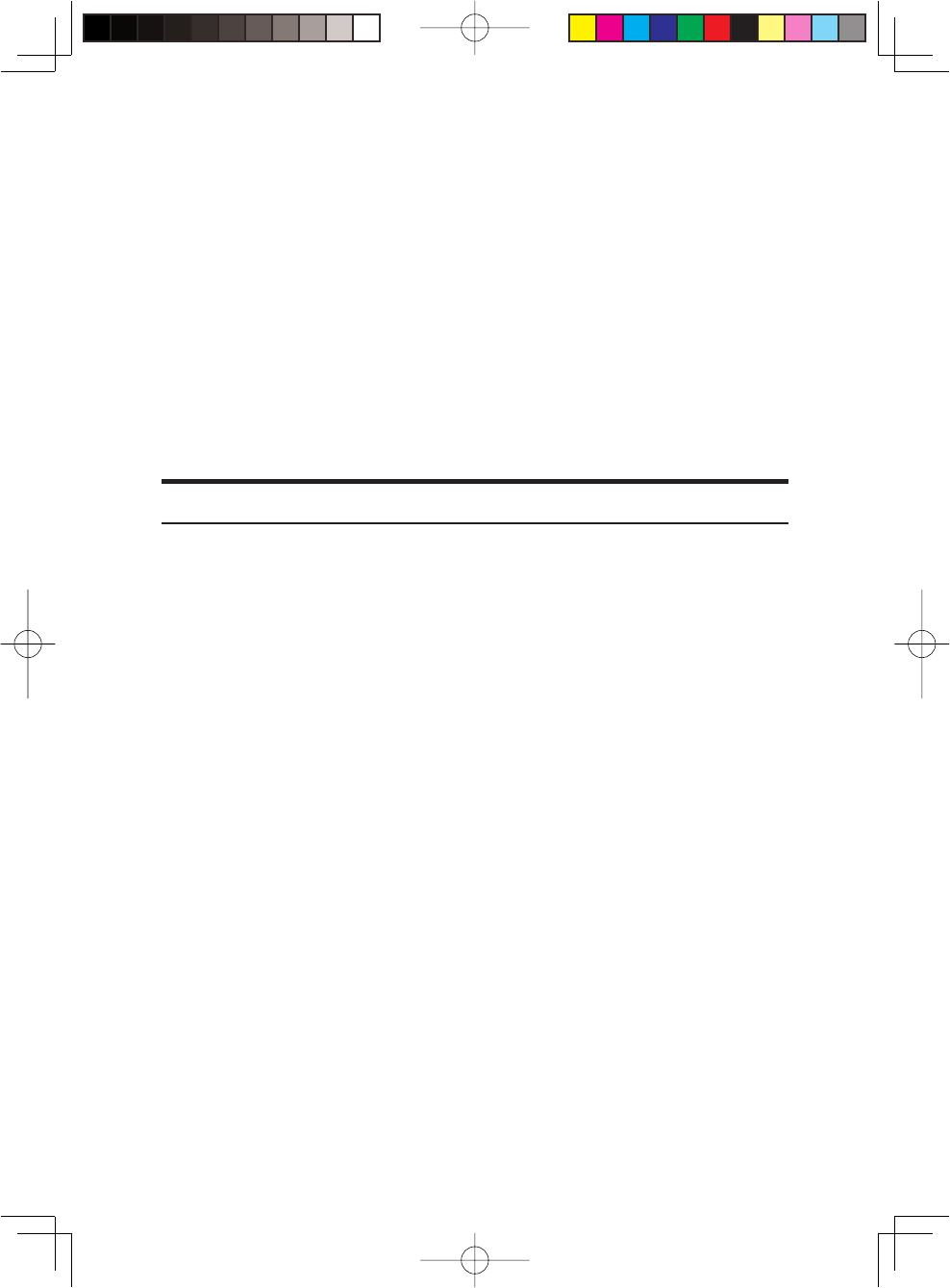
6
Important Safety Instructions
When using your telephone equipment, basic safety precautions should always
be followed to reduce the risk of fire, electric shock and injury to persons,
including the following:
1. Do not use this product near water, for example, near a bathtub, wash bowl,
kitchen sink or laundry tub, in a wet basement or near a swimming pool.
2. Avoid using a telephone (other than a cordless type) during an electrical
storm. There may be a remote risk of electric shock from lightning.
3. Do not use the telephone to report a gas leak in the vicinity of the leak.
4. Use only the power cord and batteries indicated in this manual. Do not
dispose of batteries in a fire. They may explode. Check with local codes for
possible special disposal instructions.
SAVE THESE INSTRUCTIONS.
IMPORTANTES MESURES DE SÉCURITÉ
Certaines mesures de sécurité doivent être prises pendant l'utilisation de mate-
rial téléphonique afin de réduire les risques d'incendie, de choc électrique et de
blessures. En voici quelques-unes:
1. Ne pas utiliser l'appareil près de l'eau, p.ex., près d'une baignoire, d'un la-
vabo, d'un évier de cuisine, d'un bac à laver, dans un sous-sol humide ou près
d'une piscine.
2. Éviter d'utiliser le téléphone (sauf s'il s'agit d'un appareil sans fil) pendant
un orage électrique. Ceci peut présenter un risque de choc électrique causé par
la foudre.
3. Ne pas utiliser l'appareil téléphonique pour signaler une fuite de gaz s'il est
situé près de la fuite.
4. Utiliser seulement le cordon d'alimentation et le type de piles indiqués dans
ce manual. Ne pas jeter les piles dans le feu: elles peuvent exploser. Se con-
former aux règrlements pertinents quant à l'élimination des piles.
CONSERVER CES INSTRUCTIONS.
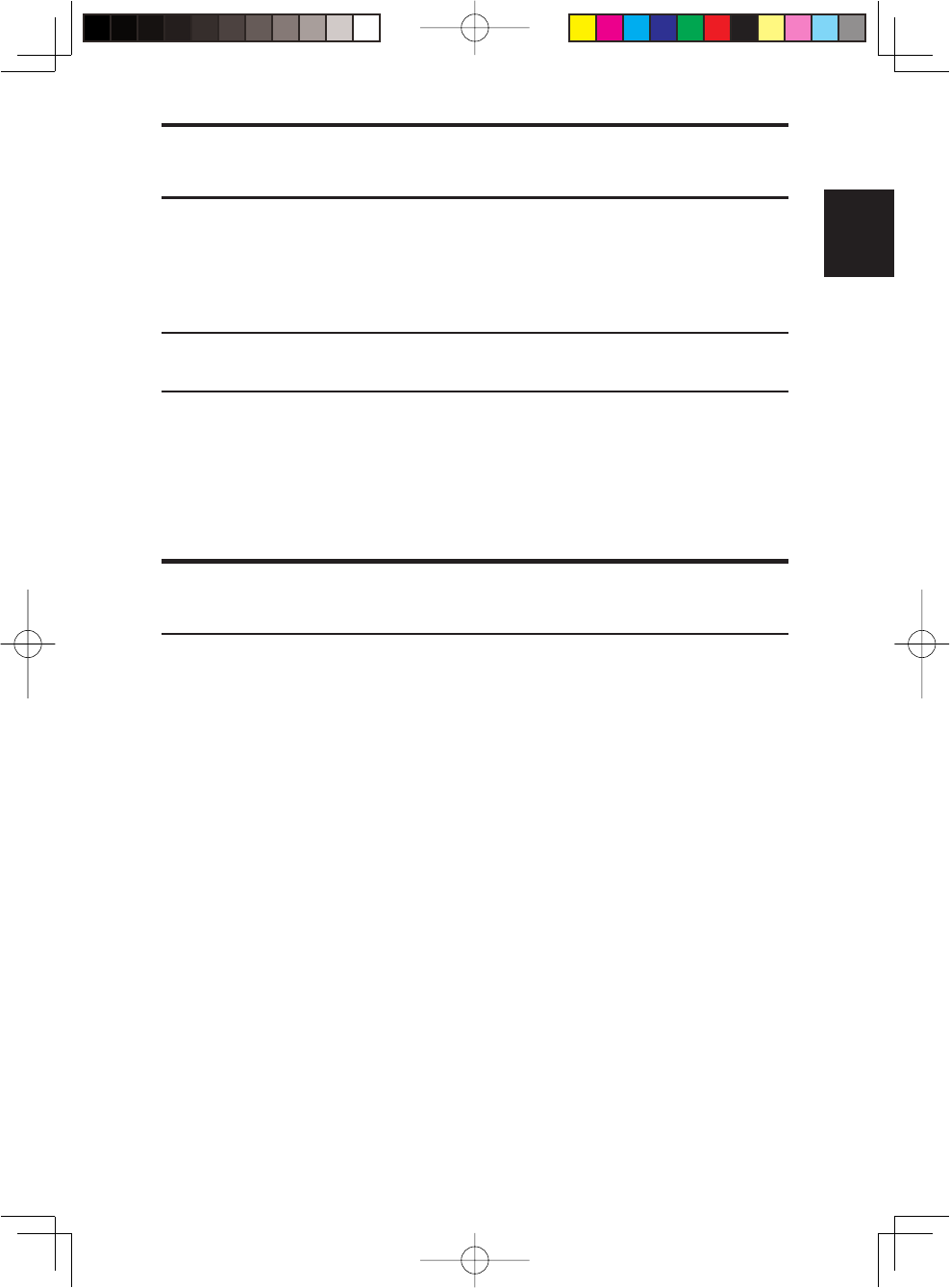
7
English
Notes to Canadian Users of SP 213Nw/ SP 212Nw
This product meets the applicable Industry Canada technical specifications.
The Ringer Equivalence Number is an indication of the maximum number
of devices allowed to be connected to a telephone interface. The termination
on an interface may consist of any combination of devices subject only to the
requirement that the sum of the RENs of all the devices does not exceed five.
Remarques a l'attention des utilisateurs canadiens du SP 213Nw/ SP 212Nw
Le present materiel est conforme aux specifications techniques applicables
d'Industrie Canada.
L'indice d'equivalence de la sonnerie (IES) sert a indiquer le nombre maximal
de terminaux qui peuvent etre raccordes a une interface telephonique. La
terminaison d'une interface peut consister en une combinaison quelconque de
dispositifs, a la seule condition que la somme d'indices d'equivalence de la son-
nerie de tous les dispositifs n'excede pas 5.
Notice about the Telephone Consumer Protection Act (Valid in
USA only)
The Telephone Consumer Protection Act of 1991 makes it unlawful for any
person to use a computer or other electronic device, including FAX machines,
to send any message unless such message clearly contains in a margin at the
top or bottom of each transmitted page or on the first page of the transmission,
the date and time it is sent and an identification of the business or other entity,
or other individual sending the message and the telephone number of the
sending machine or such business, other entity, or individual. (The telephone
number provided may not be a 900 number or any other number for which
charges exceed local or long-distance transmission charges.)
In order to program this information into your FAX machine, you should
complete the following steps: Follow the FAX HEADER programming pro-
cedure in the Programming chapter of the operating instructions to enter the
business identification and telephone number of the terminal or business. This
information is transmitted with your document by the FAX HEADER feature.
In addition to the information, be sure to program the date and time into your
machine.

8
Note to users in Canada
Note
This Class B digital apparatus complies with Canadian ICES- 003.
Remarque concernant les utilisateurs au Canada
Avertissement
Cet appareil numérique de la classe B est conforme à la norme NMB-003
du Canada.
Notes to Canadian Users of IC Rules
Notes to users in Canada
This device complies with Industry Canada licence-exempt RSS
standard(s).
Operation is subject to the following two conditions:
(1) this device may not cause interference, and
(2) this device must accept any interference, including interference that
may cause undesired operation of the device.
For product available in the USA/Canada market, only channel 1~11 can
be operated. Selection of other channels is not possible.
Remarques a l'attention des utilisateurs canadiens
Le present appareil est conforme aux CNR d'Industrie Canada appli-
cables aux appareils radio exempts de licence.
L'exploitation est autorisee aux deux conditions suivantes :
(1) l'appareil ne doit pas produire de brouillage, et
(2) l'utilisateur de l'appareil doit accepter tout brouillage radioelectrique
subi, meme si le brouillage est susceptible d'en compromettre le fonc-
tionnement.
Pour les produits disponibles aux États-Unis / Canada du marché, seul
le canal 1 à 11 peuvent être exploités. Sélection d'autres canaux n'est pas
possible.
IMPORTANT NOTE:
IC Radiation Exposure Statement
This EUT is compliance with SAR for general population/uncontrolled
exposure limits in IC RSS-102 and had been tested in accordance with
the measurement methods and procedures specified in IEEE 1528. This
equipment should be installed and operated with minimum distance
2.5cm between the radiator and your body.
❖
❖
❖
❖
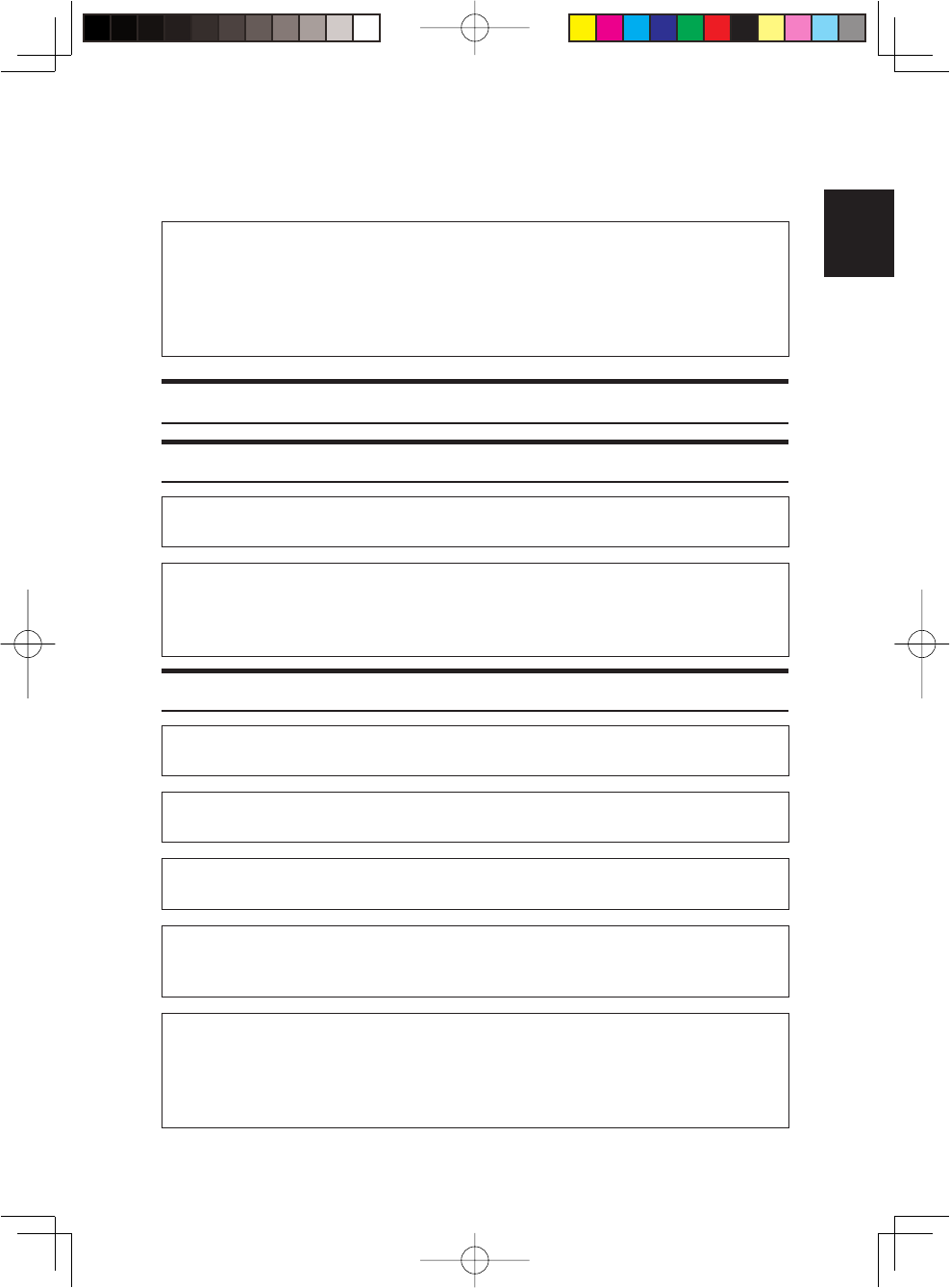
9
English
Safety During Operation
In this manual, the following important symbols are used:
WARNING:
Indicates a potentially hazardous situation which, if instructions are not followed,
could result in death or serious injury.
CAUTION:
Indicates a potentially hazardous situation which, if instructions are not followed,
may result in minor or moderate injury or damage to property.
R
R
Environments Where the Machine Can be Used
WARNING:
Do not use flammable sprays or solvents in the vicinity of this ma-
chine. Doing so could result in fire or electric shock.
•
Do not place vases, plant pots, cups, toiletries, medicines, small metal
objects, or containers holding water or any other liquids, on or close
to this machine. Fire or electric shock could result from spillage or if
such objects or substances fall inside this machine.
•
CAUTION:
Keep the machine away from humidity and dust. Otherwise a fire or an
electric shock might occur.
•
Do not place the machine on an unstable or tilted surface. If it topples over,
an injury might occur.
•
Do not place heavy objects on the machine. Doing so can cause the ma-
chine to topple over, possibly resulting in injury.
•
Make sure the room where you are using the machine is well ventilated
and spacious. Good ventilation is especially important when the machine is
used heavily.
•
Keep the machine in an area that is within optimum environmental condi-
tions. Operating the machine in an environment that is outside the recom-
mended ranges of humidity and temperature can cause an electrical fire
hazard. Keep the area around the socket free of dust. Accumulated dust
can become an electrical fire hazard.
•
R
R
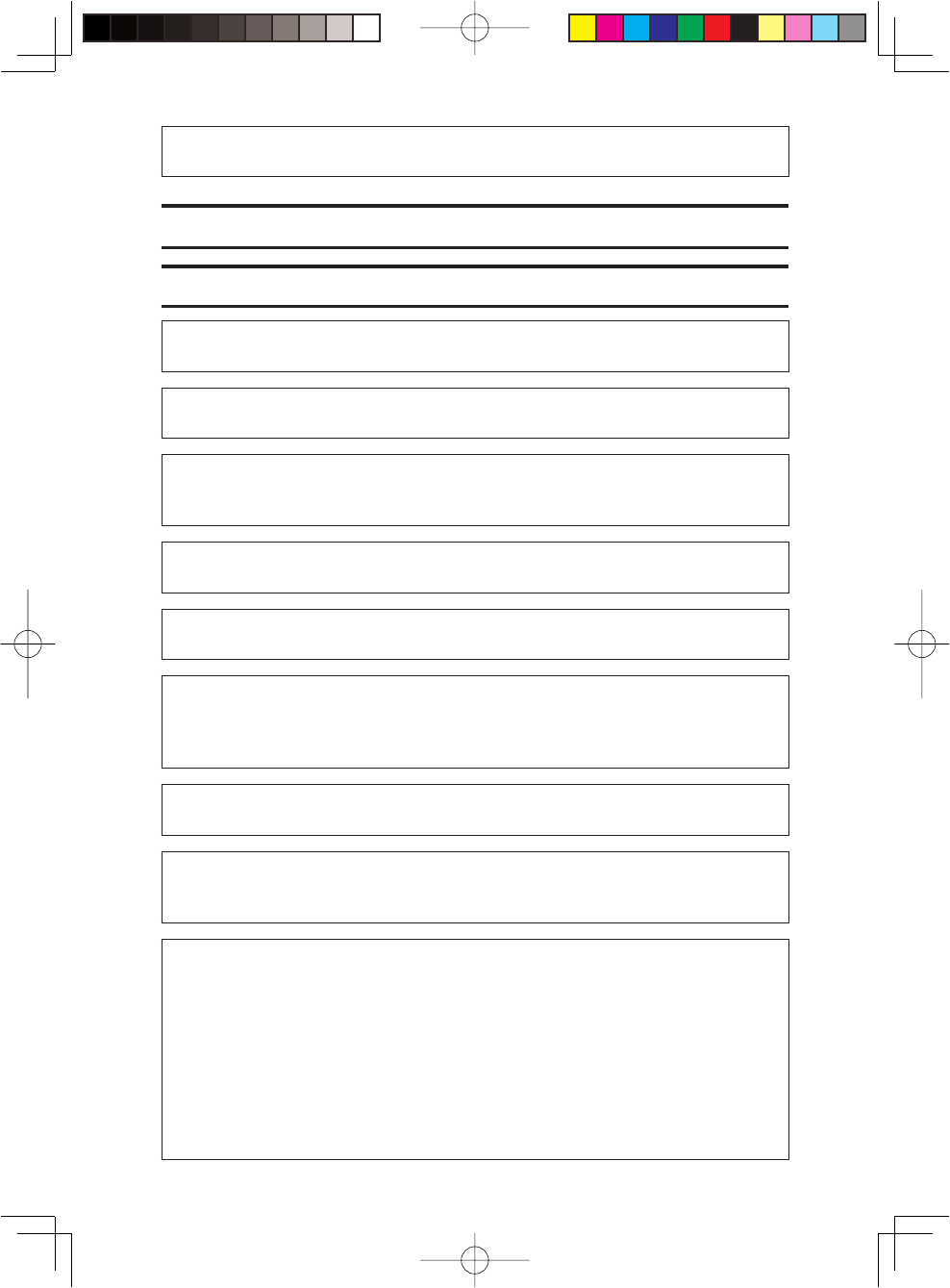
10
Do not obstruct the machine's vents. Doing so risks fire caused by over-
heated internal components.
•
Handling Power Cords and Power Plugs
WARNING:
Touching the prongs of the power cable's plug with anything metallic
constitutes a fire and electric shock hazard.
•
Do not use any frequencies other than those that match the specifica-
tions shown. Doing so could result in fire or electric shock.
•
Do not use any power sources other than those that match the speci-
fications shown in this manual. Doing so could result in fire or electric
shock.
•
Do not use multi-socket adaptors. Doing so could result in fire or
electric shock.
•
Do not use extension cords. Doing so could result in fire or electric
shock.
•
Do not use power cords that are damaged, broken, or modified. Also,
do not use power cords that have been trapped under heavy objects,
pulled hard, or bent severely. Doing so could result in fire or electric
shock.
•
It is dangerous to handle the power cord plug with wet hands. Doing
so could result in electric shock.
•
If the power cord is damaged and its inner wires are exposed or
broken, contact your service representative for a replacement. Use of
damaged power cords could result in fire or electric shock.
•
Be sure to disconnect the power cord from the wall outlet at least
once a year and check for the following:
The power cord's inner wires are exposed, broken, etc.
The power cord's coating has a crack or dent.
When bending the power cord, the power turns off and on.
Part of the power cord becomes hot.
The power cord is damaged.
If any of the above conditions exist, do not use the power cord and
consult your dealer or service representative. Use of the power cord
could result in fire or electric shock.
•
•
•
•
•
•
•
R
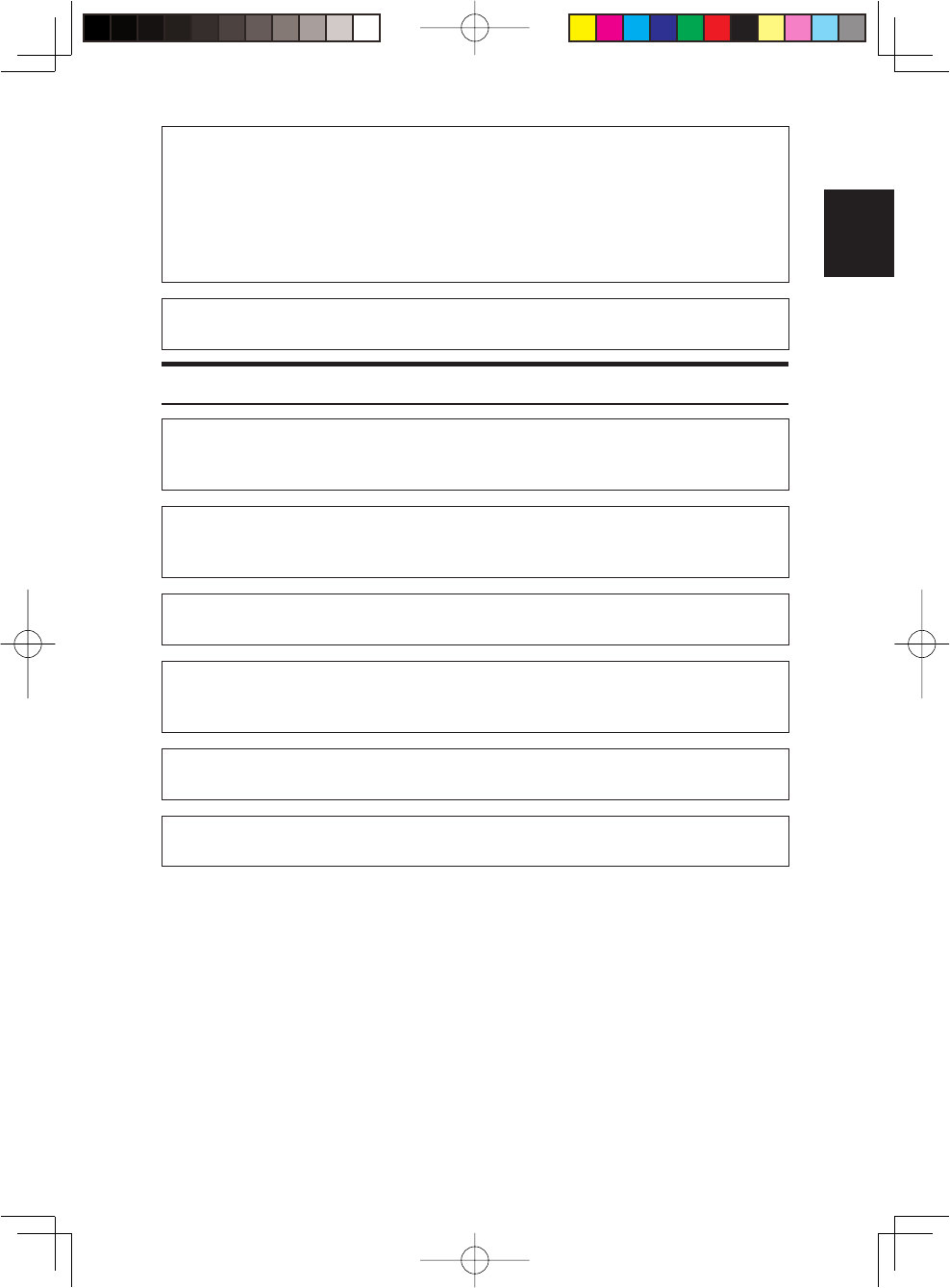
11
English
Be sure to disconnect the plug from the wall outlet at least once a
year and check for the following:
There are burn marks on the plug.
The prongs on the plug are deformed.
If any of the above conditions exist, do not use the plug and consult
your dealer or service representative. Use of the plug could result in
fire or electric shock.
•
•
•
•
The supplied power cord is for use with this machine only. Do not use
it with other appliances. Doing so could result in fire or electric shock.
•
CAUTION:
Be sure to disconnect the plug from the wall outlet and clean the prongs
and the area around the prongs at least once a year. Allowing dust to build
up on the plug constitutes a fire hazard.
•
Be sure to push the plug of the power cord fully into the wall outlet. Par-
tially inserted plugs create an unstable connection that can result in unsafe
buildup of heat.
•
If this machine is not going to be used for several days or longer at a time,
disconnect its power cord from the wall outlet.
•
When disconnecting the power cord from the wall outlet, always pull the
plug, not the cord. Pulling the cord can damage the power cord. Use of
damaged power cords could result in fire or electric shock.
•
When performing maintenance on the machine, always disconnect the
power cord from the wall outlet.
•
To reduce the risk of fire, use only No.26 AWG or larger telecommunication
line cord.
•
R
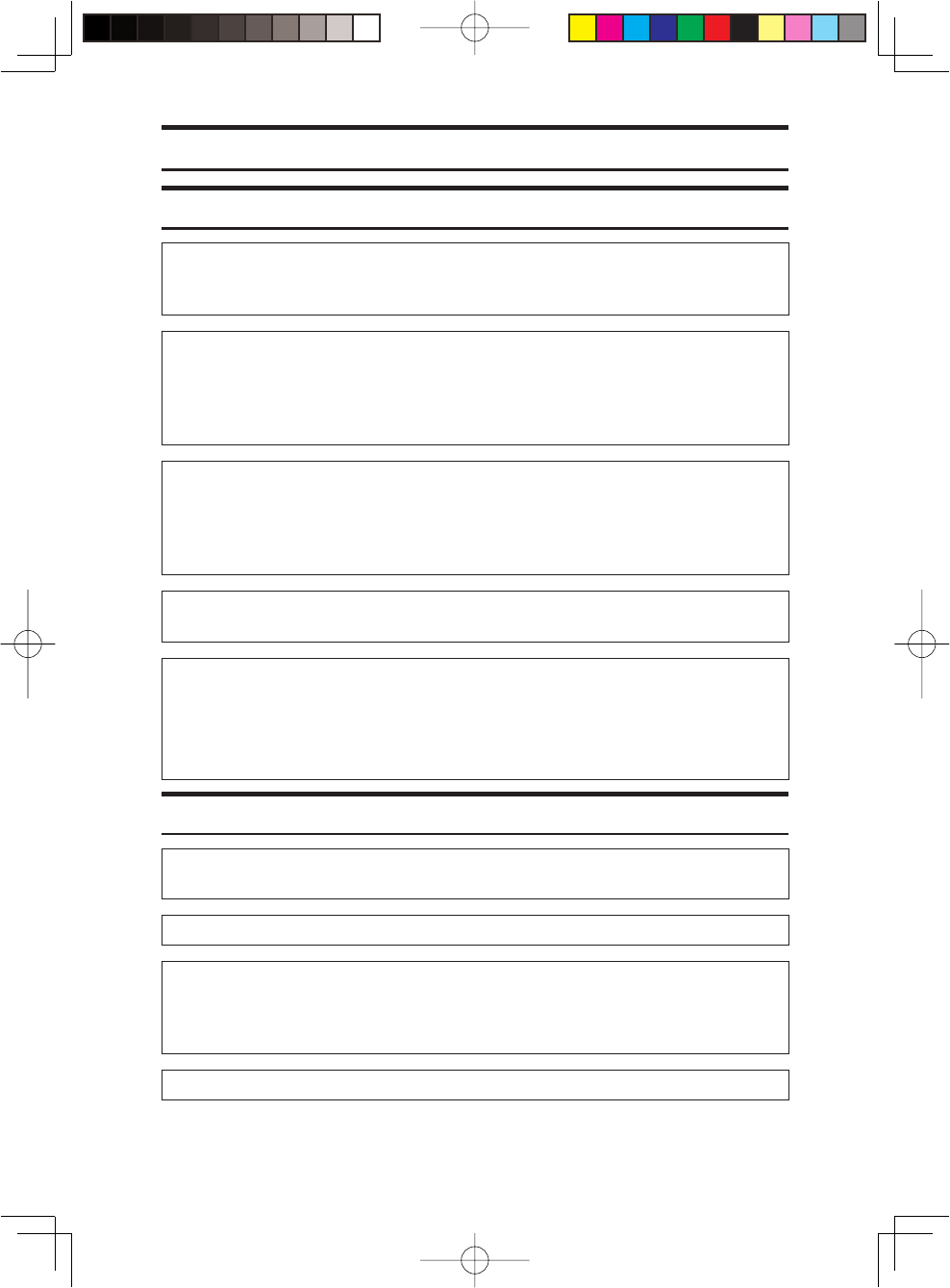
12
Handling the Machine
WARNING:
Be sure to locate the machine as close as possible to a wall outlet.
This will allow easy disconnection of the power cord in the event of
an emergency.
•
If the machine emits smoke or odours, or if it behaves unusually, you
must turn off its power immediately. After turning off the power, be
sure to disconnect the power cord plug from the wall outlet. Then con-
tact your service representative and report the problem. Do not use
the machine. Doing so could result in fire or electric shock.
•
If metal objects, or water or other fluids fall inside this machine, you
must turn off its power immediately. After turning off the power, be
sure to disconnect the power cord plug from the wall outlet. Then con-
tact your service representative and report the problem. Do not use
the machine. Doing so could result in fire or electric shock.
•
Do not touch this machine if a lightning strike occurs in the immedi-
ate vicinity. Doing so could result in electric shock
•
The following explains the warning messages on the plastic bag used
in this product's packaging.
Keep the polythene materials (bags, etc.) supplied with this machine
away from babies and small children at all times. Suffocation can result
if polythene materials are brought into contact with the mouth or nose.
•
•
CAUTION:
When moving the machine, use the inset grips on both sides, and lift it up
slowly. The machine may break or cause injury if dropped.
•
Be careful not to trap your fingers when opening or closing the cover.
•
Unplug the power cord from the wall outlet before you move the machine.
While moving the machine, take care that the power cord is not damaged
under the machine. Failing to take these precautions could result in fire or
electric shock.
•
Do not look into the lamp. It can damage your eyes.•
R
R
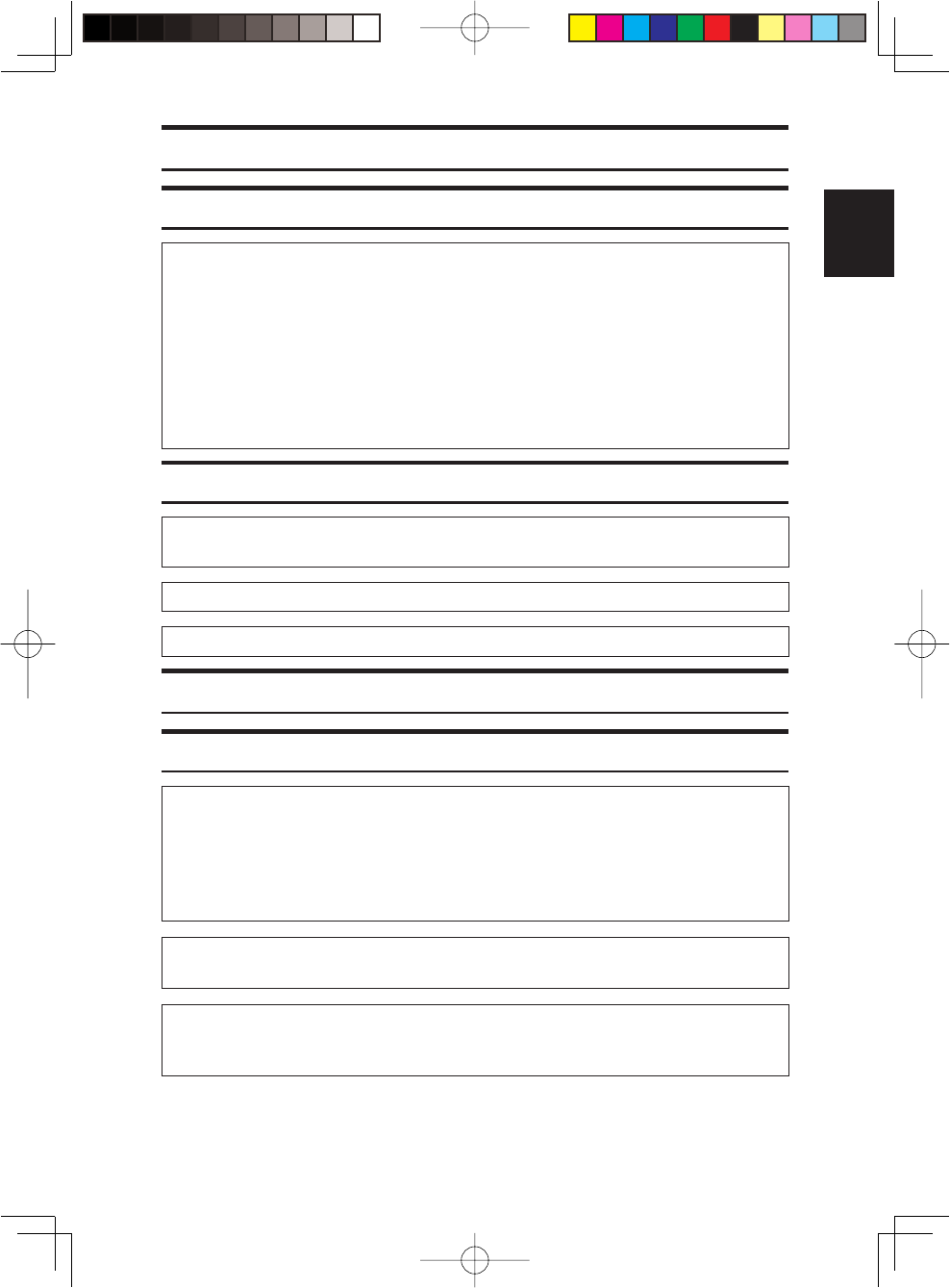
13
English
Handling the Machine's Interior
WARNING:
Do not remove any covers or screws other than those explicitly men-
tioned in this manual. Inside this machine are high voltage compo-
nents that are an electric shock hazard and laser components that
could cause blindness. Contact your sales or service representative
if any of the machine's internal components require maintenance,
adjustment, or repair.
Do not attempt to disassemble or modify this machine. Doing so risks
burns and electric shock. Note again that exposure to the laser com-
ponents inside this machine risks blindness.
•
•
CAUTION:
Some of this machine's internal components get very hot. For this reason,
take care when removing misfed paper. Not doing so could result in burns.
•
When removing jammed paper, make sure not to trap or injure your fingers.
•
When loading paper, take care not to trap or injure your fingers.•
Handling the Machine's Supplies
WARNING:
Do not use a vacuum cleaner to remove spilled toner (including used
toner). Absorbed toner may cause a fire or explosion due to electrical
contact flickering inside the vacuum cleaner. However, it is possible to
use a vacuum cleaner that is explosion-proof and dust ignition-proof.
If toner is spilled on the floor, remove the spilled toner slowly using a
wet cloth, so that the toner is not scattered.
•
Do not incinerate toner (new or used) or toner containers. Doing so
risks burns. Toner will ignite on contact with naked flame.
•
Do not store toner (new or used) or toner containers anywhere near
naked flames. Doing so risks fire and burns. Toner will ignite on con-
tact with naked flame.
•
R
R
R
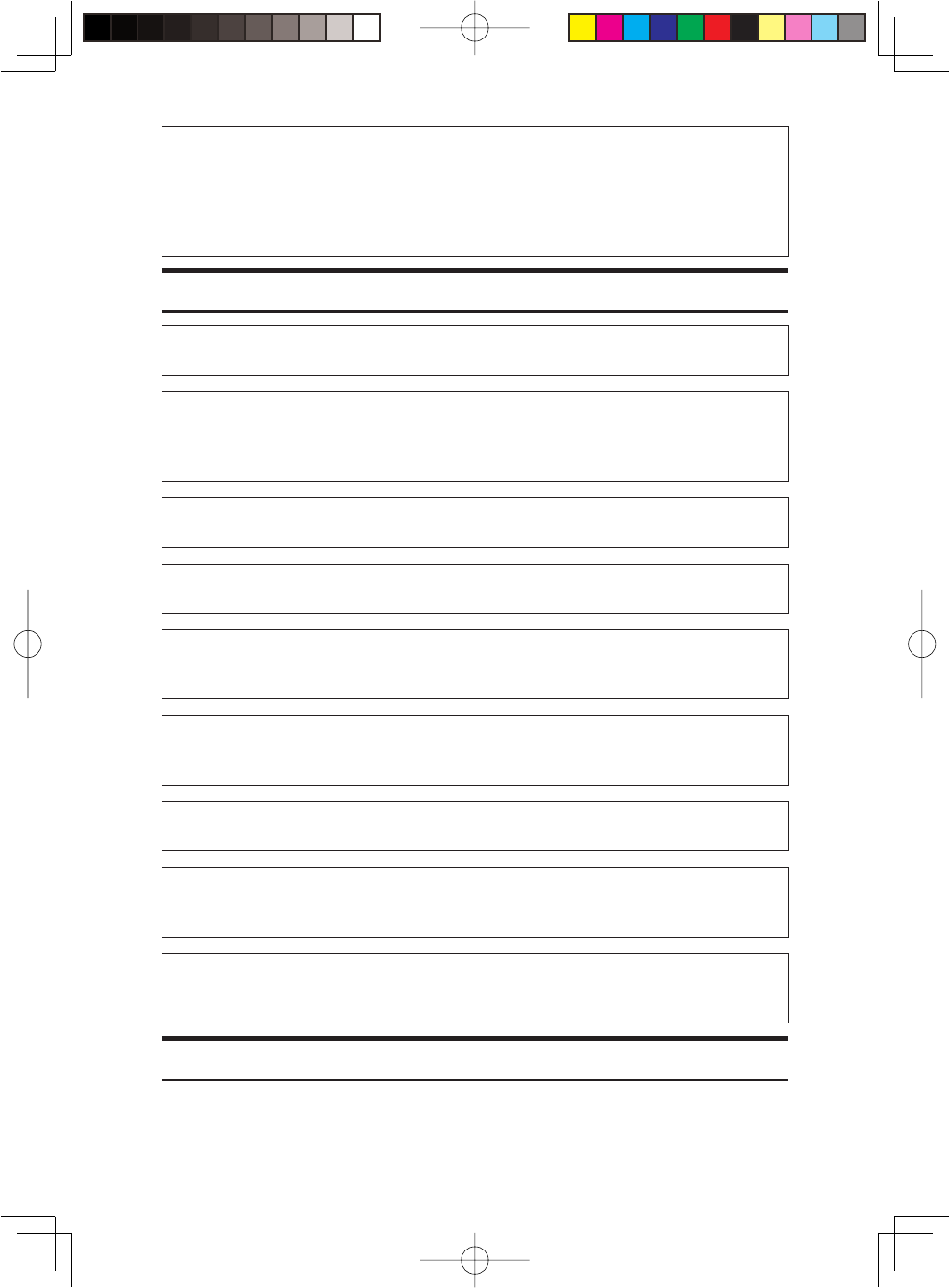
14
The following explains the warning messages on the plastic bag used
in this product's packaging.
Keep the polythene materials (bags, gloves, etc.) supplied with this
machine away from babies and small children at all times. Suffoca-
tion can result if polythene materials are brought into contact with
the mouth or nose.
•
•
CAUTION:
If toner or used toner is inhaled, gargle with plenty of water and move into a
fresh air environment. Consult a doctor if necessary.
•
When removing jammed paper or replacing toner, avoid getting toner (new
or used) on your clothing. If toner comes into contact with your clothing,
wash the stained area with cold water. Hot water will set the toner into the
fabric and make removing the stain impossible.
•
If toner or used toner gets into your eyes, flush immediately with large
amounts of water. Consult a doctor if necessary.
•
If toner or used toner is swallowed, dilute by drinking a large amount of
water. Consult a doctor if necessary.
•
When removing jammed paper or replacing toner, avoid getting toner (new
or used) on your skin. If toner comes into contact with your skin, wash the
affected area thoroughly with soap and water.
•
Do not crush or squeeze toner containers. Doing so can cause toner spill-
age, possibly resulting in dirtying of skin, clothing, and floor, and accidental
ingestion.
•
Store toner (new or used), toner containers, and components that have
been in contact with toner out of reach of children.
•
Our products are engineered to meet high standards of quality and func-
tionality, and we recommend that you use only the expendable supplies
available at an authorized dealer.
•
Keep USB flash memory devices out of reach of children. If a child ac-
cidentally swallows an USB flash memory device, consult a doctor immedi-
ately.
•
Notes for Users
If you continuously print multiple pages, moist or vapor may appear from the
paper exit area. However this will not have any impact on the performance of
your printer. Be cautious not to touch the surface, or wait until cooled down,
and keep children away from the surface.
R
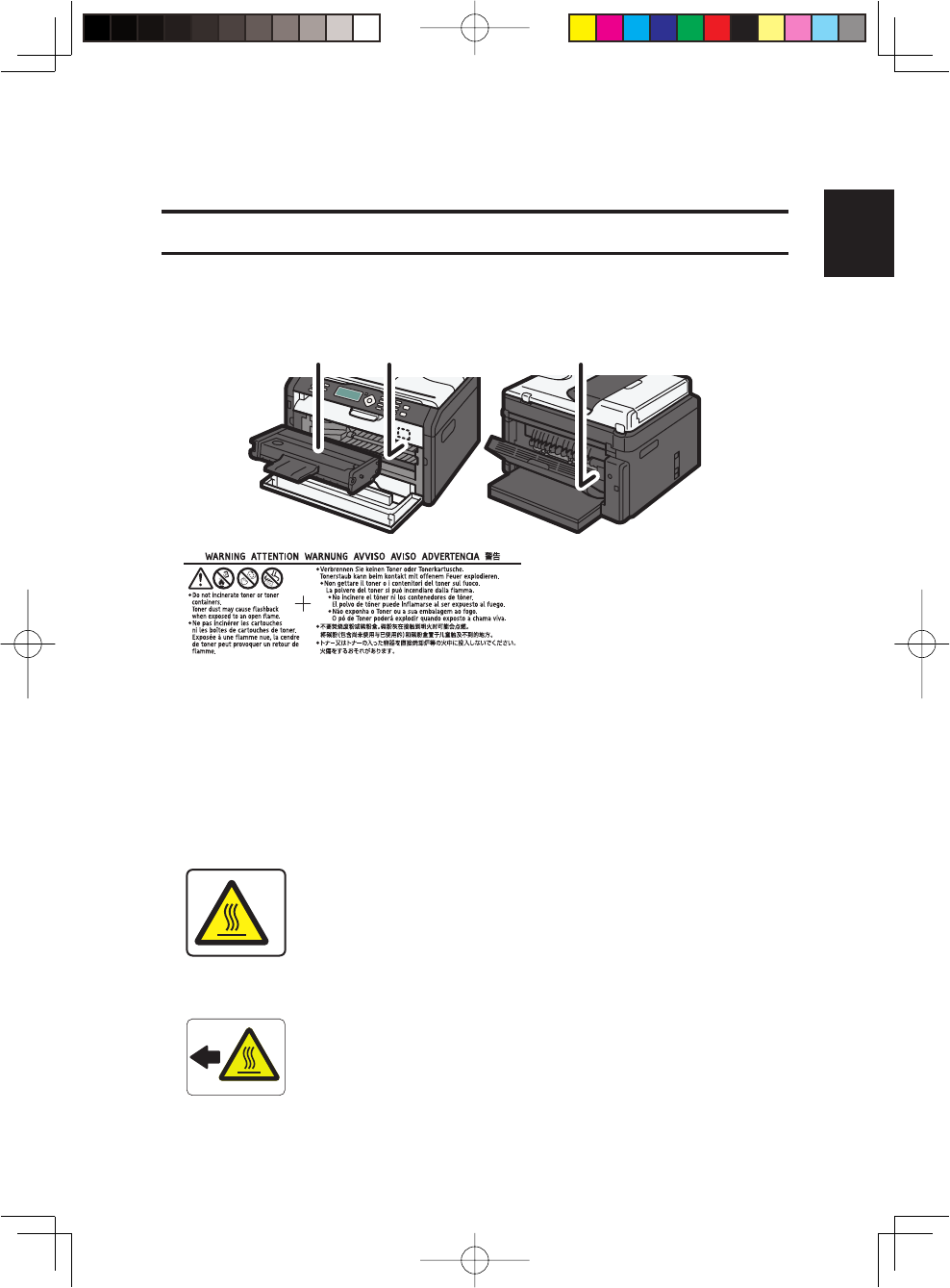
15
English
Safety Labels of This Machine
This section explains the machine's safety information labels.
Positions of
R
WARNING and
R
CAUTION labels
This machine has labels and engraved seals for RWARNING and RCAU-
TION at the positions shown below. For safety, please follow the instructions
and handle the machine as indicated.
1 2 3
CTT140
1
Do not incinerate toner or toner containers. Toner dust may cause flashback
when exposed to an open flame.
Do not use the cleaner to suck spilled toner (including used toner). Sucked
toner may cause firing or explosion due to electrical contact flickering inside
the cleaner. However, it is possible to use the cleaner designed for dust explo-
sion-proof purpose. If toner is spilled over the floor, sweep up spilled toner
slowly and clean remainder with wet cloth.
Store toner (new or used), toner containers, and components that have been in
contact with toner out of reach of children.
2
Do not touch the parts a label indicates. The inside of the machine could be
very hot.
3
Do not touch the parts a label indicates. The inside of the machine could be
very hot.
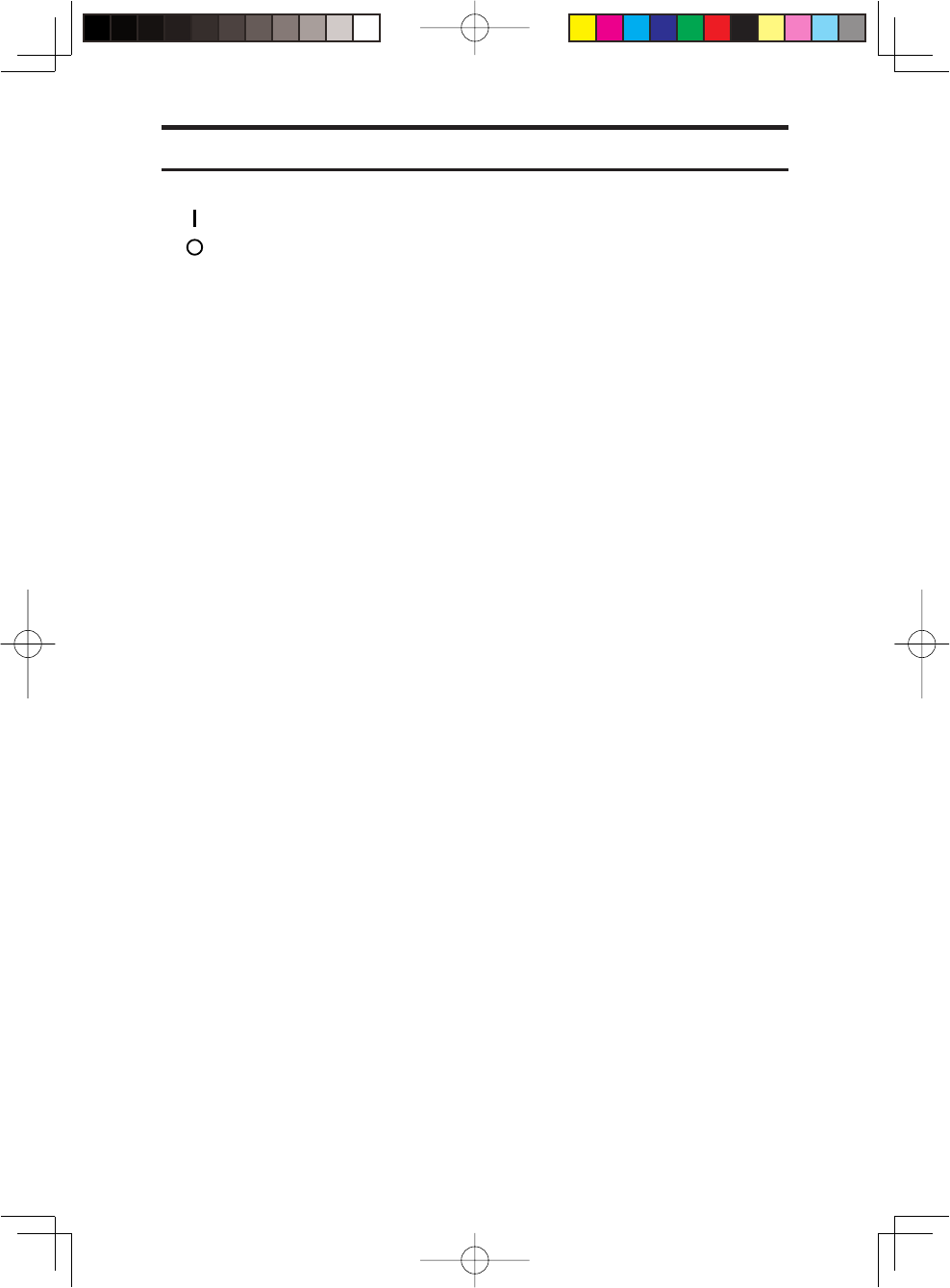
16
Power Switch Symbols
The meanings of the symbols for the switches on this machine are as follows:
:POWER ON.
:POWER OFF.
•
•
